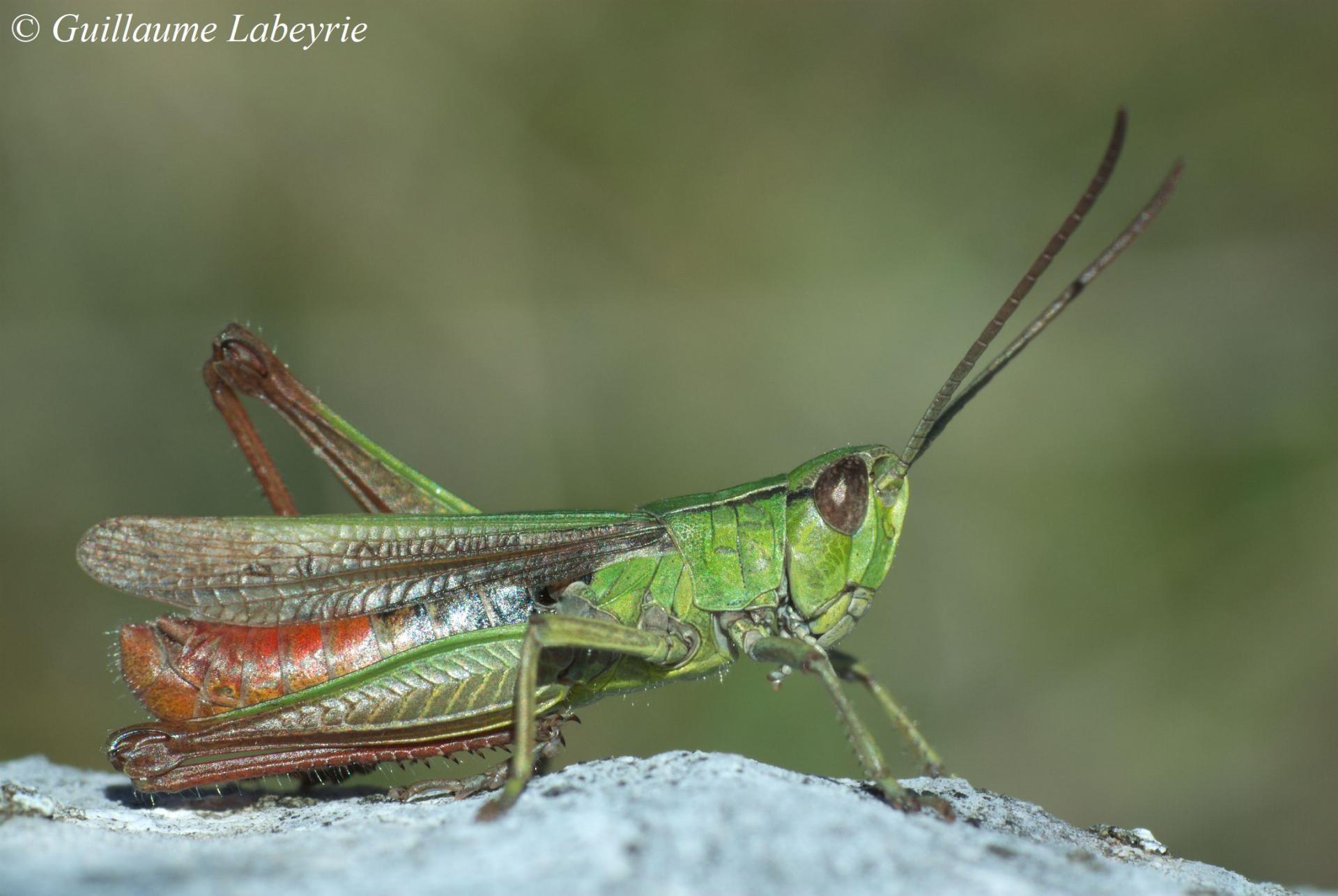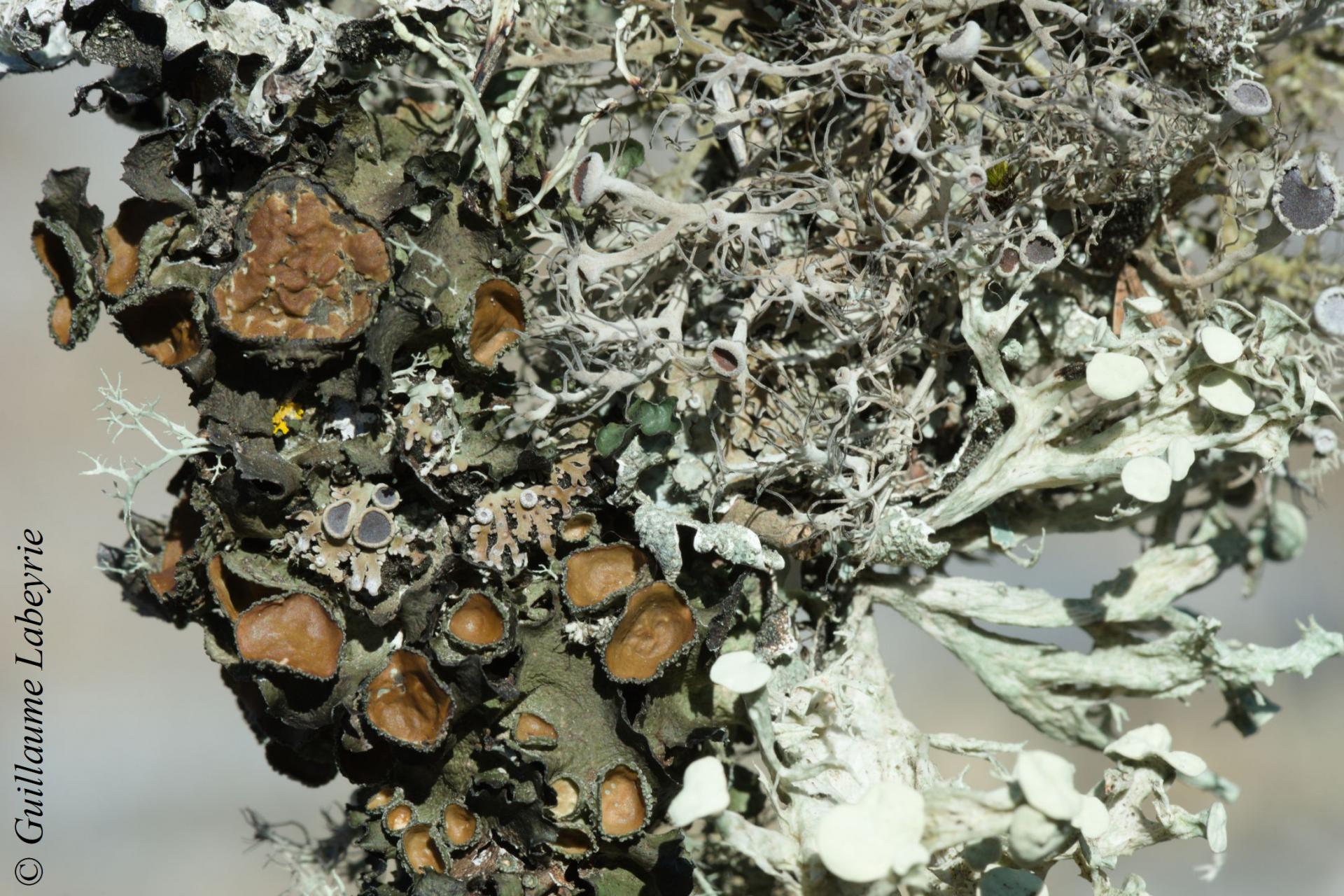Nature in the Grasse Prealps
The Grasse Prealps include a large karstic mountain range north to the city of Grasse, in the French department of the Alpes-Maritimes (06). This range of low mountains (maximum altitude of 1800 m), located at only 20 km from the mediterranean sea, harbors an exceptional biodiversity. The Parc Naturel Régional des Préalpes d'Azur was created in 2012 to help protecting this outstanding natural heritage.
In the following, species are grouped according to their habitat: dry grasslands, karst, dry slopes, wetlands, cliffs and rocky slopes and forests. Note that this choice is sometimes arbitrary, since habitats do overlap and some species can occur in several habitats.
These rocky grasslands cover most of the calcareous plateaus of the area. The climate is harsh: strong exposure to wind and sun, but also to cold and snow during winter. The grasslands depend on grazing by sheeps (and wild species such as the european roe deer and the red deer), to avoid colonization by trees such as the Scots pine. Many animals and plants inhabit these grasslands, some of them rare and threatened. In particular, many birds in sharp decline in Europe are still found here.
 Plateau de Calern. The vast plateaus are a distinctive feature of the landscape of the Grasse prealps. The plateau de Calern illustrated here is among the finest examples of such a geological formation. It shelters a spectacular diversity of flora and fauna, with rare and endangered species such as Orsini's viper (Vipera ursinii) and the short-horned grasshopper (Prionotropis azami).
Plateau de Calern. The vast plateaus are a distinctive feature of the landscape of the Grasse prealps. The plateau de Calern illustrated here is among the finest examples of such a geological formation. It shelters a spectacular diversity of flora and fauna, with rare and endangered species such as Orsini's viper (Vipera ursinii) and the short-horned grasshopper (Prionotropis azami).
Flora
The flora of dry grassland includes many bulbs, orchids and members of the Lily family. Massive successive bloomings occur from spring to the end of summer. The species are presented here by families, shown by alphabetic order. The definition of the families follows the classification of flowering plants APG IV (2016).
Family : Asteraceae
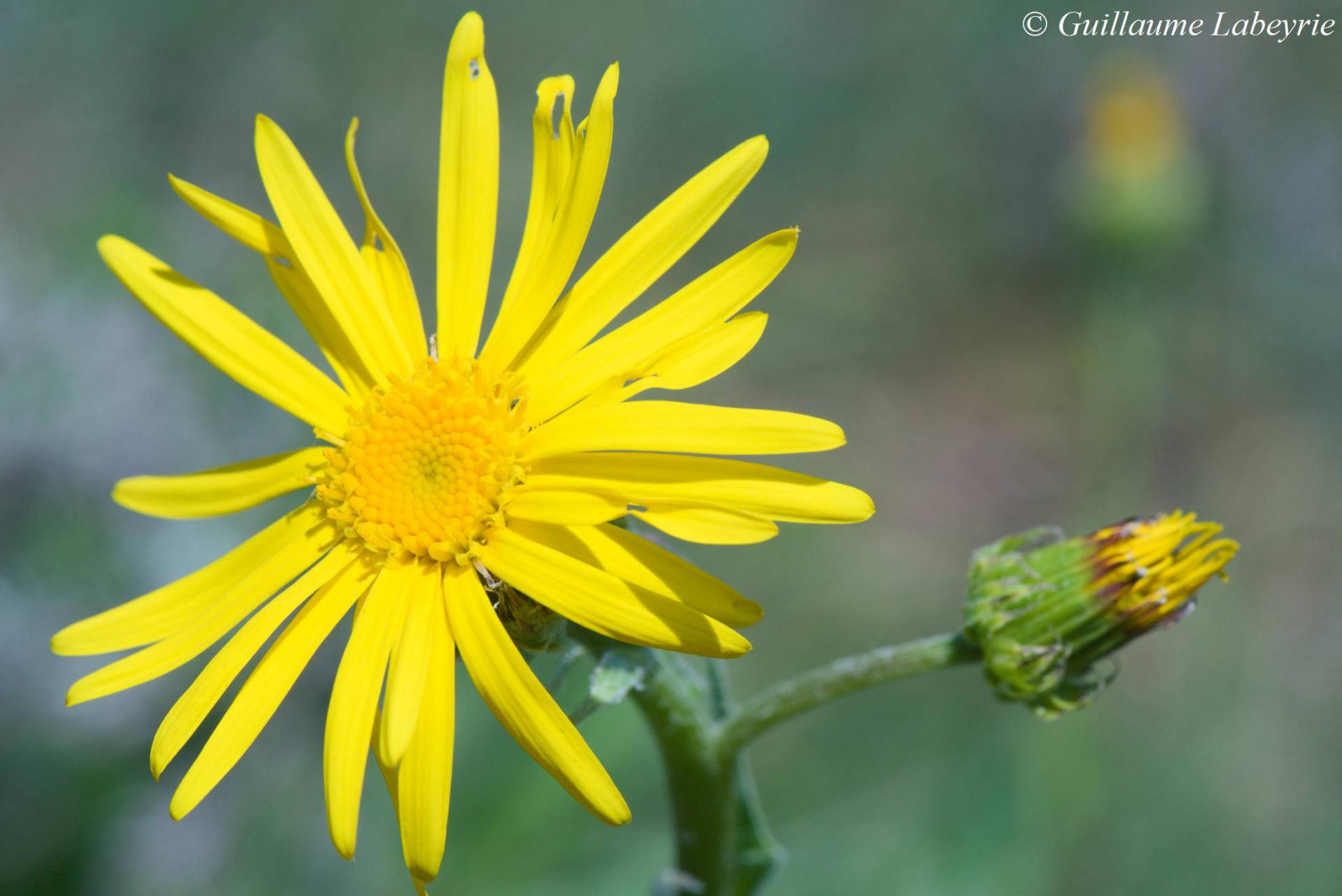
Senecio gerardi. This tall Senecio is quite similar to Senecio doronicum, but its flowers are yellow instead of orange and it is found at lower altitudes. On the plateaus, it is a local species but with sometimes rather large populations. In France, it occurs mainly in the South-East.
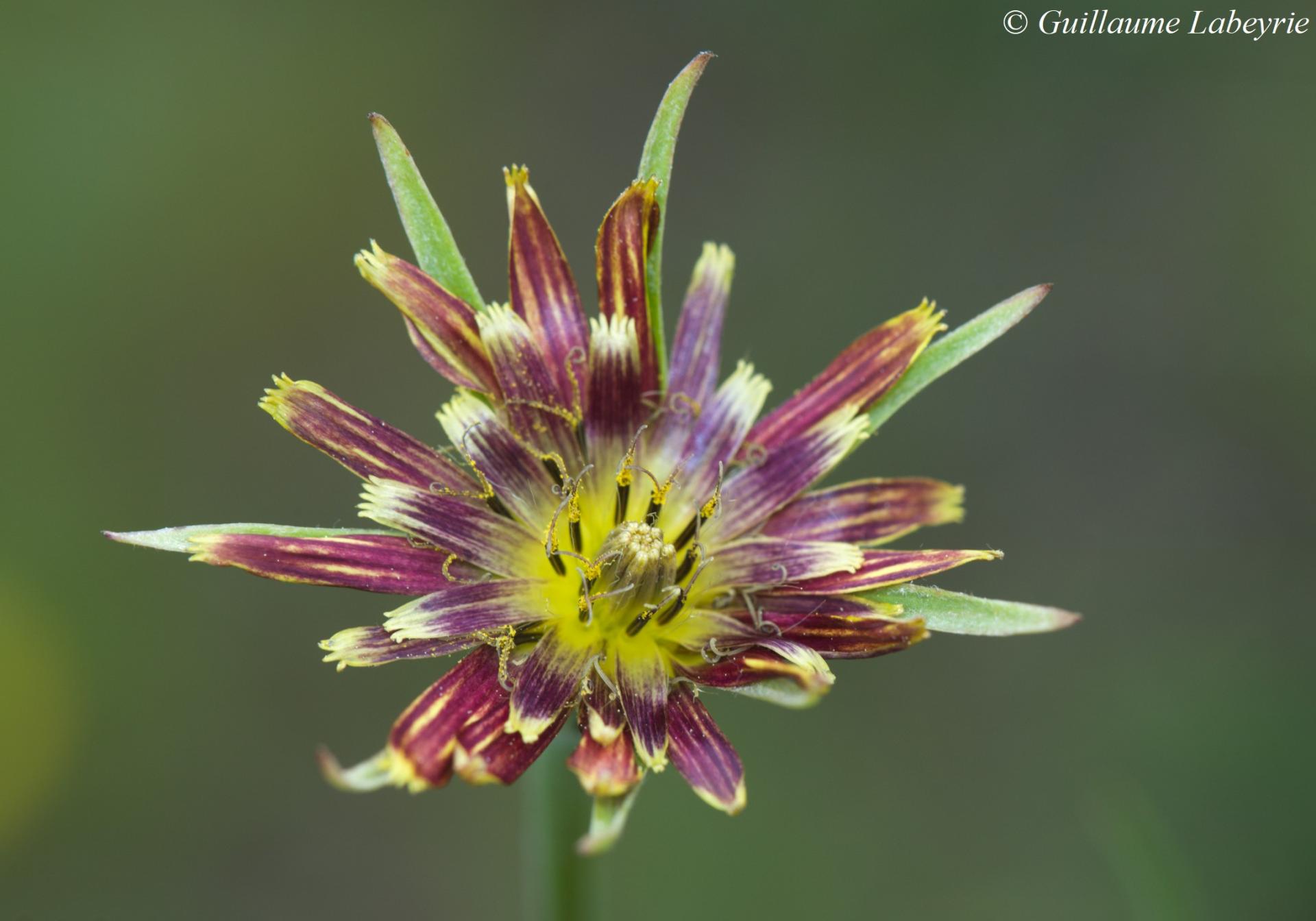
Tragopogon crocifolius. Several species of salsify occur in the Grasse Prealps. This one is the most spectacular, with its red and yellow flowers and very narrow leaves. This species of Mediterranean distribution is found in France in the South.
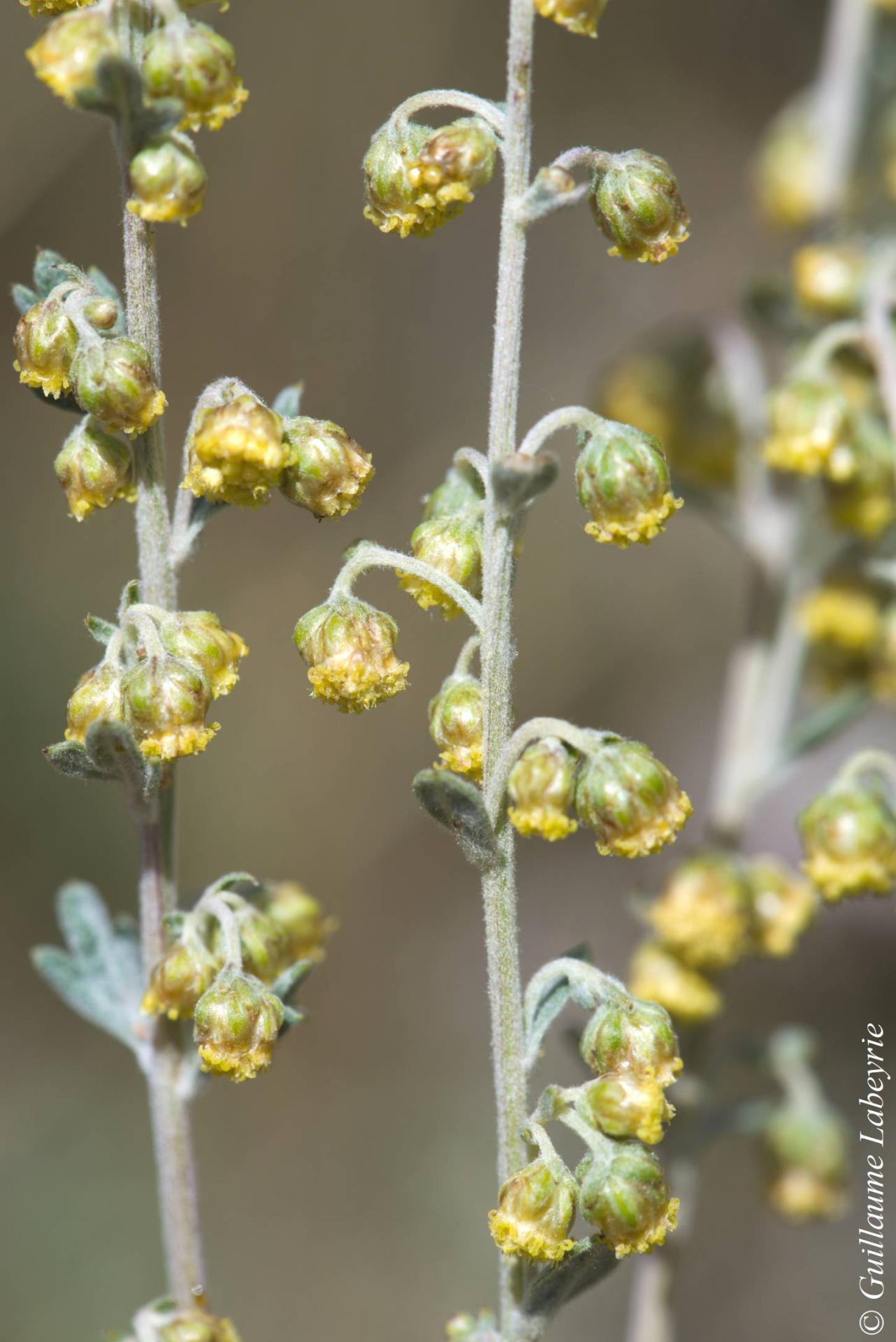
Artemisia armeniaca. This sagebrush is found in rocky steppe grasslands. Very rare in France, it is only known from the Prealps of Grasse, Verdon and a location in Mercantour. It appears on the French red list with the mention “near-threatened”.
Family : Brassicaceae
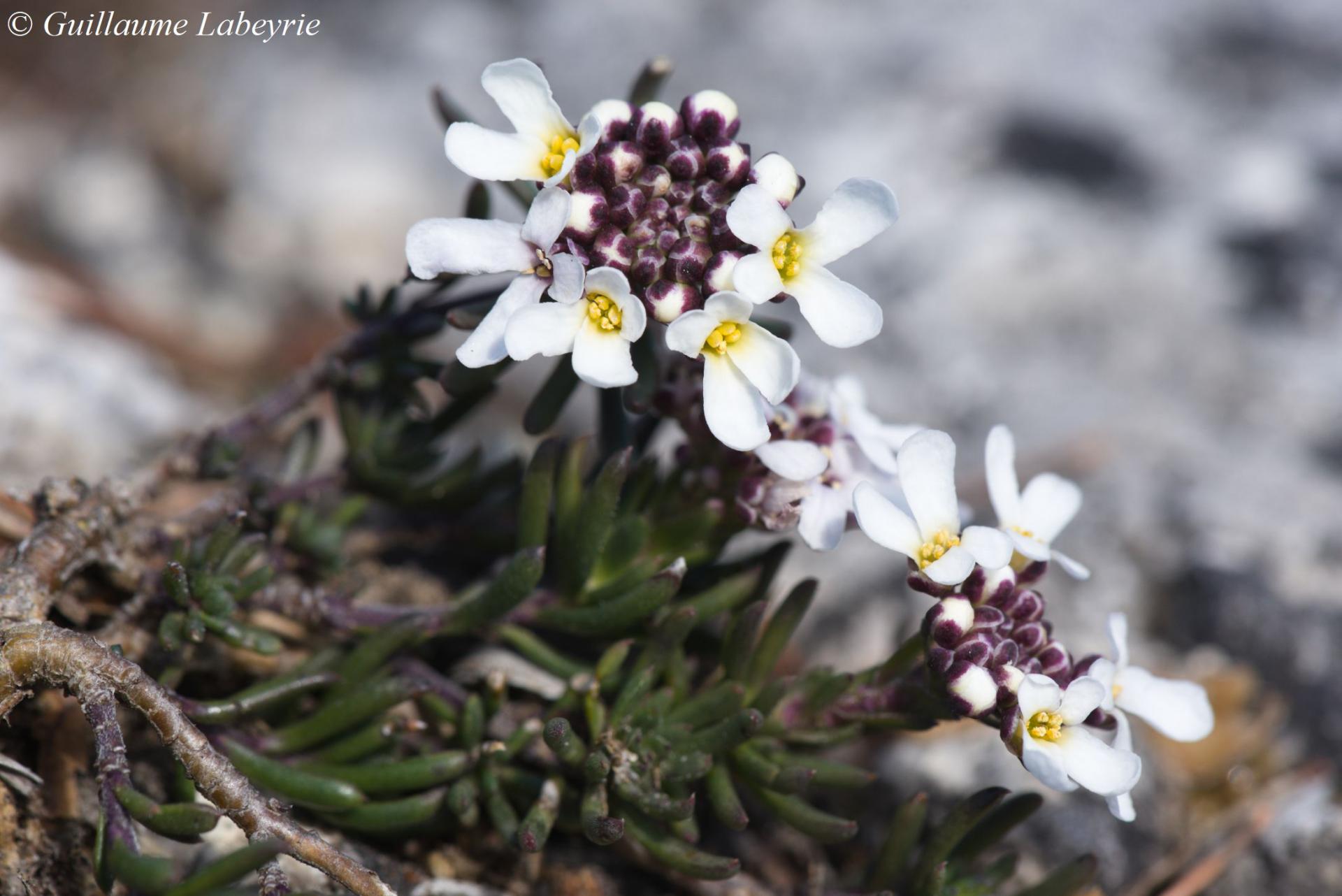
The rock candytuft (Iberis saxatilis). Members of the Iberis genus have characteristic asymmetrical flowers, with the two inner petals shorter than the outer ones. I. saxatilis is a prostrate plant with a woody stem, with white flowers and fleshy, pointed leaves, which distinguishes it from I. sempervirens, with spatulate leaves and occuring at higher altitudes. It appreciates dry rocky areas in mid-mountains. This West European species is present here and there in France, and is protected in the Franche-Comté and Midi-Pyrénées regions.
Family : Caryophyllaceae
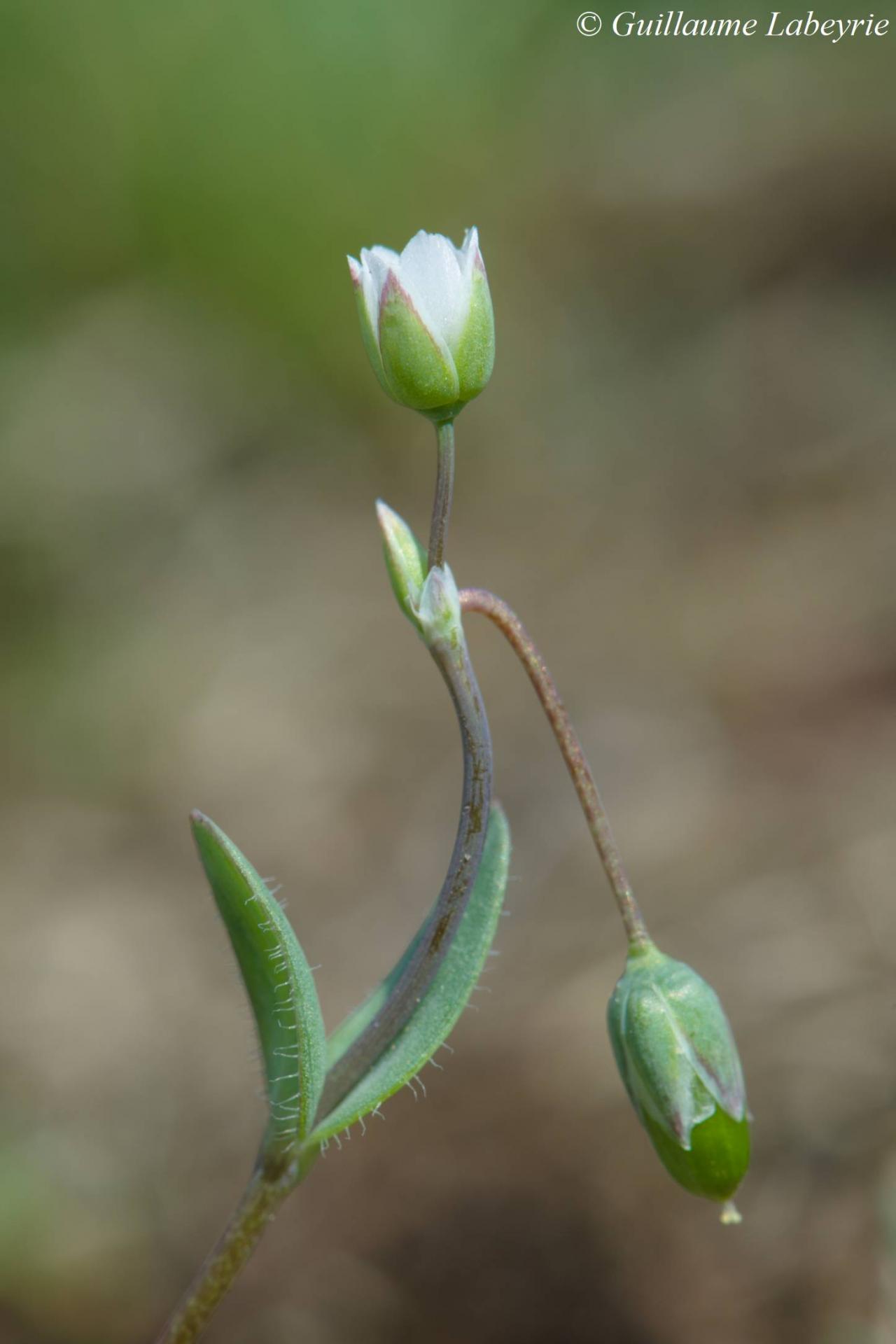 Holosteum breistrofferi. This inconspicuous plant, less than 10 cm tall, has characteristic ciliate leaves. The flower stalks are reflexed after flowering. This rare species, endemic to southeastern France, is found in dry grasslands. It is protected in the PACA region, and listed as "near threatened" by IUCN.
Holosteum breistrofferi. This inconspicuous plant, less than 10 cm tall, has characteristic ciliate leaves. The flower stalks are reflexed after flowering. This rare species, endemic to southeastern France, is found in dry grasslands. It is protected in the PACA region, and listed as "near threatened" by IUCN.
Family : Colchicaceae
 The spring meadow saffron (Colchicum bulbocodium subsp. bulbocodium). This plant flowers in early spring in mountain meadows, quite often mixed with Crocus versicolor with which it should not be confused: its flowers are a uniform purple, and its leaves are short and broad. This species, relatively uncommon, is found in the Pyrenees and the occidental Alps.
The spring meadow saffron (Colchicum bulbocodium subsp. bulbocodium). This plant flowers in early spring in mountain meadows, quite often mixed with Crocus versicolor with which it should not be confused: its flowers are a uniform purple, and its leaves are short and broad. This species, relatively uncommon, is found in the Pyrenees and the occidental Alps.
Family : Fabaceae
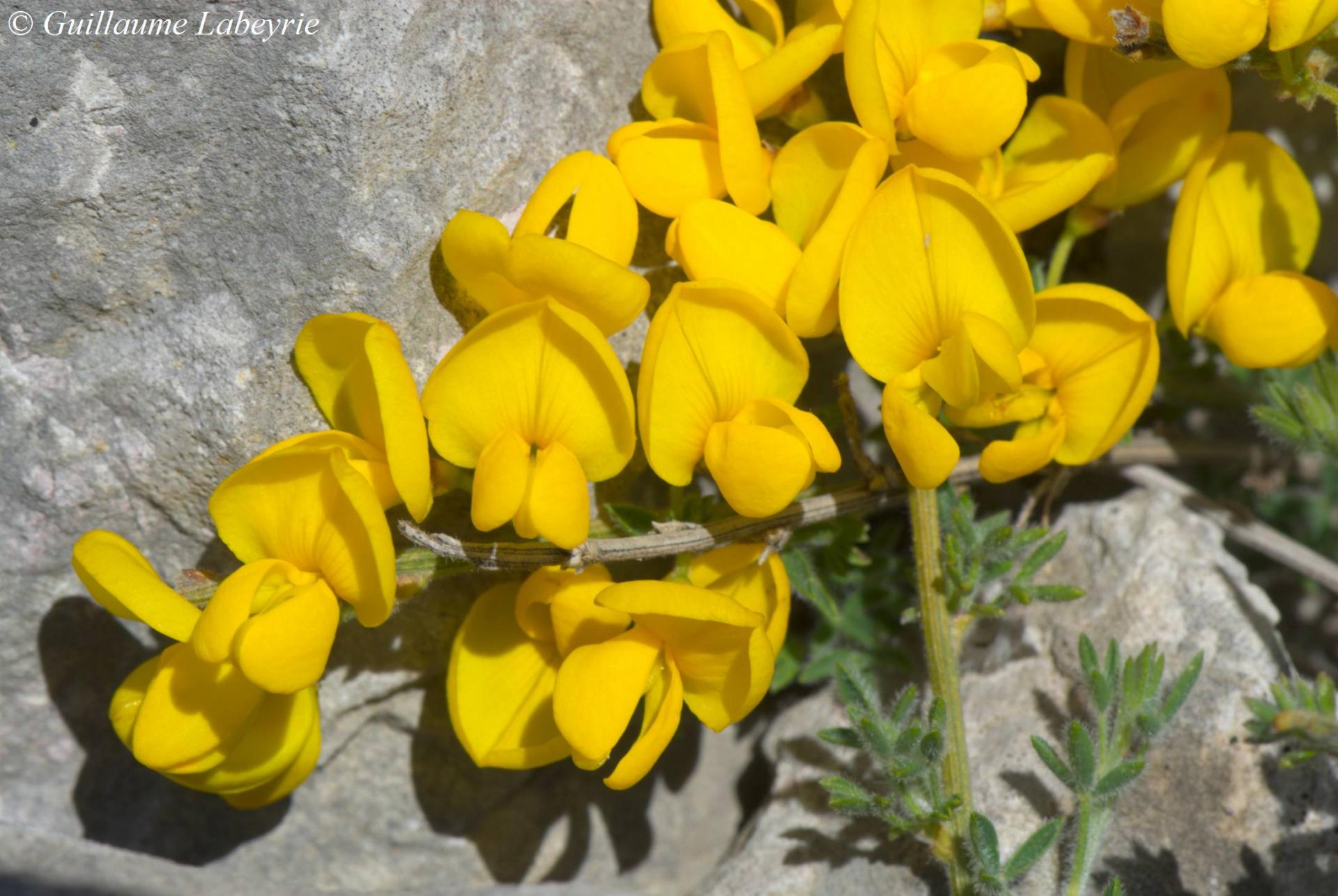 Ardoino's cytisus (Cytisus ardoinoi subsp. ardoinoi). This broom-like low-lying plant is recognizable to its golden yellow flowers, the polyhedral section of its stems, and the leaves divided into three leaflets. It is endemic to the French Alpes-Maritimes, where it is found on the karstic plateaus between 1000 m and 1800 m in altitude. Flowering occurs in May-June. This species is protected in France.
Ardoino's cytisus (Cytisus ardoinoi subsp. ardoinoi). This broom-like low-lying plant is recognizable to its golden yellow flowers, the polyhedral section of its stems, and the leaves divided into three leaflets. It is endemic to the French Alpes-Maritimes, where it is found on the karstic plateaus between 1000 m and 1800 m in altitude. Flowering occurs in May-June. This species is protected in France.
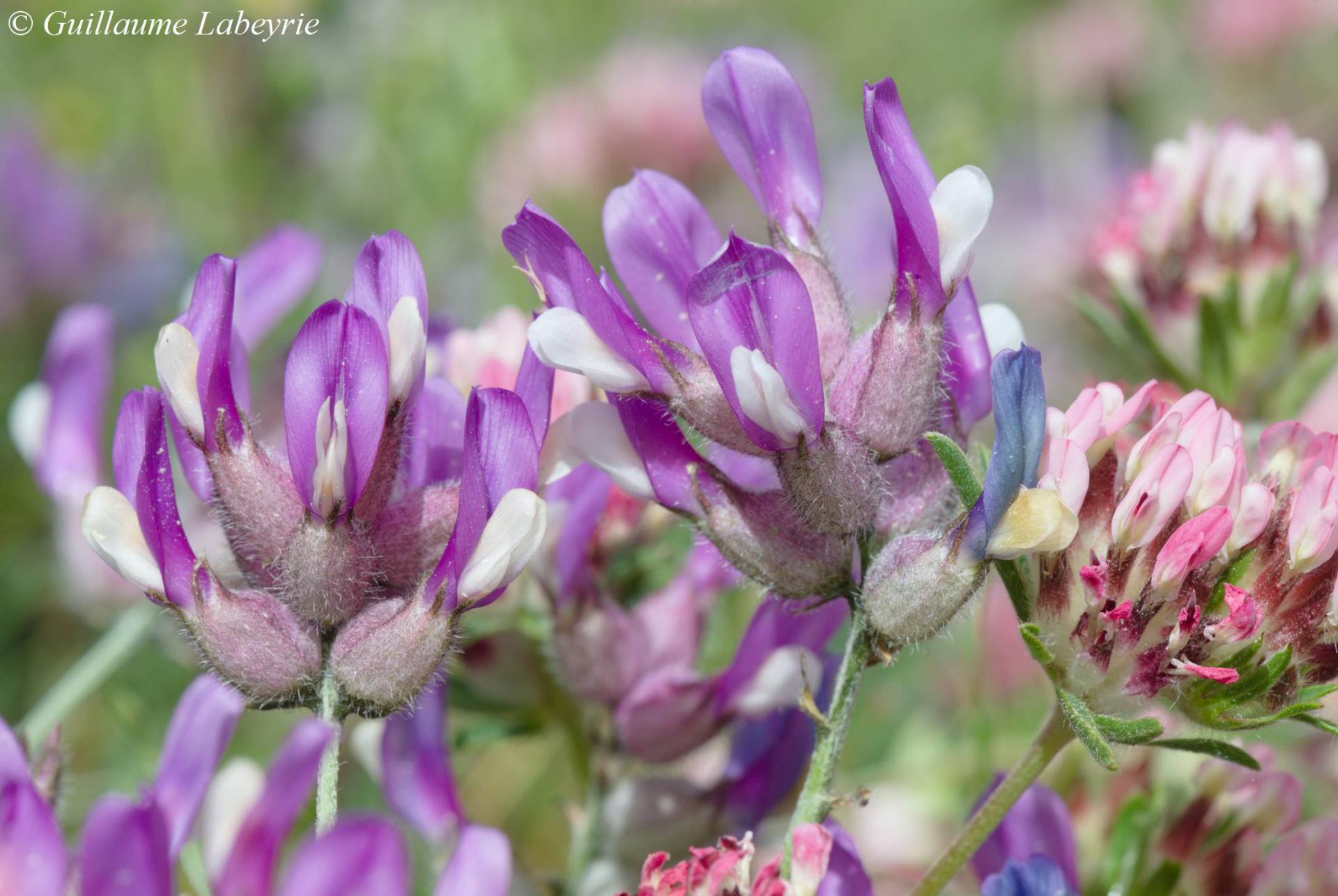 Astragalus vesicarius. This nice species displays bicoloured flowers with a distinctive inflated calyx. The leaves are highly divided and silvery. This plant grows in rocky grasslands. In France, it is found only in the Alps.
Astragalus vesicarius. This nice species displays bicoloured flowers with a distinctive inflated calyx. The leaves are highly divided and silvery. This plant grows in rocky grasslands. In France, it is found only in the Alps.
Family : Iridaceae
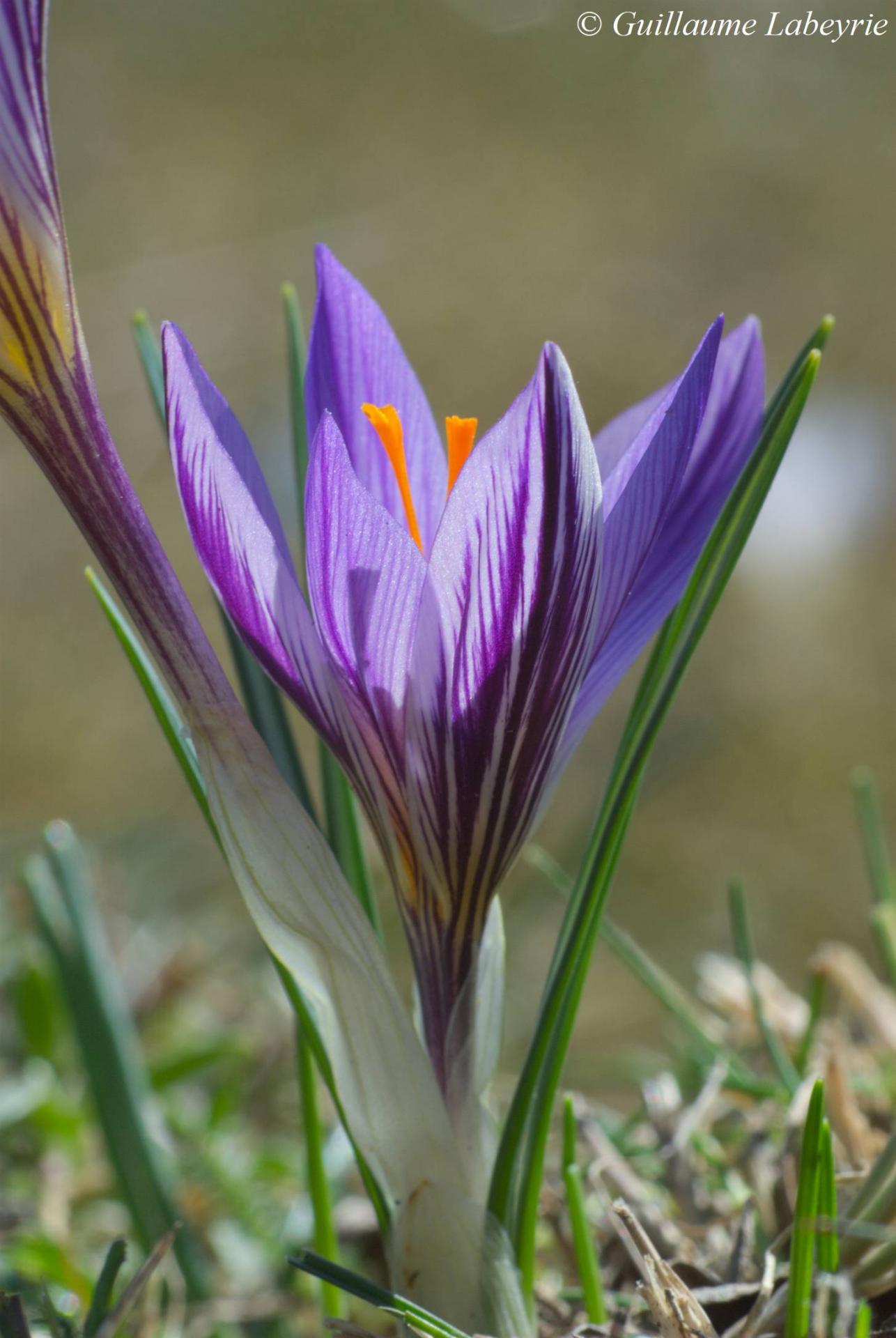 Crocus versicolor. This crocus is generally the first plant to flower on the grasslands of the calcareous plateaus, as early as February. It is identified by its purple or white flowers, with purple stripes on the outside. This Ligurian species is found in southeastern France and northwestern Italy.
Crocus versicolor. This crocus is generally the first plant to flower on the grasslands of the calcareous plateaus, as early as February. It is identified by its purple or white flowers, with purple stripes on the outside. This Ligurian species is found in southeastern France and northwestern Italy.
Family : Lamiaceae
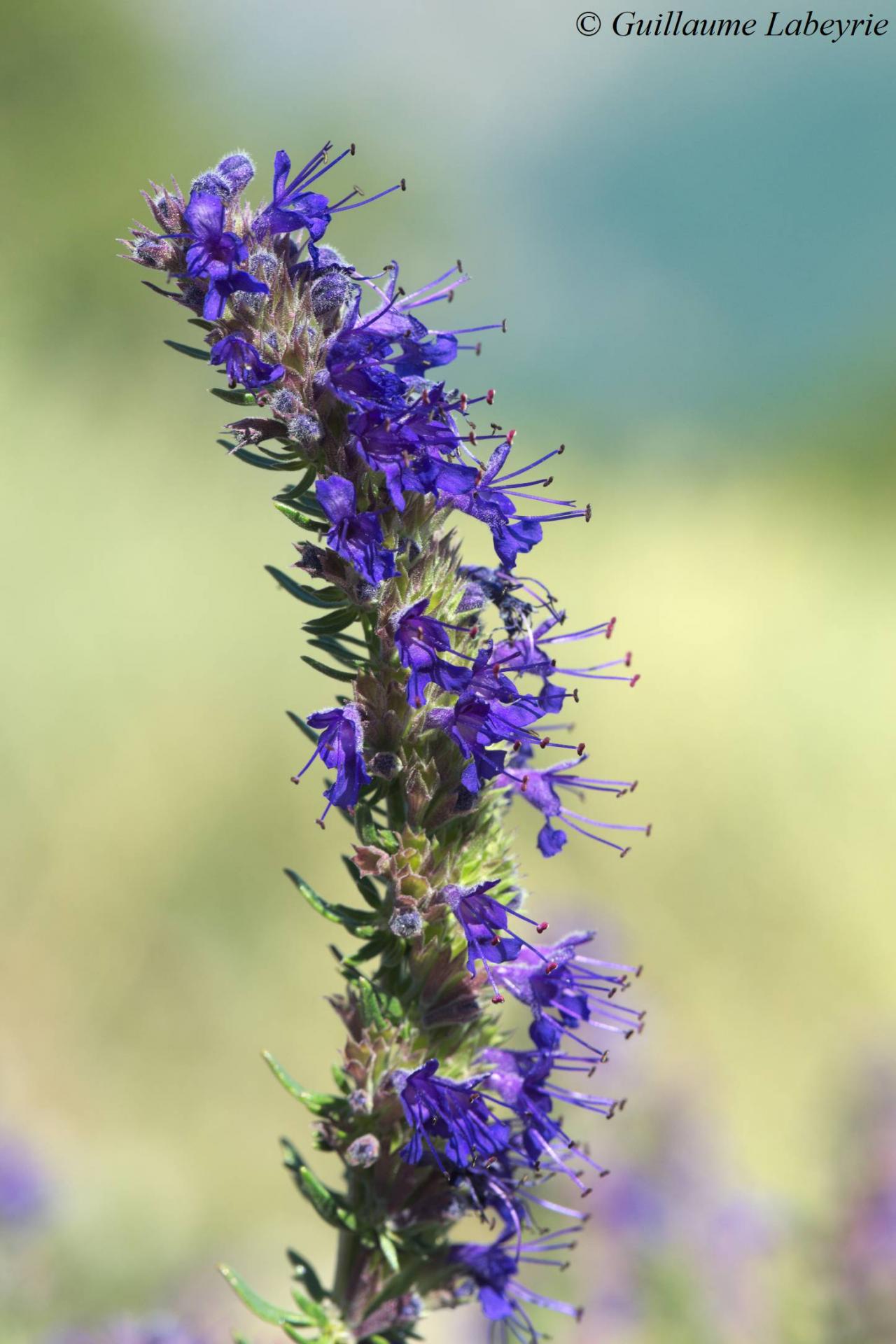 The hyssop (Hyssopus officinalis). This shrub is very similar to the mountain savory (Satureja montana), which often grows in the same locations. Known for its medicinal properties, it is still used in many products including the Provencal "pastis". This plant is usually found in very dry, rocky grasslands. In the Grasse Prealps, it seems rather uncommon and localized. Mostly occuring in France in the southern half, the hyssop ranges from meridional Europe to North Africa and Western Asia.
The hyssop (Hyssopus officinalis). This shrub is very similar to the mountain savory (Satureja montana), which often grows in the same locations. Known for its medicinal properties, it is still used in many products including the Provencal "pastis". This plant is usually found in very dry, rocky grasslands. In the Grasse Prealps, it seems rather uncommon and localized. Mostly occuring in France in the southern half, the hyssop ranges from meridional Europe to North Africa and Western Asia.
Family : Liliaceae
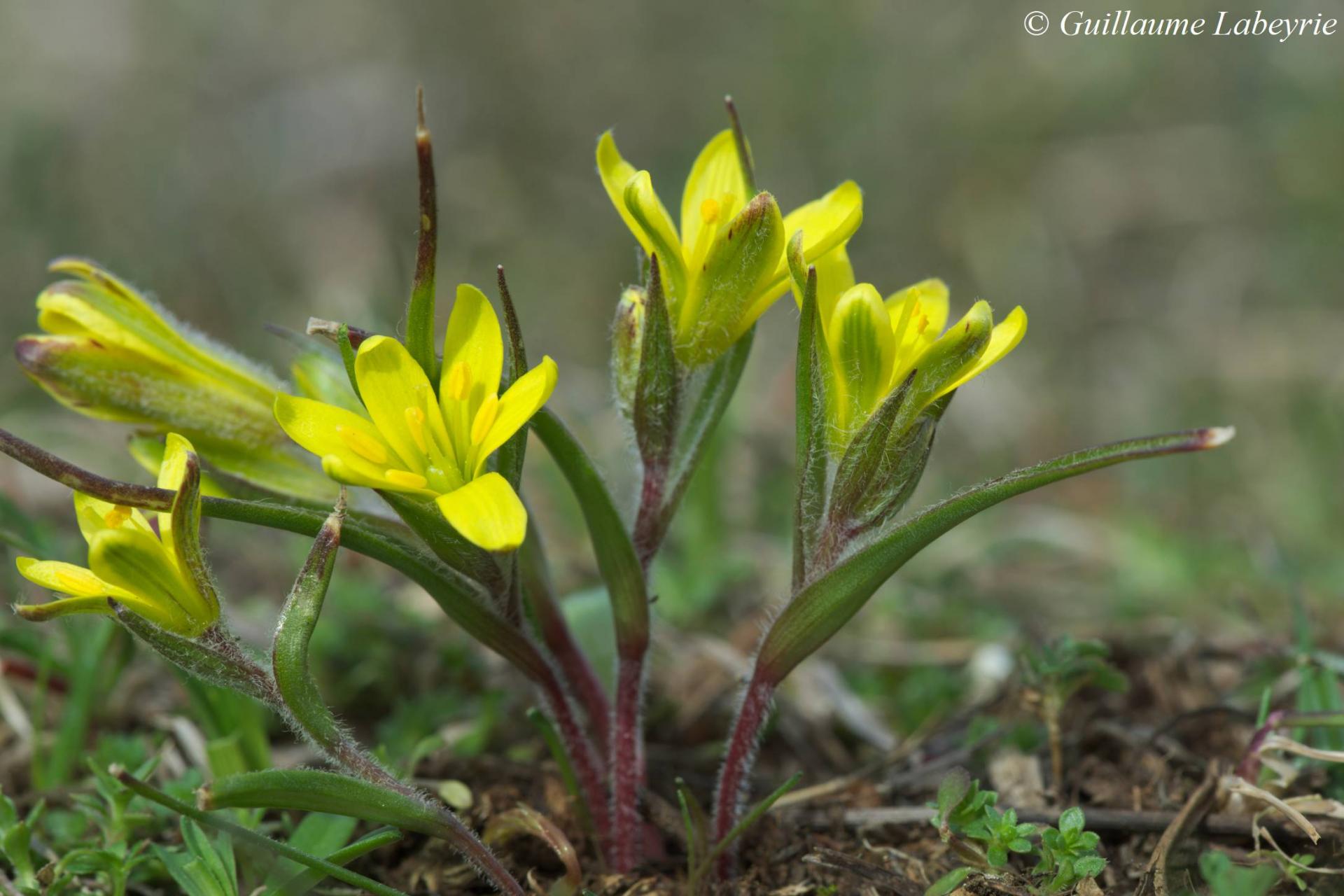 The early star-of-Bethlehem (Gagea bohemica). This tiny plant from the Liliaceae family is among the first plants to flower, as early as February-March, in the karst grassy areas. This species has very short stems and comparatively large yellow flowers. The basal leaves are very narrow, while those on the stem are lanceolate. The key feature for identification is the long hairs covering the flower stalks. In France, this species is mainly present in the south-east, and fully protected. Three other protected species of Gagea also occur in the same habitat (G. arvensis, G. pratensis, G. reverchonii).
The early star-of-Bethlehem (Gagea bohemica). This tiny plant from the Liliaceae family is among the first plants to flower, as early as February-March, in the karst grassy areas. This species has very short stems and comparatively large yellow flowers. The basal leaves are very narrow, while those on the stem are lanceolate. The key feature for identification is the long hairs covering the flower stalks. In France, this species is mainly present in the south-east, and fully protected. Three other protected species of Gagea also occur in the same habitat (G. arvensis, G. pratensis, G. reverchonii).
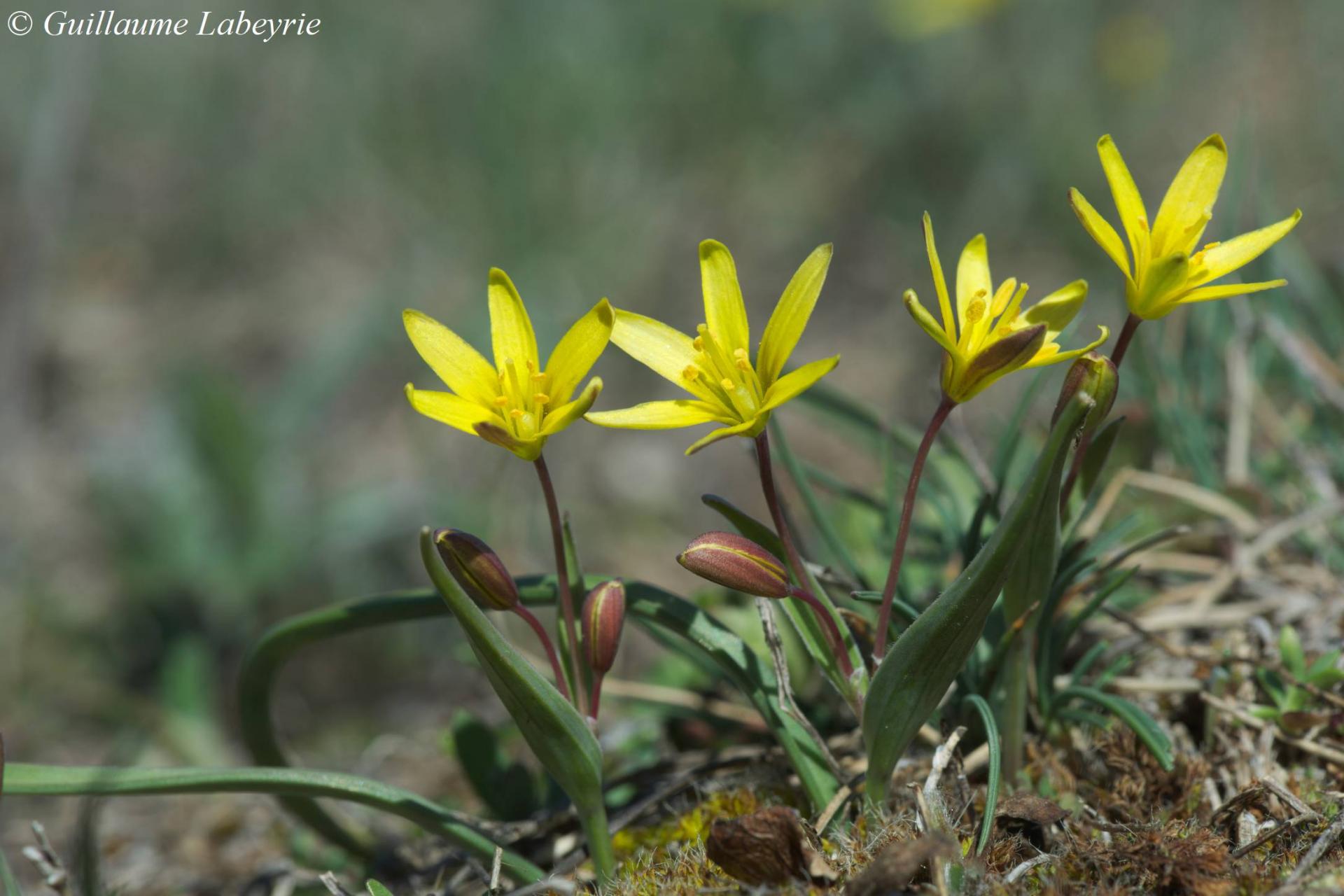 Burnat's star-of-Bethlehem (Gagea reverchonii). This species is sometimes found together with the previous one, in rocky grasslands in spring. It is identified by its rather broad leaves, and its small flowers with a reddish color of the outer parts. The flowers stalks are hairless. Gagea reverchonii is found mainly in the south-east of France.
Burnat's star-of-Bethlehem (Gagea reverchonii). This species is sometimes found together with the previous one, in rocky grasslands in spring. It is identified by its rather broad leaves, and its small flowers with a reddish color of the outer parts. The flowers stalks are hairless. Gagea reverchonii is found mainly in the south-east of France.
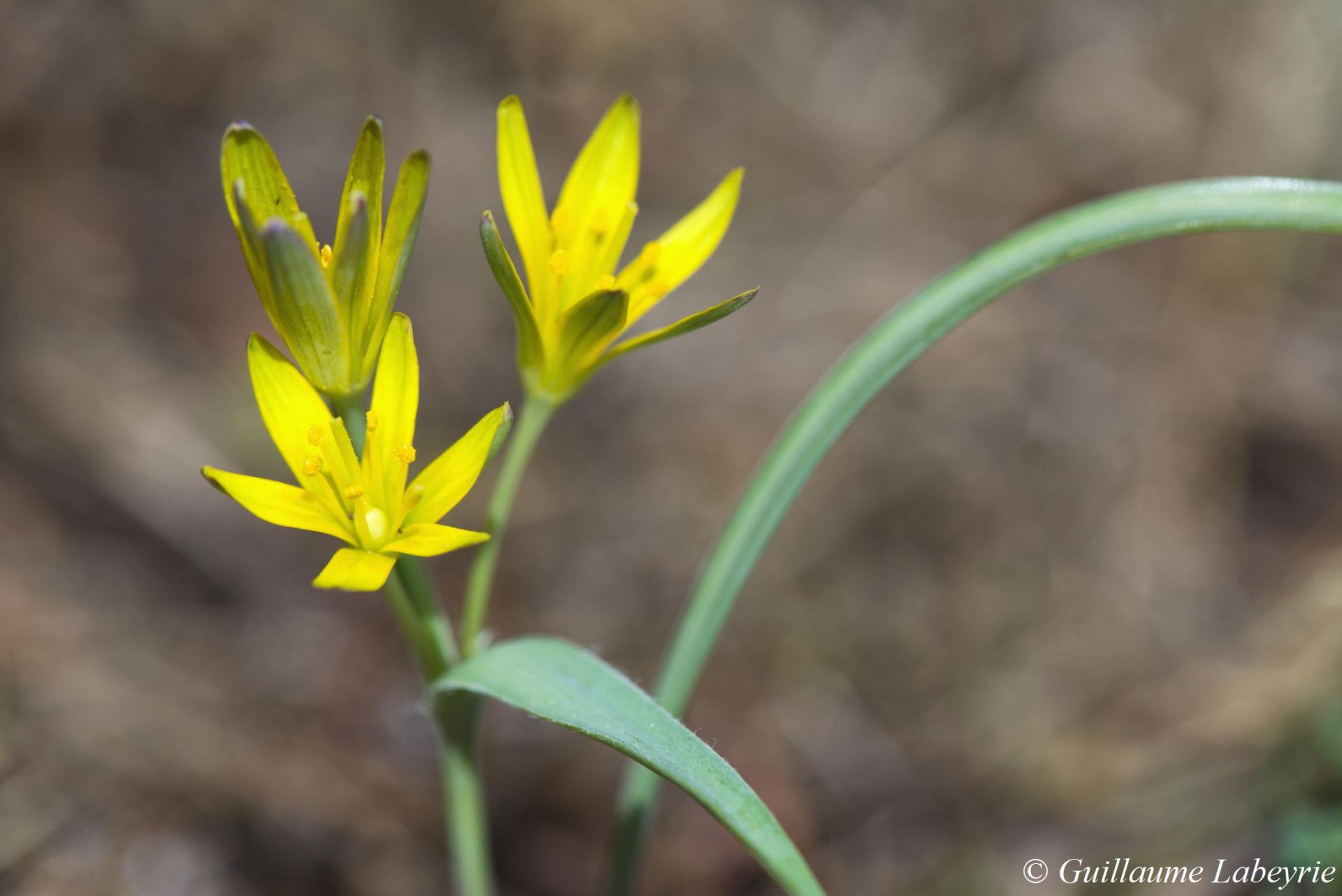
The yellow star-of-Bethlehem (Gagea pratensis). This third species of Gagea is sometimes found in mixed populations with the previous one. It has long and narrow leaves, and larger flowers (2 cm in diameter) with green-tinted outer parts. It occurs in Europe, but is becoming rare in mainy areas due to habitat loss. In France, it is fully protected.
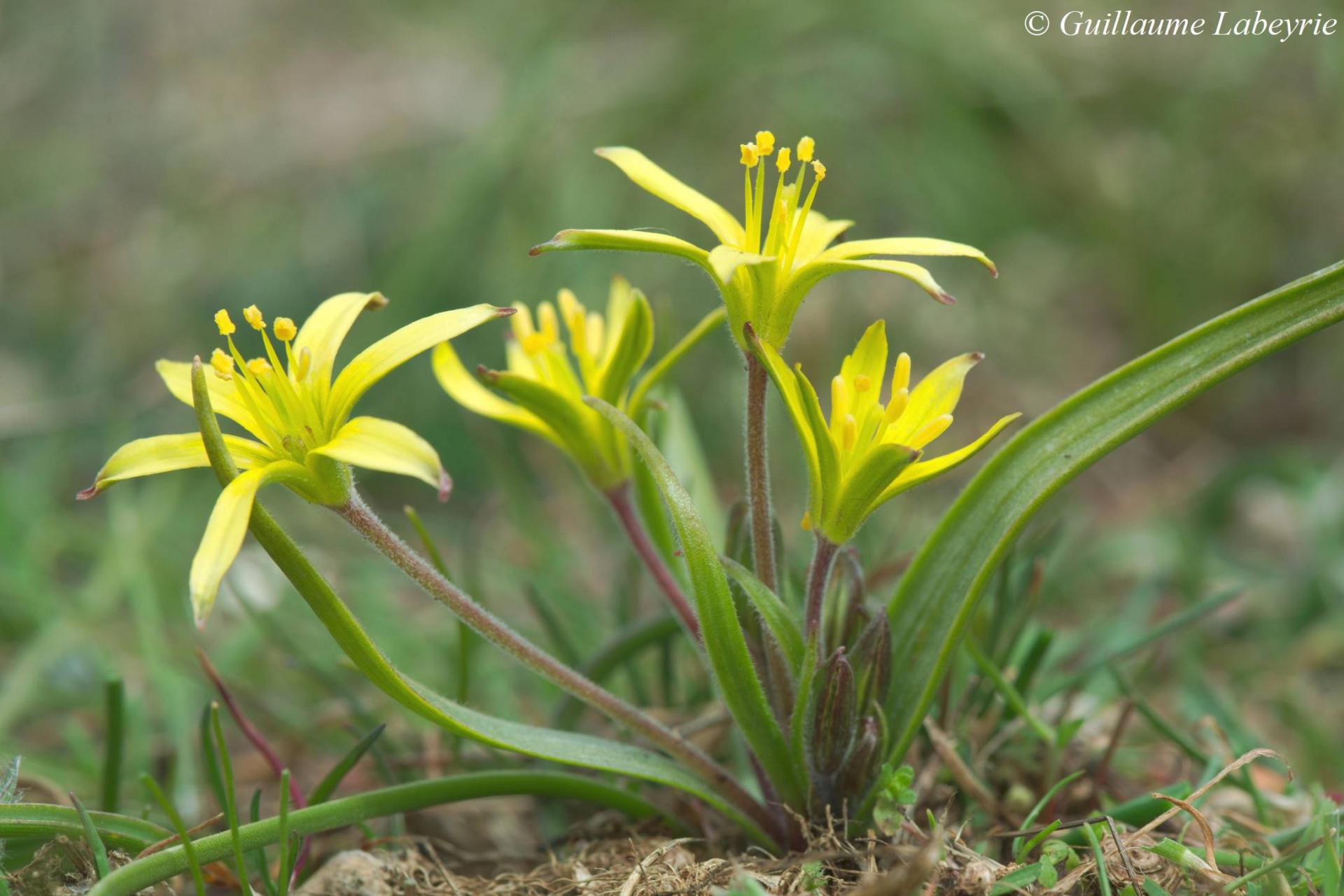 The hairy star-of-Bethlehem (Gagea villosa). This species has hairy flower stalks as Gagea saxatilis, but these hairs are short and dense. Gagea villosa is found in fields, wineyards and calcareous grasslands. Occuring in France in the eastern half, it is fully protected.
The hairy star-of-Bethlehem (Gagea villosa). This species has hairy flower stalks as Gagea saxatilis, but these hairs are short and dense. Gagea villosa is found in fields, wineyards and calcareous grasslands. Occuring in France in the eastern half, it is fully protected.
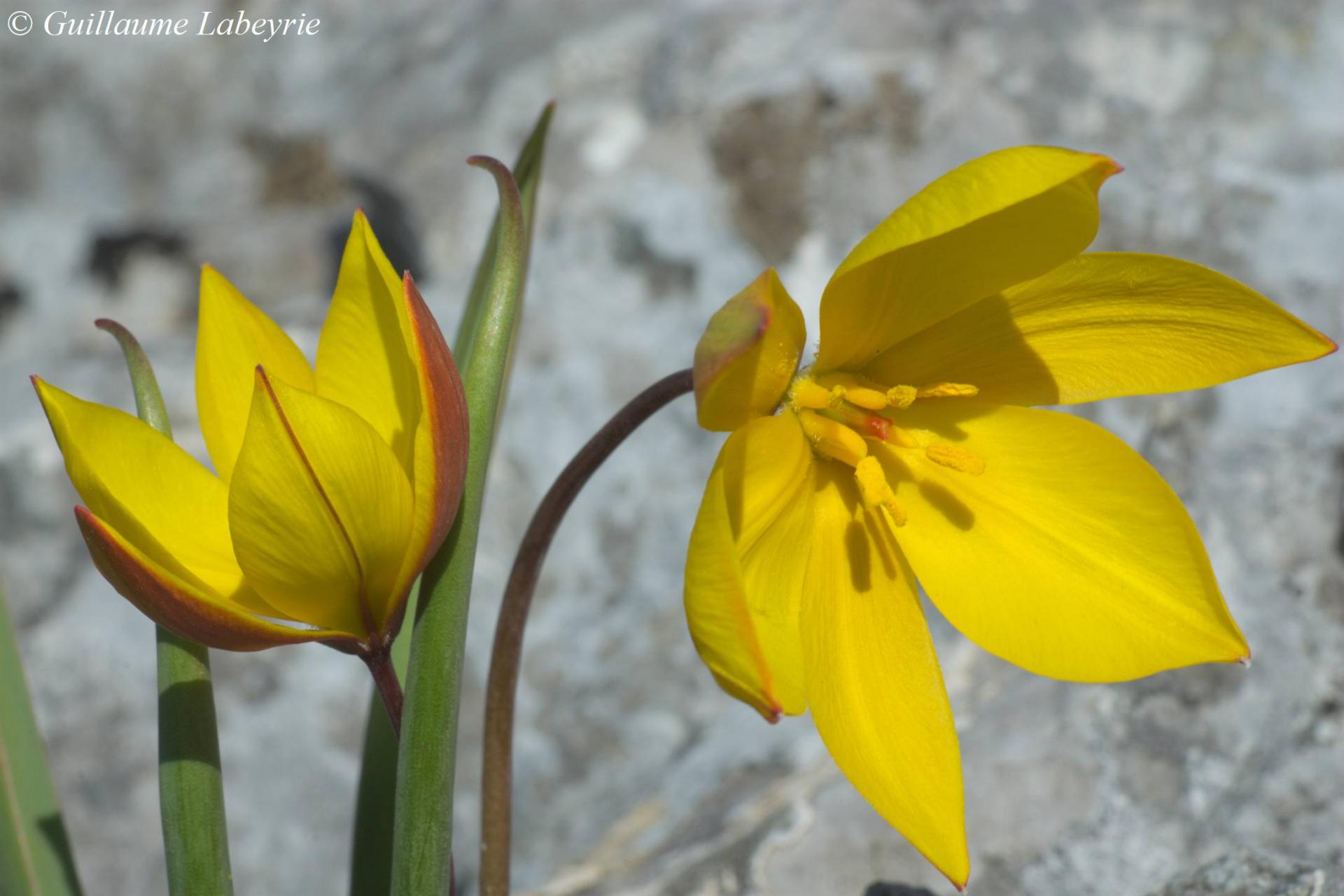 Wild tulip (Tulipa sylvestris subsp. australis). This nice tulip is recognized by the orange color of the outside of the tepals. This is a sub-mediterranean low mountain species, flowering in April in rocky meadows and cracks of the karst. A closely related species (Tulipa sylvestris subsp. sylvestris), with all-yellow flowers, is much scarcer in the Alpes-Maritimes.
Wild tulip (Tulipa sylvestris subsp. australis). This nice tulip is recognized by the orange color of the outside of the tepals. This is a sub-mediterranean low mountain species, flowering in April in rocky meadows and cracks of the karst. A closely related species (Tulipa sylvestris subsp. sylvestris), with all-yellow flowers, is much scarcer in the Alpes-Maritimes.
Family : Orchidaceae
Orchids are fascinating plants, with a stunning diversity of shapes and colors. The Alpes-Maritimes are among the richest French departments in terms of number of orchids species, most of which are found in the Mediterranean zone (see the "Provence-Alpes-Côte d'Azur" section for some examples). However, some species are typical of low mountains:
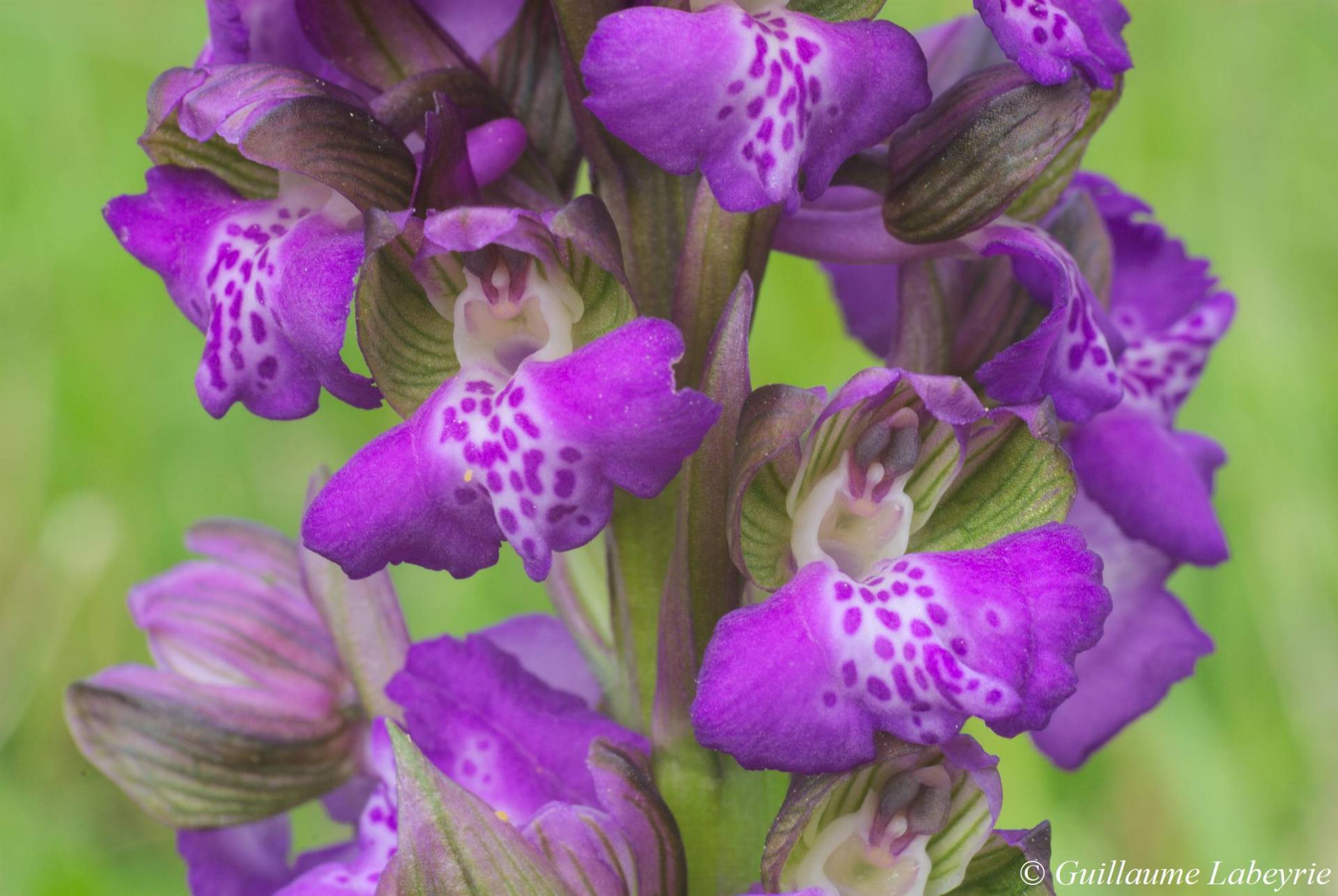 The green-winged orchid (Anacamptis morio subsp. morio). This orchid is easily recognizable to its violet flowers with green veins in the perianth. In southern France, this is a mountain species which grows in grasslands on calcareous plateaus, where it can form large populations. A closely-related subspecies, Anacamptis morio subsp. picta, is found at low altitude in siliceous Mediterranean scrub. This species, with a wide distribution ranging from Europe to Iran, is found in most of the French territory.
The green-winged orchid (Anacamptis morio subsp. morio). This orchid is easily recognizable to its violet flowers with green veins in the perianth. In southern France, this is a mountain species which grows in grasslands on calcareous plateaus, where it can form large populations. A closely-related subspecies, Anacamptis morio subsp. picta, is found at low altitude in siliceous Mediterranean scrub. This species, with a wide distribution ranging from Europe to Iran, is found in most of the French territory.
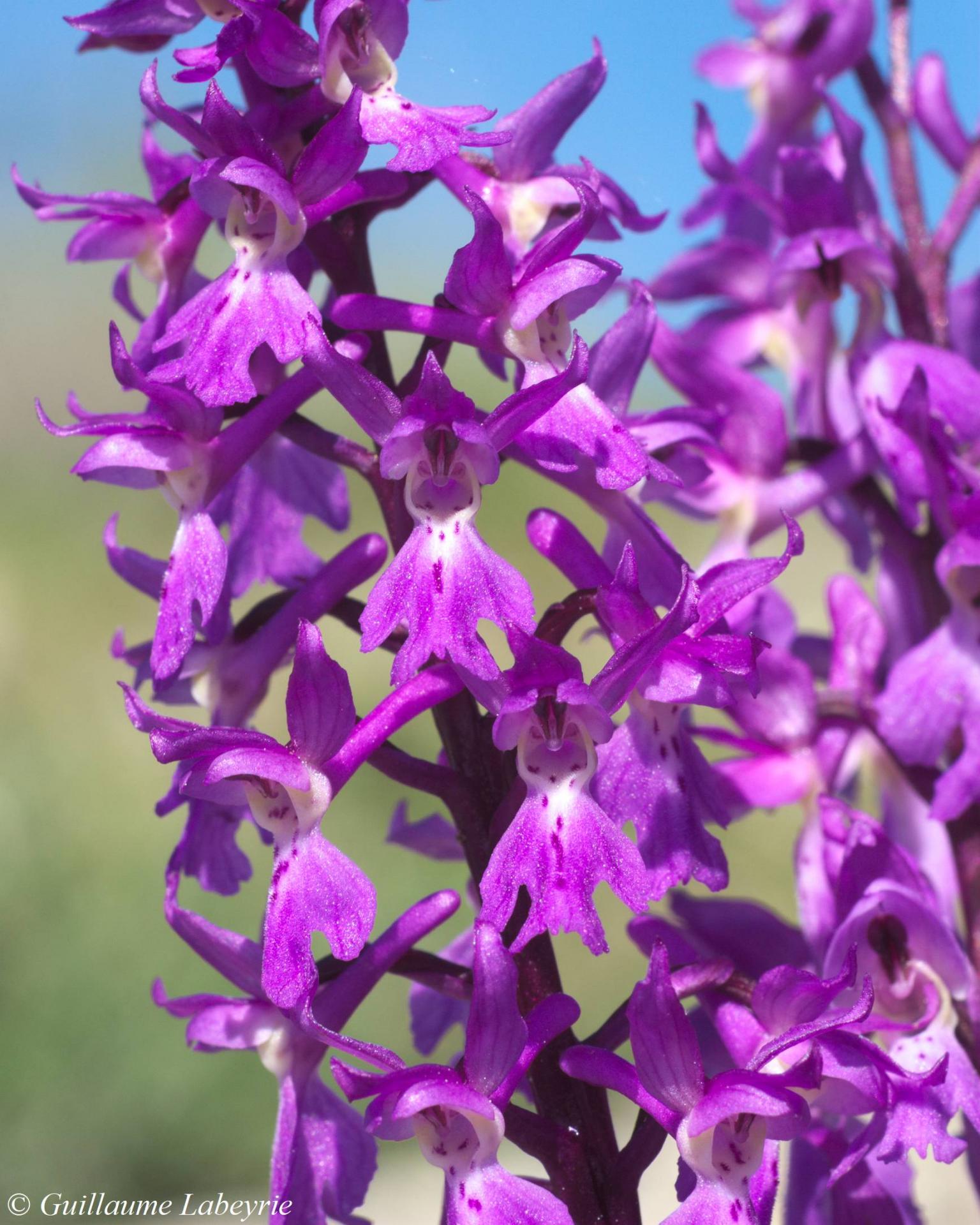
Orchis mascula subsp. speciosa. This orchid with characteristic pink flowers is found in the Prealps in rocky grasslands on the calcareous plateaus, sometimes in very large numbers. Flowering occurs in April and May. This species is close to the early purple orchid (Orchis mascula subsp. mascula), but differs by its divided labellum, its petals that are pointed forward, and the leaves and base of the stem that are very finely spotted with red (no black spots on the leaves). This species's range is restricted to mountains in southeastern France.
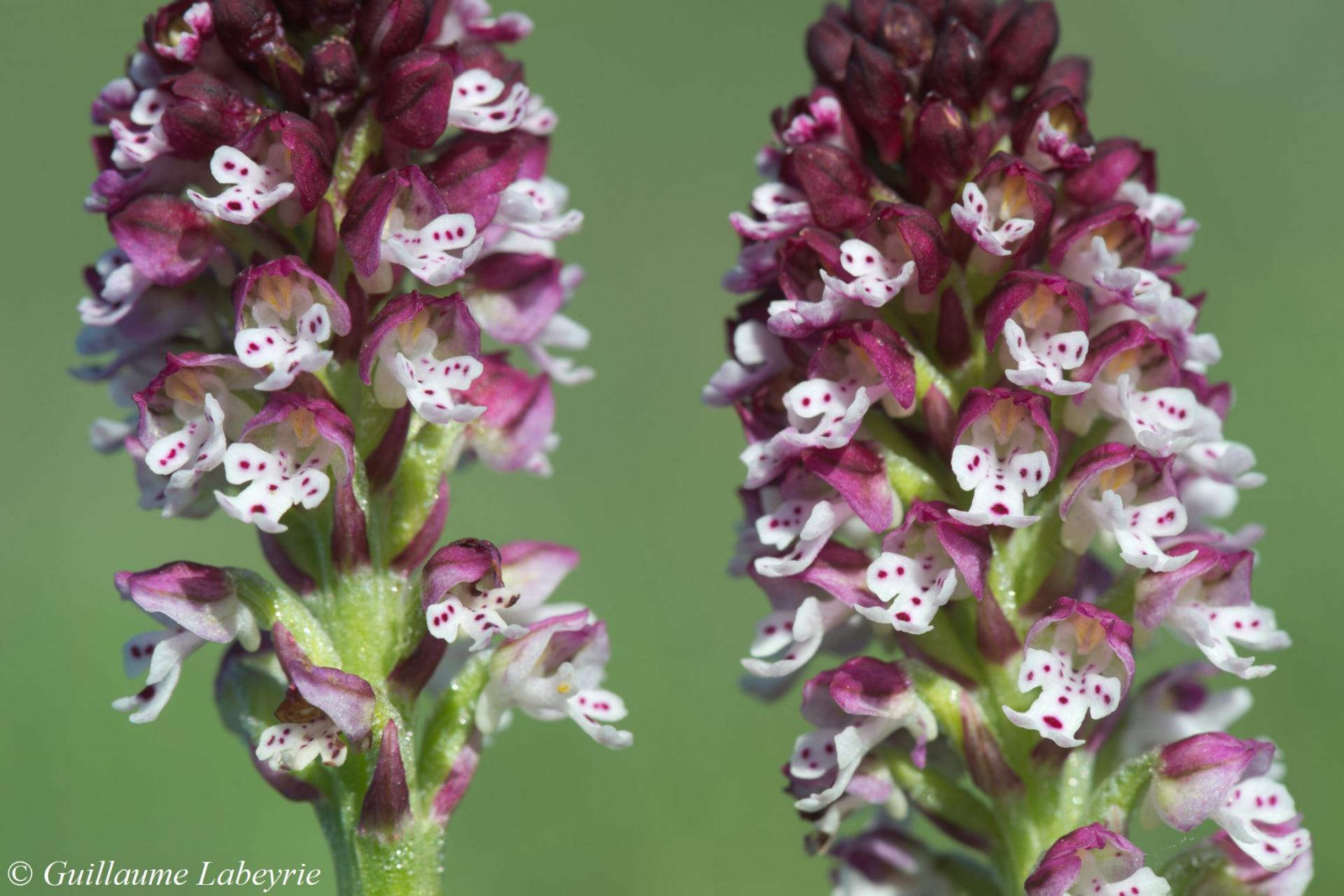 The burnt orchid (Neotinea ustulata). This orchid is also easy to identify, with the reddish-brown color of the flower's hood contrasting with the spotted labellum. It is common in the grasslands of the calcareous plateaus in the Prealps. Present in most of France, the burnt orchid is rare in the Mediterranean where it is found in mountains.
The burnt orchid (Neotinea ustulata). This orchid is also easy to identify, with the reddish-brown color of the flower's hood contrasting with the spotted labellum. It is common in the grasslands of the calcareous plateaus in the Prealps. Present in most of France, the burnt orchid is rare in the Mediterranean where it is found in mountains.
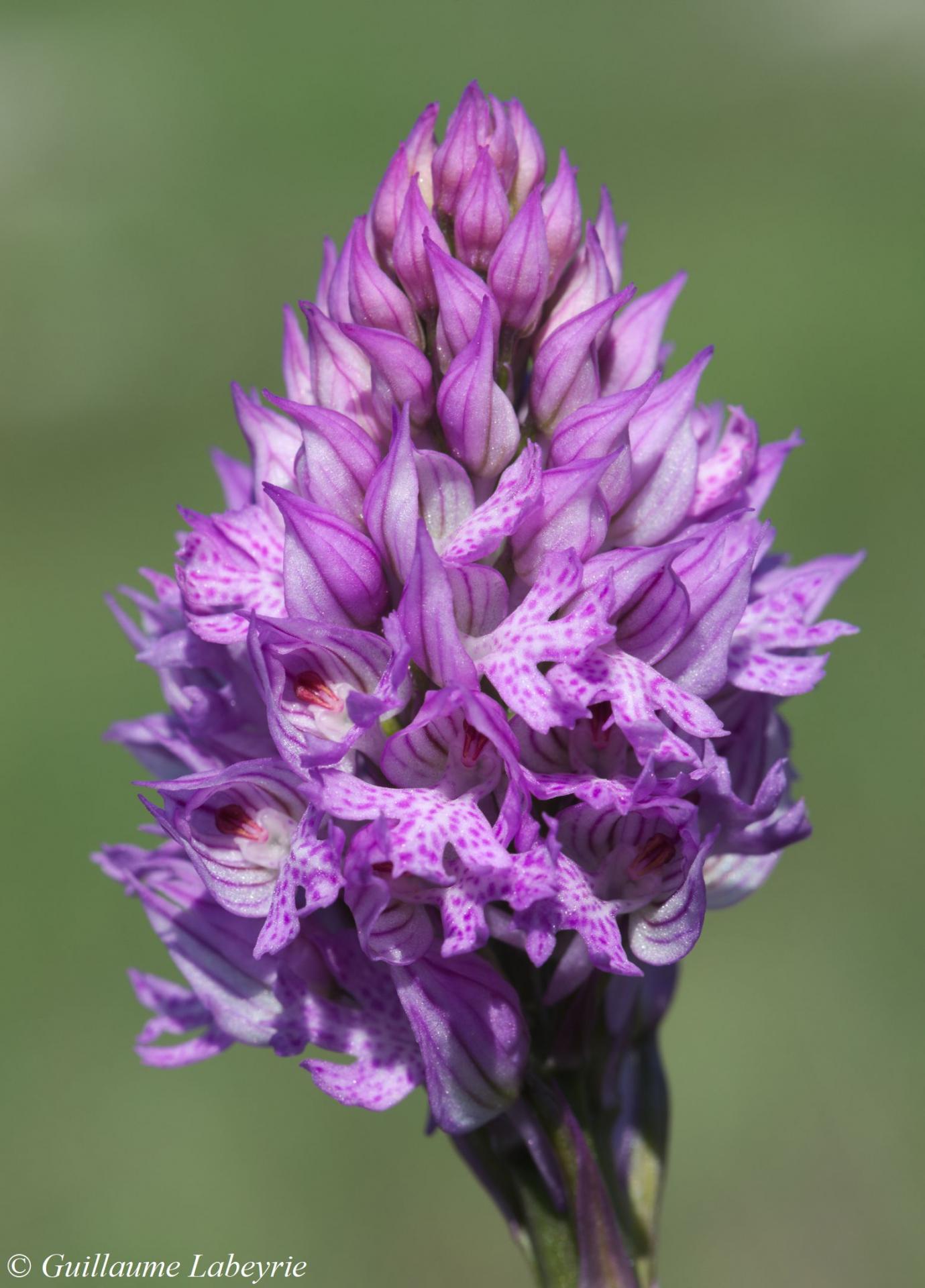 The three-toothed orchid (Neotinea tridentata). This lovely species has typical pink flowers, with a spotted labellum divided in three lobes of equal size. It is quite common in the Prealps, where it occupies the same habitat has the burnt orchid. The two frequently hybridize (see below). Mostly mediterranean, this plant occurs in France in a south-east third of the territory.
The three-toothed orchid (Neotinea tridentata). This lovely species has typical pink flowers, with a spotted labellum divided in three lobes of equal size. It is quite common in the Prealps, where it occupies the same habitat has the burnt orchid. The two frequently hybridize (see below). Mostly mediterranean, this plant occurs in France in a south-east third of the territory.
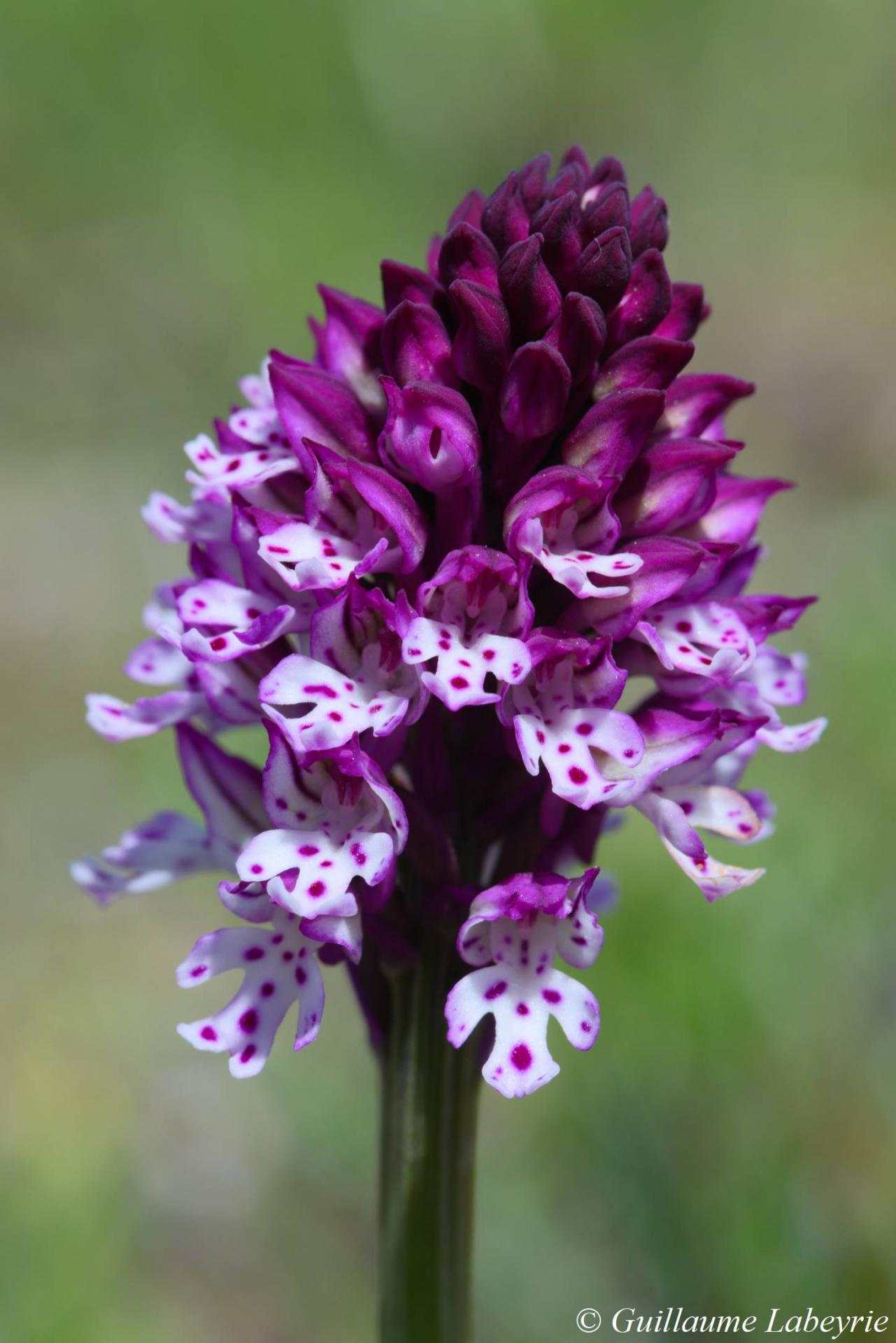
Neotinea x dietrichiana. This hybrid between the two previous species is the most common orchid hybrid in the area. The shape of the flowers is that of N. ustulata but the color is purple instead of brownish. The size of the plant and shape of the flower spike are that of N. tridentata.
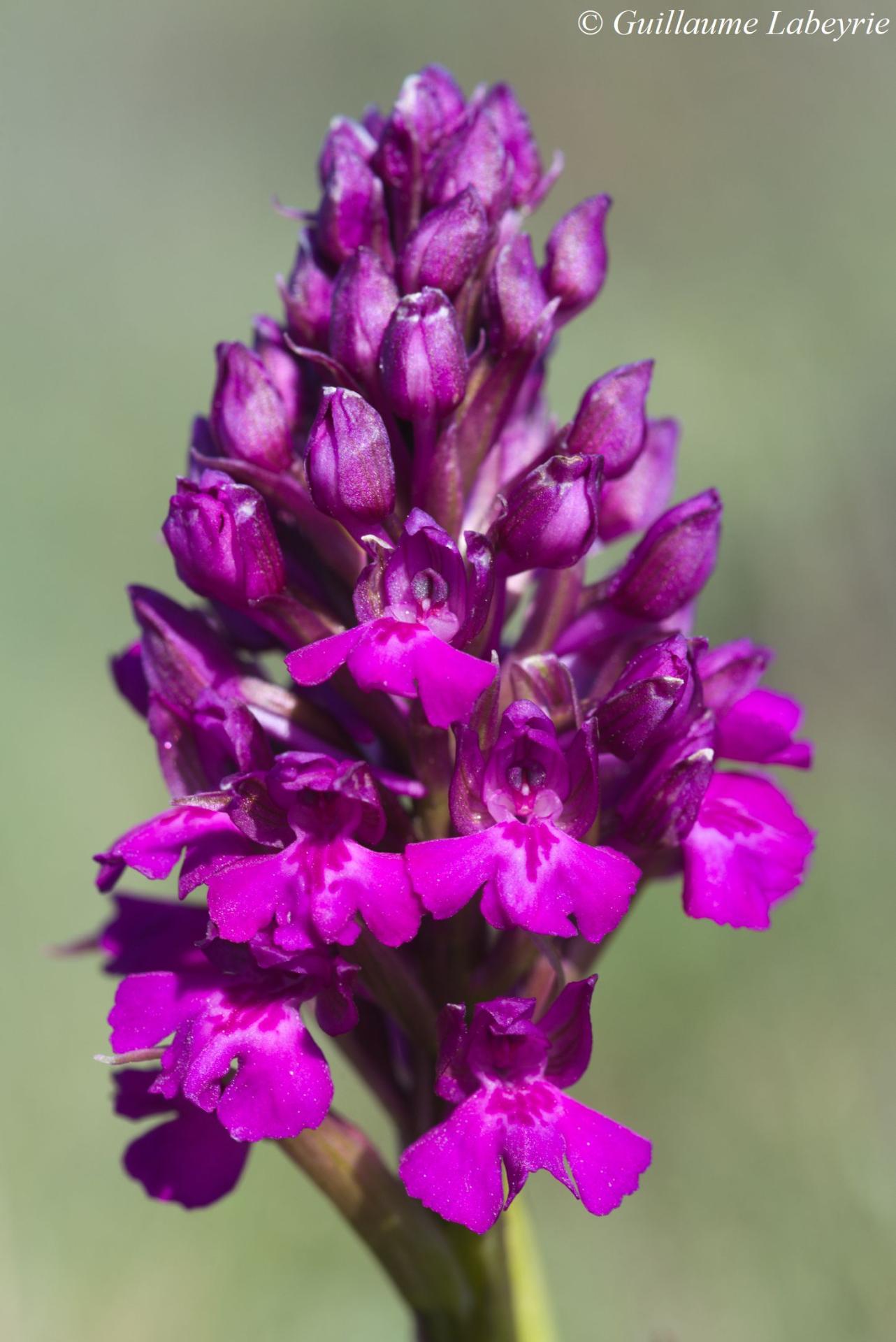
Neotinea x lannicae. This other hybrid is much rarer than the previous one. It is an hybrid between the green-winged orchid (Anacamptis morio subsp. morio) and the pyramidal orchid (Anacamptis pyramidalis).
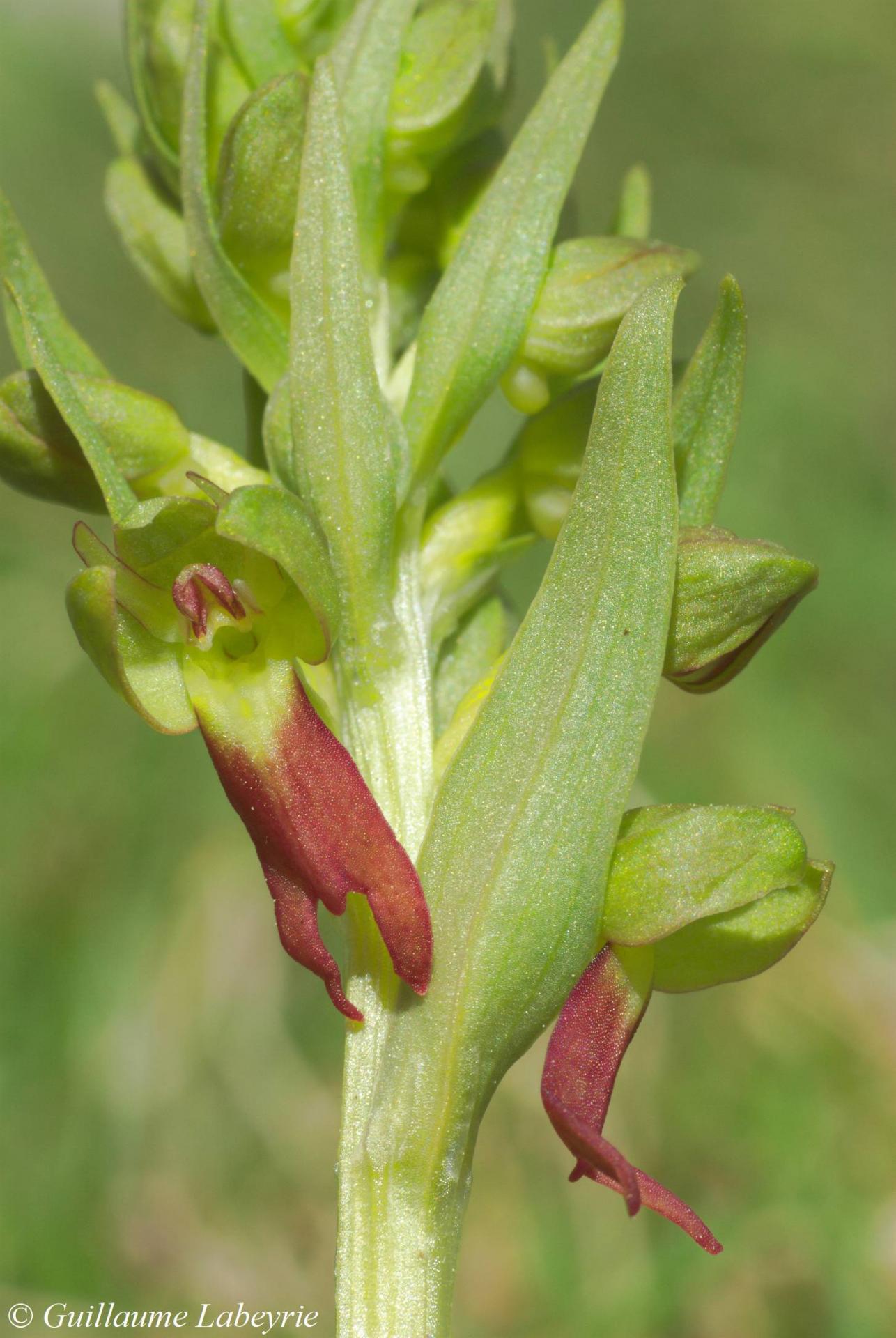 The frog orchid (Dactylorhiza viridis). This inconspicuous orchid grows in mountain meadows. It is found in most of Europe (excluding the Mediterranean basin) and northern America. The color of the labellum varies from green to red.
The frog orchid (Dactylorhiza viridis). This inconspicuous orchid grows in mountain meadows. It is found in most of Europe (excluding the Mediterranean basin) and northern America. The color of the labellum varies from green to red.
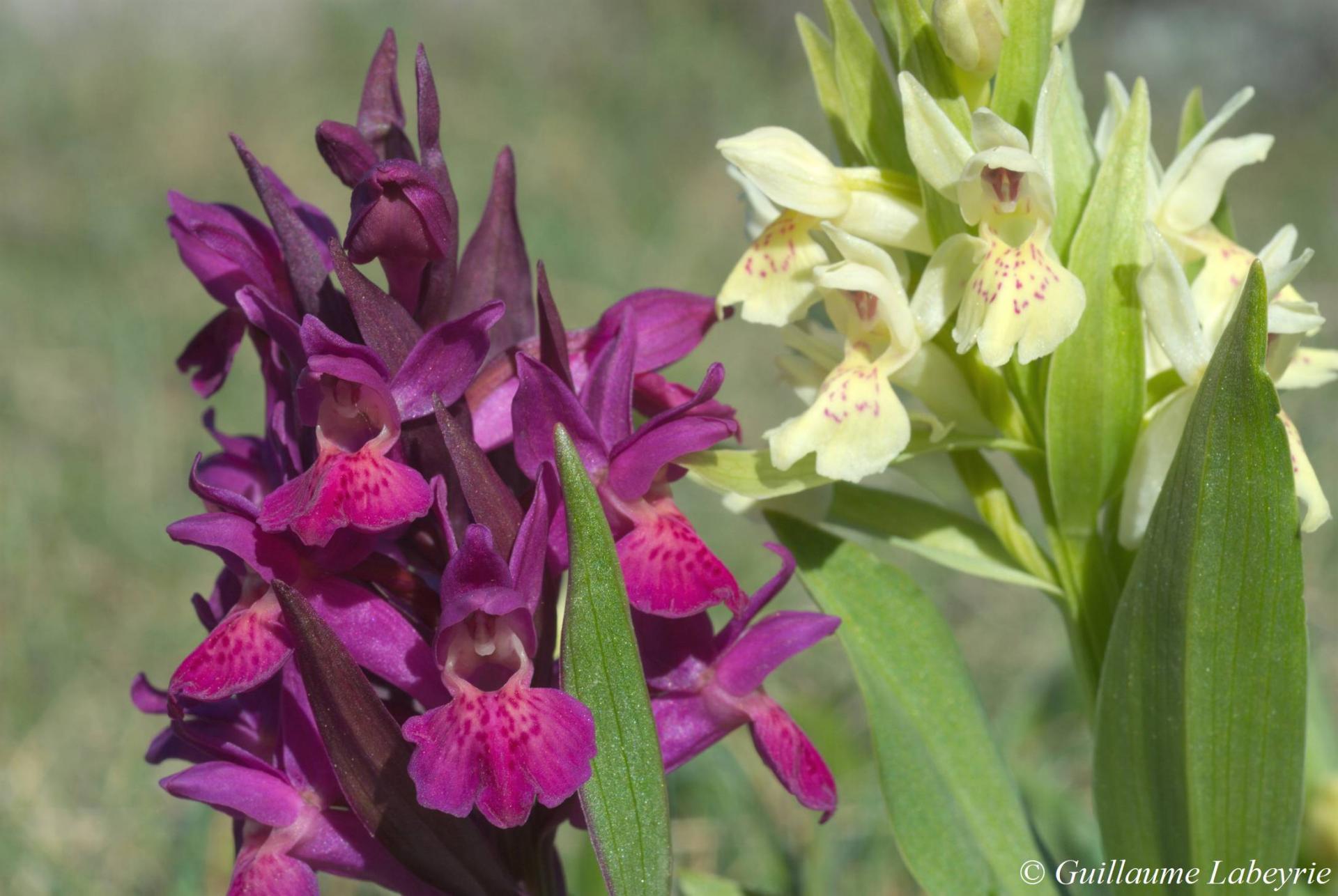 The elder-flowered orchid (Dactylorhiza sambucina). This mountain orchid has two forms, one yellow-flowered and the other with reddish flowers. In the Prealps, this species is found in rocky slopes and in grasslands on calcareous plateaus. A species native to central and southern Europe, it occurs in France in a south-east third of the country.
The elder-flowered orchid (Dactylorhiza sambucina). This mountain orchid has two forms, one yellow-flowered and the other with reddish flowers. In the Prealps, this species is found in rocky slopes and in grasslands on calcareous plateaus. A species native to central and southern Europe, it occurs in France in a south-east third of the country.
Family : Orobanchaceae
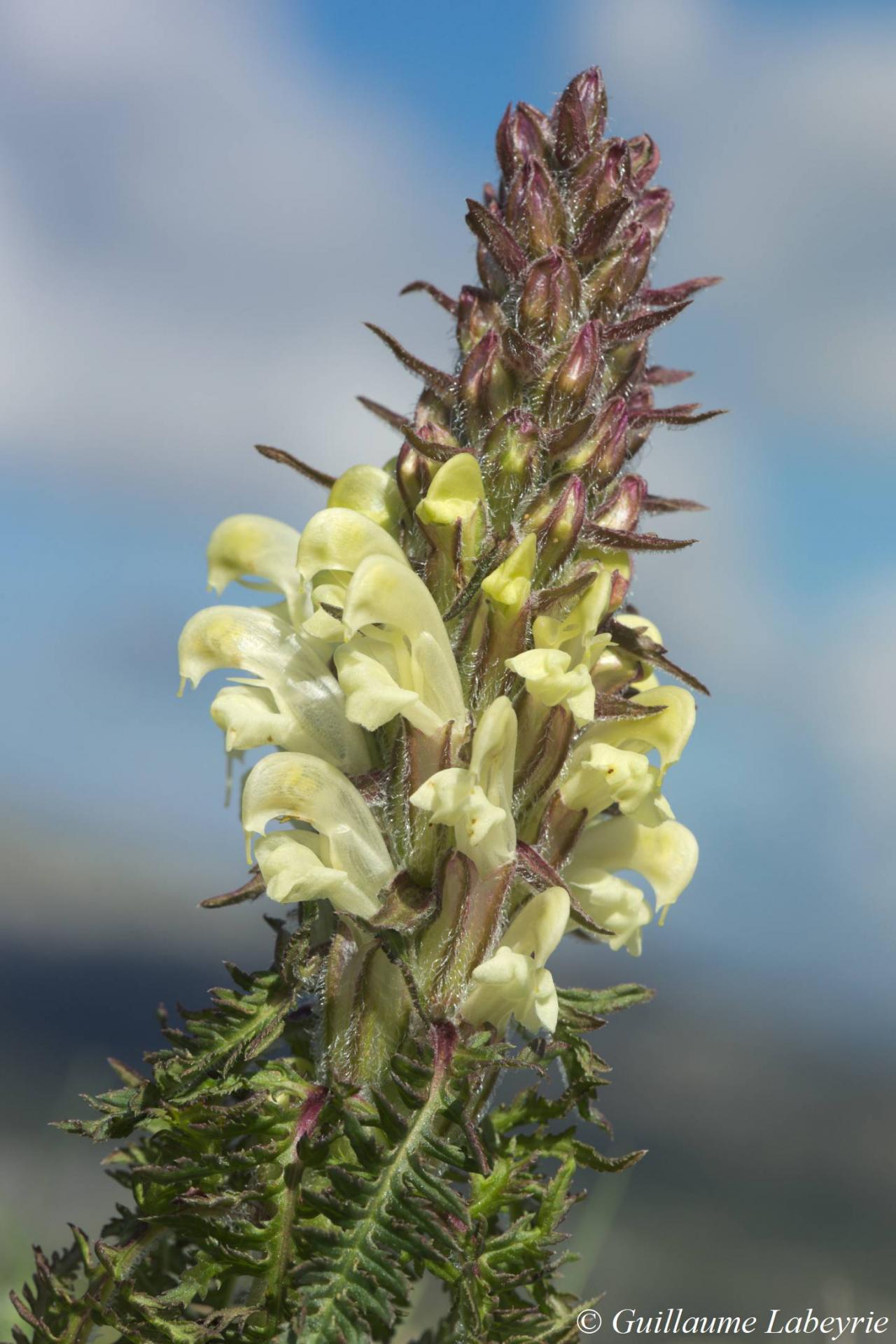 Lousewort (Pedicularis comosa). This large species belonging to the broomrape family has pale yellow flowers with the upper lip terminated by a short beak. It is locally found, in the Préalpes de Grasse, in rocky grasslands. In France, this plant occurs in most moutain ranges.
Lousewort (Pedicularis comosa). This large species belonging to the broomrape family has pale yellow flowers with the upper lip terminated by a short beak. It is locally found, in the Préalpes de Grasse, in rocky grasslands. In France, this plant occurs in most moutain ranges.
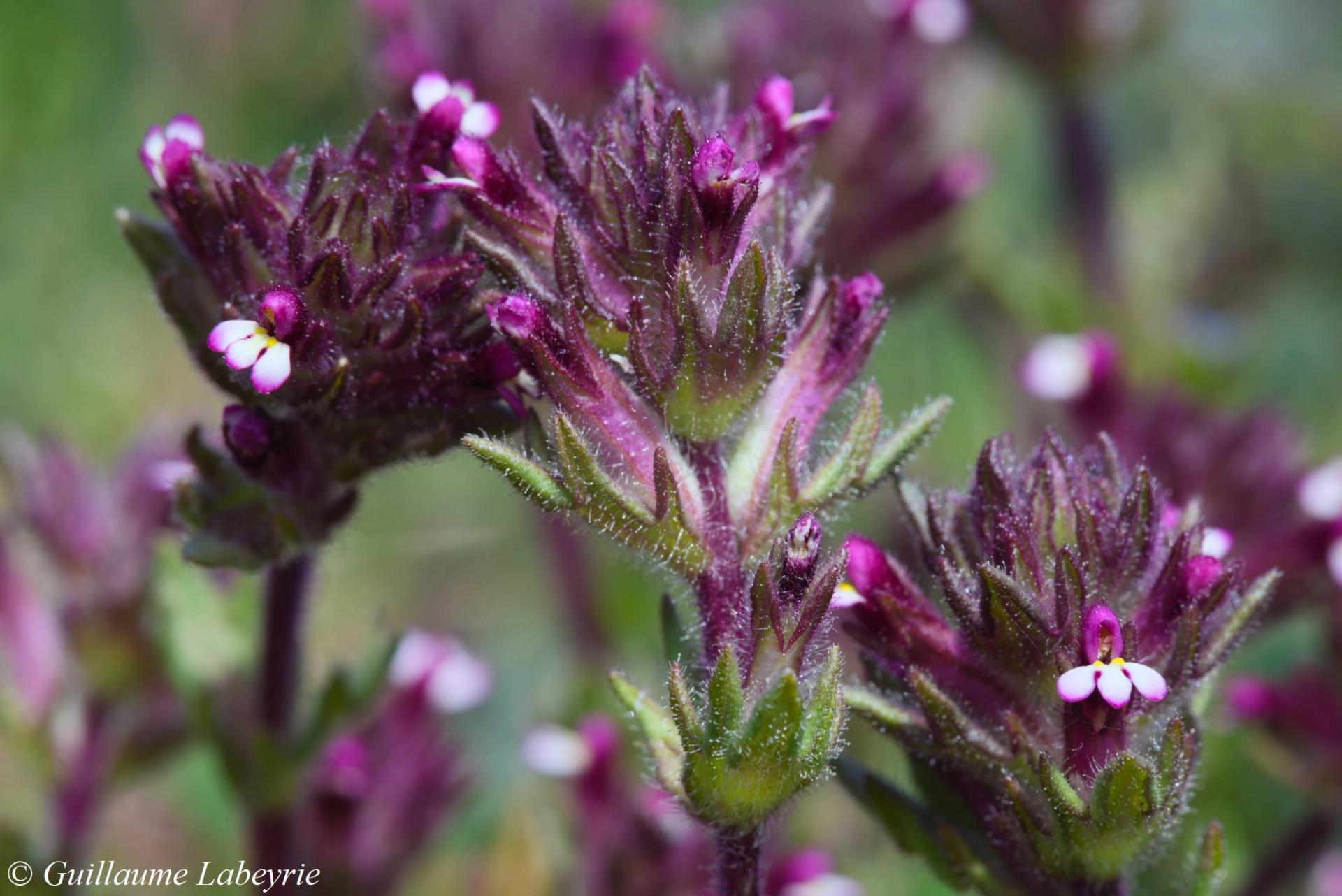
The red bartsia (Parentucellia latifolia). This small plant sporting tiny purple flowers is fairly abundant in the steppe-like grasslands. The whole plant is covered with glandular hairs. In France, this species is found mainly along the Atlantic and Mediterranean coasts. Its is protected in the Bretagne and Midi-Pyrénées regions.
Family : Papaveraceae
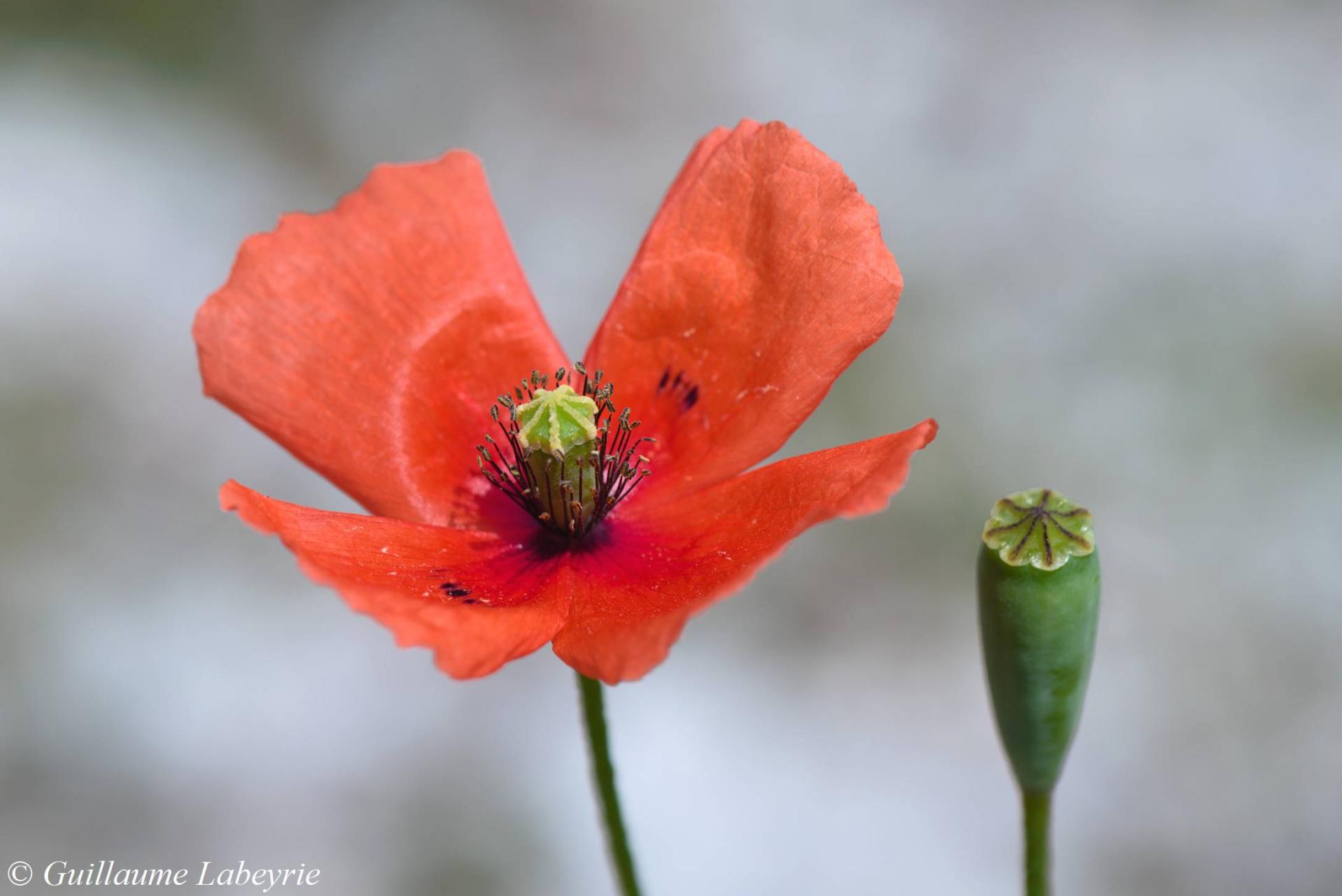 The long-headed poppy (Papaver dubium). This poppy has four orange petals that generally do not overlap much, and elongated capsules. It is sometimes found on the calcareous plateaus, usually in dolines. This species is protected in région PACA.
The long-headed poppy (Papaver dubium). This poppy has four orange petals that generally do not overlap much, and elongated capsules. It is sometimes found on the calcareous plateaus, usually in dolines. This species is protected in région PACA.
Family : Ranunculaceae
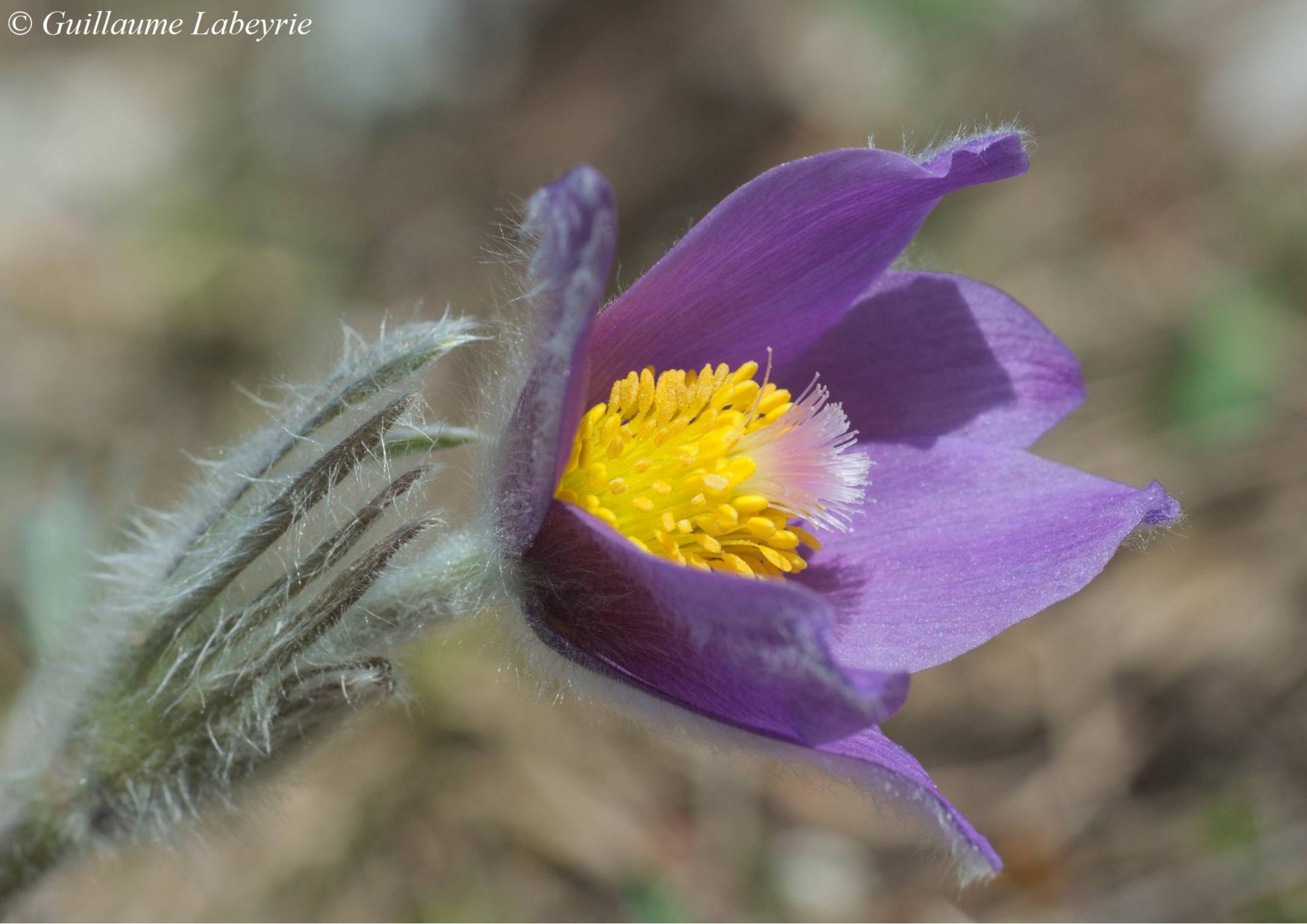 Haller's pulsatilla (Anemone halleri). This striking species is covered with long silvery hair. It grows in rocky meadows and clear Scots pine woods. Flowering occurs from March to May. This plant is endemic to the western Alps, and a protected species in France.
Haller's pulsatilla (Anemone halleri). This striking species is covered with long silvery hair. It grows in rocky meadows and clear Scots pine woods. Flowering occurs from March to May. This plant is endemic to the western Alps, and a protected species in France.
Family : Ricciaceae
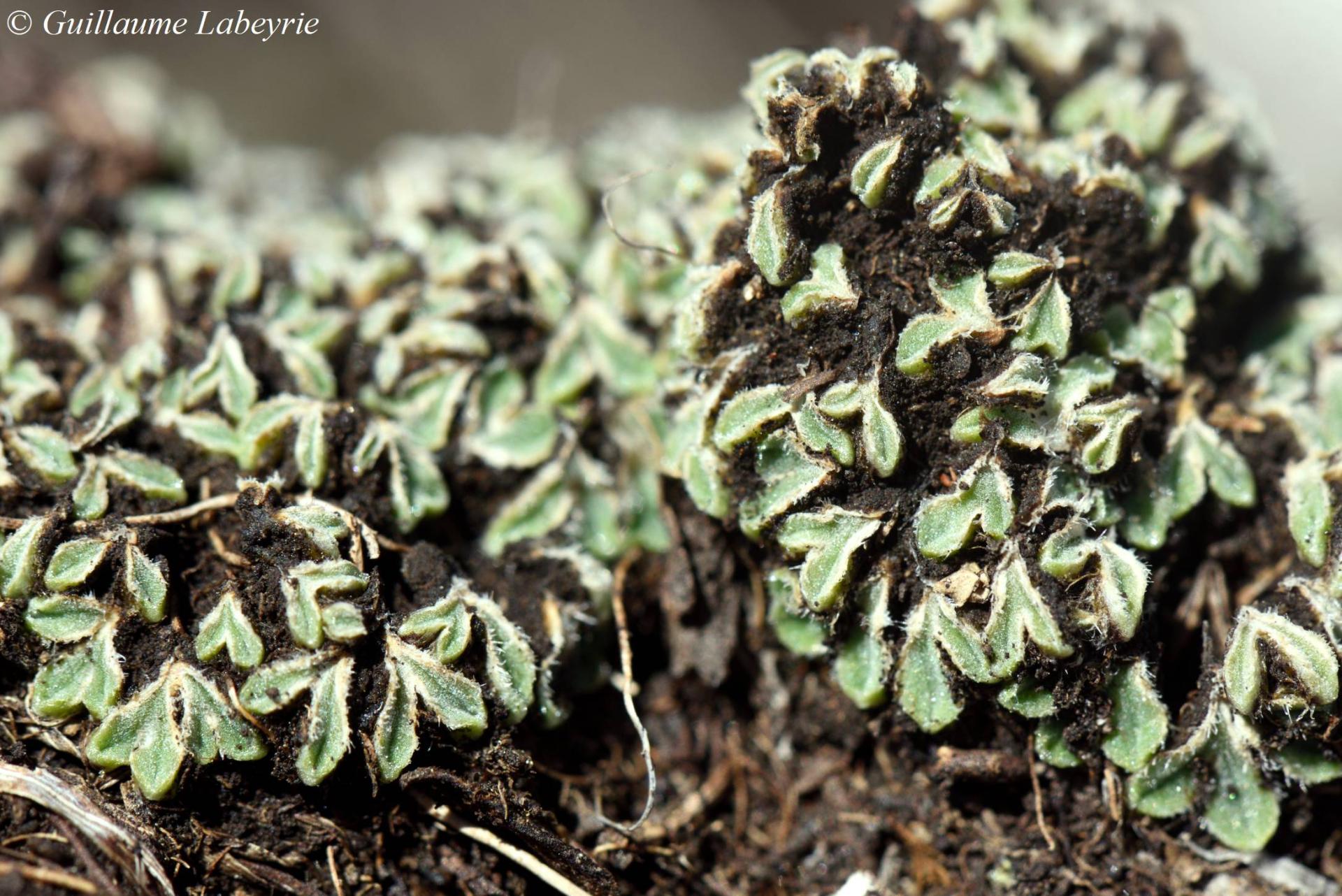
Riccia ciliifera. This tiny plant, which belongs to the liverworts, colonizes areas of bare soil in steppe grasslands. It is present in Central and Western Europe.
Family : Violaceae
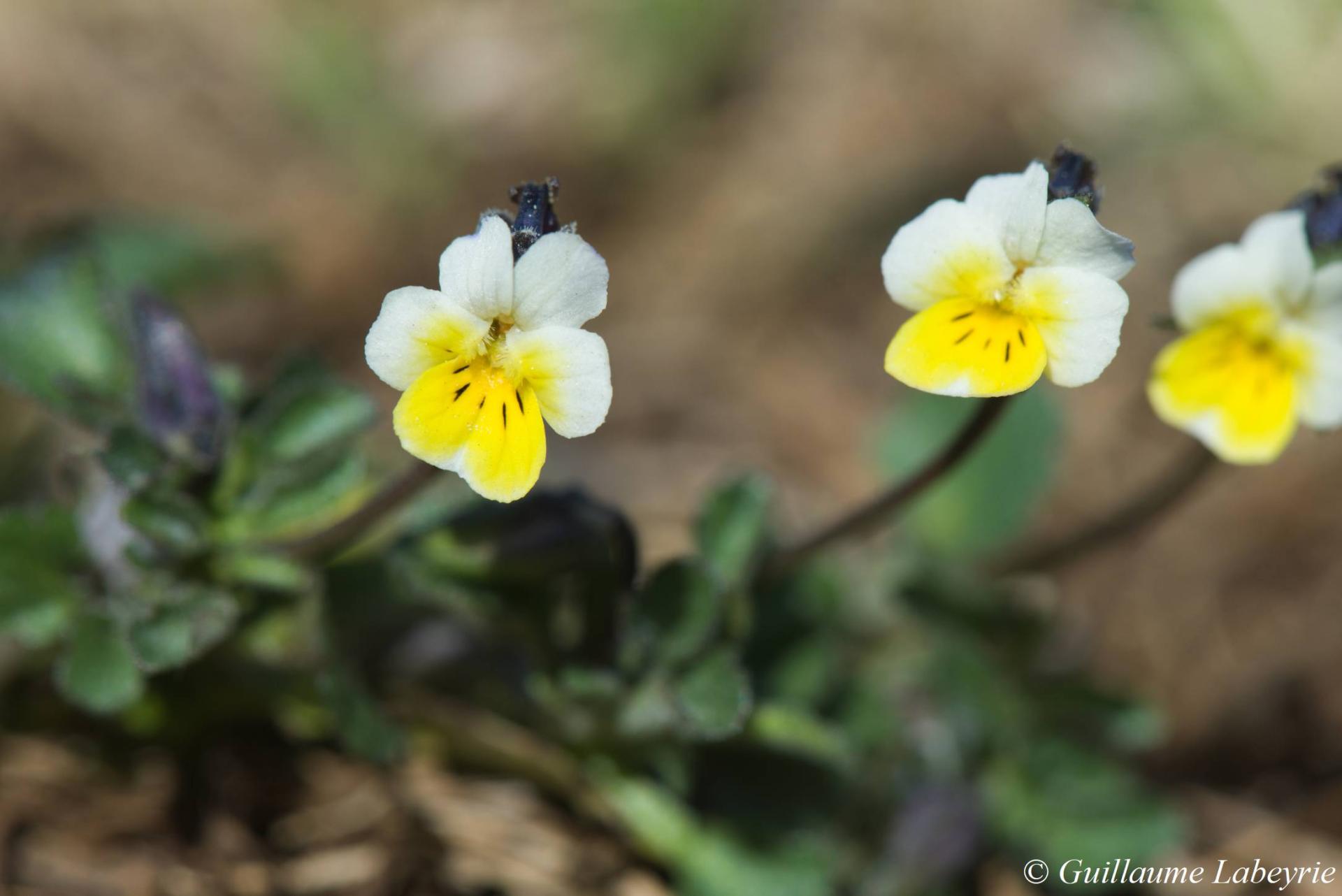
The dwarf violet (Viola kitaibeliana). This tiny violet is fairly common on the karstic plateaus. In France, it occurs in the South but also on the Altlantic coast. It is protected in Région Aquitaine.
Fungi and lichens
Fungi
Compared to forests, dry grasslands harbour relatively few fungi, but some species are quite spectacular.
Family : Agaricaceae
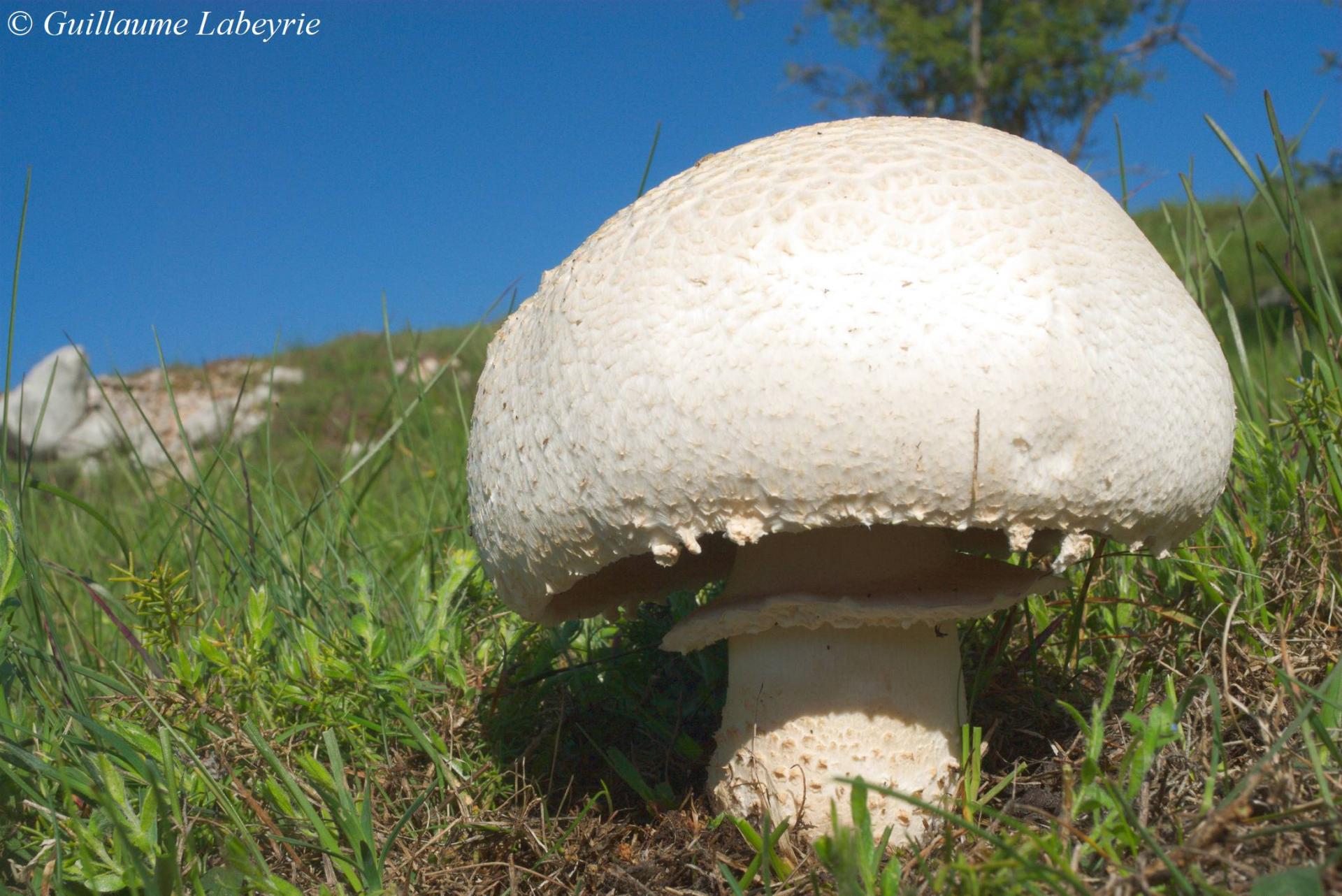 The giant meadow agaric (Agaricus urinascens). The cap of this mushroom is spherical when it is young, hence its common name of "snowball". Fully deployed, it can reach 30 cm of diameter. This nice species grows in dolines in May-June, often forming a circular pattern called a fairy ring. Edible, this mushroom must be consumed when young.
The giant meadow agaric (Agaricus urinascens). The cap of this mushroom is spherical when it is young, hence its common name of "snowball". Fully deployed, it can reach 30 cm of diameter. This nice species grows in dolines in May-June, often forming a circular pattern called a fairy ring. Edible, this mushroom must be consumed when young.

Fairy ring. These enigmatic circles reflect the presence in the soil of the mycelium of various species of mushrooms, including the giant meadow agaric (Agaricus urinascens) described above. The grass is greener at the mycelium level due to the presence of nitrates.
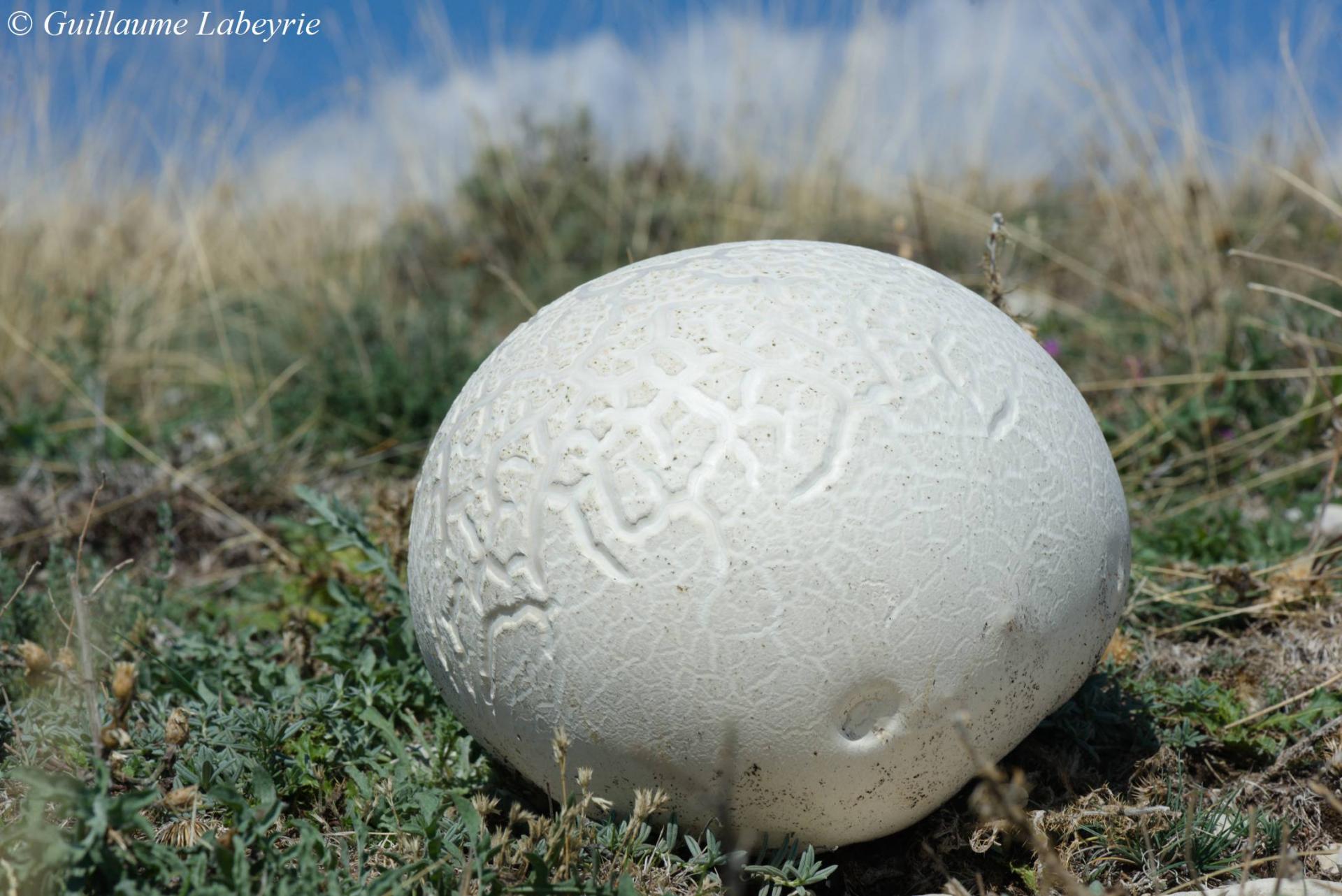 The giant puffball (Calvatia gigantea). This impressive species can grow beyond 50 cm in diameter. Widespread but uncommon, this mushroom grows in pastures. It is edible when young, when the inside is white.
The giant puffball (Calvatia gigantea). This impressive species can grow beyond 50 cm in diameter. Widespread but uncommon, this mushroom grows in pastures. It is edible when young, when the inside is white.
Fauna
The fauna of the Grasse Prealps is highly diversified, due to the variety of habitats found in the area. Another reason for this outstanding biodiversity is the overlap of the mediterranean and alpine influences.
Reptiles
Family : Viperidae
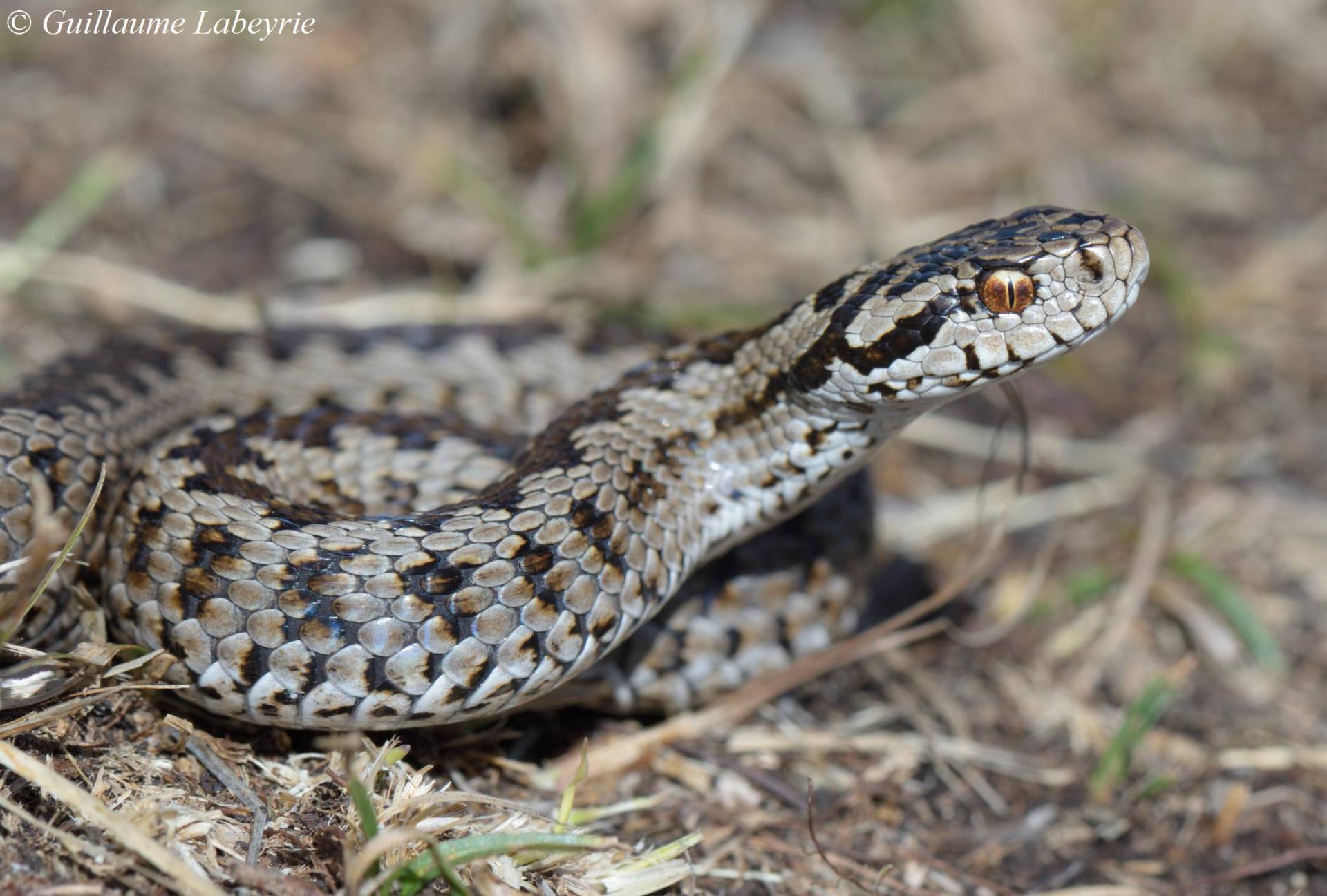
Orsini's viper (Vipera ursinii). This small viper is identified by its small head, not clearly separated from the neck. It lives in dry meadows above 1000 m of altitude where grasshoppers, its main prey, are abundant. Quite unaggressive and little venomous, this snake does not constitute a danger for man. It is very rare in France, with a few stations all located in the south-east. This species is fully protected in France, and liste as "endangered" by IUCN: if by chance you find it, admire it but don't hurt it !
Butterflies and Moths (Lepidoptera)
Sharply declining throughout Europe due to habitat loss and pesticides, butterflies are still abundant in the Préalpes de Grasse, with a remarkable diversity (80% of the French species are found in the Alpes-Maritimes). The flower-rich dry grasslands are home to many species, some of which are rare and protected.
Family : Lycaenidae
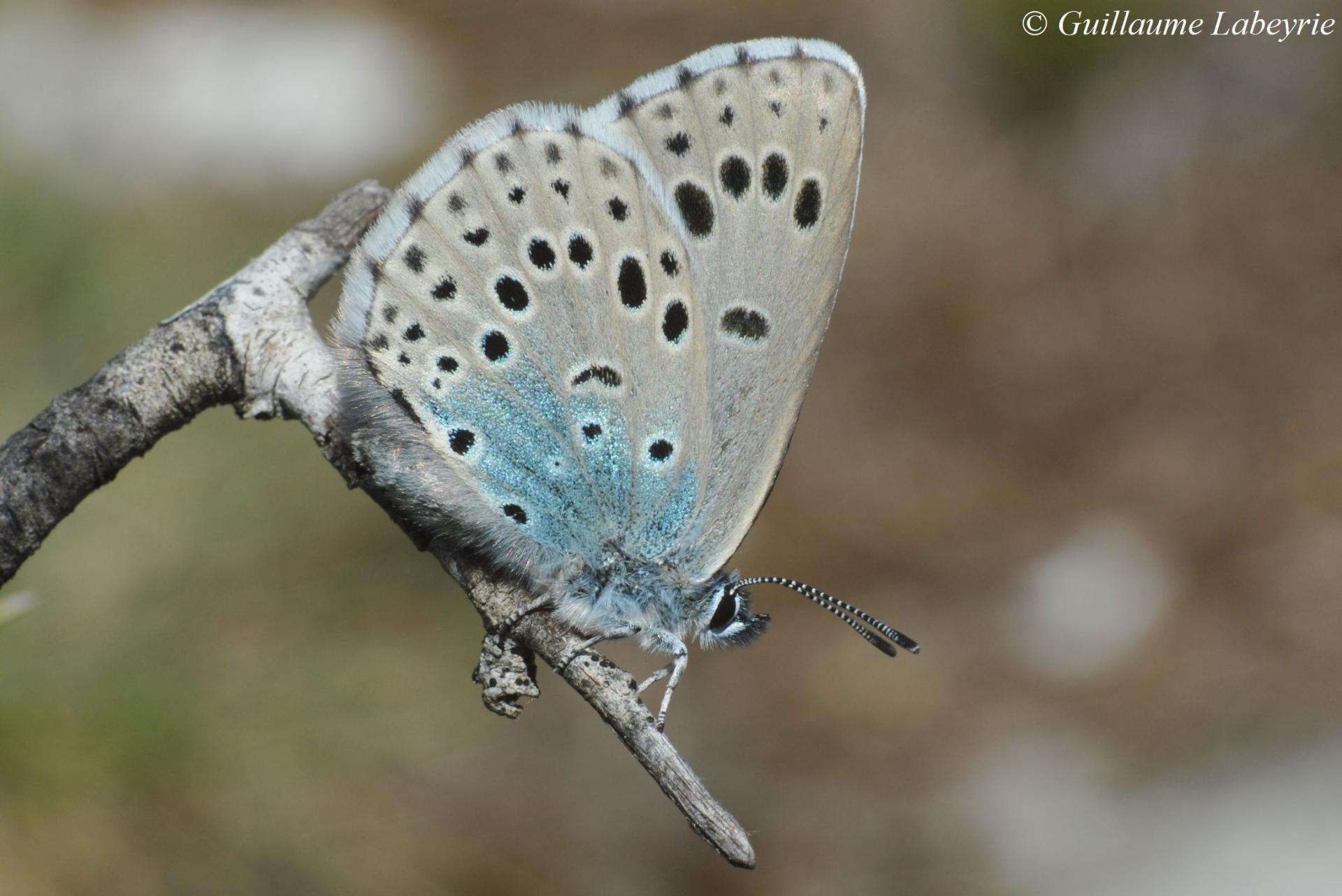 The large blue (Phengaris arion). This nice butterfly is readily recognized by the striking large black dots on the dark blue background of the upperside of its wings. It flies above dry grassy areas where thyme (its host plant) grows, between May and August. Like for the other species of the genus Phengaris, the caterpillars finish their development inside an ant-hill. This species who has know a drastic decrease of its population throughout Europe is listed as threatened by the IUCN, and protected in many countries including France.
The large blue (Phengaris arion). This nice butterfly is readily recognized by the striking large black dots on the dark blue background of the upperside of its wings. It flies above dry grassy areas where thyme (its host plant) grows, between May and August. Like for the other species of the genus Phengaris, the caterpillars finish their development inside an ant-hill. This species who has know a drastic decrease of its population throughout Europe is listed as threatened by the IUCN, and protected in many countries including France.
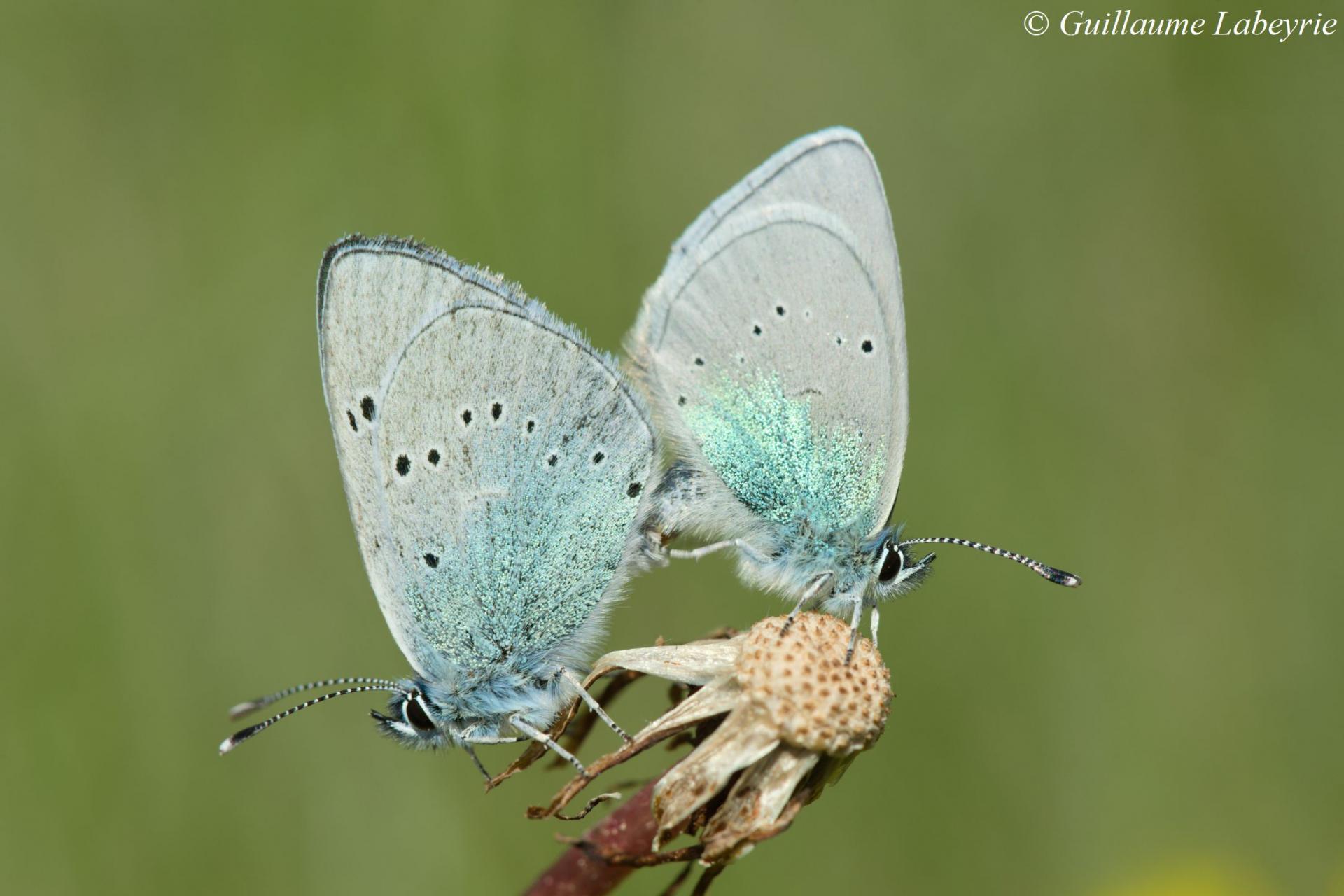 The green-underside blue (Glaucopsyche alexis). This small butterfly has a pale grey underside with an extended area with blue scales. It lives in flower-rich dry meadows. It is found in most of Europe, Russia and Asia. In France, it occurs in most of the territory.
The green-underside blue (Glaucopsyche alexis). This small butterfly has a pale grey underside with an extended area with blue scales. It lives in flower-rich dry meadows. It is found in most of Europe, Russia and Asia. In France, it occurs in most of the territory.
Family : Nymphalidae / Sub-Family : Nymphalinae
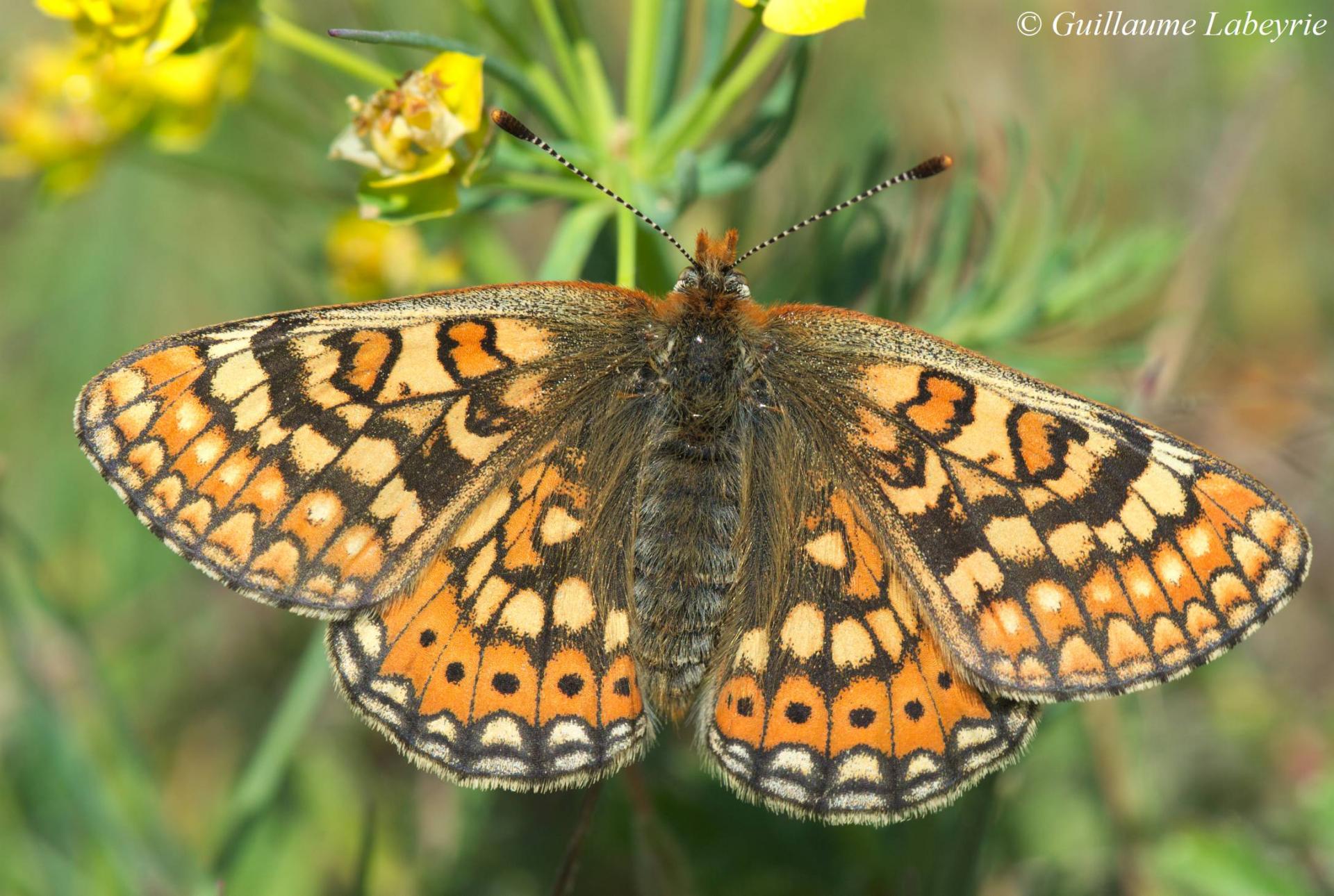 The marsh fritillary (Euphydryas aurinia). This butterfly displays a typical delicate black pattern on the orange background of its wings. In the Préalpes de Grasse, it occurs in dry calcareous grasslands between April and July. Widely distributed from North Africa, Europe to Asia, this species is in sharp decline. It is protected in France.
The marsh fritillary (Euphydryas aurinia). This butterfly displays a typical delicate black pattern on the orange background of its wings. In the Préalpes de Grasse, it occurs in dry calcareous grasslands between April and July. Widely distributed from North Africa, Europe to Asia, this species is in sharp decline. It is protected in France.
Family : Nymphalidae / Sub-Family : Heliconiinae
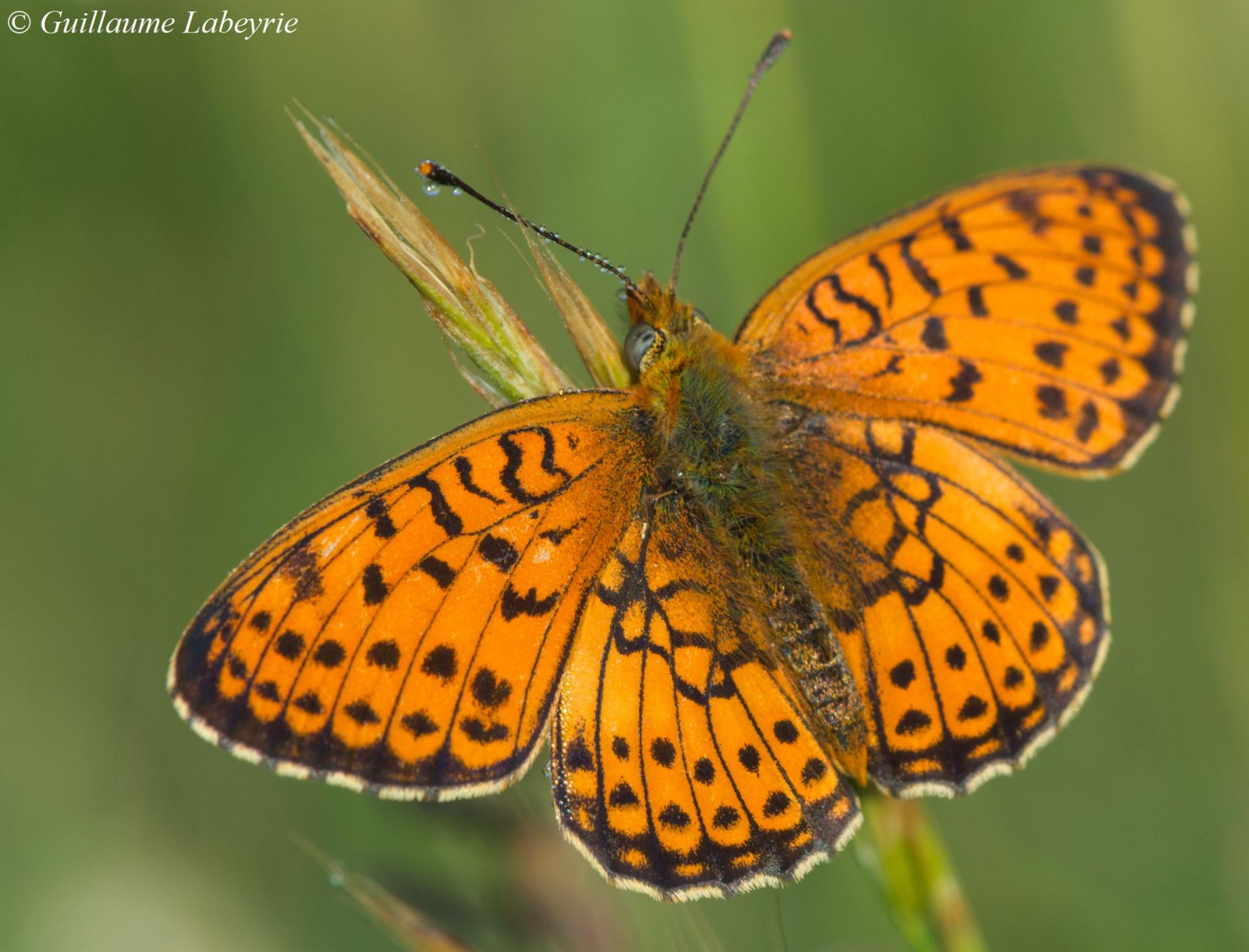 The twin-spot fritillary (Brenthis hecate). This butterfly has a distinctive double set of black dots on a bright orange background. It is usually observed in sunny meadows, in June. In western Europe, this species occurs only in the south, while it is more widespread in eastern Europe up to Turkey. In France, it is found in a southermost third of the country.
The twin-spot fritillary (Brenthis hecate). This butterfly has a distinctive double set of black dots on a bright orange background. It is usually observed in sunny meadows, in June. In western Europe, this species occurs only in the south, while it is more widespread in eastern Europe up to Turkey. In France, it is found in a southermost third of the country.
 The Queen of Spain fritillary (Issoria lathonia). This striking species displays distinctive large mirror-like spots on the underside of the wings. The upperside is orange with black spots, as in most fritillary species. This butterfly is widespread from North Africa, Europe to Mongolia.
The Queen of Spain fritillary (Issoria lathonia). This striking species displays distinctive large mirror-like spots on the underside of the wings. The upperside is orange with black spots, as in most fritillary species. This butterfly is widespread from North Africa, Europe to Mongolia.
Family : Nymphalidae / Sub-Family : Satyrinae
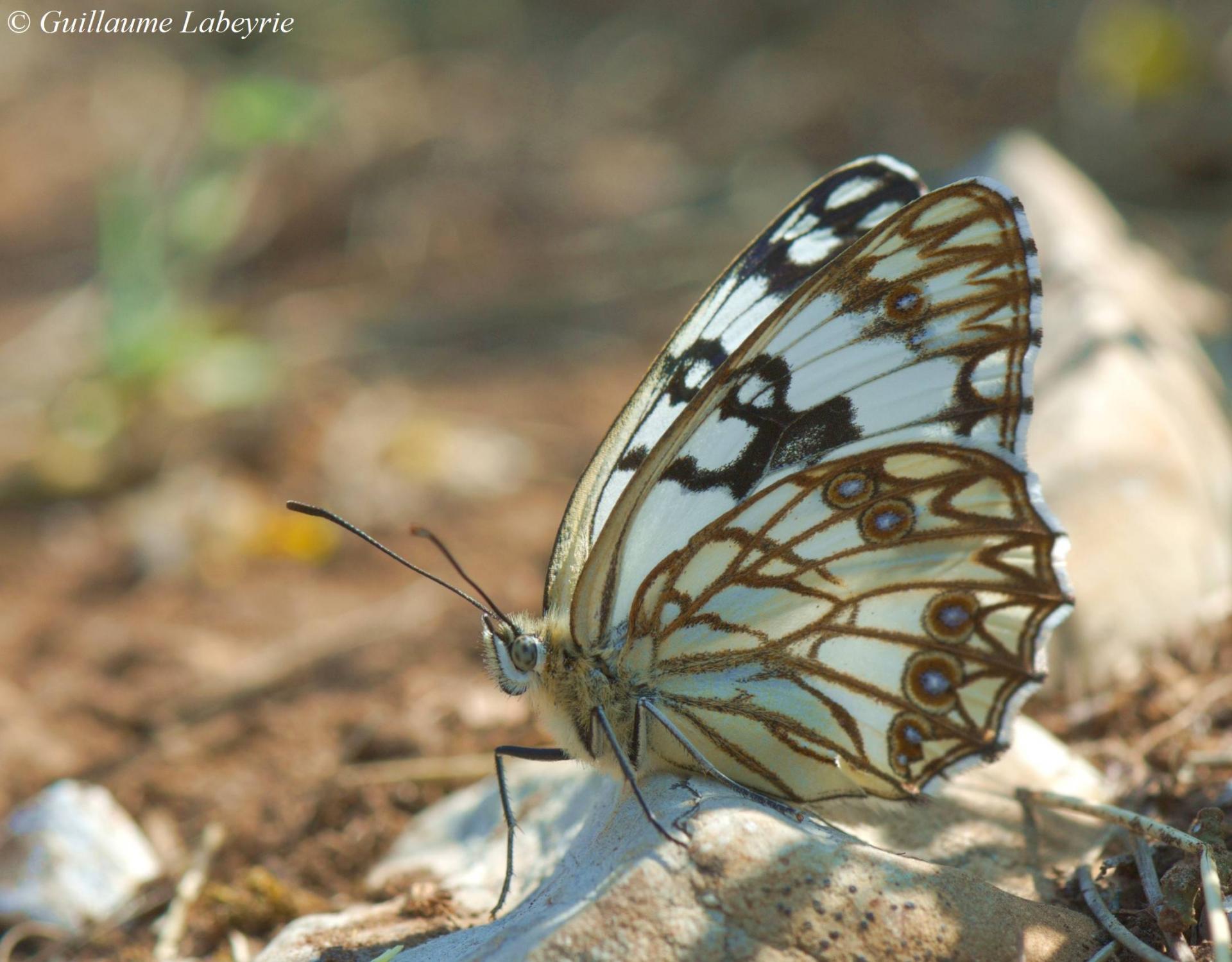 The western marbled white (Melanargia occitanica). A close relative of the common marbled white (Melanargia galathea), this beautiful and much scarcer butterfly displays a characteristic rusty pattern and blue eyespots on the underwing. This species is usually observed flying rapidely above rocky grasslands, in May and June. It is found in France (Mediterranean fringe), Spain and Northern Africa.
The western marbled white (Melanargia occitanica). A close relative of the common marbled white (Melanargia galathea), this beautiful and much scarcer butterfly displays a characteristic rusty pattern and blue eyespots on the underwing. This species is usually observed flying rapidely above rocky grasslands, in May and June. It is found in France (Mediterranean fringe), Spain and Northern Africa.

The autumn ringlet (Erebia neoridas). This ringlet is quite common in the area, where it can be observed starting from the end of August. This a low mountain butterfly, found in scattered colonies in Spain, France and Italy.
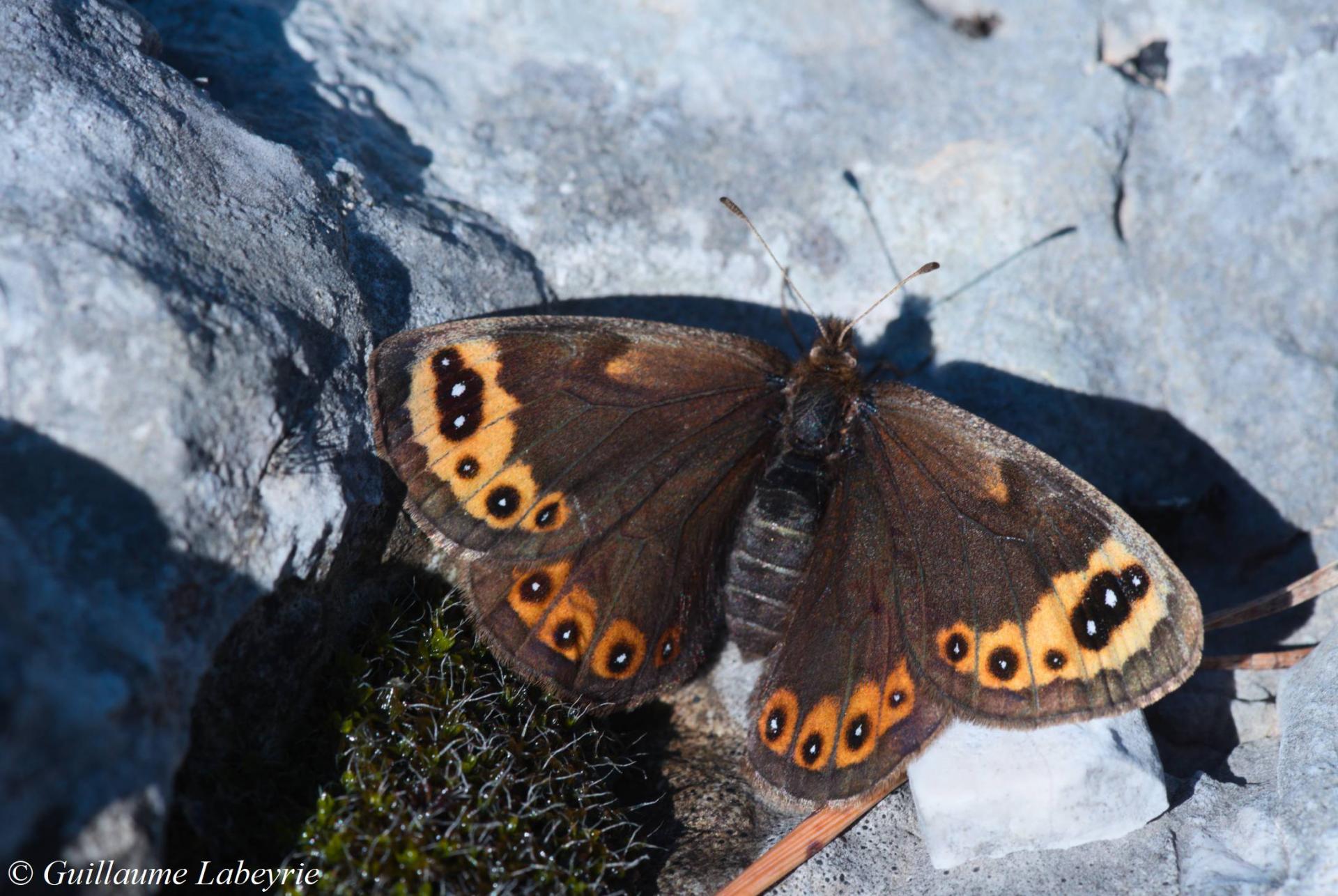
The spring ringlet (Erebia epistygne). As indicated by its name, this ringlet flies as early as March, even by low temperatures. It has characteristic "bicolored" wings, with the markings on the upper wings a pale yellow whilst those of the lower wings are brown. This is an uncommon and localized species, only found in Spain and southern France where it is listed as "near threatened" by IUCN.
Family : Papilionidae
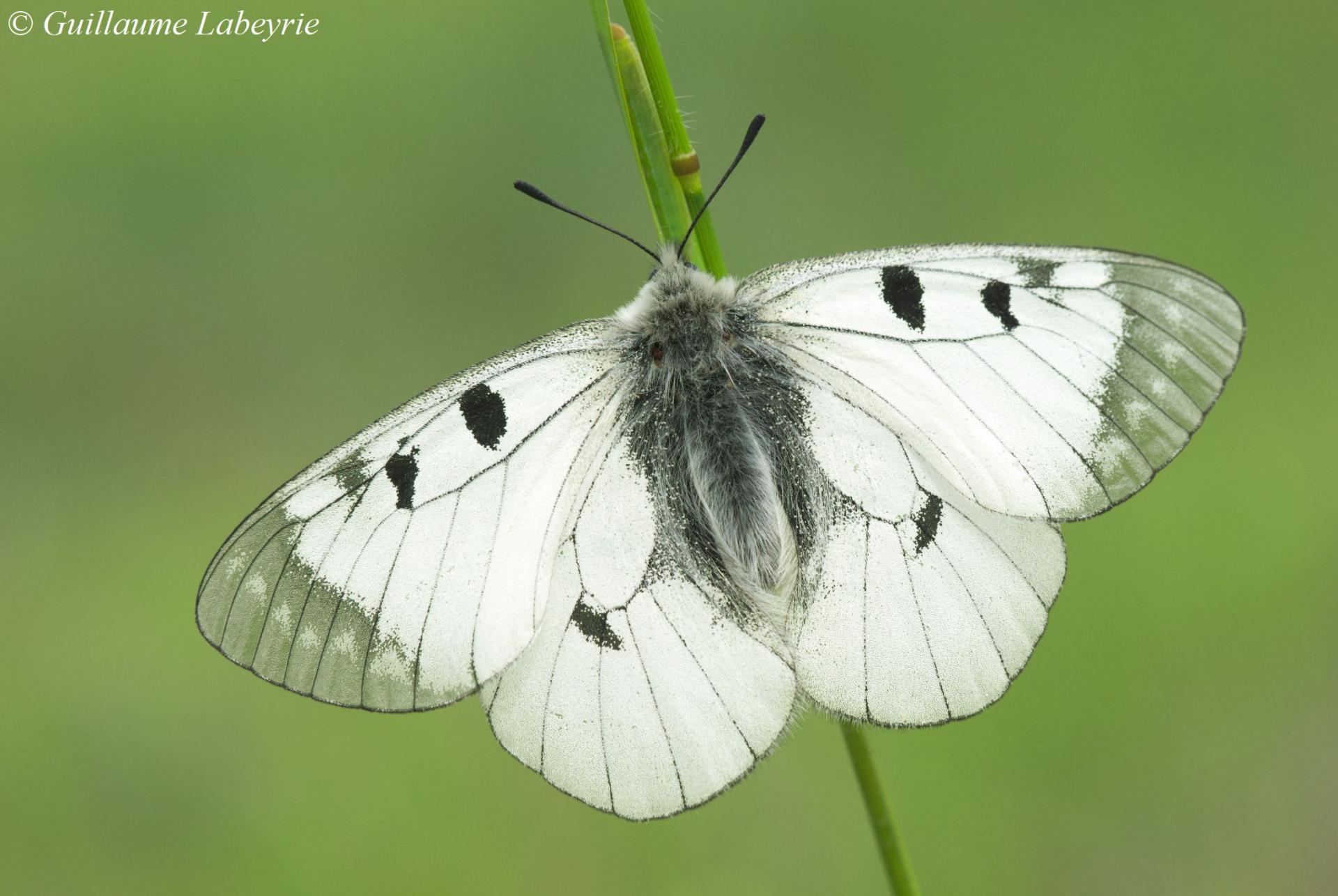 The clouded Apollo (Parnassius mnemosyne). This quite large butterfly is recognized by its white wings with a few black spots. It flies in May-June over rocky meadows and clearings where its host-plant Corydalis solida grows. This is a quite rare and very local species, listed "near threatened" by IUCN. It is found in the Alps, the Balkans, Turkey and the Middle East, up to Siberia. It is fully protected in France.
The clouded Apollo (Parnassius mnemosyne). This quite large butterfly is recognized by its white wings with a few black spots. It flies in May-June over rocky meadows and clearings where its host-plant Corydalis solida grows. This is a quite rare and very local species, listed "near threatened" by IUCN. It is found in the Alps, the Balkans, Turkey and the Middle East, up to Siberia. It is fully protected in France.
Family : Pieridae
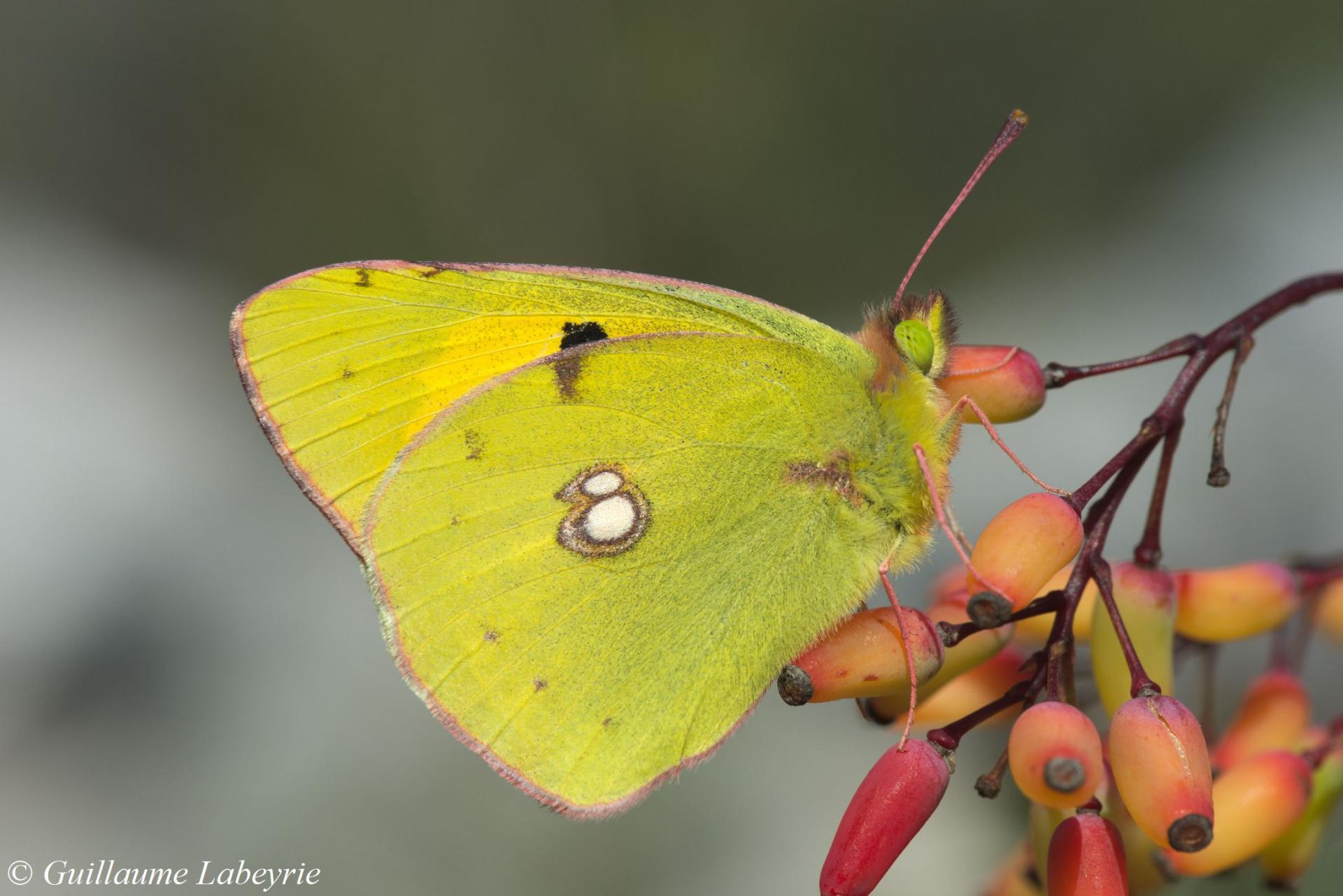
The clouded yellow (Colias croceus). This uperside of the wings of this nice butterfly is orange and black. This is one of the last species flying at the end of summer on the calcareous plateaus. It is widespread in the North Africa, in Europe and in part of Asia.
Family : Zygaenidae
Burnets display a distinctive red-on-black pattern to warn predators of their toxicity: they contain hydrogen cyanide, a chemical with a very bad taste and potentially harmful.
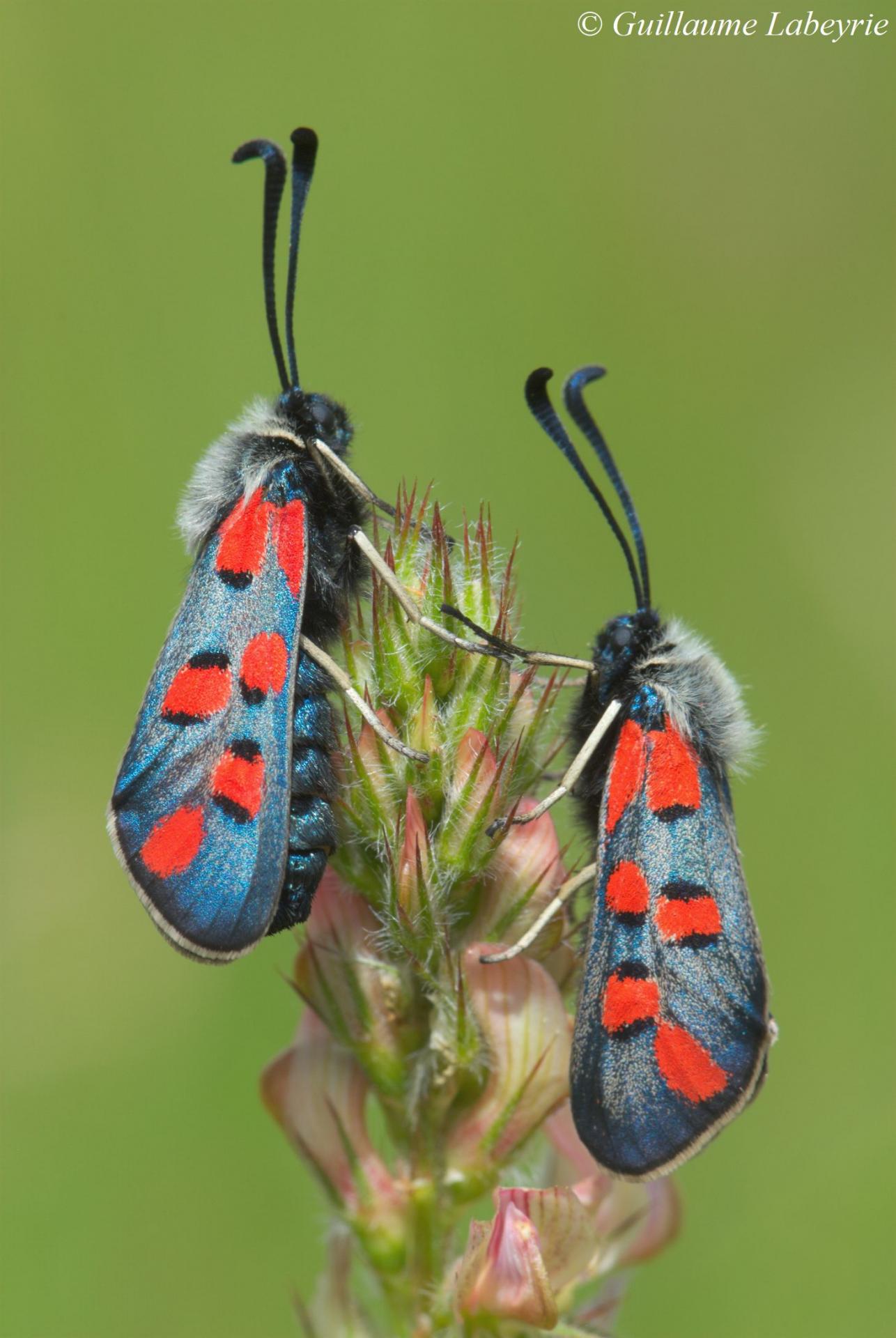 Zygaena rhadamanthus. This is a beautiful burnet with dark wings covered with silvery scales, displaying six red spots with black edges for some of them. This scarce species is usually found in small numbers, at the end of May. Restricted to southern Europe, it occurs in France only in the mediterranean fringe. It is fully protected.
Zygaena rhadamanthus. This is a beautiful burnet with dark wings covered with silvery scales, displaying six red spots with black edges for some of them. This scarce species is usually found in small numbers, at the end of May. Restricted to southern Europe, it occurs in France only in the mediterranean fringe. It is fully protected.
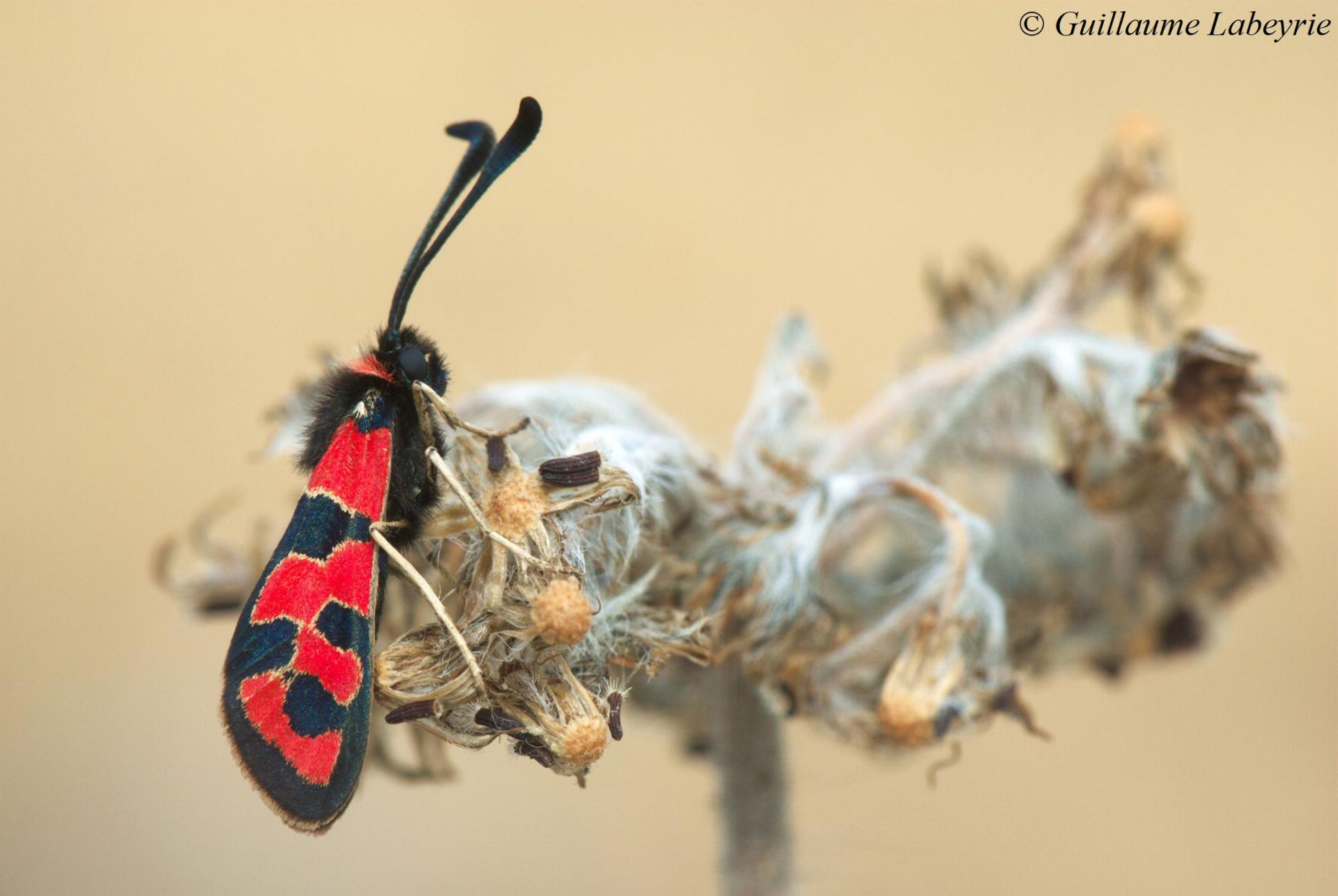 Zygaena fausta. This small burnet sports distinctive merging red spots surrounded by a clearer margin, a red collar and a red ring on the abdomen. It is quite common on the plateaus of the Préalpes de Grasse, in August and September. This species is found in Western Europe, from Spain to Germany and Italy.
Zygaena fausta. This small burnet sports distinctive merging red spots surrounded by a clearer margin, a red collar and a red ring on the abdomen. It is quite common on the plateaus of the Préalpes de Grasse, in August and September. This species is found in Western Europe, from Spain to Germany and Italy.
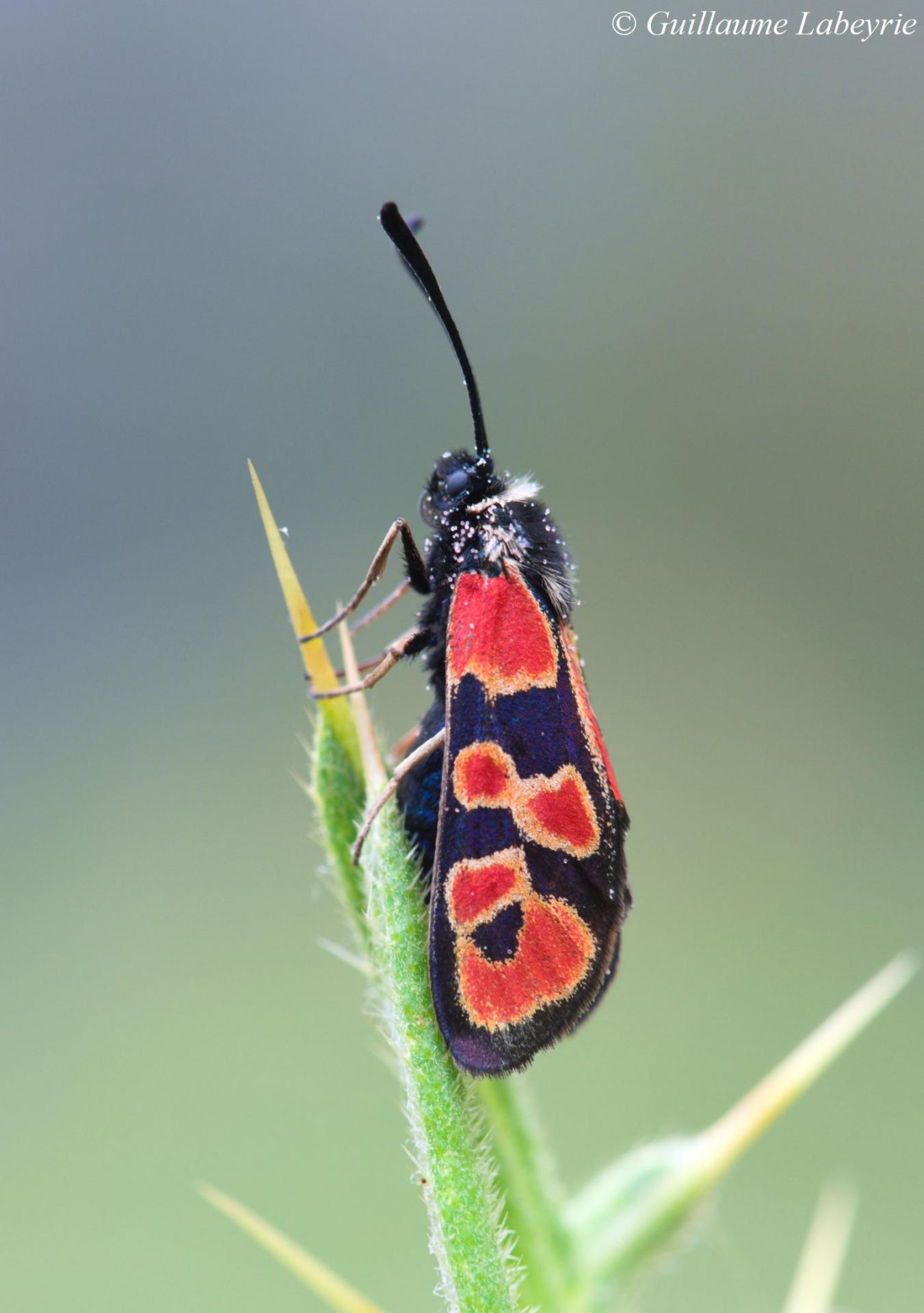
Zygaena hilaris. Superficially similar to the previous species, this burnet sports a distinctive white collar and lacks the red ring on the abdomen. It also flies much earlier, in June in the Grasse Prealps. In France, this species is restricted to the South-East, where it is widespread but uncommon. The sub-species ononidis, from the surroundings of the city of Cannes, is on the brink of extinction.
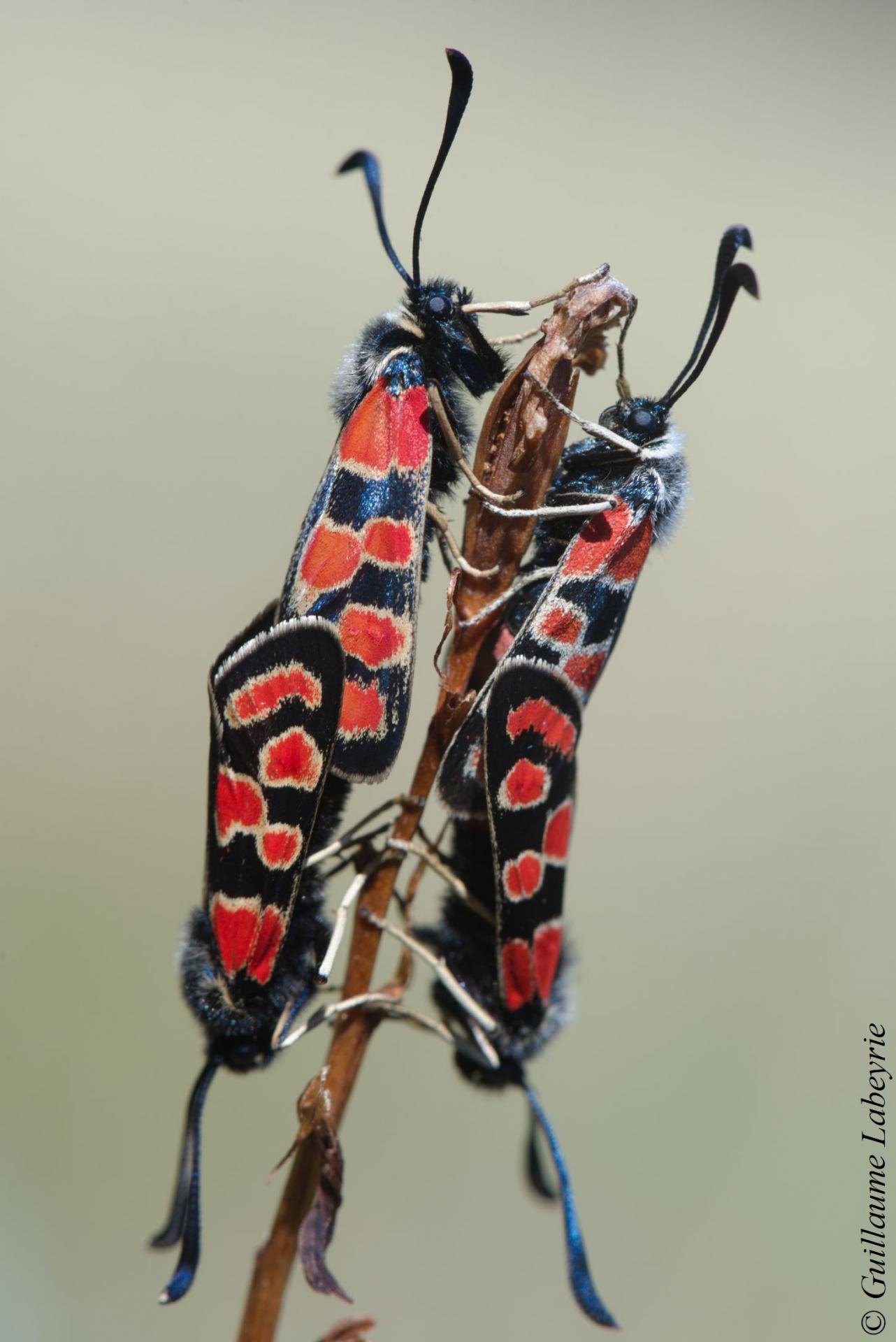 The crepuscular burnet (Zygaena carniolica). With its white collar and red spots rimmed with ocher or creamy white, this species resembles the previous one. It is distinguished in particular by the spot in the shape of a narrow crescent at the tip of the wing, which does not touch the nearest spot. In addition, individuals from the Grasse Prealps often have a red abdominal belt (visible here on the top right individual), absent in Z. hilaris. The crepuscular burnet is quite common in the Prealps above 1000 m altitude, where it flies from the end of June. It is found in a major part of France, with the exception of the Aquitaine basin and the Armorican massif.
The crepuscular burnet (Zygaena carniolica). With its white collar and red spots rimmed with ocher or creamy white, this species resembles the previous one. It is distinguished in particular by the spot in the shape of a narrow crescent at the tip of the wing, which does not touch the nearest spot. In addition, individuals from the Grasse Prealps often have a red abdominal belt (visible here on the top right individual), absent in Z. hilaris. The crepuscular burnet is quite common in the Prealps above 1000 m altitude, where it flies from the end of June. It is found in a major part of France, with the exception of the Aquitaine basin and the Armorican massif.
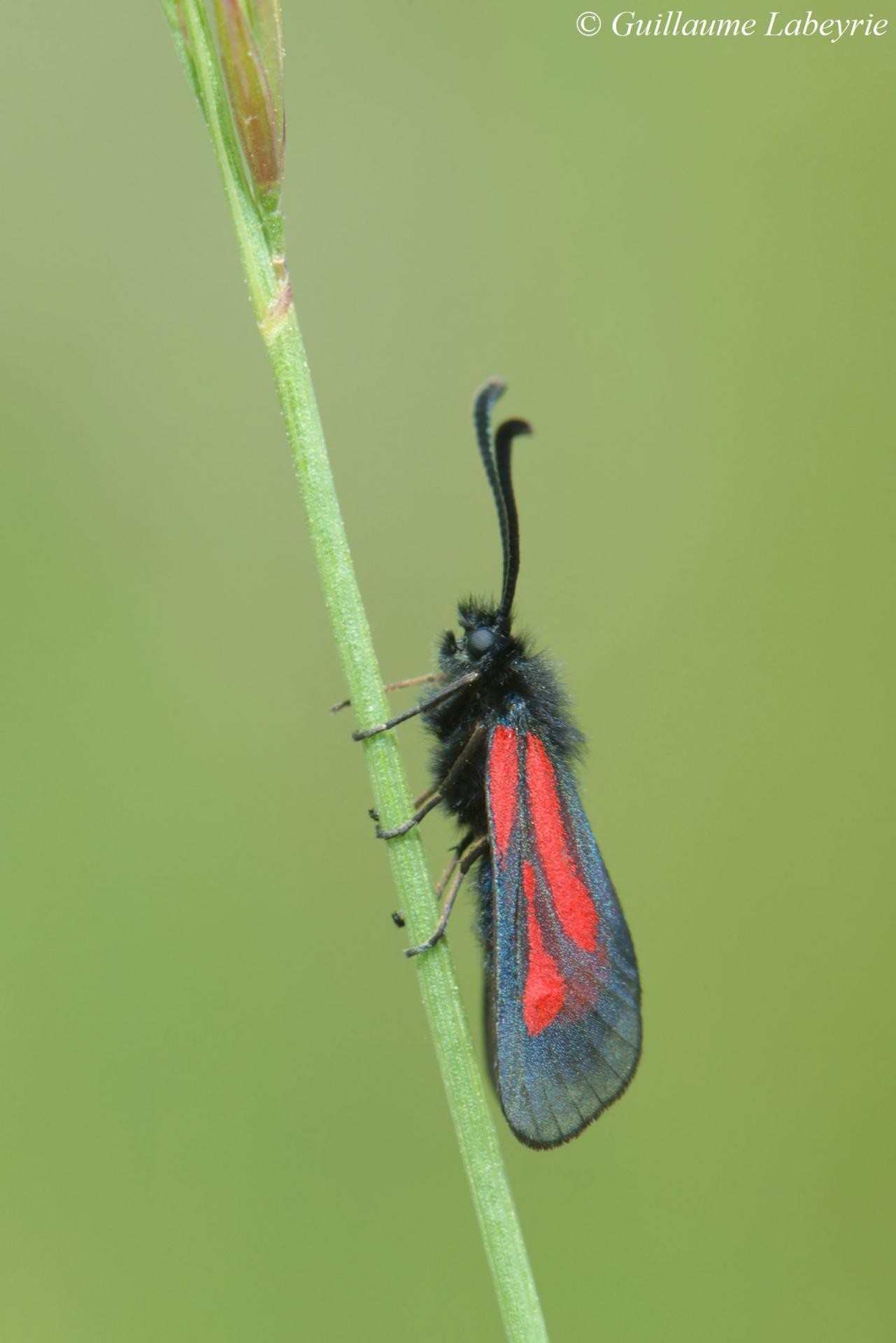 Zygaena nevadensis. This small burnet has translucent wings with three red stripes. In France, this very local species only occurs in the South-East. In the Alpes-Maritimes, it seems to be mostly restricted to the Préalpes de Grasse where it can be observed in dry meadows in June.
Zygaena nevadensis. This small burnet has translucent wings with three red stripes. In France, this very local species only occurs in the South-East. In the Alpes-Maritimes, it seems to be mostly restricted to the Préalpes de Grasse where it can be observed in dry meadows in June.
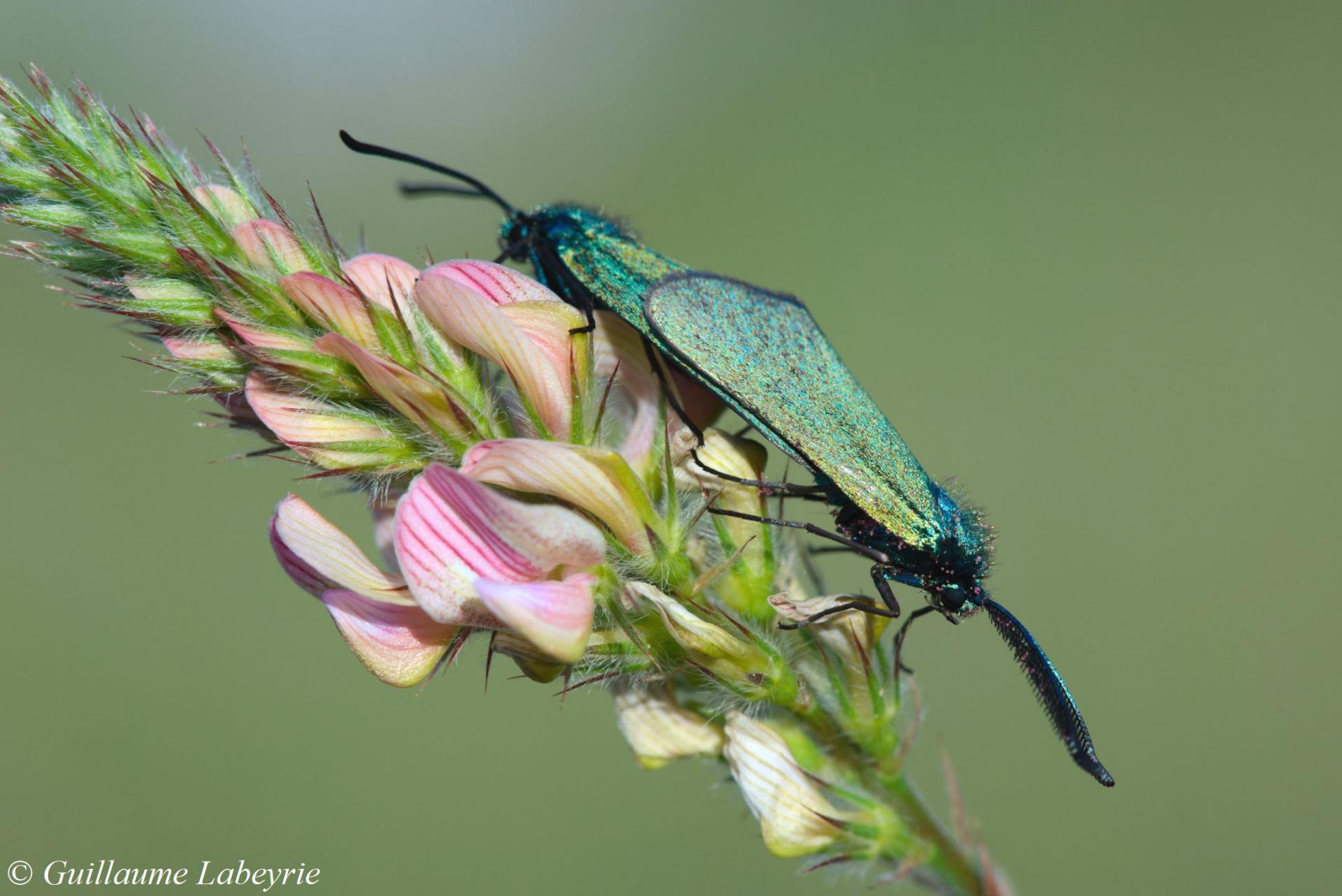
Adscita sp. These members of the Zygaenidae family are uniformly green. Thirteen species occur in the Alpes-Maritimes, their identification usually requiring the examination of the genitalia. The pair shown here belongs to the genus Adscita (antennae thickened at the tip). The male (to the right) has pectinate antennae.
Family : Brahmaeidae
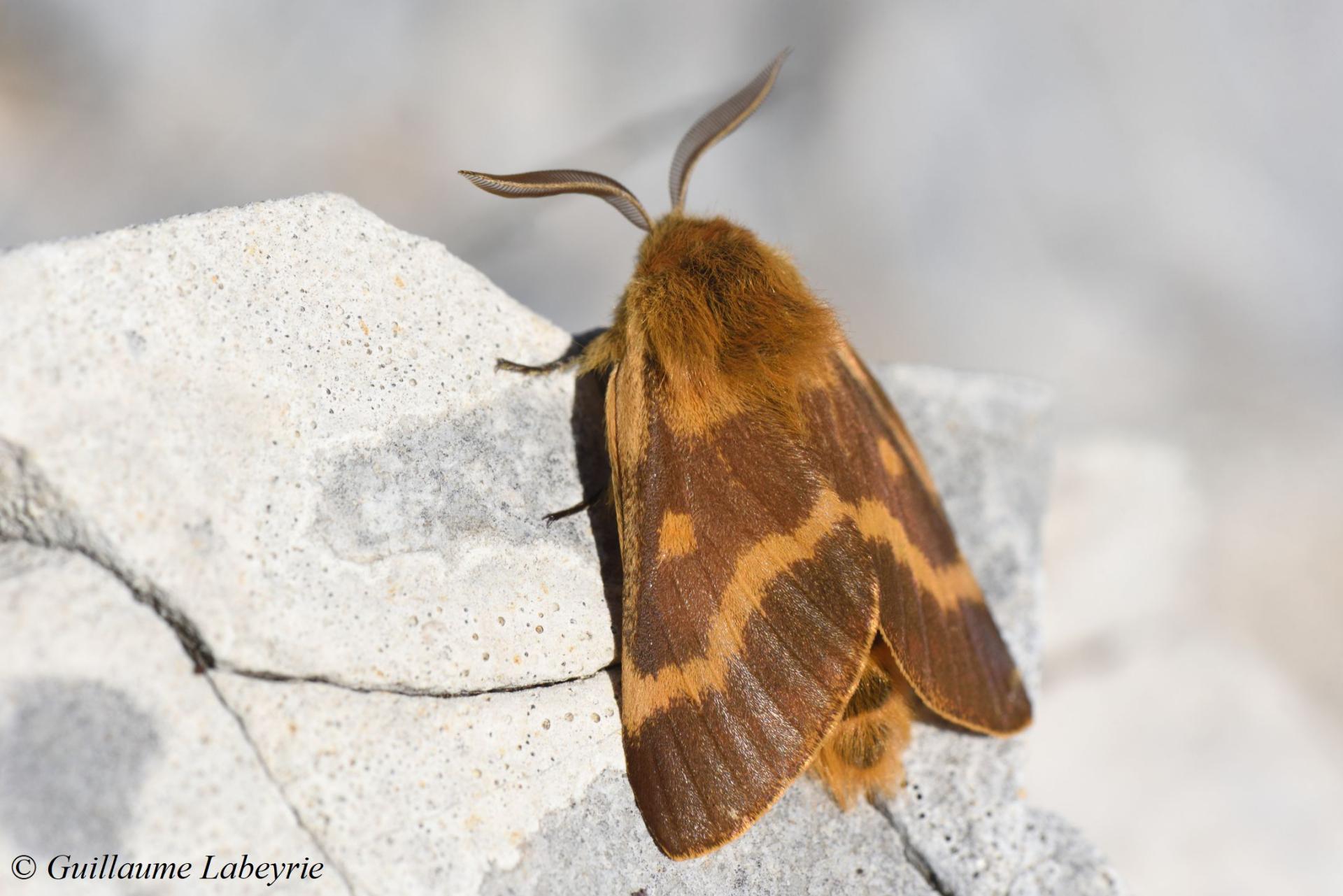
Lemonia dumi. This species, widespread in Europe but often localized, appreciates dry meadows. The caterpillars consume various plants including dandelions. In France, it is found mainly in the eastern half.
Family : Crambidae
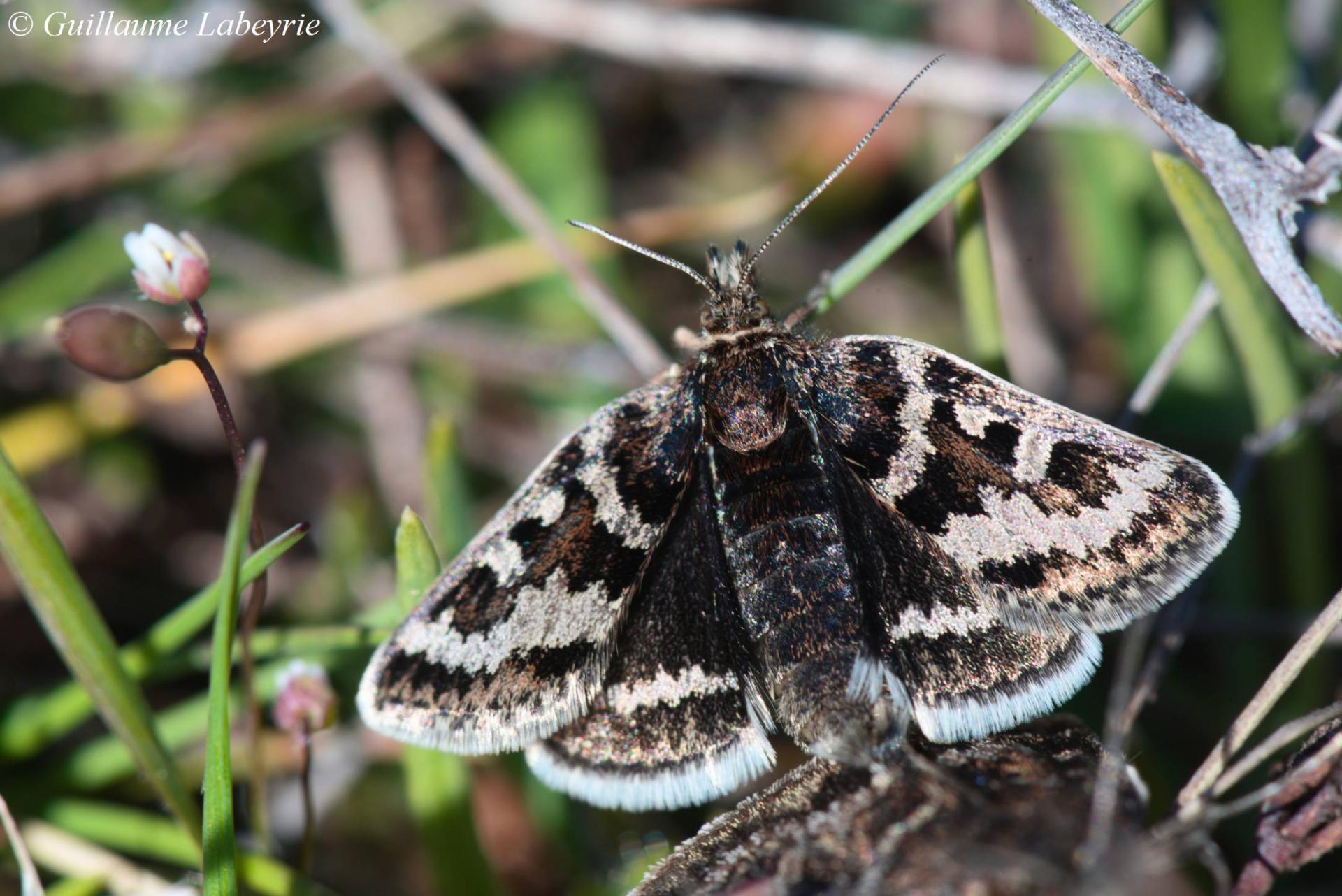
Metaxmeste schrankiana. This small moth has a wingspan of about 1 cm. It can be observed in spring during the day, flying fast just above the ground. This is a mountain species, found in most of Western Europe.
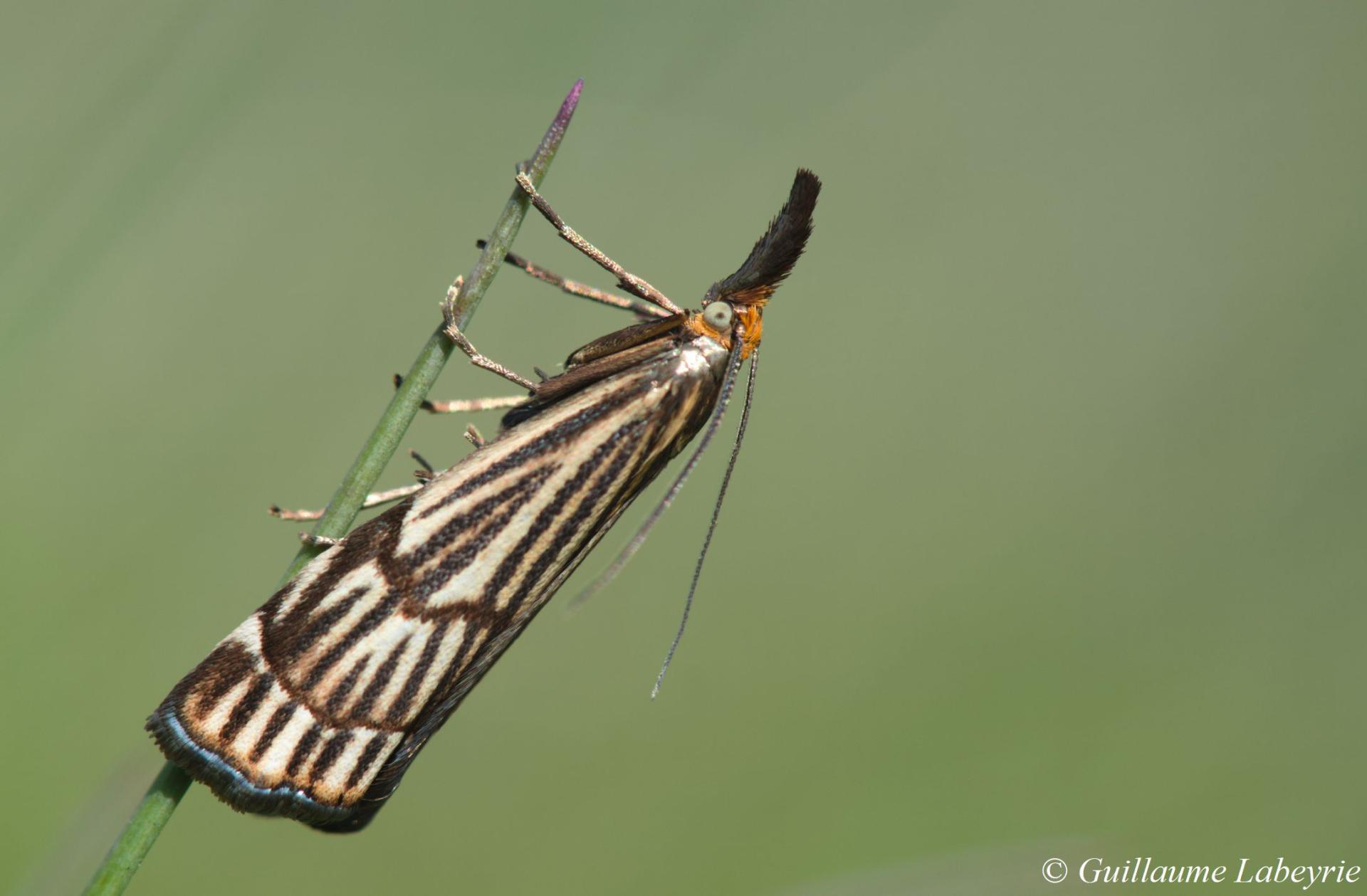
Chrysocramboides craterellus. This magnificent species barely exceeds 1 cm in length. It is common in spring on the karstic plateaus. In France, it is found mainly in the southern half.
Family : Erebidae
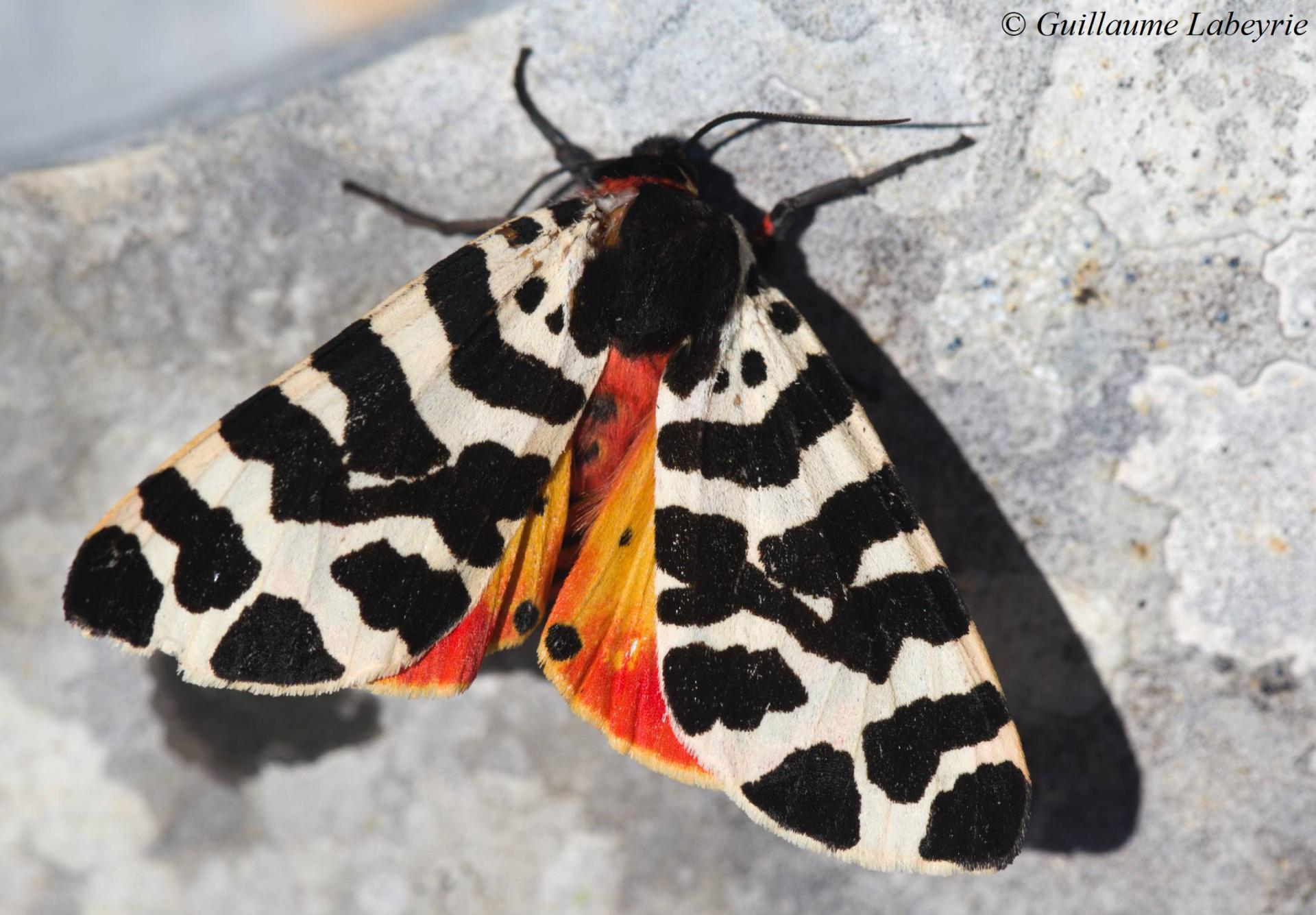
Arctia tigrina. This beautiful species is restricted to southwestern Europe. In France, it occurs in the south.
Family : Geometridae
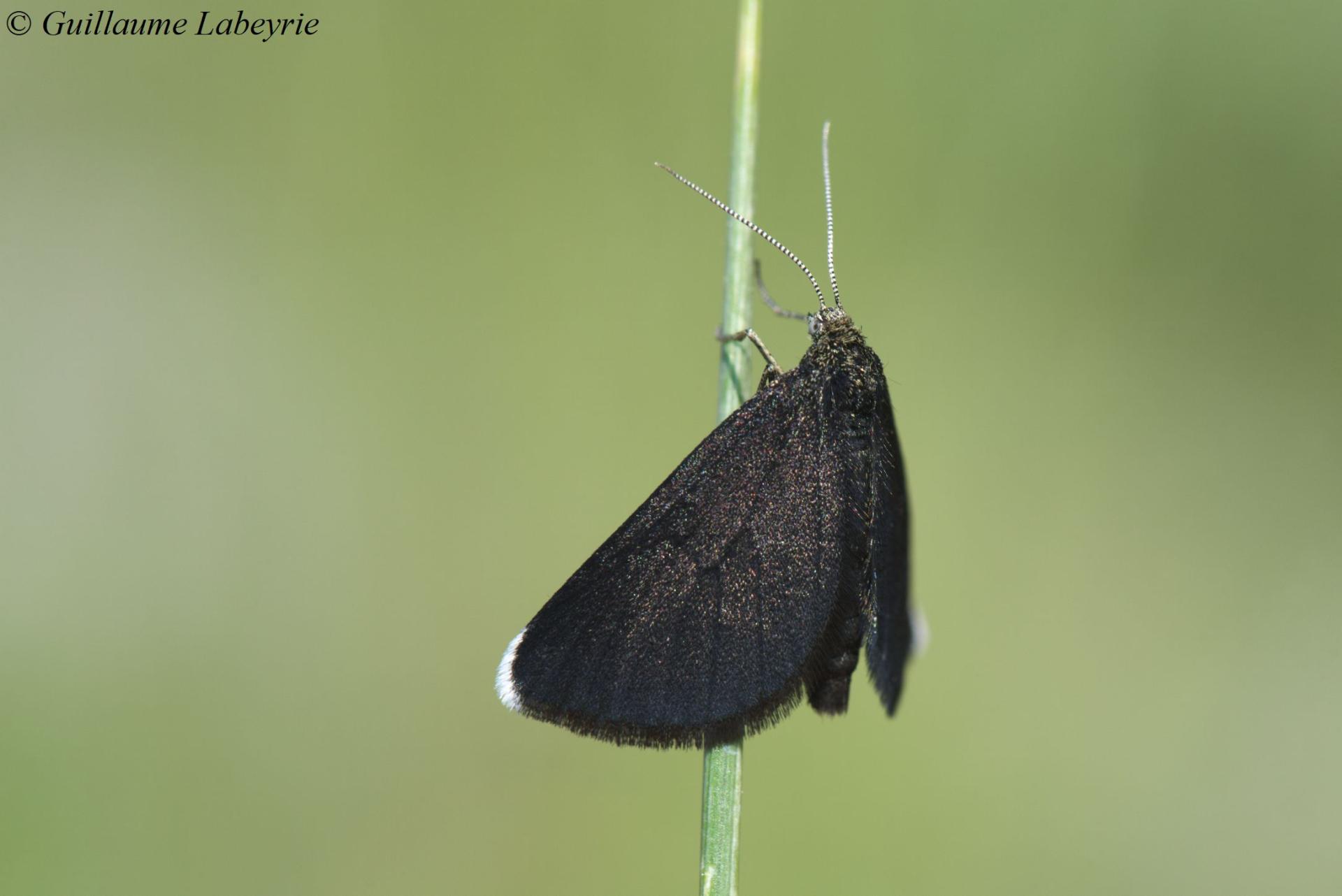
The chimney sweeper (Odezia atrata). This little moth is very characteristic with its black wings decorated with a fine white crescent at the tip. It is quite abundant in steppe grasslands in May-June. It is present throughout Europe as far as Russia and the Middle East.
Family : Pyralidae
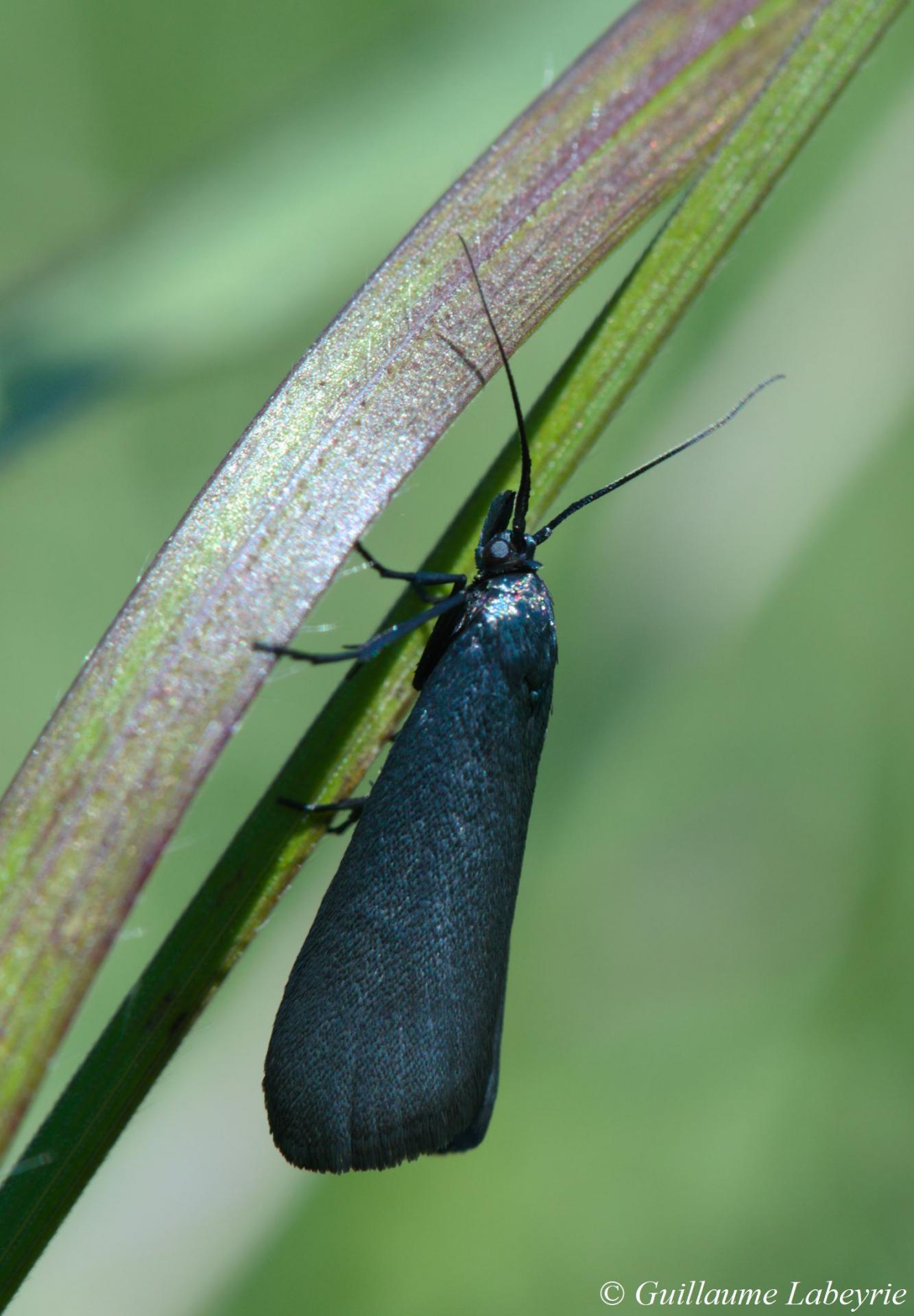 Lymphia chalybella. This small species is very dark in color, with tappered antennae. It flies in May on the limestone plateaus. It is present in France in the southern Alps.
Lymphia chalybella. This small species is very dark in color, with tappered antennae. It flies in May on the limestone plateaus. It is present in France in the southern Alps.
Hemiptera
This order regroups insects such as cicadas, aphids and shield bugs. They all share sucking mouthparts allowing them to feed on liquids, ranging from plant sap to blood of other insects or even mammals.
Family : Coreidae
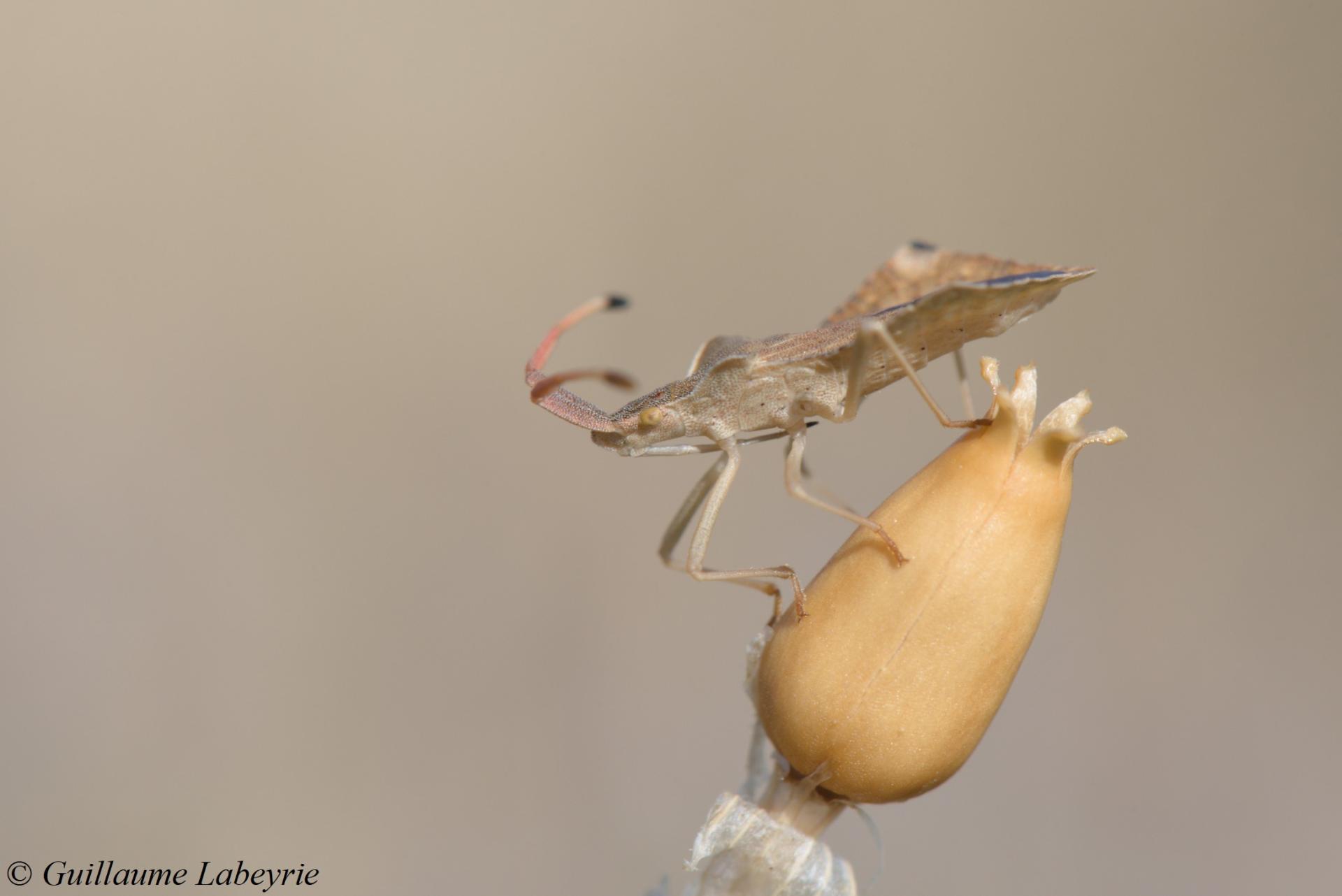
The rhombic leatherbug (Syromastus rhombeus). This species has a characteristic angular, diamond-shaped abdomen. It appreciates sunny grasslands where it often feeds on Caryophyllaceae. It is widespread throughout Europe, as far as Russia and the Middle East.
Family : Miridae
This family counts hundreds of small species that are often difficult to identify. Many are phytophageous, some are crop pests.
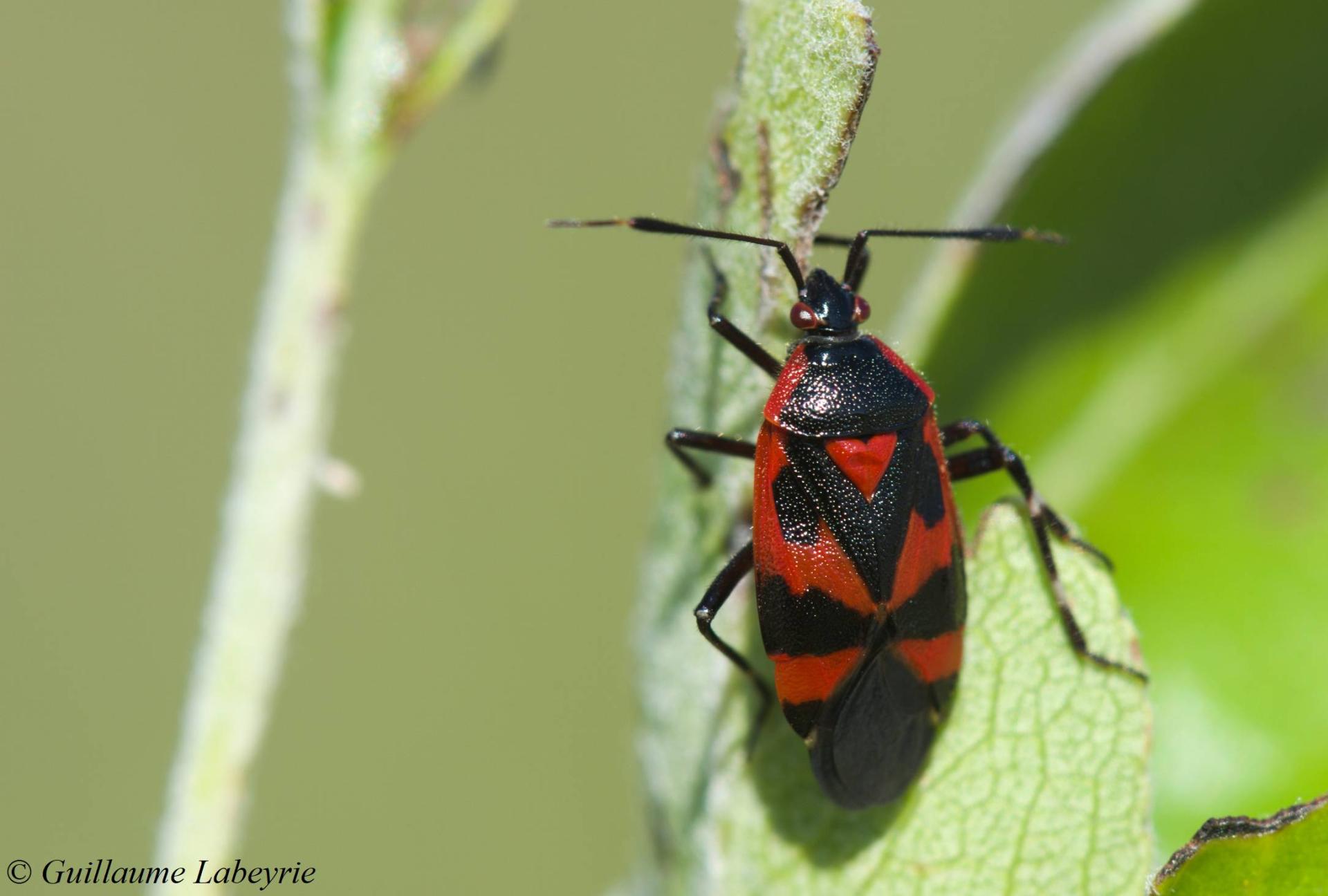
Deraeocoris trifasciatus. This pretty little bug is found on shrubs. It is present mainly in Western Europe.
Family : Pentatomidae
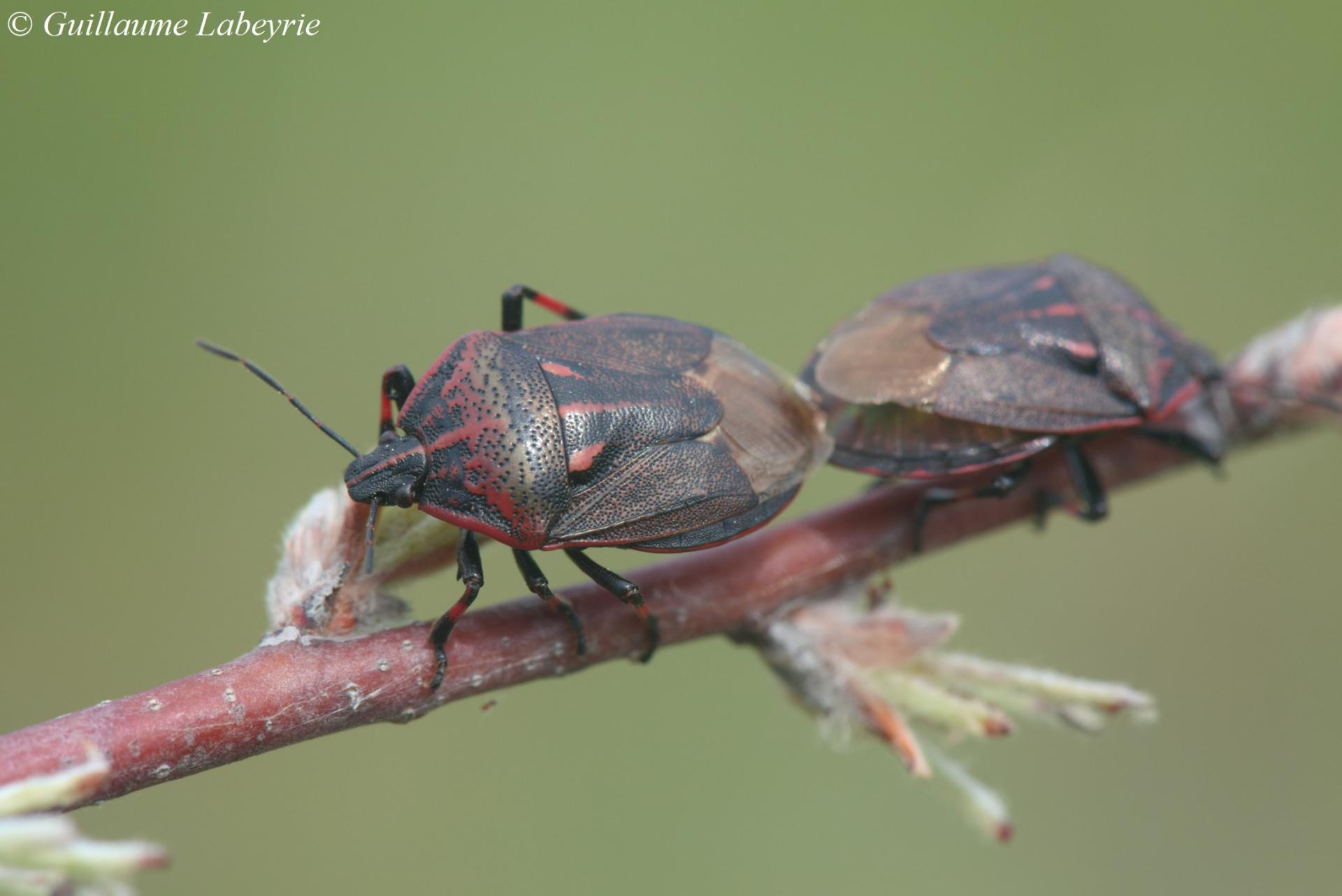
Jalla dumosa mating. This shield bug shows a very variable coloring, sometimes completely black (see below). The red or yellow line on the head is characteristic. Jalla dumosa feeds on insect larvae (mainly beetles and lepidoptera). This rare species is present in Central and Northern Europe. In France, it is mainly observed in the Massif Central and the South-East.

Jalla dumosa laying eggs. The eggs form an hexagonal pattern.
Family : Reduviidae
The members of this familly are large predatory bugs, equipped with a powerful proboscis used to pierce their prey. It is not recommended to handle them with bare hands, their sting can be painful !
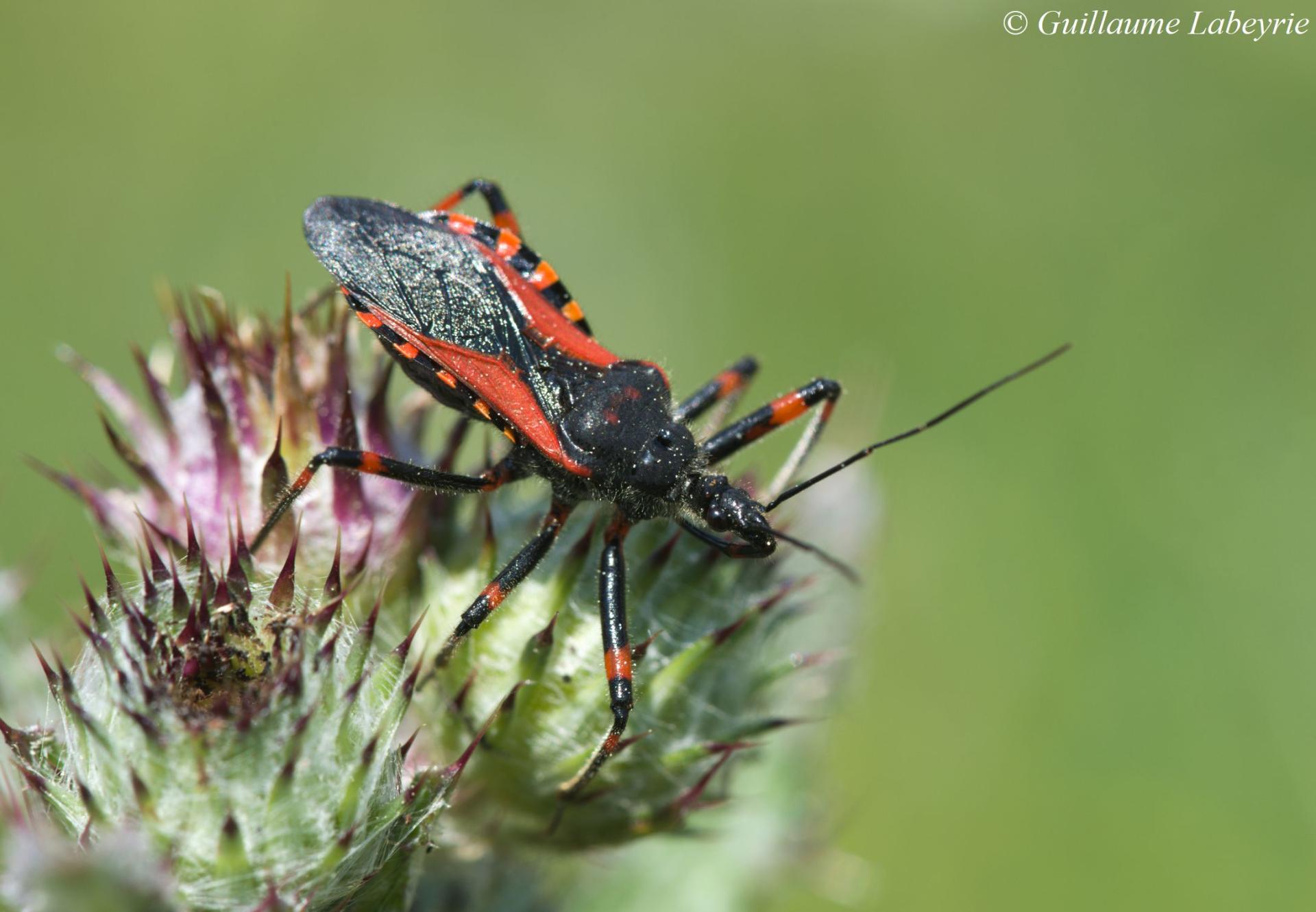 Assassin bug (Rhynocoris iracundus). This colorful species is very abundant in the Grasse Prealps. It is identified by the red upper part of the wings and the red first article of the rostrum (not very clear on this individual). There are two very similar species that are in principle inseparable on photos (identification requires examination of the genitals): R. cuspidatus and R. rubricus.
Assassin bug (Rhynocoris iracundus). This colorful species is very abundant in the Grasse Prealps. It is identified by the red upper part of the wings and the red first article of the rostrum (not very clear on this individual). There are two very similar species that are in principle inseparable on photos (identification requires examination of the genitals): R. cuspidatus and R. rubricus.
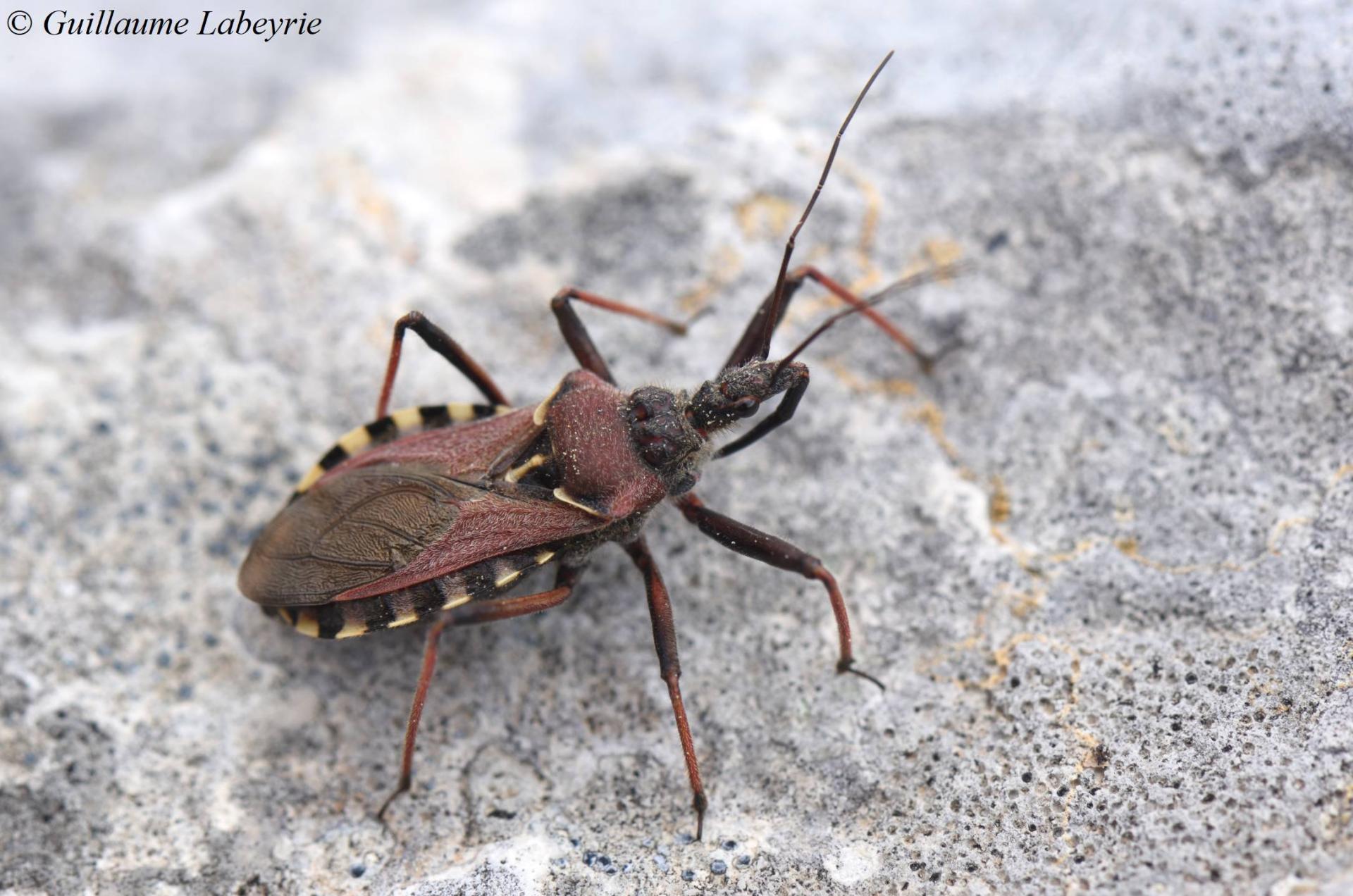
Assassin bug (Rhynocoris erythropus). This species is easily identified by the purplish tint of wings and pronotum, and the yellow line on the scutellum. It is present in Western Europe and North Africa.
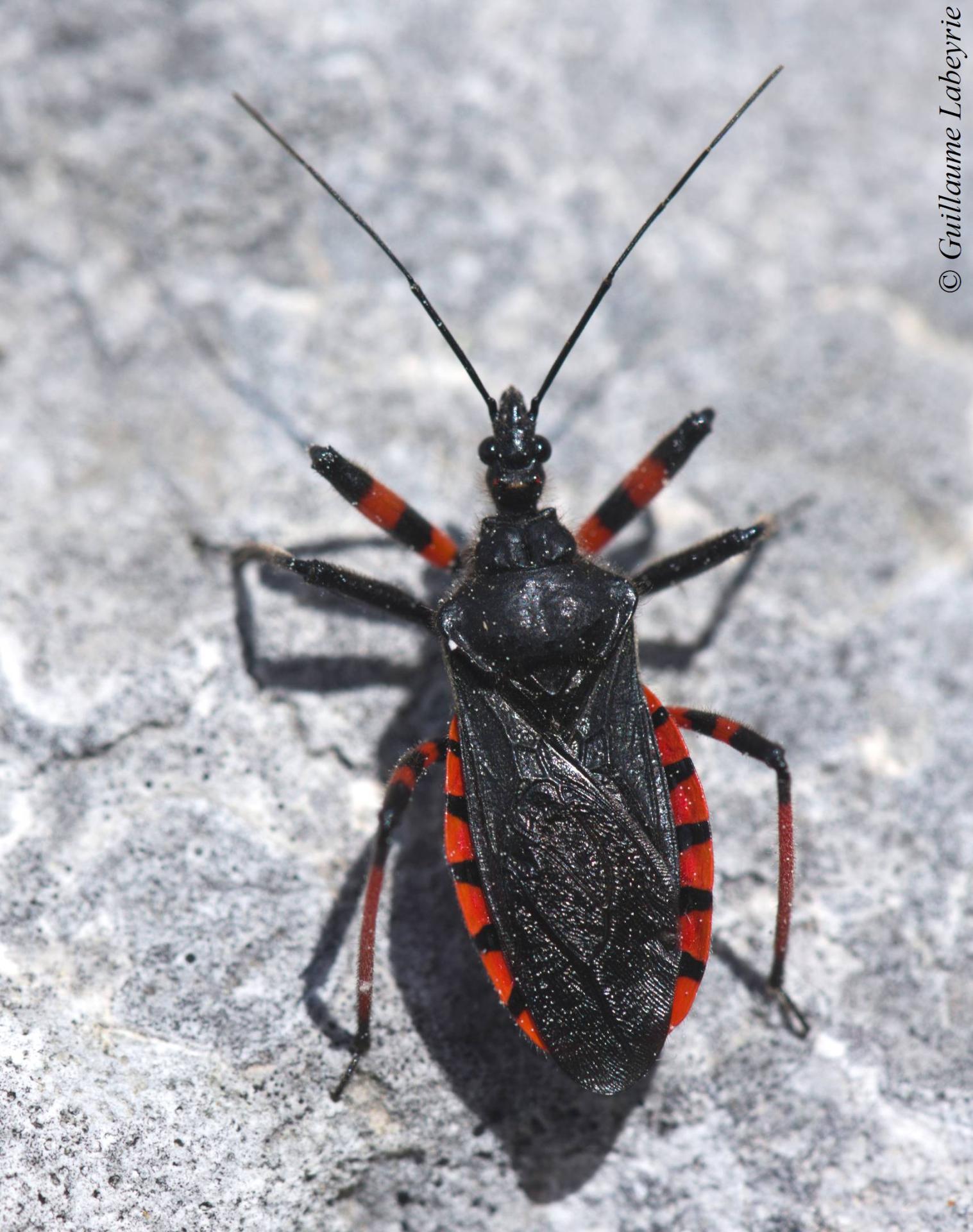
Assassin bug (Rhynocoris annulatus). This third species of assassin bug is less common than the previous two. Its wings are entirely black, which contrasts with the bright red of the abdomen. It is present in Europe (excluding the Iberian Peninsula) and Russia.
Beetles (Coleoptera)
This order numbers almost 10 000 species in France, some of them among our largest insects such as the great capricorn (Cerambyx cerdo).
Family : Cerambycidae
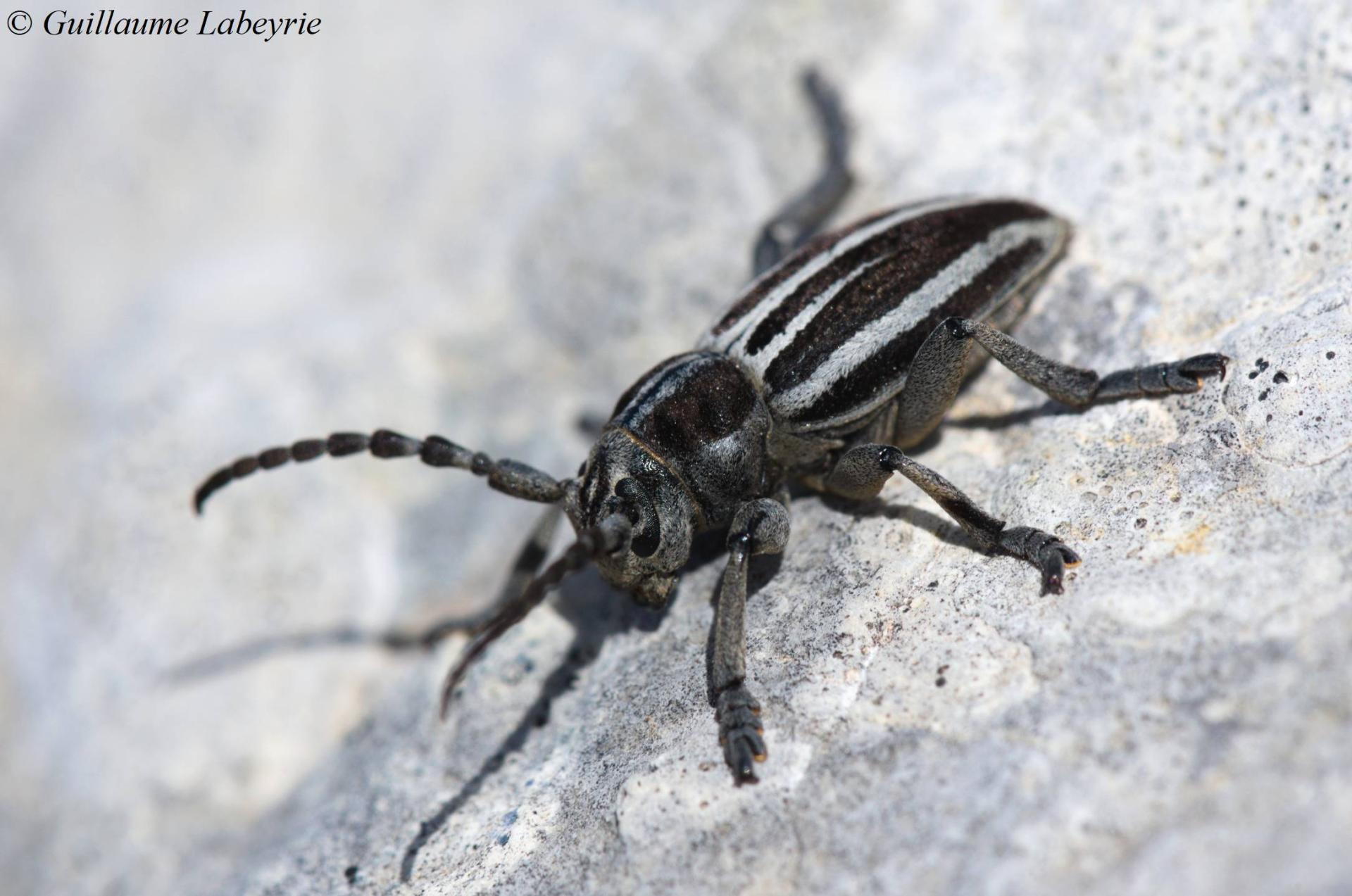
Iberodorcadion molitor. This striking longhorned beetle, measuring approximately 15 mm, has a stocky body and fairly short antennae. Another species, Iberodorcadion fuliginator, also present in the same environments, is distinguished by the absence of white bands on the pronotum. I. molitor is found in spring in rocky grasslands. This species is restricted to northeastern Spain and southern France.
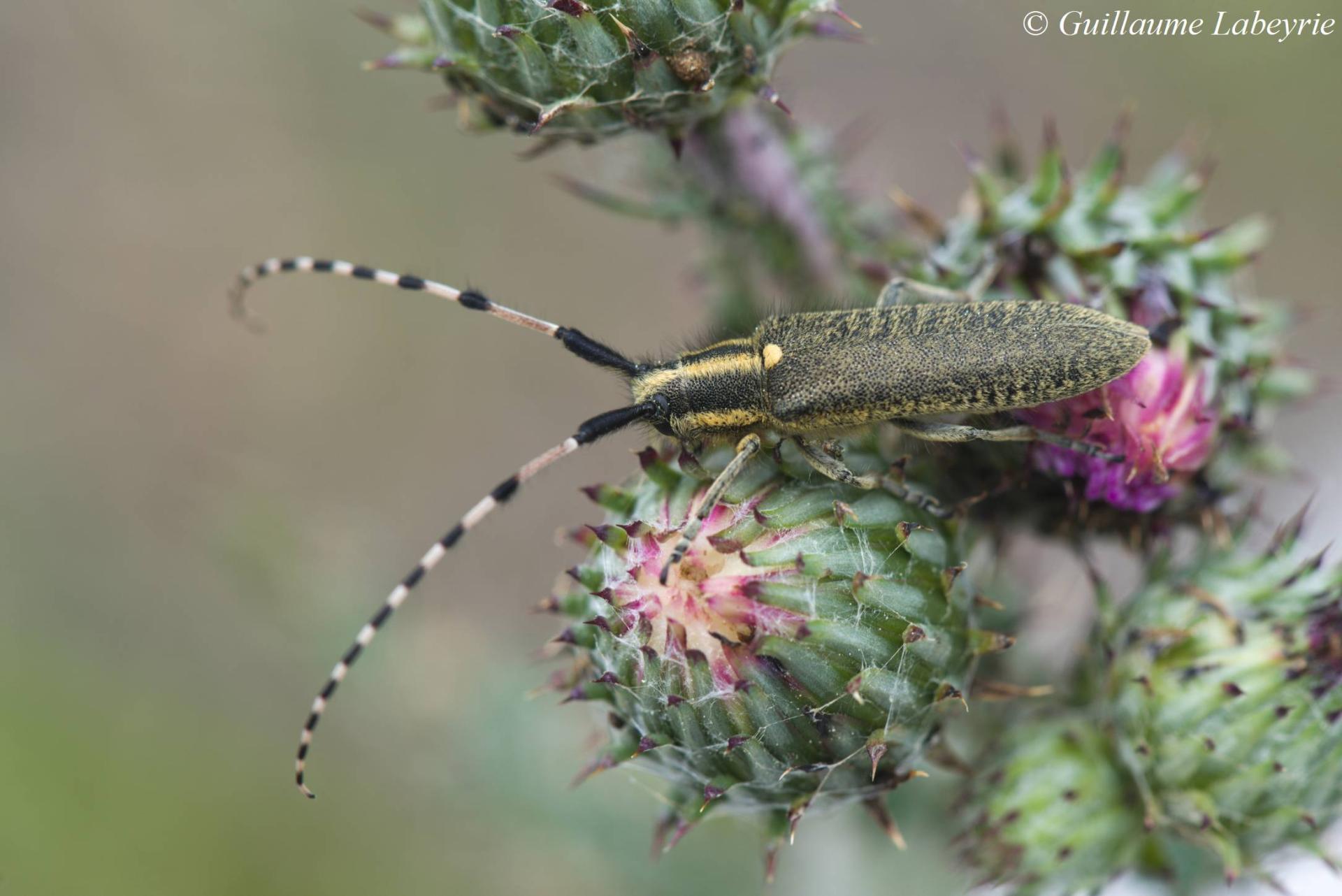
Agapanthia dahli. This magnificent insect is observed on various species of thistles. The genus Agapanthia includes several species relatively difficult to determine. Distributed in Central and Southern Europe, A. dahli is found, in France, mainly in the South.
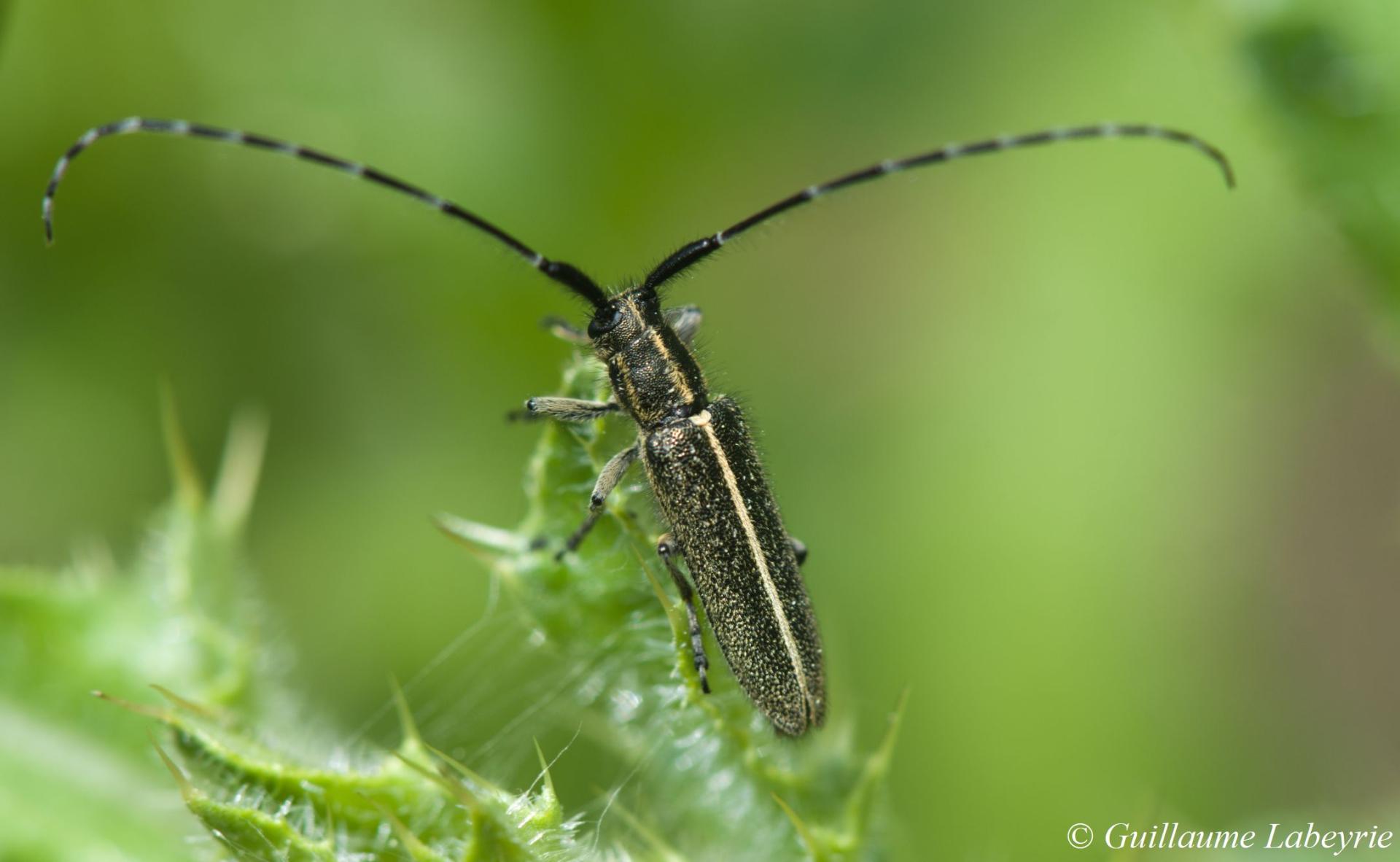
Agapanthia cardui. Much smaller than the previous species, this Agapanthia is also found on thistles. It is easily identified by the yellow inner margin of its elytra. It is present in most of Europe and France.
Family : Chrysomelidae
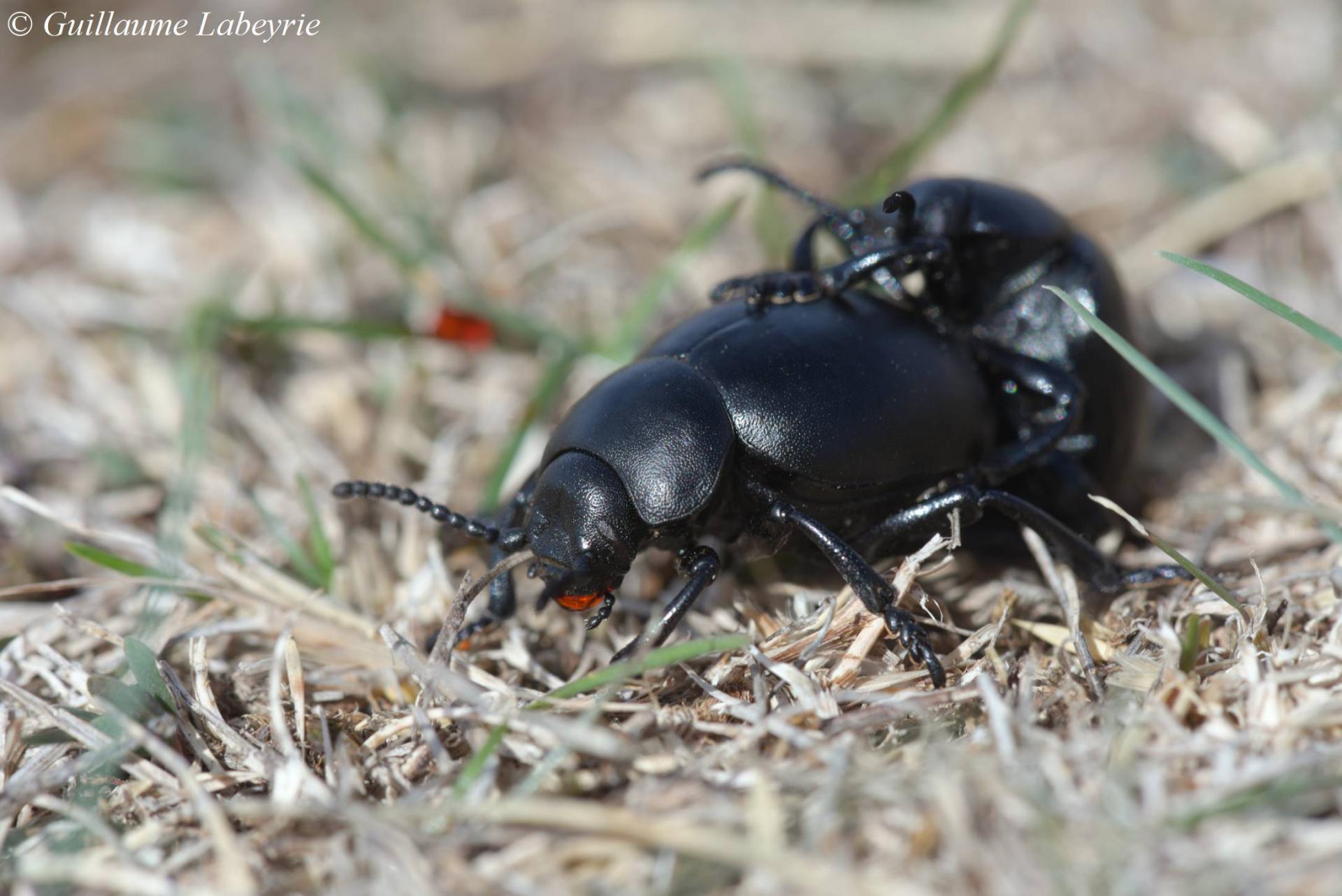
The bloody-nosed beetle (Timarcha tenebricosa). This beetle with a rotund, entirely black body is very abundant in the Prealps. When disturbed, it exudes an unpleasant-tasting bright red liquid. Two other very similar species occur in the same environment, T. niciensis and T. goettingensis. Occuring mostly in Western Europe, the bloody-nosed beetle is found everywhere in France.
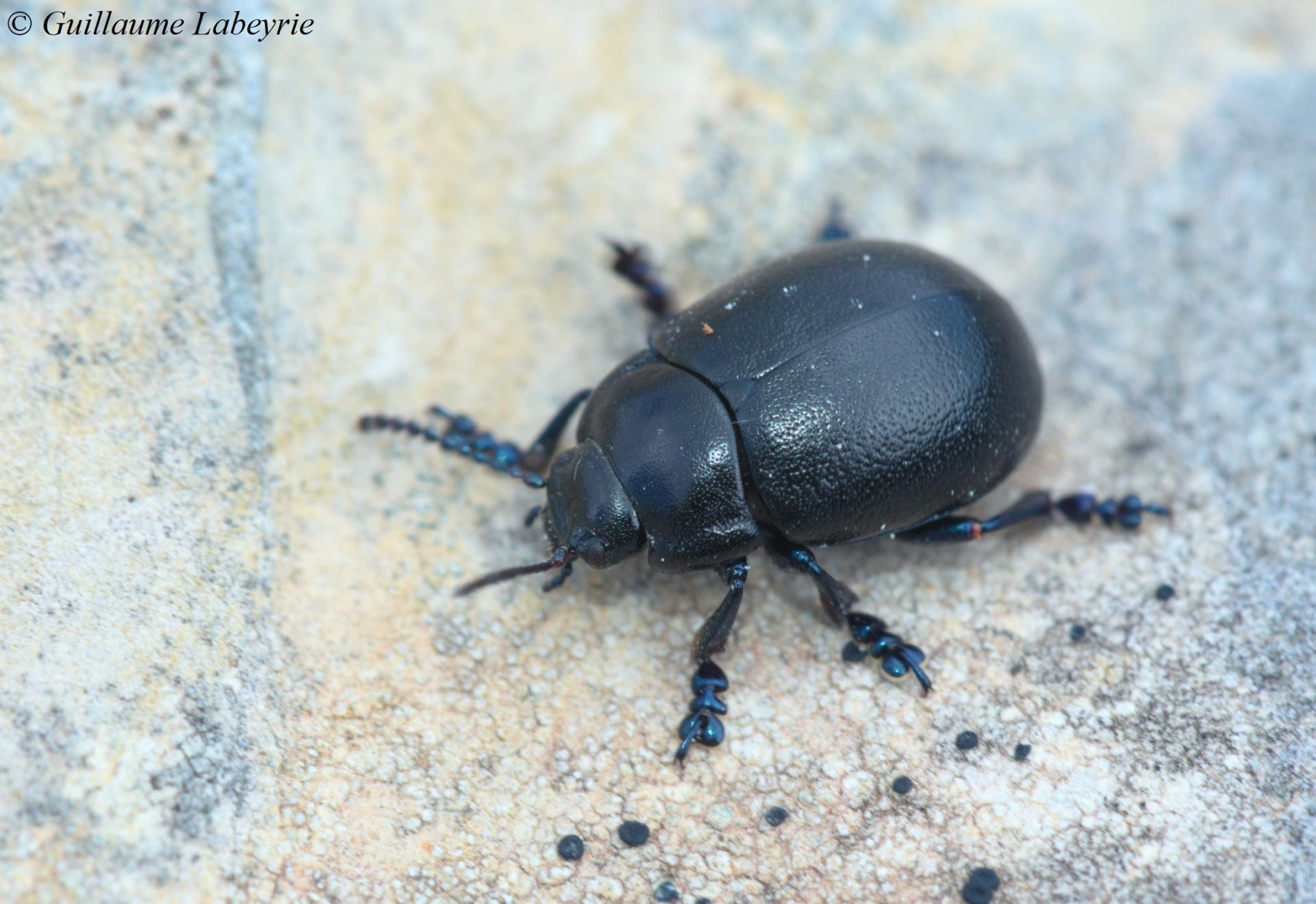 Chrysolina platypoda. This is a rare species, endemic to South-Eastern France. It can be encountered in spring, in dry rocky grasslands.
Chrysolina platypoda. This is a rare species, endemic to South-Eastern France. It can be encountered in spring, in dry rocky grasslands.
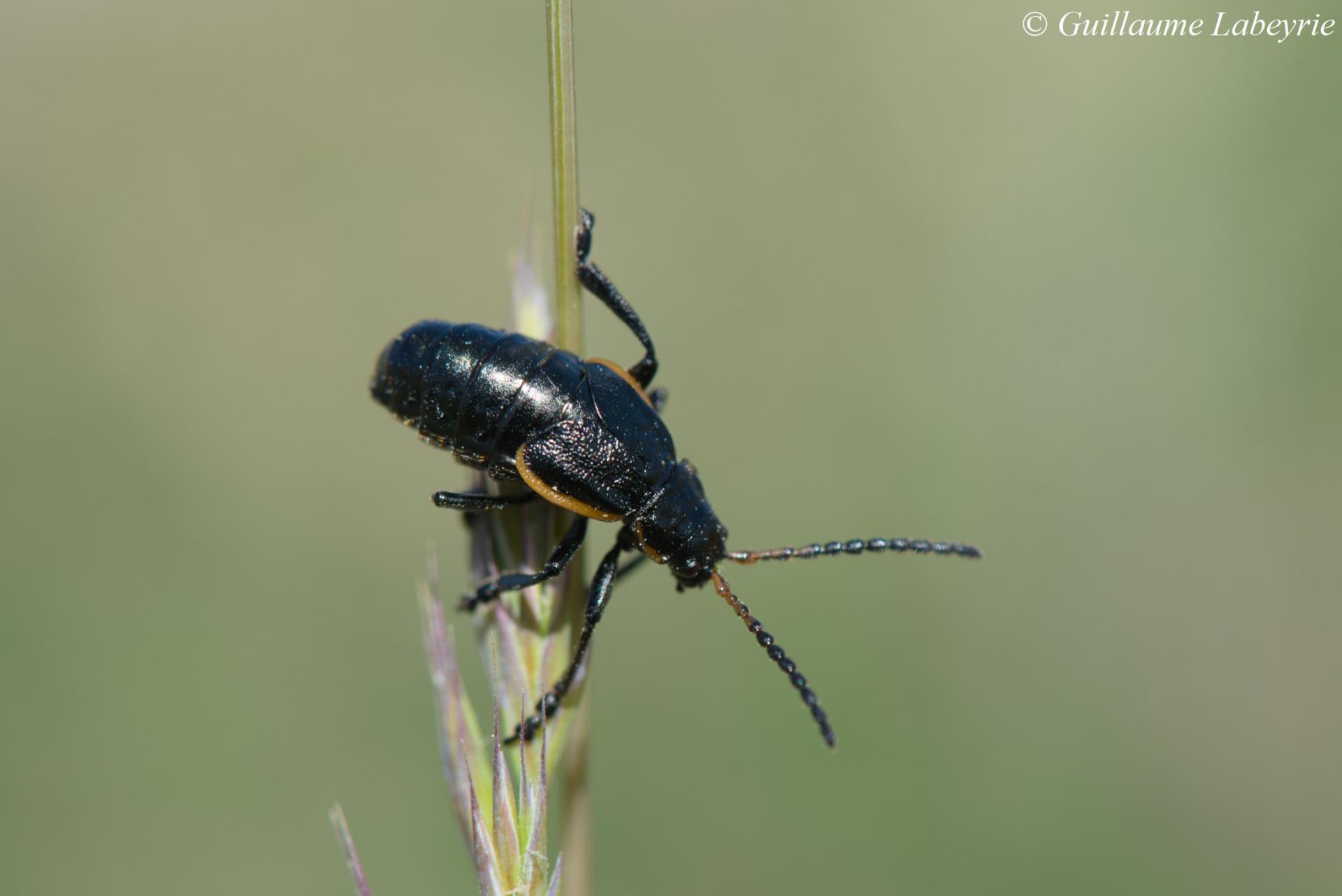 Arima marginata. This unusual species is distinguished by a soft and swollen abdomen (especially in the female), and elytra with orange borders. In the Grasse Prealps, where it is observed starting from June, it can be locally very abundant. Arima marginata has a restricted distribution, in the South-East of France and the North-West of Italy.
Arima marginata. This unusual species is distinguished by a soft and swollen abdomen (especially in the female), and elytra with orange borders. In the Grasse Prealps, where it is observed starting from June, it can be locally very abundant. Arima marginata has a restricted distribution, in the South-East of France and the North-West of Italy.
Family : Curculionidae
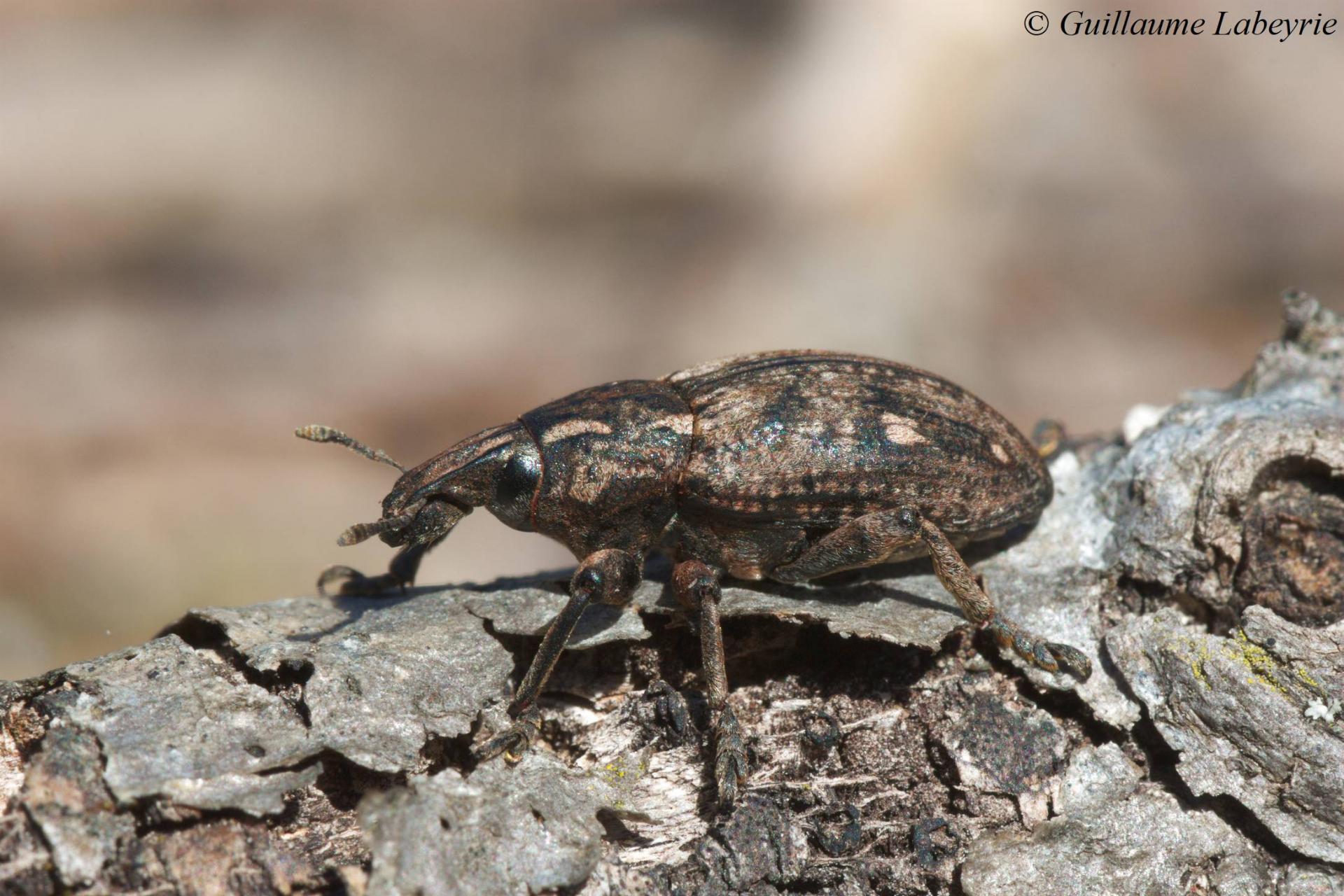
Leucophyes pedestris / occidentalis. This weevil reaches 2 cm in body length. The white spots on the elytra and the shape of the rostrum are distinctive. However, another species, L. occidentalis, is so similar that it can only be safely differentiated by the shape of the penis. In France, Leucophyes pedestris seems to be restricted to the extreme South-East, L. occidentalis being more widespread in the South-West.
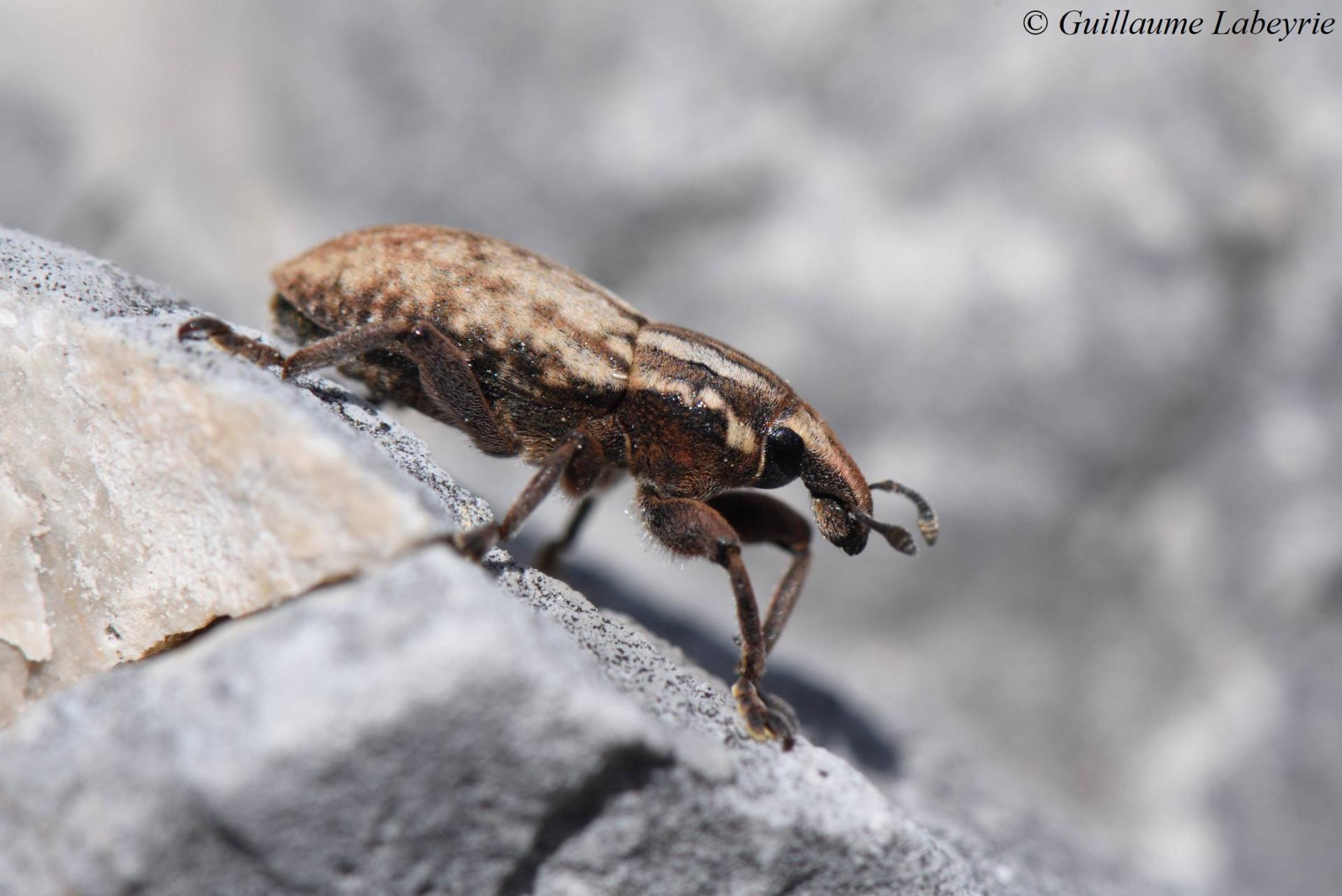
Pseudocleonus cinereus. This pretty weevil often has a golden-reddish color with two white stripes on each side of the pronotum. The majority of sightings in France are in the South-East.
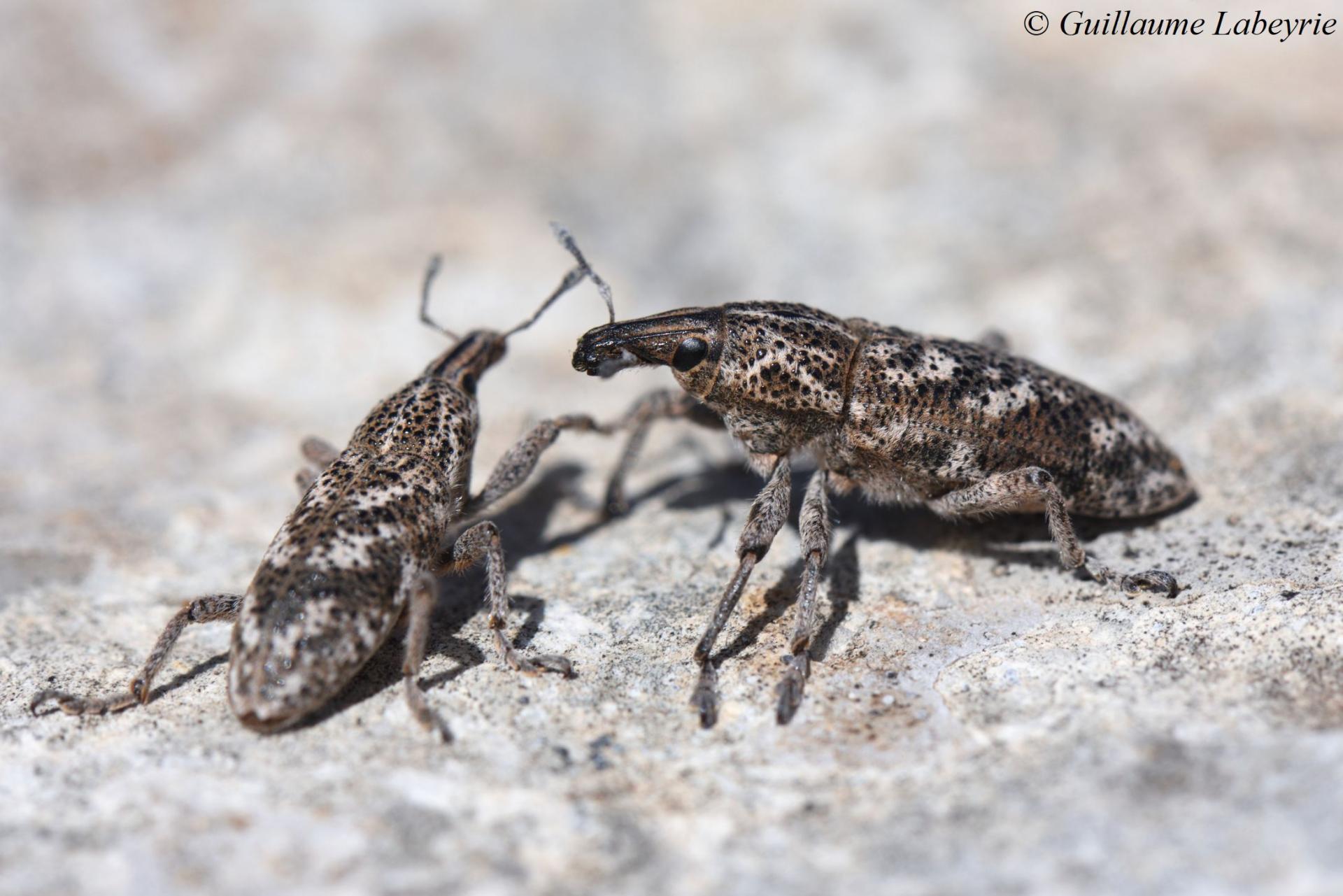
Cyphocleonus testatus. This third weevil species is also between 15 and 20 mm long. The black dots scattered on the whole body are distinctive. Little seems to be know about the distribution of Cyphocleonus testatus in France, with a few sightings in the Pyrénées-Orientales, Lubéron, and Alpes-Maritimes. This species is distributed in the Iberian Peninsula, France, Italy and North Africa.
Family : Elateridae
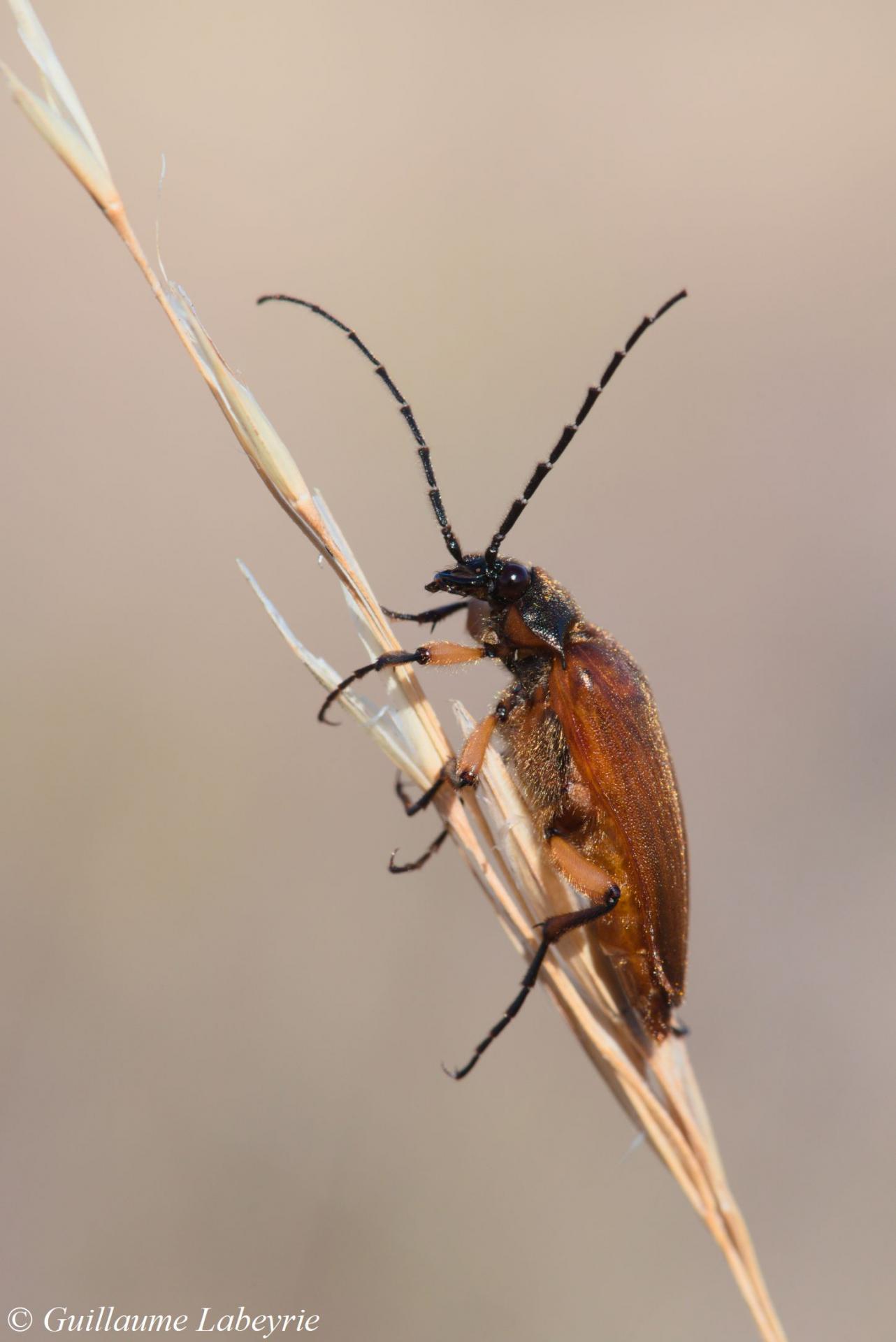 Cebrio gigas. This rather small beetle can be recognized by its elytra covered with a fine golden down, the peculiar shape of the pronotum and the reddish first segment of the legs. It is observed in September-October, always after the rain which loosens the soil and allows it to emerge. Usually only males are observed, the females remaining underground. This species is present in France in the South-East, east of the Rhône.
Cebrio gigas. This rather small beetle can be recognized by its elytra covered with a fine golden down, the peculiar shape of the pronotum and the reddish first segment of the legs. It is observed in September-October, always after the rain which loosens the soil and allows it to emerge. Usually only males are observed, the females remaining underground. This species is present in France in the South-East, east of the Rhône.
Family : Histeridae
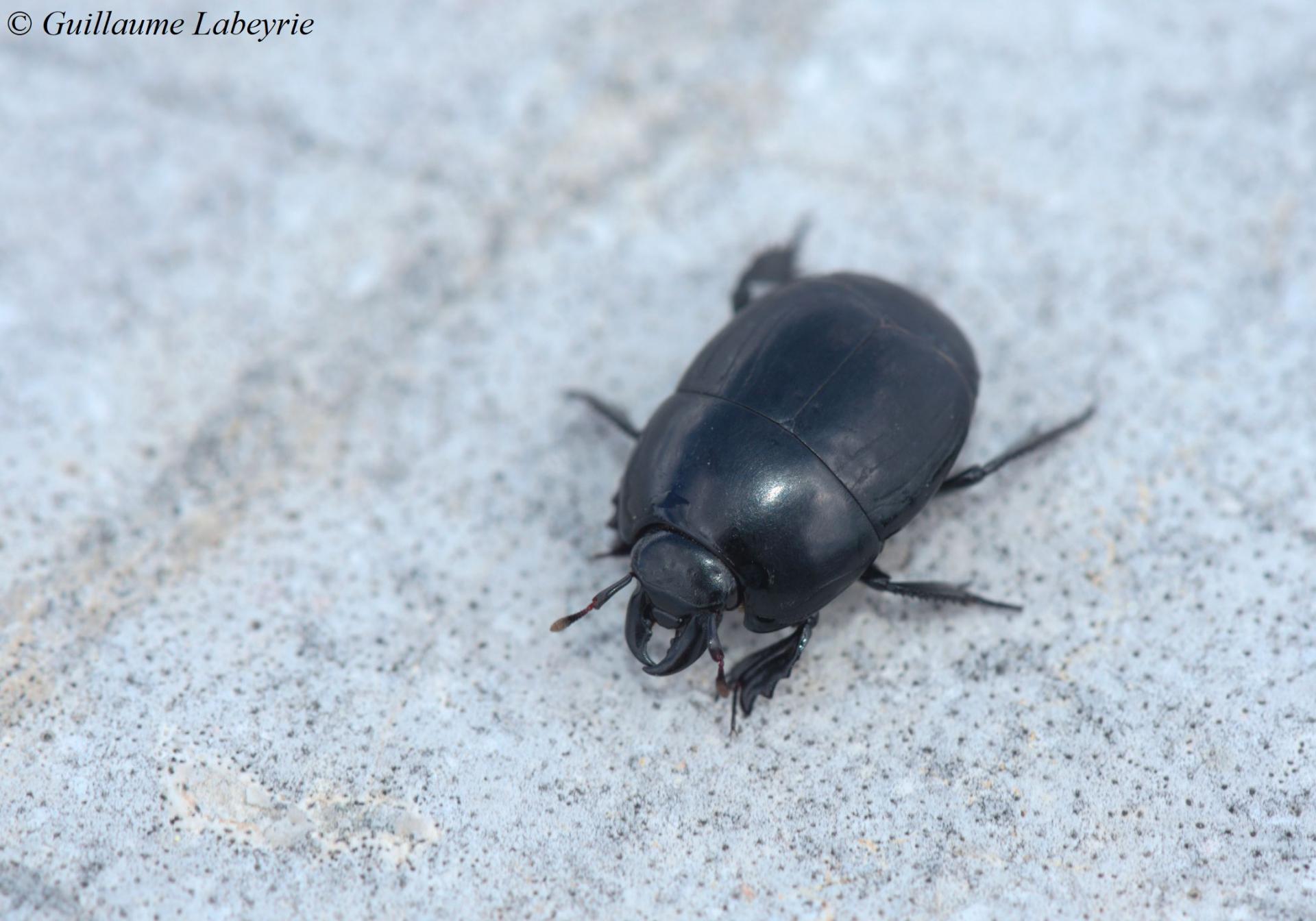
Hister grandicollis. Members of the genus Hister are strange little beetles a little less than a centimeter long with flattened fore tibiae and strong mandibles. Carnivores, they often hide in decomposing organic matter. Hister grandicollis is a rare species in France, observed only in the Pyrénées-Orientales and the Alpes-Maritimes. It is found only in the Iberian Peninsula and in France.
Diptera
This order includes flies, horseflies and other mosquitoes. There are around 8 500 species in France.
Family : Ulidiidae
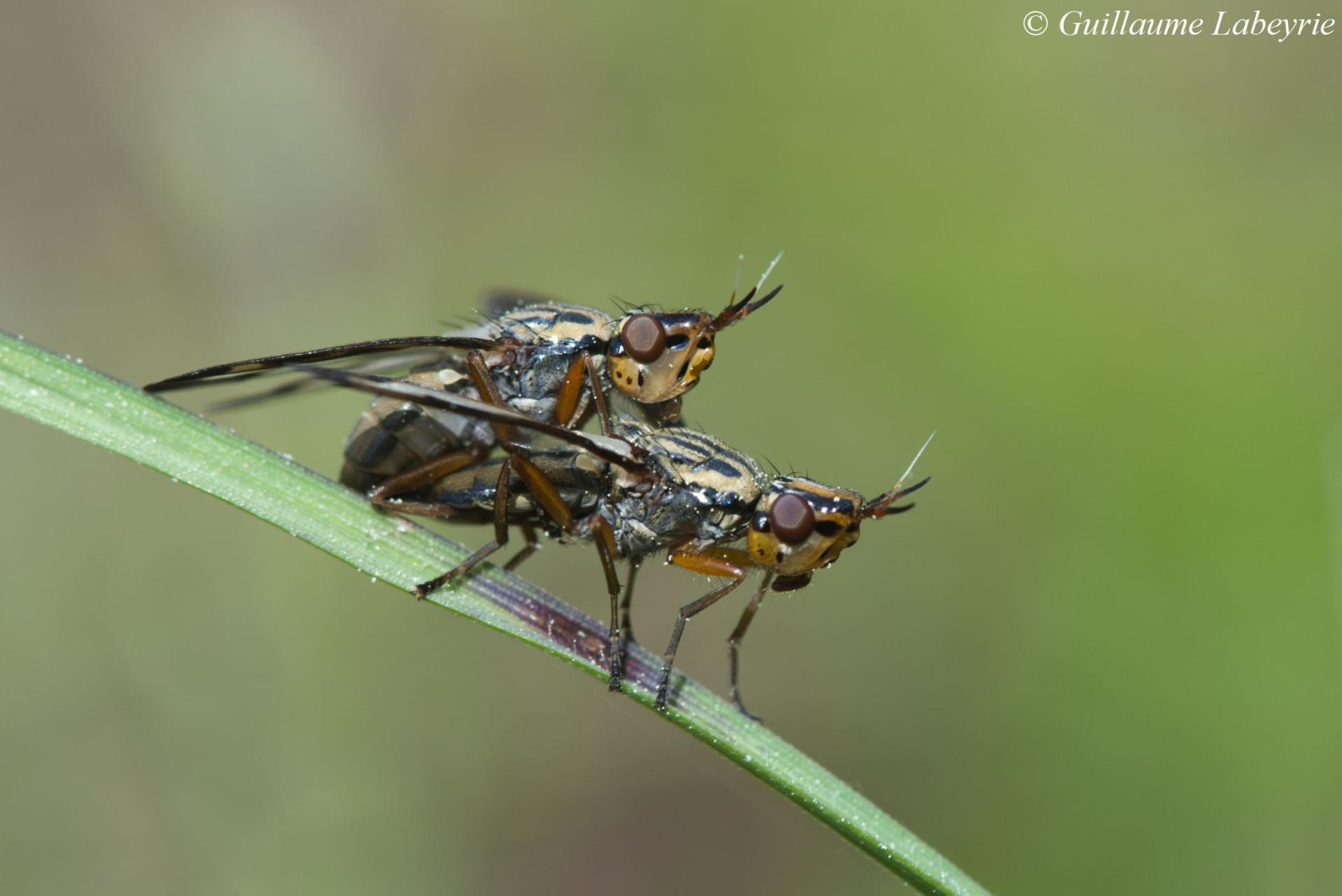
Dorycera grandis. This striking fly frequents flowering meadows in spring. It has a restricted distribution (France, Italy). In France, it is mainly observed in the extreme South-East, east of the Rhône.
Mantids
Only a few species of mantids occur in France, most of them in the south.
Family : Mantidae
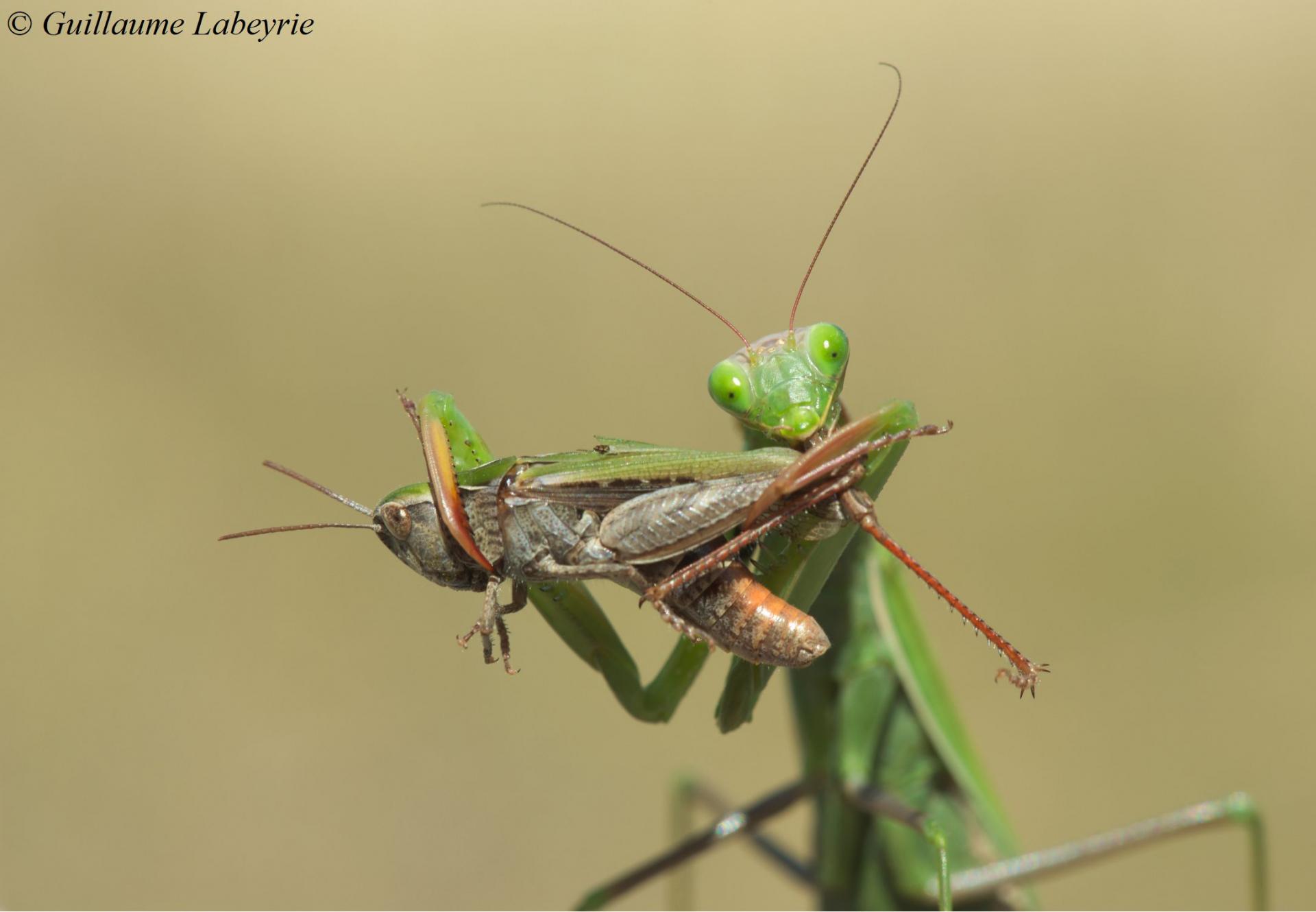 Praying mantis (Mantis religiosa) eating a grasshopper. During the end of summer, grasshoppers are very abundant in the dry meadows and their predators as well, including the praying mantis. It can come in different colors, from green to brown. In most of France, this is the only mantis that can be observed. Several less common species are also found in the southern part of the country (see below).
Praying mantis (Mantis religiosa) eating a grasshopper. During the end of summer, grasshoppers are very abundant in the dry meadows and their predators as well, including the praying mantis. It can come in different colors, from green to brown. In most of France, this is the only mantis that can be observed. Several less common species are also found in the southern part of the country (see below).
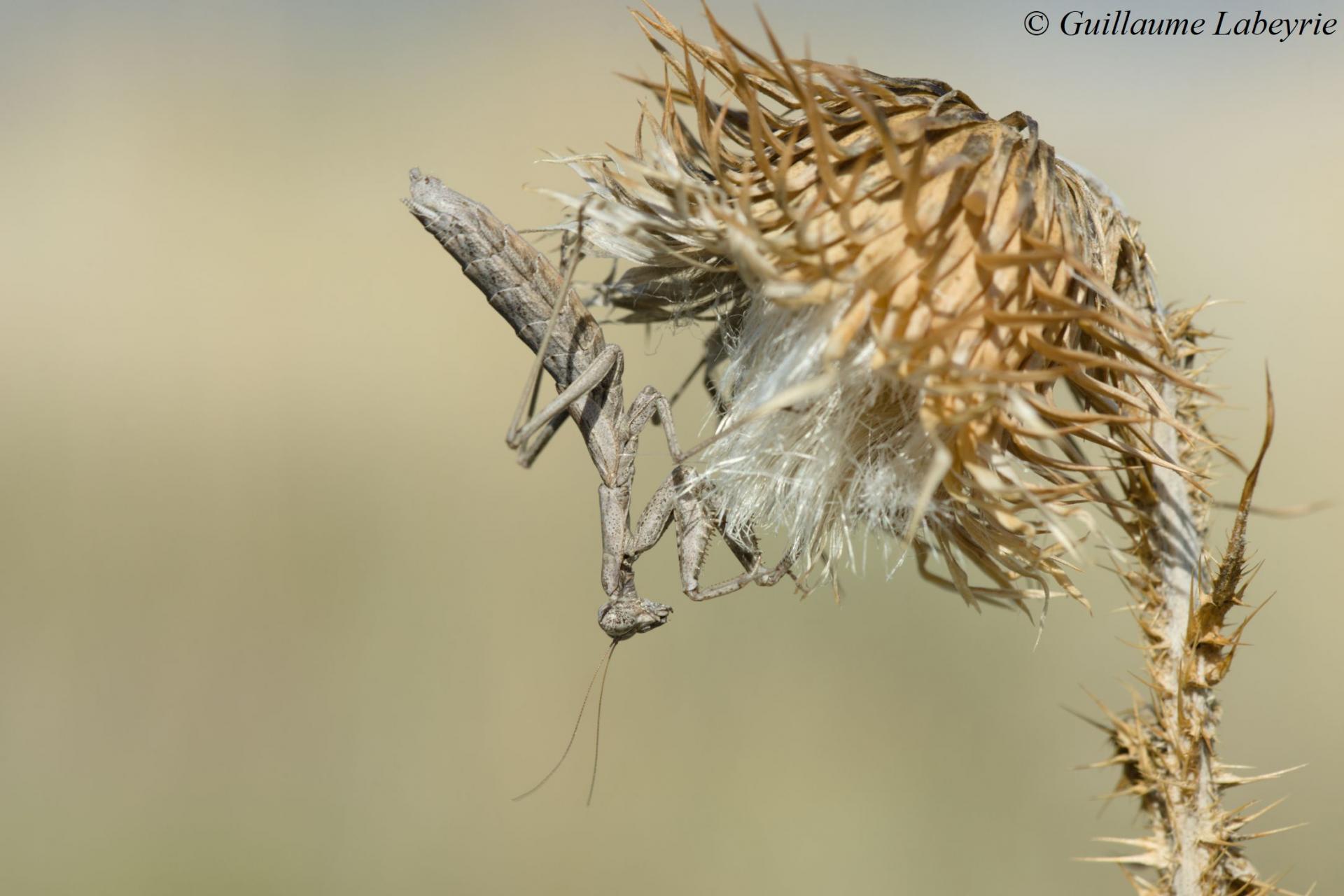 Ameles decolor. This small mantis is often difficult to spot in the dry vegetation, due to its brown or grey color. The female, shown here, has very short wings while the male's are longer than the abdomen. Quite common at low elevation, this species also occurs in the dry grasslands of the Préalpes de Grasse up to 1500 m of altitude. A species of southern Europe, Ameles decolor is only found in France in the south east.
Ameles decolor. This small mantis is often difficult to spot in the dry vegetation, due to its brown or grey color. The female, shown here, has very short wings while the male's are longer than the abdomen. Quite common at low elevation, this species also occurs in the dry grasslands of the Préalpes de Grasse up to 1500 m of altitude. A species of southern Europe, Ameles decolor is only found in France in the south east.
Orthopterans (Orthoptera)
At the end of summer, the dry grasslands in low mountains are the kingdom of Orthopterans (grasshoppers, katydids and others crickets), with a stunning diversity of shapes and colors.
Family : Gryllidae
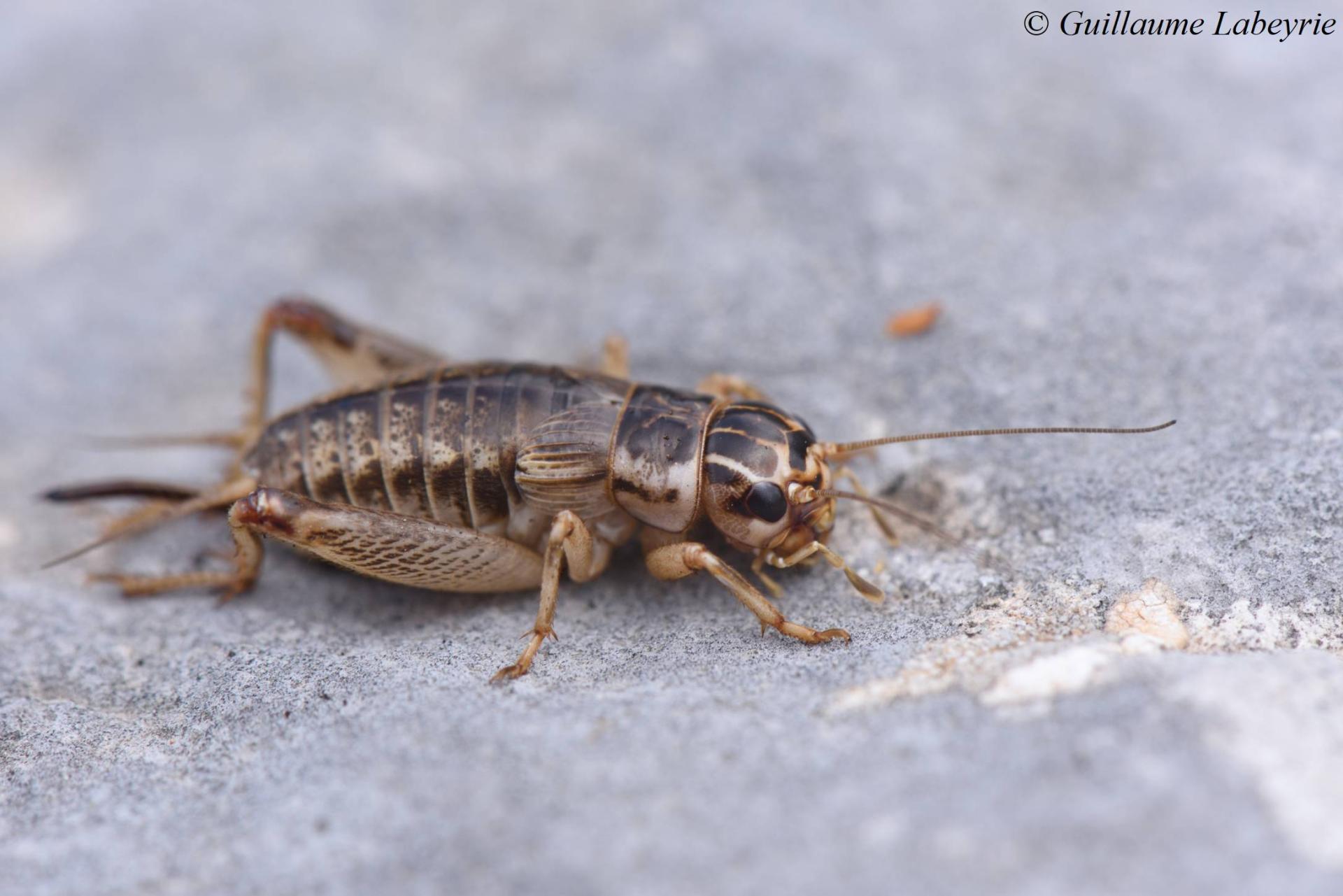
The common mountain-cricket (Eugryllodes pipiens). This small cricket frequents rocky grasslands in low mountains, where it hides under stones. It is therefore discreet and can often be identified by its song (a regular series of high and very short notes) emitted at dusk. This species is found in France (South-East and Pyrenees Orientales) and in Spain.
Family : Tettigonidae / Sub-Family : Saginae
 The spiked magician (Saga pedo). This stunning bush cricket, one of the largest insects in Europe (body size up to 12 cm), is found in dry areas from sea level up to altitudes of 1700 m. This species is reproducing par parthenogenesis, only females are known in Europe. Saga pedo is exclusively carnivorous, and hunts mainly at night. This rare species, listed as "vulnerable" by IUCN, has a wide distribution spanning from southern France to China.
The spiked magician (Saga pedo). This stunning bush cricket, one of the largest insects in Europe (body size up to 12 cm), is found in dry areas from sea level up to altitudes of 1700 m. This species is reproducing par parthenogenesis, only females are known in Europe. Saga pedo is exclusively carnivorous, and hunts mainly at night. This rare species, listed as "vulnerable" by IUCN, has a wide distribution spanning from southern France to China.
Family : Tettigonidae / Sub-Family : Bradyporinae
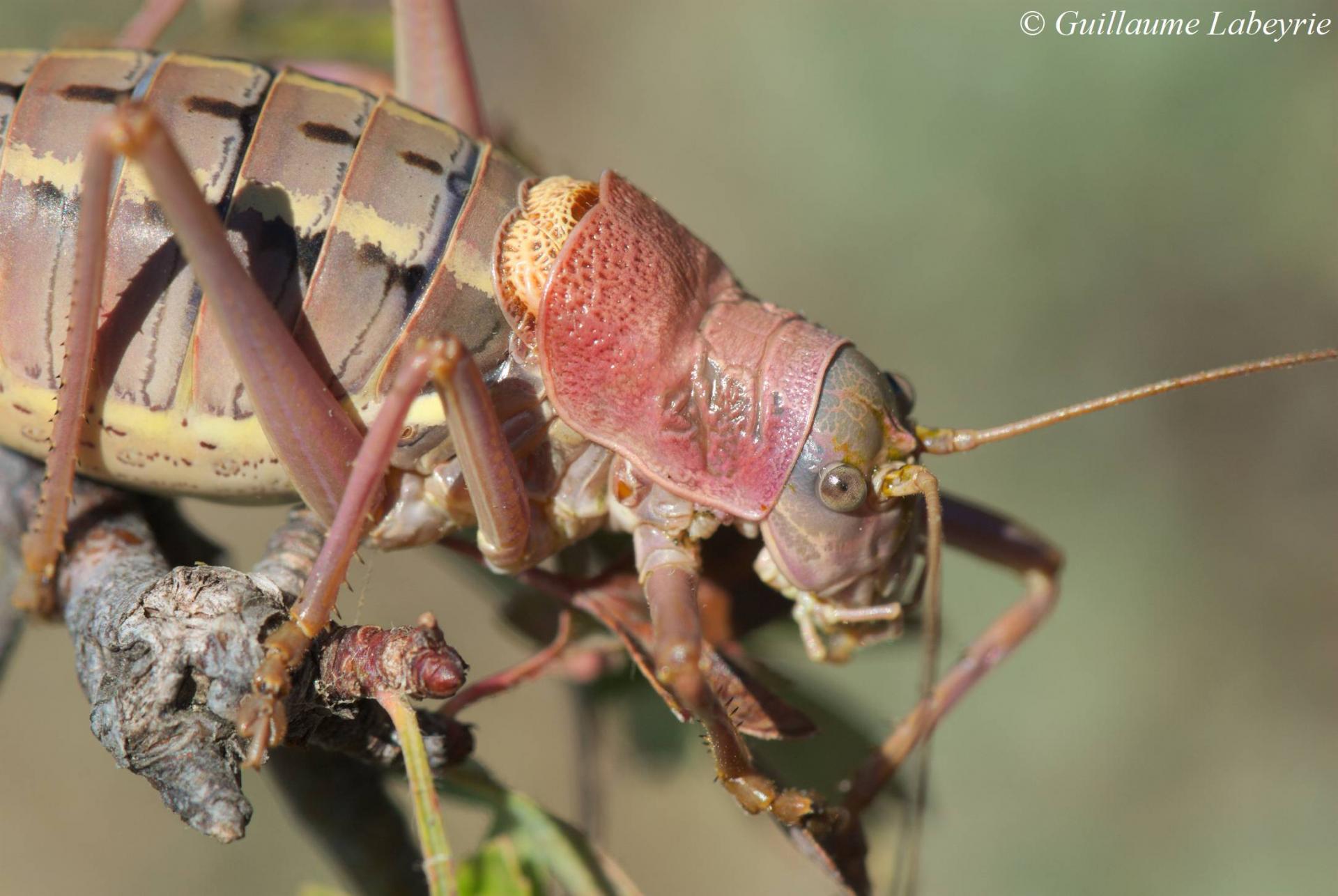 Bush cricket (Ephippiger terrestris subsp. terrestris). This large bush cricket has a pronotum with a distinctive saddle shape. The female sports a long ovipositor to burry eggs in the ground. This species is restricted in France to the extreme South-East, where it inhabits dry grasslands in low mountains (between 1000 m and 2000 m of altitude).
Bush cricket (Ephippiger terrestris subsp. terrestris). This large bush cricket has a pronotum with a distinctive saddle shape. The female sports a long ovipositor to burry eggs in the ground. This species is restricted in France to the extreme South-East, where it inhabits dry grasslands in low mountains (between 1000 m and 2000 m of altitude).
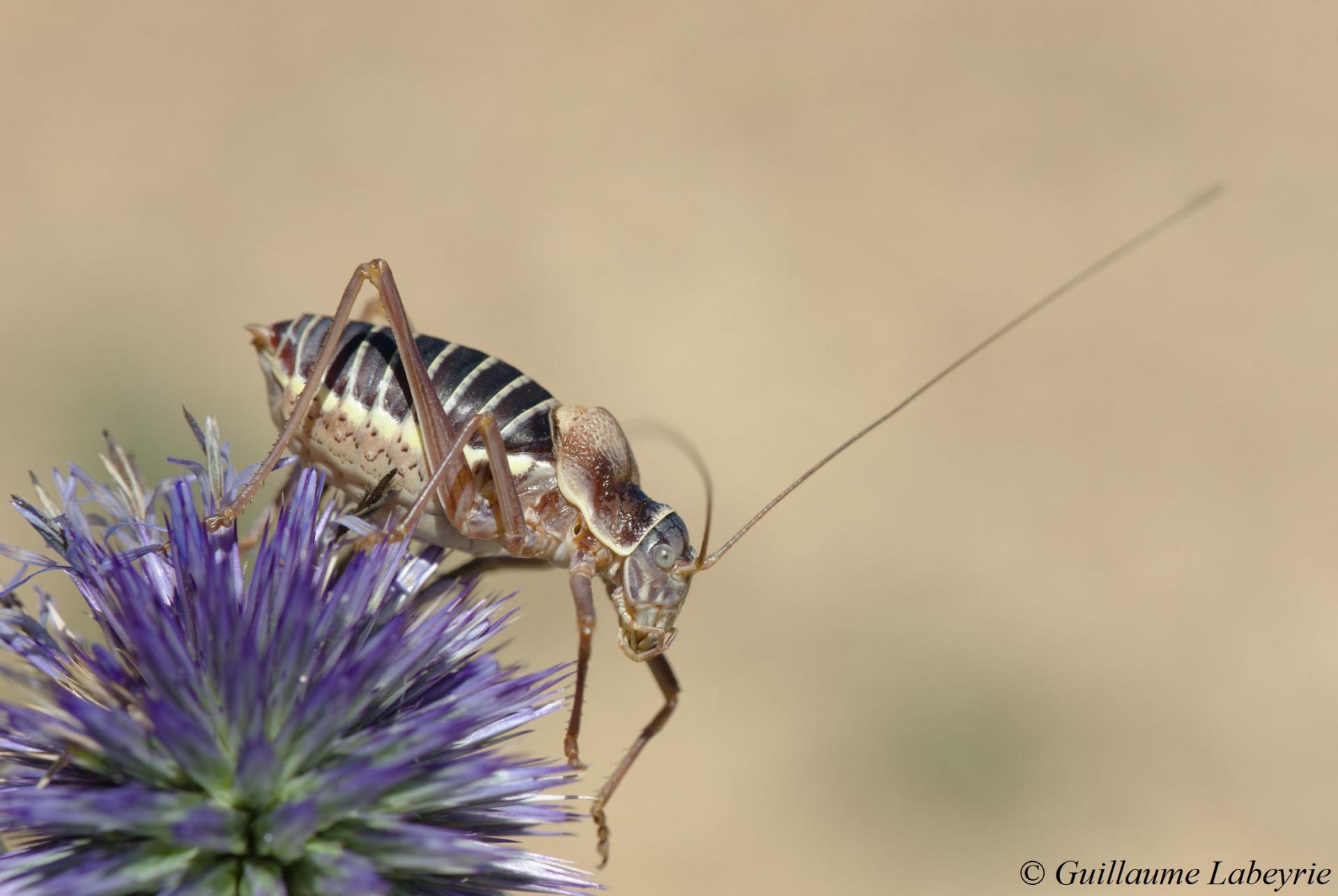 Ephippiger diurnus. This species differs from the previous one by its distinctive stripped pattern, due to the dark abdominal plates with clear edges. It is widespread in France but rare in the Alpes-Maritimes, where it seems to occur mainly in the Préalpes de Grasse.
Ephippiger diurnus. This species differs from the previous one by its distinctive stripped pattern, due to the dark abdominal plates with clear edges. It is widespread in France but rare in the Alpes-Maritimes, where it seems to occur mainly in the Préalpes de Grasse.
Family : Tettigonidae / Sub-Family : Phaneropterinae
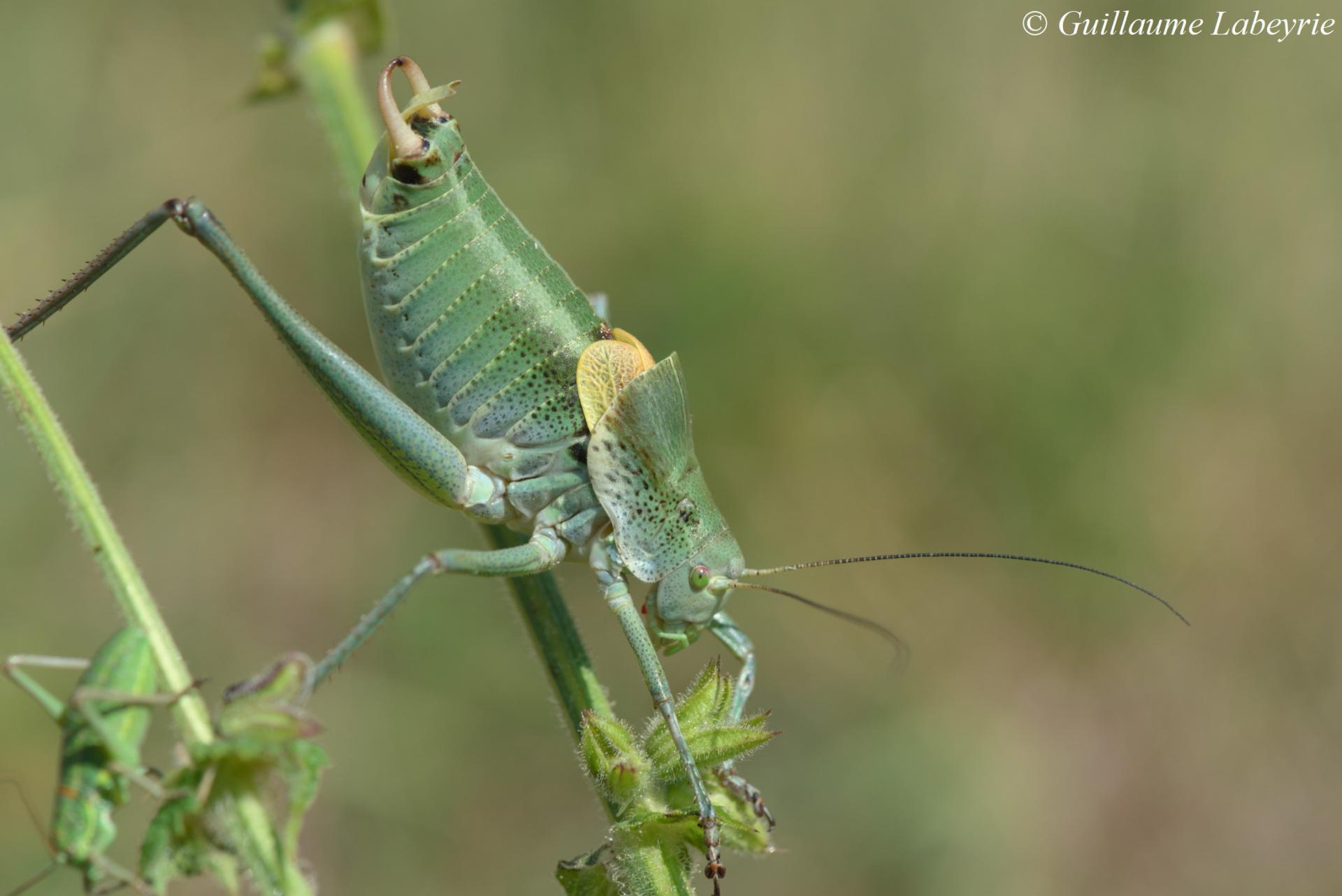
Large saw-tailed bush cricket (Polysarcus denticauda). This bulky bush cricket is found in dry grasslands above 1000 m. The tip of the female's ovipositor is barbed. This species occurs in mountains of central and southern Europe. In the Alpes Maritimes, this is a rather local and uncommon species.
Family : Tettigonidae / Sub-Family : Tettigoninae
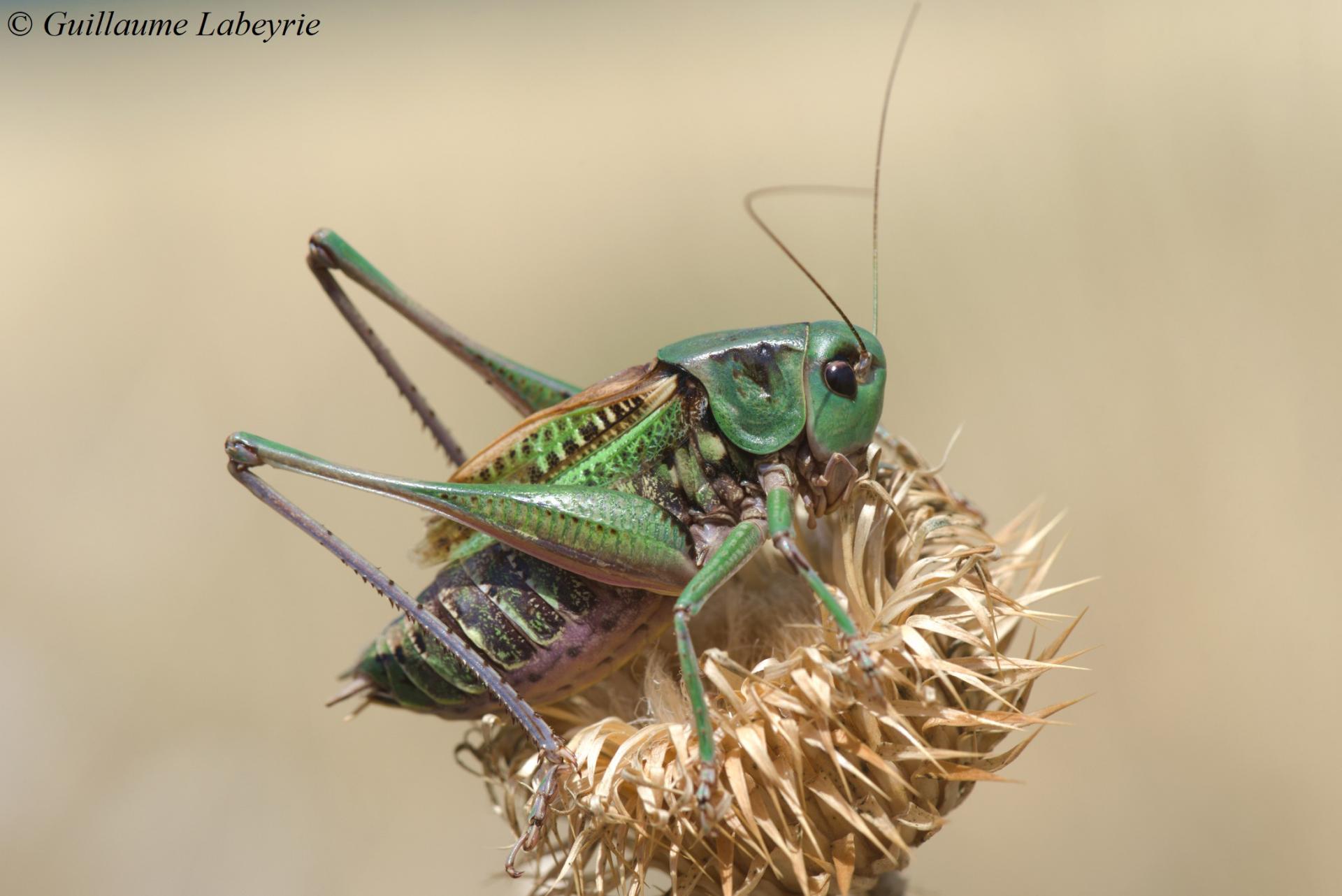 The wart-biter (Decticus verrucivorus). This large bush-cricket appreciates dry mountain grasslands. Its color varies from green to brown. In spite of its size, this species is preyed on by Narbonne's wolf-spider (Lycosa tarentula). The wart-biter is present in most of Europe and Asia. It is getting scarcer in the west (threatened with extinction in Great-Britain).
The wart-biter (Decticus verrucivorus). This large bush-cricket appreciates dry mountain grasslands. Its color varies from green to brown. In spite of its size, this species is preyed on by Narbonne's wolf-spider (Lycosa tarentula). The wart-biter is present in most of Europe and Asia. It is getting scarcer in the west (threatened with extinction in Great-Britain).
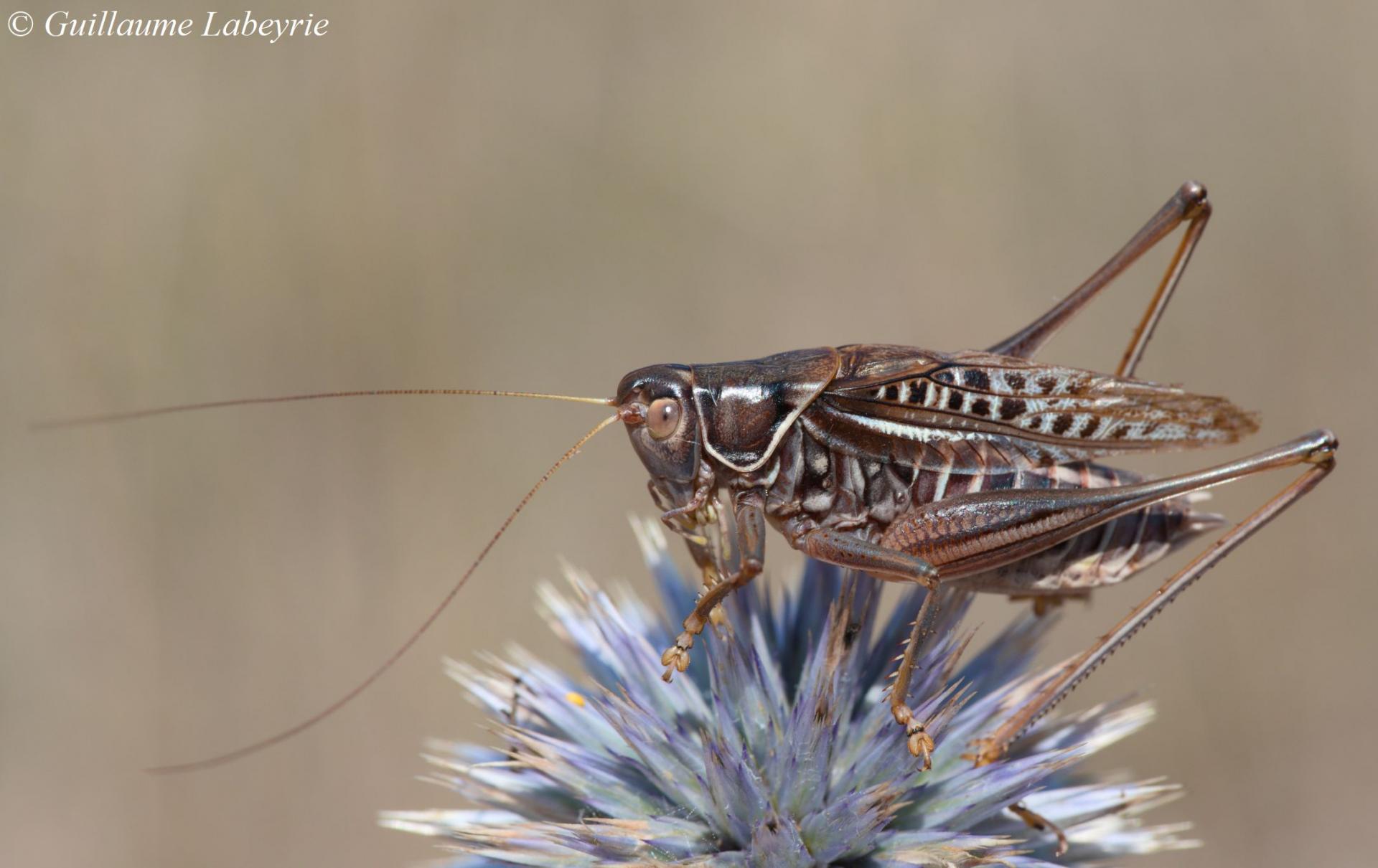 Gampsocleis glabra. This middle-sized bush-cricket shows a distinctive narrow white line along the edges of the pronotum. It inhabits steppe meadows up to 1500 m of altitude. The males perch on grass to emit a low, continuous chirp. Found in southern France, Gampsocleis glabra is rare in the Alpes-Maritimes where it occurs only in the Préalpes de Grasse.
Gampsocleis glabra. This middle-sized bush-cricket shows a distinctive narrow white line along the edges of the pronotum. It inhabits steppe meadows up to 1500 m of altitude. The males perch on grass to emit a low, continuous chirp. Found in southern France, Gampsocleis glabra is rare in the Alpes-Maritimes where it occurs only in the Préalpes de Grasse.
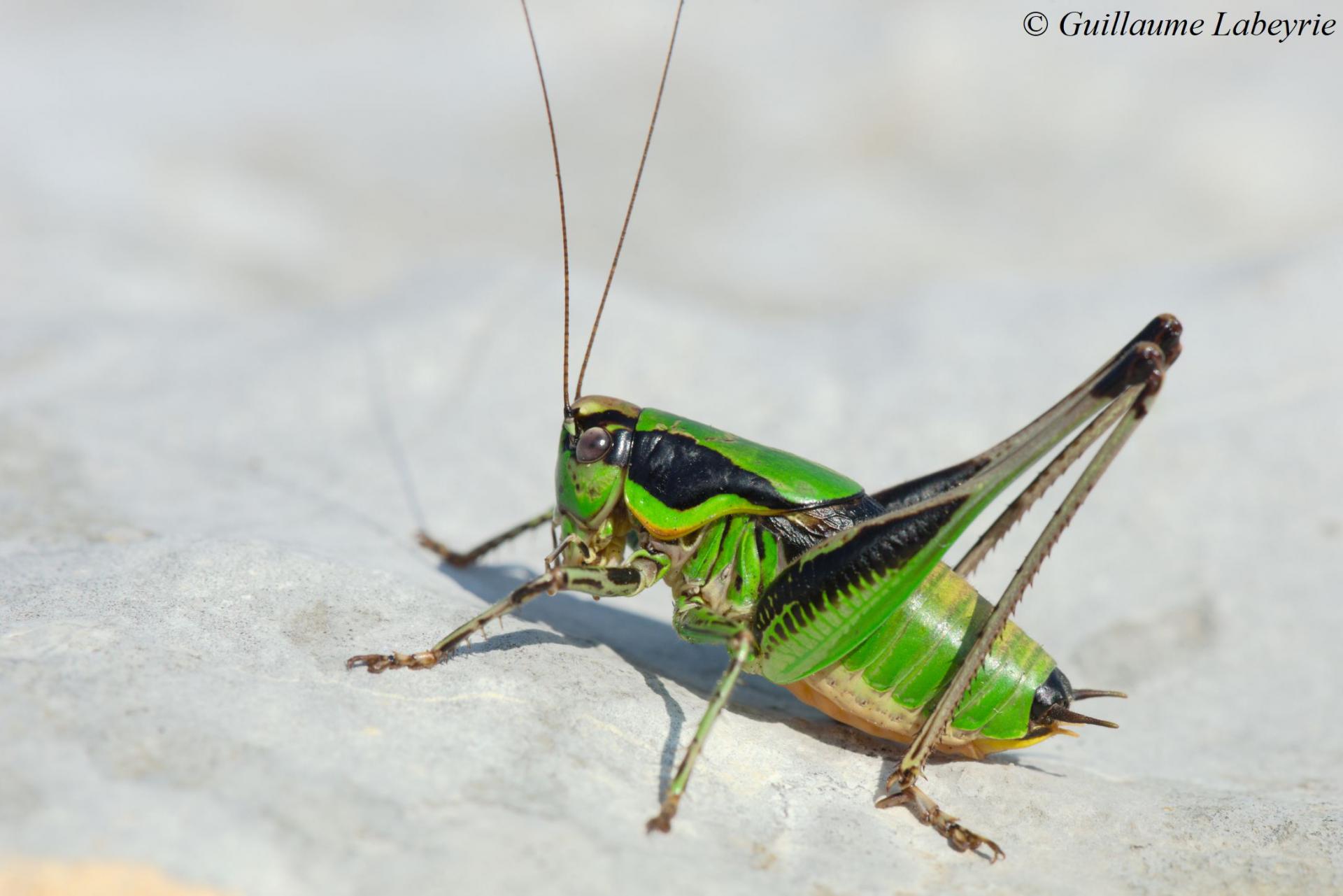 Eupholidoptera chabrieri. In the Grasse Prealps, this relatively large katydid with bright colors is often found in rocky grasslands near Scots pines. It is quite uncommon. This species occurs in southeast France, Switzerland, and eastwards to Greece.
Eupholidoptera chabrieri. In the Grasse Prealps, this relatively large katydid with bright colors is often found in rocky grasslands near Scots pines. It is quite uncommon. This species occurs in southeast France, Switzerland, and eastwards to Greece.
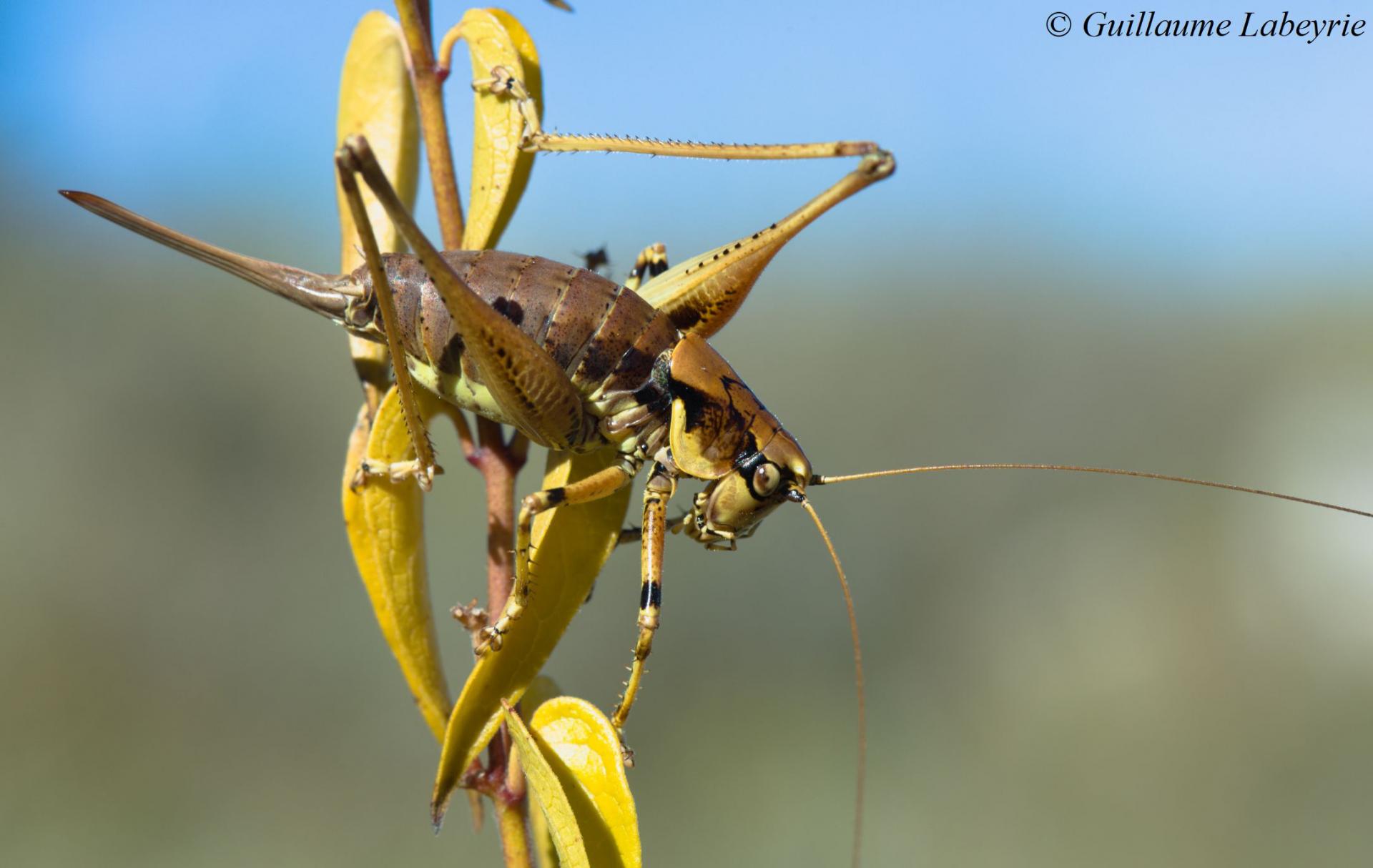 Antaxius pedestris subsp. pedestris. This katydid is typically grey or brown. The female sports a distinctive straight ovipositor. This species occurs in the Spanish Pyrenees and in the Alps. In France, it is found only in the Southeast.
Antaxius pedestris subsp. pedestris. This katydid is typically grey or brown. The female sports a distinctive straight ovipositor. This species occurs in the Spanish Pyrenees and in the Alps. In France, it is found only in the Southeast.
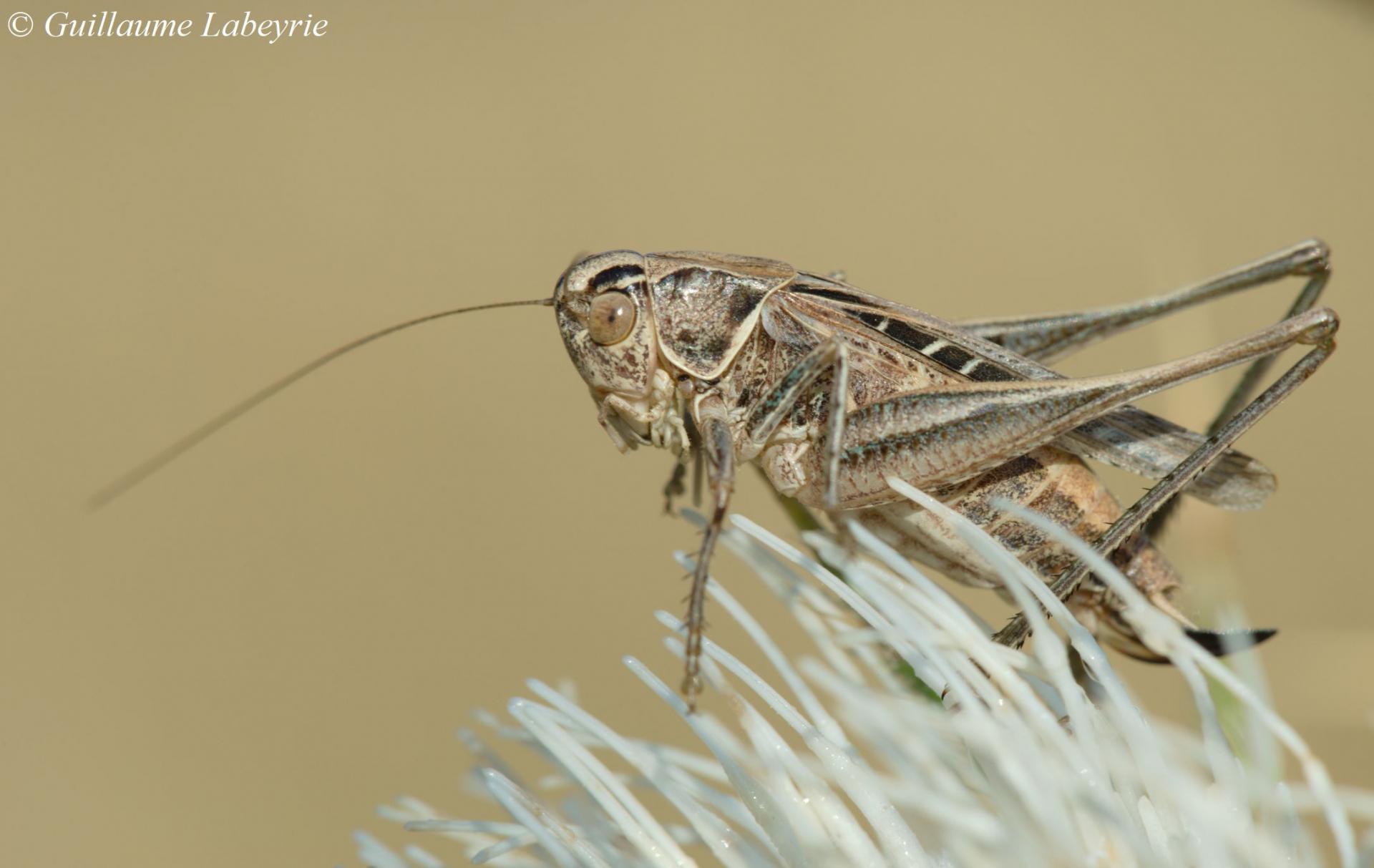 The brown-spotted bush-cricket (Tessellana tesselata subsp. tesselata). This species differs from related ones from the genus Platycleis by its smaller size (14 mm) and its narrow elytra with distinctive black rectangles. This bush-cricket occurs everywhere in France except in the north-east.
The brown-spotted bush-cricket (Tessellana tesselata subsp. tesselata). This species differs from related ones from the genus Platycleis by its smaller size (14 mm) and its narrow elytra with distinctive black rectangles. This bush-cricket occurs everywhere in France except in the north-east.
Family : Pamphagidae
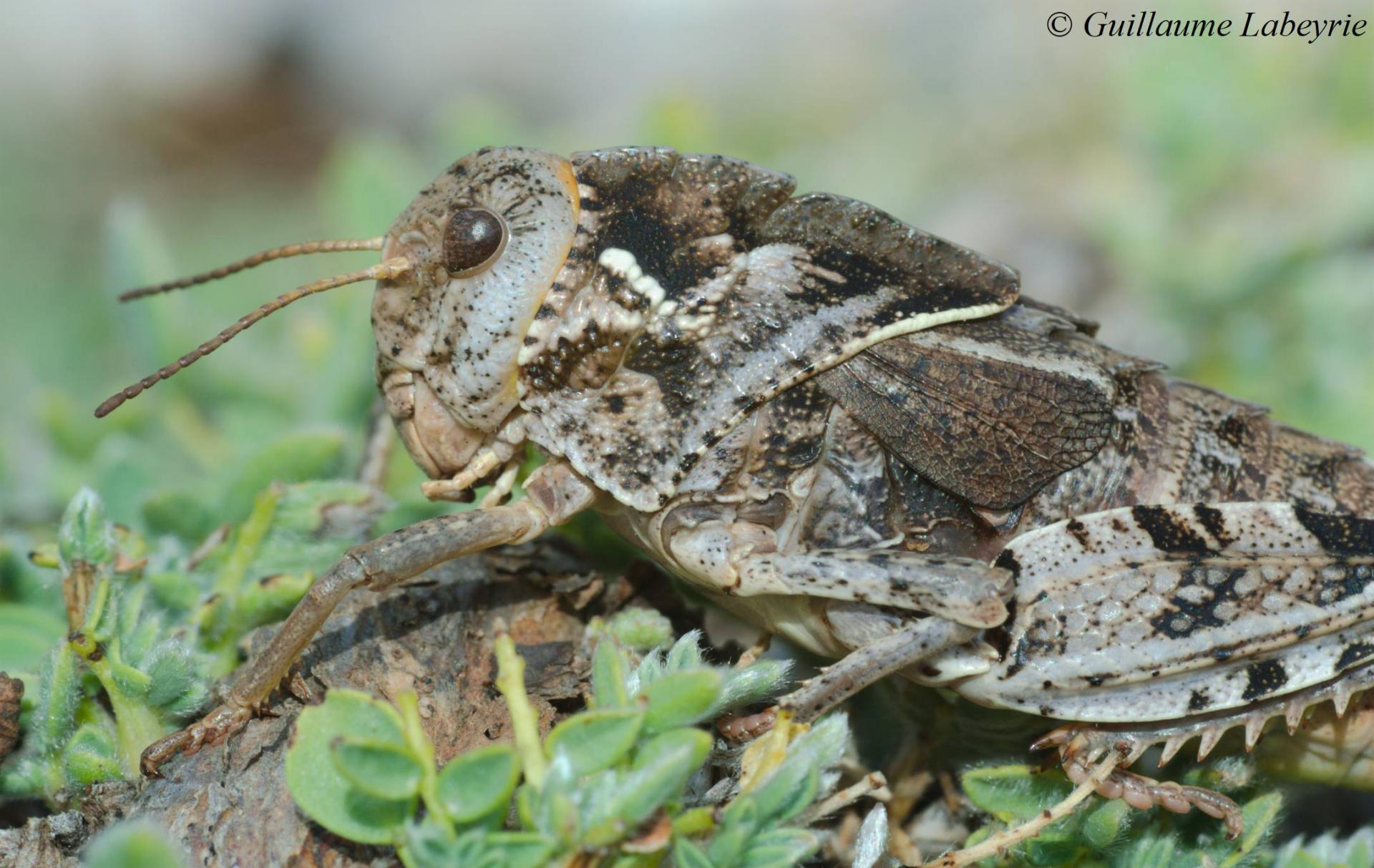 Prionotropis azami. This thick-bodied grasshopper is endemic to Provence, and found in the Var and Alpes-Maritimes. Very rare and threatened, it is fully protected in France. It is found on calcareous plateaus, at an elevation of 1000 m, from July to September. They female, shown here, is grey while the male is smaller and yellowish (see below). Two other species of Prionotropis are found in Europe: the very local and threatened Prionotropis rhodanica endemic to the plaine de la Crau (Bouches-du-Rhône), and Prionotropis hystrix which is found in the Balkans.
Prionotropis azami. This thick-bodied grasshopper is endemic to Provence, and found in the Var and Alpes-Maritimes. Very rare and threatened, it is fully protected in France. It is found on calcareous plateaus, at an elevation of 1000 m, from July to September. They female, shown here, is grey while the male is smaller and yellowish (see below). Two other species of Prionotropis are found in Europe: the very local and threatened Prionotropis rhodanica endemic to the plaine de la Crau (Bouches-du-Rhône), and Prionotropis hystrix which is found in the Balkans.
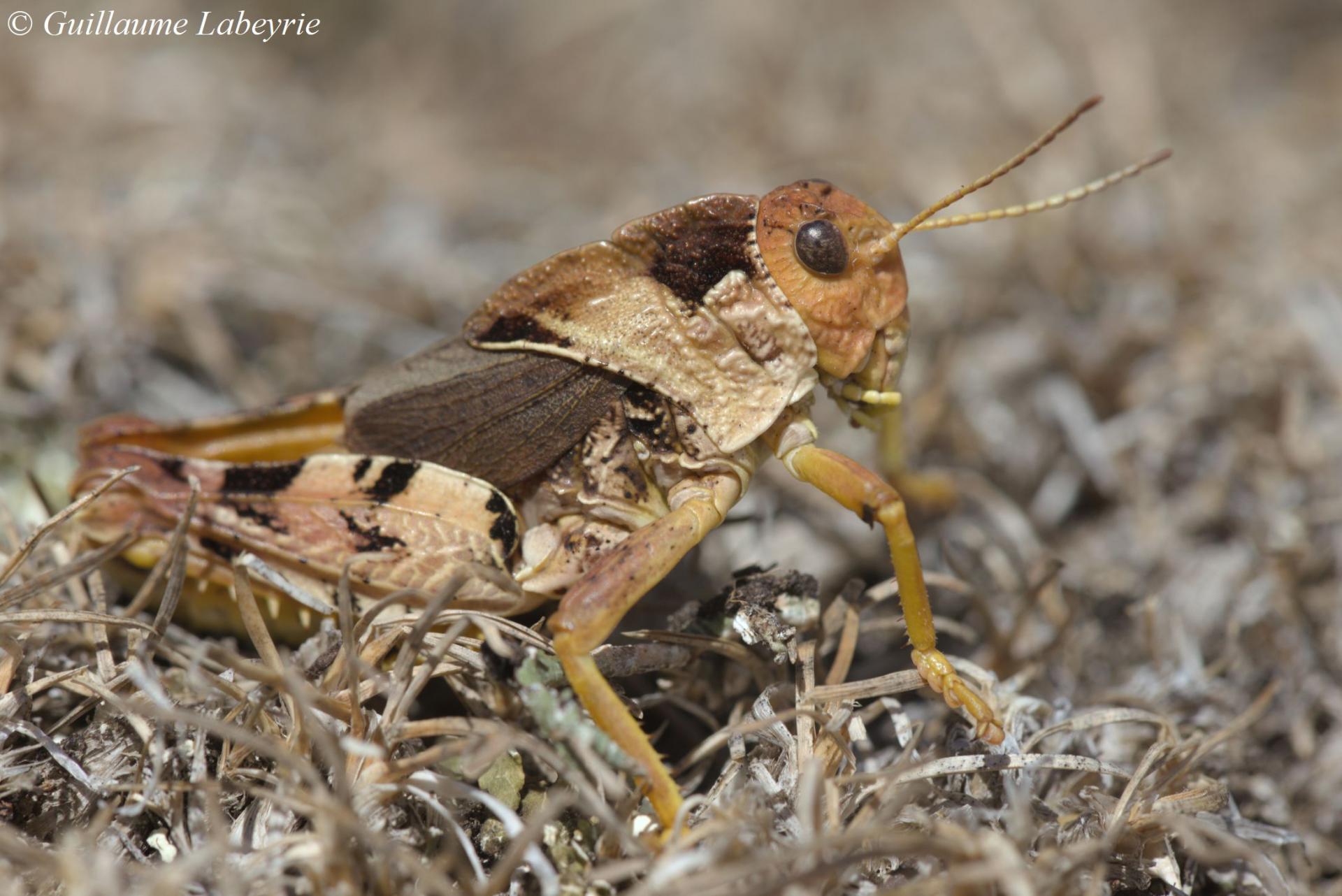
Male Prionotropis azami.
Family : Acrididae / Sub-Family : Gomphocerinae
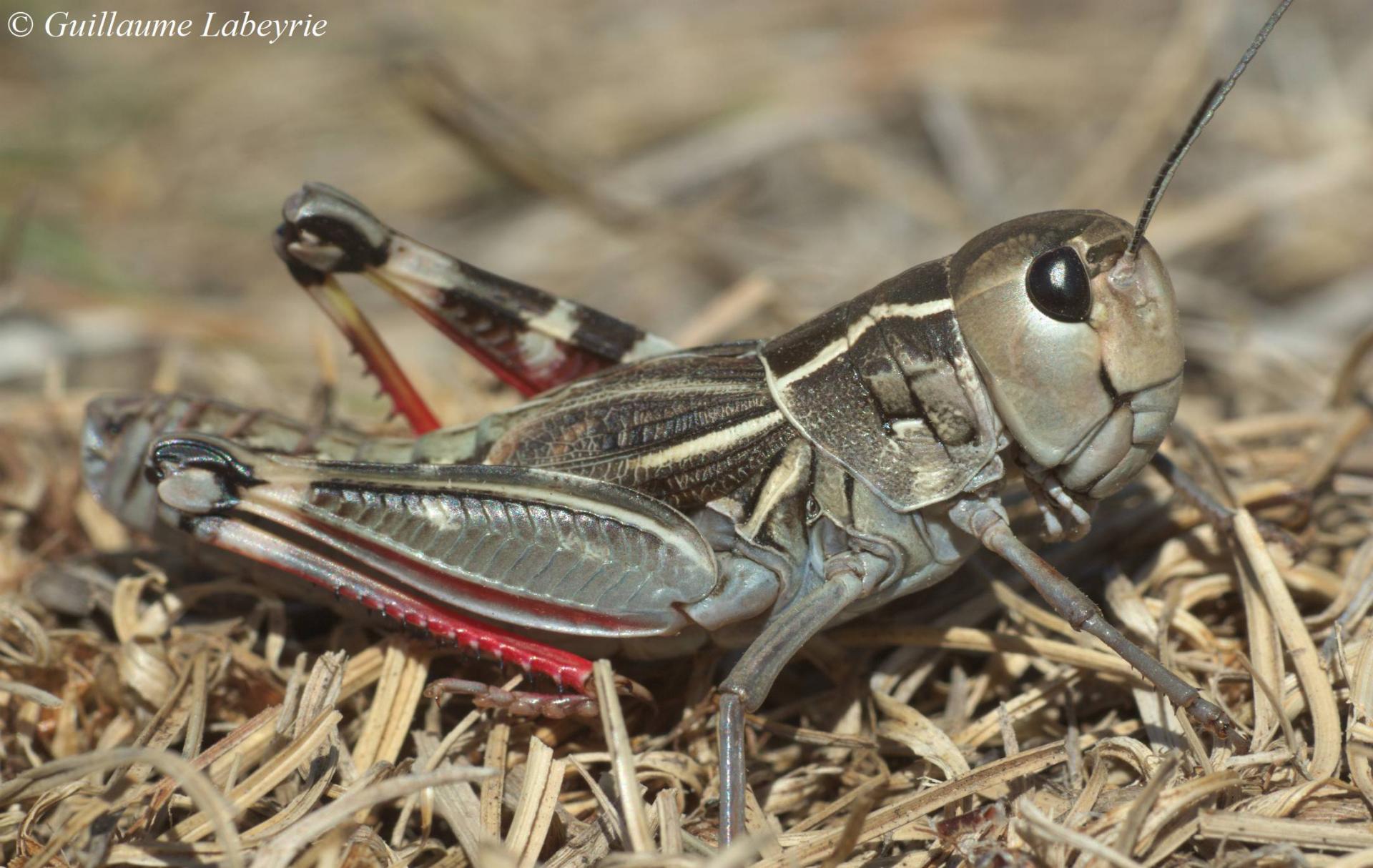 Arcyptera kheili. This large grasshopper is recognized to the distinctive white mark on the pronotum of both sexes, and the black and white diverging stripes on the abdomen of the female (shown here). The male is quite smaller and yellowish (see below). This species is endemic to Provence, and lives on calcareous plateaus. Uncommon and local, it is however less rare than Prionotropis azami, whose habitat it is sometimes sharing.
Arcyptera kheili. This large grasshopper is recognized to the distinctive white mark on the pronotum of both sexes, and the black and white diverging stripes on the abdomen of the female (shown here). The male is quite smaller and yellowish (see below). This species is endemic to Provence, and lives on calcareous plateaus. Uncommon and local, it is however less rare than Prionotropis azami, whose habitat it is sometimes sharing.
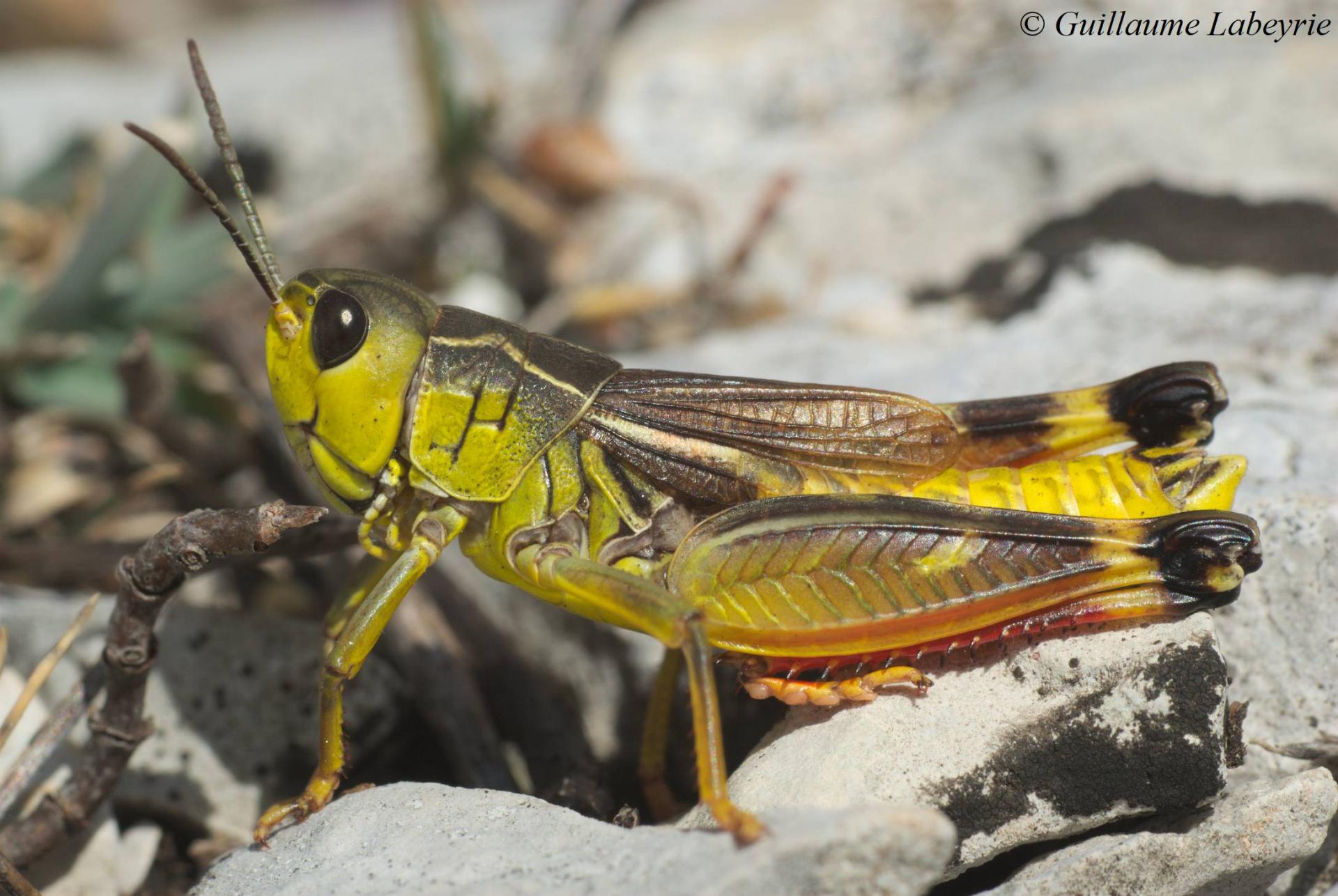 Male Arcyptera kheili.
Male Arcyptera kheili.
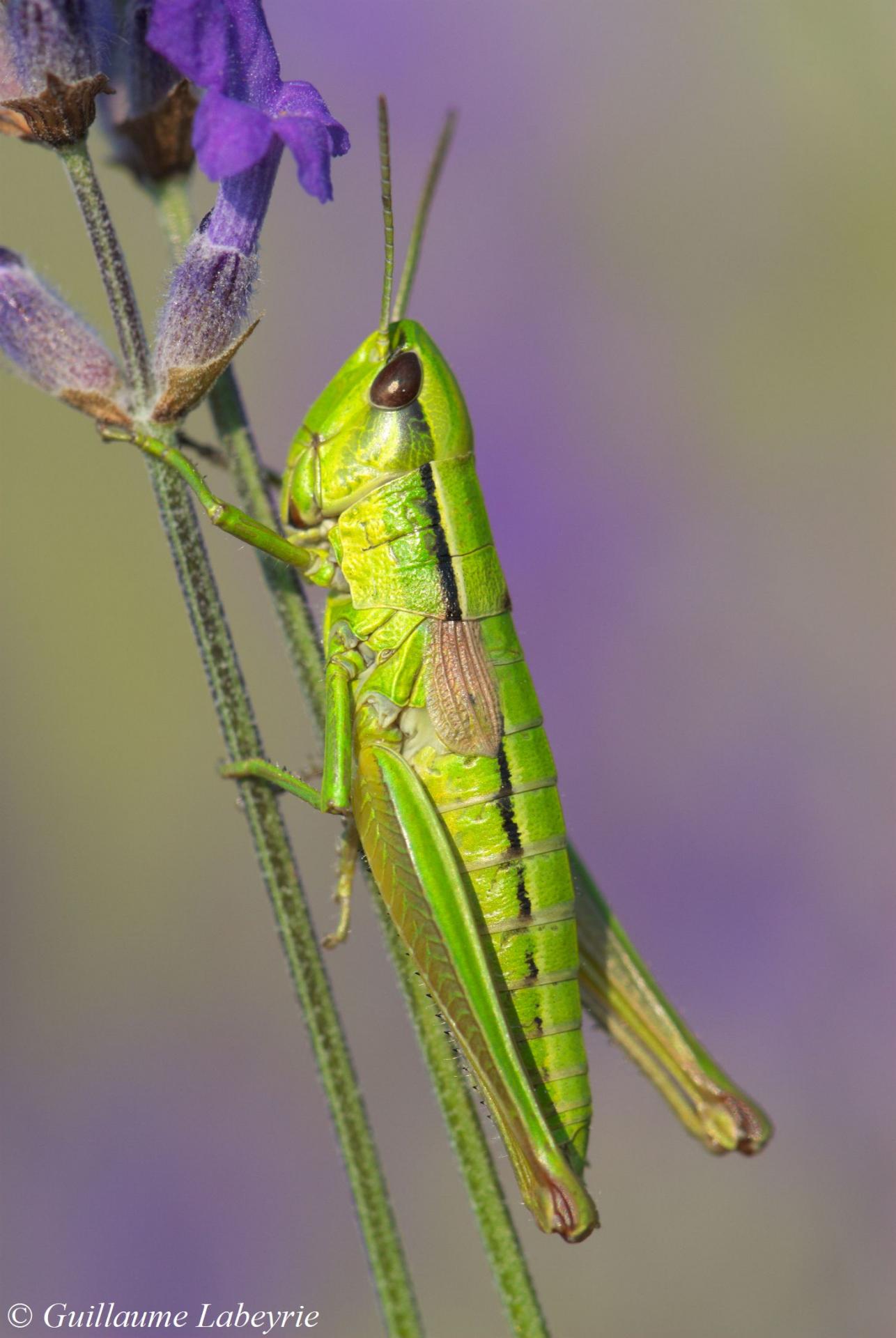 Euthystira brachyptera. This small grasshopper is found in the Eastern half of France. The male, small, is bright green, while the female (shown here) is more yellowish, with small pink wings.
Euthystira brachyptera. This small grasshopper is found in the Eastern half of France. The male, small, is bright green, while the female (shown here) is more yellowish, with small pink wings.
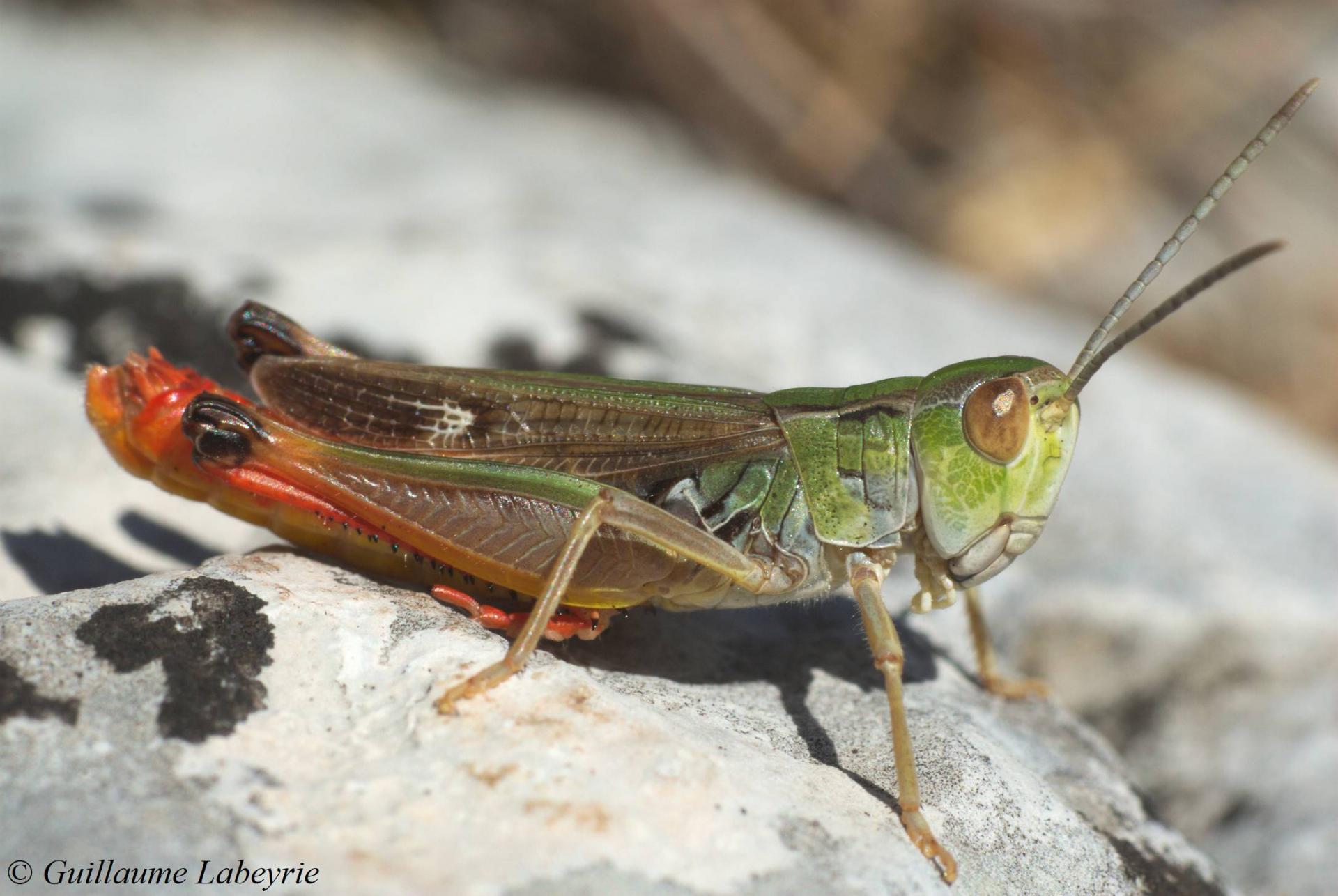 Stenobothrus fischeri subsp. glaucescens. This elytra of this species don't quite reach the knees, and display a round white stigma located at the beginning of the last third of their length. The male, shown here, has a bright orange abdomen. This rather local grasshopper lives in dry mountain grasslands in Southeastern France.
Stenobothrus fischeri subsp. glaucescens. This elytra of this species don't quite reach the knees, and display a round white stigma located at the beginning of the last third of their length. The male, shown here, has a bright orange abdomen. This rather local grasshopper lives in dry mountain grasslands in Southeastern France.
Family : Acrididae / Sub-Family : Melanoplinae
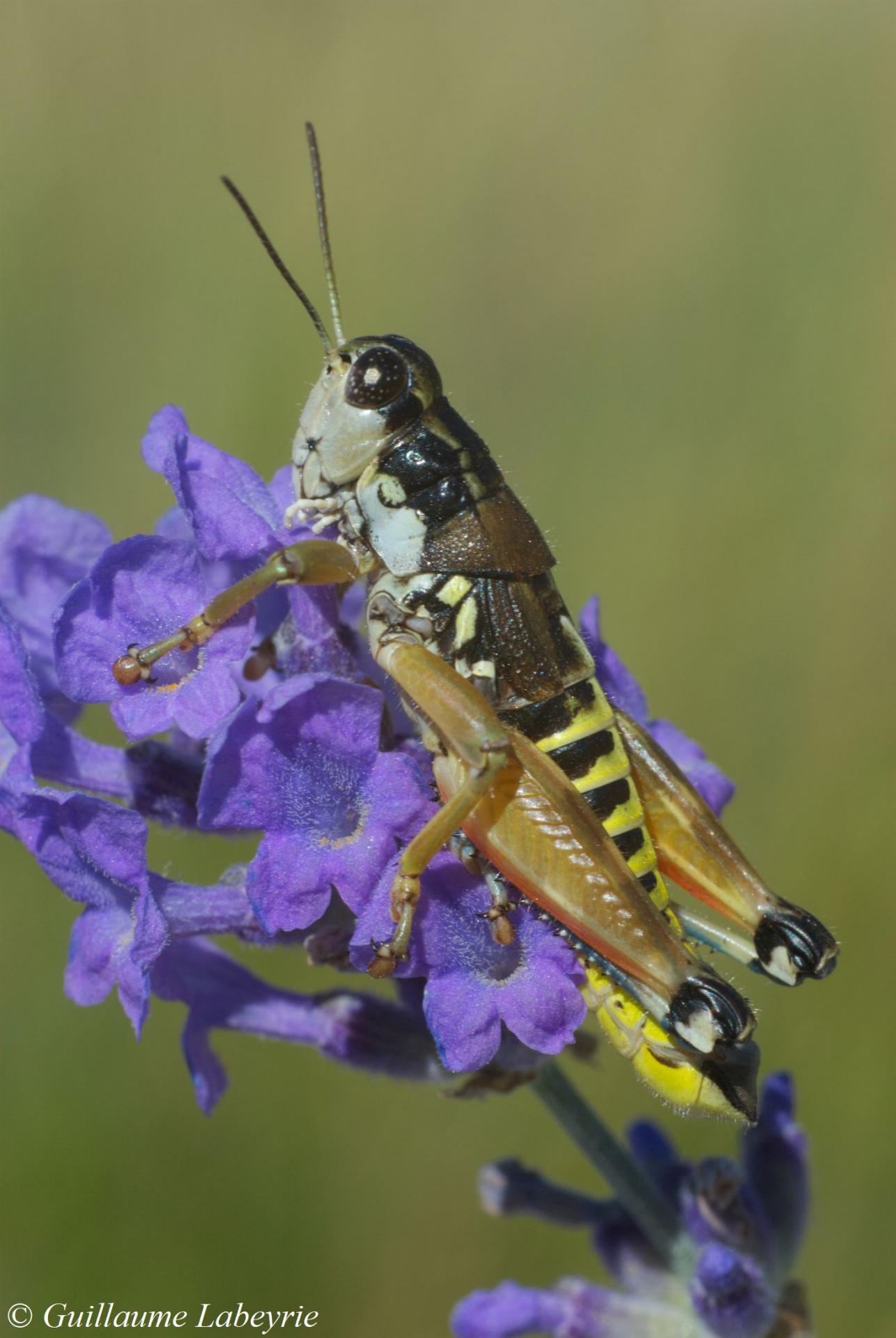 Podisma pedestris. This short-horned grasshopper lives in dry mountain grasslands (roughly from 1000 to 3000 m of altitude), in the Alps and Pyrenees. The male, shown here, is brightly colored with a distinctive yellow and black abdomen. The female is bigger and lacks the yellow pattern on the abdomen. Both sexes have short elytra extending up to the second abdominal segment. In the higher mountains of Mercantour, the closely-related Podisma deschambrei has even shorter elytra. Podisma pedestris is present in most of Europe and Asia.
Podisma pedestris. This short-horned grasshopper lives in dry mountain grasslands (roughly from 1000 to 3000 m of altitude), in the Alps and Pyrenees. The male, shown here, is brightly colored with a distinctive yellow and black abdomen. The female is bigger and lacks the yellow pattern on the abdomen. Both sexes have short elytra extending up to the second abdominal segment. In the higher mountains of Mercantour, the closely-related Podisma deschambrei has even shorter elytra. Podisma pedestris is present in most of Europe and Asia.
Famille : Acrididae / Sous-Famille : Caliptaminae
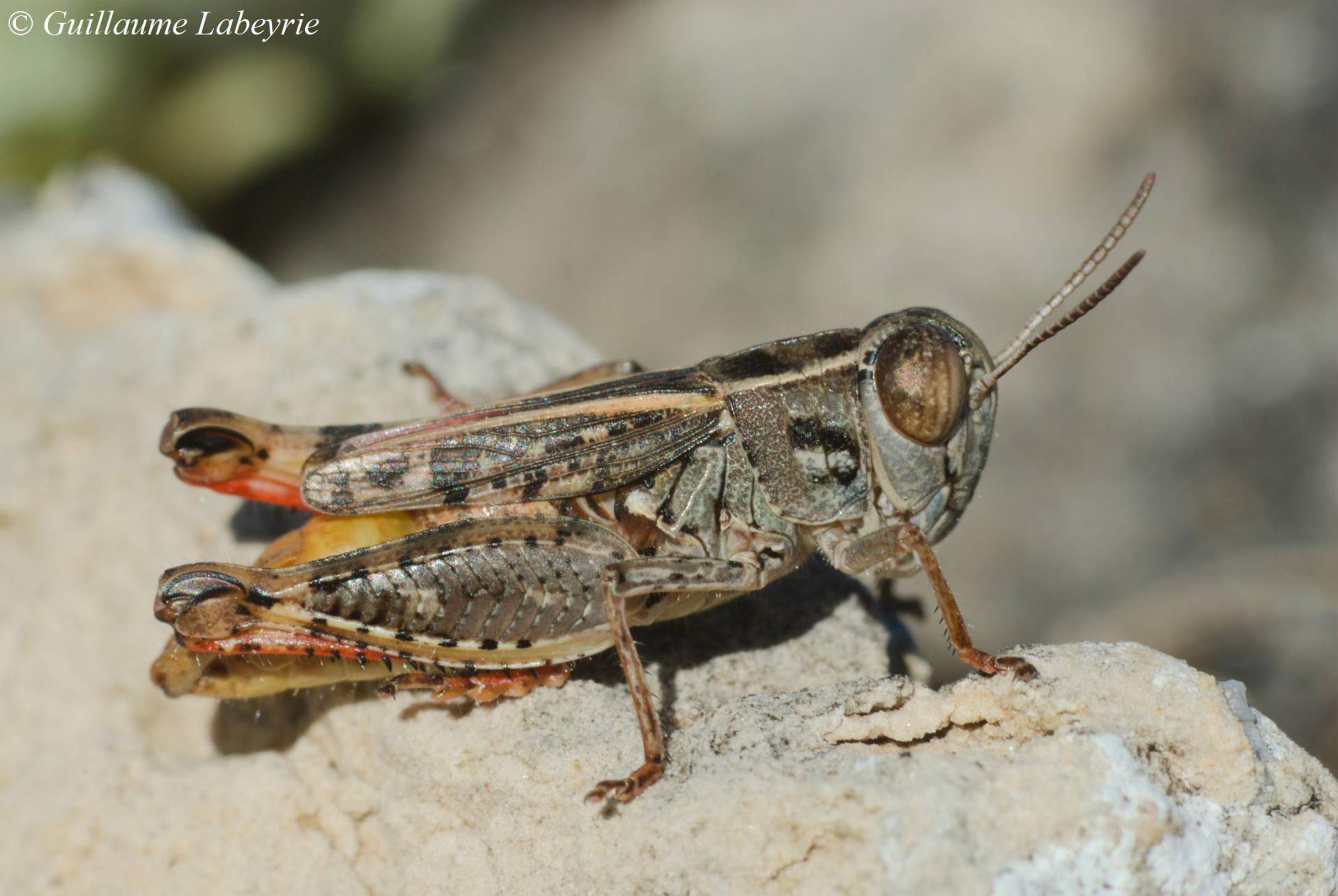 Calliptamus siciliae. The male of this short-horned grasshopper species is very small, much smaller than the female, with large eyes. It is distinguished from other Calliptamus species by the wings that are shorter than the abdomen. This grasshopper is abundant on the calcareous plateaus in the Préalpes de Grasse. It has however a limited distribution, which includes only southeastern France, Switzerland and Italy.
Calliptamus siciliae. The male of this short-horned grasshopper species is very small, much smaller than the female, with large eyes. It is distinguished from other Calliptamus species by the wings that are shorter than the abdomen. This grasshopper is abundant on the calcareous plateaus in the Préalpes de Grasse. It has however a limited distribution, which includes only southeastern France, Switzerland and Italy.
Famille : Acrididae / Sous-Famille : Locustinae
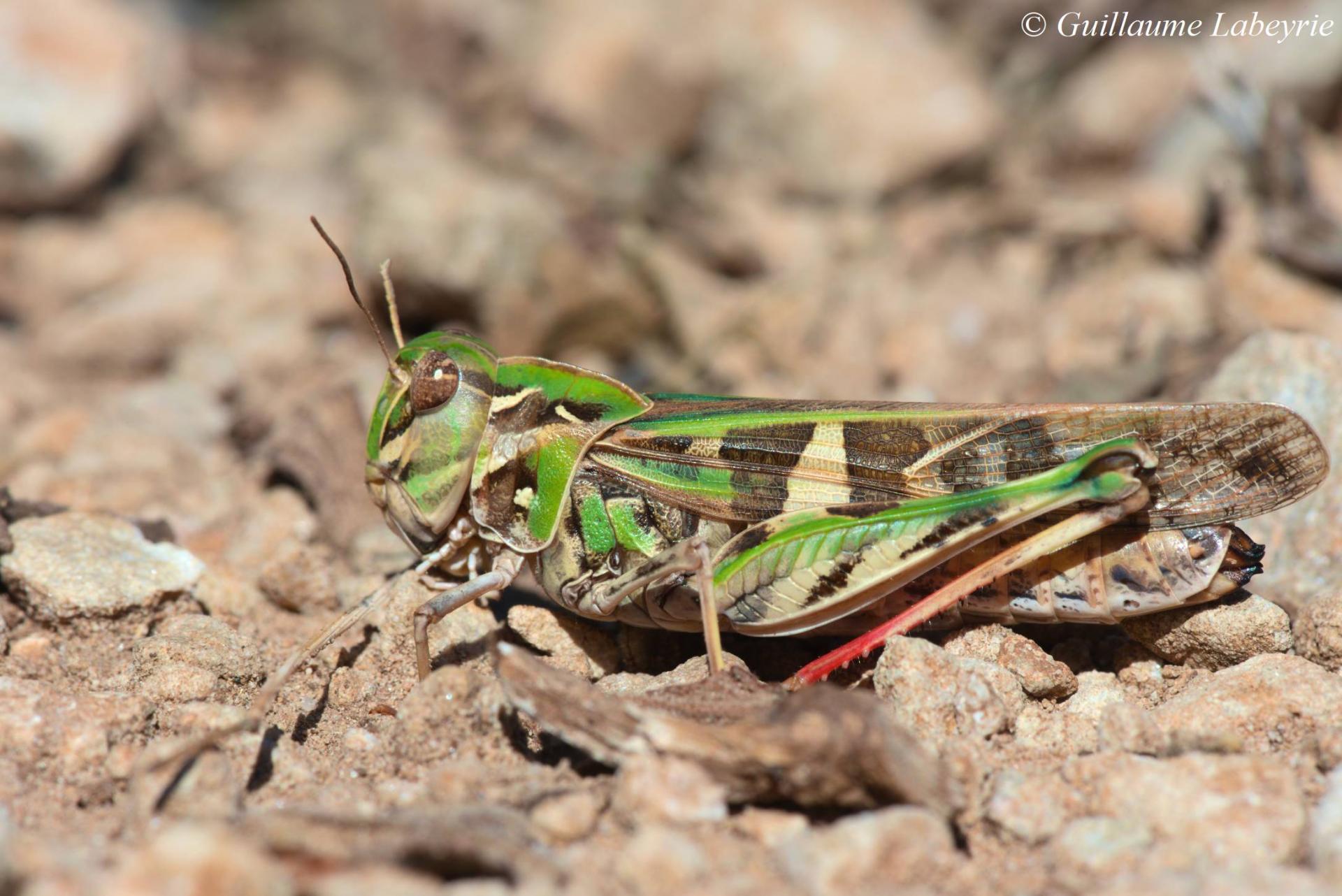 Oedaleus decorus. Most species of the subfamily Oedipodinae are mimetic grasshoppers with grey wings. Instead, Oedaleus decorus bears a distinctive black and white pattern. The background colour can be green, as on this individual, or brown. This species is usually found in dry locations with a bare ground, at low altitude. In the Préalpes de Grasse, Oedaleus decorus seems to be rather uncommon and quite local. In France, it occurs in a southern half of the country.
Oedaleus decorus. Most species of the subfamily Oedipodinae are mimetic grasshoppers with grey wings. Instead, Oedaleus decorus bears a distinctive black and white pattern. The background colour can be green, as on this individual, or brown. This species is usually found in dry locations with a bare ground, at low altitude. In the Préalpes de Grasse, Oedaleus decorus seems to be rather uncommon and quite local. In France, it occurs in a southern half of the country.
 Mummified grasshoppers. At the end of summer, many such small dessicated bodies can be found on tall grass. These grasshoppers are victims of the "summit disease" caused by the fungus Entomophaga grylli. The infected host climbs on a tall grass to die, ensuring optimal dispersion of the fungal spores.
Mummified grasshoppers. At the end of summer, many such small dessicated bodies can be found on tall grass. These grasshoppers are victims of the "summit disease" caused by the fungus Entomophaga grylli. The infected host climbs on a tall grass to die, ensuring optimal dispersion of the fungal spores.
Neuroptera
Owlflies, looking like a cross between a dragonfly and a fly, belong to the order Neuroptera. A few species live in France, mostly in the sunny meadows of the South.
Family : Ascalaphidae
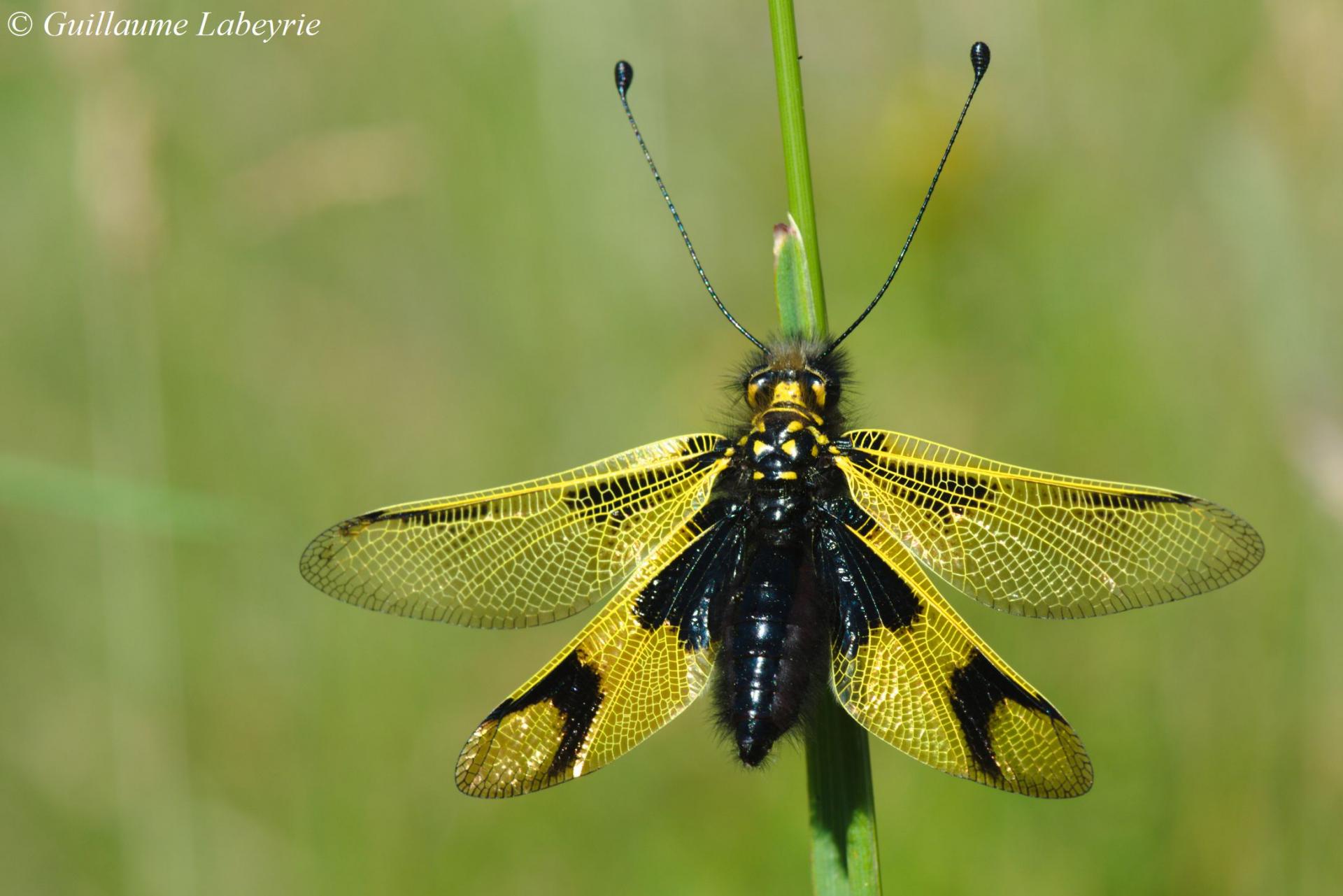 Owlfly (Libelloides longicornis). This species sports a distinctive black pattern on the hindwings, and yellow wing veins. It inhabits southern Europe, where it glides over sunny meadows.
Owlfly (Libelloides longicornis). This species sports a distinctive black pattern on the hindwings, and yellow wing veins. It inhabits southern Europe, where it glides over sunny meadows.
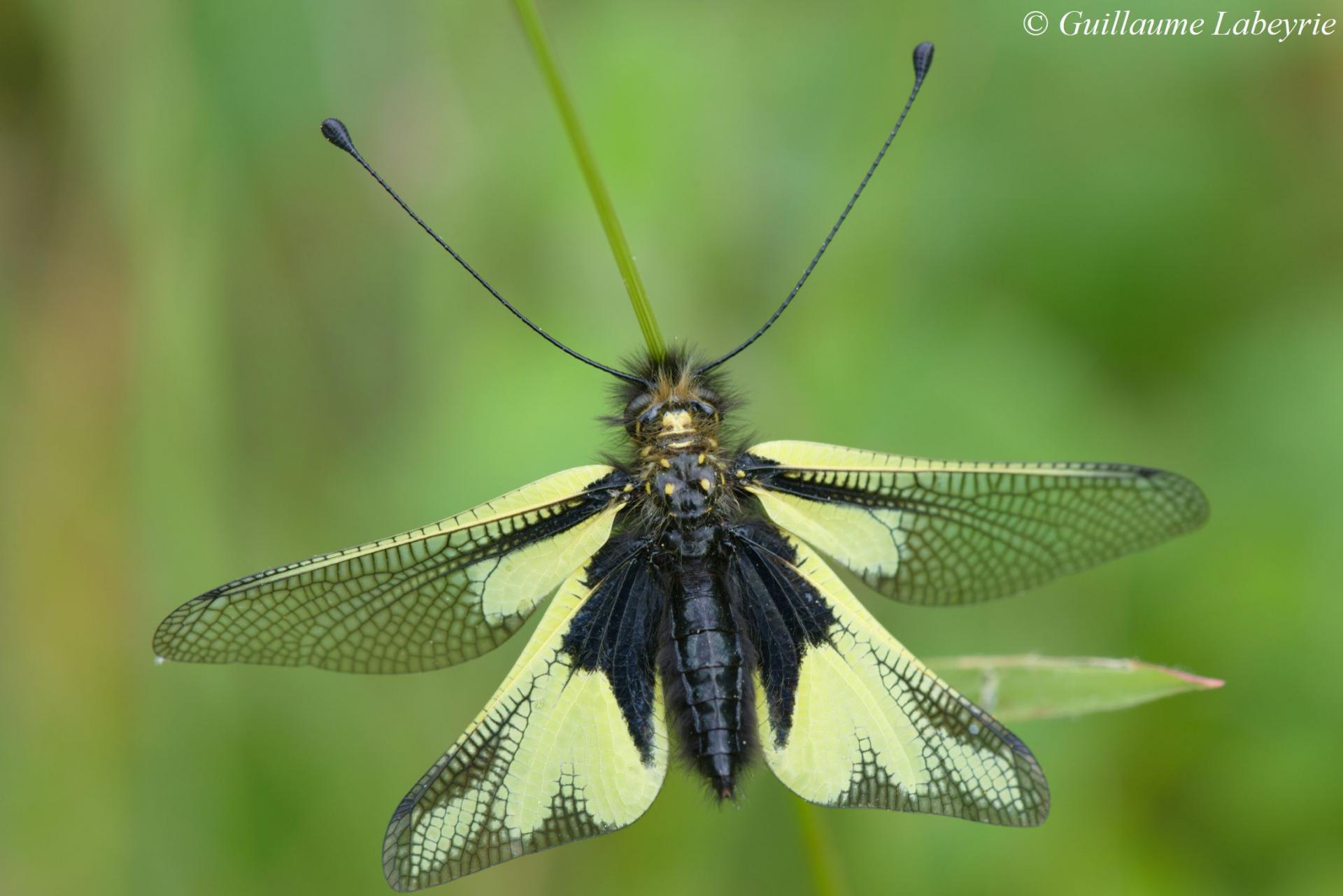 The owly sulfur (Libelloides cocajus). This is another owlfly species commonly found in the area. The extended bright yellow (sometimes almost white) areas on the wings are typical. The wing veins are black.
The owly sulfur (Libelloides cocajus). This is another owlfly species commonly found in the area. The extended bright yellow (sometimes almost white) areas on the wings are typical. The wing veins are black.
Dragonflies (Odonata)
Dragonflies are scarce on the dry plateaus of the Prealps, where only a few migratory species are observed.
Family : Libellulidae
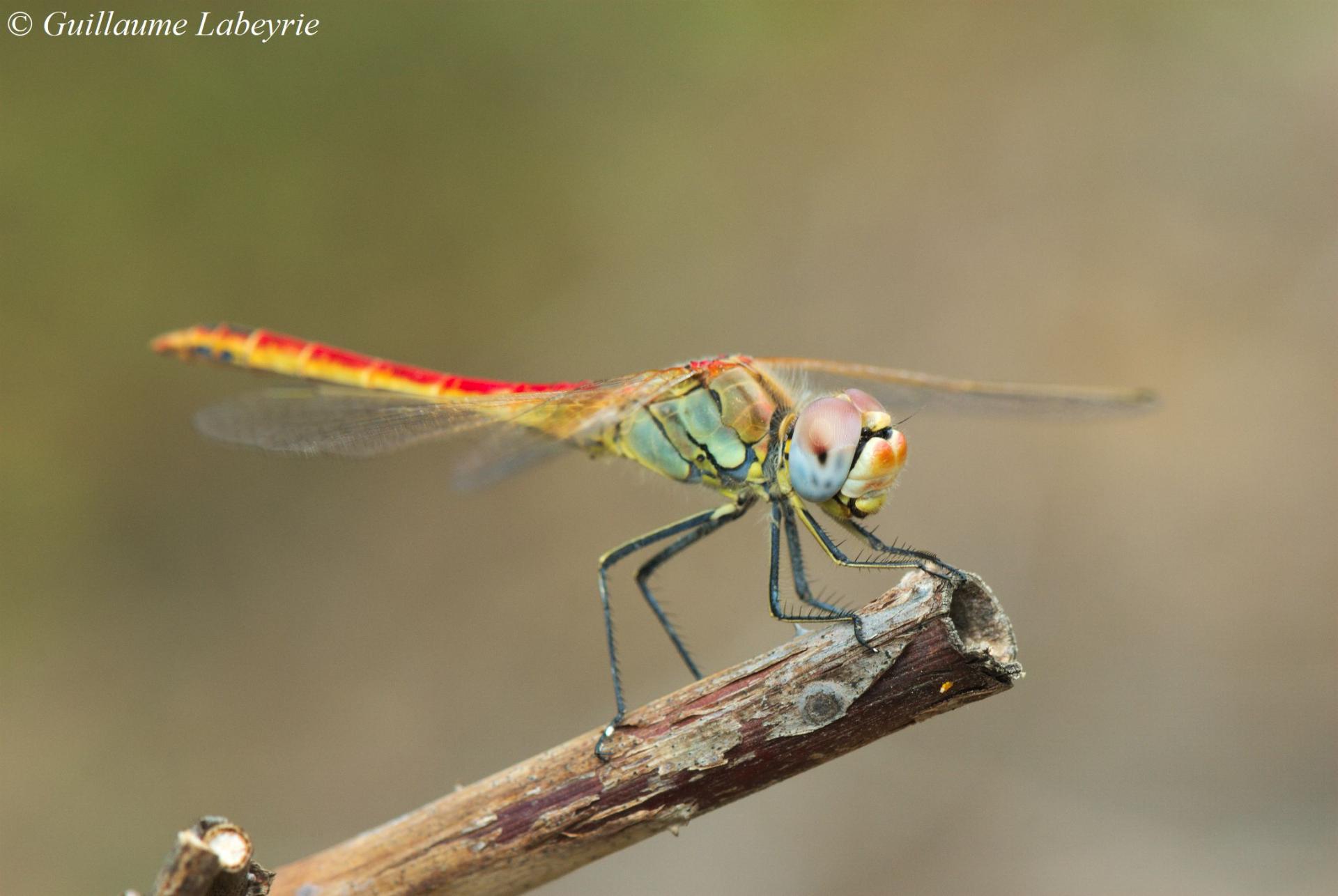 The red-veined Darter (Sympetrum fonscolombii). This dragonfly is recognized by its strange bi-color eyes, with a blueish lower part. The male, shown on this photo, is red whilst the female is yellowish. A migratory species, this inhabitant of southern Europe can be found in many habitat, and is observed certain years quite far north of its usual range.
The red-veined Darter (Sympetrum fonscolombii). This dragonfly is recognized by its strange bi-color eyes, with a blueish lower part. The male, shown on this photo, is red whilst the female is yellowish. A migratory species, this inhabitant of southern Europe can be found in many habitat, and is observed certain years quite far north of its usual range.
Arachnids
Spiders play a fundamental role in ecosystems by helping to limit insect populations. They are excellent indicators of the health of a natural habitat.
Family : Araneidae
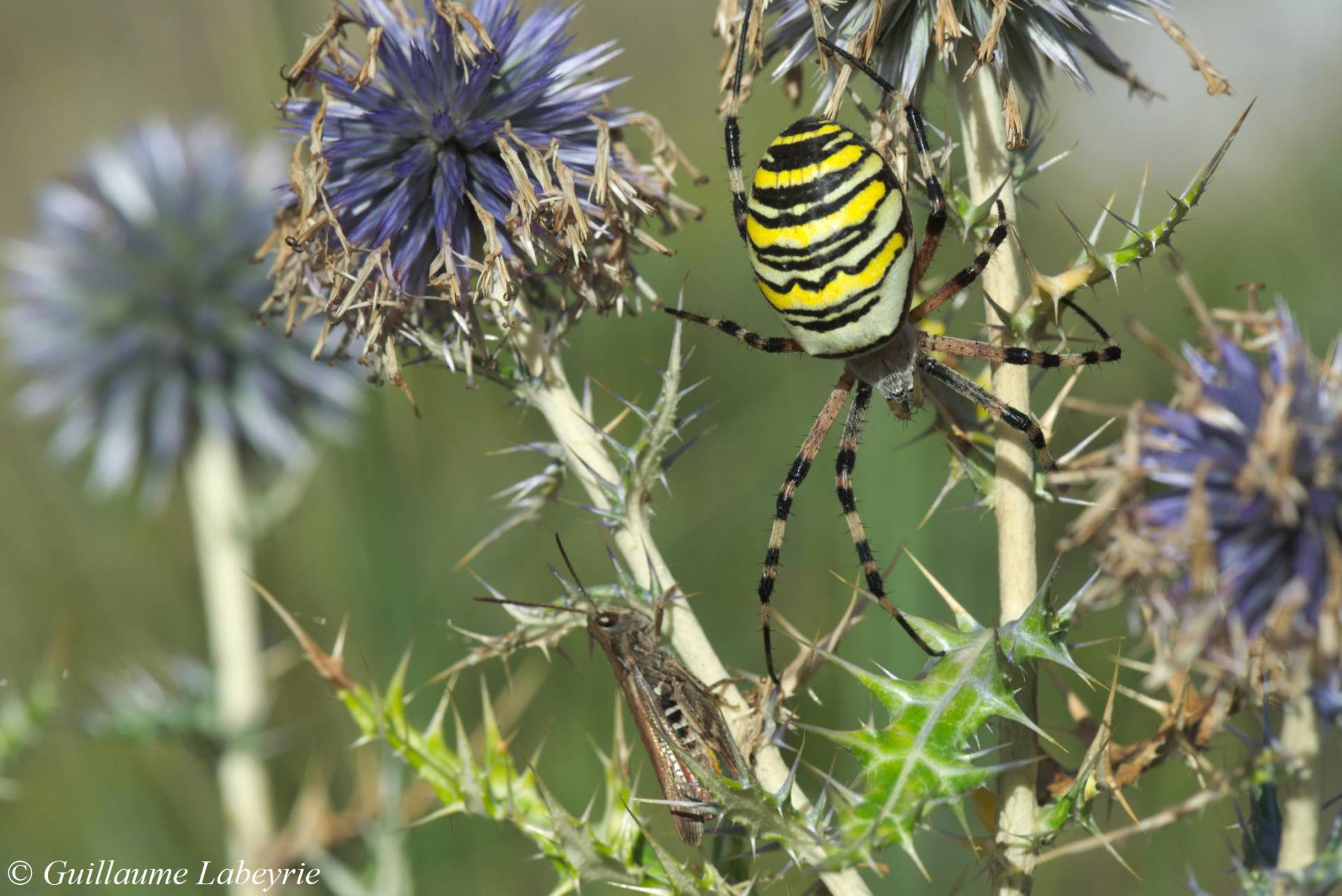 The wasp spider (Argiope bruennichi). This spectacular spider cannot be confused. Its web exhibits a white zig-zag pattern called the stabilimentum. Once entangled in the web, the prey is wrapped in silk and then bitten. This meridional species has been expanding toward northern Europe since the beginning of the 20th century.
The wasp spider (Argiope bruennichi). This spectacular spider cannot be confused. Its web exhibits a white zig-zag pattern called the stabilimentum. Once entangled in the web, the prey is wrapped in silk and then bitten. This meridional species has been expanding toward northern Europe since the beginning of the 20th century.
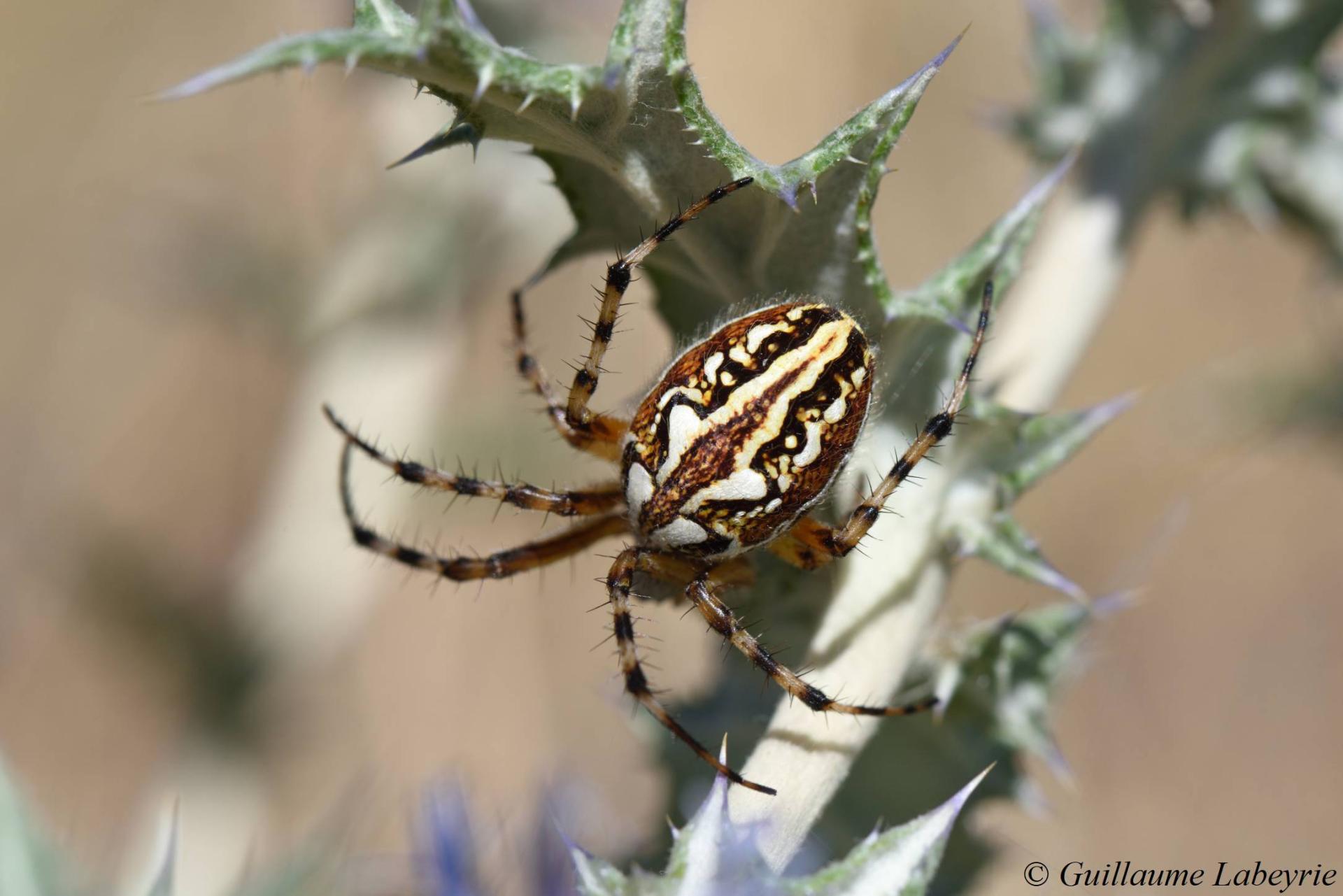
Aculepeira armida. This beautiful spider is identified by its red flanks and the white leaf-shaped design on the top of the abdomen. Distributed mainly in southern Europe, it is observed in France in the South.
Family : Eresidae
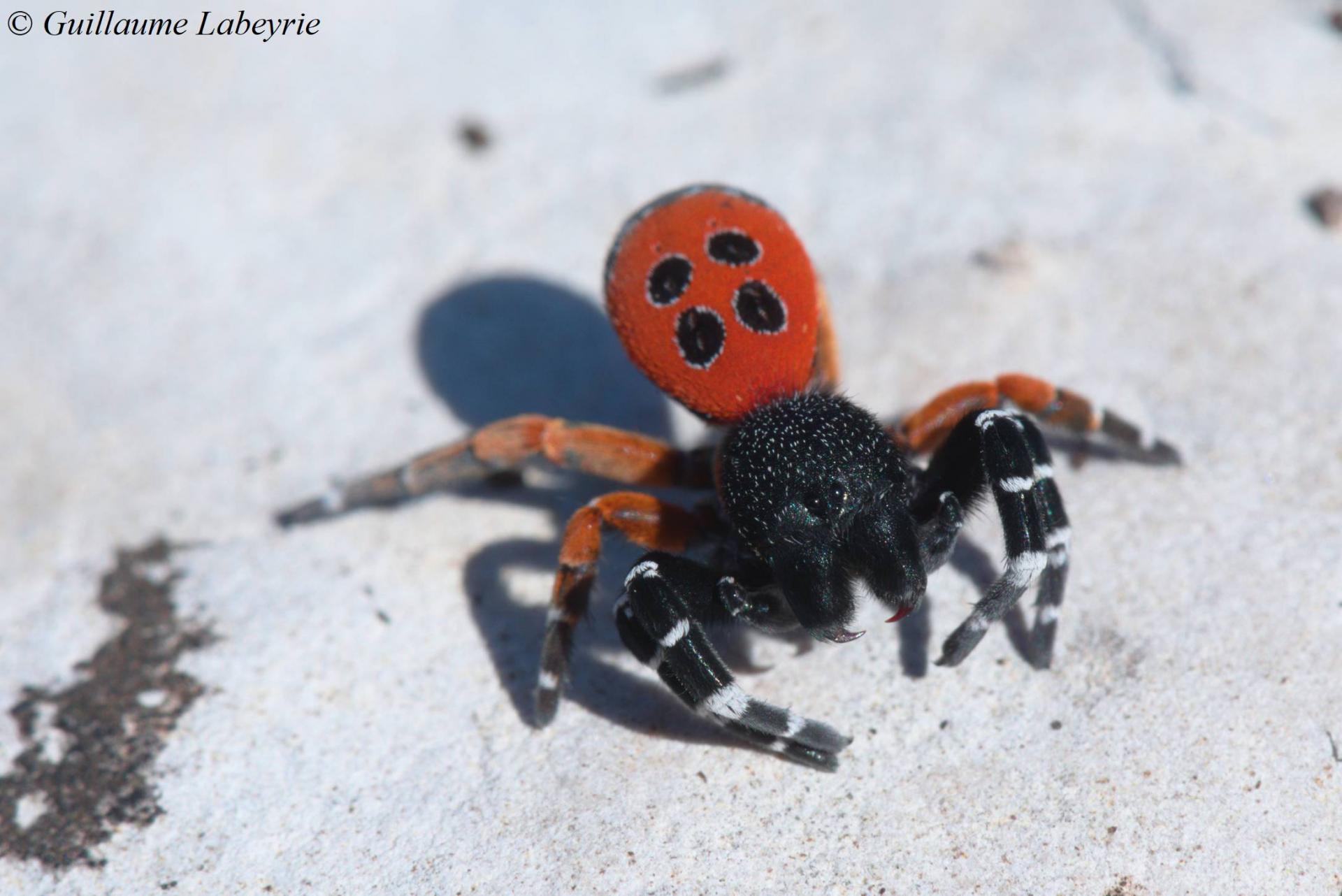 The ladybird spider (Eresus kollari). The male of this nice species sports a distinctive red abdomen with four large black spots. The reddish hairs on the the two pairs of hindlegs allow to differentiate it from the much rarer Eresus sandaliatus. The female E. kollari is larger than the male and rarely seen, remaining in its burrow. The males are often observed wandering on the plateaus at the end of summer (September/October).
The ladybird spider (Eresus kollari). The male of this nice species sports a distinctive red abdomen with four large black spots. The reddish hairs on the the two pairs of hindlegs allow to differentiate it from the much rarer Eresus sandaliatus. The female E. kollari is larger than the male and rarely seen, remaining in its burrow. The males are often observed wandering on the plateaus at the end of summer (September/October).
Family : Lycosidae
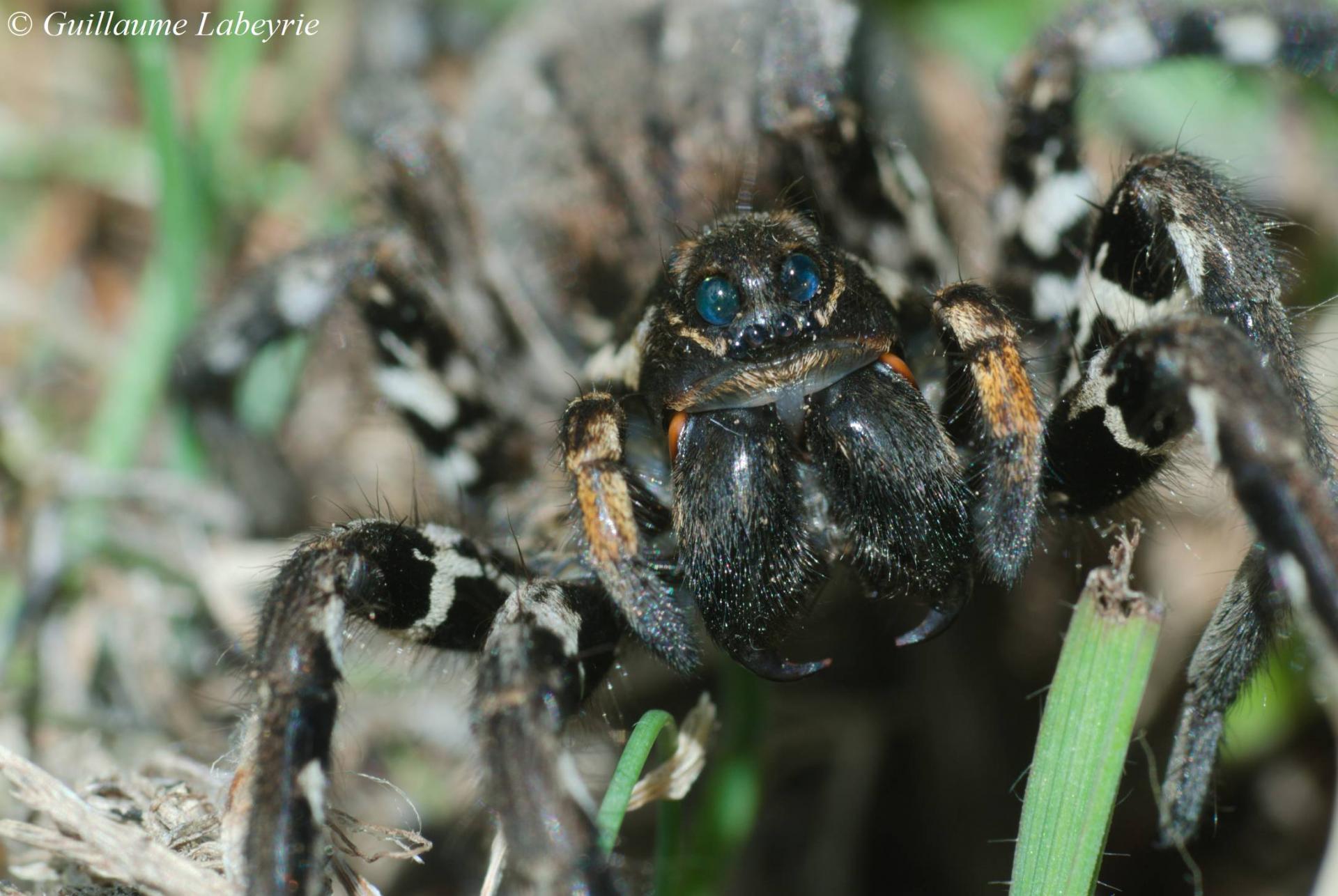 Narbonne's wolf-spider (Lycosa tarentula). This impressive spider, one of the largest in Europe, lives in a burrow whose entrance is carpeted with silk. This is one of the rare spiders capable of biting humans if disturbed (the bite is said to be painful): look but don't touch ! This Mediterranean species occurs in France only in the south-east. In the Alpes-Maritimes, it is found mainly in the rocky grasslands of the calcareous plateaus, at an altitude ranging from 800 m to 1600 m.
Narbonne's wolf-spider (Lycosa tarentula). This impressive spider, one of the largest in Europe, lives in a burrow whose entrance is carpeted with silk. This is one of the rare spiders capable of biting humans if disturbed (the bite is said to be painful): look but don't touch ! This Mediterranean species occurs in France only in the south-east. In the Alpes-Maritimes, it is found mainly in the rocky grasslands of the calcareous plateaus, at an altitude ranging from 800 m to 1600 m.
Family : Nemesiidae
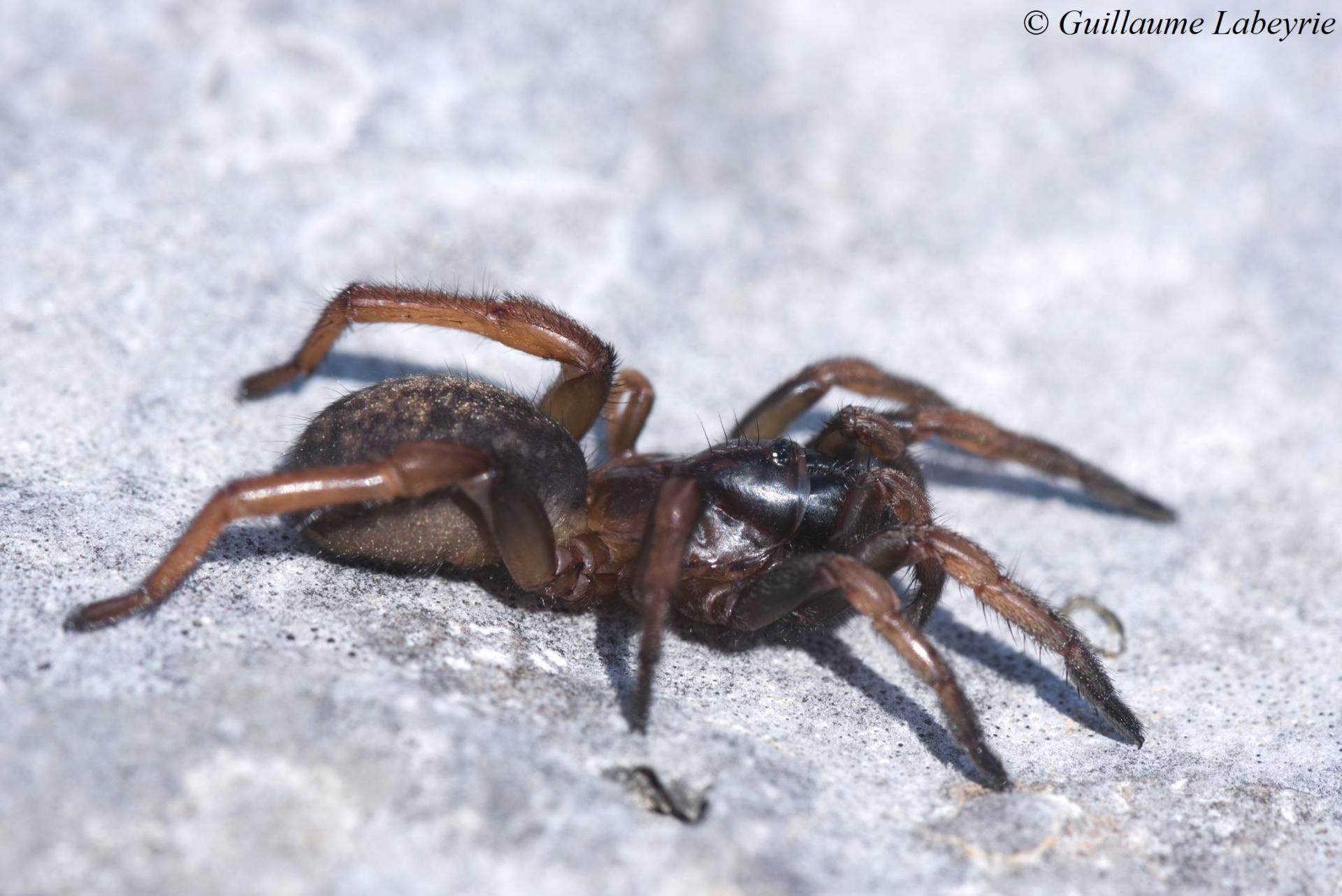
Trapdoor spider (Nemesia manderstjernae). Nineteen species of trapdoor spiders are found in France, several of them occuring only in Corsica. These are rather large (2-3 cm) nocturnal species living in a burrow, usually closed by a lid (see below). Nemesia manderstjernae is present in the Alpes-Maritimes and Var. It is sharing its habitat with Narbonne's wolf-spider.
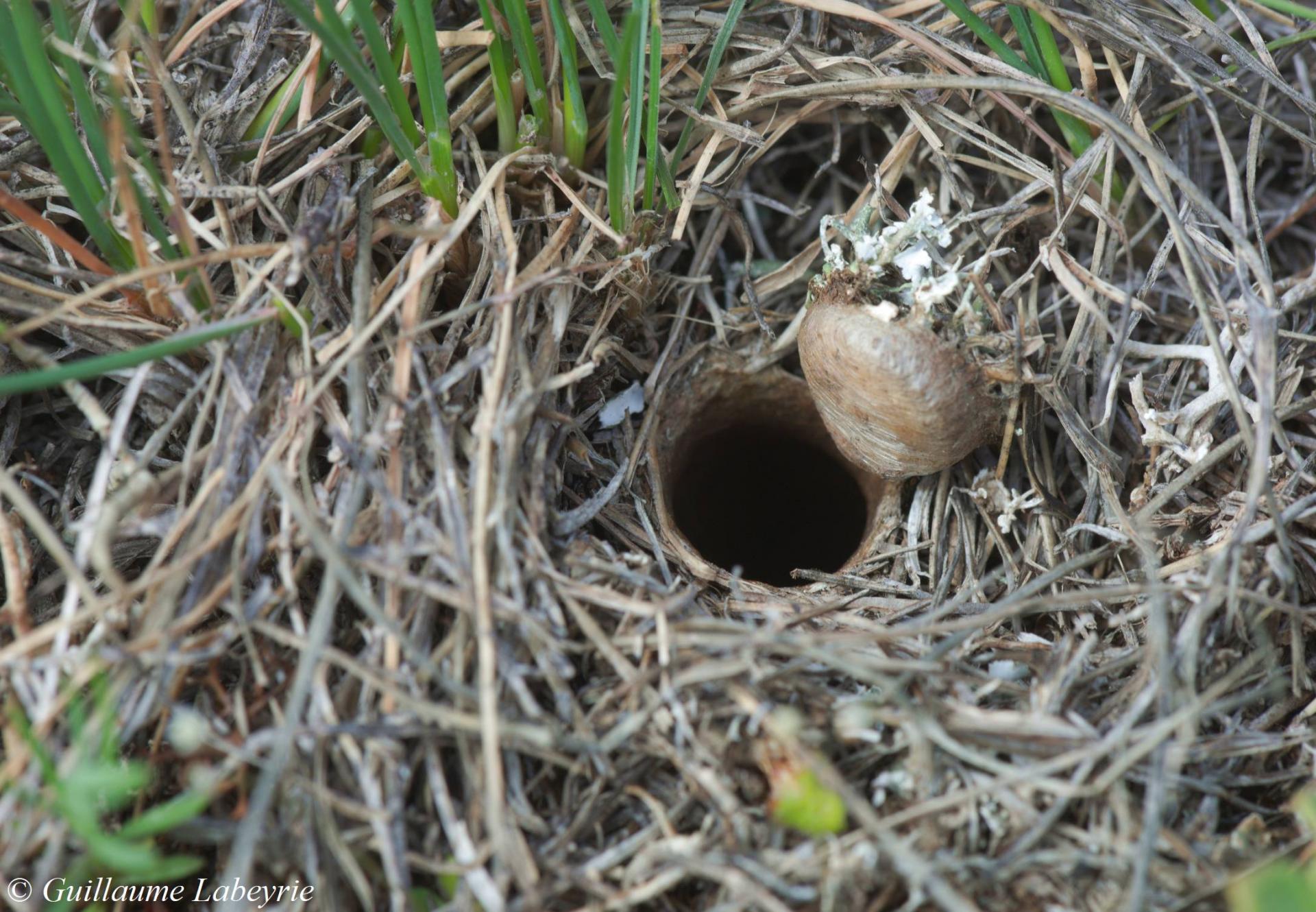 Burrow of trapdoor spider (Nemesia manderstjernae). The lid of this burrow is camouflaged with lichens and grass. Once it is closed, the entrance of the burrow is undetectable.
Burrow of trapdoor spider (Nemesia manderstjernae). The lid of this burrow is camouflaged with lichens and grass. Once it is closed, the entrance of the burrow is undetectable.
Family : Salticidae
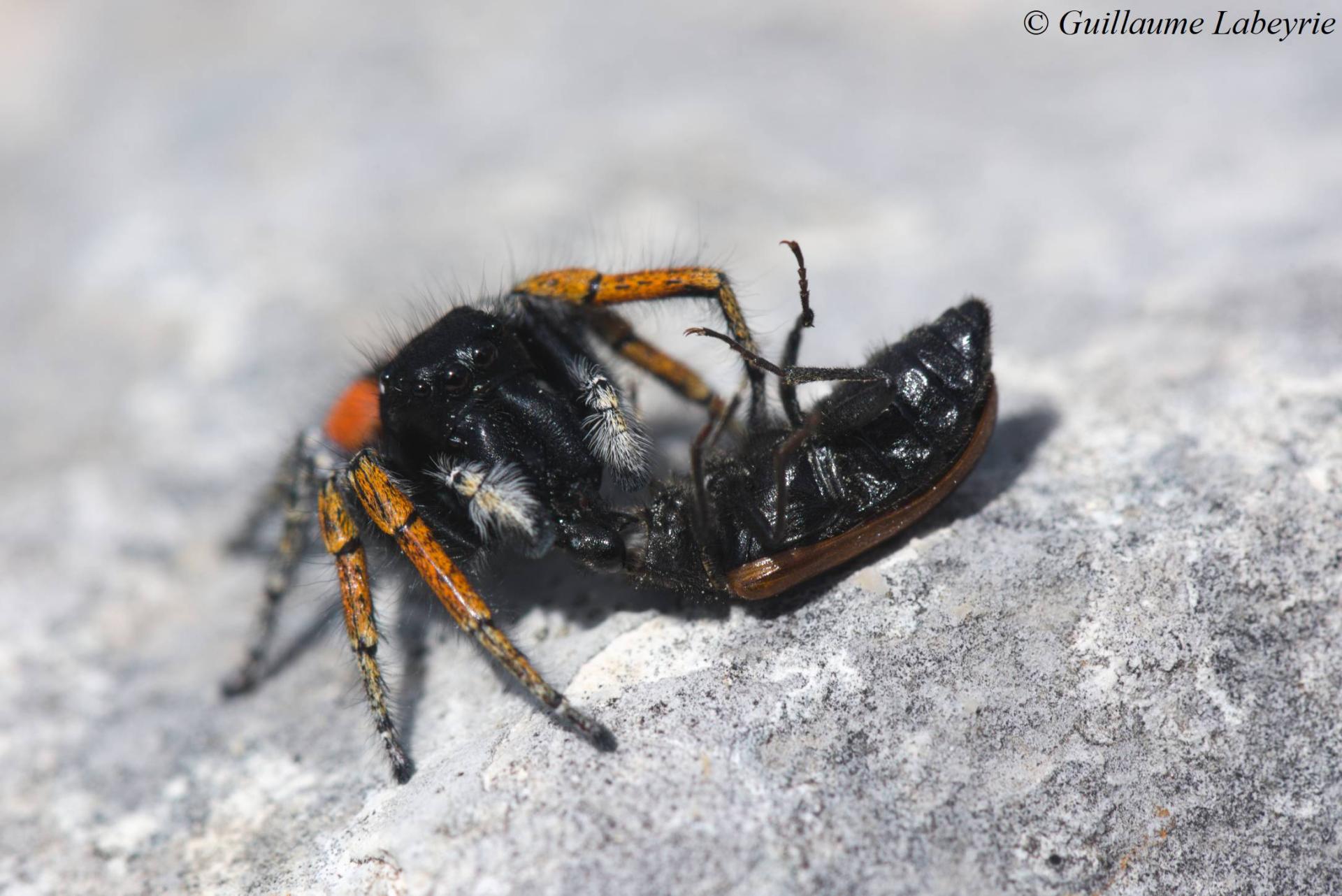
Philaeus chrysops. The male of this species of jumping spider does not go unnoticed, with his orange abdomen crossed by a black median stripe. It is one of our largest jumping spiders, measuring up to 12 mm. It is very common in rocky meadows. Distributed in Southern and Central Europe, this spider is found in France mainly in the southern half.
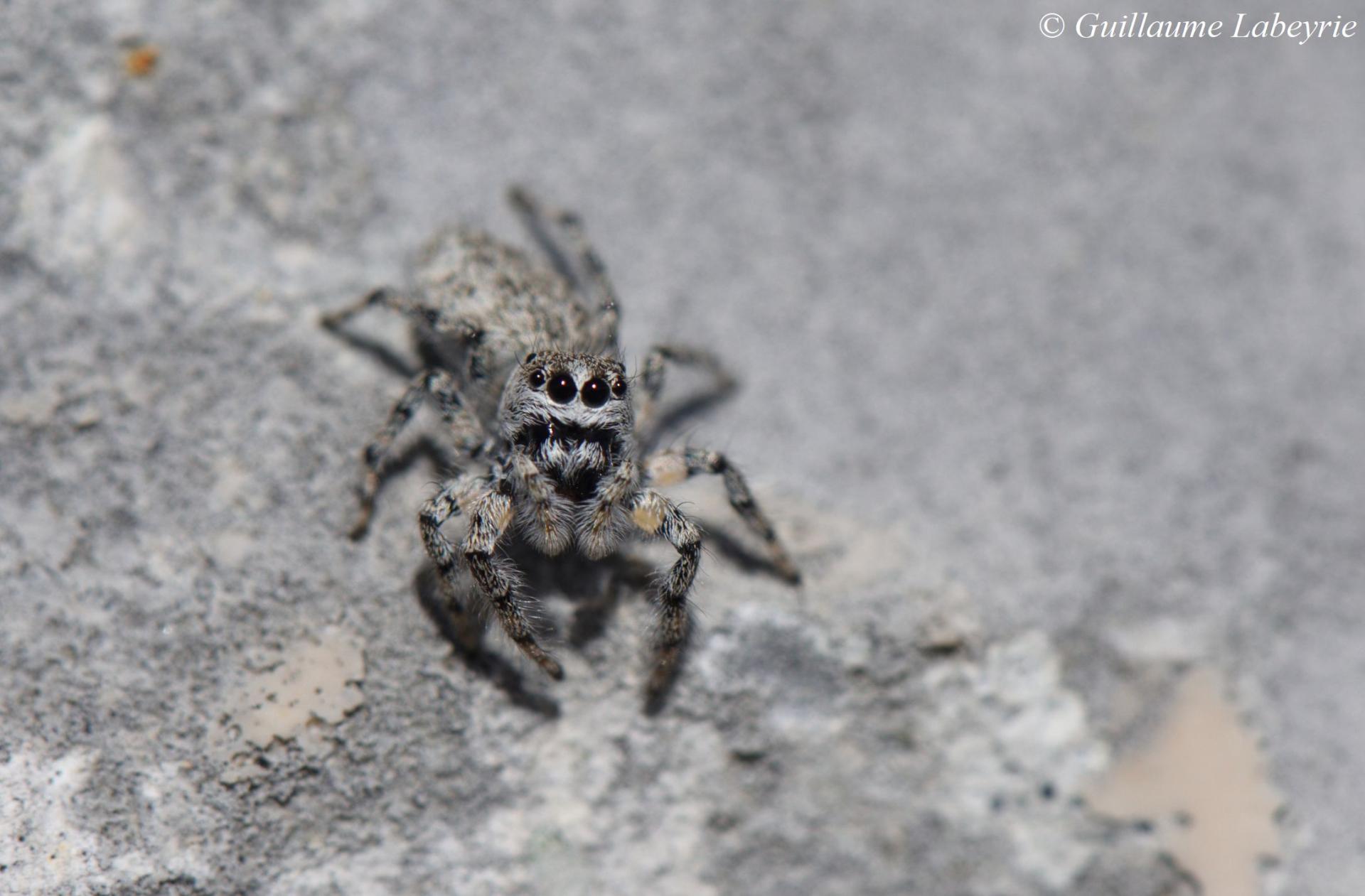
Salticus conjunctus. This small species has a whitish coloring with faint patterns and yellow-ringed legs. This is a rare species, restricted to France where it is found on the Mediterranean fringe. It appears on the French red list under the mention “near-threatened”.
Family : Euscorpiidae
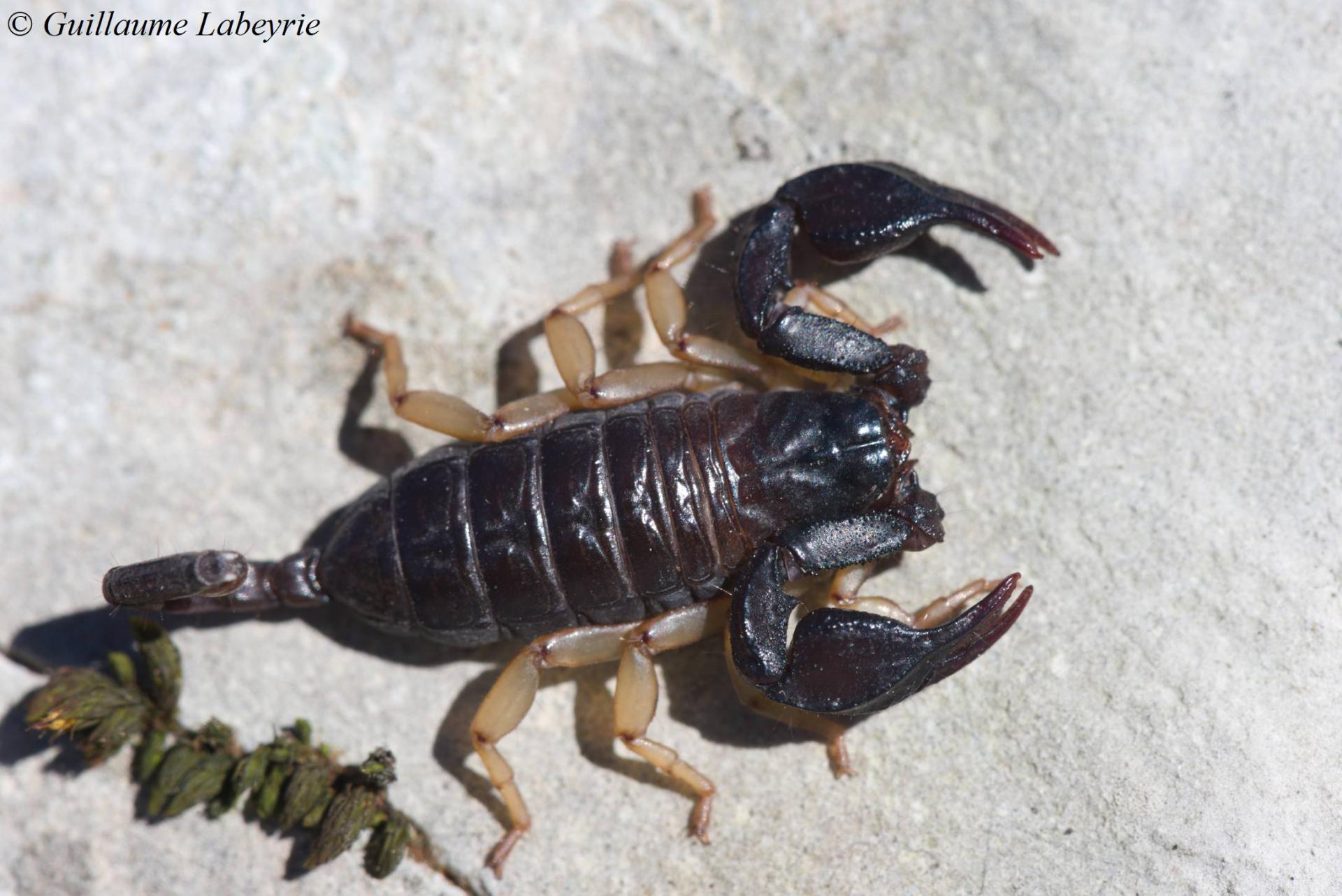
Euscorpius niciensis. The Alpes-Maritimes are home to three species of these small black scorpions, which are often difficult to identify: E. flavicaudis, E. italicus and E. niciensis (formerly E. tergestinus). The safest criterion is based on the number of trichobothria, sensory bristles implanted on the ventral side of the claws ! Mostly active at night, these scorpions shelter under a stone during the day. They often enter homes, but are harmless to humans.
Family : Ixodidae
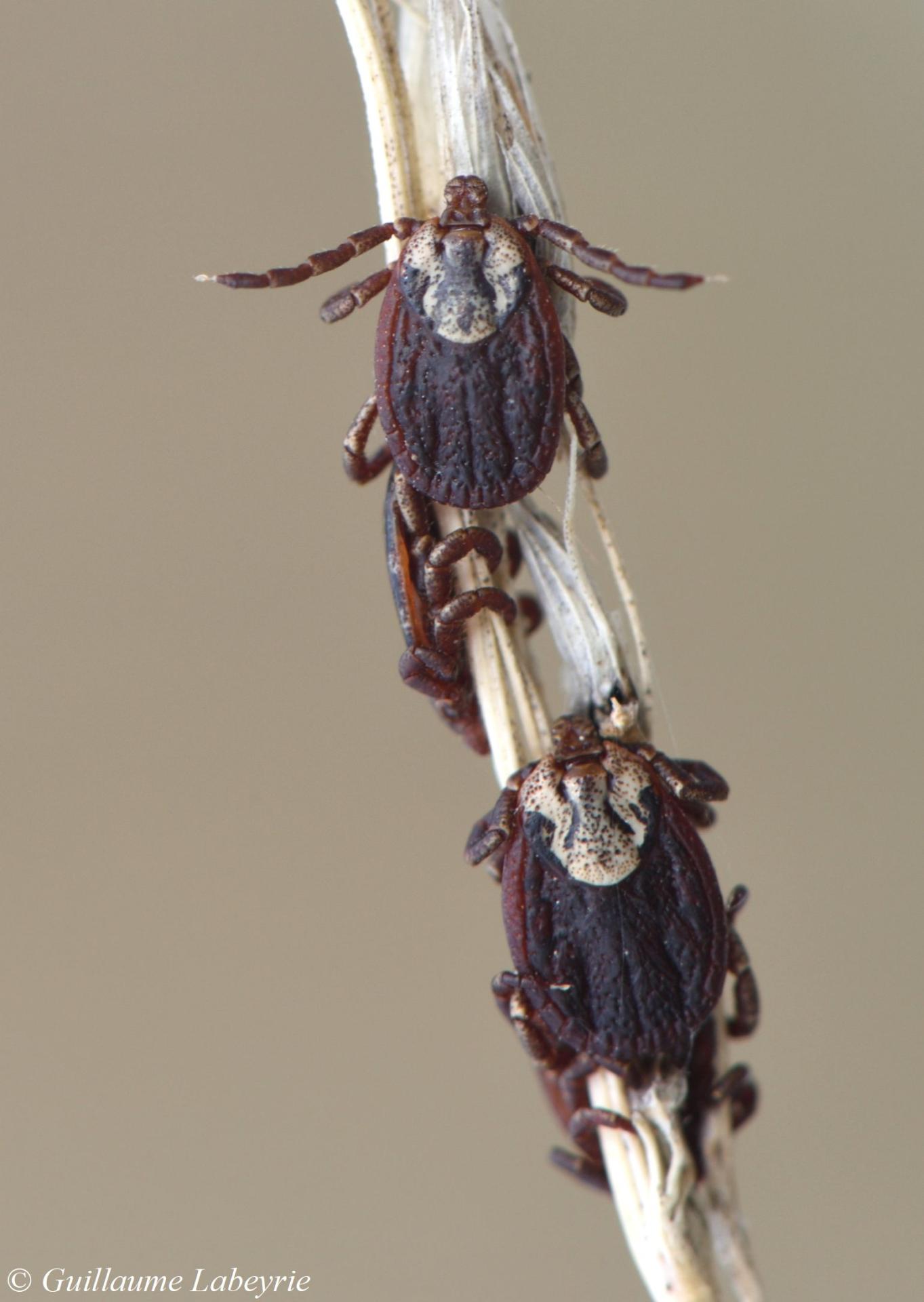
The ornate sheep tick (Dermacentor marginatus). The female ticks perched on this grass await the passage of a prey. It can be a wild animal such as a wild boar, a domestic one such as a sheep, or more rarely a human. Dermacentor marginatus is morphologically very close to Dermacentor reticulatus, but prefers drier environments. Many diseases, such as Lyme disease, are spread by ticks.
Mollusks
Family : Enidae
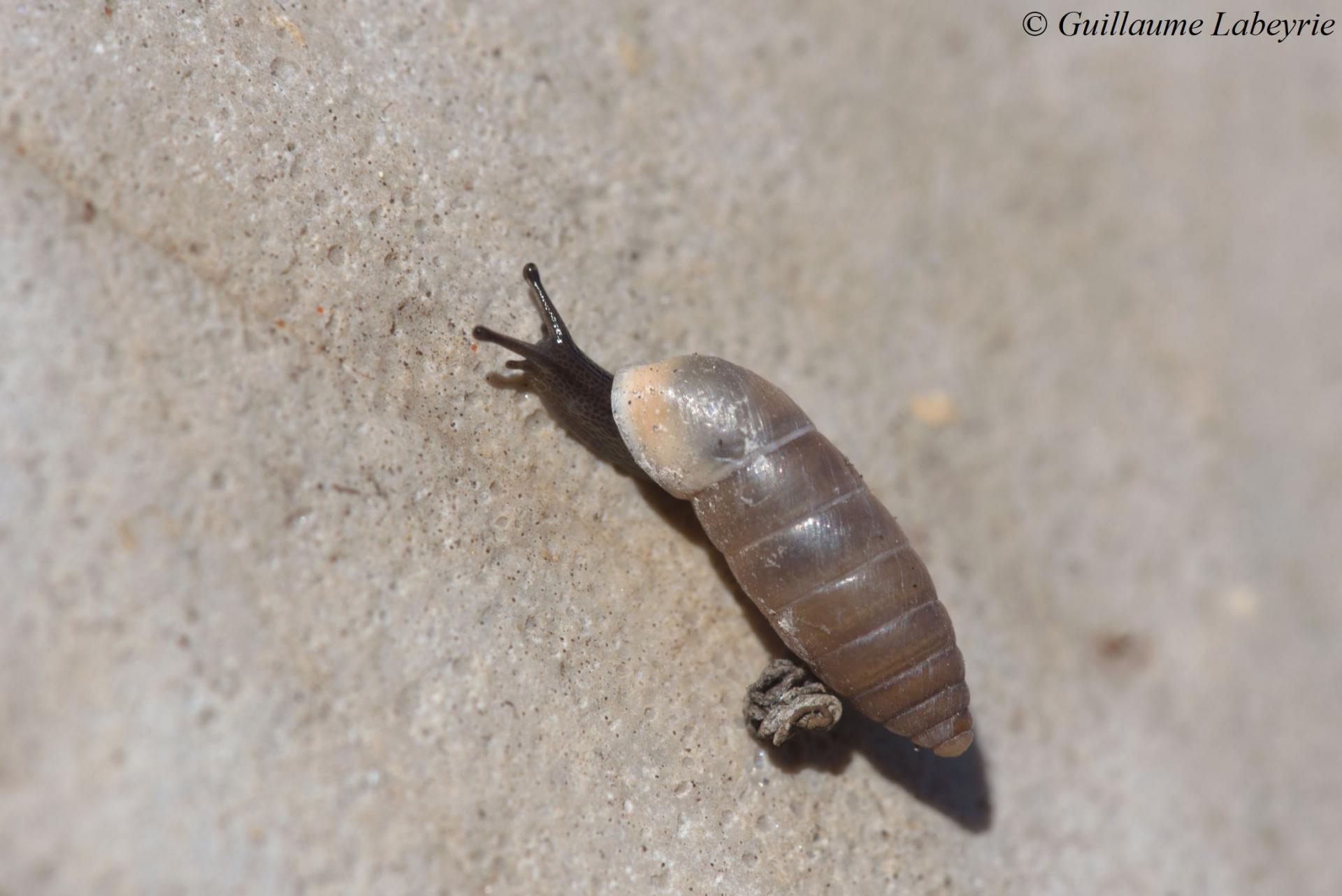 Jaminia quadridens subsp. elongata. This little snail is just over a centimeter long. It is found in steppe grasslands, where it hides under stones. Its shell has the particularity of being left-handed ("sinistral") while 90% of the French species are right-handed ("dextral"). This snail is observed in France in the South-East and in Corsica.
Jaminia quadridens subsp. elongata. This little snail is just over a centimeter long. It is found in steppe grasslands, where it hides under stones. Its shell has the particularity of being left-handed ("sinistral") while 90% of the French species are right-handed ("dextral"). This snail is observed in France in the South-East and in Corsica.
Karstic formations are due to the erosion of limestone by acidic water. Many such formations are found in the Préalpes de Grasse: canyons, dolines, lapiez, caves ... Since the climatic conditions in the karst are very diversified, it harbors an important biodiversity. Many species are found nowhere else.
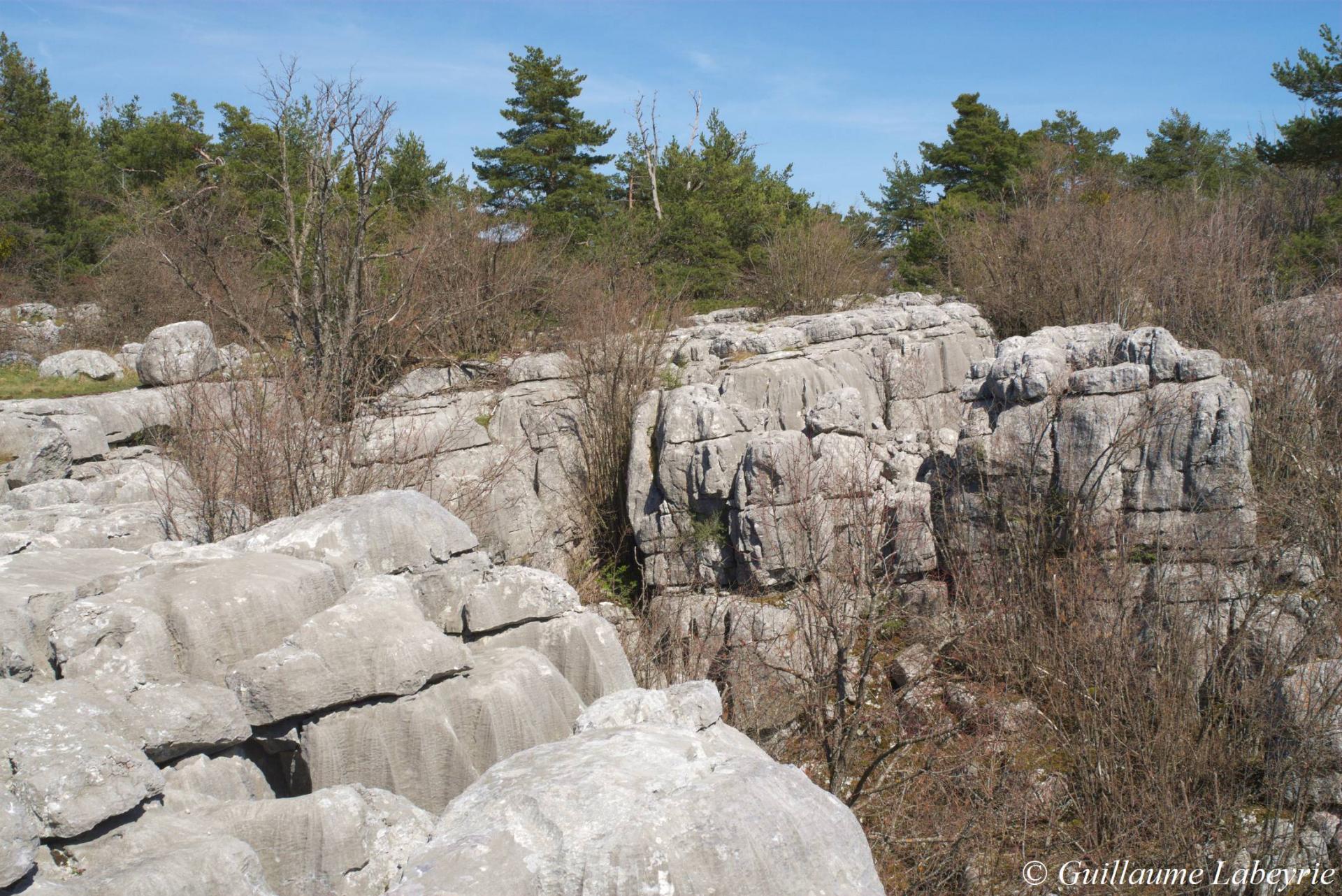 Doline and lapiez. These eroded dolomitic slabs are typical of the karst. The lapiez is usually spotted with dolines, formed by collapsed cavities. Because of the large variety of microclimates in the lapiez, the biodiversity found here is very large, with many rare and very local species.
Doline and lapiez. These eroded dolomitic slabs are typical of the karst. The lapiez is usually spotted with dolines, formed by collapsed cavities. Because of the large variety of microclimates in the lapiez, the biodiversity found here is very large, with many rare and very local species.
Flora
Family : Amaryllidaceae
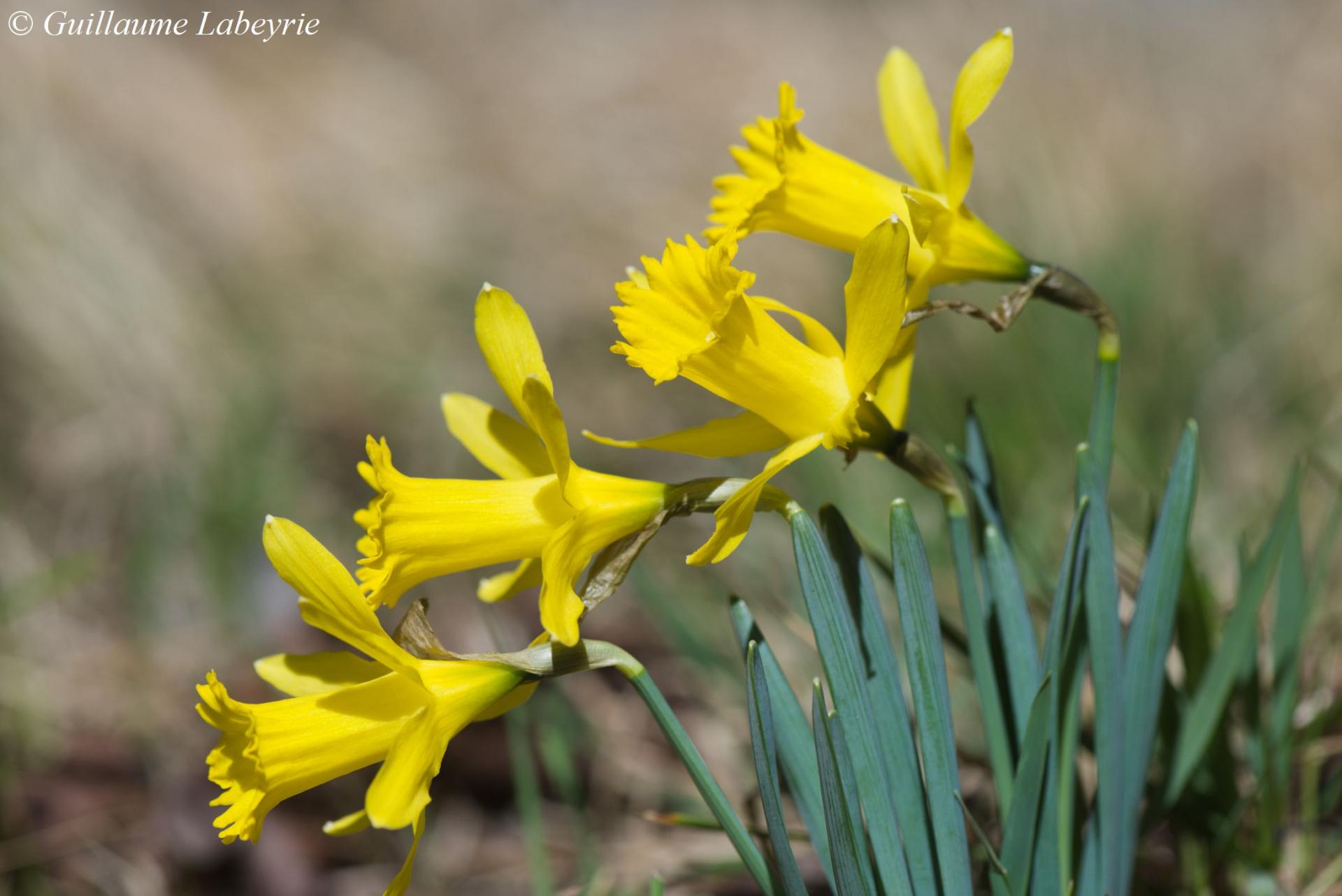
Provence's narcissus (Narcissus pseudonarcissus subsp. provincialis). This lovely species was differentiated from Narcissus minor only recently (2009). The plant is small with large yellow flowers. It blooms in clear oak woods and cracks of the karst, in early spring. It seems restricted to the Préalpes de Grasse.
Family : Aristolochiaceae
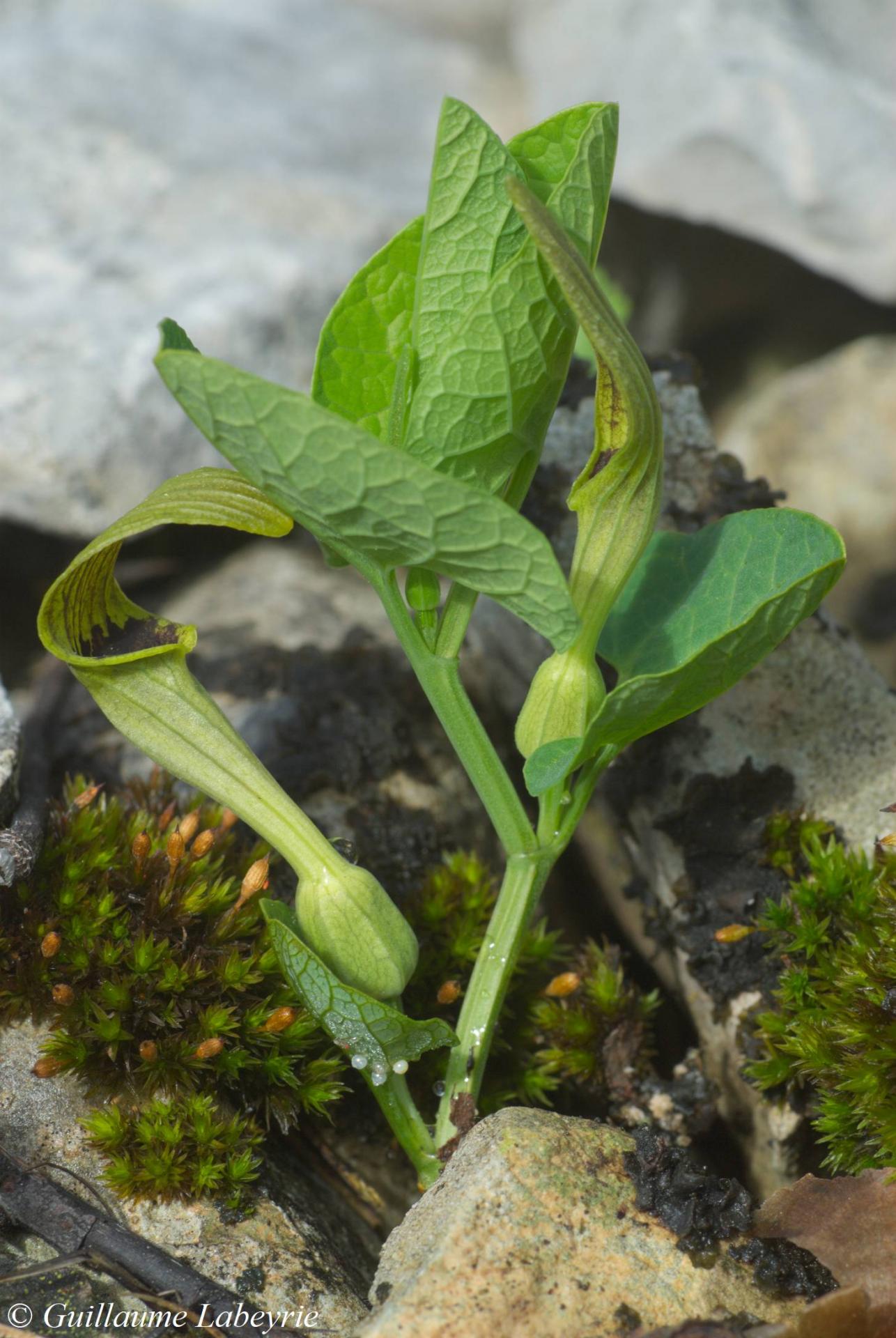 Aristolochia pallida. This small plant with trumpet-shaped green flowers grows in rock piles, karst cracks and around the dolines on calcareous plateaus in the Prealps. This is the host plant of the mountain populations of the Southern festoon (Zerynthia polyxena), a threatened butterfly whose eggs can be seen below the left flower on this photo. Aristolochia pallida is only present in France in the extreme south-east.
Aristolochia pallida. This small plant with trumpet-shaped green flowers grows in rock piles, karst cracks and around the dolines on calcareous plateaus in the Prealps. This is the host plant of the mountain populations of the Southern festoon (Zerynthia polyxena), a threatened butterfly whose eggs can be seen below the left flower on this photo. Aristolochia pallida is only present in France in the extreme south-east.
Family : Asteraceae
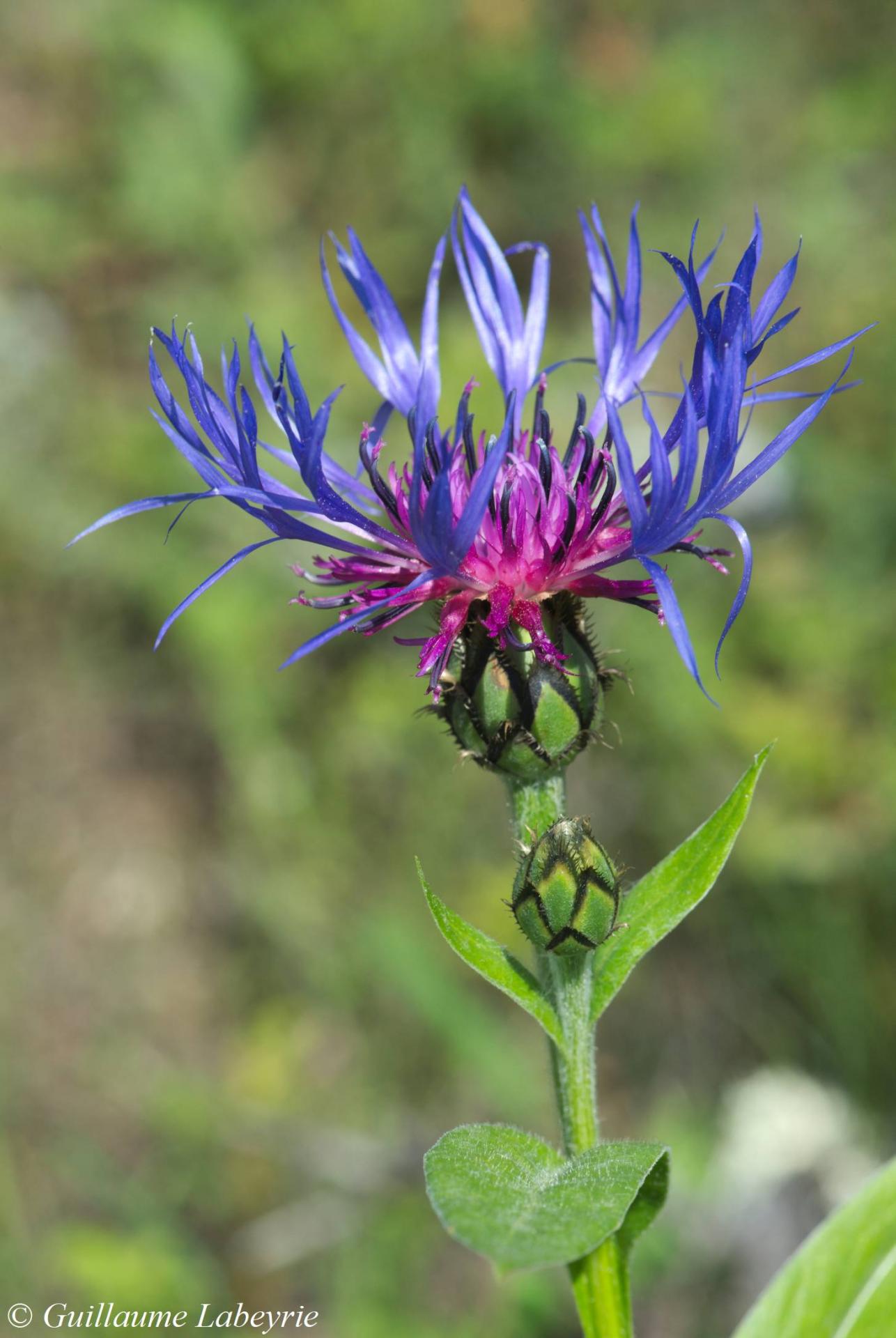 Cyanus semidecurrens. This nice member of the knapweeds displays distinctive bright colors. The leaves are slightly deccurent. In the south-east of France, this species occurs in the karst in low mountains.
Cyanus semidecurrens. This nice member of the knapweeds displays distinctive bright colors. The leaves are slightly deccurent. In the south-east of France, this species occurs in the karst in low mountains.
Family : Asparagaceae
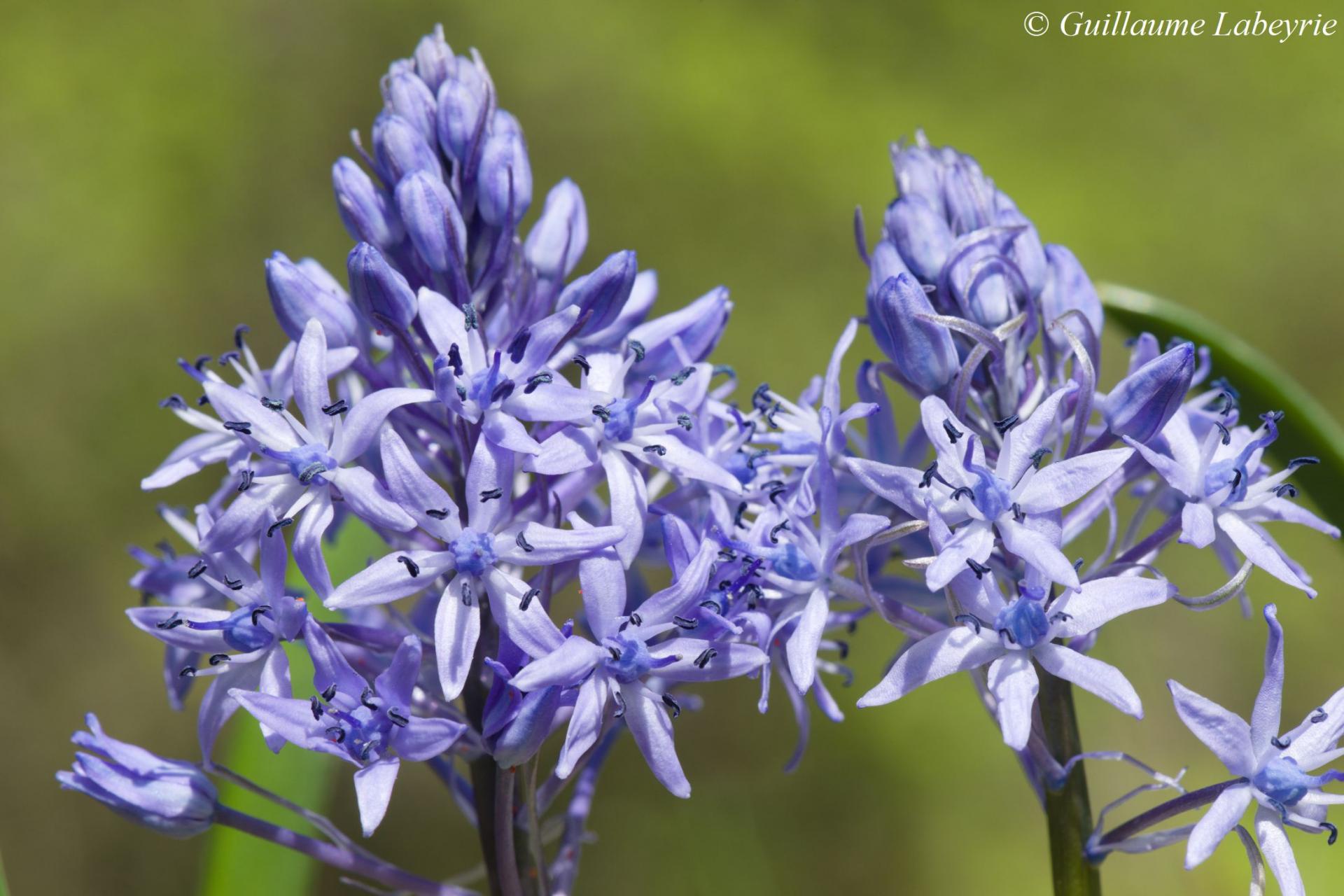 The Italian bluebell (Hyacinthoides italica). This plant of the bluebell family blooms in May, in the shadowy areas of the karst. It is a local species, endemic to southeastern France and northwestern Italy.
The Italian bluebell (Hyacinthoides italica). This plant of the bluebell family blooms in May, in the shadowy areas of the karst. It is a local species, endemic to southeastern France and northwestern Italy.
Family : Aytoniaceae
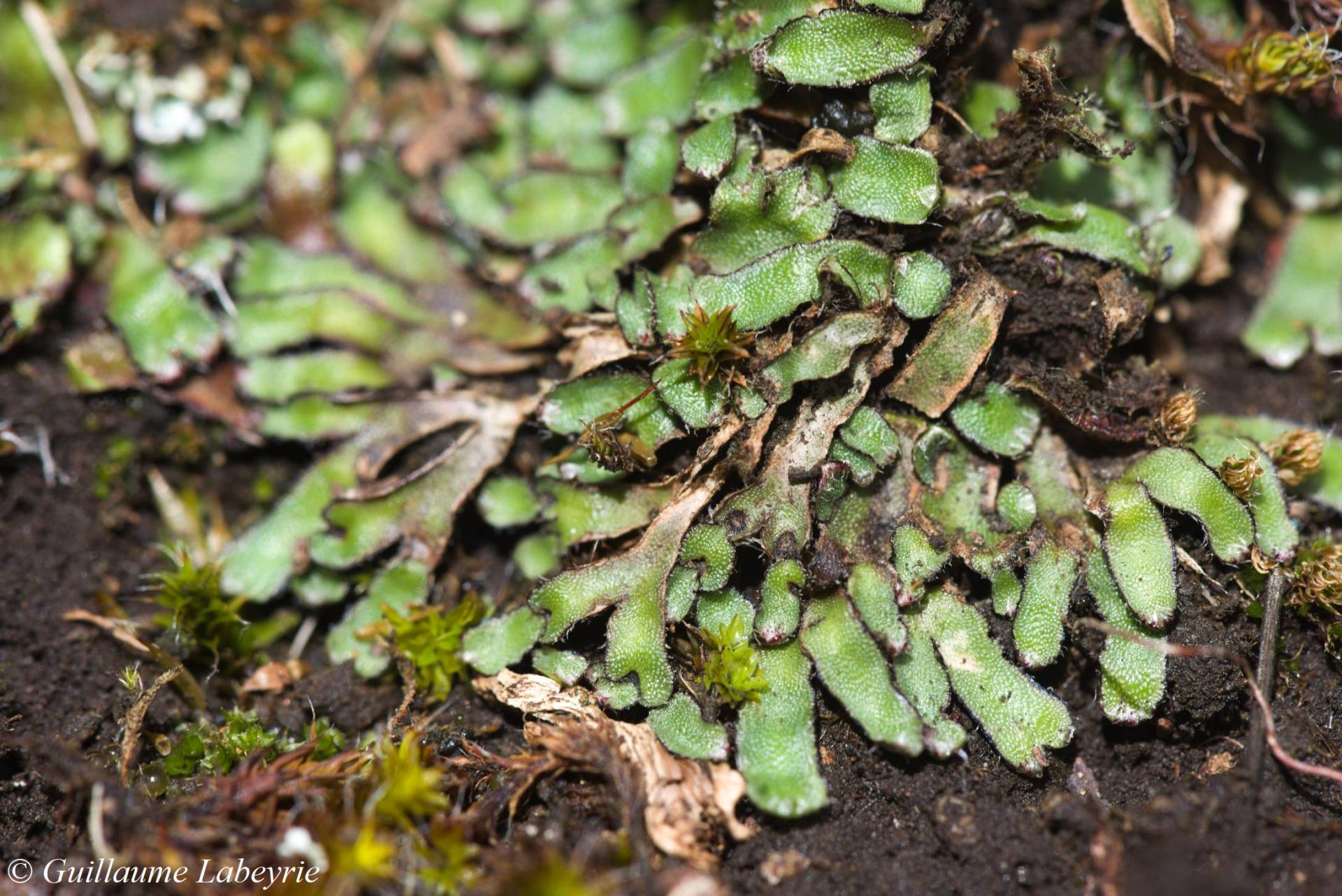
Mannia fragans. This unconspicuous liverwort is found on karst plateaus, where it grows on the ground sheltered by rocks. This species appears on the red list of threatened European flora, with the mention "vulnerable". In France, it is found mainly in the South-East.
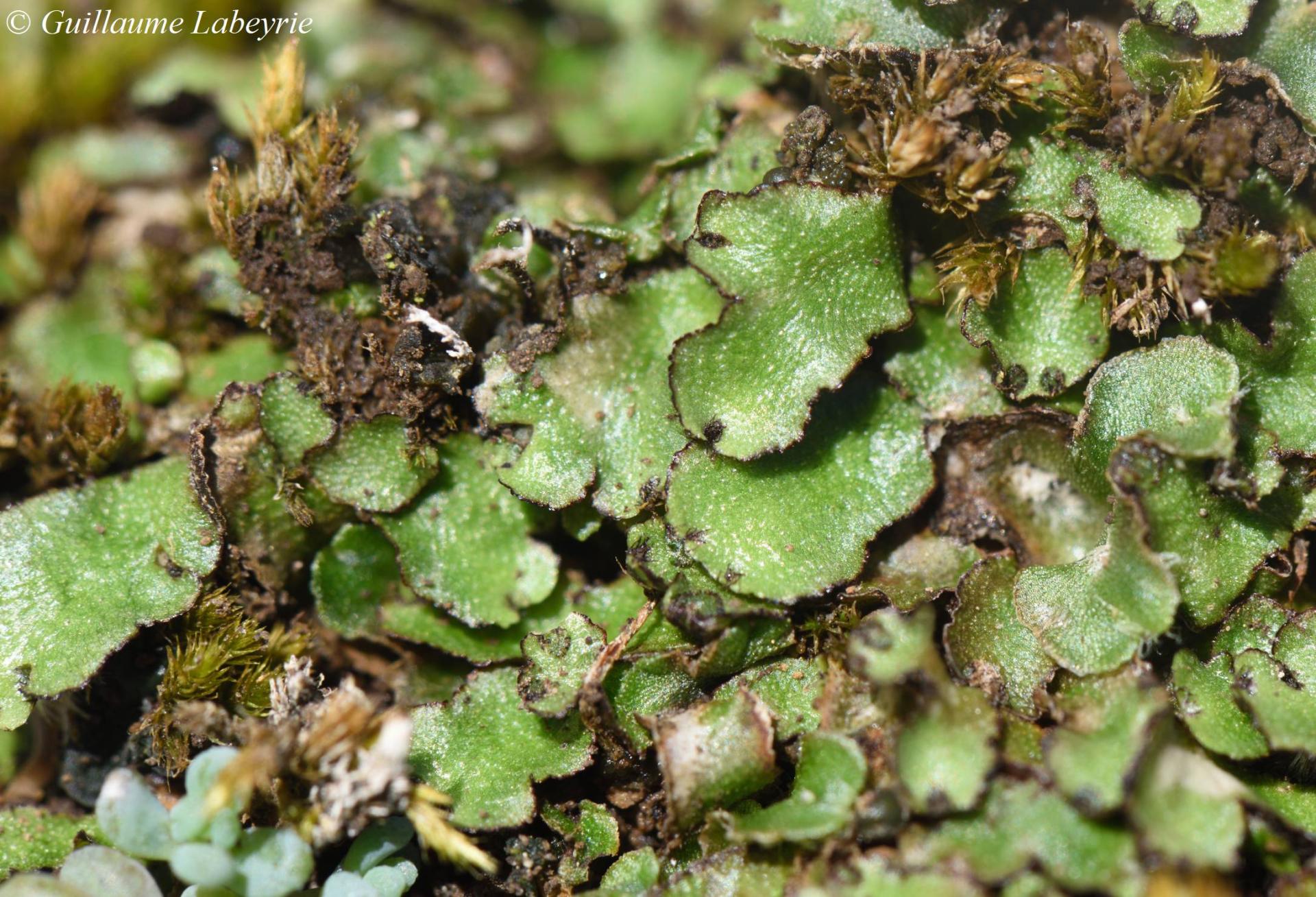
The hemisphaeric liverwort (Reboulia hemisphaerica). This other liverwort frequents the same environment as the previous species, while being much less rare. It has a very wide worldwide distribution.
Family : Boraginaceae
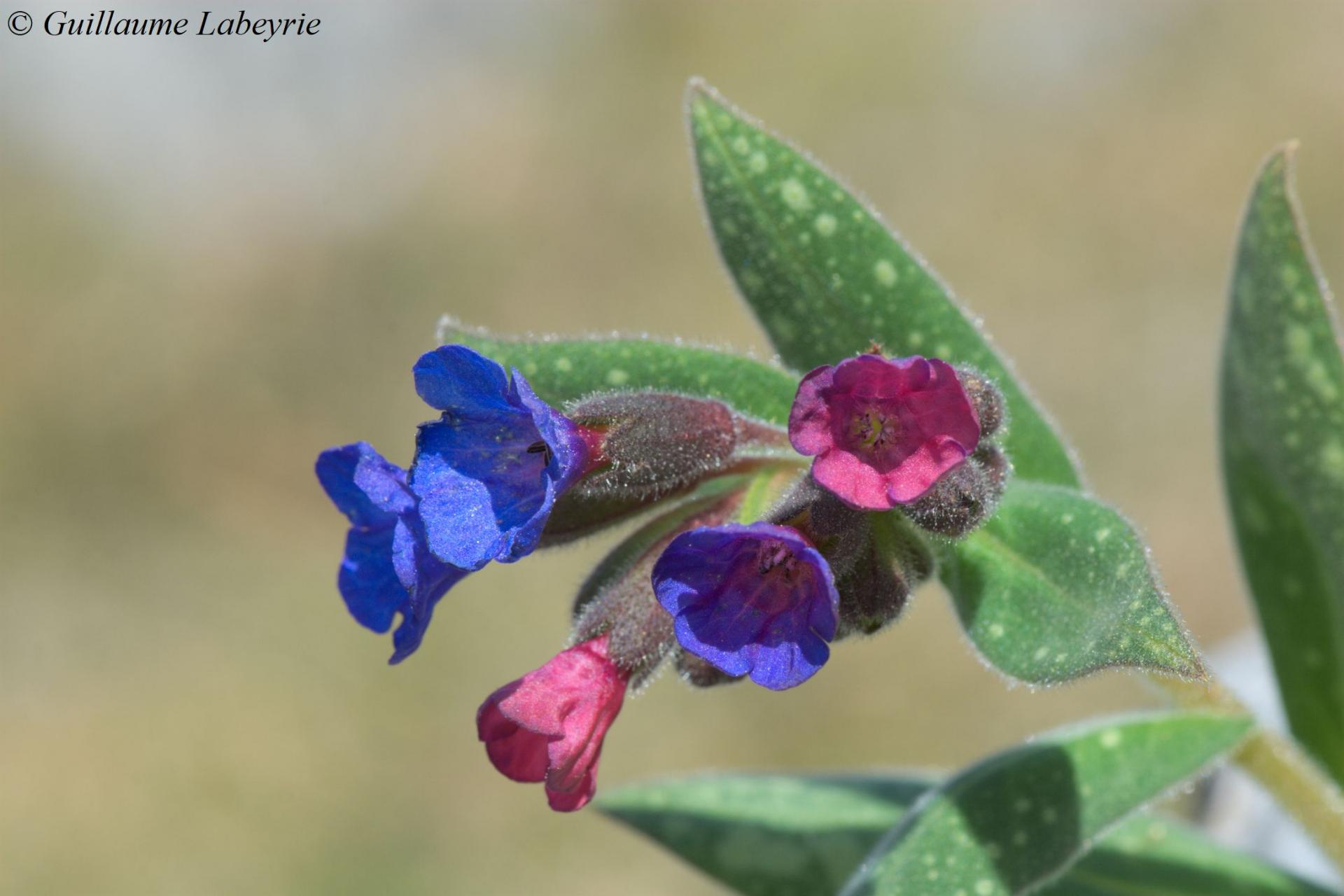 The Bethlehem lungwort (Pulmonaria saccharata). This low mountain species flowering in spring is easily recognized by its blue and purple flowers, and its large leaves with white spots. It appreciates the shade and often colonizes the bottom of collapsed dolines, in the karst. It occurs in the south-west of the Alps.
The Bethlehem lungwort (Pulmonaria saccharata). This low mountain species flowering in spring is easily recognized by its blue and purple flowers, and its large leaves with white spots. It appreciates the shade and often colonizes the bottom of collapsed dolines, in the karst. It occurs in the south-west of the Alps.
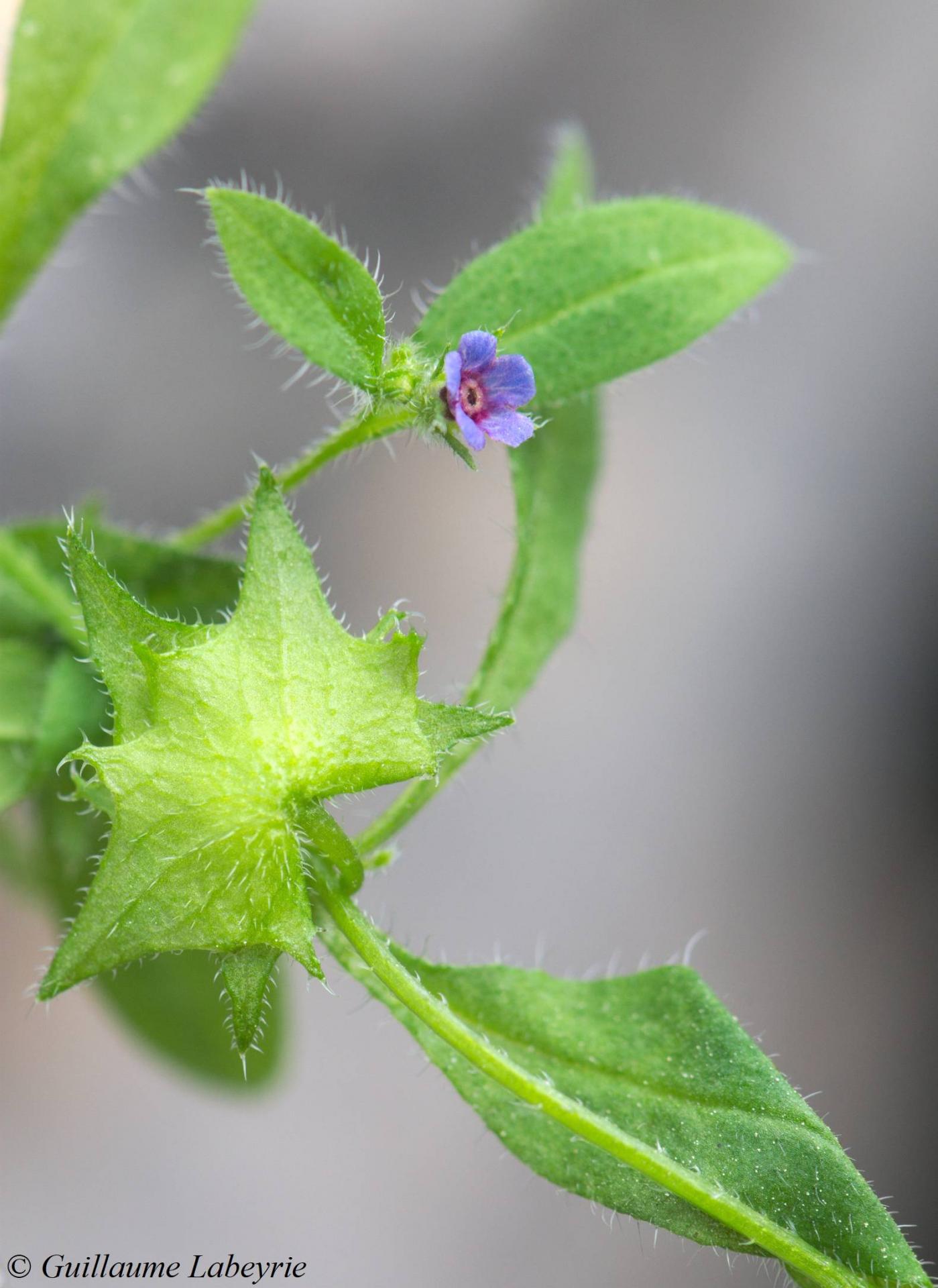
The madwort (Asperugo procumbens). This plant with small flowers has a characteristic calyx, which becomes flat and leafy when fruiting as shown in this photo. In the Grasse Prealps, it is sometimes found on the shaded bottom of collapsed sinkholes. This species is present in France especially in a south-eastern third.
Family : Celastraceae
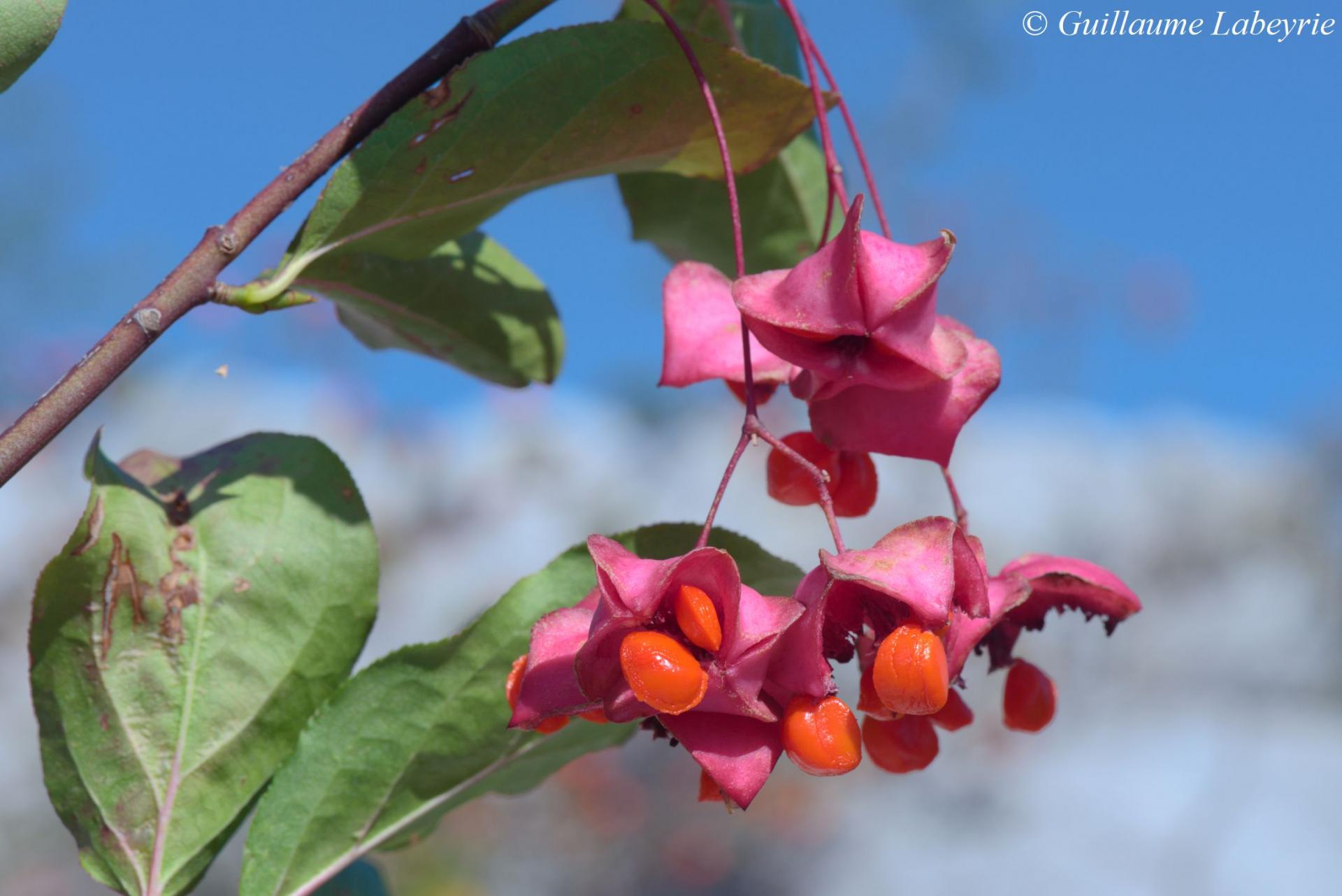
The large-leaf spindle (Euonymus latifolius). This nice plant is distinguished from the much more widespread European spindle (Euonymus europaeus) by its keeled capsules. In the Grasse Prealps, it is a characteristic shrub of the lapiez. This very toxic species is found in France mainly in the South-East. It is protected in région Midi-Pyrénées.
Family : Dryopteridaceae
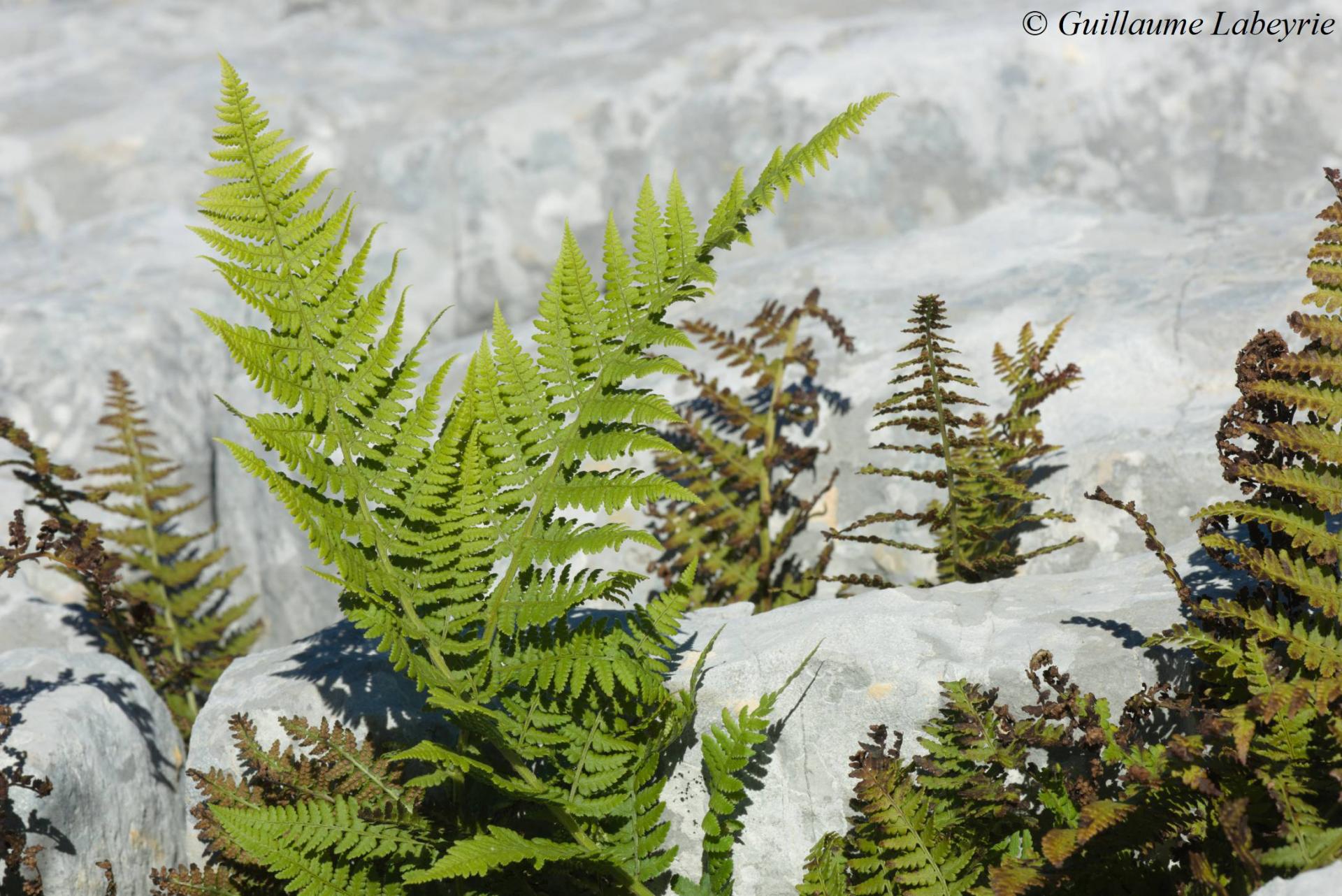 The rigid buckler-fern (Dryopteris mindshelkensis). This fern is a specialist of cracks in the lapiez. Rare in France, it is found only in the extreme south-east and in the Pyrenees.
The rigid buckler-fern (Dryopteris mindshelkensis). This fern is a specialist of cracks in the lapiez. Rare in France, it is found only in the extreme south-east and in the Pyrenees.
Family : Fabaceae
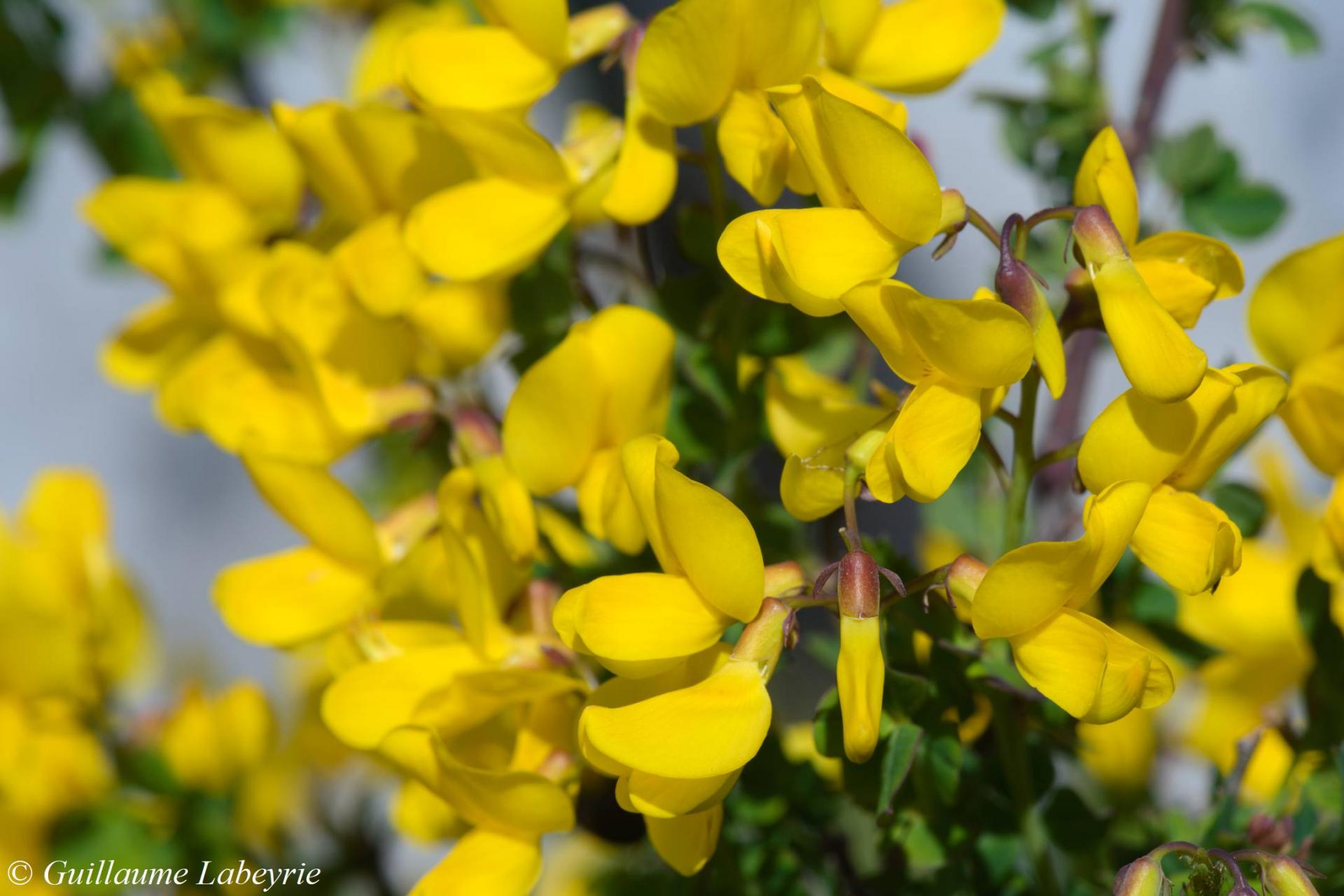
Cytisophyllum sessilifolium. This species forms bushes exceeding one meter in height, covered with yellow flowers. It is found especially in dry places in the lapiaz. Present in France mainly in the South, it is protected in the Champagne-Ardenne region.
Family : Iridaceae
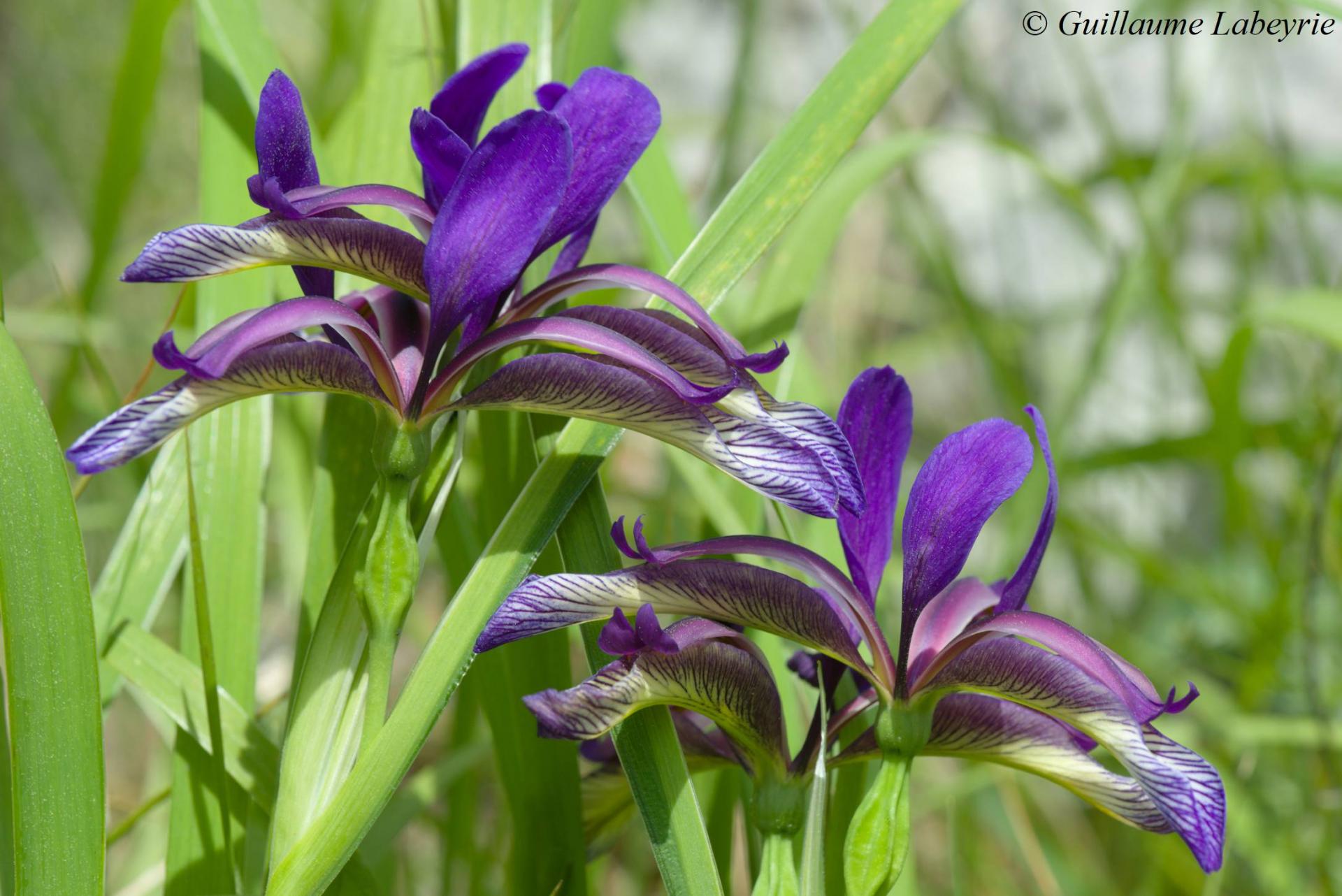 The grass-leaved flag (Iris graminea). Outside the flowering period (May-June), this plant is easily overlooked since its leaves strongly resemble that of certain species of grass. This rare species occurs in France in the south-west, and in the Alpes-Maritimes where it is protected. It grows in cracks of karstic slabs, at an altitude around 1000 m.
The grass-leaved flag (Iris graminea). Outside the flowering period (May-June), this plant is easily overlooked since its leaves strongly resemble that of certain species of grass. This rare species occurs in France in the south-west, and in the Alpes-Maritimes where it is protected. It grows in cracks of karstic slabs, at an altitude around 1000 m.
Family : Lamiaceae
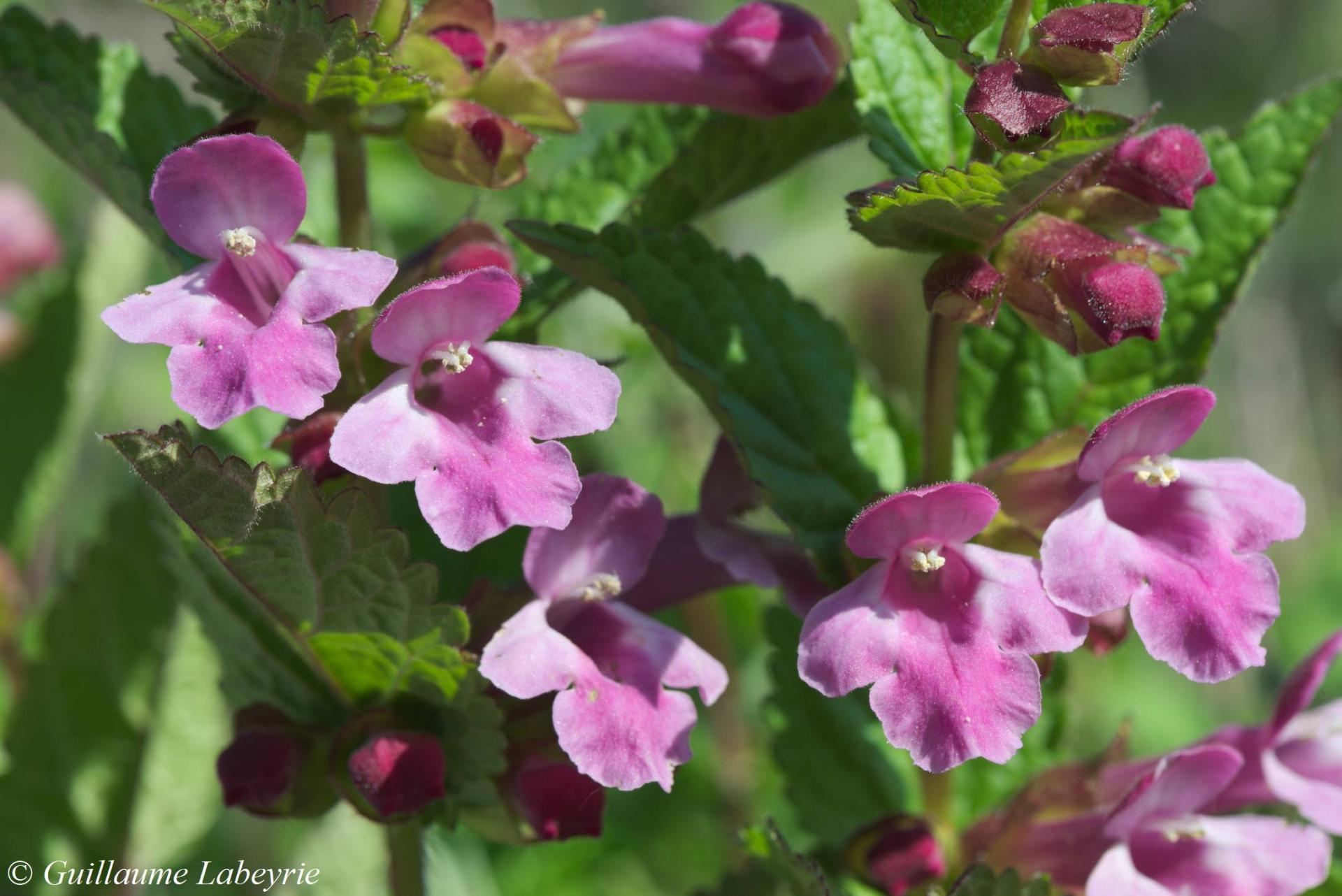 The bastard balm (Mellitis melissophylum). The is one of the most striking member of the Lamiaceae family, with its large pink flowers exceeding 4 cm in length. In the Préalpes de Grasse, this plant is found in the cracks of the lapiaz. The fragrant leaves can be used in herbal tea.
The bastard balm (Mellitis melissophylum). The is one of the most striking member of the Lamiaceae family, with its large pink flowers exceeding 4 cm in length. In the Préalpes de Grasse, this plant is found in the cracks of the lapiaz. The fragrant leaves can be used in herbal tea.
Family : Liliaceae
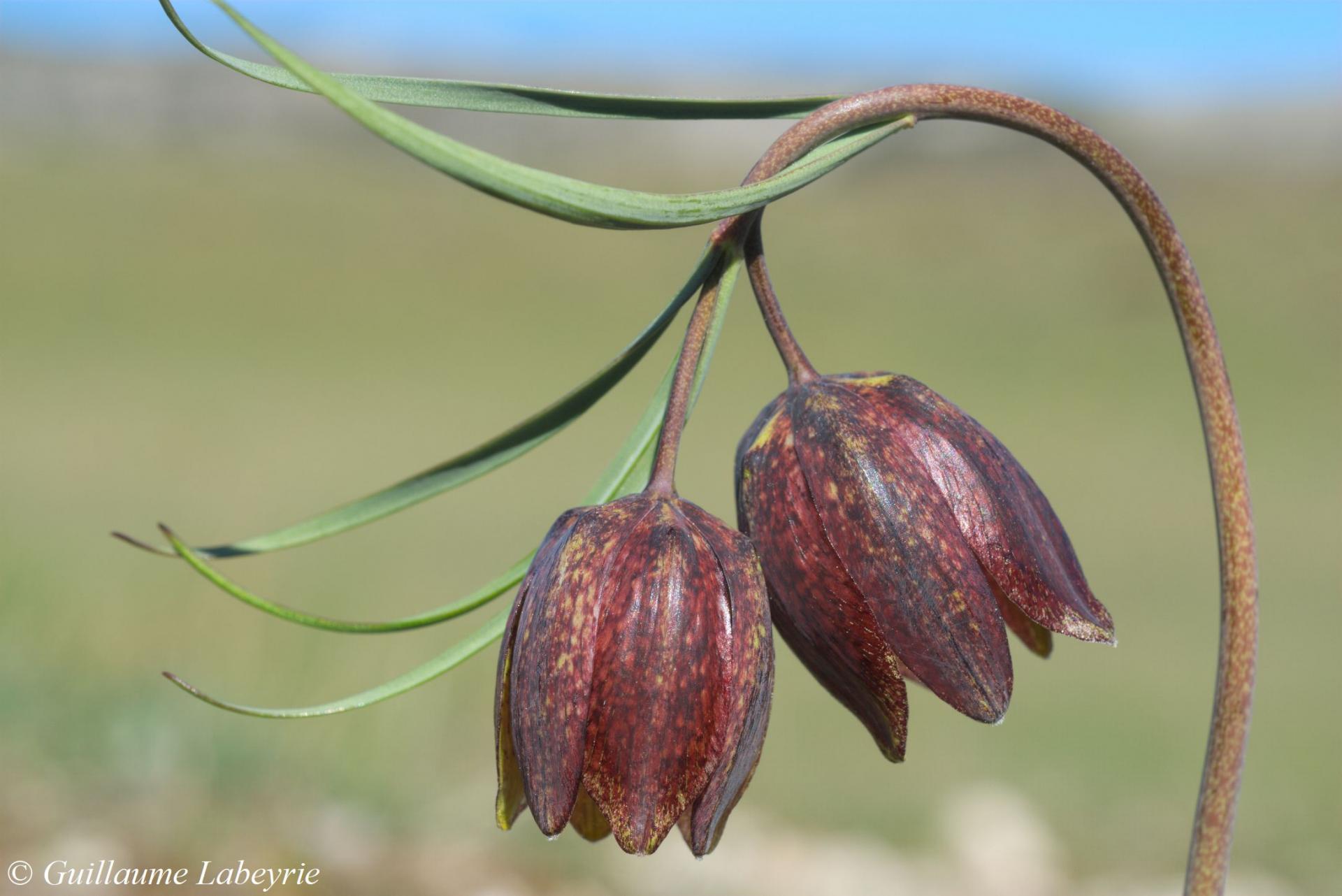 The oriental fritillary (Fritillaria montana). This plant is readily recognized by its small dark bell-shaped flowers, and its alternate leaves. It flowers in April in karstic meadows. The oriental fritillary is a very rare plant in France, occurring in a single location. It is fully protected.
The oriental fritillary (Fritillaria montana). This plant is readily recognized by its small dark bell-shaped flowers, and its alternate leaves. It flowers in April in karstic meadows. The oriental fritillary is a very rare plant in France, occurring in a single location. It is fully protected.
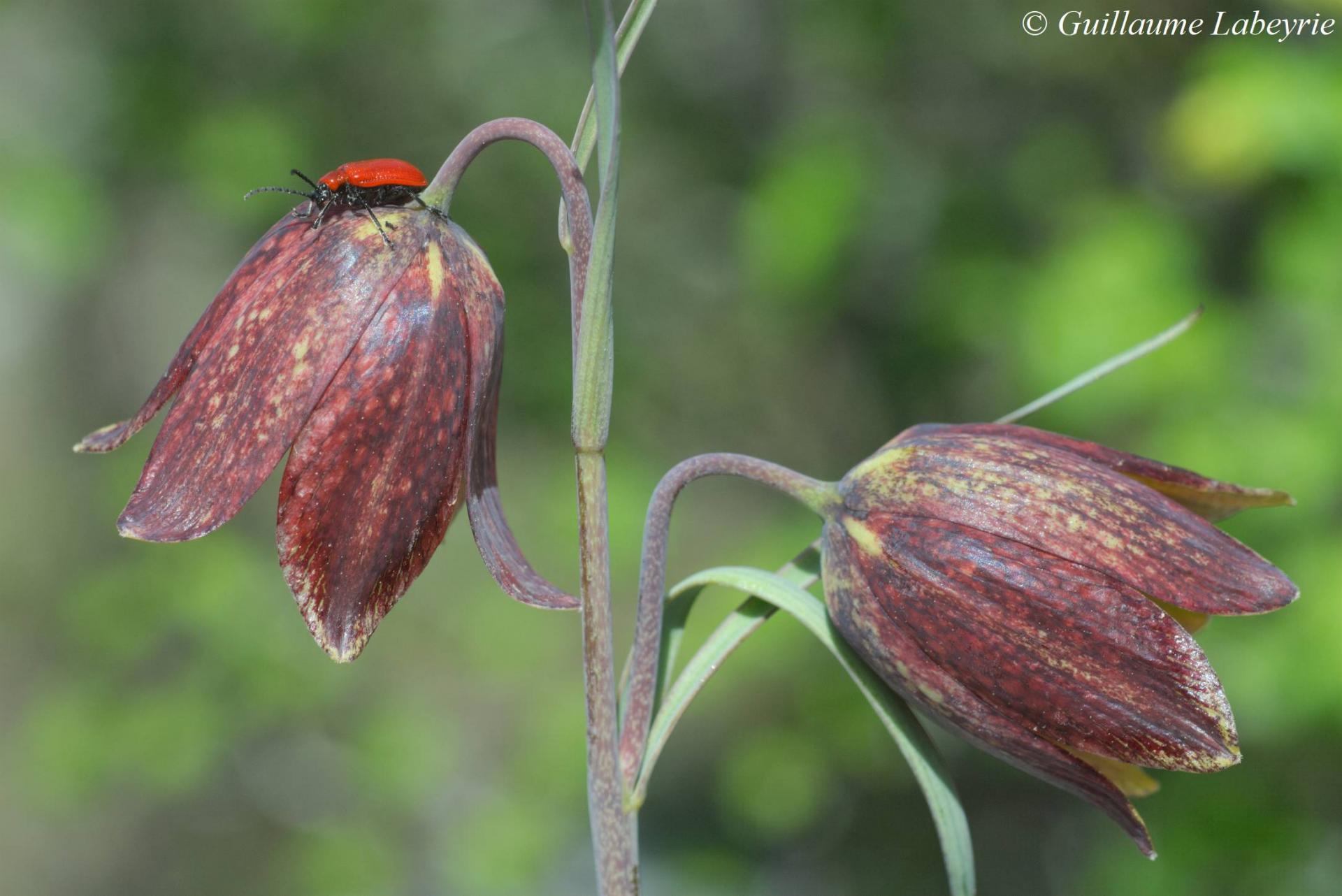 Lily leaf beetle (Lilioceris lilii) on oriental fritillary. The lily leaf beetle is a small, bright red beetle, which consumes many species from the lily family, including fritillaries.
Lily leaf beetle (Lilioceris lilii) on oriental fritillary. The lily leaf beetle is a small, bright red beetle, which consumes many species from the lily family, including fritillaries.
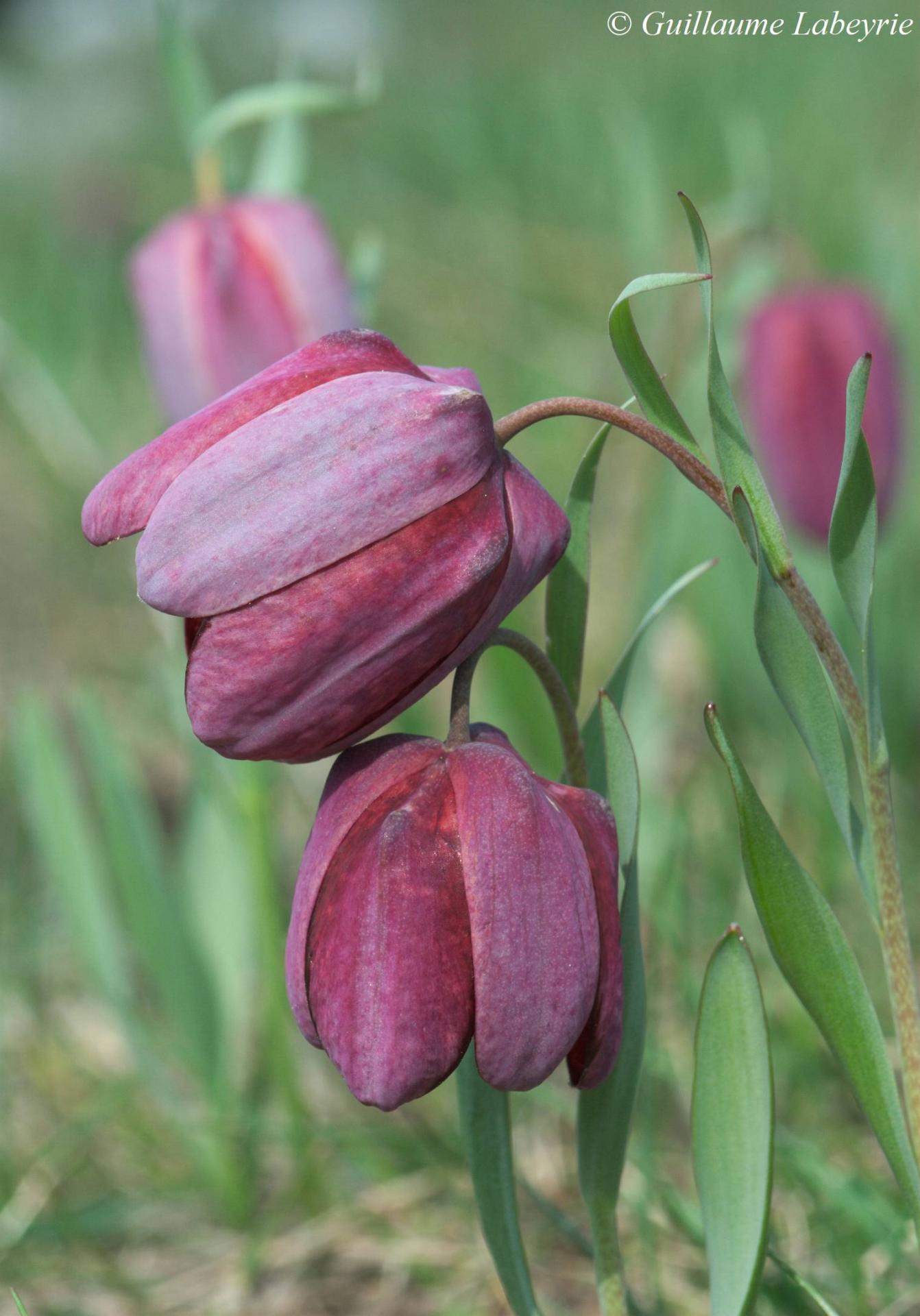 Dauphiné's fritillary (Fritillaria tubiformis subsp. tubiformis). This species is recognizable to its large greyish-pink flowers. Its is endemic to the Southern Alps, and flowers in May-June in rocky meadows above 1400 m of altitude.
Dauphiné's fritillary (Fritillaria tubiformis subsp. tubiformis). This species is recognizable to its large greyish-pink flowers. Its is endemic to the Southern Alps, and flowers in May-June in rocky meadows above 1400 m of altitude.
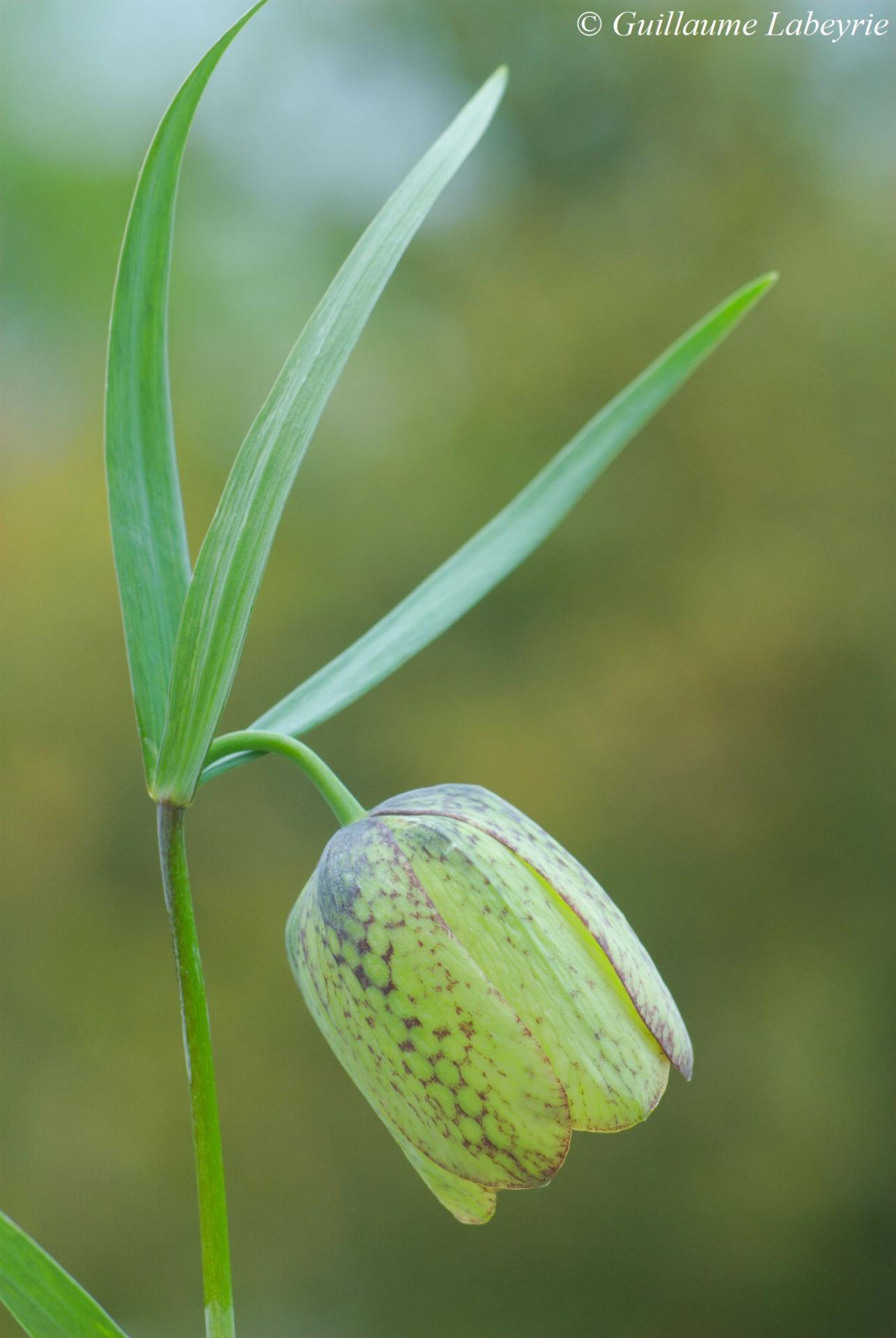 Fritillaria involucrata. This plant is the third species of Fritillary occurring in the Préalpes de Grasse. Much more widespread than the two previous species, it is recognized by its large green flowers hanging from a whorl of three leaves. It is found in the karst and below bushes. This is a species of the meridional Alps.
Fritillaria involucrata. This plant is the third species of Fritillary occurring in the Préalpes de Grasse. Much more widespread than the two previous species, it is recognized by its large green flowers hanging from a whorl of three leaves. It is found in the karst and below bushes. This is a species of the meridional Alps.
Family : Paeoniaceae
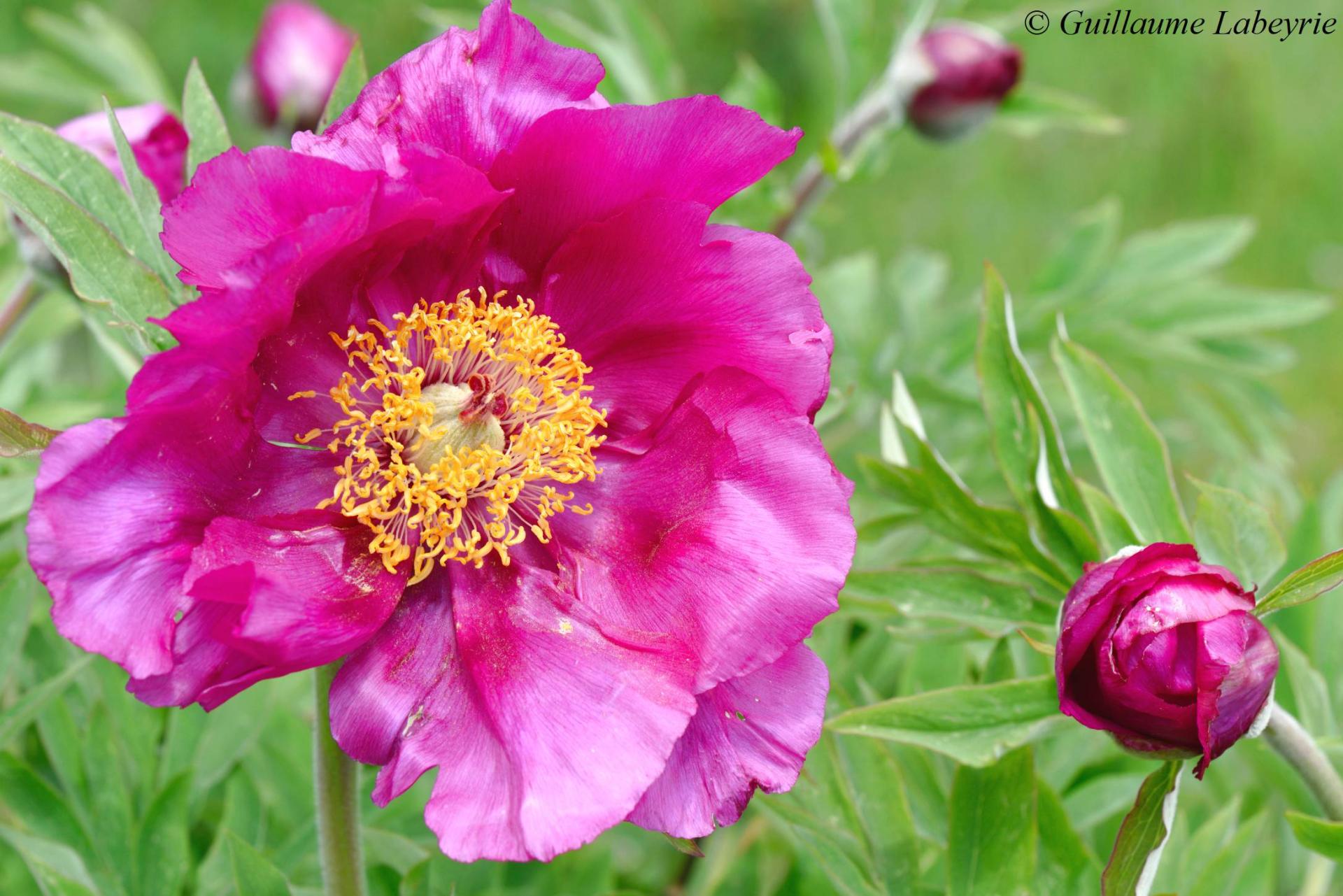
The hairy peony (Paeonia officinalis subsp. huthii). With its pink flowers exceeding 10 cm in diameter, this peony is certainly the most spectacular plant in the area. It flowers in May-June, in karst meadows and clear beech woods. This particular subspecies occurs only in southeastern France and Italy. Sometimes abundant in its locations, this magnificent plant is however vulnerable and protected in France : do not pick it !
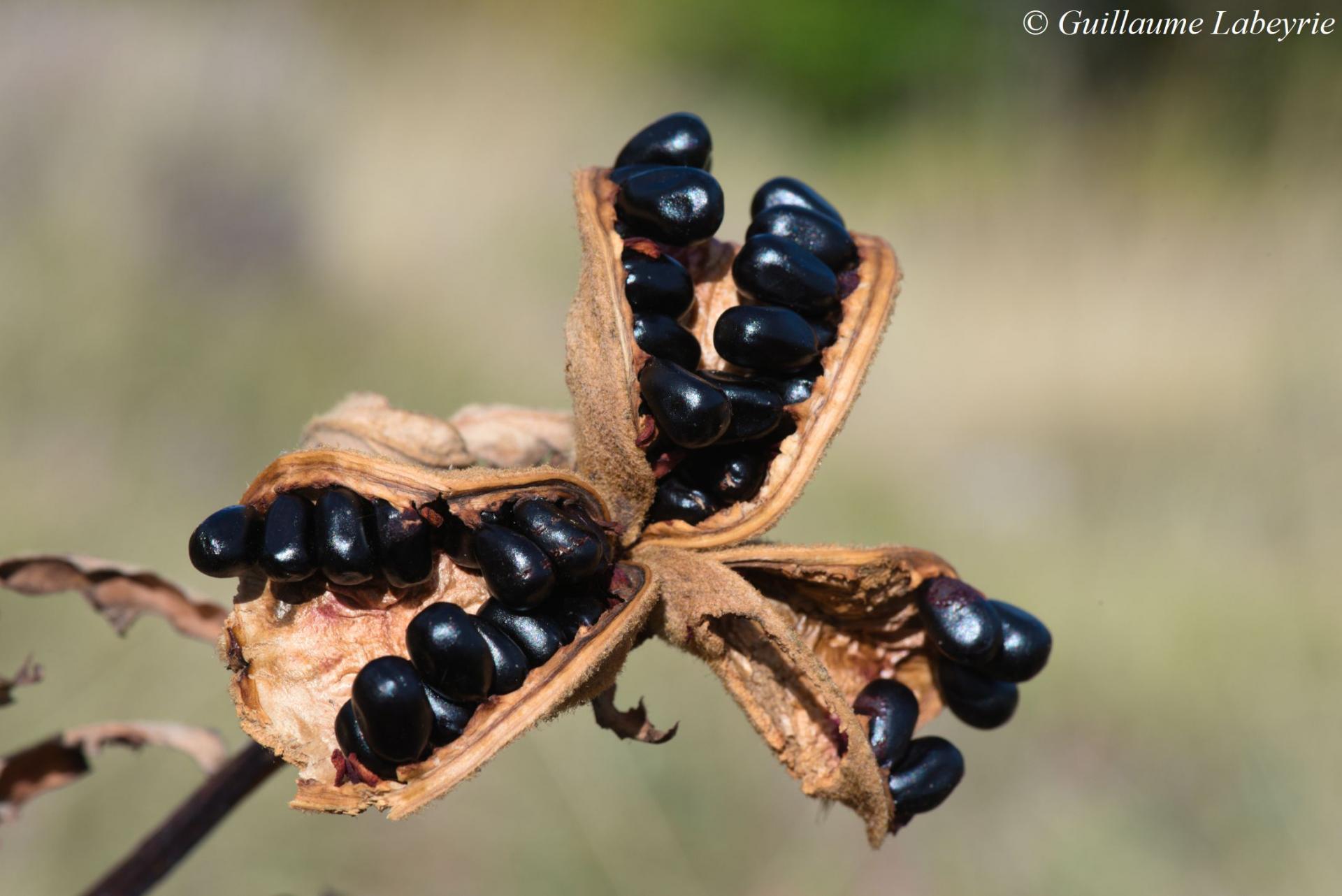 The hairy peony (Paeonia officinalis subsp. huthii), dry follicles with seeds.
The hairy peony (Paeonia officinalis subsp. huthii), dry follicles with seeds.
Family : Papaveraceae
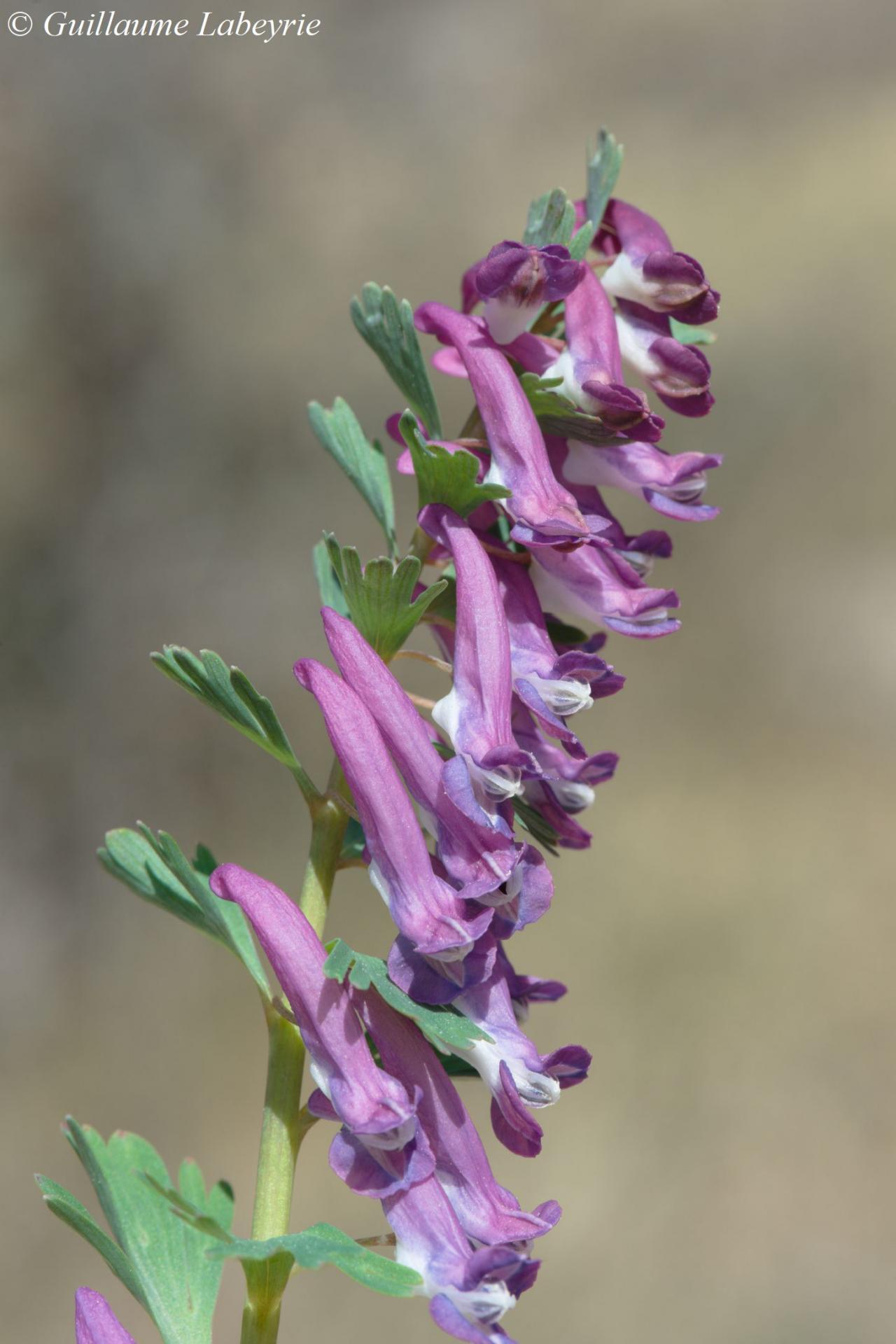 The fumewort (Corydalis solida). This plant appreciates sunny locations protected from the wind. Unlike in Corydalis cava, a related pecies, the bracts are divided and similar to the leaves. In the Préalpes de Grasse, the fumewort is the host plant of the clouded Apollo (Parnassius mnemosyne), a scarce and protected butterfly. This plant occurs in most of France.
The fumewort (Corydalis solida). This plant appreciates sunny locations protected from the wind. Unlike in Corydalis cava, a related pecies, the bracts are divided and similar to the leaves. In the Préalpes de Grasse, the fumewort is the host plant of the clouded Apollo (Parnassius mnemosyne), a scarce and protected butterfly. This plant occurs in most of France.
Family : Ranunculaceae
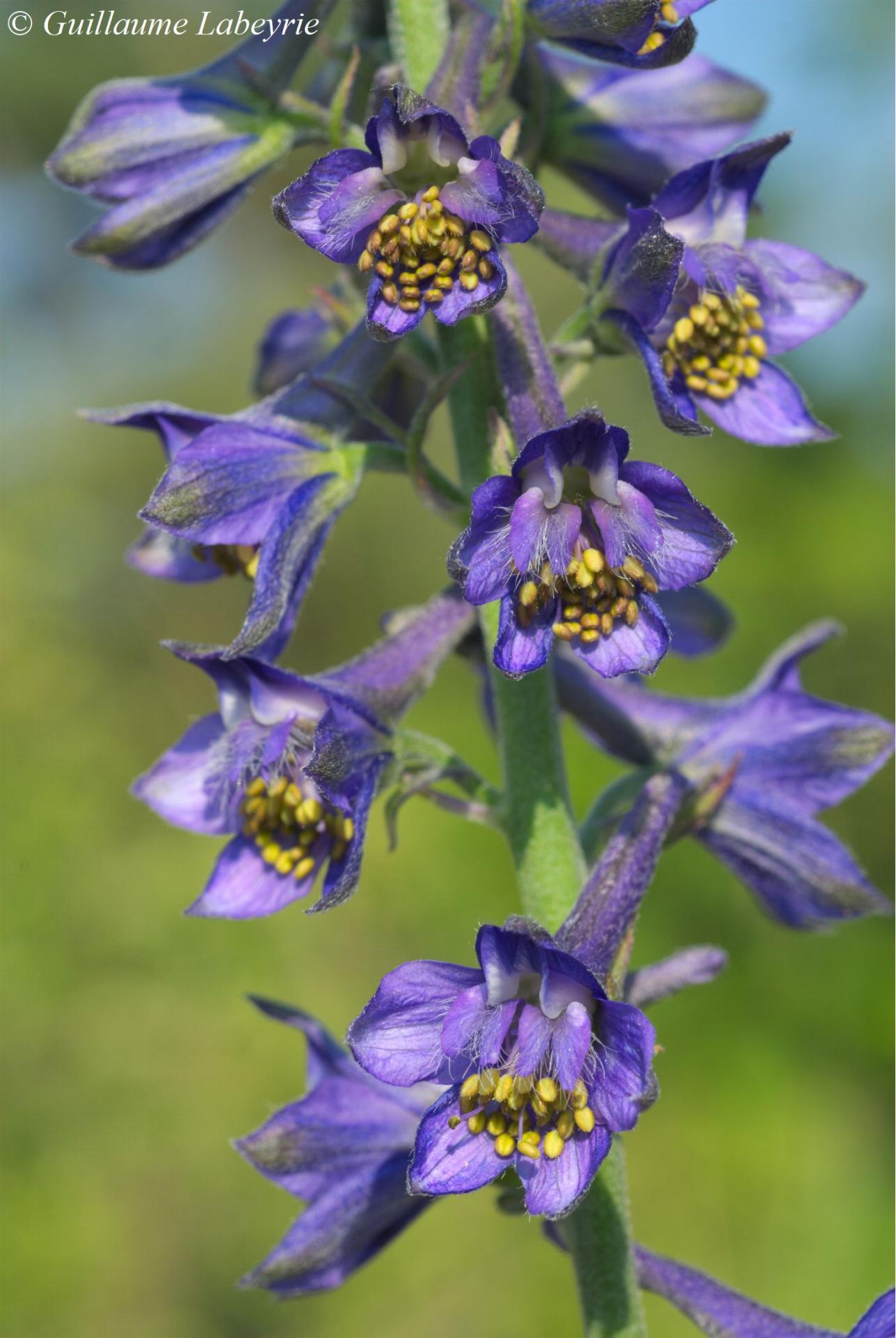 Delphinium fissum. This outstanding plant produces in June-July purple flowering spikes up to 1 m high. The broad leaves are soft and highly divided. This is a rare plant, occurring in rocky areas of south-eastern France. It is protected in the PACA region.
Delphinium fissum. This outstanding plant produces in June-July purple flowering spikes up to 1 m high. The broad leaves are soft and highly divided. This is a rare plant, occurring in rocky areas of south-eastern France. It is protected in the PACA region.
Family : Rosaceae
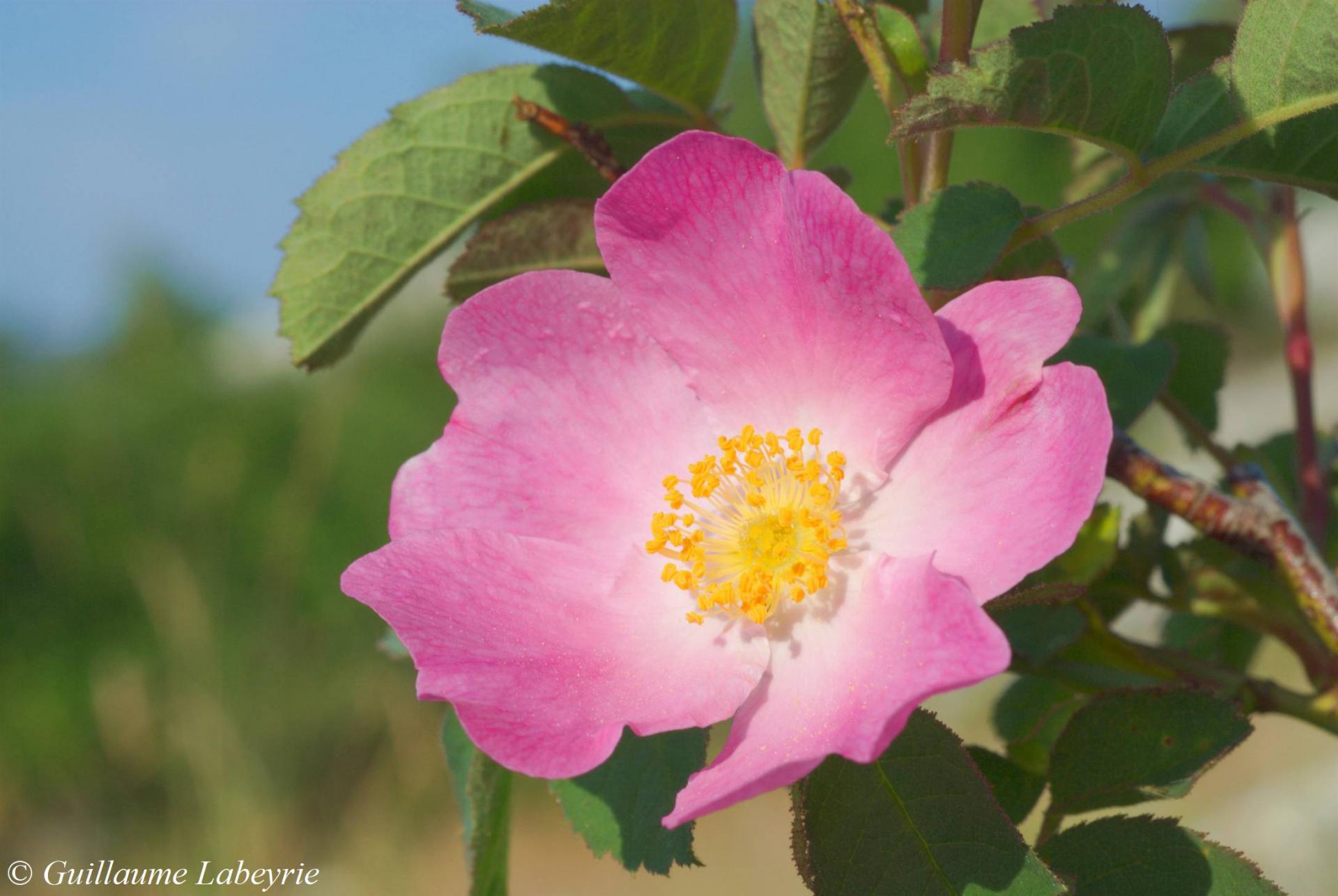 The red-leaved rose (Rosa ferruginea). Several rose species occur in the Préalpes de Grasse, but this is one of the prettiest. The flowers are of a deep pink, and the leaves a glaucous blue-green bordered with purple. This rose is native to central and southern Europe mountains.
The red-leaved rose (Rosa ferruginea). Several rose species occur in the Préalpes de Grasse, but this is one of the prettiest. The flowers are of a deep pink, and the leaves a glaucous blue-green bordered with purple. This rose is native to central and southern Europe mountains.
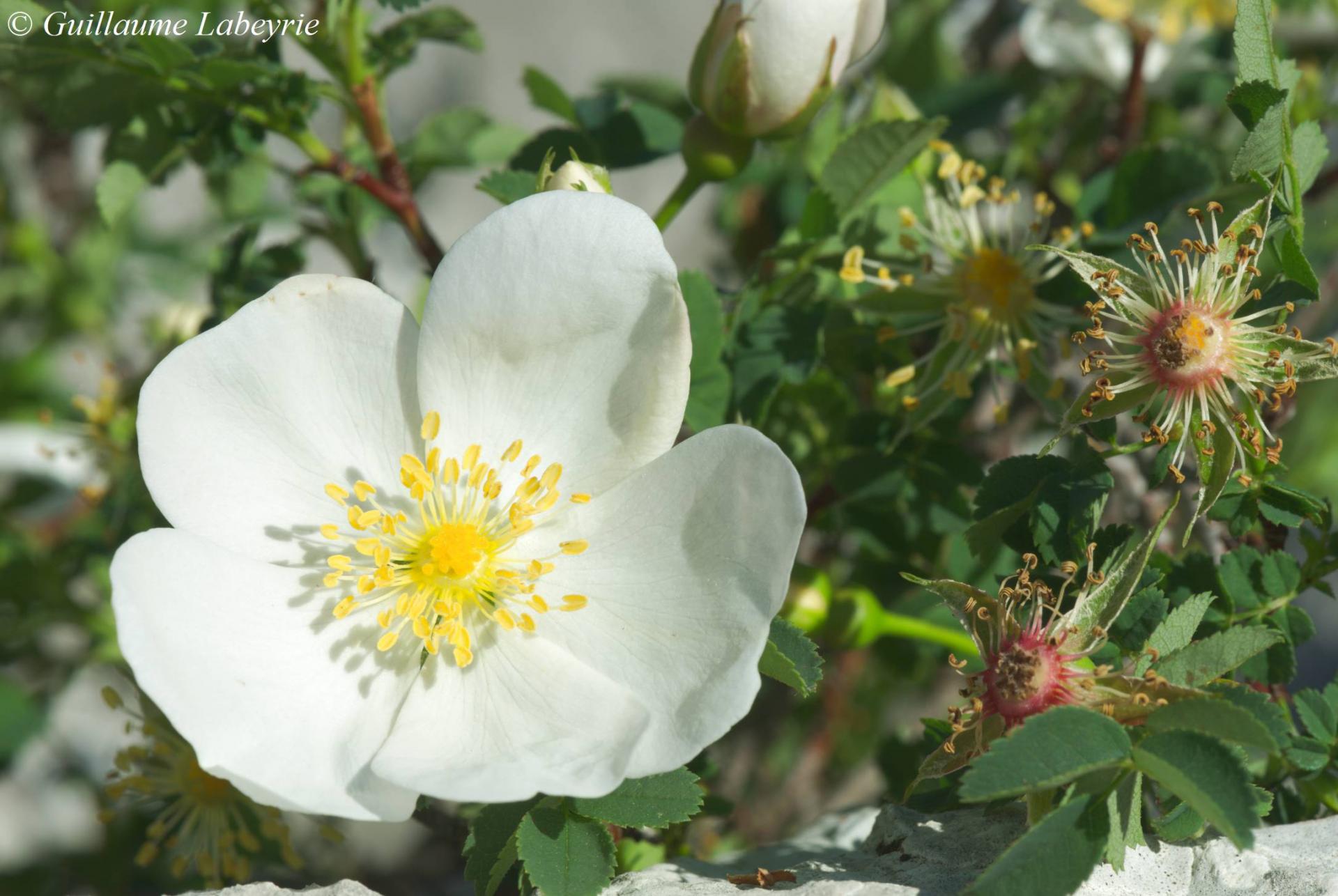 The burnet rose (Rosa spinosissima = R. pimpinellifolia). This other nice rose forms a low bush, with small white flowers and stems covered with straight prickles of different size. It often grows in the cracks of the lapiaz. This species occurs in western, central and southern Europe, and in northwest Africa.
The burnet rose (Rosa spinosissima = R. pimpinellifolia). This other nice rose forms a low bush, with small white flowers and stems covered with straight prickles of different size. It often grows in the cracks of the lapiaz. This species occurs in western, central and southern Europe, and in northwest Africa.
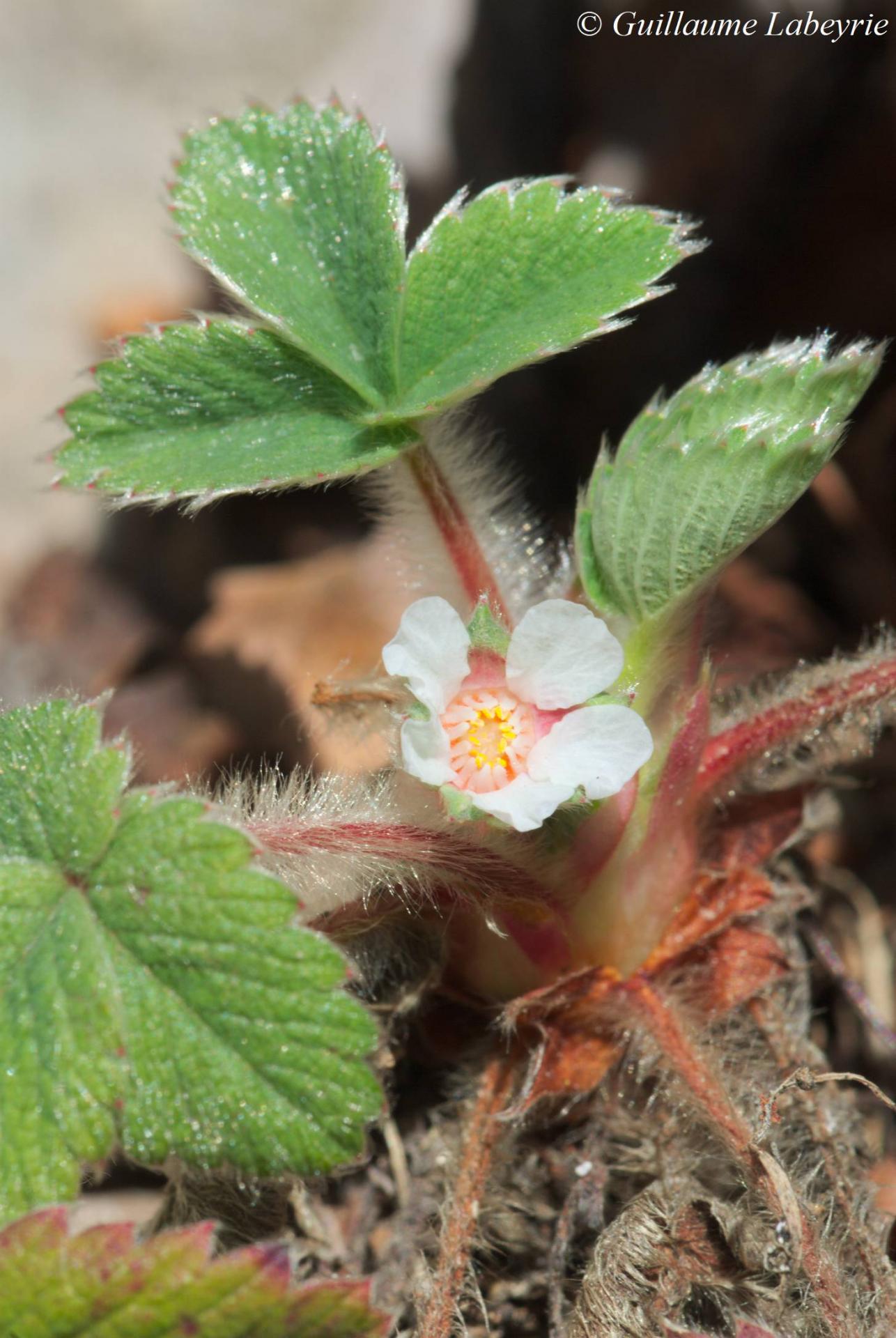 Potentilla micrantha. A member of the cinquefoils genus, this small plant has hairy leaves and small, often rosy flowers. It grows in dry woods of downy oaks, in low mountains. The flowers open in early spring. In France, this species is found in the southeastern half of the country.
Potentilla micrantha. A member of the cinquefoils genus, this small plant has hairy leaves and small, often rosy flowers. It grows in dry woods of downy oaks, in low mountains. The flowers open in early spring. In France, this species is found in the southeastern half of the country.
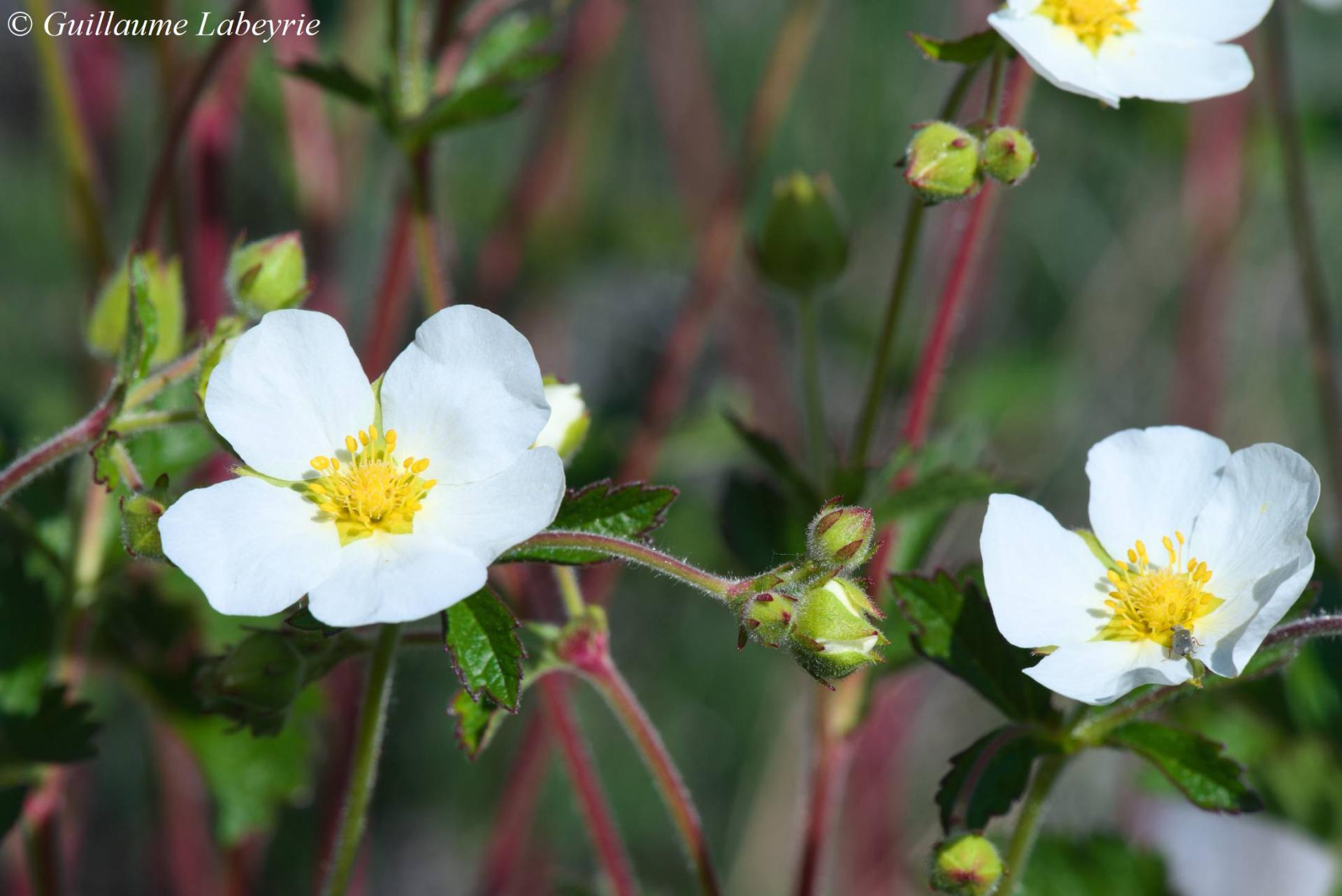
The rock cinquefoil (Drymocallis rupestris). With its tall red stems (up to 60 cm) and its many large white flowers, this cinquefoil does not go unnoticed. It seems rather scarce in the Grasse Prealps, where it occurs locally in the cracks of the lapiez. In France, this beautiful species is mainly present in a south-eastern quarter, as well as in the Pyrenees.
Family : Thymelaeaceae
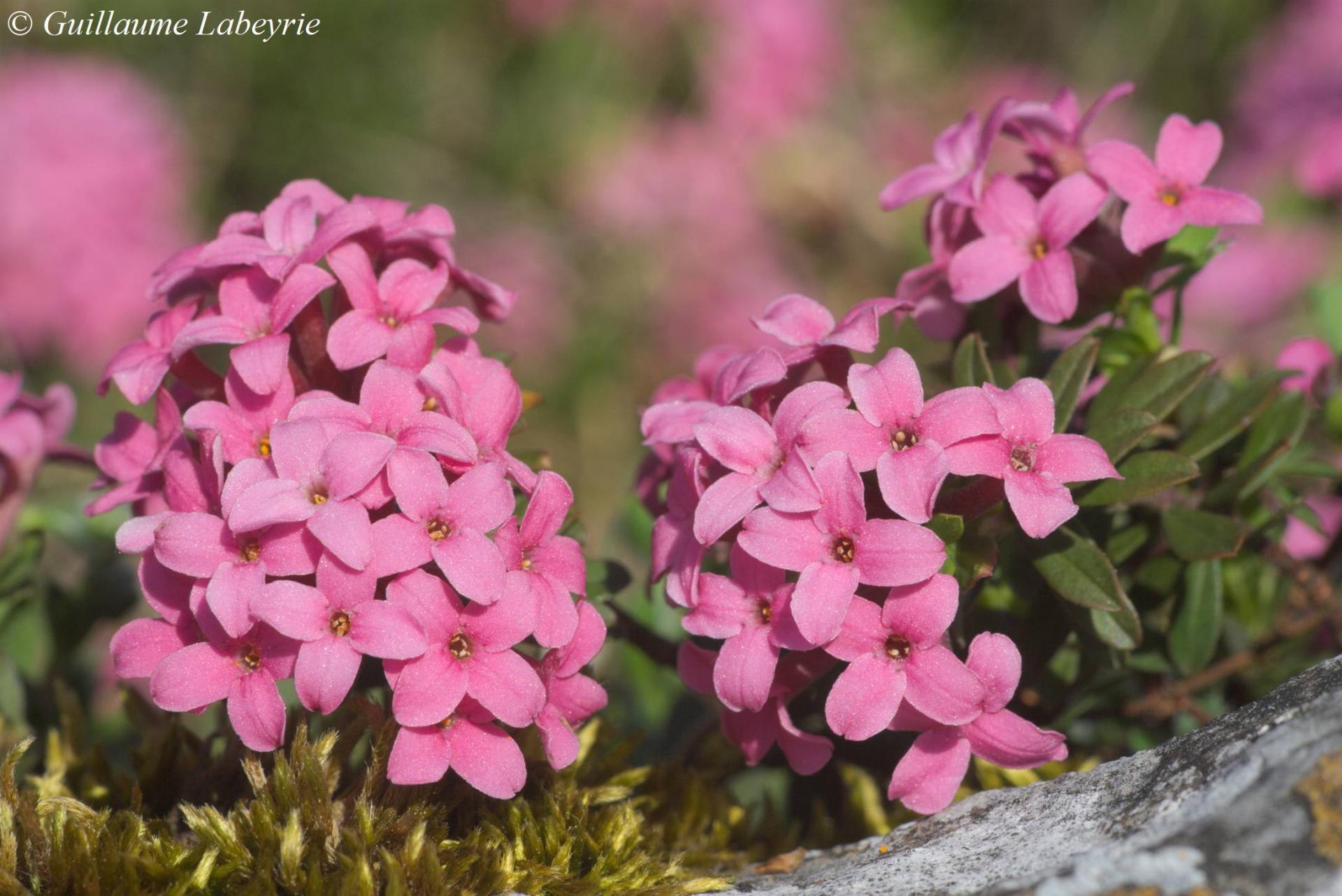 The rose daphne (Daphne cneorum). This small prostrate plant grows beautiful and dense clusters of pink, sweetly-scented flowers. It is found during spring in clearings of Scots pine, in low mountains. It is quite similar to Daphne striata, an alpine species much scarcer in our region, which lacks hairs on its leaves. The rose daphne occurs in central and meridional Europe.
The rose daphne (Daphne cneorum). This small prostrate plant grows beautiful and dense clusters of pink, sweetly-scented flowers. It is found during spring in clearings of Scots pine, in low mountains. It is quite similar to Daphne striata, an alpine species much scarcer in our region, which lacks hairs on its leaves. The rose daphne occurs in central and meridional Europe.
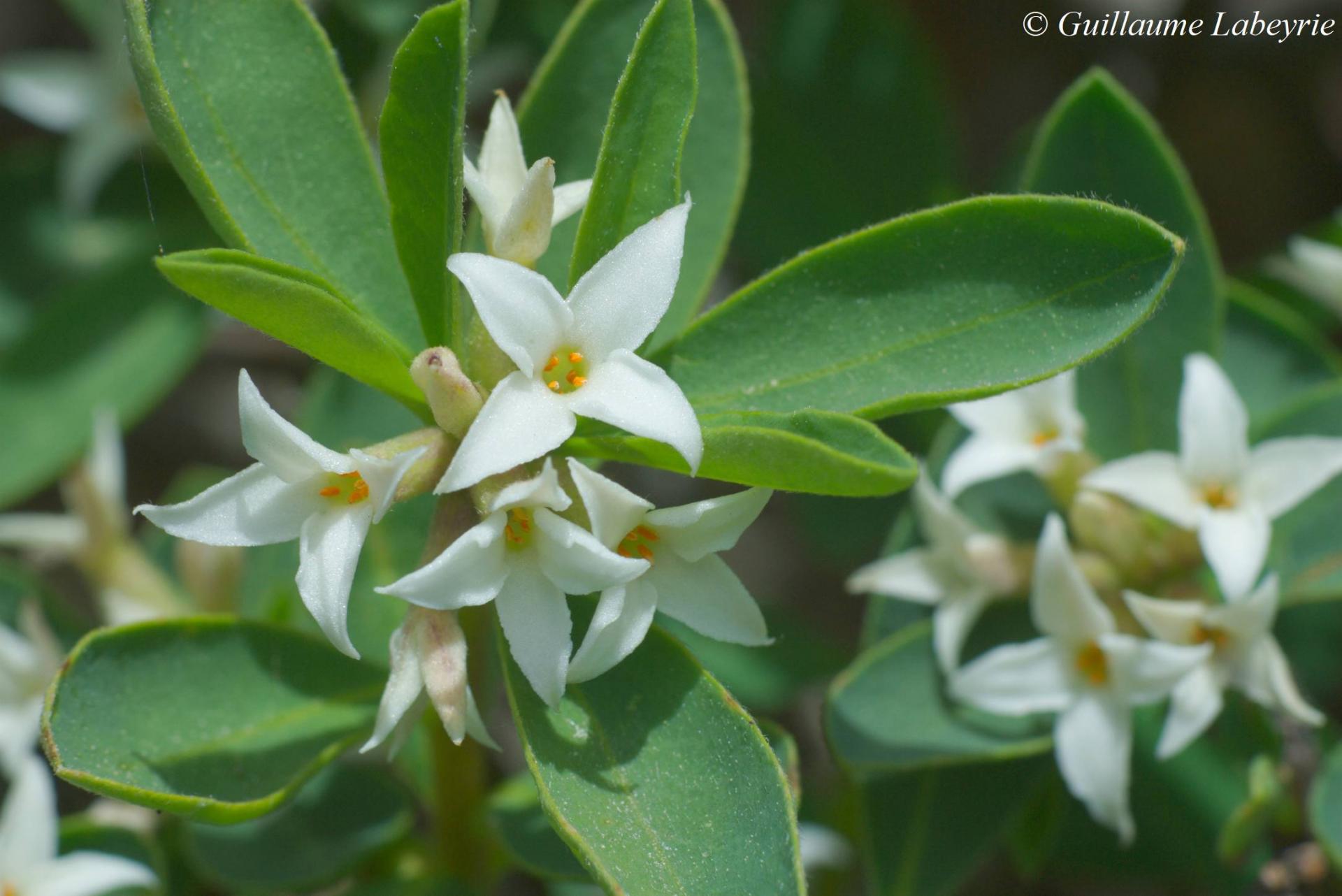 The alpine daphne (Daphne alpina). This plant forms small bushes that covers with fragrant whites flowers in May-June. In the Préalpes de Grasse, it grows mainly in cracks and holes of karstic slabs. Originating from central Europe, this species is found in France only in the south-east.
The alpine daphne (Daphne alpina). This plant forms small bushes that covers with fragrant whites flowers in May-June. In the Préalpes de Grasse, it grows mainly in cracks and holes of karstic slabs. Originating from central Europe, this species is found in France only in the south-east.
Fungi and lichens
Lichens
Family : Parmeliaceae
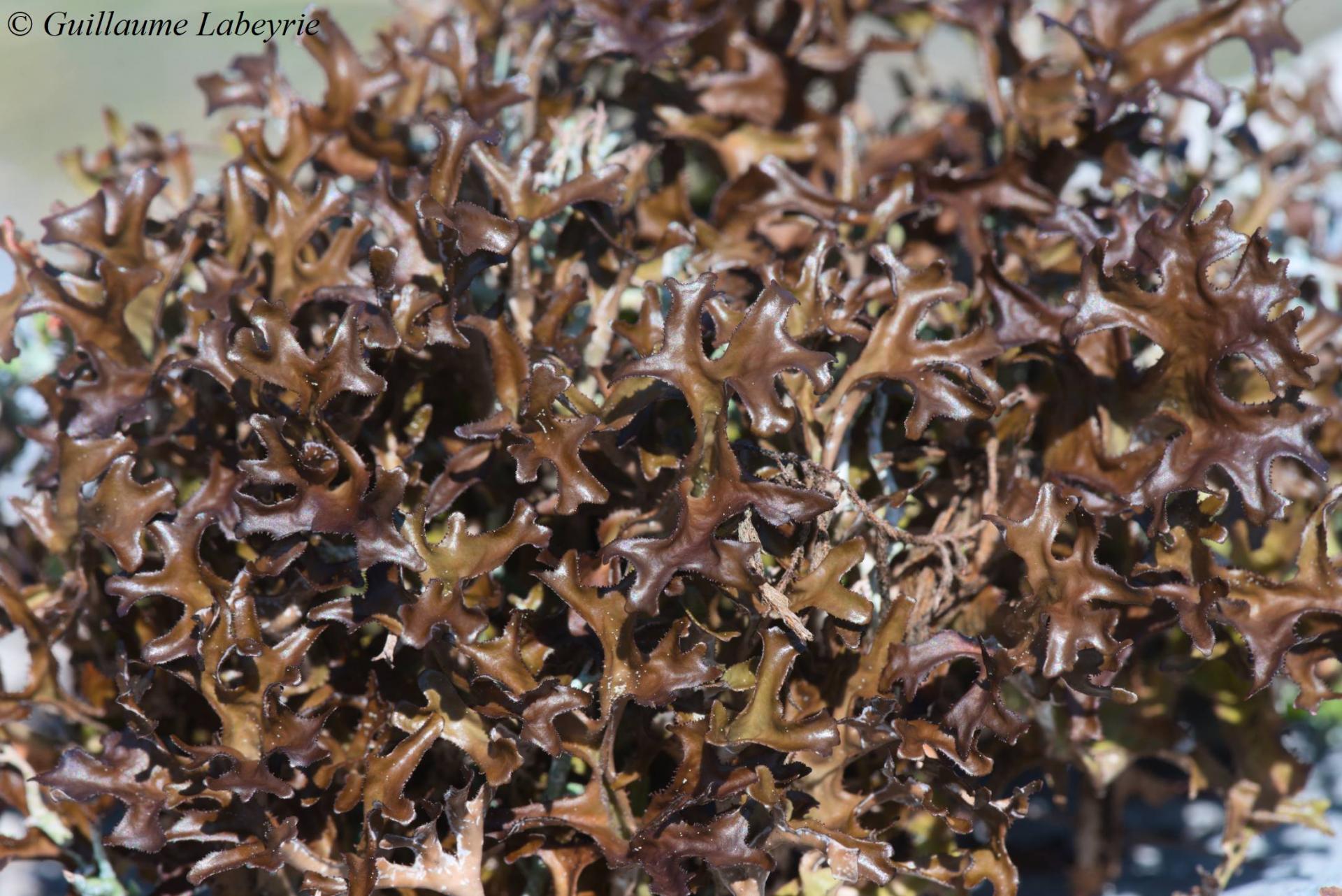
The Iceland moss (Cetraria islandica). This lichen from cold regions forms tufts of around ten cm in diameter with a characteristic frizzy appearance. The dry thallus, as in this photo, evokes leather by its color and texture. It turns green when wet. This lichen was used in human food and to treat sore throats. This mountain species is present locally in the Prealps, on the shaded slopes of dolines.
Family : Peltigeraceae
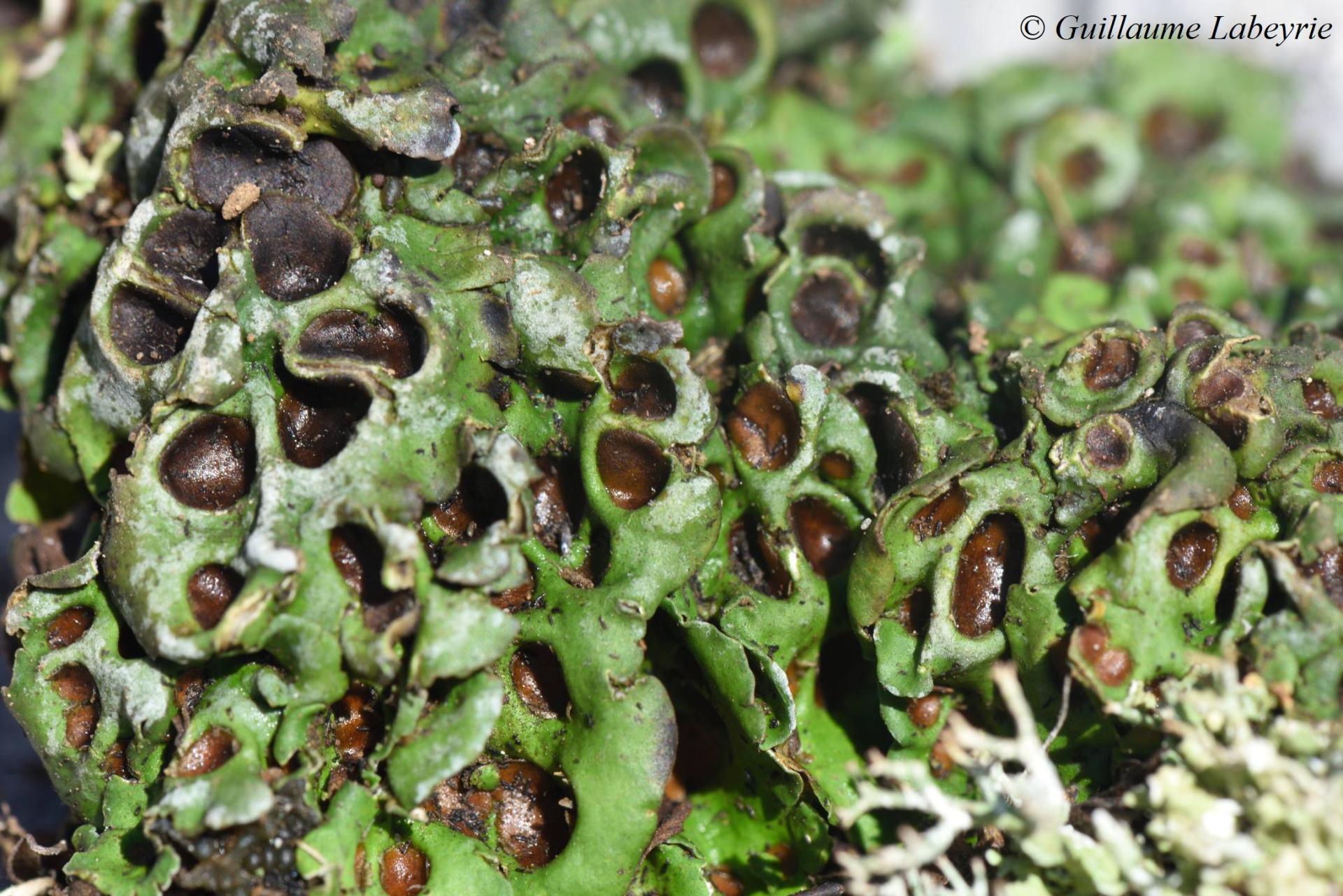
The chocolate chip lichen (Solorina saccata). This lichen is very characteristic with its bright green thallus and brown apothecia. It shelters in the shaded cracks of limestone blocks. A species of cold regions, it is found throughout Europe, Russia and North America, including Canada and Greenland.
Family : Rhizocarpaceae
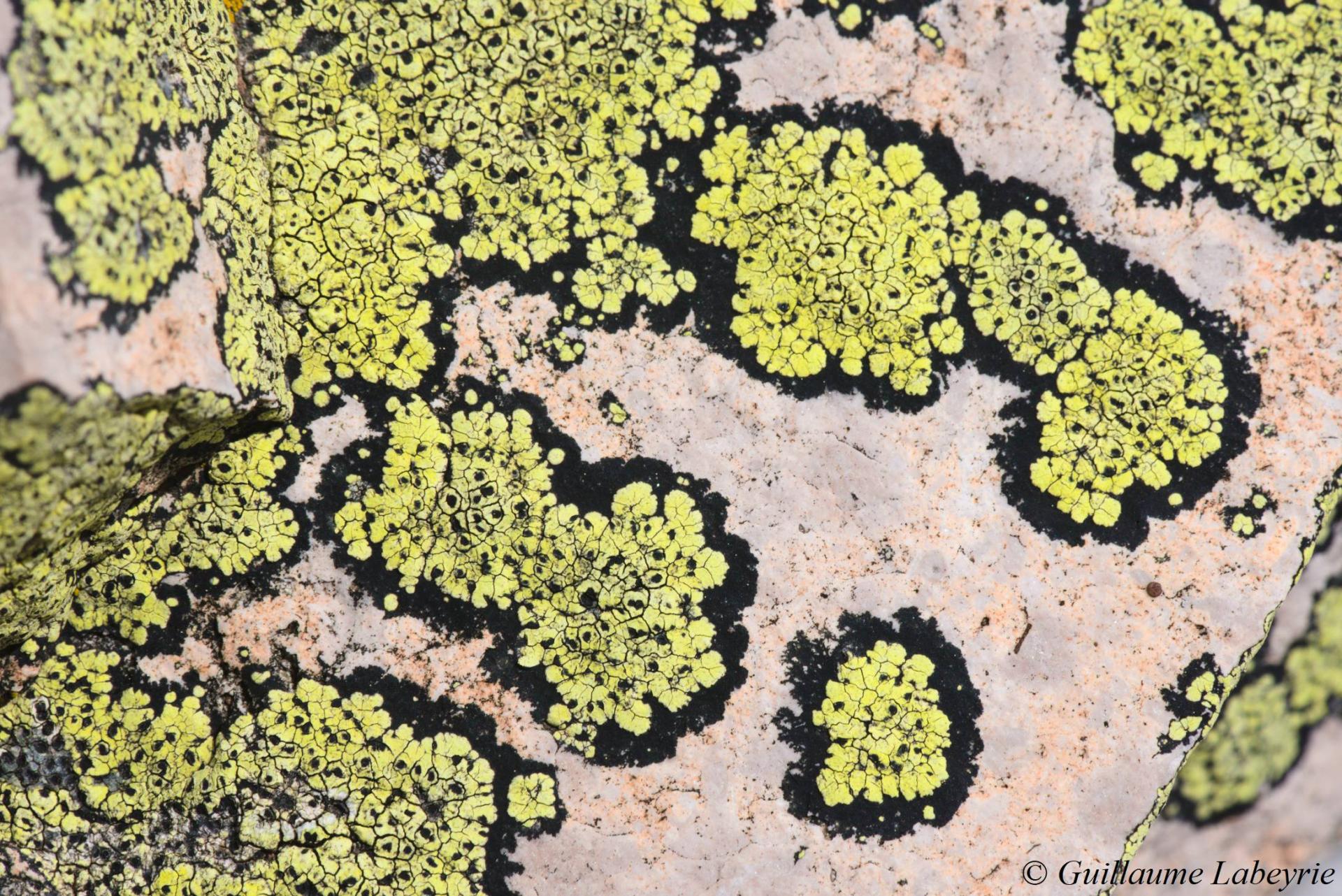
Rhizocarpon lecanorinum. This lichen is very characteristic, with its mosaic of yellow cells on a black background. It is distinguished from the very common Rhizocarpon geographicum by the areoles surrounding the apothecia. Fairly widespread in France, it frequents siliceous rocks from sea level to high mountains. In the karst, it is only found on flint.
Family : Squamarinaceae
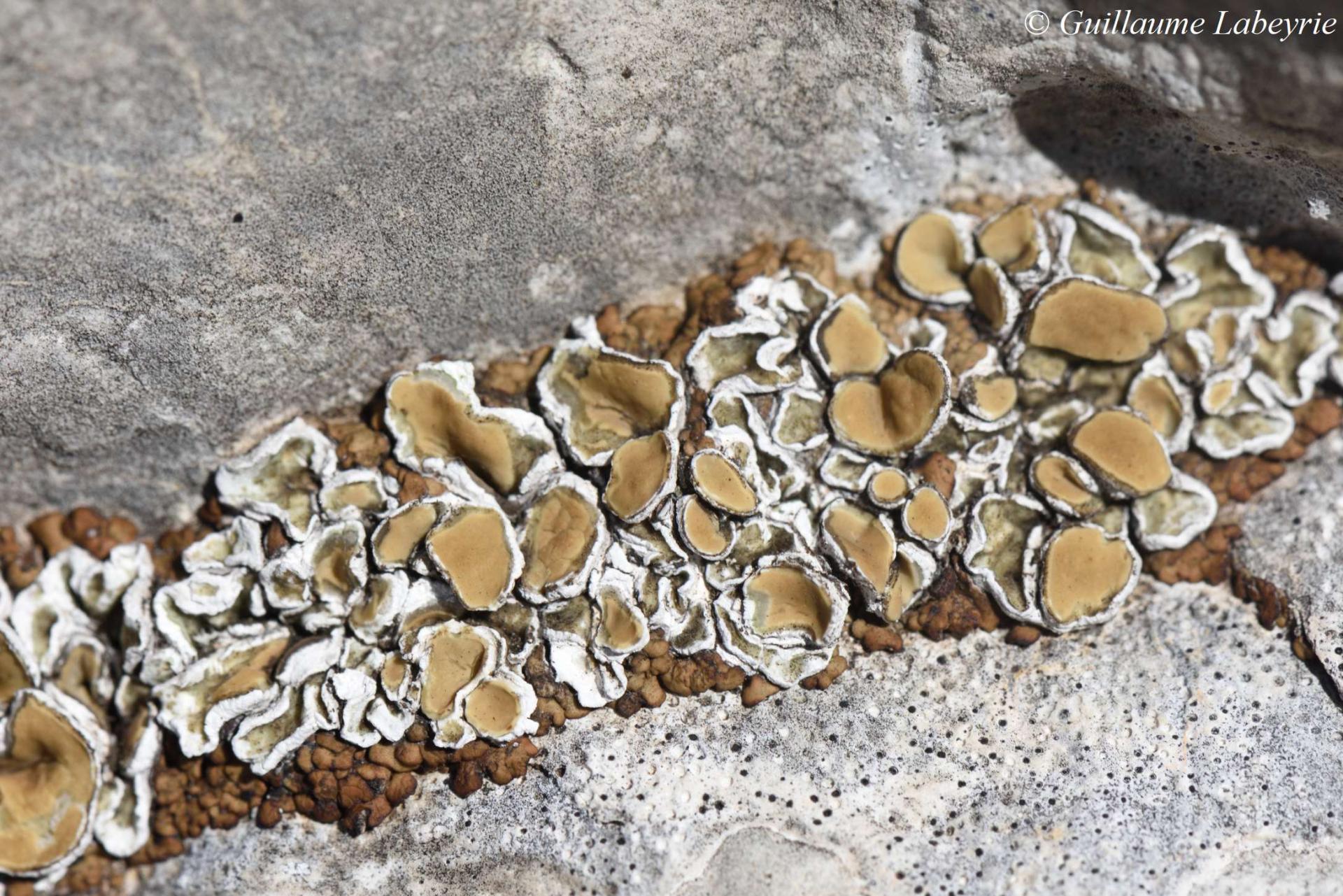
Squamarina gypsacea. This species is found in cracks in limestone blocks. The circular ocher-greenish scales are characteristic. Squamarina gypsacea often grows as a parasite on Romjularia lurida, dark brown in this photo. It is found in France in a southeastern third.
Family : Teloschistaceae
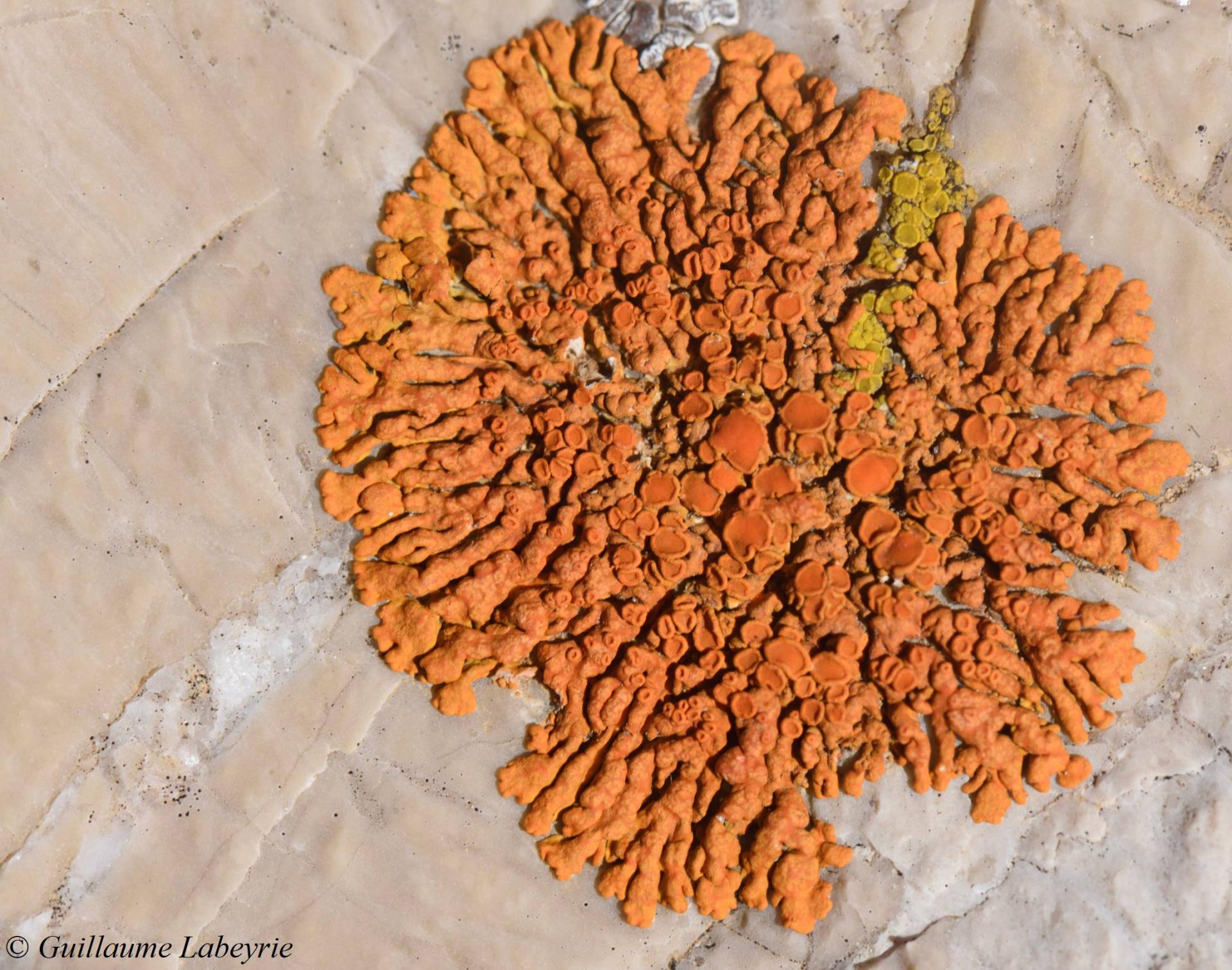
The elegant sunburst lichen (Rusavskia elegans). This pretty lichen is distinguished by its bright orange rosettes with elongated peripheral lobes. It is generally found in small colonies on top of rocks, where it can benefit from bird droppings. This lichen is present in the mountainous areas of most of France.
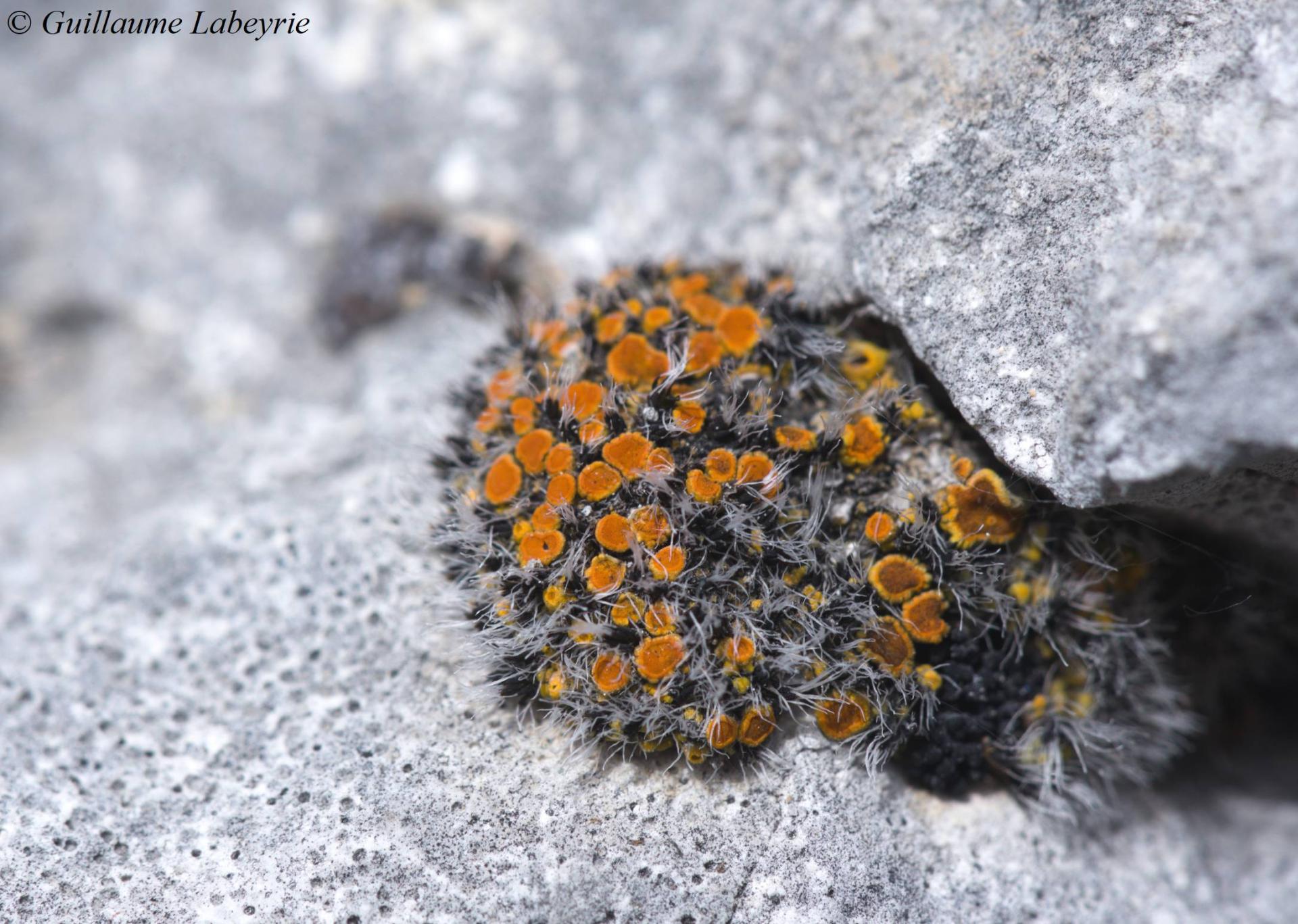
Calogaya schistidii. This tiny lichen only grows on certain mosses colonizing the cracks of limestone rocks (here Grimmia tergestina). It is observed in France in a southeastern third.
Family : Verrucariaceae
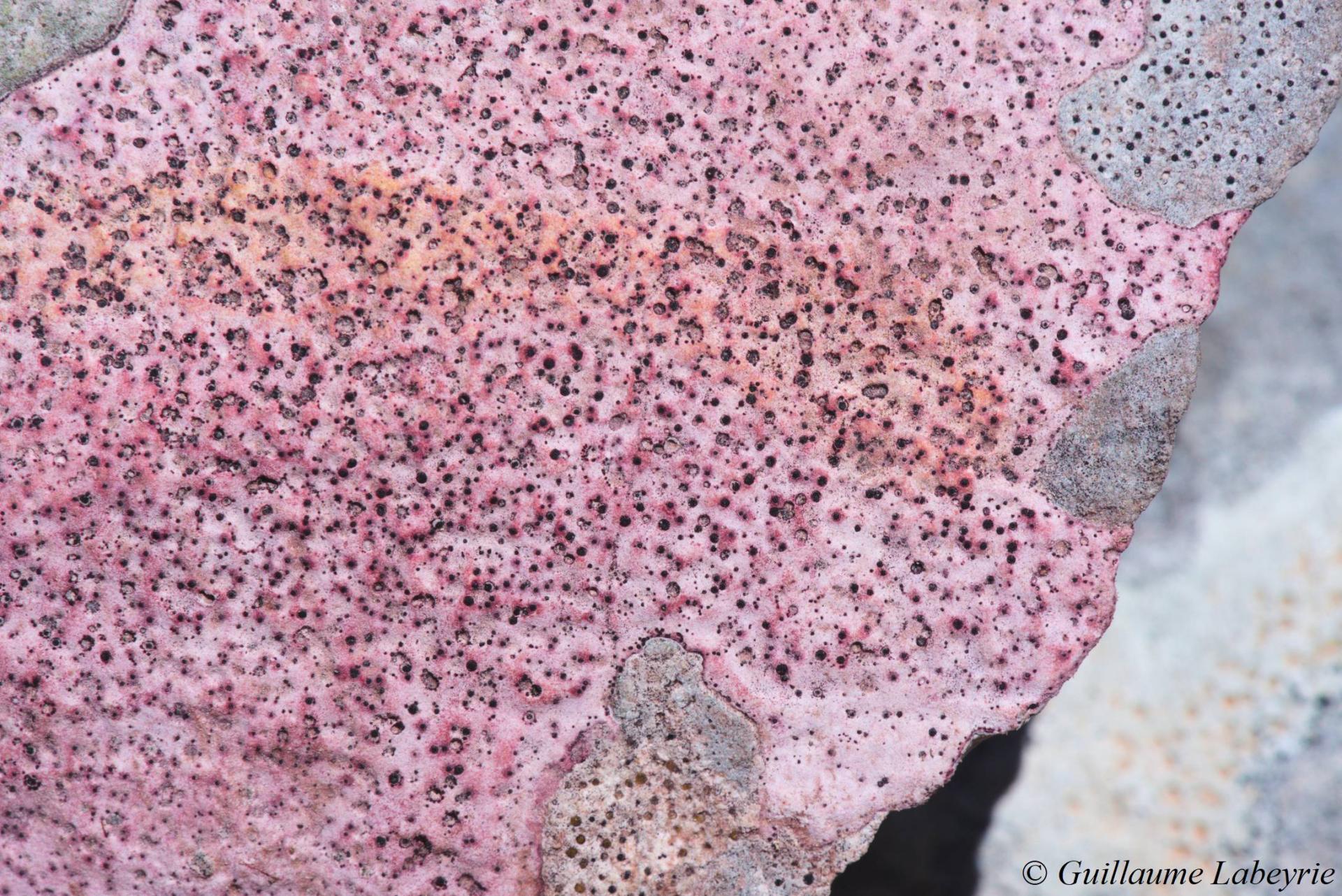
Bagliettoa marmorea. This pink lichen is common on calcareous stones exposed to sunlight. The circular holes that are visible on this photo are left by perithecia, organs used by the lichen for sexual reproduction.

Placocarpus schaereri. This lichen forms gray patches with a cracked appearance. It is found on well-exposed limestone blocks, in the southern half of France.
Fauna
Amphibians
Family : Pelodytidae
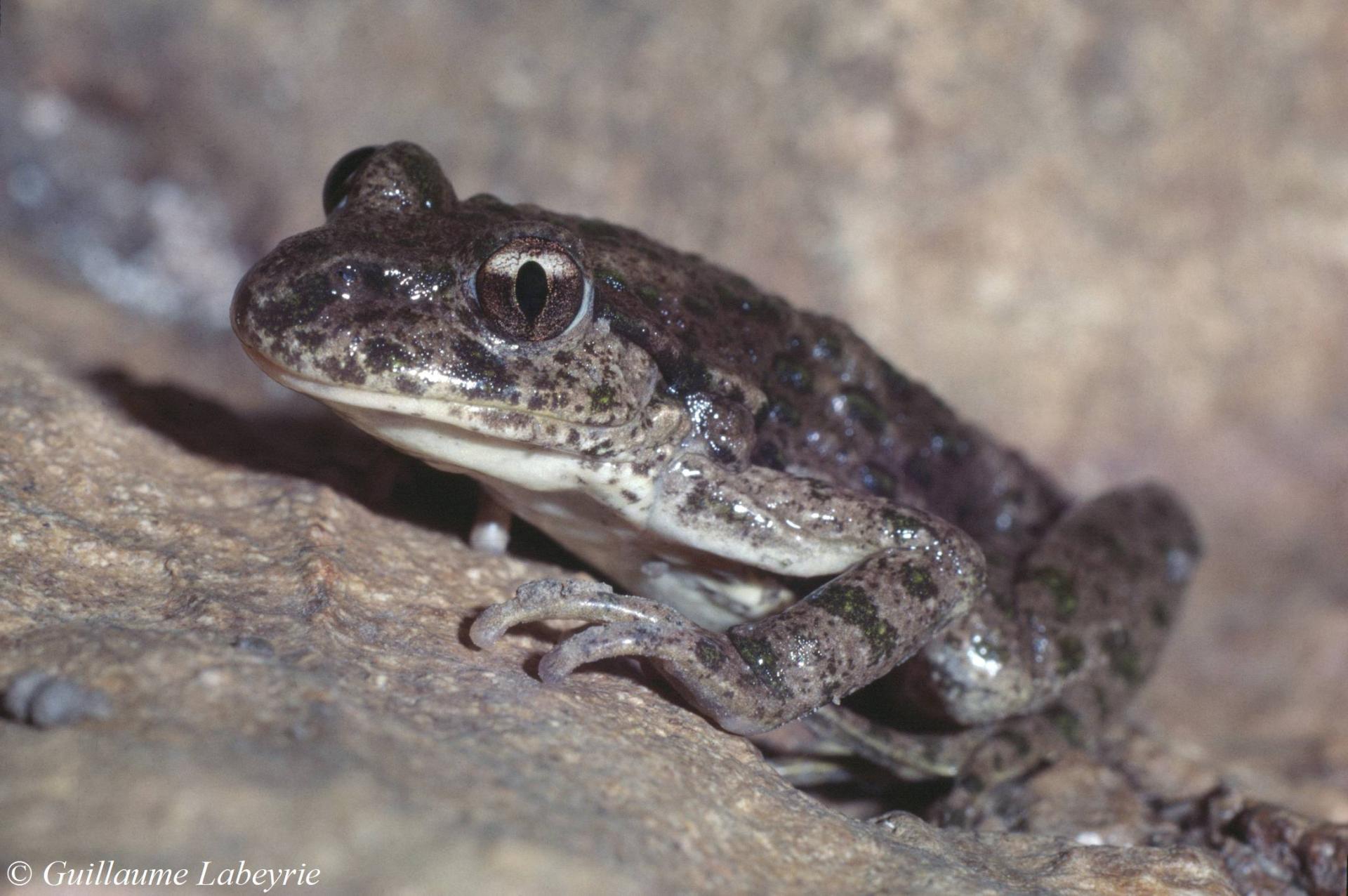
The common parsley frog (Pelodytes punctatus). This small toad is restricted to southwestern Europe: Italy, France and the Iberian peninsula. It is capable of surviving in dry habitats such as the calcareous plateaus by exploiting the cavities and caves (as in this photo) under the surface of the karst. The common parsley frog is protected in France.
Grasshoppers (Orthoptera)
Family : Raphidophoridae
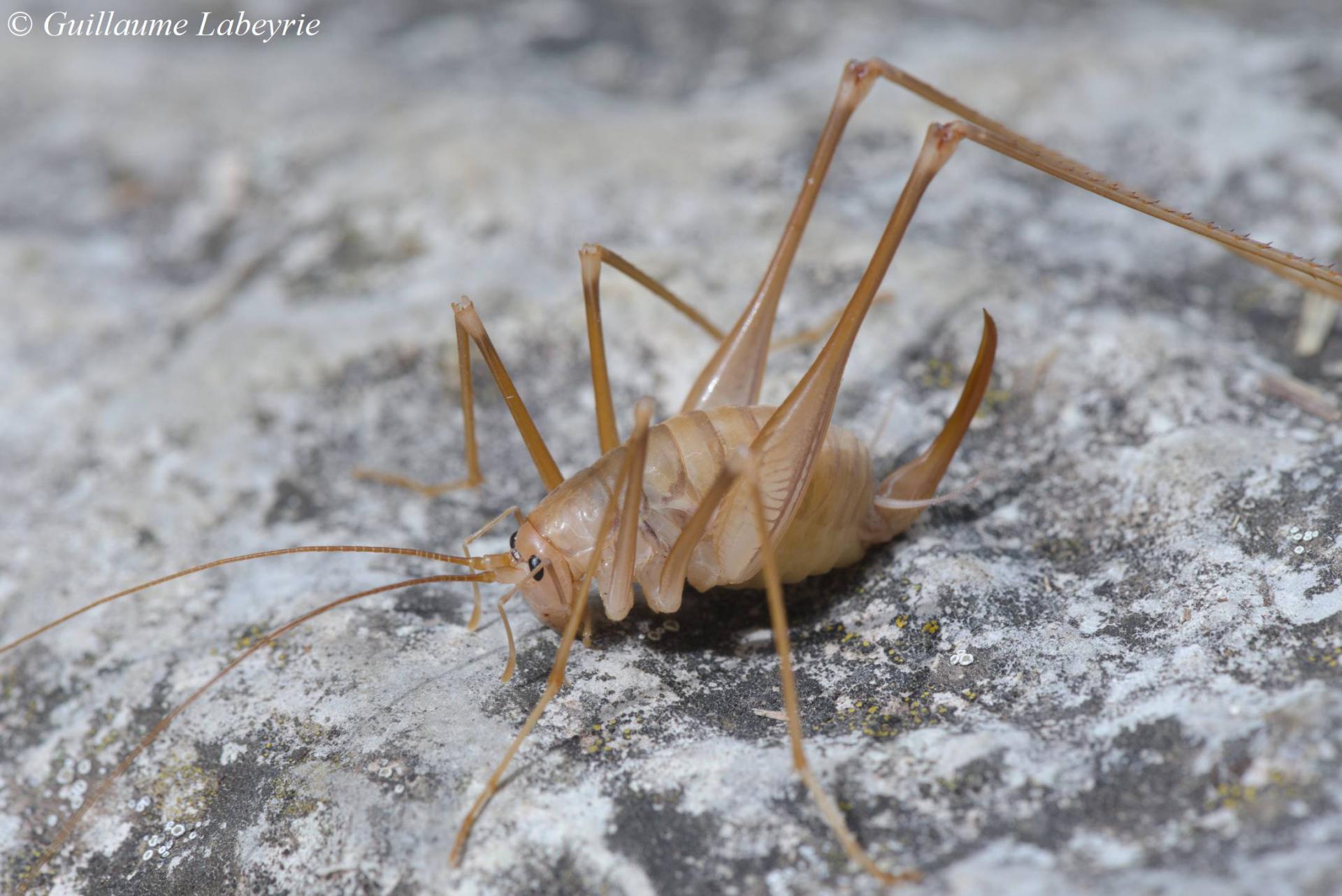
Cave cricket (Dolichopoda azami subsp. azami). This strange grasshopper with very long legs and antennae leaves in cavities, either natural or artificial (such as house basements). It is found in the southern Alps and in Liguria. Four other Dolichopoda species occur in France, two of which are endemic to Corsica and one to the valley of the Tinée.
Butterflies and Moths (Lepidoptera)
Family : Hesperiidae
 The southern grizzled skipper (Pyrgus malvoides). The members of this family are fast flying little butterflies with a thick hairy body. Several species occur in southern France, whose identification is often delicate. Pyrgus malvoides and Pyrgus malvae are almost identical (possibly forming a single species), the former found in the southern half of France and the latter in the northern half. The series of diffuse spots near the wing margins, and the clear white spot with a "tooth" shape on the hindwings are typical. This butterfly starts flying in early spring.
The southern grizzled skipper (Pyrgus malvoides). The members of this family are fast flying little butterflies with a thick hairy body. Several species occur in southern France, whose identification is often delicate. Pyrgus malvoides and Pyrgus malvae are almost identical (possibly forming a single species), the former found in the southern half of France and the latter in the northern half. The series of diffuse spots near the wing margins, and the clear white spot with a "tooth" shape on the hindwings are typical. This butterfly starts flying in early spring.
Family : Lycaenidae
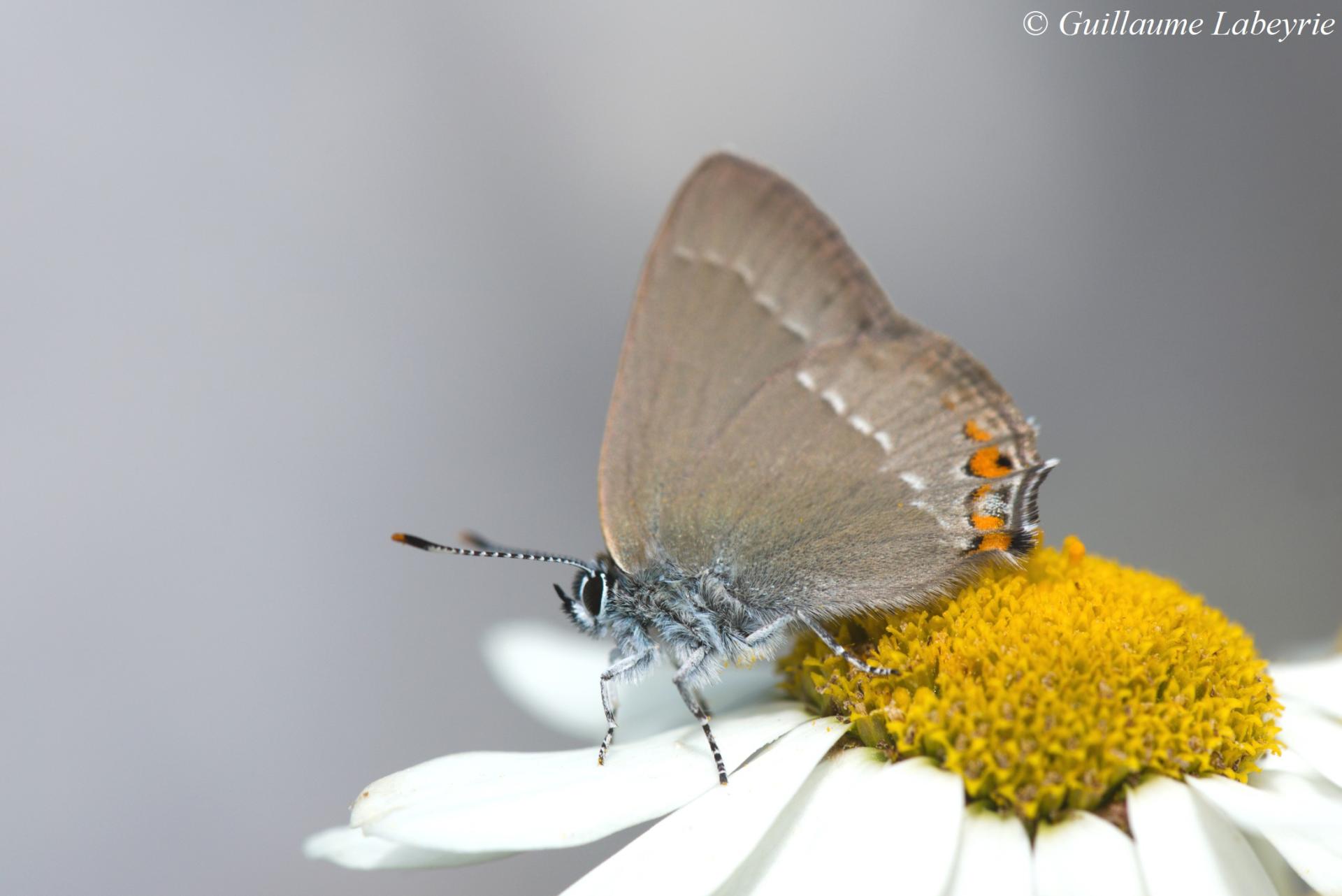
The sloe hairstreak (Satyrium acaciae). This species reproduces on the blackthorn (Prunus spinosa), a common plant in the lapiaz. It is identified by the grayish spot and the orange lunules on the edge of the hindwing. In France, it is found mostly in the eastern half of the country.
Family : Papilionidae
 The southern Festoon (Zerynthia polyxena). The southern Festoon inhabits southern Europe up to Asia Minor. In southeastern France, it typically inhabits warm valleys with a river where grows Aristolochia rotunda, its host plant. However, in the Préalpes de Grasse, the southern Festoon also occurs in the much dryer habitat of the calcareous plateaus (as on this photo), where it then feeds on Aristolochia pallida. The southern Festoon is fully protected in France.
The southern Festoon (Zerynthia polyxena). The southern Festoon inhabits southern Europe up to Asia Minor. In southeastern France, it typically inhabits warm valleys with a river where grows Aristolochia rotunda, its host plant. However, in the Préalpes de Grasse, the southern Festoon also occurs in the much dryer habitat of the calcareous plateaus (as on this photo), where it then feeds on Aristolochia pallida. The southern Festoon is fully protected in France.
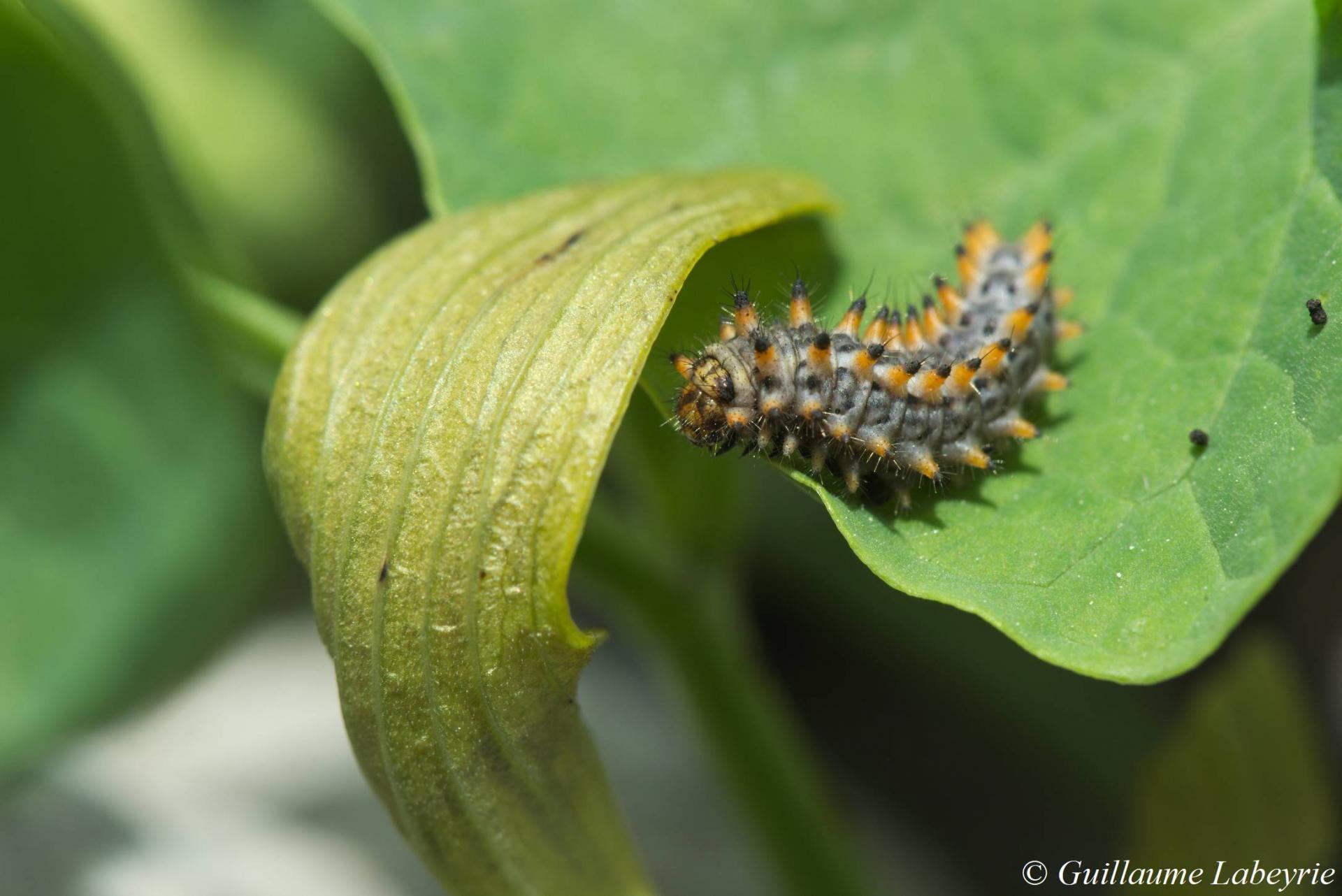 Caterpillar of southern Festoon on Aristolochia pallida.
Caterpillar of southern Festoon on Aristolochia pallida.
Family : Riodinidae
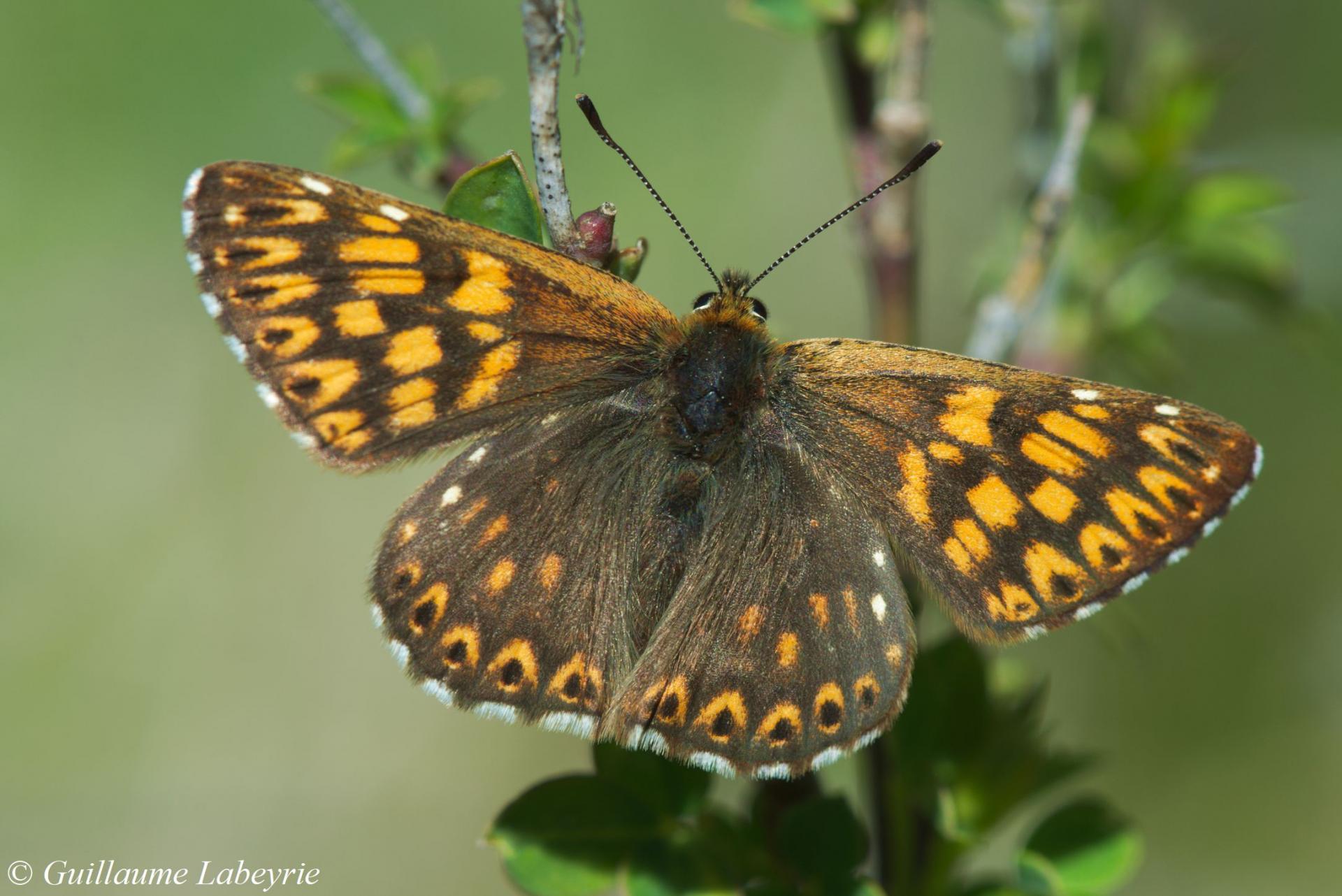 The duke of Burgundy (Hamearis lucina). Only member of its family in Europe, this fast-flying small butterfly is found in clearings of the karst, in May-June. The male is highly territorial, and attacks other intruding butterflies. The caterpillars feed on primroses. This butterfly is present in Europe up to the Ural. In France, is occurs in most of the territory.
The duke of Burgundy (Hamearis lucina). Only member of its family in Europe, this fast-flying small butterfly is found in clearings of the karst, in May-June. The male is highly territorial, and attacks other intruding butterflies. The caterpillars feed on primroses. This butterfly is present in Europe up to the Ural. In France, is occurs in most of the territory.
Family : Lasiocampidae
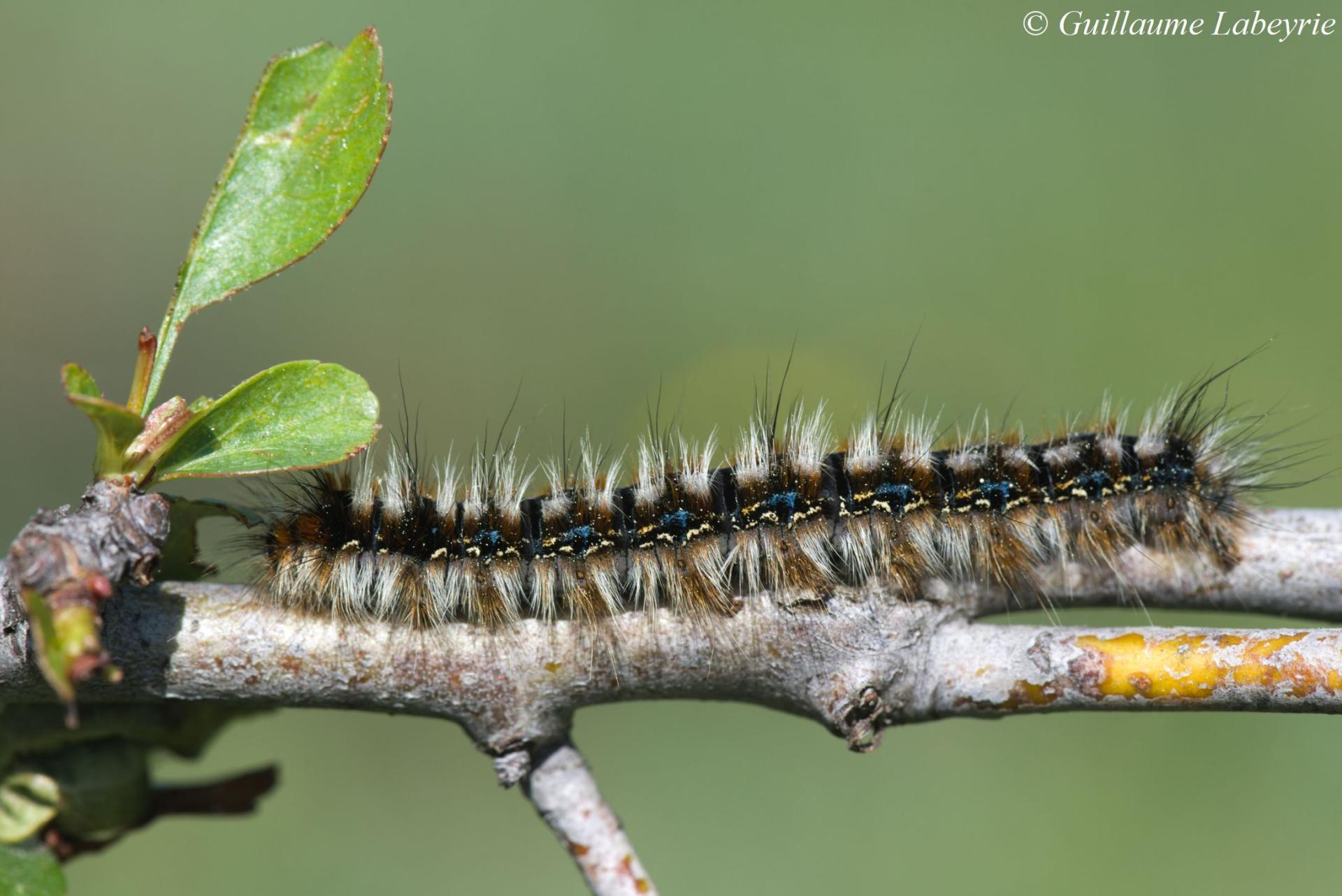
The eastern eggar (Eriogaster catax). The caterpillar of this moth has a distinctive pattern of blue and white spots on the flanks. It feeds on blackthorn and hawthorn. In France, where it is protected, this species mainly occurs in the southern half.
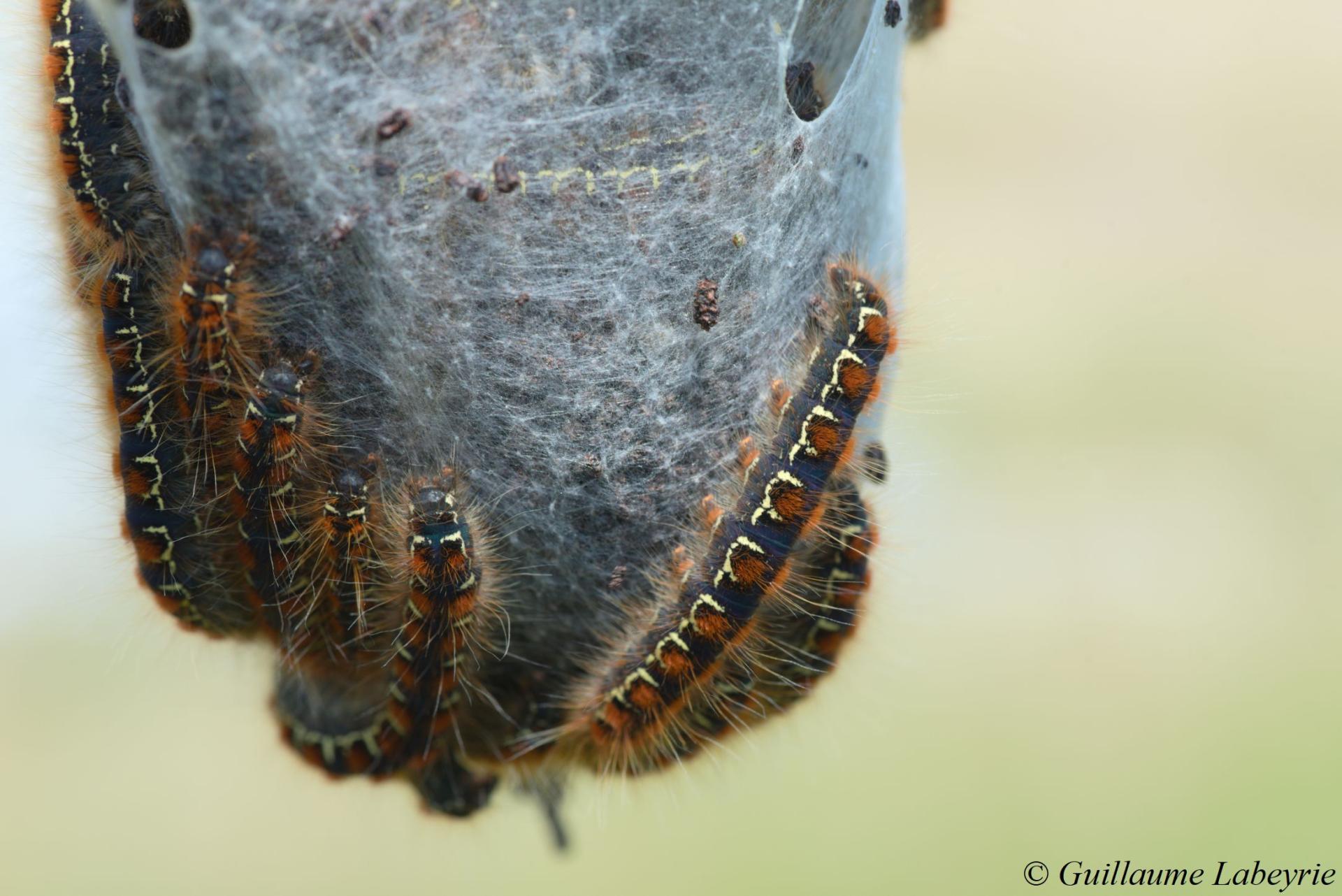
The small eggar (Eriogaster lanestris). The caterpillar of this other Eriogaster shows distinctive u-shaped white markings. It also feeds on blackthorn and hawthorn, on which this nest was photographed. It is present everywhere in France.
Beetles (Coleoptera)
Family : Curculionidae
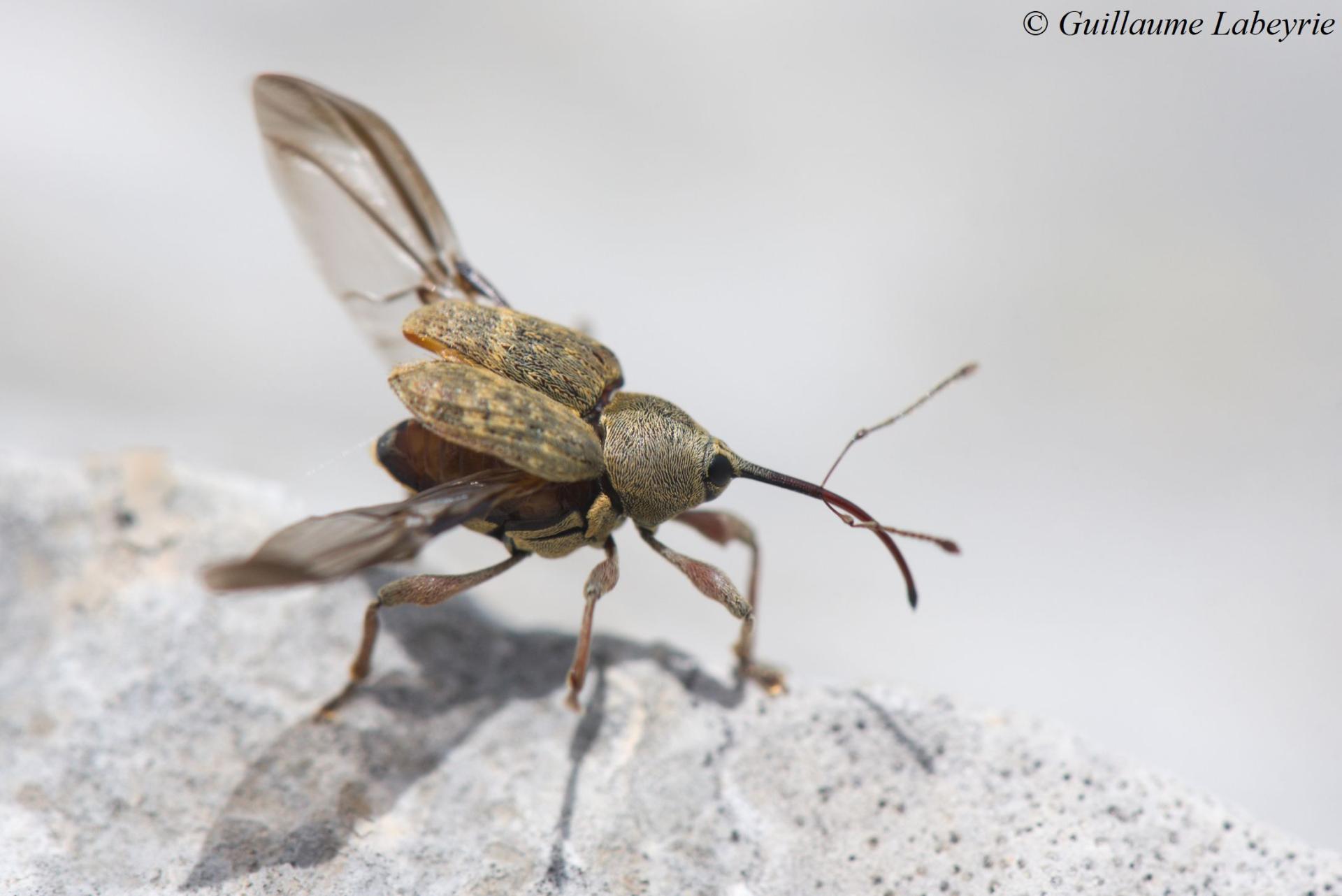
The nut weevil (Curculio nucum). This weevil has a very long and thin rostrum. The adults and larvae feed on various parts of the hazel tree (Corylus avellana), and can cause serious damage to crops. In the Grasse Prealps, this species lives on the wild hazelnut trees which populate the karst.
Arachnids
Family : Araneidae
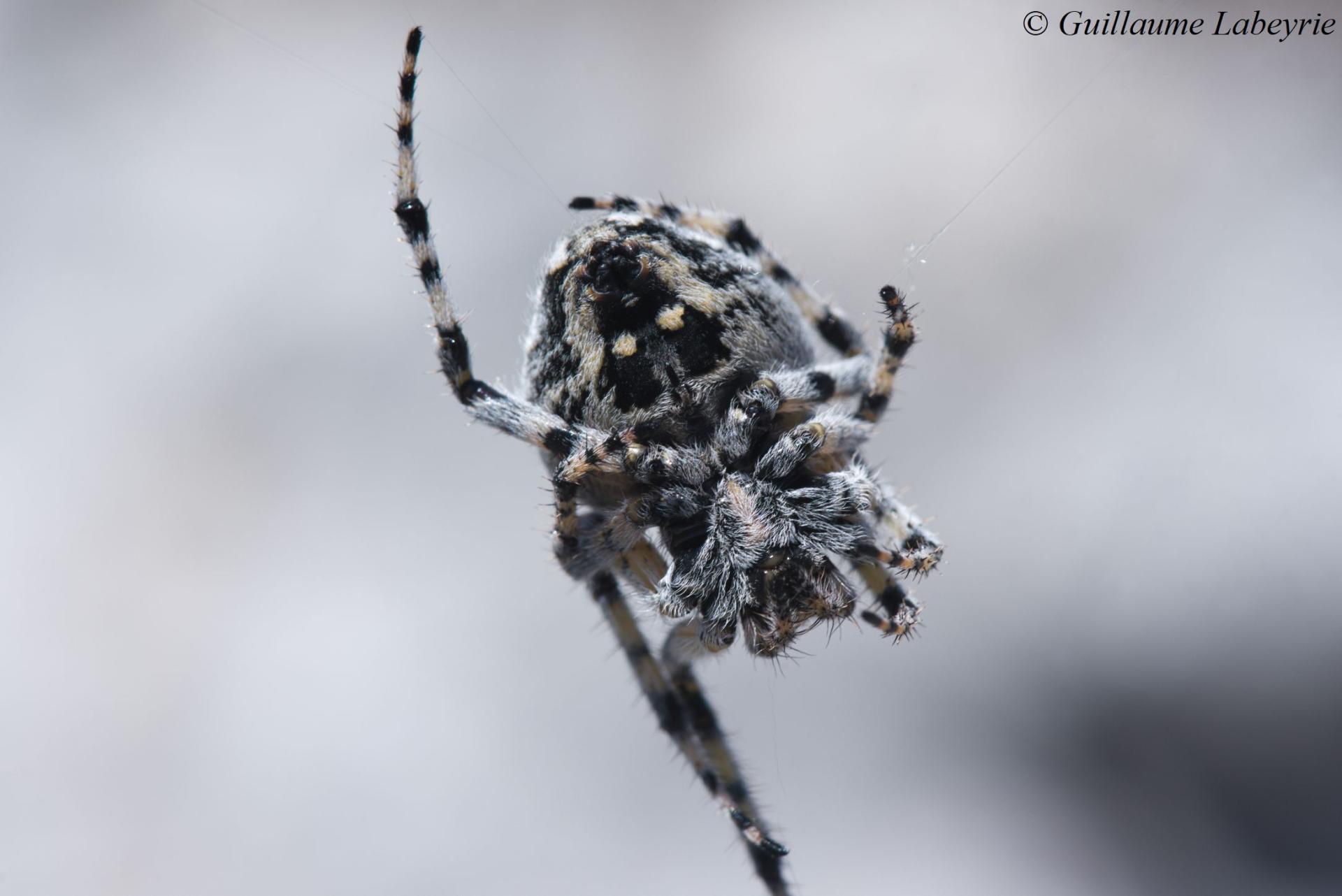
Araneus circe. This relatively large spider has a massive abdomen, generally whitish gray on top, with 2 tubercles. It differs from the similar A. angulatus in the ornamentation of the underside: the sternum is dark with a light central band, and the abdomen near the spinnerets has a black area with 2 white lines. This spider is generally found in cracks in the lapiaz or under rocky overhangs, where it weaves a large web. Rare in France, this Mediterranean species is observed mostly in the South-East.
Family : Gnaphosidae

Poecilochroa variana. This small spider has an unusual and spectacular color pattern. It is present in Western and Northern Europe.
Family : Phalangiidae
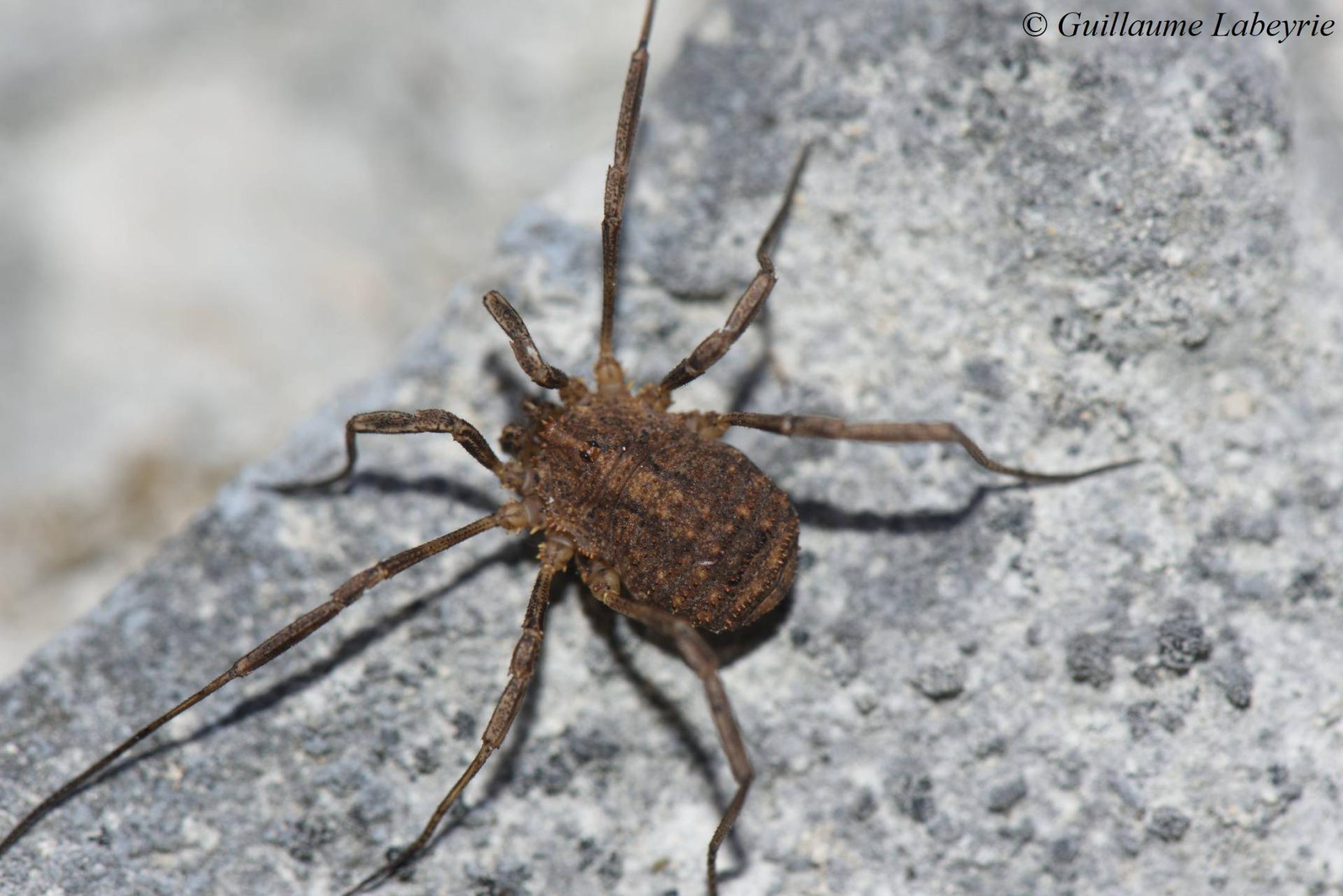
Odiellus spinosus. This species is part of the harvestmen, arachnids without venom or silk. The genus Odiellus has short legs and a spiny body. It includes several species that are quite difficult to identify. Odiellus spinosus is present in Central Europe and a large part of France.
Family : Thomisidae
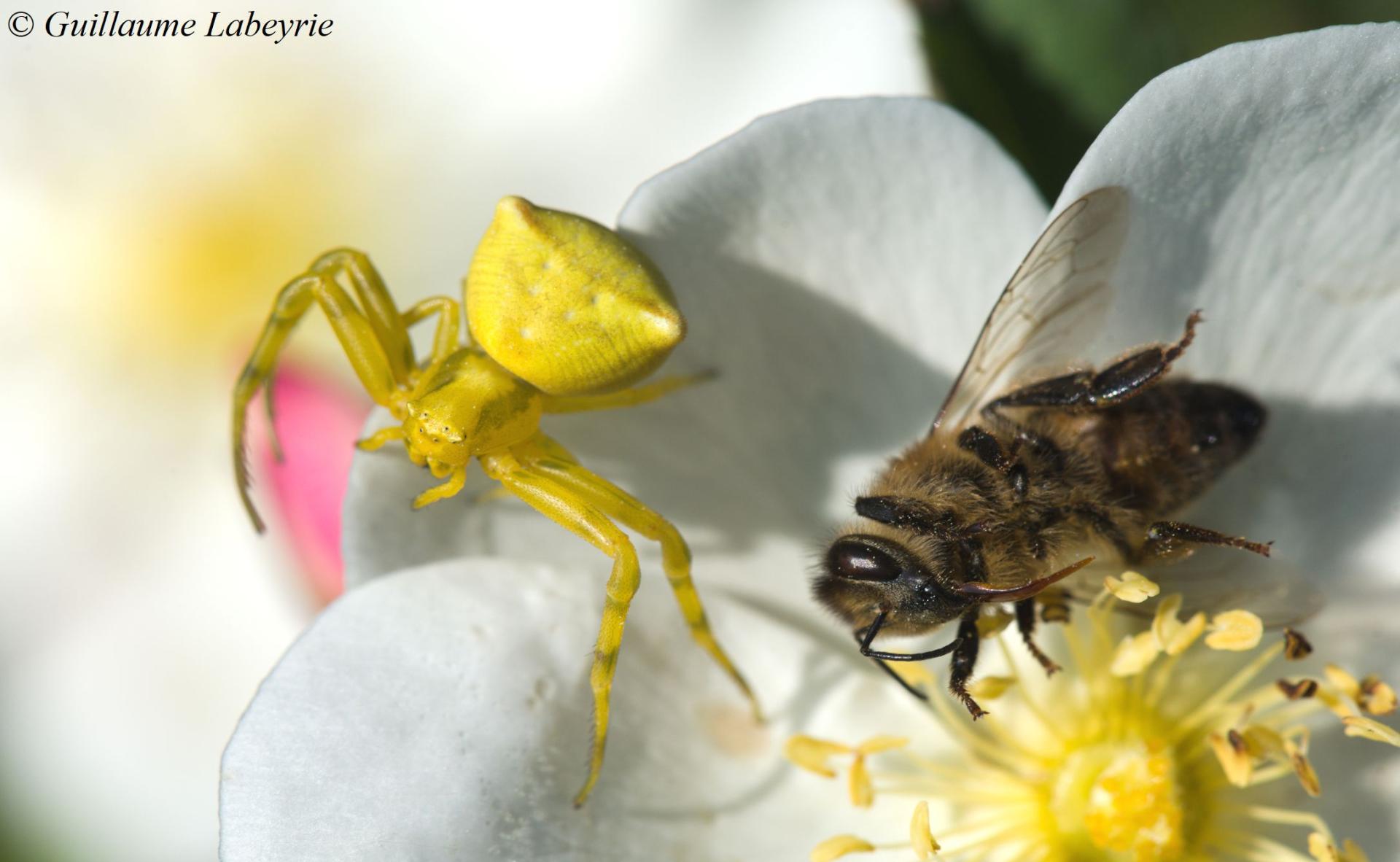
Thomisus onustus. This crab spider has an abdomen with two pointed tubercles. Its color is very variable. It often hunts hidden under a flower, waiting for pollinating insects like this domestic bee. This species is present throughout Europe and France. A closely related southern species, T. citrinellus, is distinguished by the presence of two dark spots behind the tubercles of the abdomen.
Crustaceans
Family : Porcellionidae
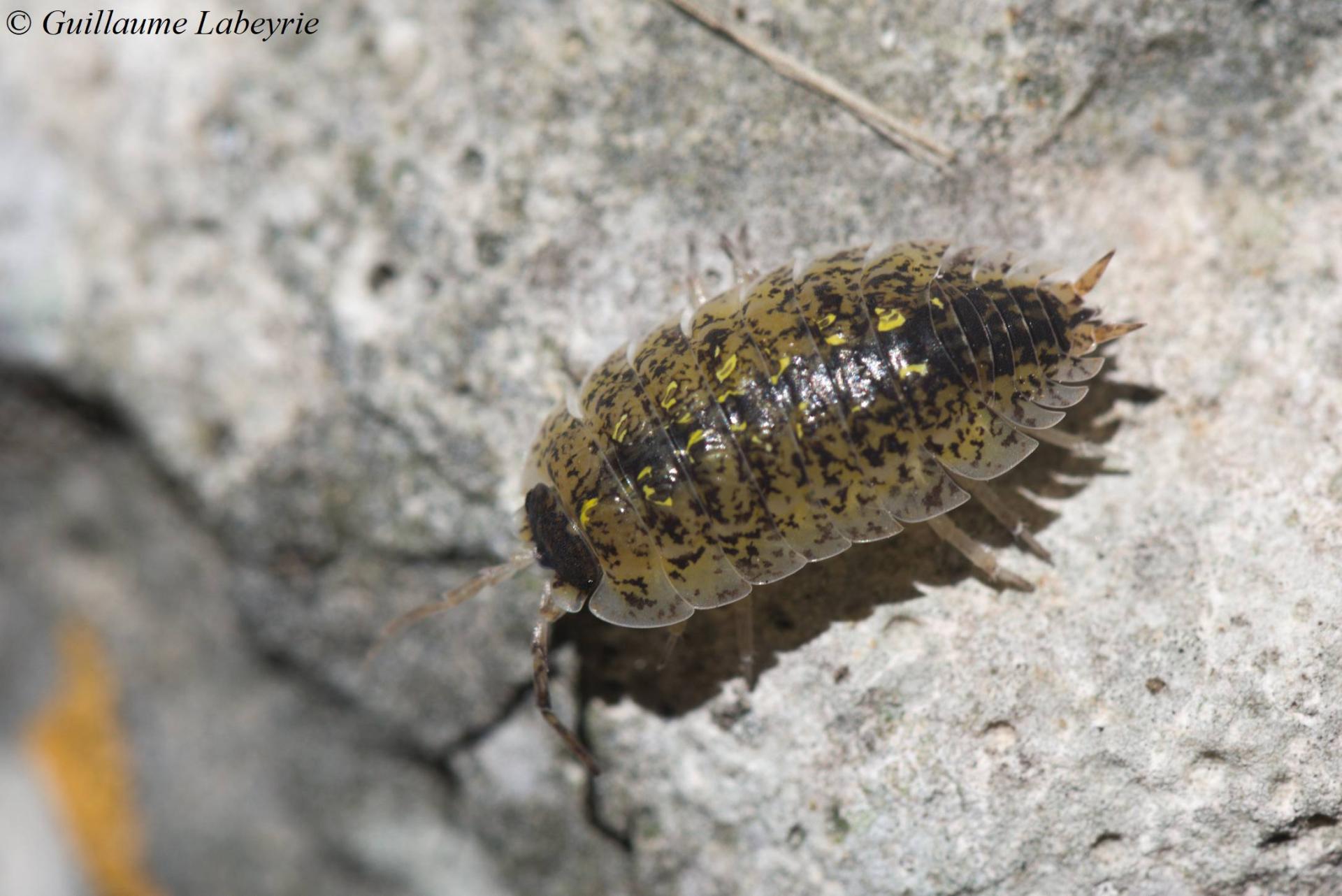
Porcellio spinipennis. This woodlouse has a strong spine at the base of the antenna (hence its latin name), as well as yellow spots on its shell. It appreciates the litter of dead leaves in the crevices of the karst. This is a species with a restricted distribution, with most observations being made in the South-East of France.
Mollusks (Mollusca)
Family : Helicidae
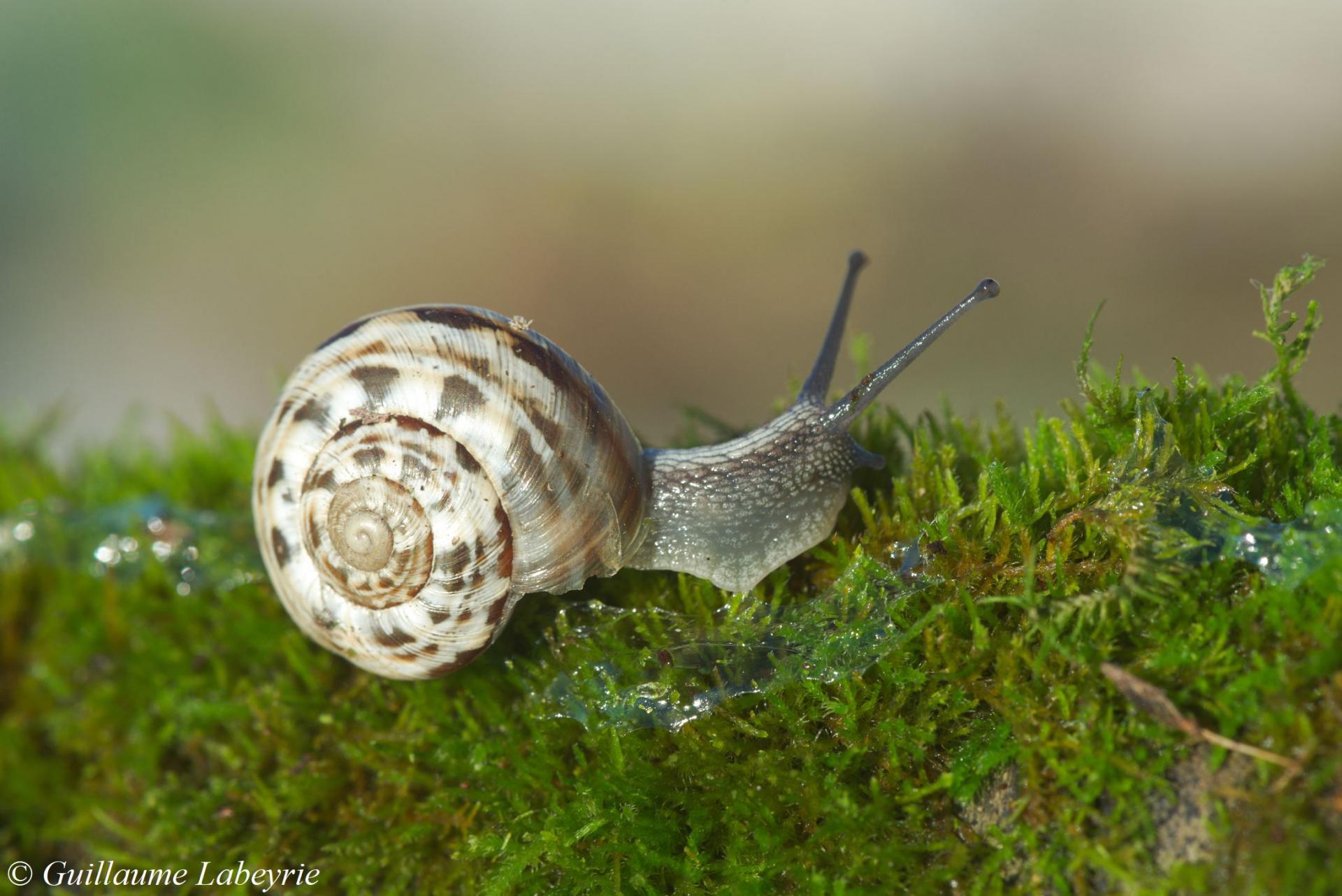 Macularia niciensis subsp. dupuyi. This shell of this snail is about 2 cm in diameter, slightly flattened, forming a spiral with five turns. The color is variable. This snail is a Ligurian endemic, found in Italy and in south-eastern France (Var, Alpes-de-Haute-Provence, Alpes-Maritimes). It seems rather widespread in the Préalpes de Grasse, but always in very small numbers. Two other subspecies of Macularia niciensis are found in the Alpes-Maritimes.
Macularia niciensis subsp. dupuyi. This shell of this snail is about 2 cm in diameter, slightly flattened, forming a spiral with five turns. The color is variable. This snail is a Ligurian endemic, found in Italy and in south-eastern France (Var, Alpes-de-Haute-Provence, Alpes-Maritimes). It seems rather widespread in the Préalpes de Grasse, but always in very small numbers. Two other subspecies of Macularia niciensis are found in the Alpes-Maritimes.
Family : Chondrinidae
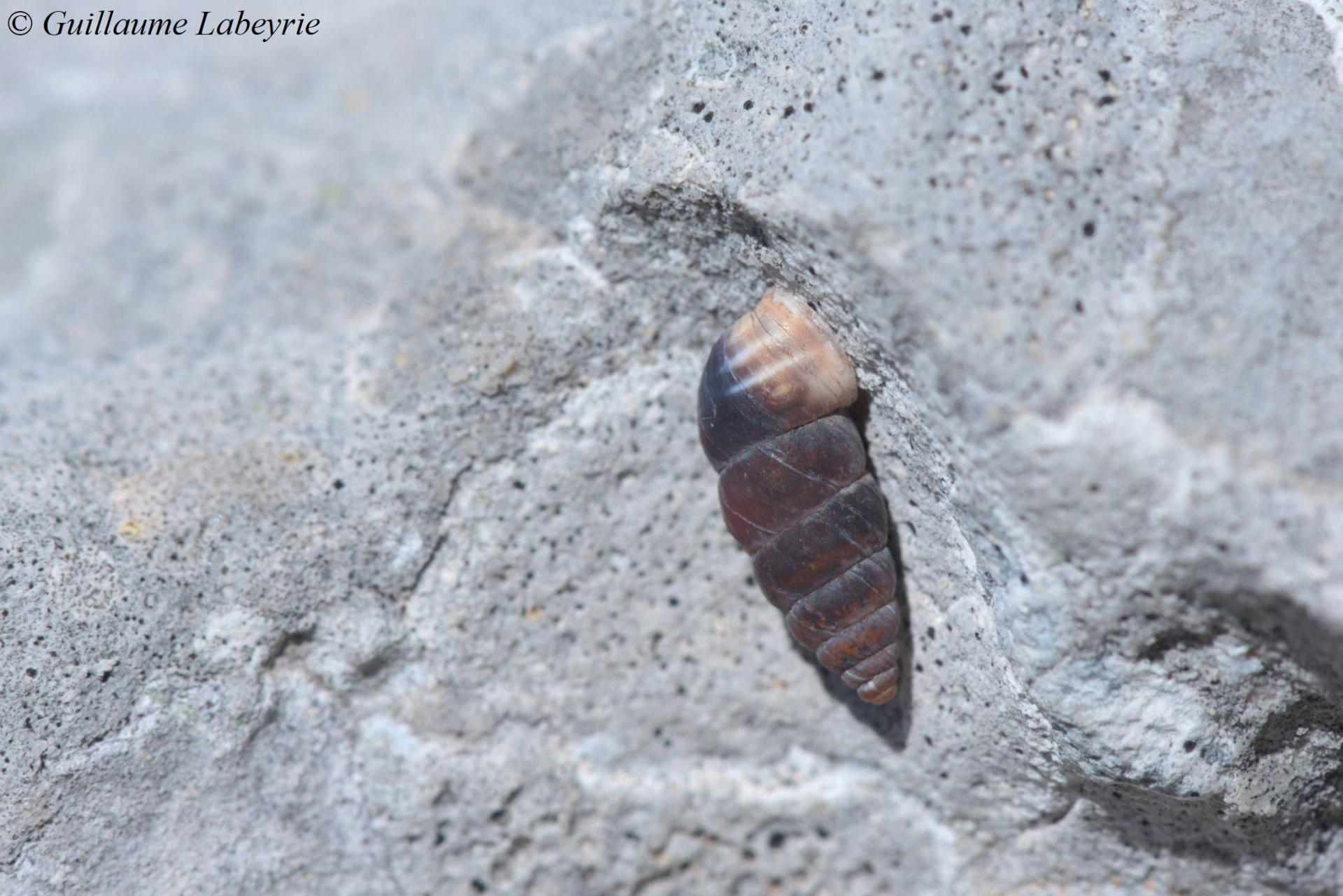
Chondrina megacheilos subsp. caziotana. This tiny snail reaches 7 mm in length. It is found in the same habitat as the previous species, sometimes with Cochlostoma macei described below. This species is restricted in France mainly to the Alpes-Maritimes, and is fully protected.
Family : Megalomastomatidae

Cochlostoma macei. This is also a small species, between 5 and 7 mm in length. It lives in shady limestone cliffs, sometimes with the two previous species. It has a restricted range in France : Alpes-Maritimes, Var and Alpes-de-Haute-Provence.
Family : Limacidae
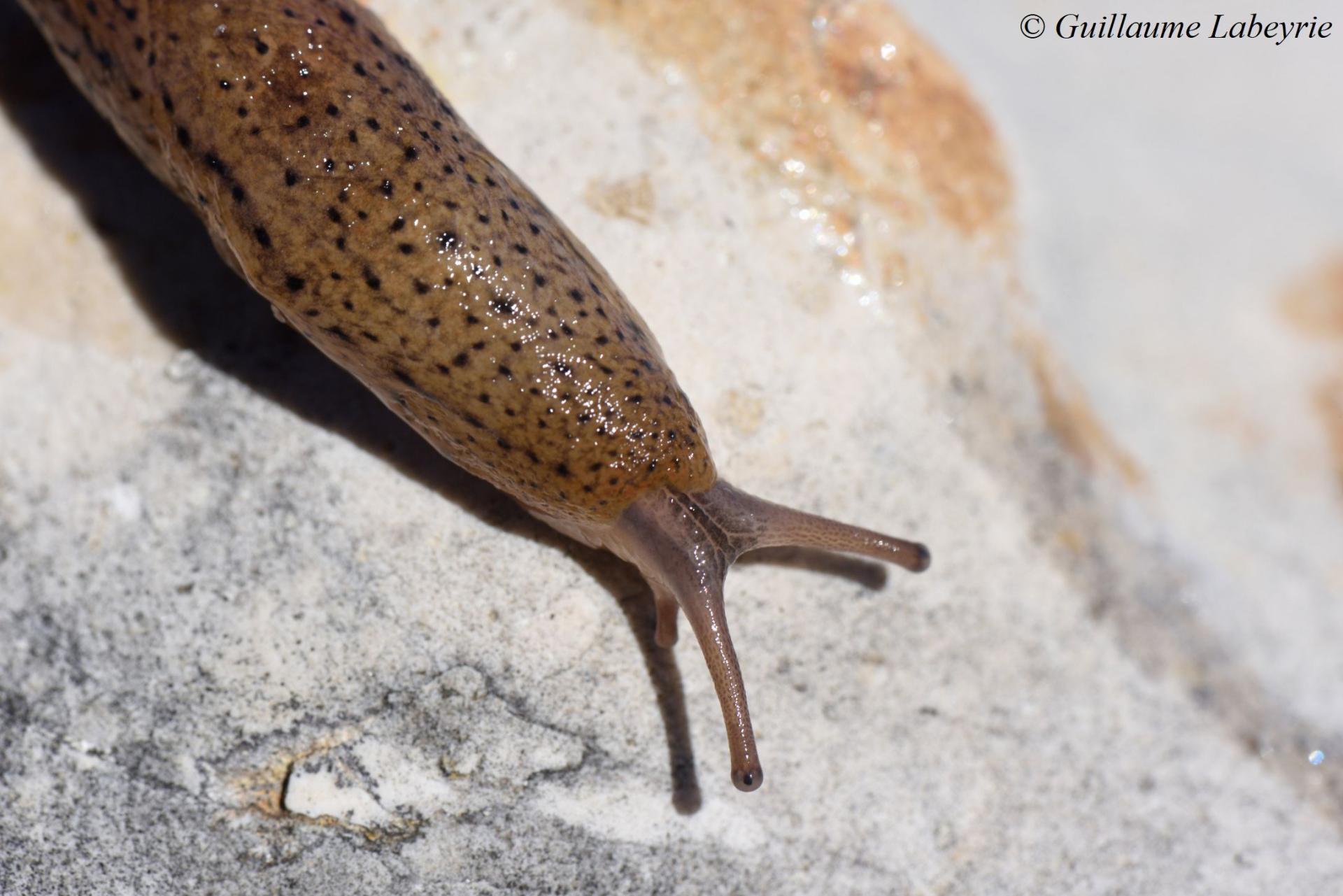
Limax millipunctatus. This striking slug reaches around ten centimeters in length, with an orange body dotted with small black spots. It is sometimes found in underground cavities. This species is endemic to Liguria and Lombardy, and only enters the French territory in the extreme South-East.
These slopes ensure the transition between the plains and valley, and the plateaus and ridges. Facing south, these dry slopes are covered by bushes and shrubs (Genista cinerea, dog rose, blackthorn, ...), with some occasional trees (Scots pine, downy oak, Italian maple, European hop-hornbeam, ... ). Some open areas with dry meadows are also present, as well as, locally, marly outcrops.
Flora
Family : Gentianaceae
 The star gentian (Gentiana cruciata). This gentian grows on fairly high stems, with shiny leaves and small, pale blue flowers. It is usually found in clearings of Scots pine woods. In the Préalpes de Grasse, this species is the host plant of the Alcon blue (Phengaris alcon rebeli), a rare butterfly.
The star gentian (Gentiana cruciata). This gentian grows on fairly high stems, with shiny leaves and small, pale blue flowers. It is usually found in clearings of Scots pine woods. In the Préalpes de Grasse, this species is the host plant of the Alcon blue (Phengaris alcon rebeli), a rare butterfly.
Family : Orchidaceae
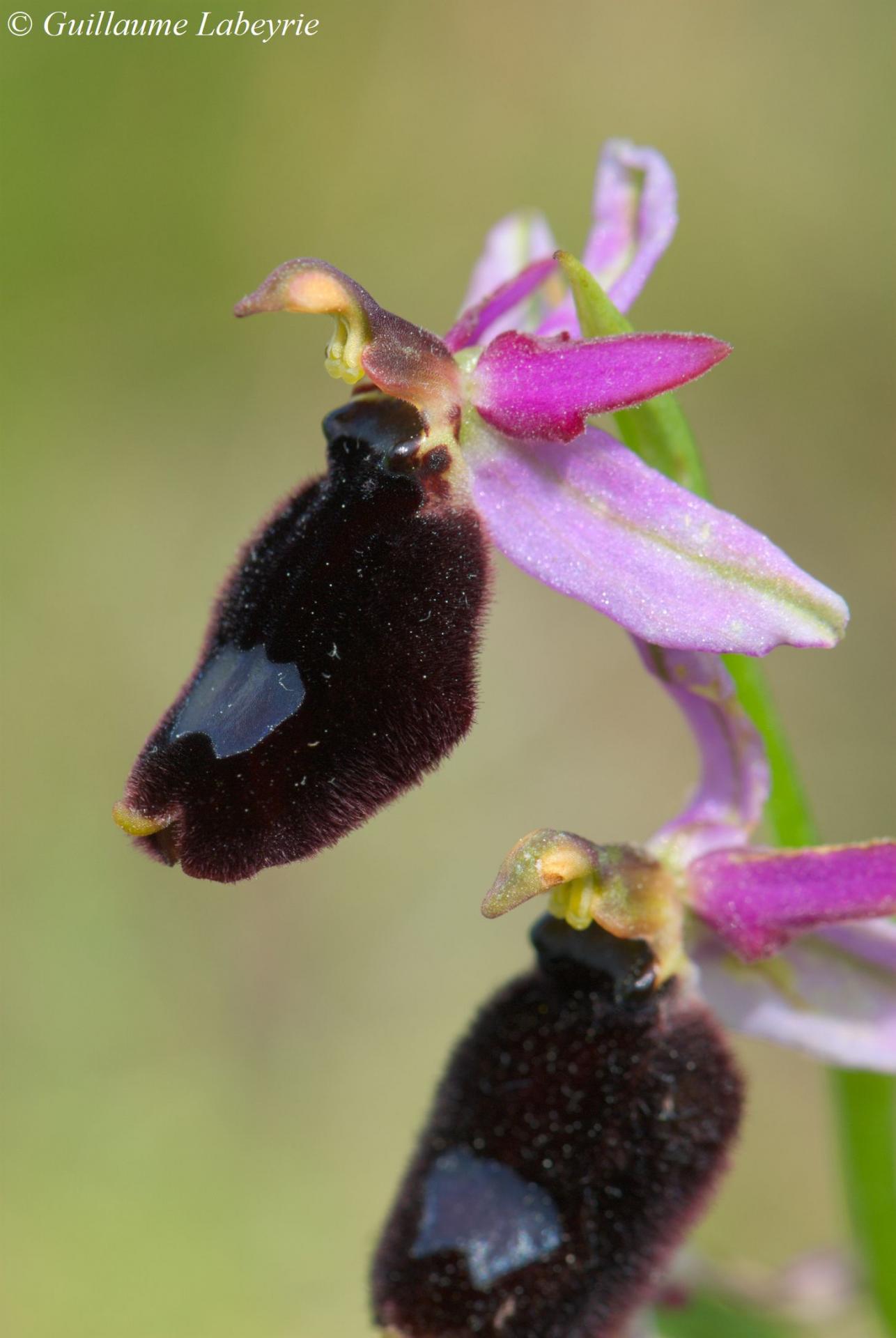 Ophrys bertolonii subsp. aurelia. This rare and beautiful ophrys is found in grasslands in low mountains, up to 1200 m of altitude. Blooming in mid-May (mid-April at low elevations), it occurs from the Bouches-du-Rhône to the Italian border. It is fully protected in France and listed as "near threatened" by IUCN.
Ophrys bertolonii subsp. aurelia. This rare and beautiful ophrys is found in grasslands in low mountains, up to 1200 m of altitude. Blooming in mid-May (mid-April at low elevations), it occurs from the Bouches-du-Rhône to the Italian border. It is fully protected in France and listed as "near threatened" by IUCN.
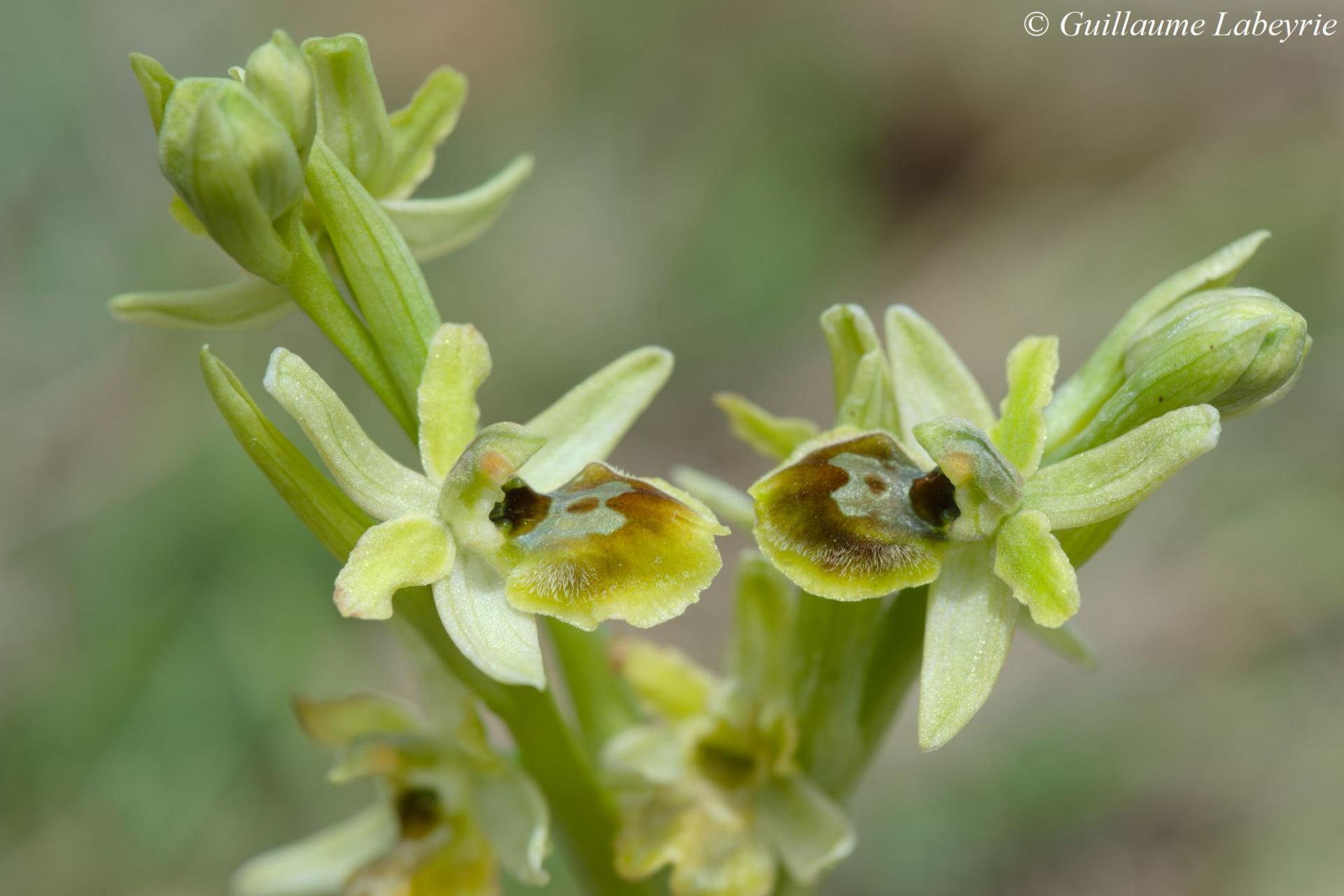 Ophrys virescens. This species is well characterized by its small pale flowers, with a green perianth and a clear yellow fringe of the labellum. This plant is a low mountain species, where it grows in marly meadows. Present from Spain to the Balkans, it is found in most of France but is rare in certain regions.
Ophrys virescens. This species is well characterized by its small pale flowers, with a green perianth and a clear yellow fringe of the labellum. This plant is a low mountain species, where it grows in marly meadows. Present from Spain to the Balkans, it is found in most of France but is rare in certain regions.
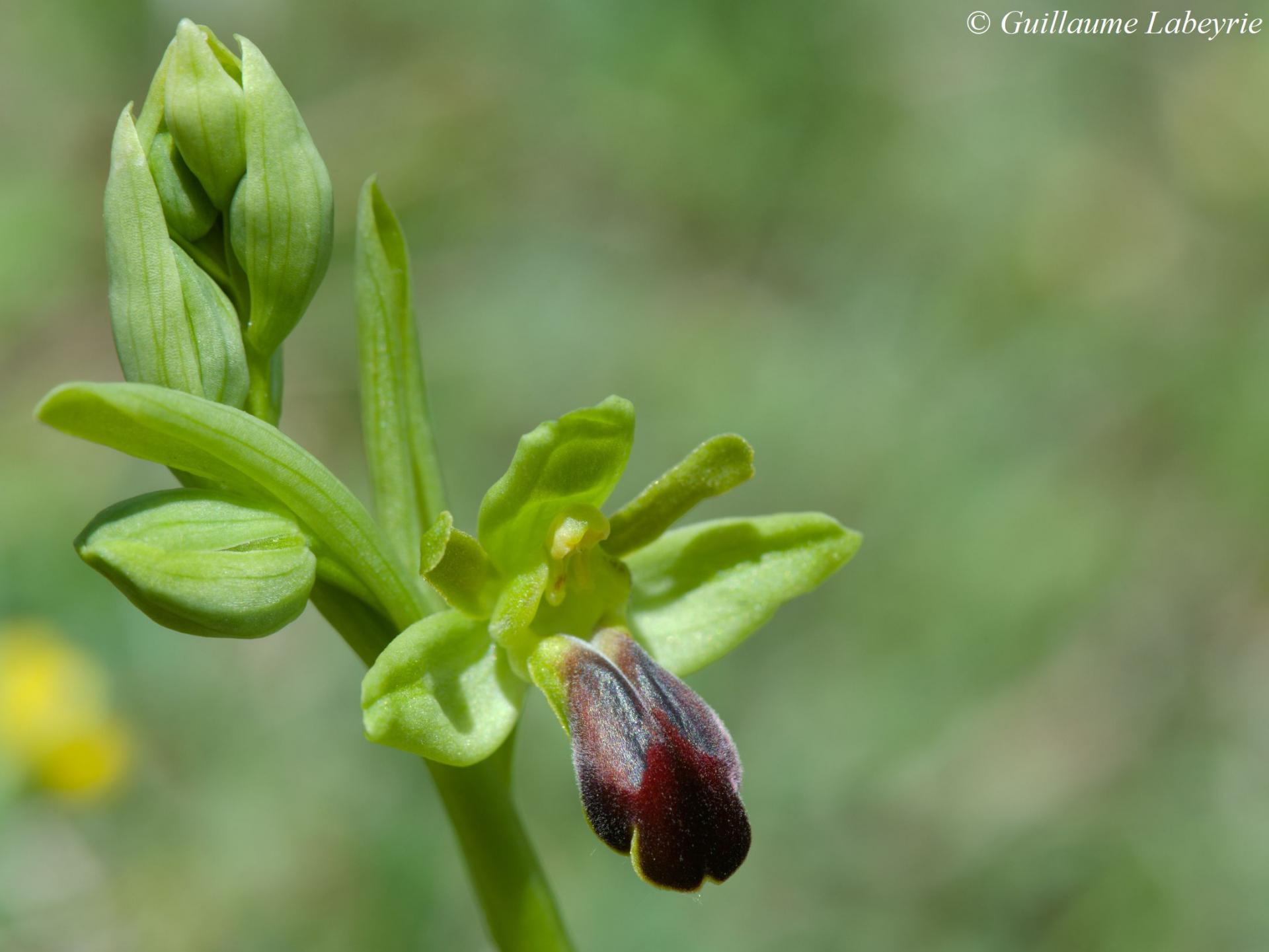 Ophrys sulcata. This ophrys has small flowers with a long labellum, divided by a clear basilar groove. This uncommon species is found at low elevation but also in low mountain ranges, in humid marly meadows. It occurs in Spain, France and Italy. In France, its is found in the south, from the Atlantic coast to the extreme south-east.
Ophrys sulcata. This ophrys has small flowers with a long labellum, divided by a clear basilar groove. This uncommon species is found at low elevation but also in low mountain ranges, in humid marly meadows. It occurs in Spain, France and Italy. In France, its is found in the south, from the Atlantic coast to the extreme south-east.
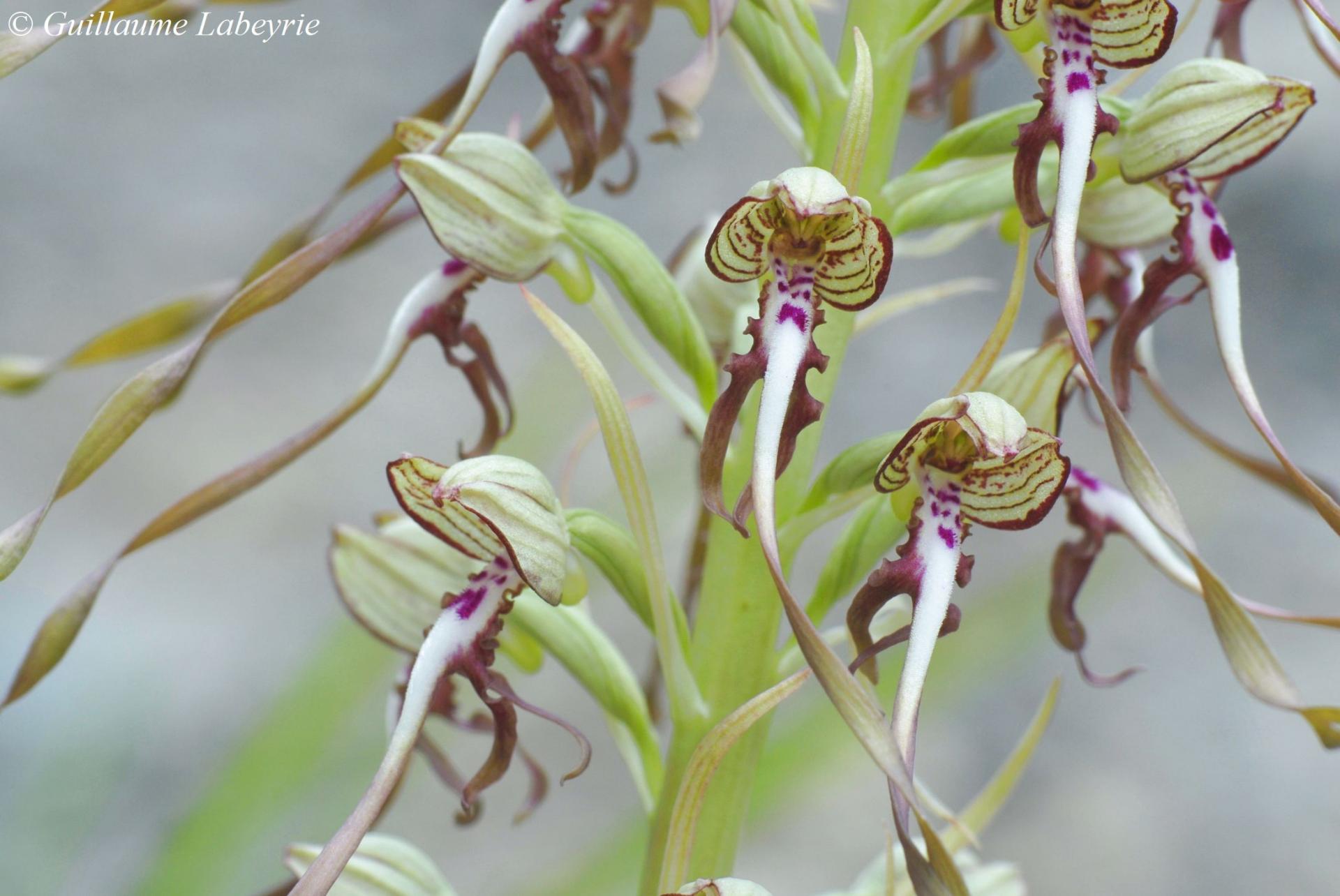 The lizard orchid (Himantoglossum hircinum). This striking species is among our largest orchids. The long labellum is unmistakable. The fresh flowers emit a deep scent which often allows to detect the plant without actually seeing it ! This orchid grows in calcareous meadows, from see level to low mountains. Found from Spain and the UK to the Balkans and North Africa, this species occurs in most of the French territory.
The lizard orchid (Himantoglossum hircinum). This striking species is among our largest orchids. The long labellum is unmistakable. The fresh flowers emit a deep scent which often allows to detect the plant without actually seeing it ! This orchid grows in calcareous meadows, from see level to low mountains. Found from Spain and the UK to the Balkans and North Africa, this species occurs in most of the French territory.
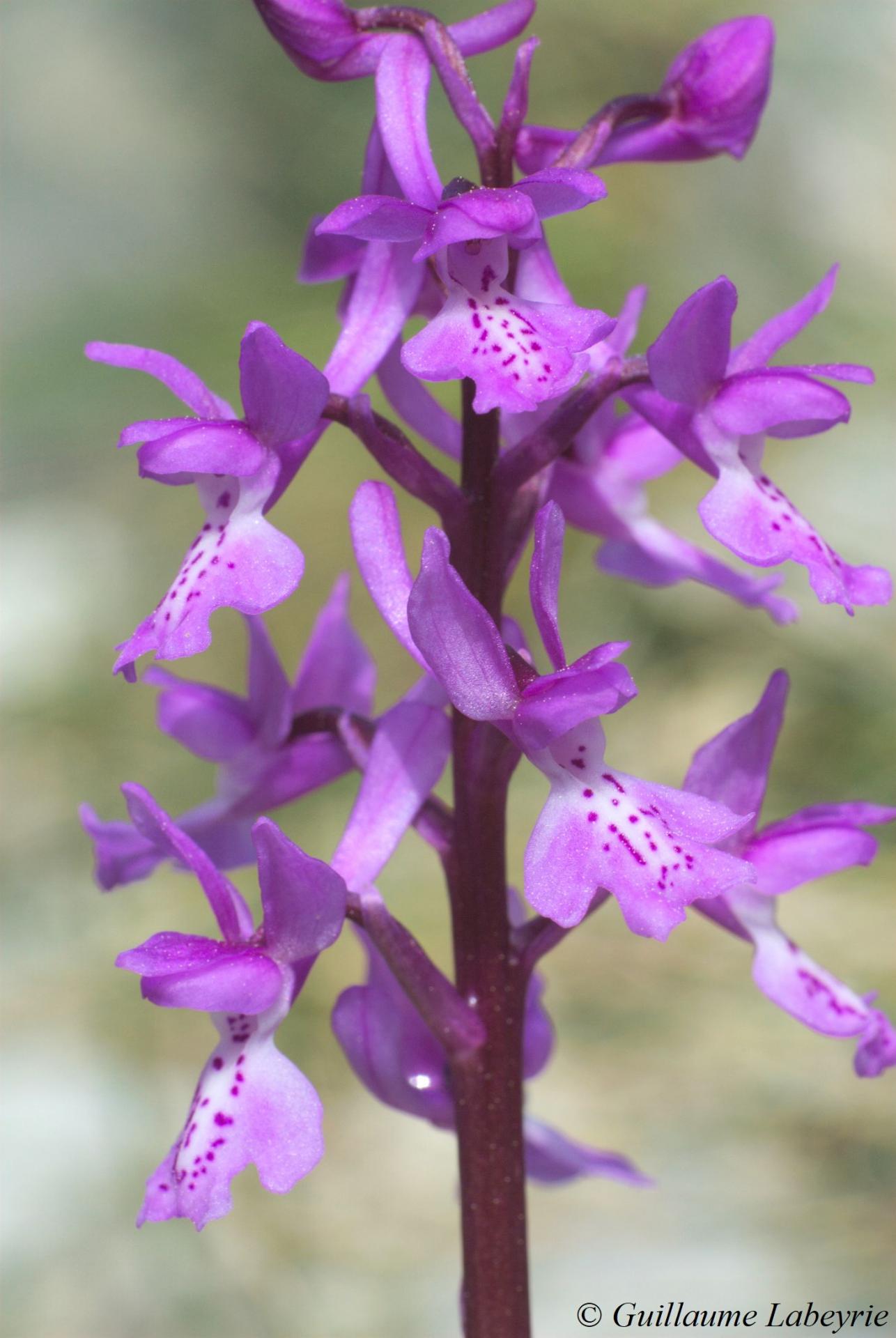 Hyères's orchid (Orchis olbiensis). This uncommon Orchis is recognizable to its pale pink flowers with a long, recurvated spear, flattened at the tip. It grows in dry calcareous area, up the low mountains. Fowering occurs in April. This is a species from Western Mediterranean, which is found in France only along the coast.
Hyères's orchid (Orchis olbiensis). This uncommon Orchis is recognizable to its pale pink flowers with a long, recurvated spear, flattened at the tip. It grows in dry calcareous area, up the low mountains. Fowering occurs in April. This is a species from Western Mediterranean, which is found in France only along the coast.
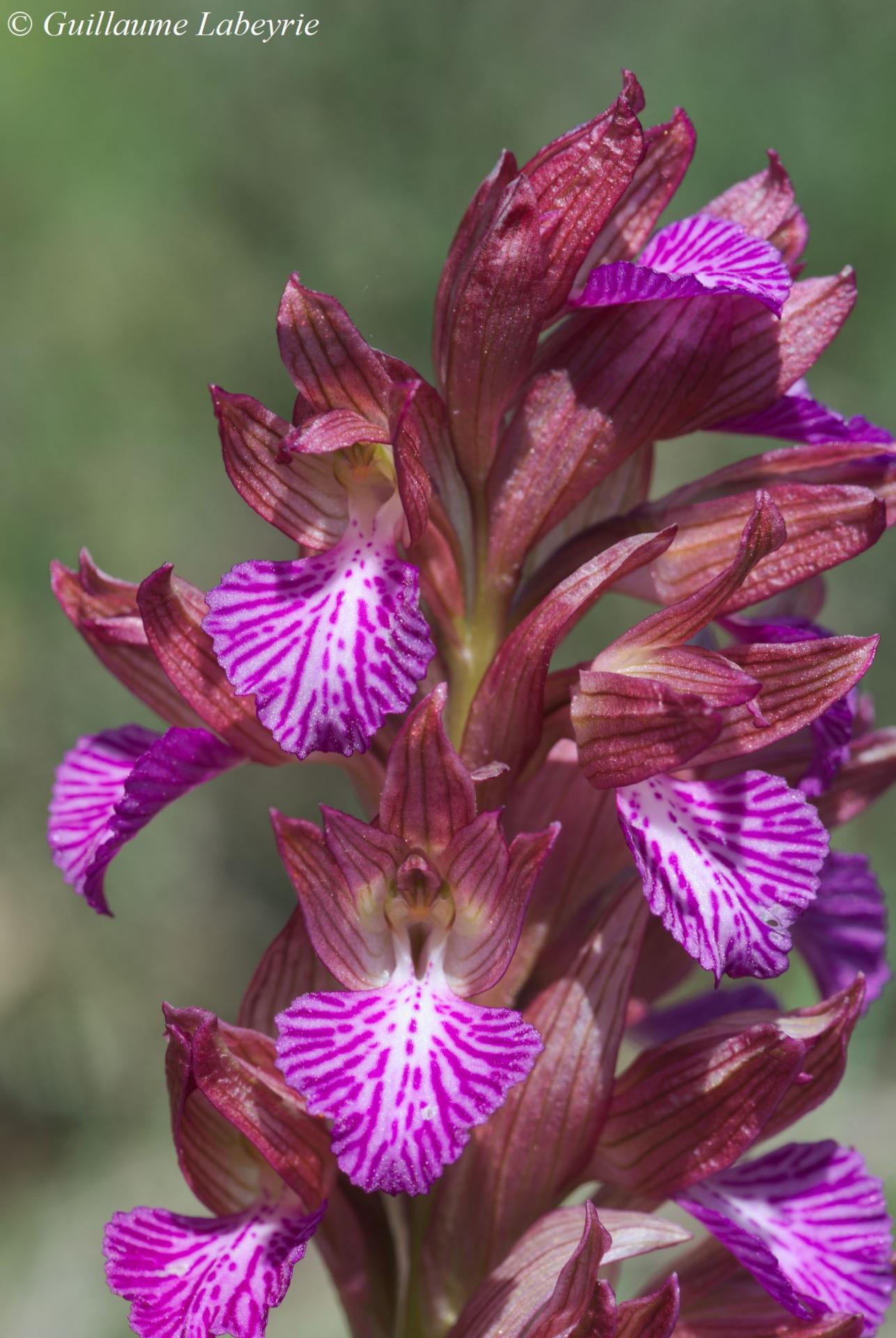 The butterfly orchid (Anacamptis papilionacea subsp. expansa). This striking orchid cannot be confused, except with the subspecies papilionacea found in Corsica, which has almost no purple stripes on the labellum. This mediterranean species occurs mainly along the coast, but can be found at altitudes up to 700 m in the Préalpes de Grasse. In France, this orchid is restricted to the Mediterranean costal area.
The butterfly orchid (Anacamptis papilionacea subsp. expansa). This striking orchid cannot be confused, except with the subspecies papilionacea found in Corsica, which has almost no purple stripes on the labellum. This mediterranean species occurs mainly along the coast, but can be found at altitudes up to 700 m in the Préalpes de Grasse. In France, this orchid is restricted to the Mediterranean costal area.
Fauna
Reptiles
Family : Viperidae
 The asp (Vipera aspis). This well-known viper has a triangular head quite distinct from the neck, and a slightly upturned snout as can be clearly seen on this image. It should not be confused with the much scarcer Orsini's viper (Vipera ursinii), which has a small rounded head (see below). The body pattern and color of the asp is highly variable. This snake is present in western Europe, mainly in France and Italy.
The asp (Vipera aspis). This well-known viper has a triangular head quite distinct from the neck, and a slightly upturned snout as can be clearly seen on this image. It should not be confused with the much scarcer Orsini's viper (Vipera ursinii), which has a small rounded head (see below). The body pattern and color of the asp is highly variable. This snake is present in western Europe, mainly in France and Italy.
Family : Lacertidae
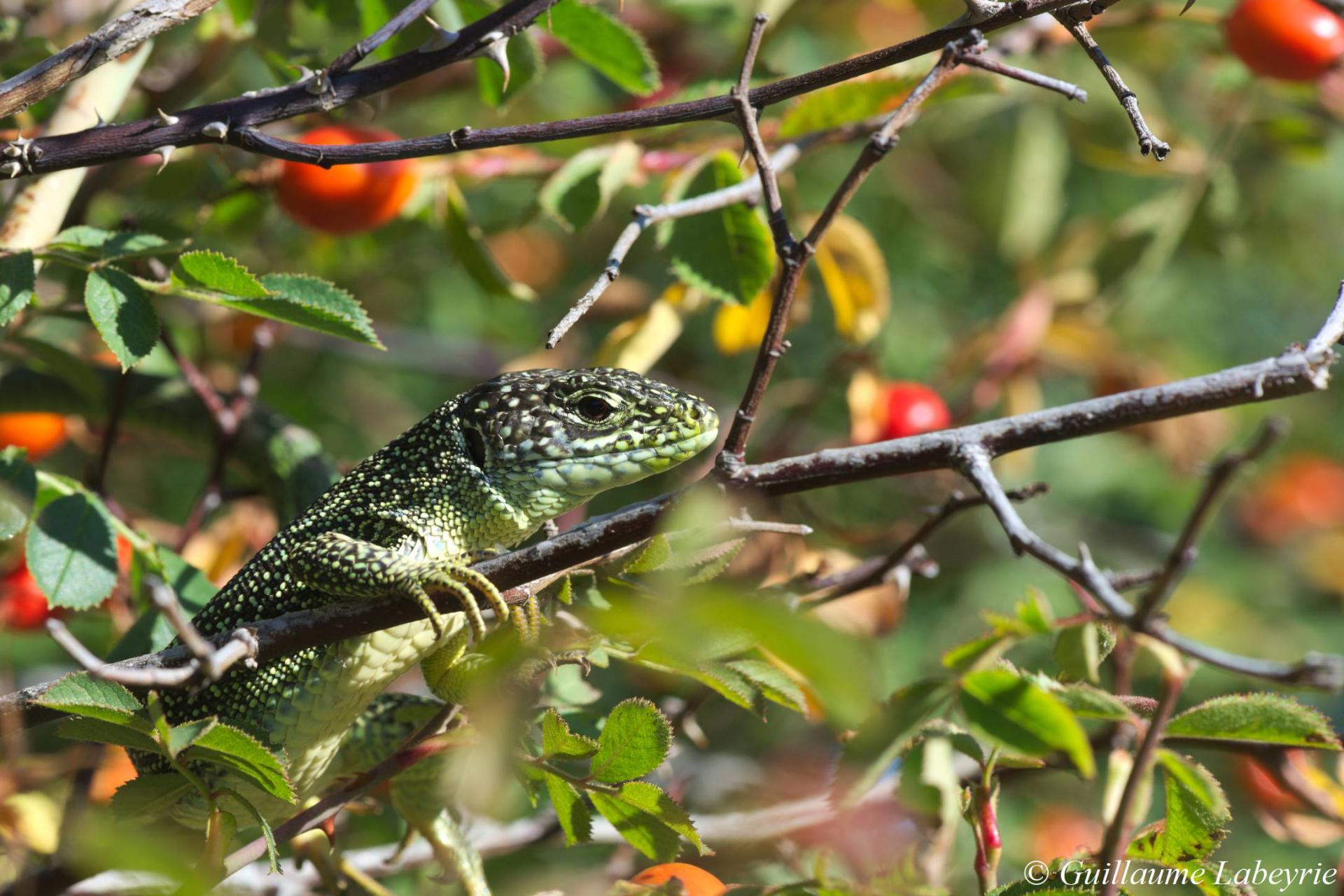 The western green lizard (Lacerta bilineata). This rather large lizard is very common in dry slopes and rocky meadows in low mountains. Males in spring often display a bright blue throat. This western European species is distinguished from the eastern green lizard (Lacerta viridis), found in eastern Europe, by the two pale lines on the juvenile's back (the adults are very similar).
The western green lizard (Lacerta bilineata). This rather large lizard is very common in dry slopes and rocky meadows in low mountains. Males in spring often display a bright blue throat. This western European species is distinguished from the eastern green lizard (Lacerta viridis), found in eastern Europe, by the two pale lines on the juvenile's back (the adults are very similar).
Family : Anguidae
 Slowworms: Anguis fragilis and Anguis veronensis. These legless lizards are well known from gardeners because they often hide inside compost piles. Five species are found in Europe, including two in France (A. fragilis and A. veronensis). A. veronensis occurs in Italy and in the French Alpes-Maritimes. It was identified a separate species in 2013 based on genetics. Morphological characters do not seem reliable enough to distinguish between the two species, whose respective distributions in the Alpes-Maritimes are not well known.
Slowworms: Anguis fragilis and Anguis veronensis. These legless lizards are well known from gardeners because they often hide inside compost piles. Five species are found in Europe, including two in France (A. fragilis and A. veronensis). A. veronensis occurs in Italy and in the French Alpes-Maritimes. It was identified a separate species in 2013 based on genetics. Morphological characters do not seem reliable enough to distinguish between the two species, whose respective distributions in the Alpes-Maritimes are not well known.
Butterflies and Moths (Lepidoptera)
Family : Lycaenidae
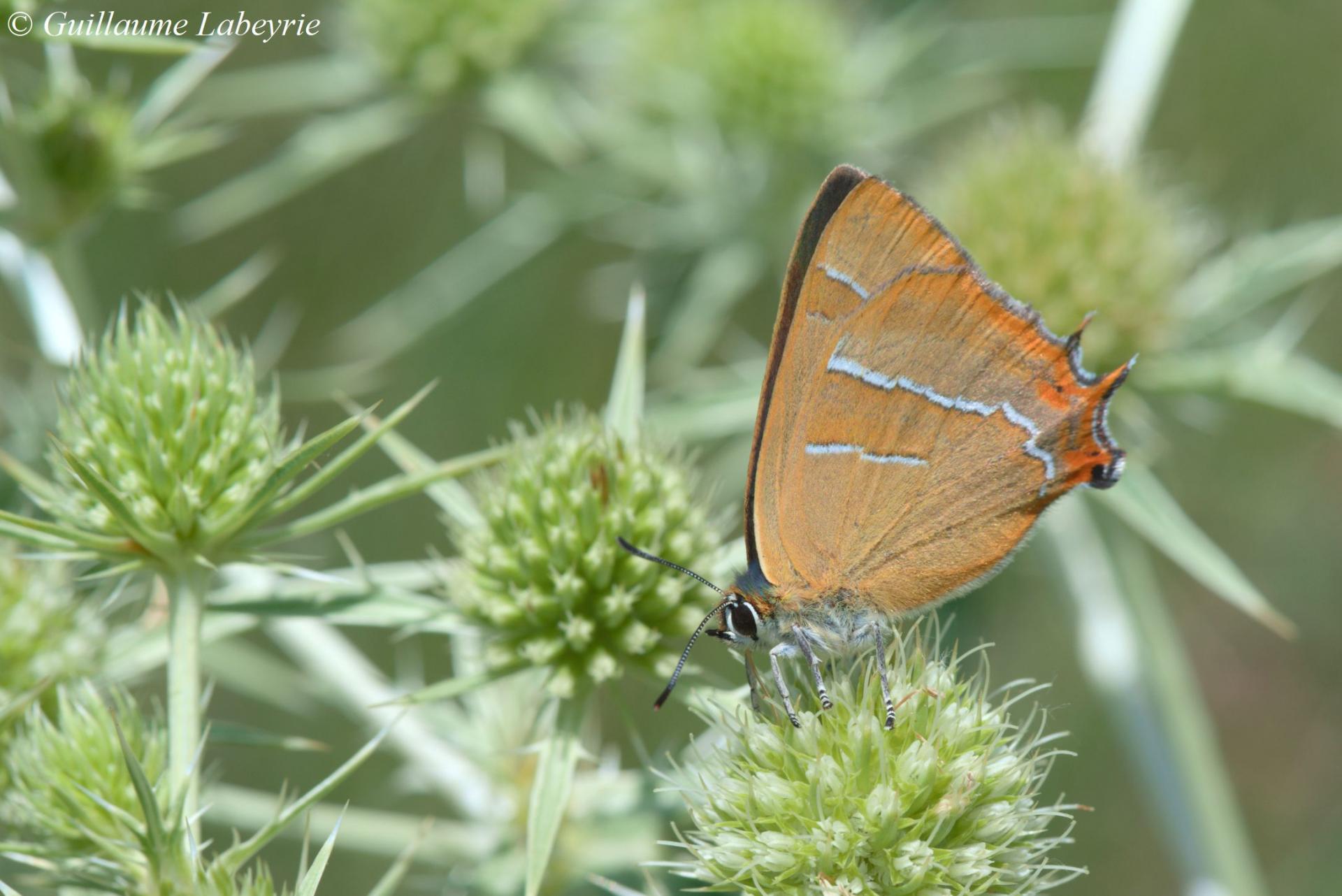
The brown hairstreak (Thecla betulae). This nice butterfly is easily distinguished from other species of the genus by its orange underside. This butterfly often flies at the top of trees and is quite difficult to observe: sightings in the Alpes-Maritimes are relatively few. In the region, this species feeds on blackthorn. Distributed from Europe to China, it is present in most of France.
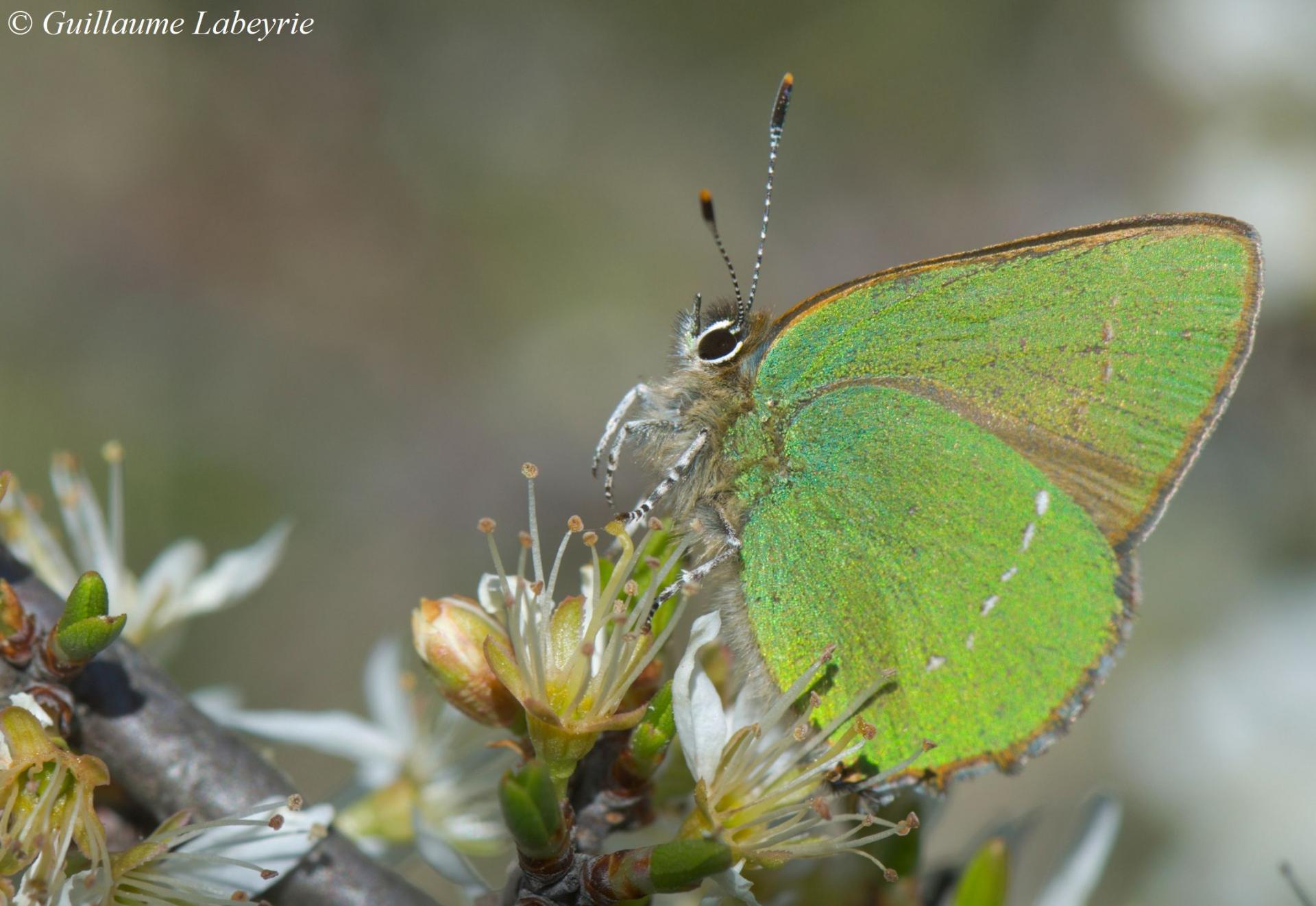 The green hairstreak (Callophrys rubi). This nice, bright green, small butterfly can not be confused, excepted with the much scarcer Chapman's green hairstreak (Callophrys avis) which has a clear dotted white line on the underside of both wings. Very common in southeastern France, the green hairstreak is on of the first butterflies to appear in spring. It occurs in most of Europe and North Africa.
The green hairstreak (Callophrys rubi). This nice, bright green, small butterfly can not be confused, excepted with the much scarcer Chapman's green hairstreak (Callophrys avis) which has a clear dotted white line on the underside of both wings. Very common in southeastern France, the green hairstreak is on of the first butterflies to appear in spring. It occurs in most of Europe and North Africa.
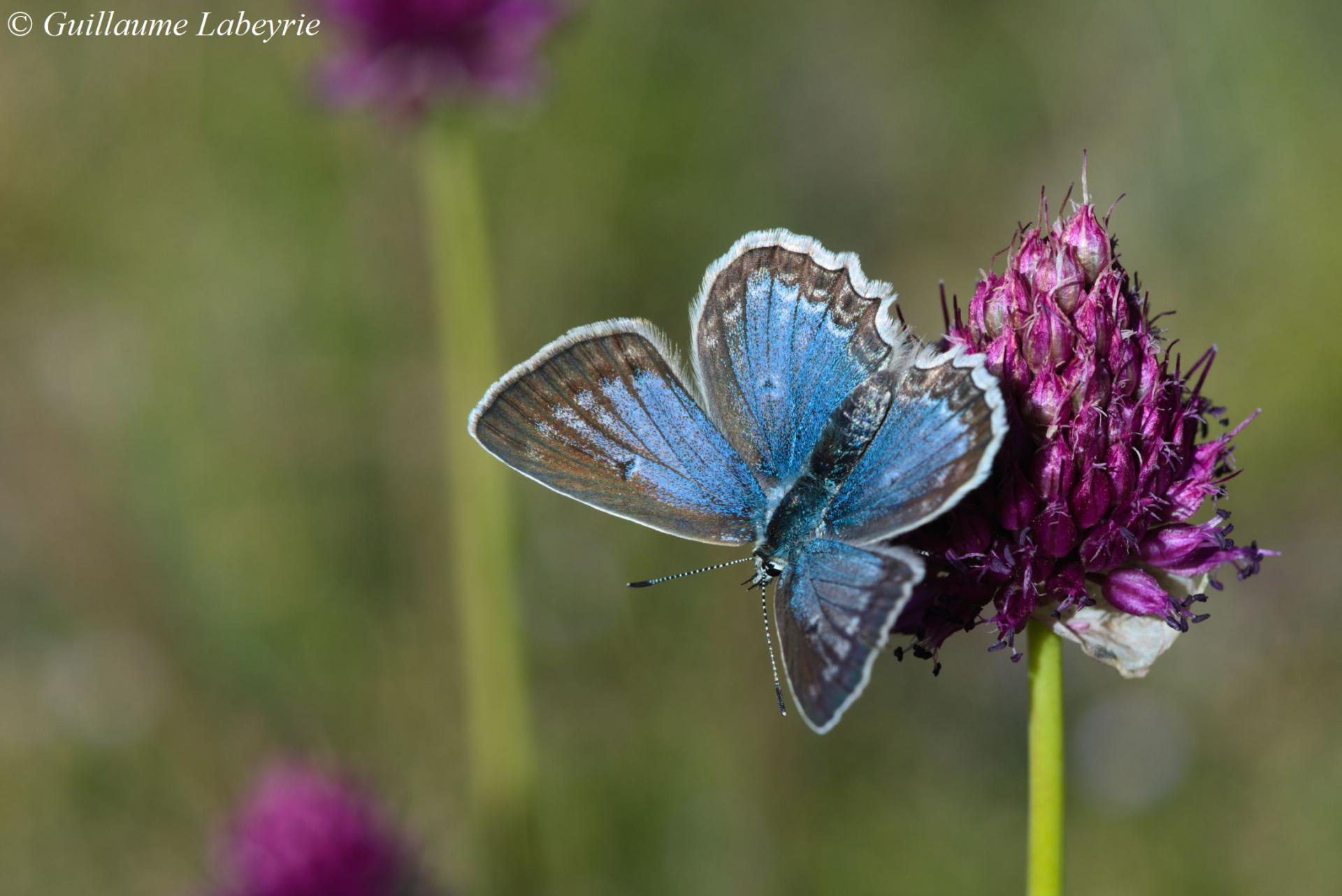 The Meleager's blue (Polyommatus daphnis). This beautiful species can be regognized by the wavy margins of the hind wings, a character more pronounced in the female as shown here. It is found in dry meadows on limestone soil, with an optimum around 1000 m of altitude. Ranging from Southern Europe to Eastern Asia, this butterfly occurs in France, where it is rather uncommon, in a south-eastern quarter.
The Meleager's blue (Polyommatus daphnis). This beautiful species can be regognized by the wavy margins of the hind wings, a character more pronounced in the female as shown here. It is found in dry meadows on limestone soil, with an optimum around 1000 m of altitude. Ranging from Southern Europe to Eastern Asia, this butterfly occurs in France, where it is rather uncommon, in a south-eastern quarter.
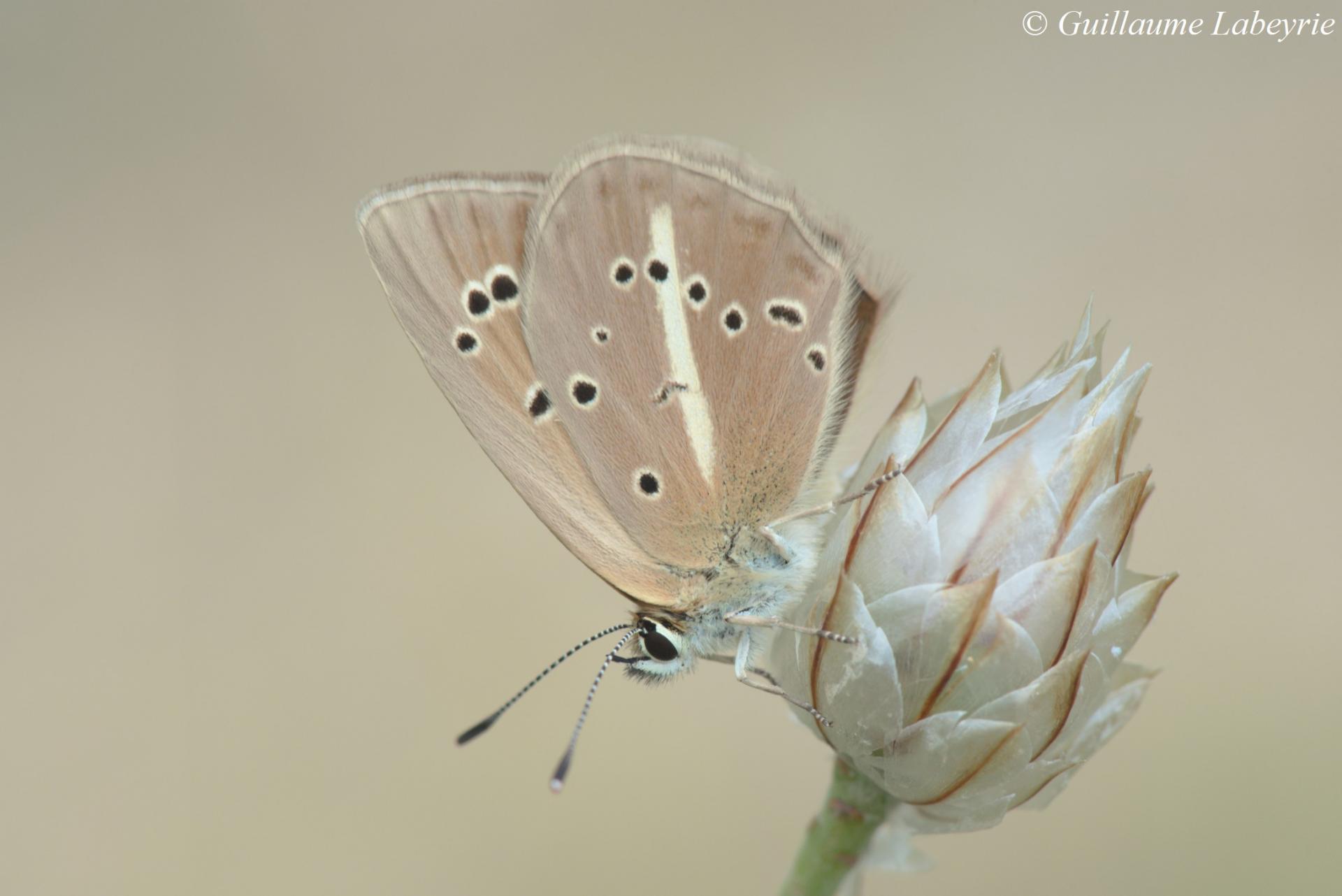
Ripart's anomalous blue (Polyommatus ripartii). This pretty butterfly is recognized by its uniform brown color in both sexes and the striking white stripe on the underside. It is found in from July to September in dry flower-rich meadows. Ripart's anomalous blue occurs in southern Europe, the Balkans to southwestern Siberia and Kazakhstan. In France, it is found only in a few departments of the South-East.
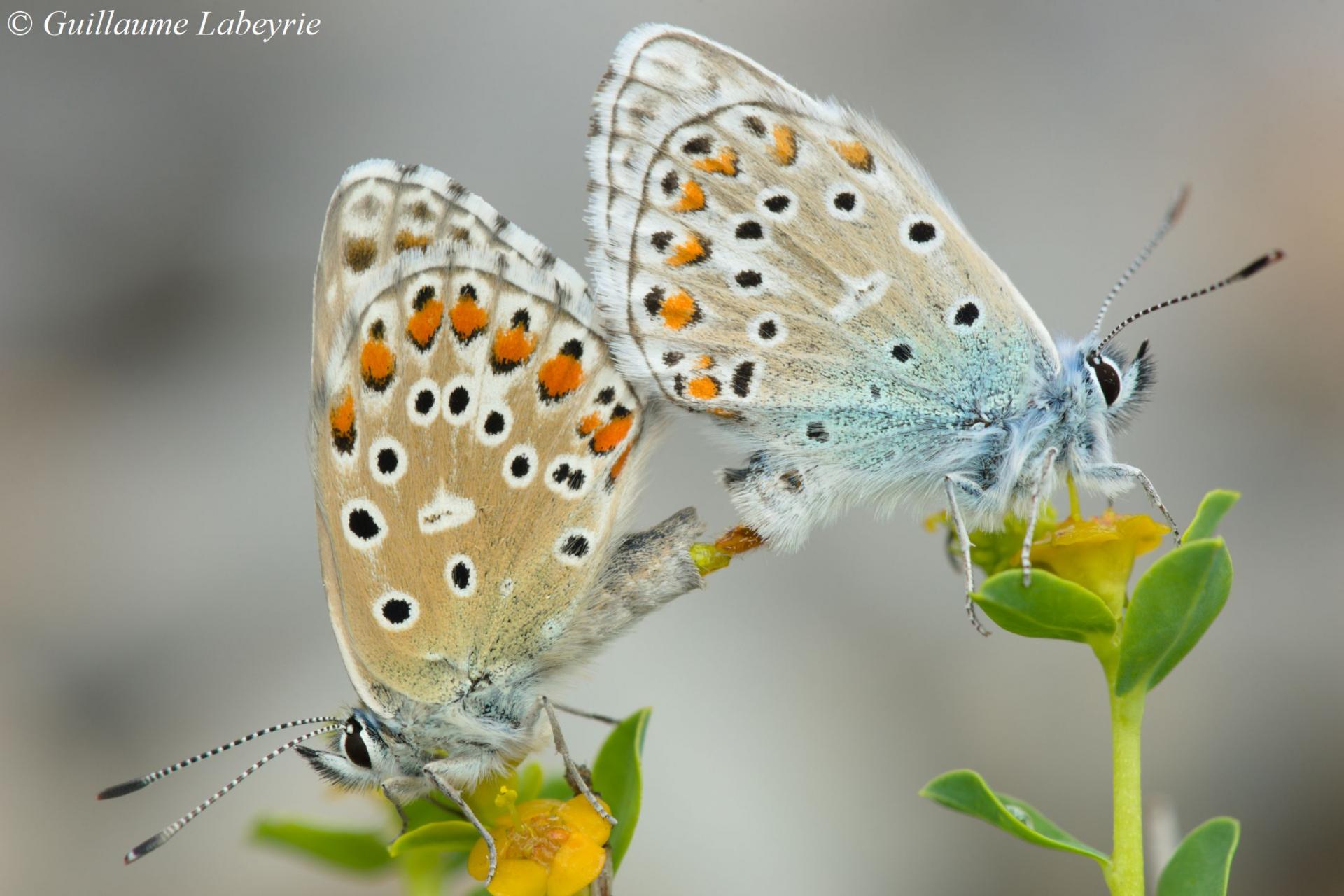 The Adonis blue (Lysandra bellargus). The male (right) has bright blue wings on the upper side, while the female (left) is mostly brown. The wing fringes are chequered in both sexes. This butterfly is widespread in dry calcareous grasslands up to 2000 m of altitude. It occurs in most of France.
The Adonis blue (Lysandra bellargus). The male (right) has bright blue wings on the upper side, while the female (left) is mostly brown. The wing fringes are chequered in both sexes. This butterfly is widespread in dry calcareous grasslands up to 2000 m of altitude. It occurs in most of France.
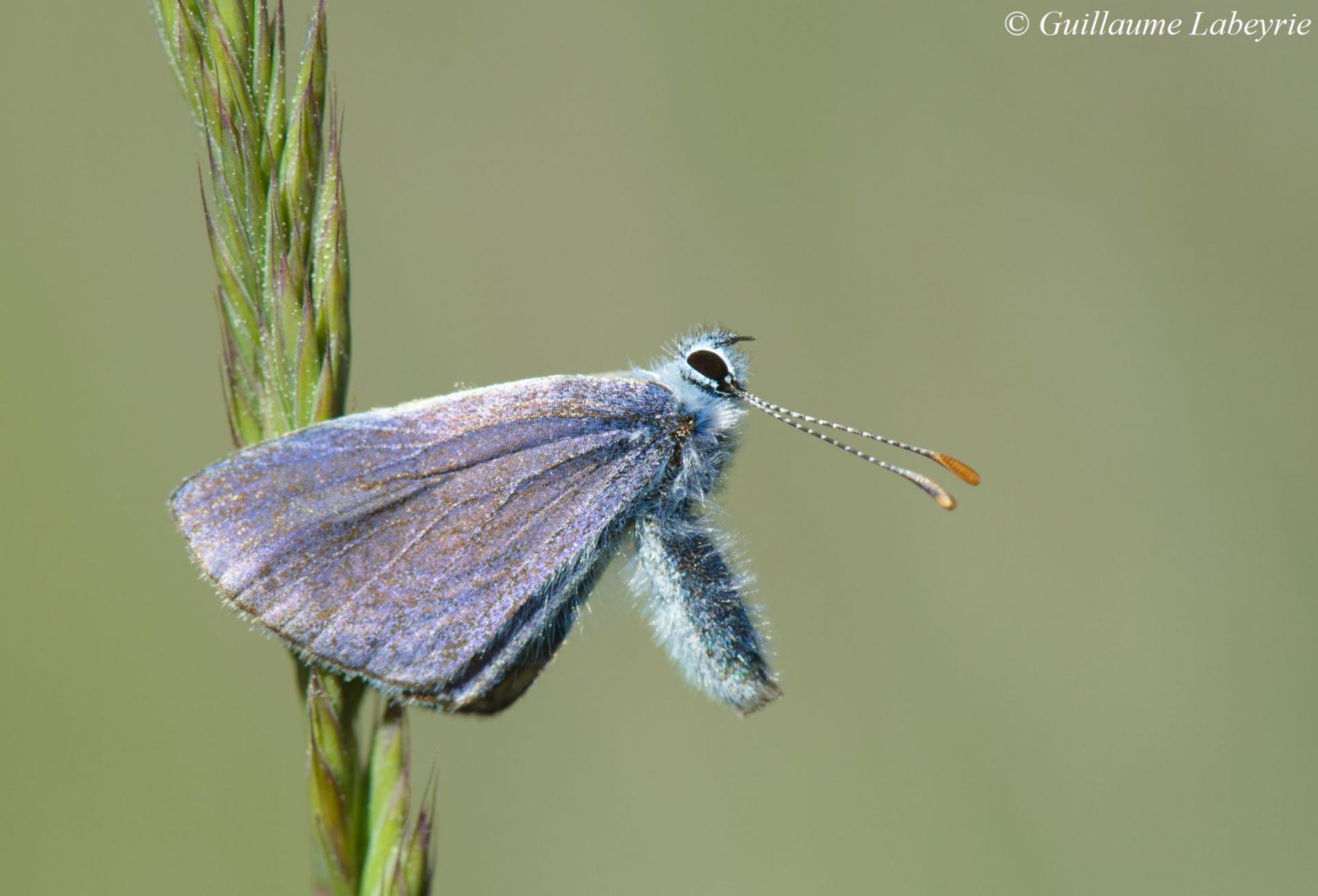 The common blue butterfly (Polyommatus icarus). This is one of the most common butterfly in Europe. The small size and purplish color of the male is quite distinctive. This individual was found dead in this strange posture ...
The common blue butterfly (Polyommatus icarus). This is one of the most common butterfly in Europe. The small size and purplish color of the male is quite distinctive. This individual was found dead in this strange posture ...
Family : Nymphalidae / Sub-Family : Nymphalinae
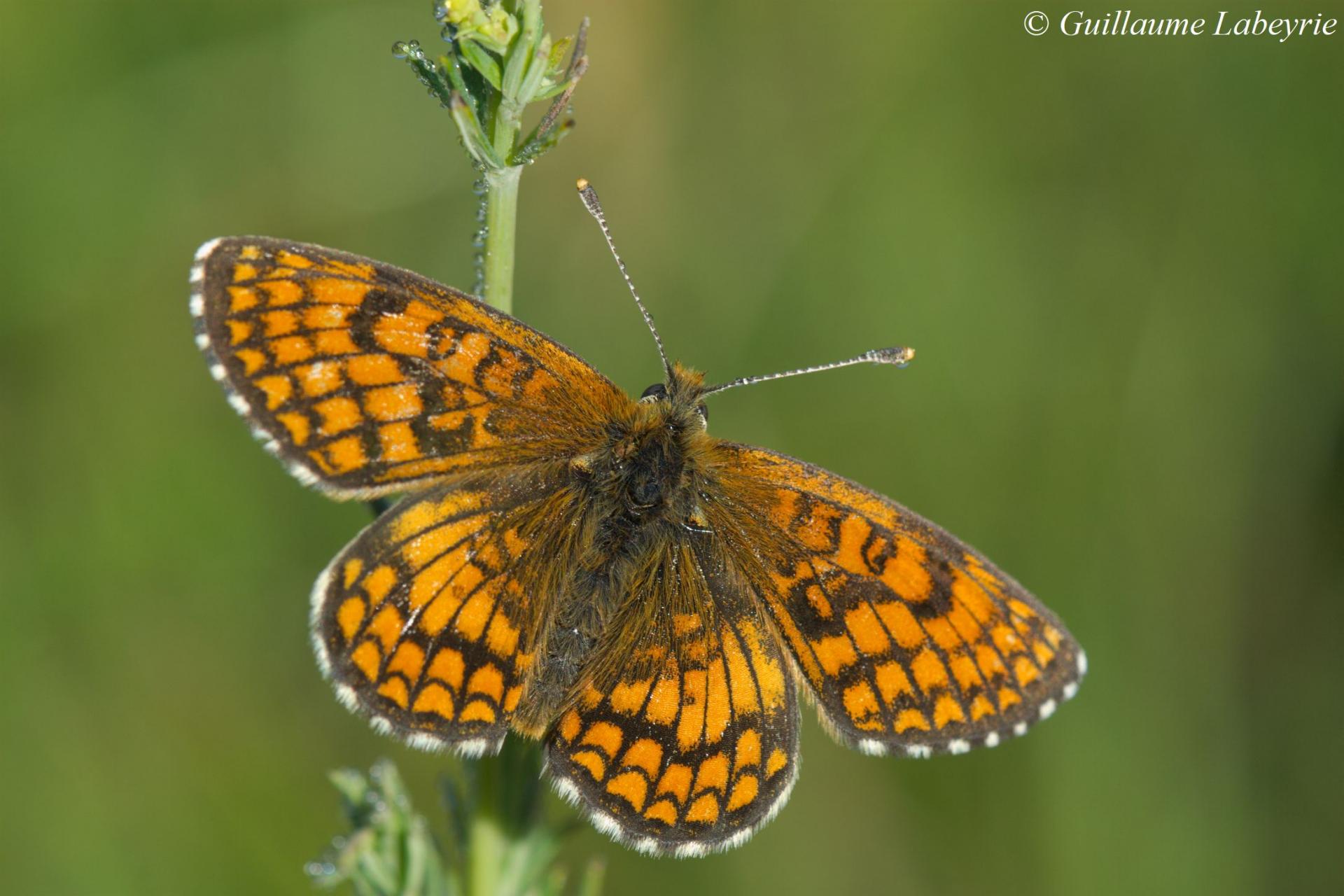 The meadow fritillary (Melitaea parthenoides). In the area this small-sized species is mainly observed in dry meadows, in June and July. It occurs in south-western Europe. In France, it can be observed in most of the territory.
The meadow fritillary (Melitaea parthenoides). In the area this small-sized species is mainly observed in dry meadows, in June and July. It occurs in south-western Europe. In France, it can be observed in most of the territory.
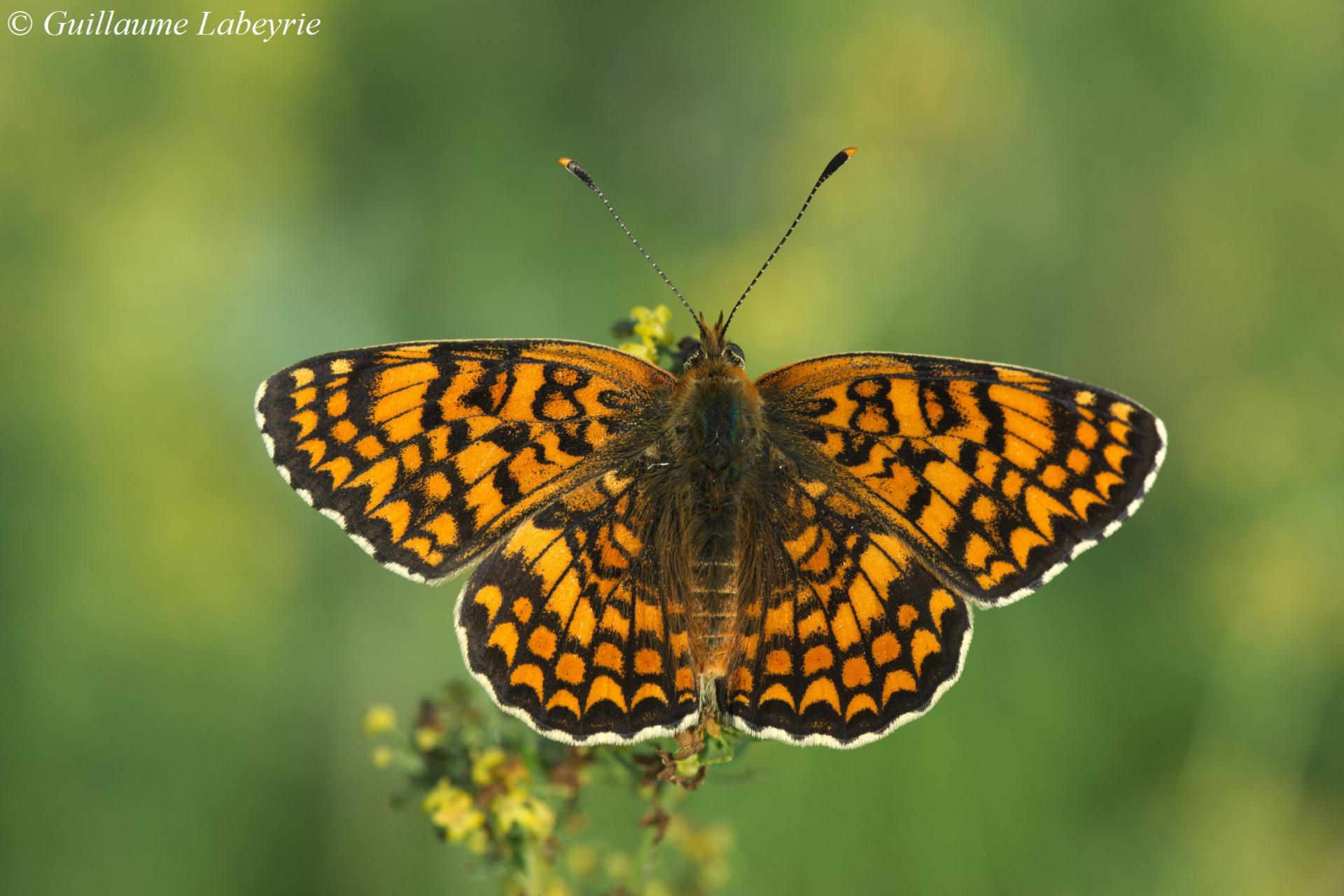 The knapweed fritillary (Melitaea phoebe). This fritillary displays a contrasted color pattern, with one of the orange spots on the edge of the upper wing distinctively larger than the others. This butterfly is widespread from North Africa to China, including most of the French territory.
The knapweed fritillary (Melitaea phoebe). This fritillary displays a contrasted color pattern, with one of the orange spots on the edge of the upper wing distinctively larger than the others. This butterfly is widespread from North Africa to China, including most of the French territory.
Family : Nymphalidae / Sub-Family : Heliconiinae
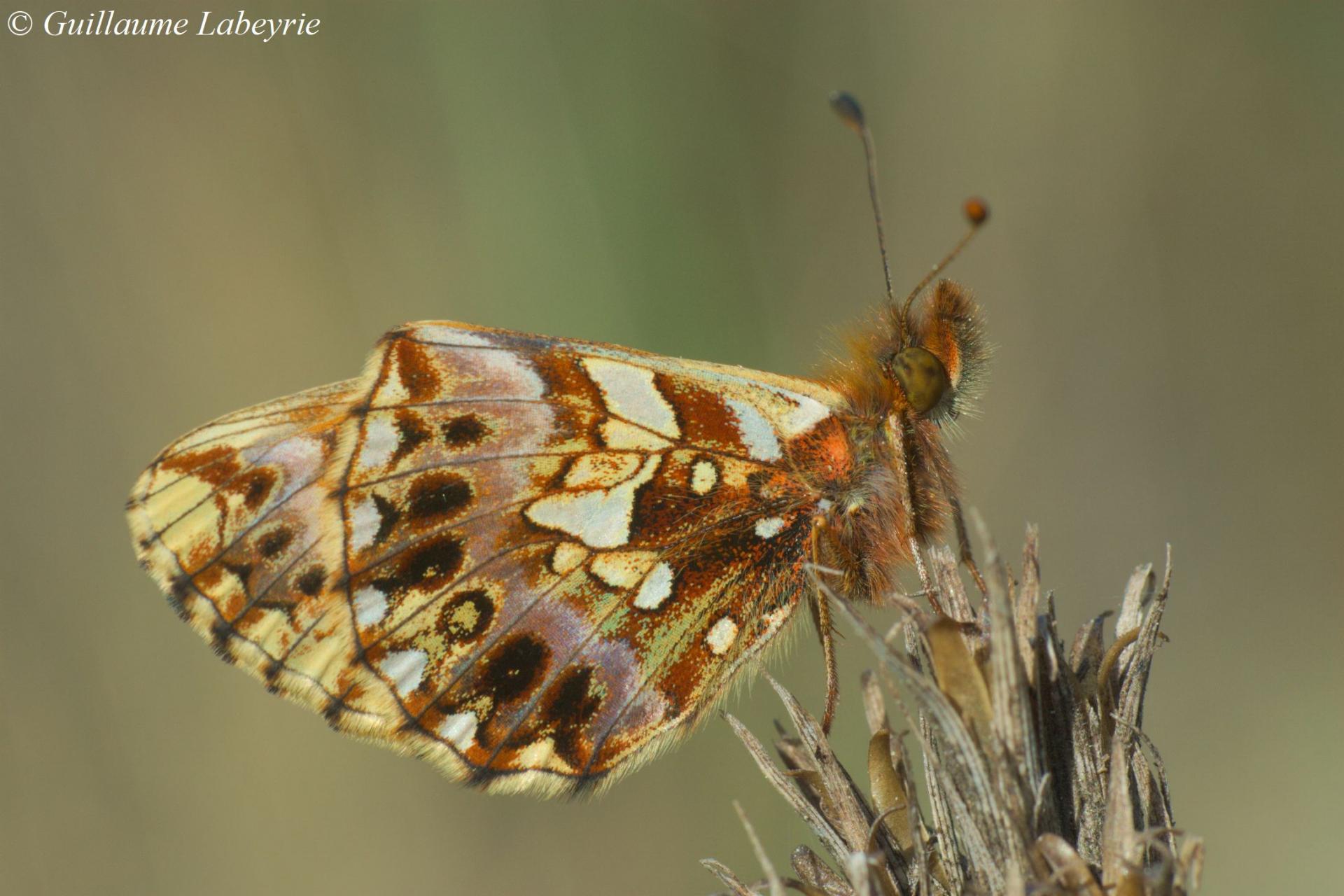 Weaver's fritillary (Boloria dia). This pretty species is recognizable by the distinctive purple band of its underside. It flies in spring in flower-rich meadows and clear undergrowth. The caterpillars feed on various violet species. This fritillary is widespread from Europe to Mongolia.
Weaver's fritillary (Boloria dia). This pretty species is recognizable by the distinctive purple band of its underside. It flies in spring in flower-rich meadows and clear undergrowth. The caterpillars feed on various violet species. This fritillary is widespread from Europe to Mongolia.
Family : Nymphalidae / Sub-Family : Satyrinae
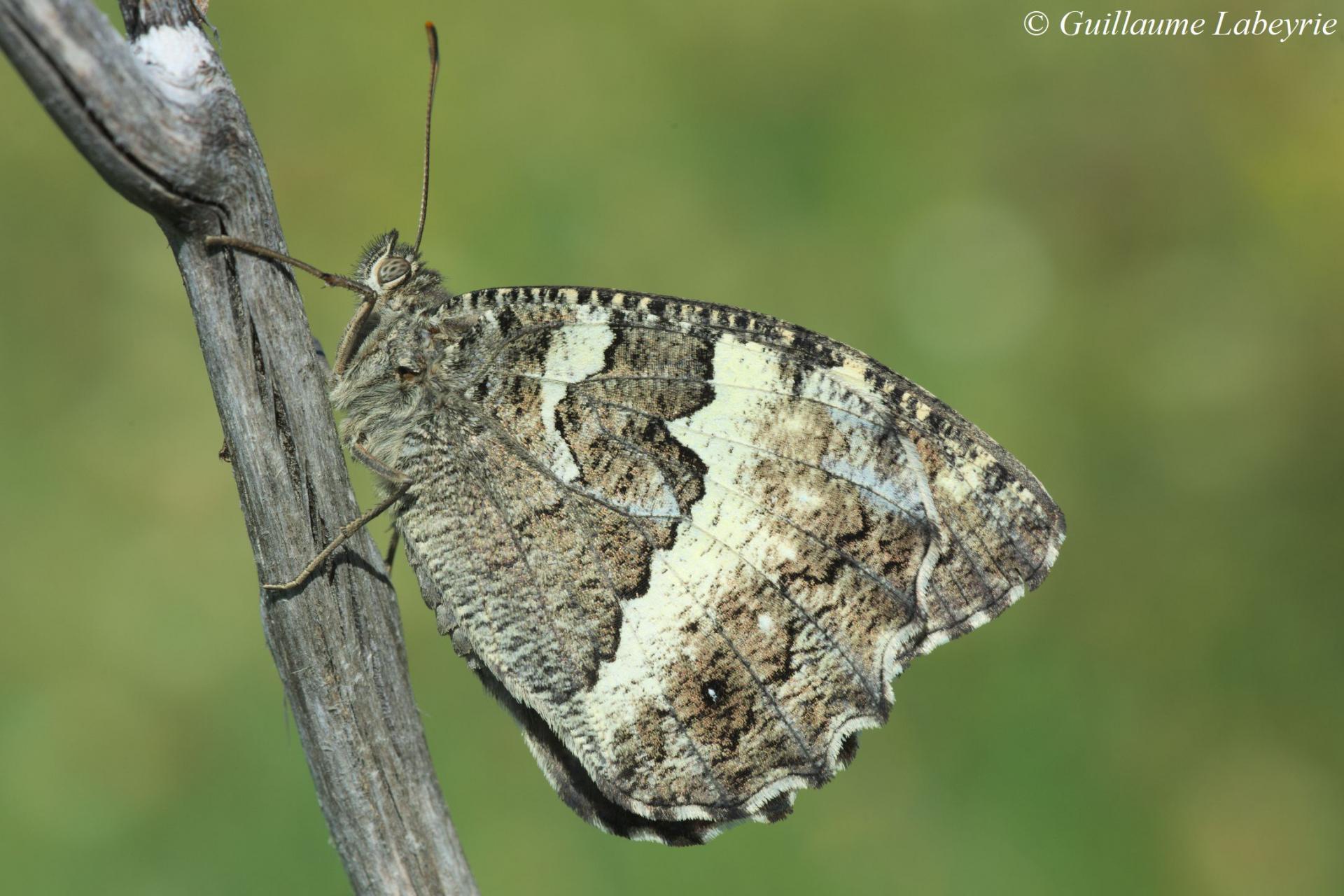 The great banded grayling (Brintesia circe). This species is our largest Satyrinae, and one of our largest butterflies. The wing's upperside, visible in flight, is brown with a wide white stripe. This grayling often perches with folded wings on tree bark, where its markings make it difficult to spot. This butterfly of southern and central Europe occurs in most of the French territory, except the north-west.
The great banded grayling (Brintesia circe). This species is our largest Satyrinae, and one of our largest butterflies. The wing's upperside, visible in flight, is brown with a wide white stripe. This grayling often perches with folded wings on tree bark, where its markings make it difficult to spot. This butterfly of southern and central Europe occurs in most of the French territory, except the north-west.
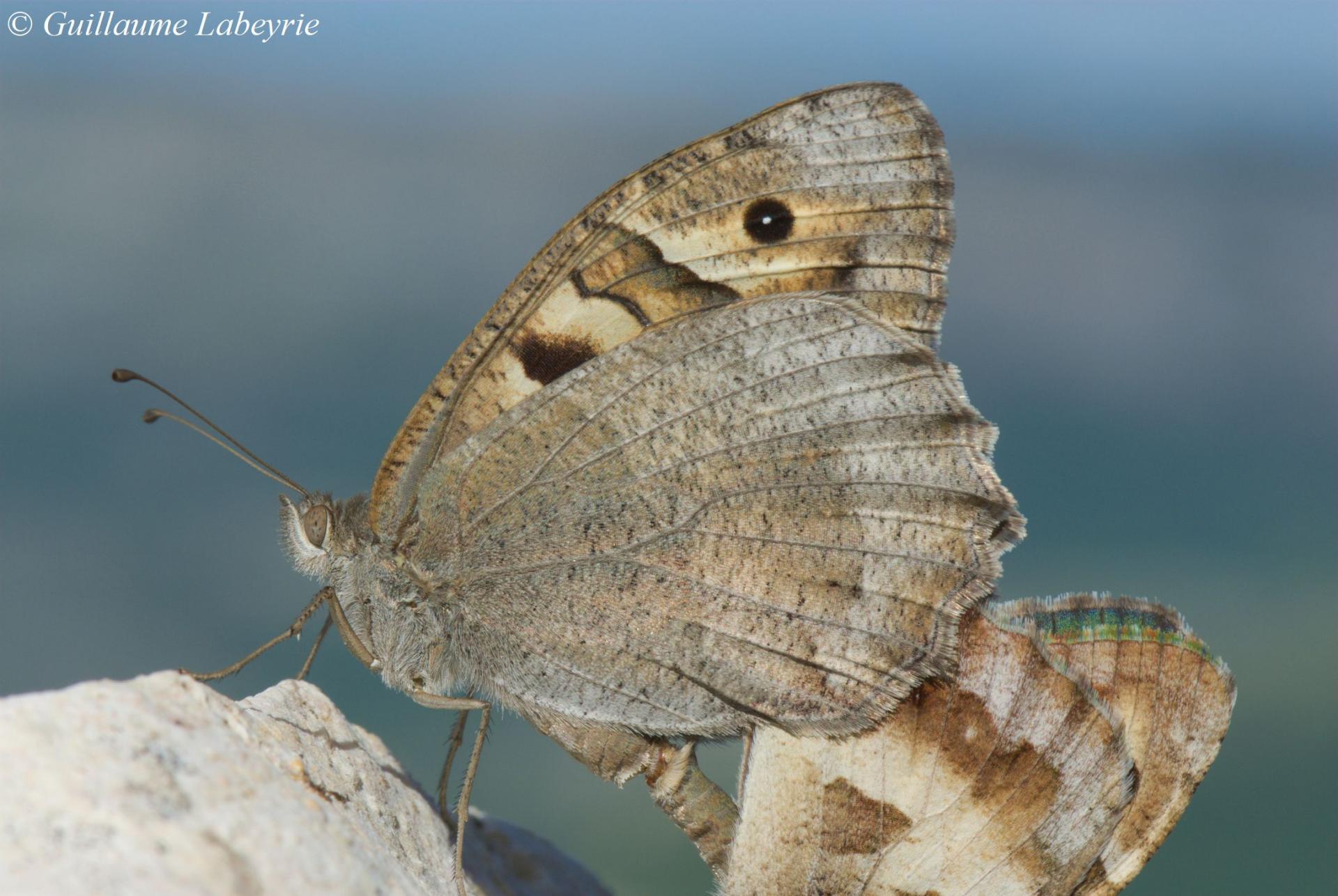 The Hermit (Chazara briseis). The Hermit belongs to the Satyrinae family, which includes meridional butterflies with brown and white colors, very mimetic when at rest with their wings folded. This species is found around the Mediterranean, expanding eastward to China. In Europe, populations form scattered islands, and the species, declining, is considered vulnerable and listed as such in France by IUCN.
The Hermit (Chazara briseis). The Hermit belongs to the Satyrinae family, which includes meridional butterflies with brown and white colors, very mimetic when at rest with their wings folded. This species is found around the Mediterranean, expanding eastward to China. In Europe, populations form scattered islands, and the species, declining, is considered vulnerable and listed as such in France by IUCN.
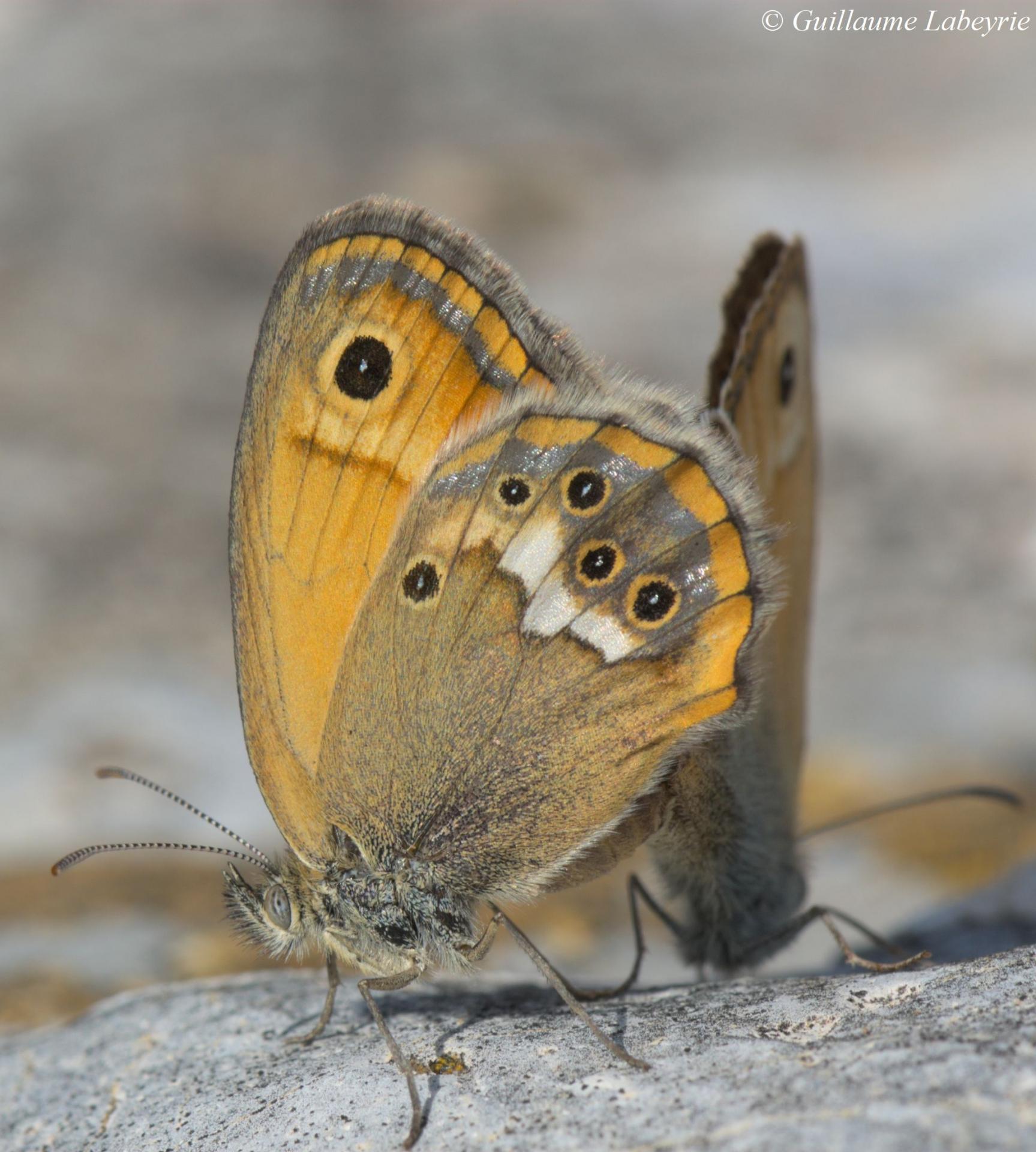 The dusky heath (Coenonympha dorus). Heaths are small-size members of the Satyrinae familly, usually showing eyespots and metallic-looking stripes on the underwing. The dusky heath is a mediterranean species restricted to Spain, southern France and western Italy, and to northwestern Africa.
The dusky heath (Coenonympha dorus). Heaths are small-size members of the Satyrinae familly, usually showing eyespots and metallic-looking stripes on the underwing. The dusky heath is a mediterranean species restricted to Spain, southern France and western Italy, and to northwestern Africa.
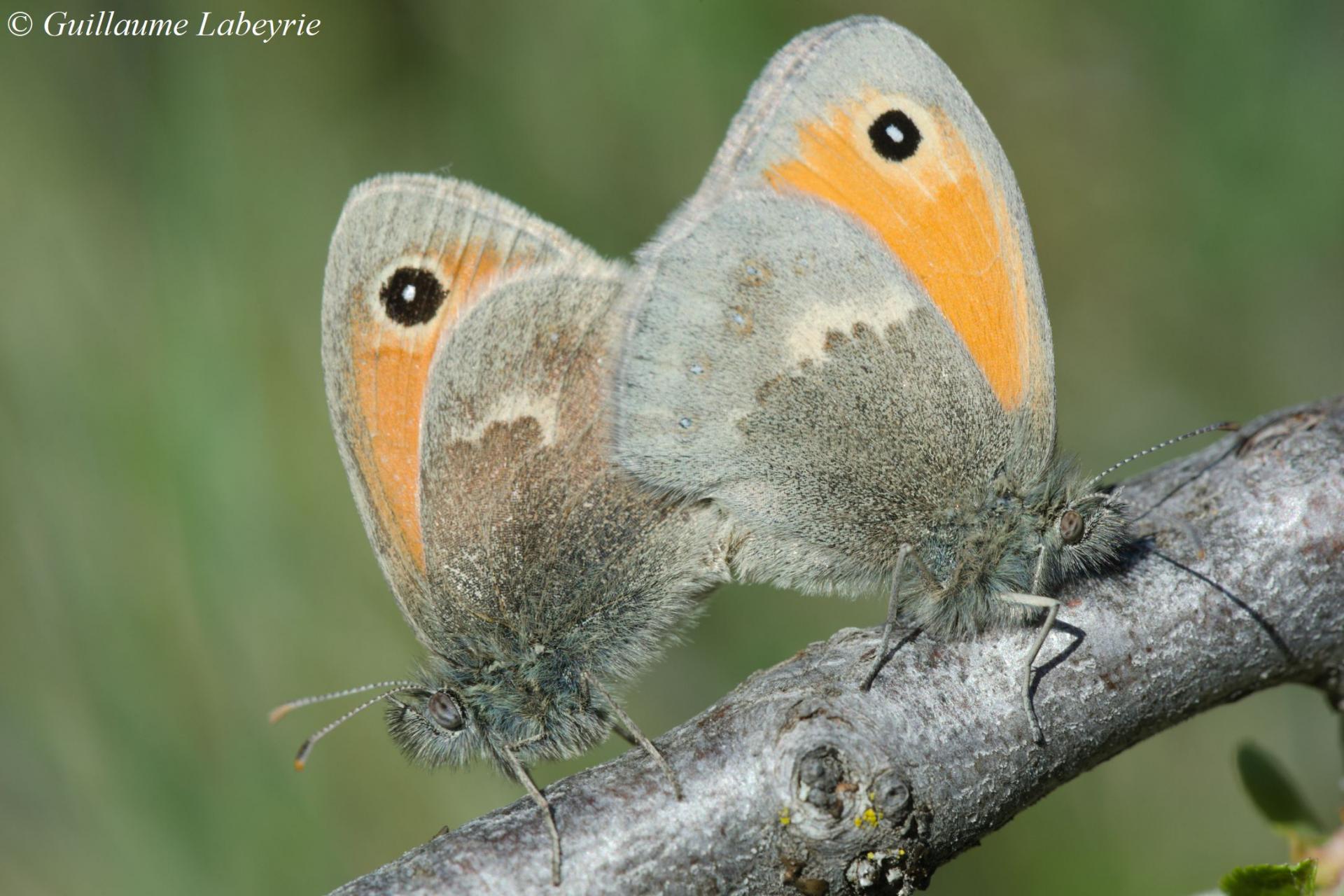 The small heath (Coenonympha pamphilus). This small species lacks the metallic stripe found in most members of this genus. It is a common butterfly, widespread in most of Europe and in North Africa.
The small heath (Coenonympha pamphilus). This small species lacks the metallic stripe found in most members of this genus. It is a common butterfly, widespread in most of Europe and in North Africa.
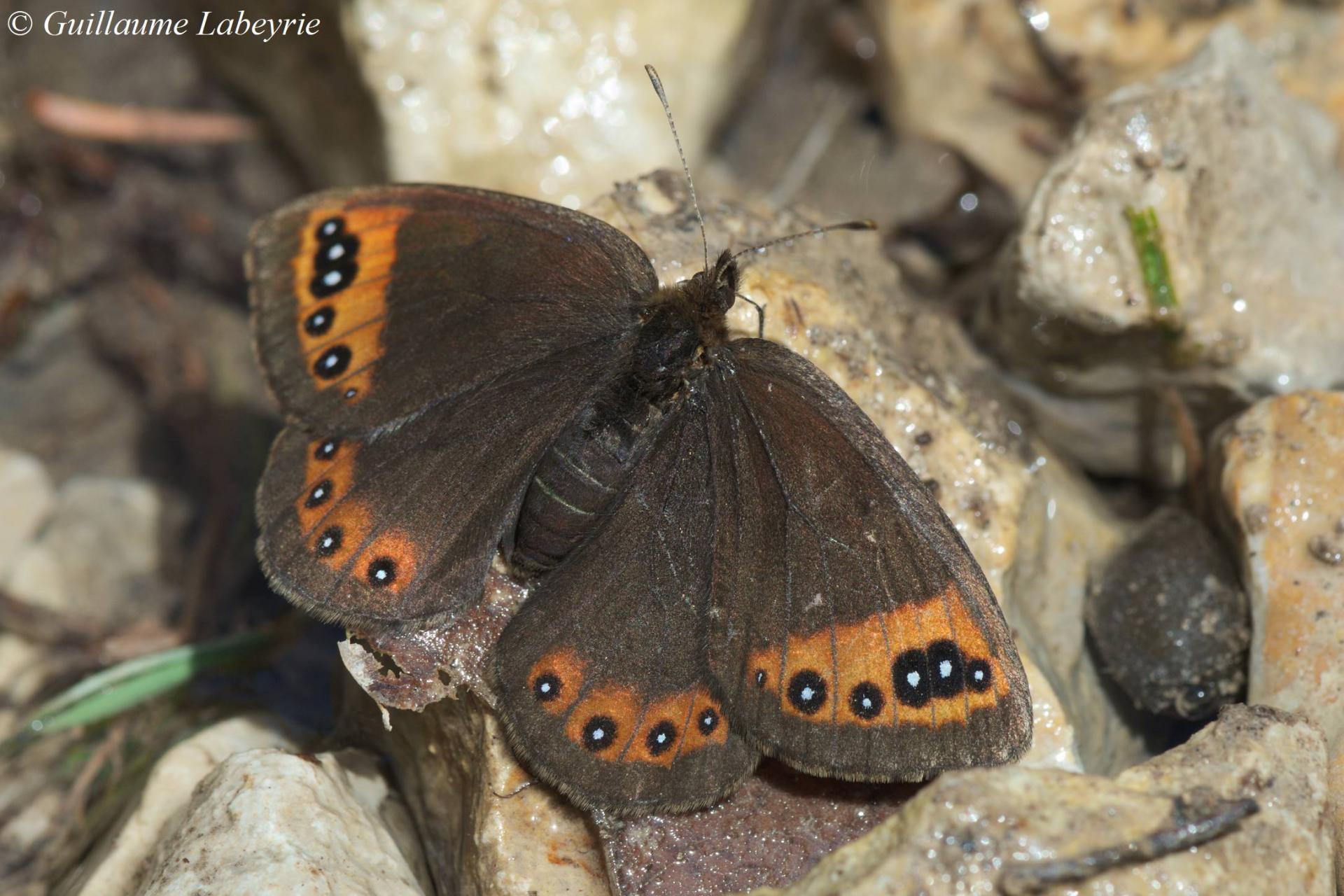 The de Prunner's ringlet (Erebia triarius). This is also a species flying in spring, in clearing of Scots pine woods. Both wings display a distinctive set of black spots with white highlights. In France, this butterfly occurs in the Pyrenees and the Alps.
The de Prunner's ringlet (Erebia triarius). This is also a species flying in spring, in clearing of Scots pine woods. Both wings display a distinctive set of black spots with white highlights. In France, this butterfly occurs in the Pyrenees and the Alps.
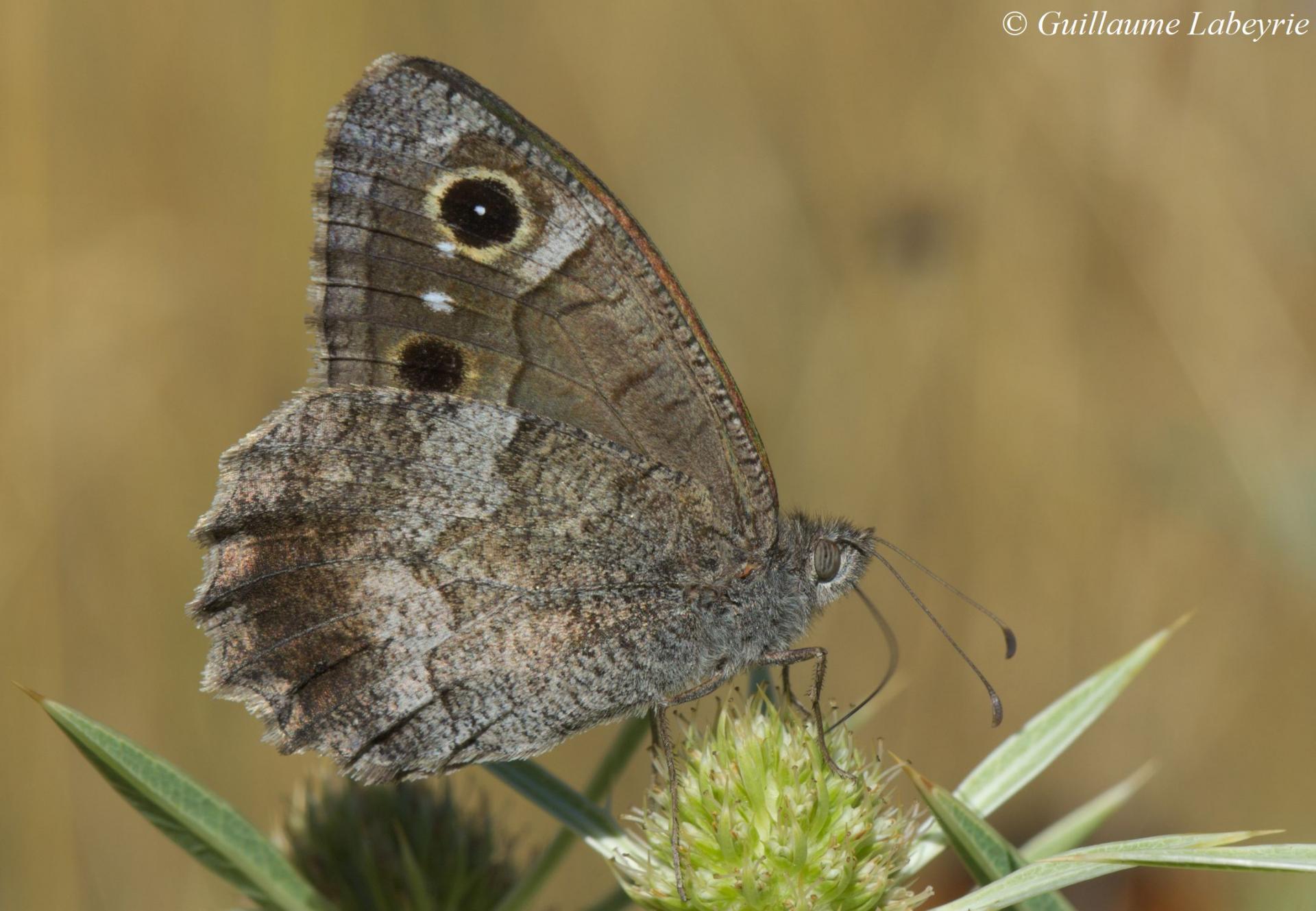 The tree grayling (Neohipparchia statilinus). This rather large species shows distinctive eyespots on the underside of the forewings. It is found in dry and rocky places, starting from the end of july. The tree grayling occurs in southern Europe, Turkey and Northern Africa.
The tree grayling (Neohipparchia statilinus). This rather large species shows distinctive eyespots on the underside of the forewings. It is found in dry and rocky places, starting from the end of july. The tree grayling occurs in southern Europe, Turkey and Northern Africa.
Family : Zygaenidae
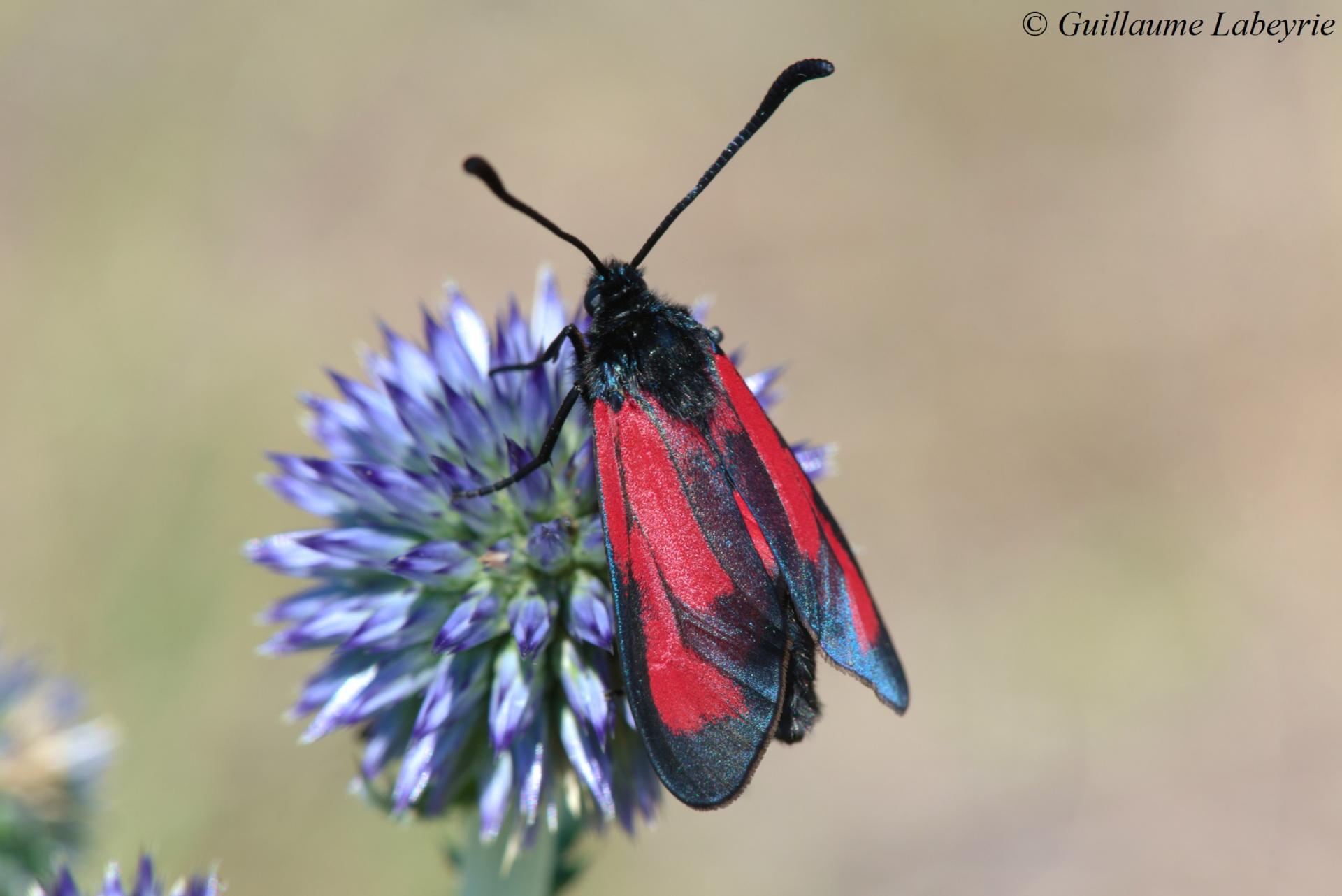
The sluggish burnet (Zygaena erythrus). This large burnet has confluent spots on the forewings resulting in three broad red stripes. A distinctive character is the presence of red scales in the axillary area of the forwings, near the thorax. This species with a restricted range (France and Italy) occurs in France only in the South-East.
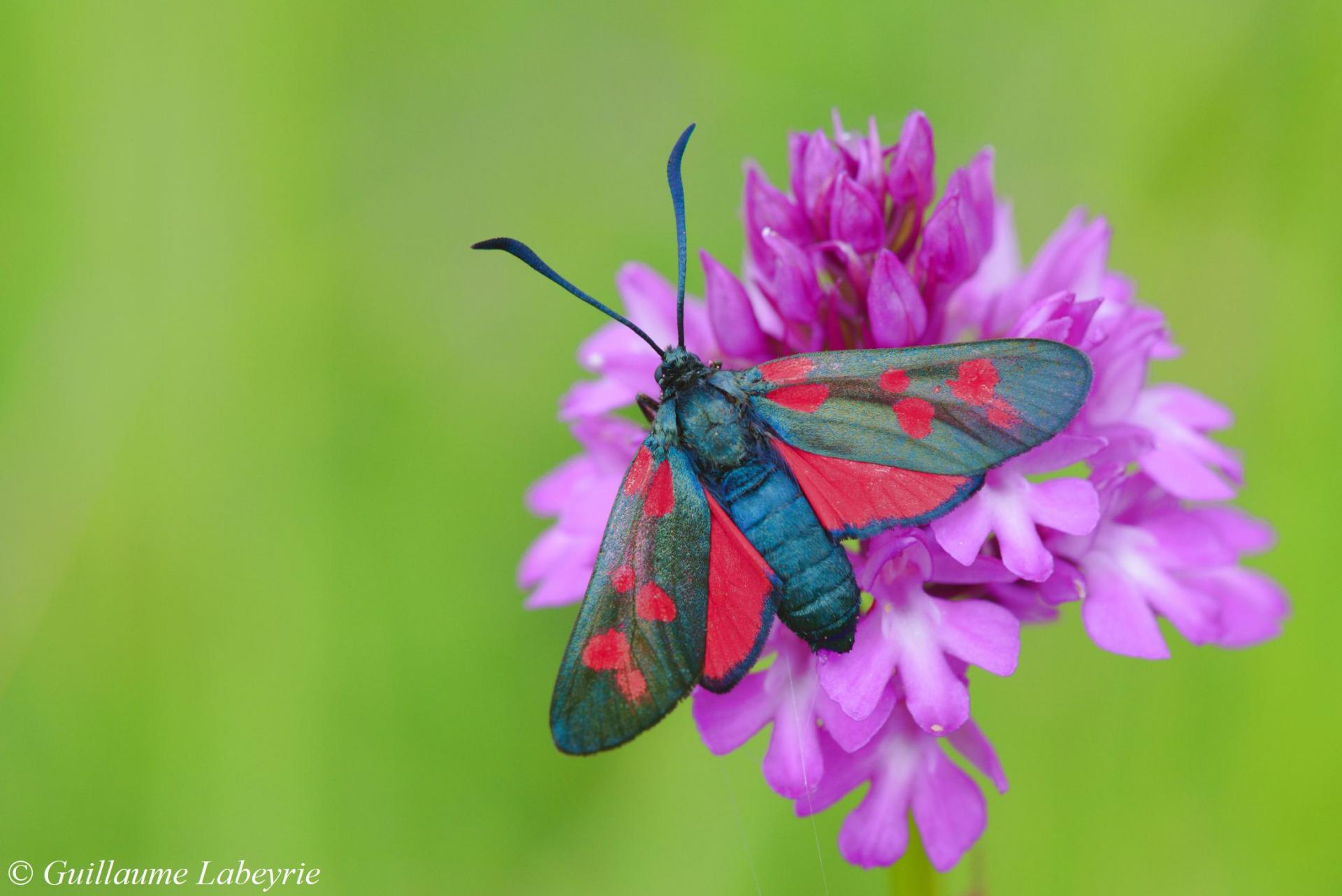 Zygaena viciae subsp. charon. This subspecies occurs, in France, only in the meridional Alps. It is characterized by six spots on the wings, while other subspecies of Z. viciae have only five. This burnet can be observed, in the Grasse Prealps, in June.
Zygaena viciae subsp. charon. This subspecies occurs, in France, only in the meridional Alps. It is characterized by six spots on the wings, while other subspecies of Z. viciae have only five. This burnet can be observed, in the Grasse Prealps, in June.
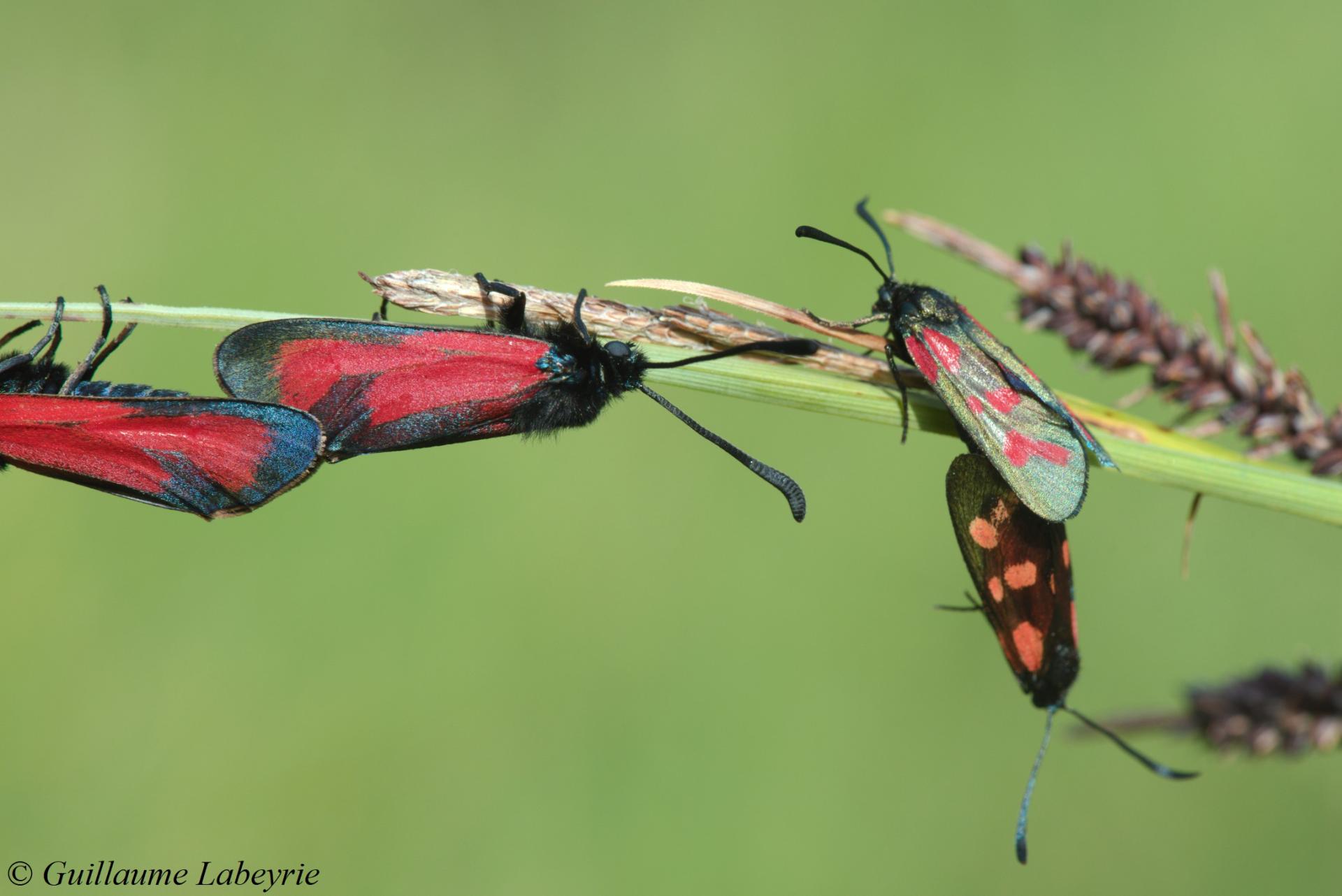
Zygaena erythrus and Zygaena viciae subsp. charon. This photo shows the large size difference between these two species.
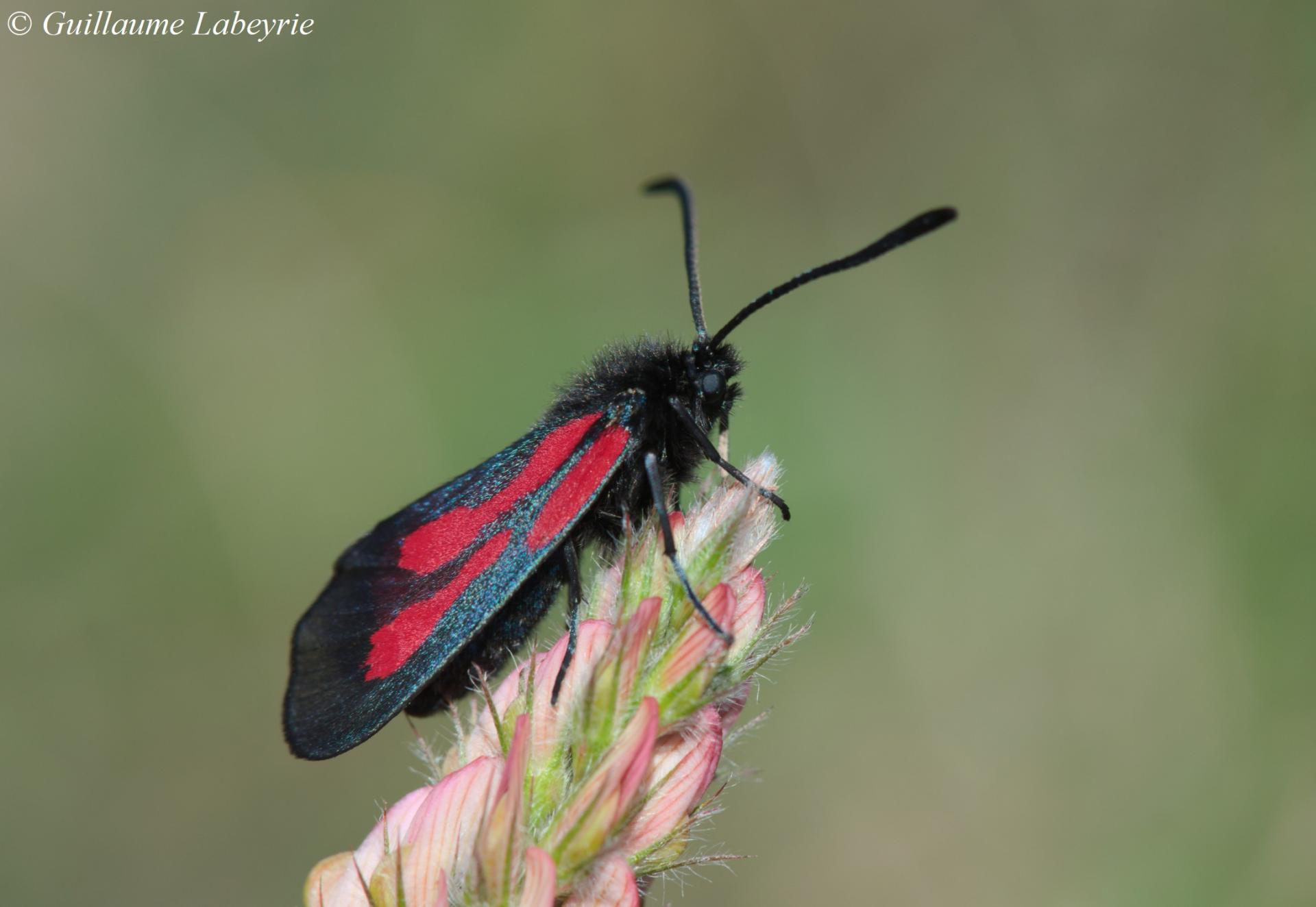 Zygaena romeo. Quite similar to the previous species, this burnet is larger and has less translucent wings. It is present in France in a southern half of the territory, and in Italy.
Zygaena romeo. Quite similar to the previous species, this burnet is larger and has less translucent wings. It is present in France in a southern half of the territory, and in Italy.
 The slender Scotch burnet (Zygaena loti). In this burnet species, the two red spots near the tip of the forewing merge. This burnet occurs on limestone grounds, in most of France except Britanny.
The slender Scotch burnet (Zygaena loti). In this burnet species, the two red spots near the tip of the forewing merge. This burnet occurs on limestone grounds, in most of France except Britanny.
Family : Erebidae
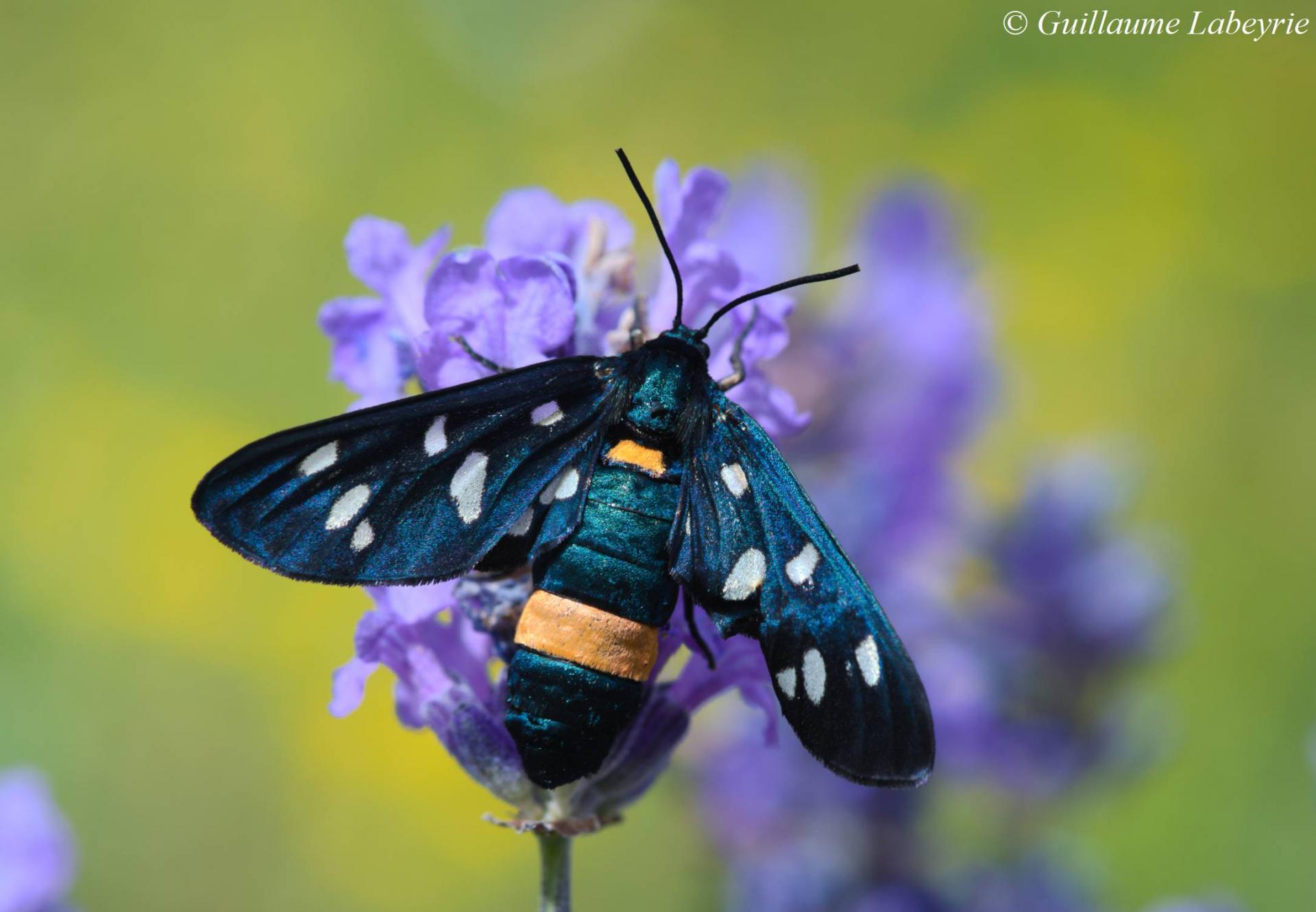 The nine-spotted moth (Amata phegea). This moth has a striking pattern of white spots on black wings. The yellow ring on the dark abdomen is distinctive. Quite local in the Préalpes de Grasse, this species flies in summer above dry slopes. It is mainly present in southern Europe, up to Anatolia and the Caucasus. In France, it occurs in the Alps.
The nine-spotted moth (Amata phegea). This moth has a striking pattern of white spots on black wings. The yellow ring on the dark abdomen is distinctive. Quite local in the Préalpes de Grasse, this species flies in summer above dry slopes. It is mainly present in southern Europe, up to Anatolia and the Caucasus. In France, it occurs in the Alps.
Family : Adelidae
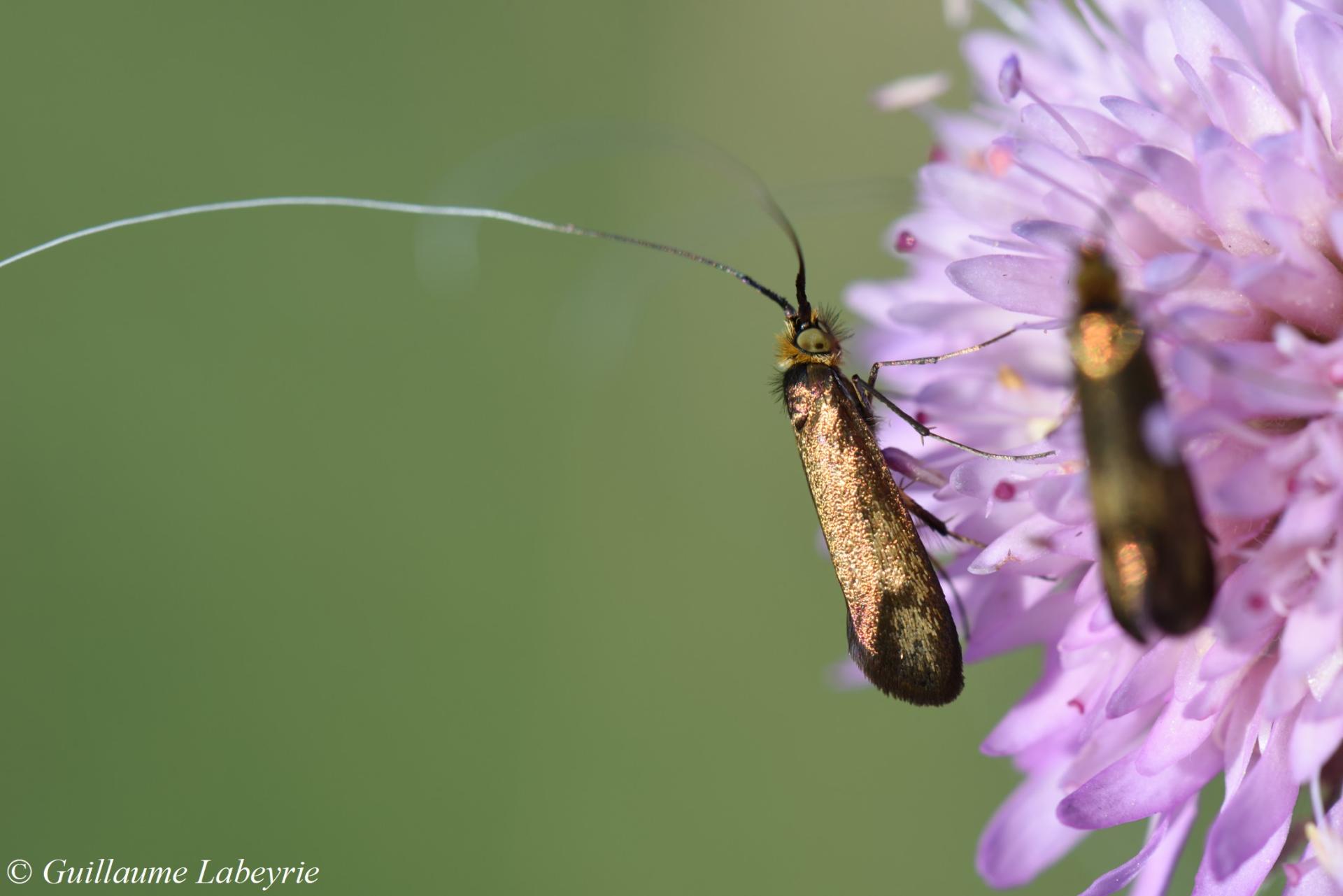 Fairy longhorn moth (Nemophora metallica). The fairy longhorn moths are tiny moths with metallic colors and oversized antennae. Nemophora metallica has uniform golden wings and a tuft of orange hairs on the head. The antennae are two-colored, black and white. This species is generally observed on Scabiosa species, on which its caterpillar feeds. This moth is widespread in France and Europe.
Fairy longhorn moth (Nemophora metallica). The fairy longhorn moths are tiny moths with metallic colors and oversized antennae. Nemophora metallica has uniform golden wings and a tuft of orange hairs on the head. The antennae are two-colored, black and white. This species is generally observed on Scabiosa species, on which its caterpillar feeds. This moth is widespread in France and Europe.
Phasmids
Three species of these strange insects are found in France. Highly mimic, slow-moving and mostly nocturnal, they are seldom spotted.
Family : Diapheromeridae
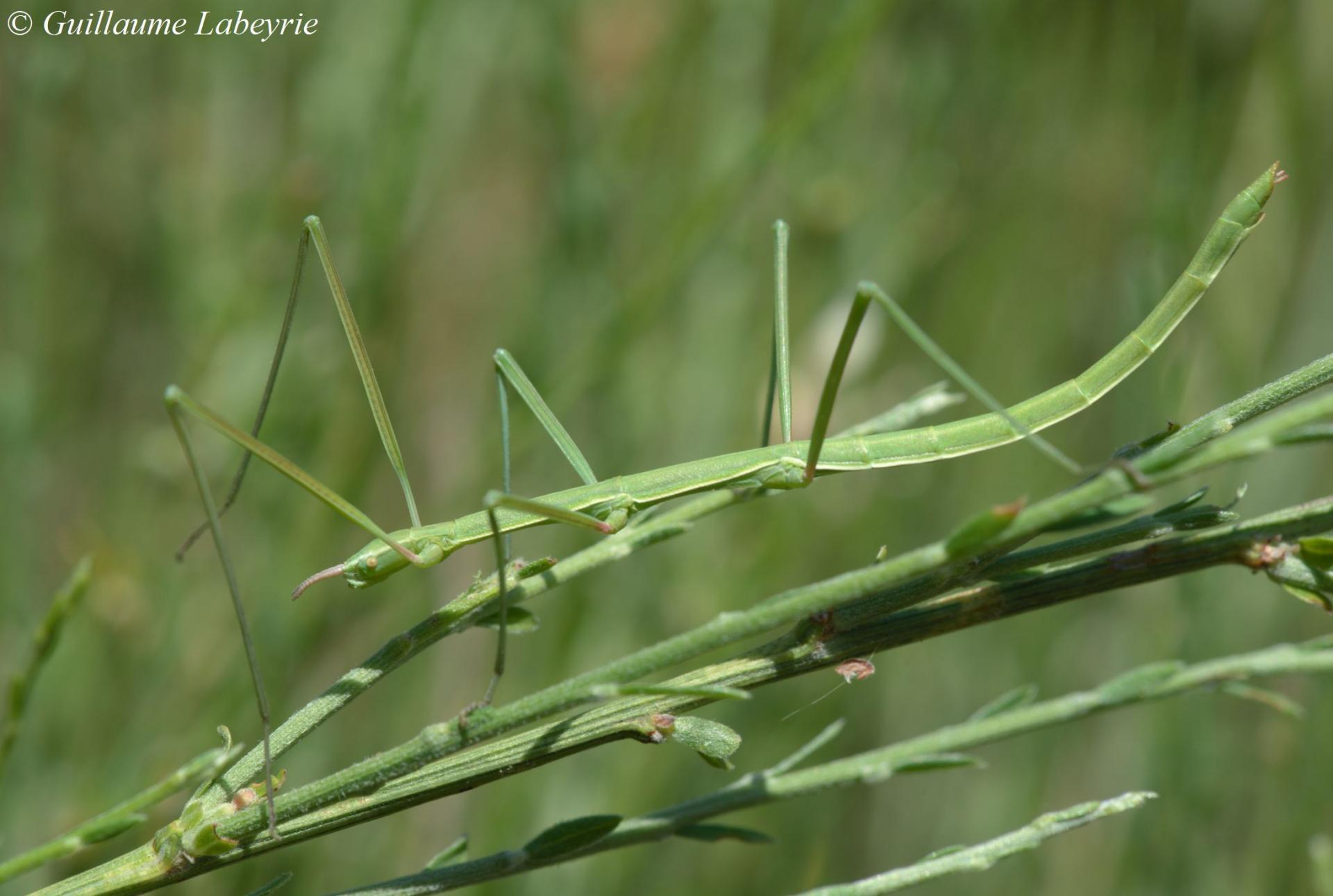 The Spanish stick insect (Pijnackeria masettii). This phasmid has a small size (55 mm without legs), short antennas, and a thin white line along its body. In France, it reproduces by parthenogenesis so that only females are present. In the Préalpes de Grasse, this insect seems to feed on the broom Genista cinerea, instead of the usual Dorycnium pentaphyllum. The Spanish stick insect occurs in France only along the mediterranean coast.
The Spanish stick insect (Pijnackeria masettii). This phasmid has a small size (55 mm without legs), short antennas, and a thin white line along its body. In France, it reproduces by parthenogenesis so that only females are present. In the Préalpes de Grasse, this insect seems to feed on the broom Genista cinerea, instead of the usual Dorycnium pentaphyllum. The Spanish stick insect occurs in France only along the mediterranean coast.
Hemiptera
Family : Pentatomidae
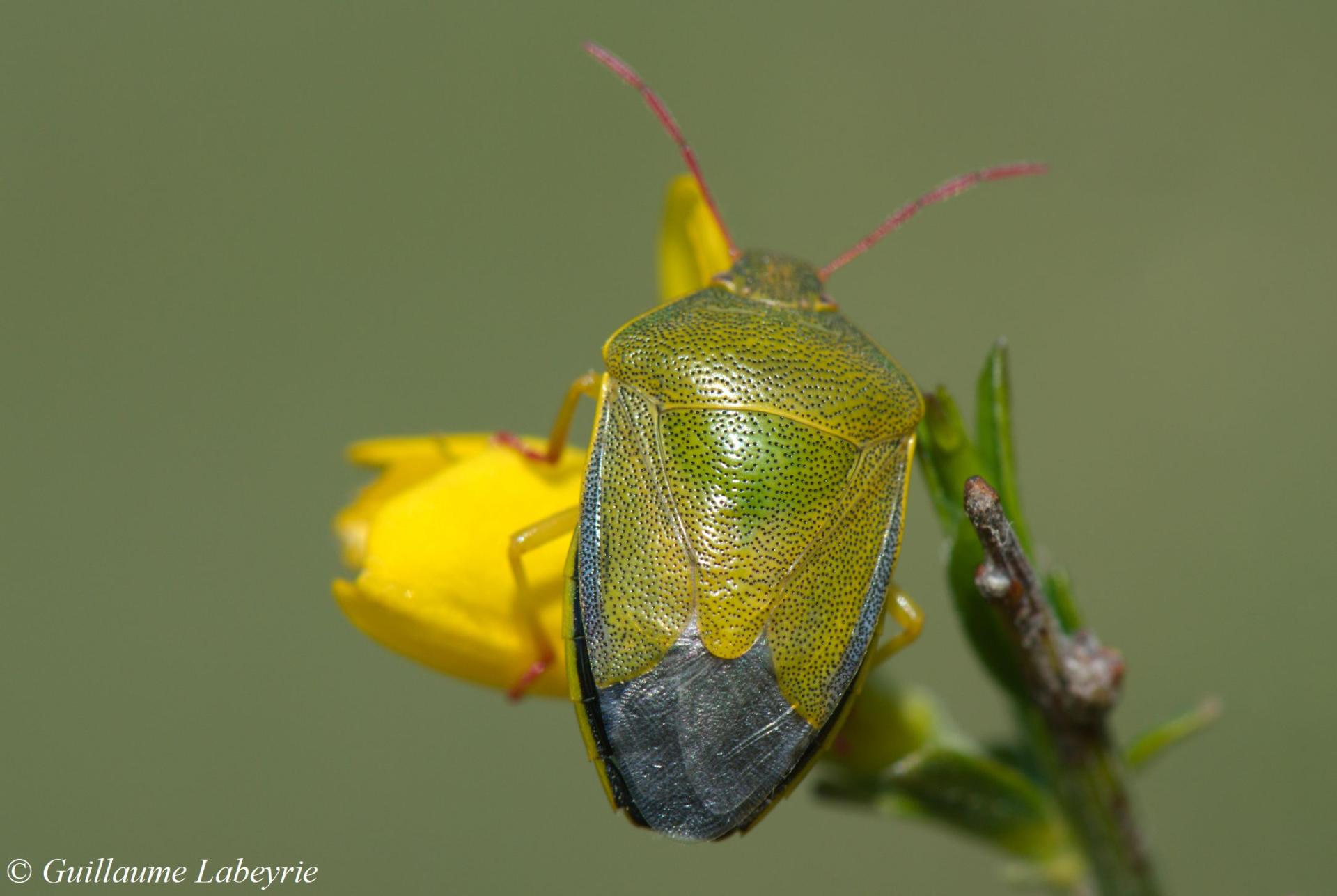
The gorse shield bug (Piezodorus lituratus). This pretty bug has a yellowish-green coloring with strong black punctuation, and red antennae. It is mainly found on the broom Genista cinerea, which populates the slopes of the Grasse Prealps. This species is found throughout Europe, Russia and the Middle East.
Orthopterans (Orthoptera)
Family : Acrididae / Sub-Family : Gomphocerinae
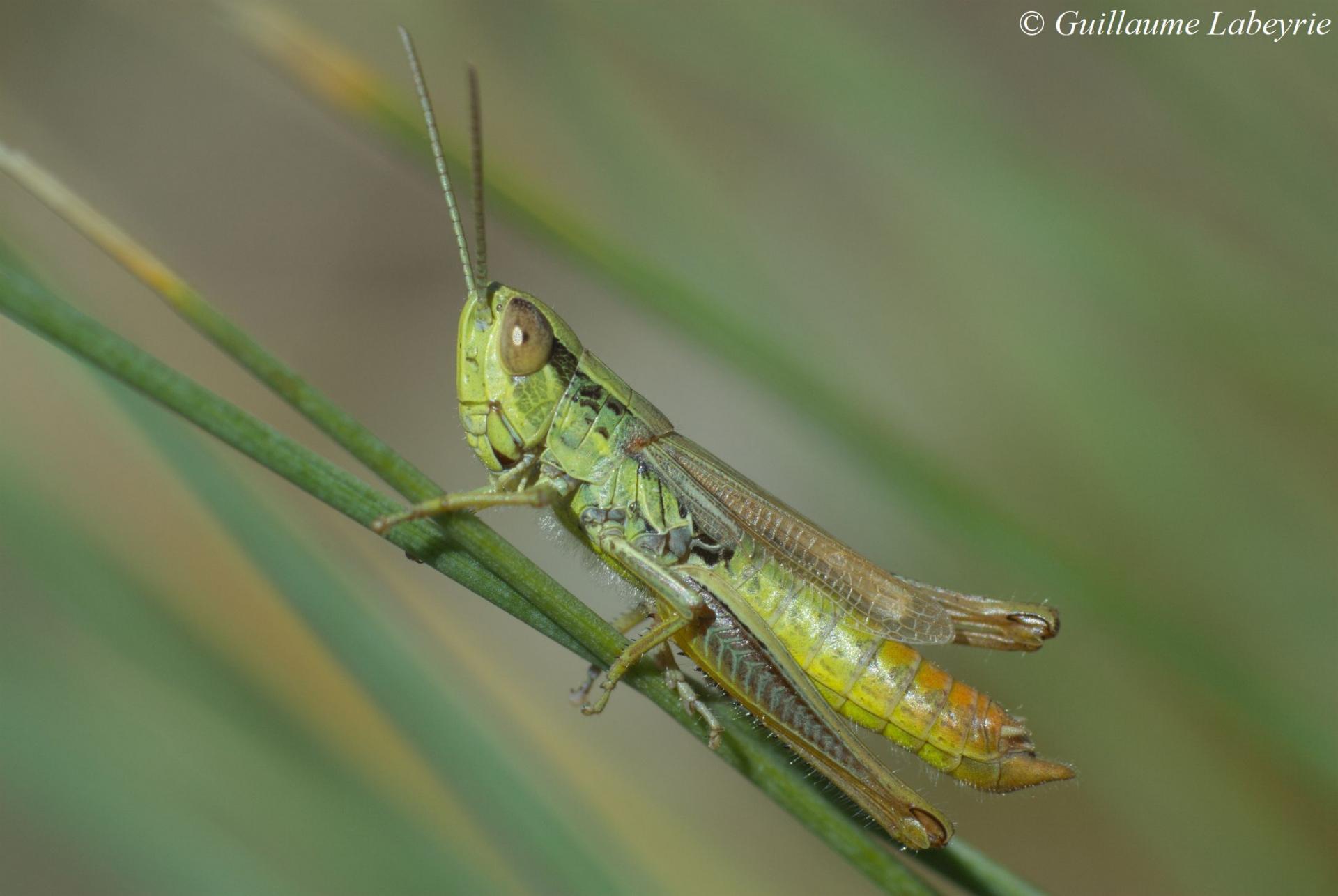 Male sharp-tailed grasshopper (Euchorthippus declivus). This species is common in most of Europe. It favors dry and rocky meadows. The male is small, with a distinctive pointed extremity of the abdomen.
Male sharp-tailed grasshopper (Euchorthippus declivus). This species is common in most of Europe. It favors dry and rocky meadows. The male is small, with a distinctive pointed extremity of the abdomen.
Female Chorthippus biggutulus. This grasshopper is present in most of France. It belongs to a group of species which are difficult to identify, especially the females.
Male Chorthippus dorsatus subsp. dorsatus. The male is often green with a red-tinted abdomen. This species is found in most of the French territory.
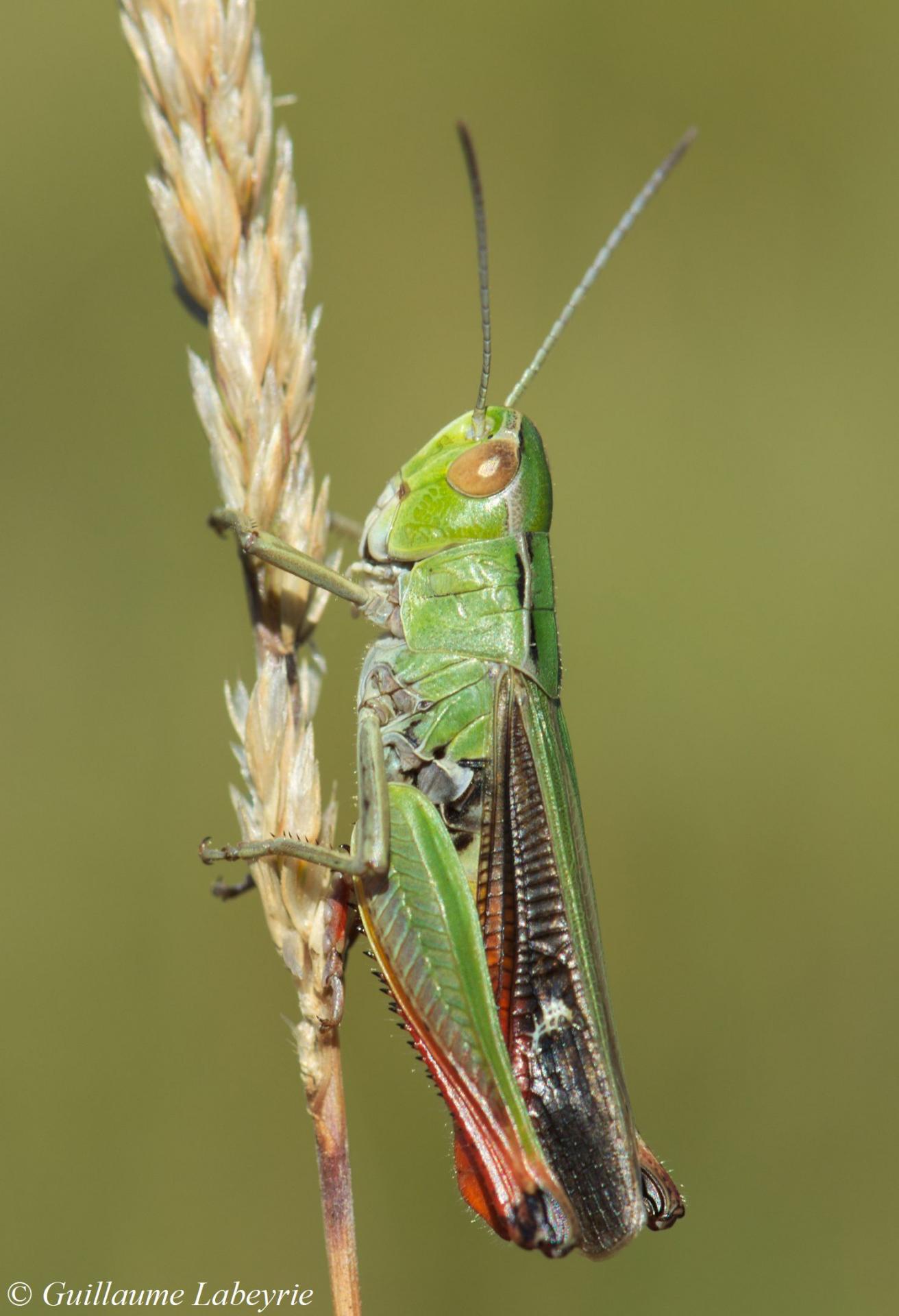 Male Stenobothrus lineatus. This widespread grasshopper exhibits a distinctive white comma on the wings. The female are sometimes very colorful. This is a common species, occuring throughout most of France.
Male Stenobothrus lineatus. This widespread grasshopper exhibits a distinctive white comma on the wings. The female are sometimes very colorful. This is a common species, occuring throughout most of France.
Family : Acrididae / Sub-Family : Catantopinae
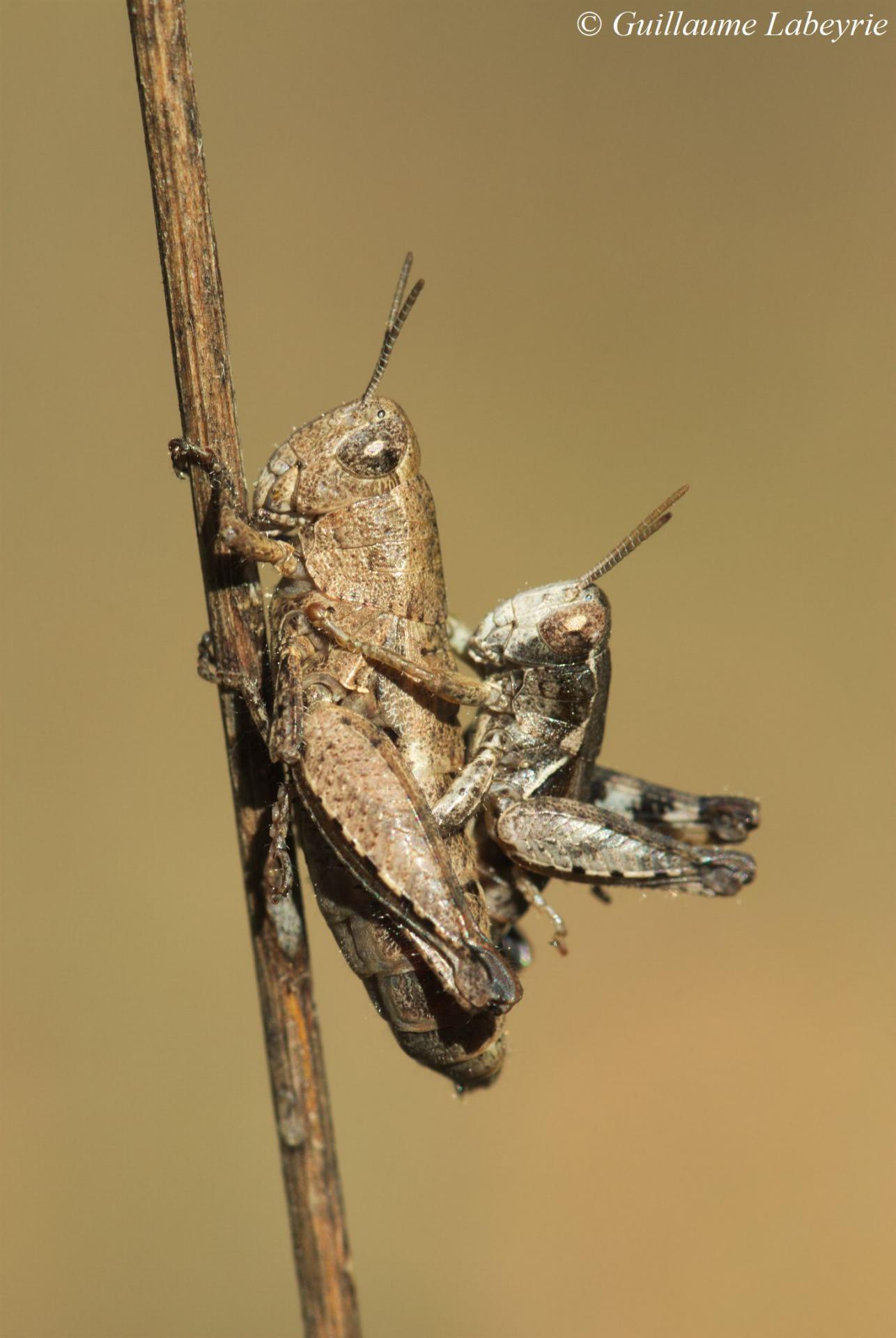 Pezotettix giornae mating. This very small grasshopper (slightly above 1 cm) is recognized by its gray color, large eyes and small wings. This species occurs all around the Mediterranean. In France, it is found in the southern half of the country.
Pezotettix giornae mating. This very small grasshopper (slightly above 1 cm) is recognized by its gray color, large eyes and small wings. This species occurs all around the Mediterranean. In France, it is found in the southern half of the country.
Several relatively wild and unpolluted rivers (Siagne, Loup, Cagne and Estéron) run through the limestone mountains of the Préalpes de Grasse. The canyons harbor unique ecosystems with a high biodiversity.
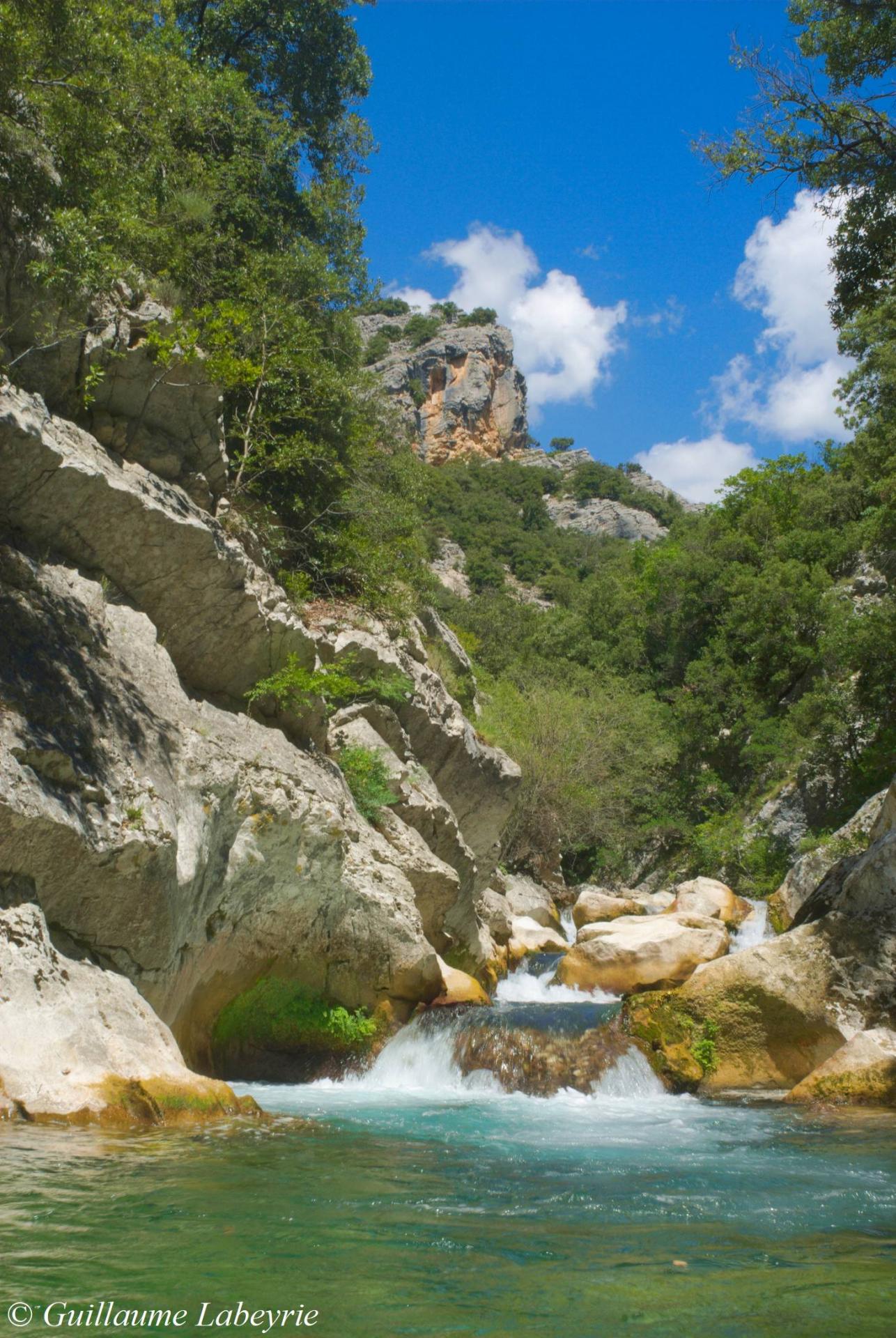
The gorges of the Siagne river. This river, still wild and unpolluted in its upper range, harbors a remarkable ecosystem including, among others, the white-clawed crayfish (Austropotamobius pallipes).
Fauna
Mammals
Family : Vespertilionidae
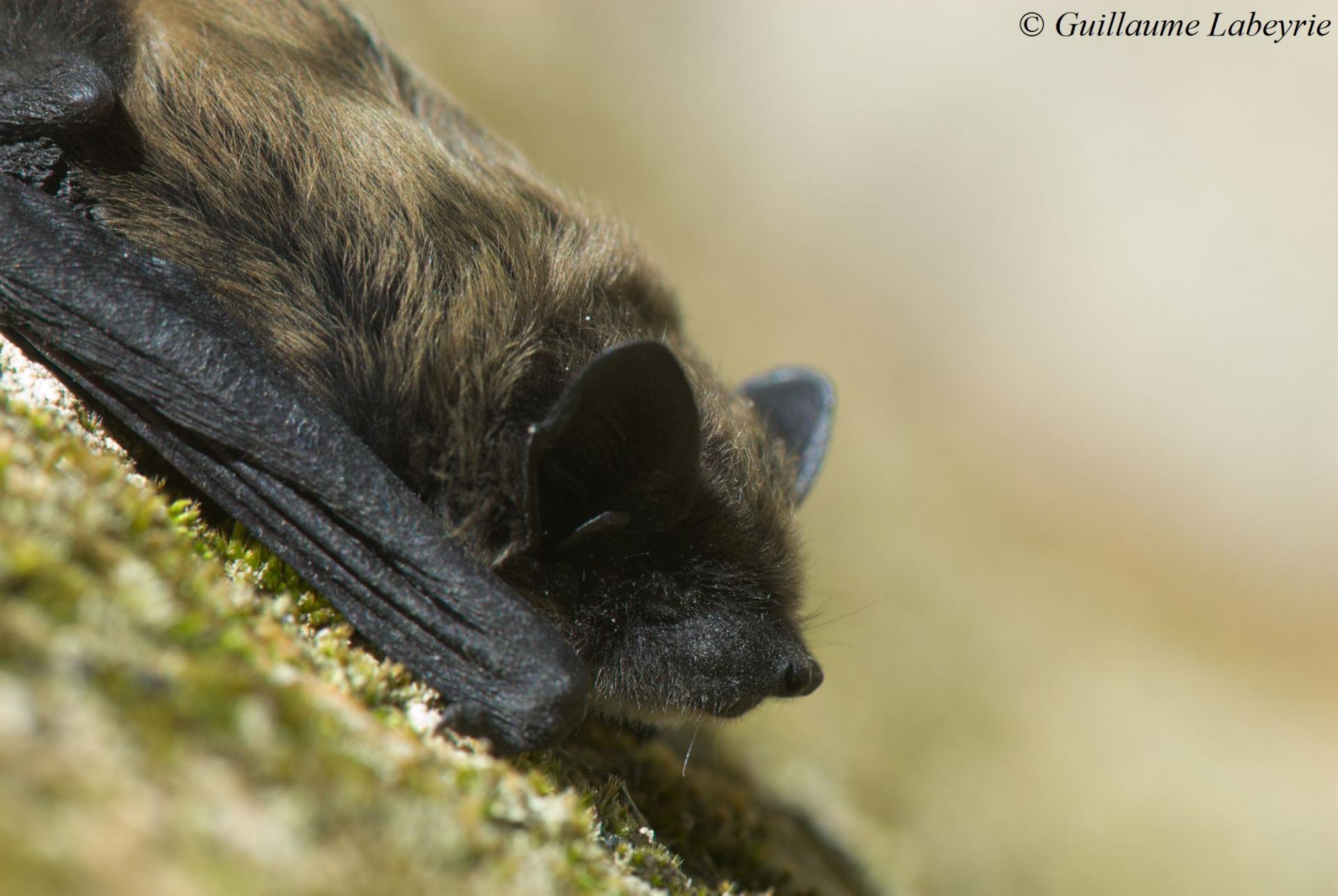 The serotine bat (Eptesicus serotinus). The PACA region harbours many bats, since 30 out of the 34 French species are found here. The serotine bat is a fairly large bat (37 cm wingspan), with a brown fur and a black skin. Widespread from Europe to south-east Asia, this species occurs everywhere in France.
The serotine bat (Eptesicus serotinus). The PACA region harbours many bats, since 30 out of the 34 French species are found here. The serotine bat is a fairly large bat (37 cm wingspan), with a brown fur and a black skin. Widespread from Europe to south-east Asia, this species occurs everywhere in France.
Reptiles
Family : Natricidae
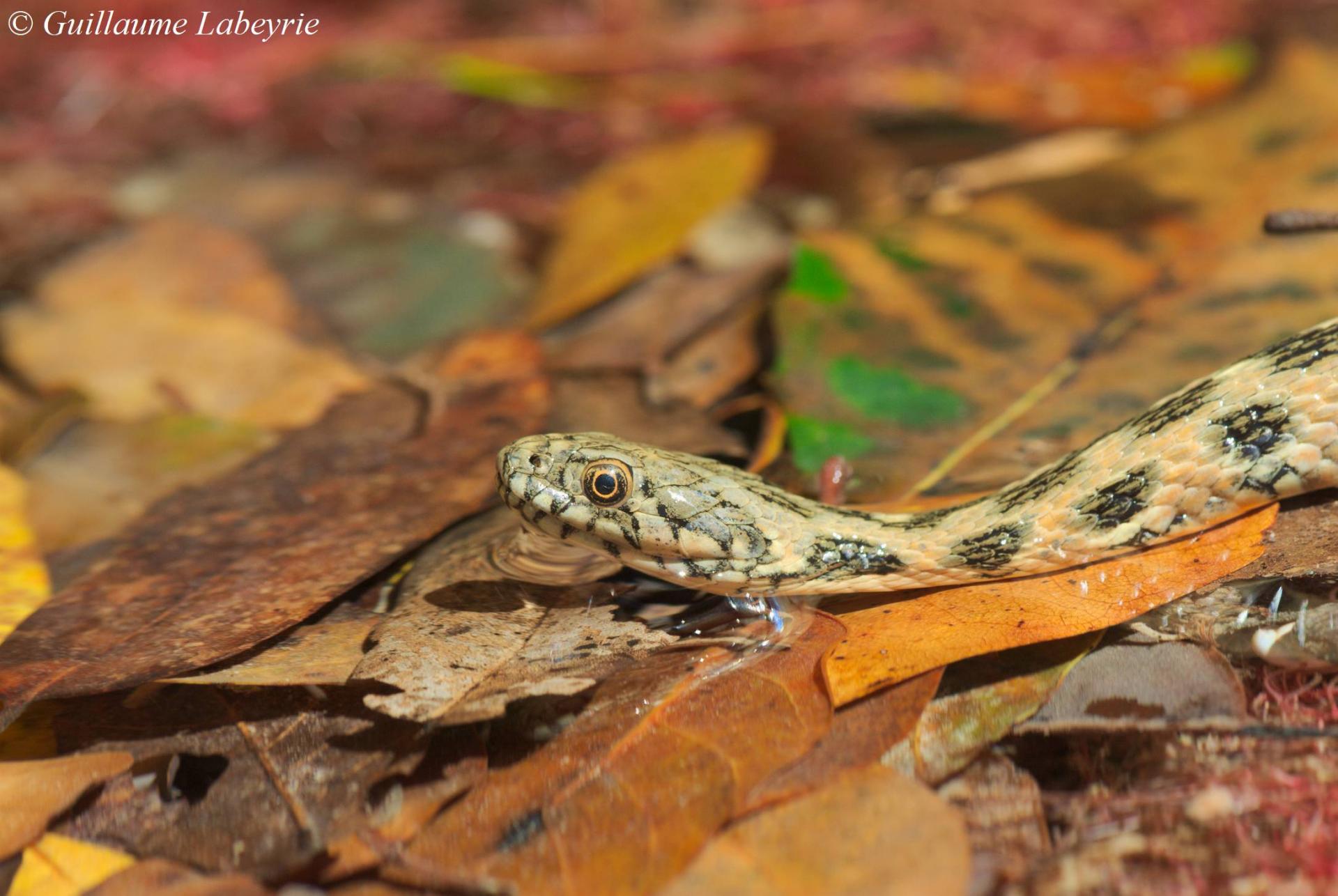 The viperine water snake (Natrix maura). This species belongs, together with the barred grass snake (Natrix helvetica) shown below, to the two species of aquatic snakes in France. The colour of this rather small snake (up to 60 cm) varies depending on habitat, from grey to brown and even reddish. The viperine water snake is distributed in western Europe and northern Africa. It feeds on various amphibians and fishes (a young trout on this photo). Totally harmless for man, it is still sometimes confused with a viper (despite the fact that vipers are never observed in water) and destroyed. This snake, however, is fully protected in France.
The viperine water snake (Natrix maura). This species belongs, together with the barred grass snake (Natrix helvetica) shown below, to the two species of aquatic snakes in France. The colour of this rather small snake (up to 60 cm) varies depending on habitat, from grey to brown and even reddish. The viperine water snake is distributed in western Europe and northern Africa. It feeds on various amphibians and fishes (a young trout on this photo). Totally harmless for man, it is still sometimes confused with a viper (despite the fact that vipers are never observed in water) and destroyed. This snake, however, is fully protected in France.
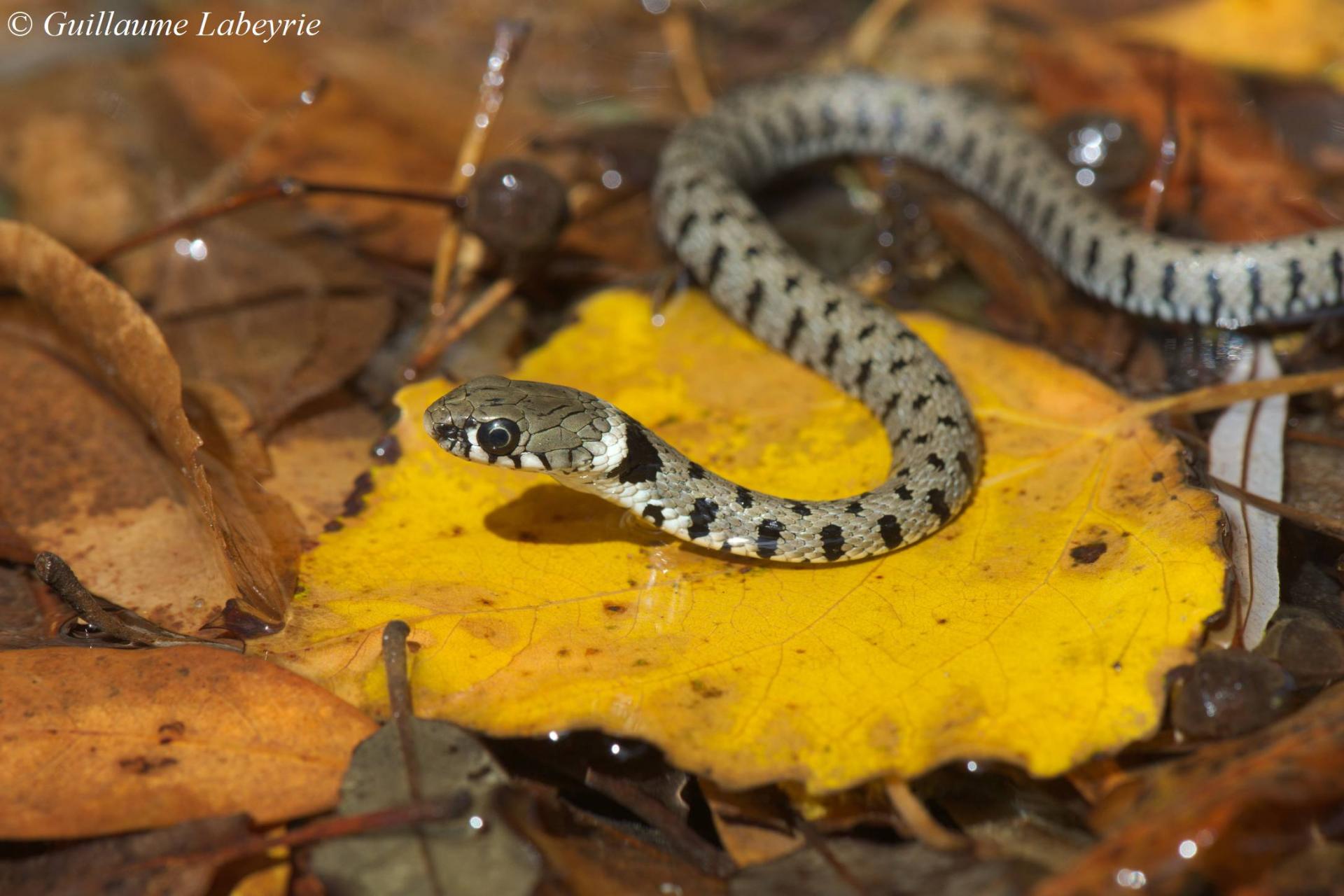 The barred grass snake (Natrix helvetica). After a genetic study published in 2017, it was determined that the French populations of this water snake belong to Natrix helvetica instead of Natrix natrix, which occurs in the northern and eastern part of Europe. This nice species differs from Natrix maura by its grey color, with a black and white "necklace" pattern at the neck. It is also usually larger, reaching over 1 m. The two species share the same habitat and sometimes cohabitate.
The barred grass snake (Natrix helvetica). After a genetic study published in 2017, it was determined that the French populations of this water snake belong to Natrix helvetica instead of Natrix natrix, which occurs in the northern and eastern part of Europe. This nice species differs from Natrix maura by its grey color, with a black and white "necklace" pattern at the neck. It is also usually larger, reaching over 1 m. The two species share the same habitat and sometimes cohabitate.
Amphibians
Family : Bufonidae
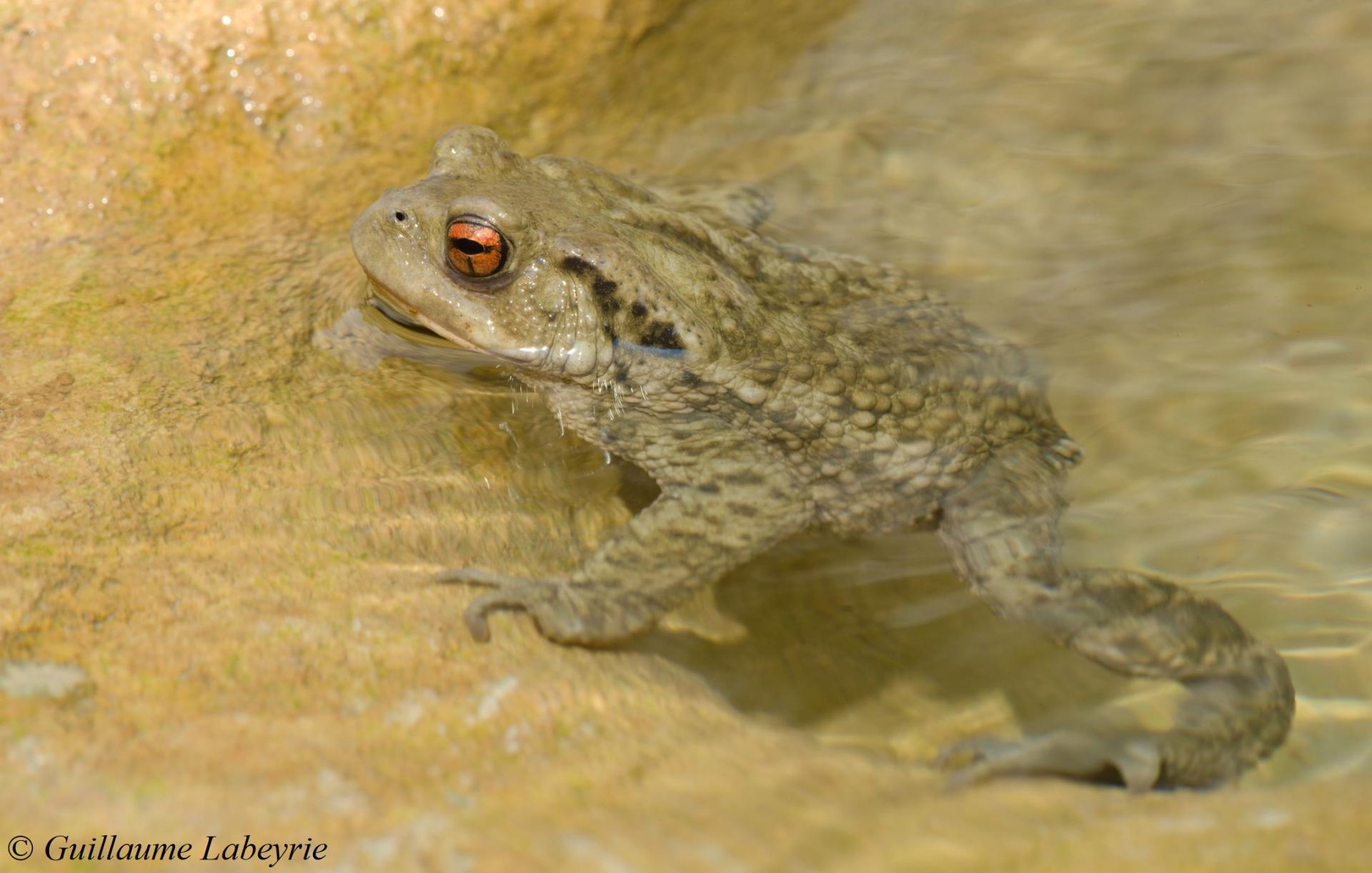 The spiny toad (Bufo spinosus). This toad was recently raised to the rank of full species. France now harbors two quite similar toad species, the common toad (Bufo bufo) occuring mainly in the northeastern half of the country, and the spiny toad (Bufo spinosus) in the southwestern part. In the male Bufo spinosus, the parotoid glands are converging (parallel in Bufo bufo). In the female, which can grow very large (> 10 cm), the skin is spiny. In the Préalpes de Grasse, it is found along rivers, but also in much dryer habitats such as the karst, where it hides in cracks and caves.
The spiny toad (Bufo spinosus). This toad was recently raised to the rank of full species. France now harbors two quite similar toad species, the common toad (Bufo bufo) occuring mainly in the northeastern half of the country, and the spiny toad (Bufo spinosus) in the southwestern part. In the male Bufo spinosus, the parotoid glands are converging (parallel in Bufo bufo). In the female, which can grow very large (> 10 cm), the skin is spiny. In the Préalpes de Grasse, it is found along rivers, but also in much dryer habitats such as the karst, where it hides in cracks and caves.
Crustaceans
Family : Astacidae
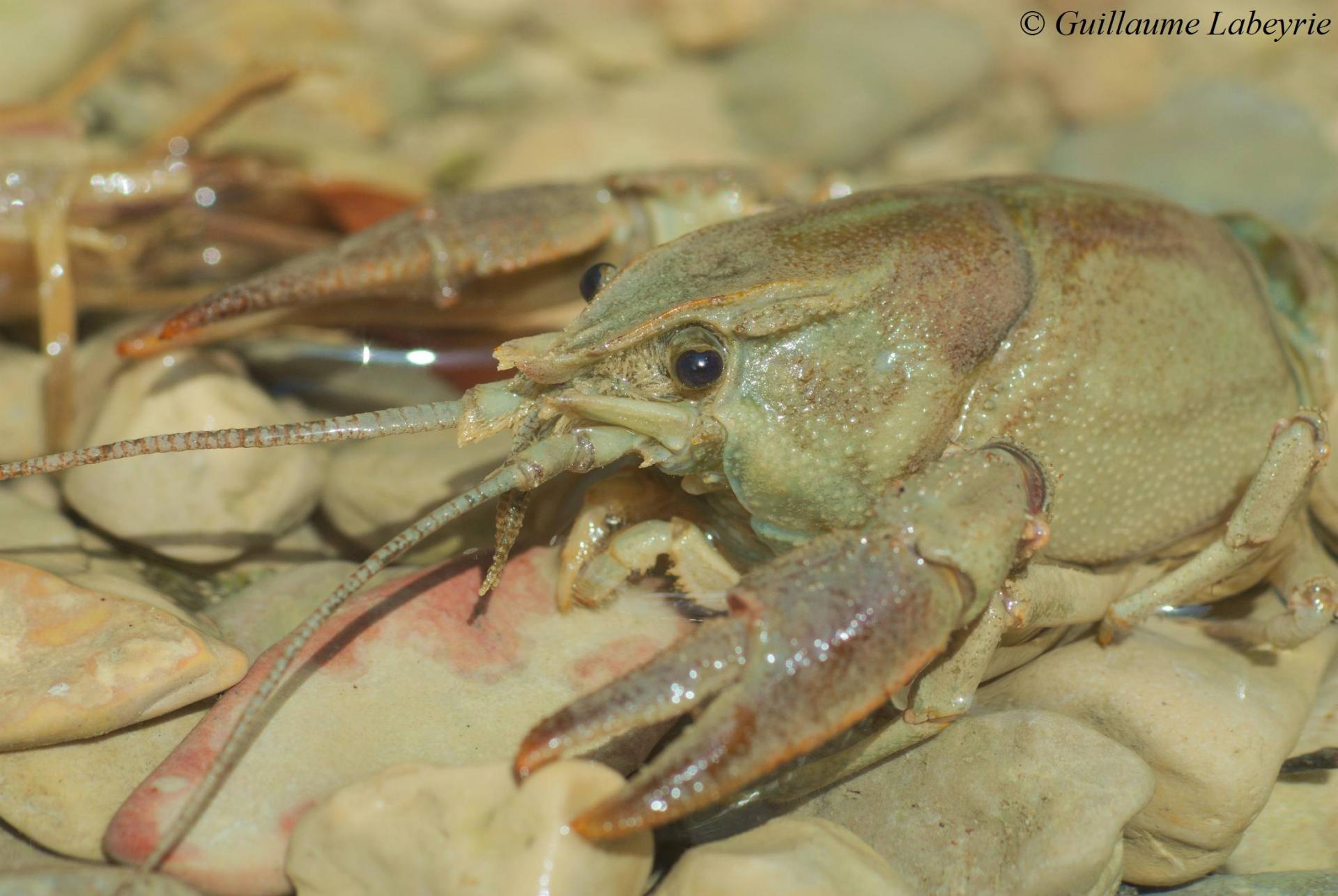 The white-clawed crayfish (Austropotamobius pallipes). This indigenous crayfish is rapidly declining in France and Europe due, among other causes, to the loss of unpolluted water bodies. It is still present in the Prealps in clear streams such as the Siagne and the Loup. This west-European crayfish is listed as threatened by IUCN.
The white-clawed crayfish (Austropotamobius pallipes). This indigenous crayfish is rapidly declining in France and Europe due, among other causes, to the loss of unpolluted water bodies. It is still present in the Prealps in clear streams such as the Siagne and the Loup. This west-European crayfish is listed as threatened by IUCN.
Dragonflies and Damselflies (Odonata)
Family : Libellulidae
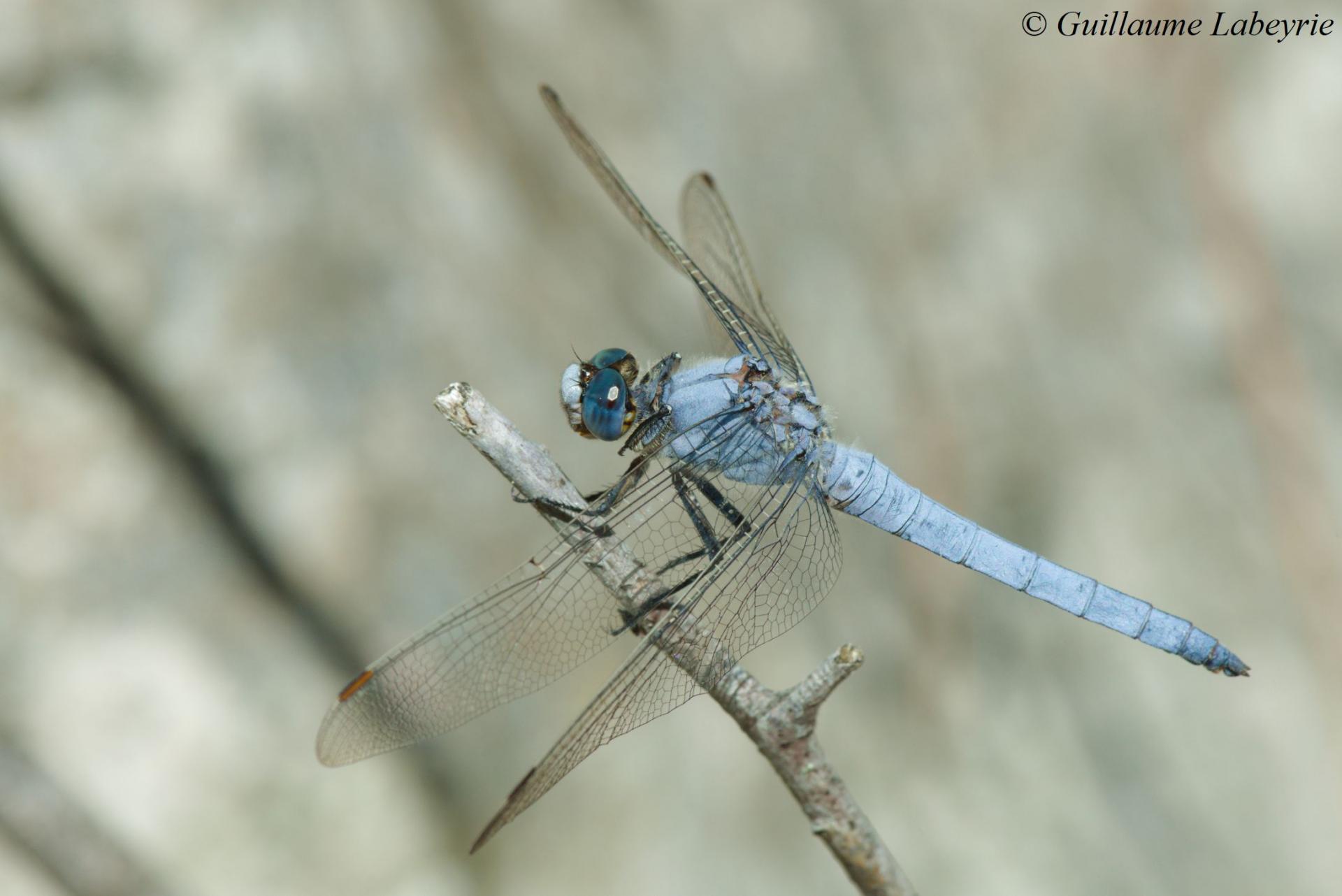 The southern skimmer (Orthetrum brunneum). This male of this widespread dragonfly has a blue-grey body. The blue thorax and pale face differentiates it from a related species, the keeled skimmer (Orthetrum coerulescens), also present in the same habitat. It is found in a variety of habitats, from ponds and lakes to rapid streams.
The southern skimmer (Orthetrum brunneum). This male of this widespread dragonfly has a blue-grey body. The blue thorax and pale face differentiates it from a related species, the keeled skimmer (Orthetrum coerulescens), also present in the same habitat. It is found in a variety of habitats, from ponds and lakes to rapid streams.
Family : Cordulegastridae
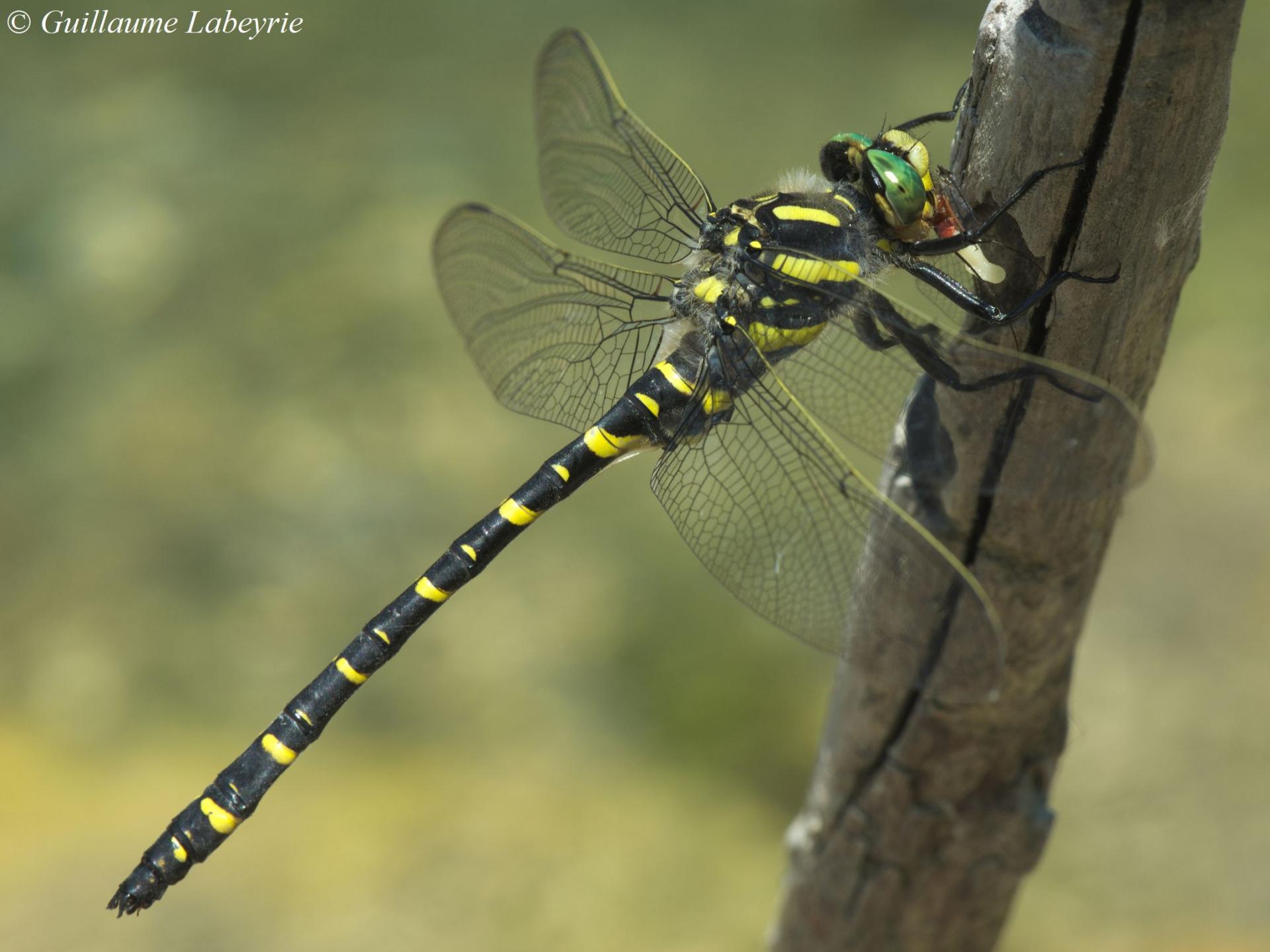 The golden-ringed dragonfly (Cordulegaster boltonii). This large dragonfly has a distinctive yellow-on-black pattern. It is usually found in rapid streams, at low elevations. The golden-ringed dragonfly is widespread in Europe.
The golden-ringed dragonfly (Cordulegaster boltonii). This large dragonfly has a distinctive yellow-on-black pattern. It is usually found in rapid streams, at low elevations. The golden-ringed dragonfly is widespread in Europe.
Family : Gomphidae
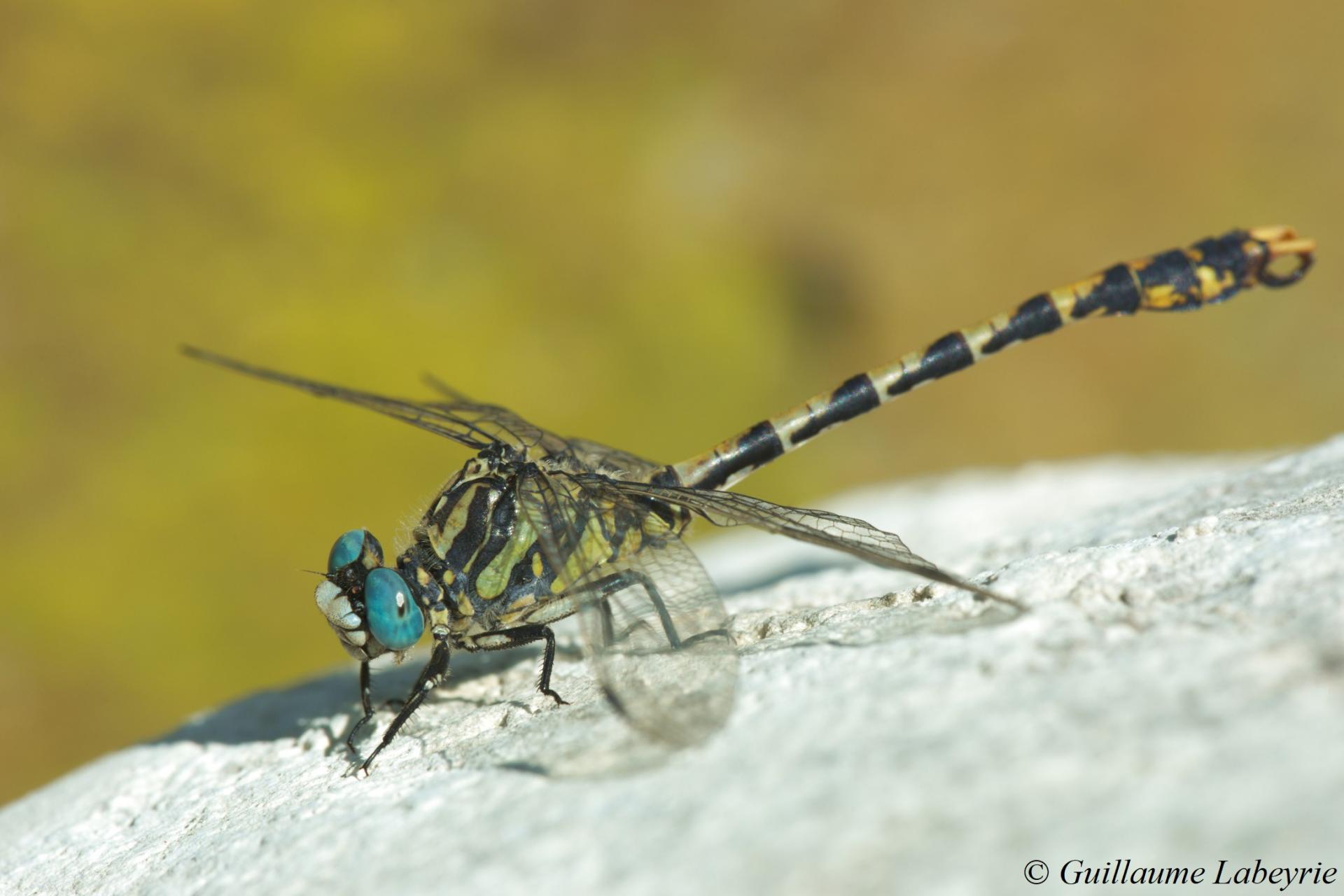 The large pincertail (Onycogomphus uncatus). Smaller than the previous species, this dragonfly is found in the same habitat. It is very similar to the small pincertail (Onycogomphus forcipatus), who shows a yellow stripe between the eye. This species is found in the southern half of France.
The large pincertail (Onycogomphus uncatus). Smaller than the previous species, this dragonfly is found in the same habitat. It is very similar to the small pincertail (Onycogomphus forcipatus), who shows a yellow stripe between the eye. This species is found in the southern half of France.
Family : Calopterygidae
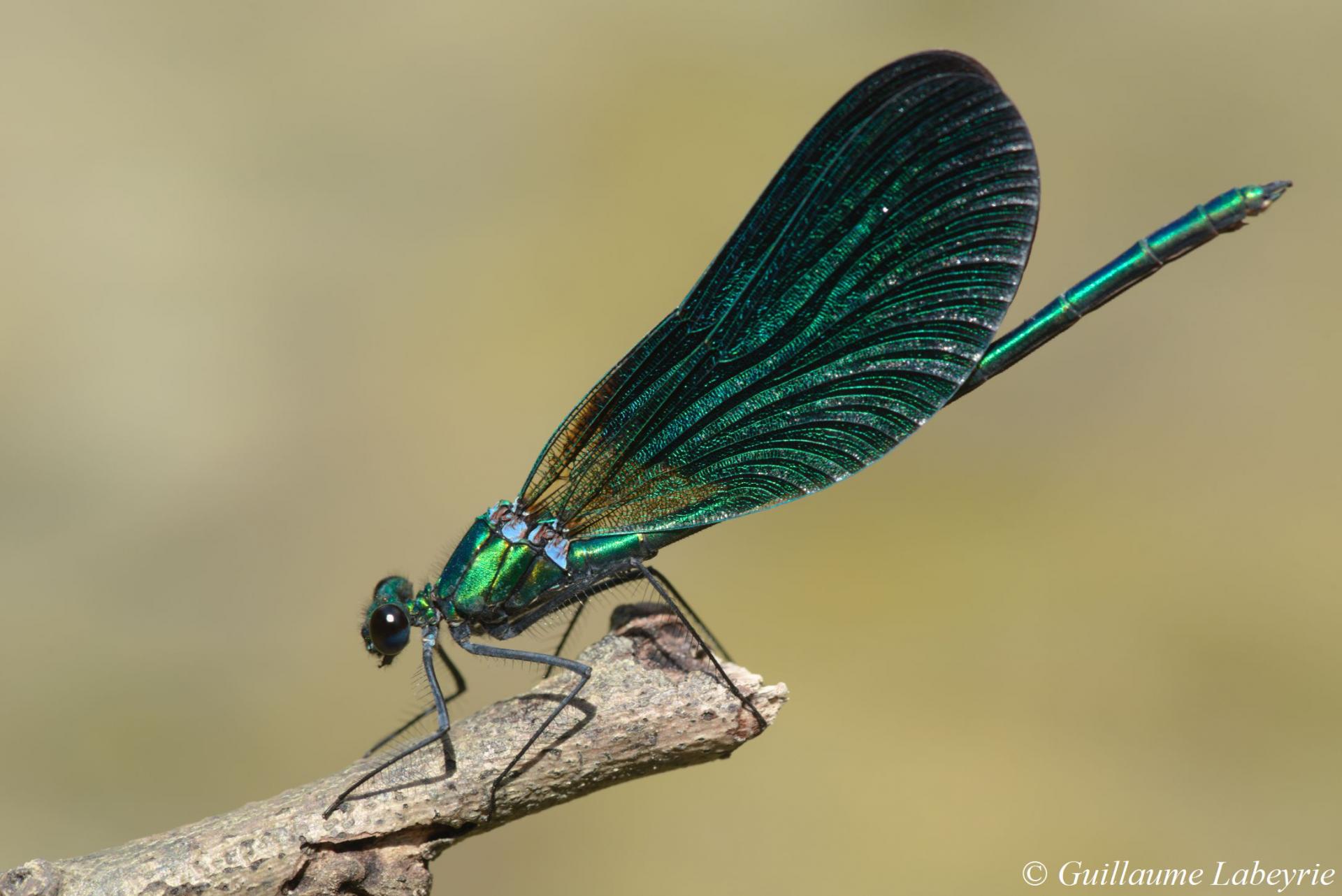 The beautiful demoiselle (Calopteryx virgo subsp. meridionalis). These amazing insects are indeed beautiful, with a metallic green body and dark blue wings for the male (shown here). The female's wings are yellow-green. The meridionalis subspecies, present in the southern part of France, has a slightly translucent area at the base of the wings.
The beautiful demoiselle (Calopteryx virgo subsp. meridionalis). These amazing insects are indeed beautiful, with a metallic green body and dark blue wings for the male (shown here). The female's wings are yellow-green. The meridionalis subspecies, present in the southern part of France, has a slightly translucent area at the base of the wings.
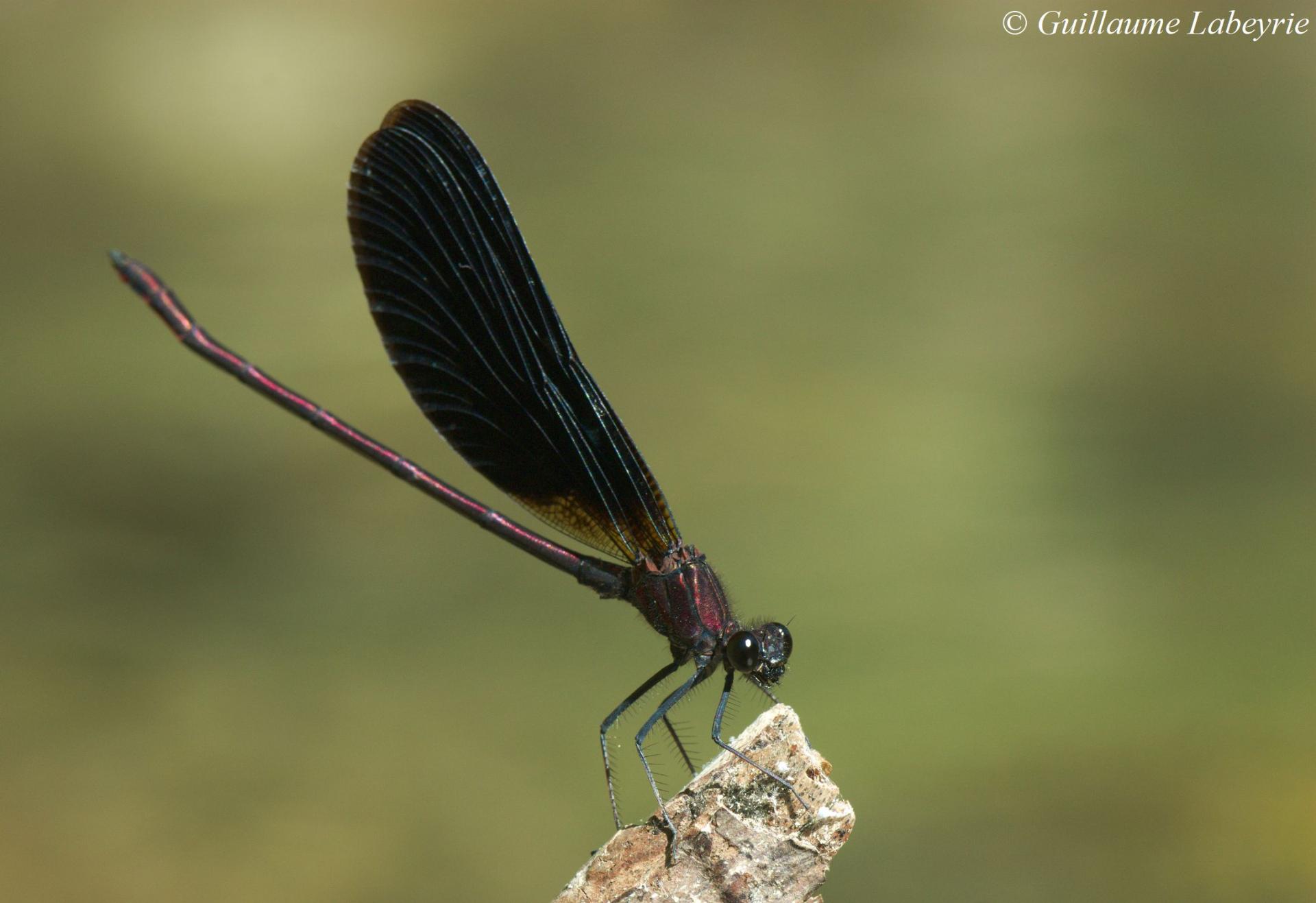 The copper demoiselle (Calopteryx haemorrhoidalis). This demoiselle differs from the previous one by its deep purple color. Both species are often found together, in rapid and well-oxygenated streams. The huge eyes provide excellent vision for these highly predatory insects. During the mating dance, the male flashes the bright pink underpart of its abdomen to the female. The copper demoiselle is found in southern Europe (Spain to Italy) and in North Africa.
The copper demoiselle (Calopteryx haemorrhoidalis). This demoiselle differs from the previous one by its deep purple color. Both species are often found together, in rapid and well-oxygenated streams. The huge eyes provide excellent vision for these highly predatory insects. During the mating dance, the male flashes the bright pink underpart of its abdomen to the female. The copper demoiselle is found in southern Europe (Spain to Italy) and in North Africa.
Plecoptera
Family : Perlidae
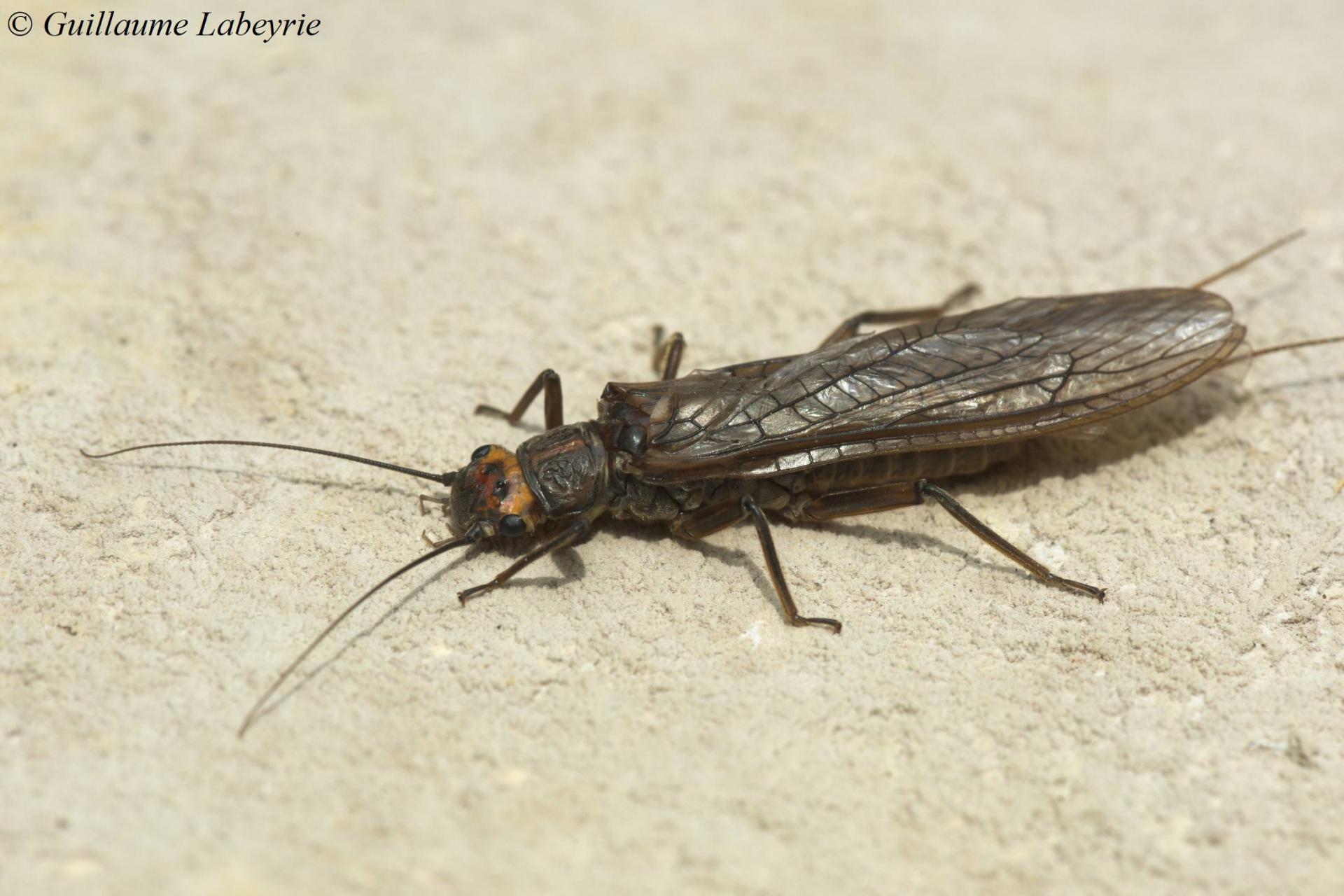 Stonefly (Dinocras cephalotes). This large stonefly can reach 4 cm. The larvae leave under stone in clear, rapid streams. The adults fly close to the water surface, where they are often captured by trouts. These insects are among the best indicators of water quality. This species is relatively widespread in France.
Stonefly (Dinocras cephalotes). This large stonefly can reach 4 cm. The larvae leave under stone in clear, rapid streams. The adults fly close to the water surface, where they are often captured by trouts. These insects are among the best indicators of water quality. This species is relatively widespread in France.
Butterflies and Moths (Lepidoptera)
Family : Lycenidae
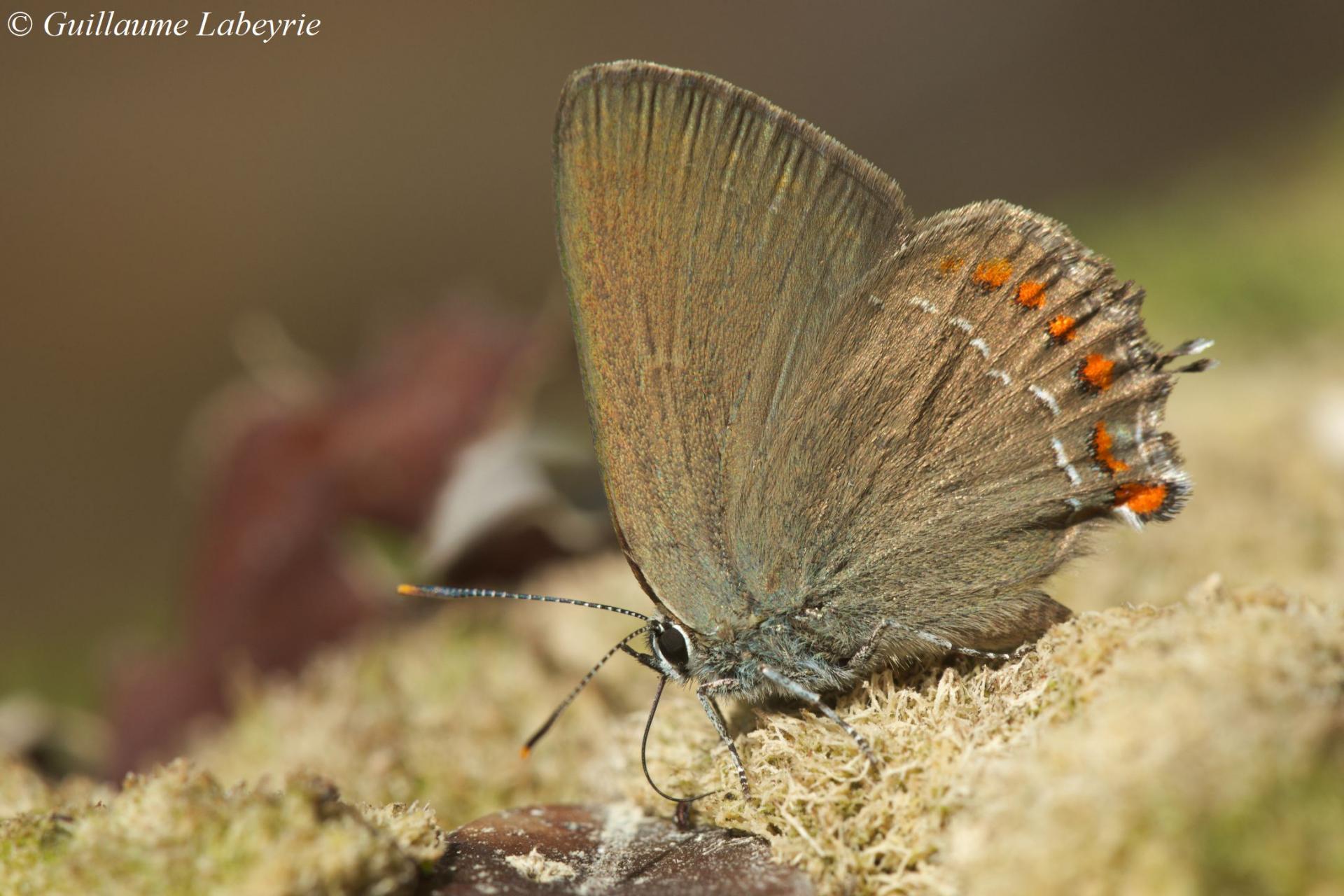 The false ilex hairstreak (Satyrium esculi). Most hairstreaks display little tails on the hindwings. This species has a distinctive set of round orange spots. The caterpillar feeds on holm and kermes oaks. This butterfly occurs in North Africa, the Iberian peninsula and southern France.
The false ilex hairstreak (Satyrium esculi). Most hairstreaks display little tails on the hindwings. This species has a distinctive set of round orange spots. The caterpillar feeds on holm and kermes oaks. This butterfly occurs in North Africa, the Iberian peninsula and southern France.
Family : Nymphalidae / Sub-Family : Apaturinae
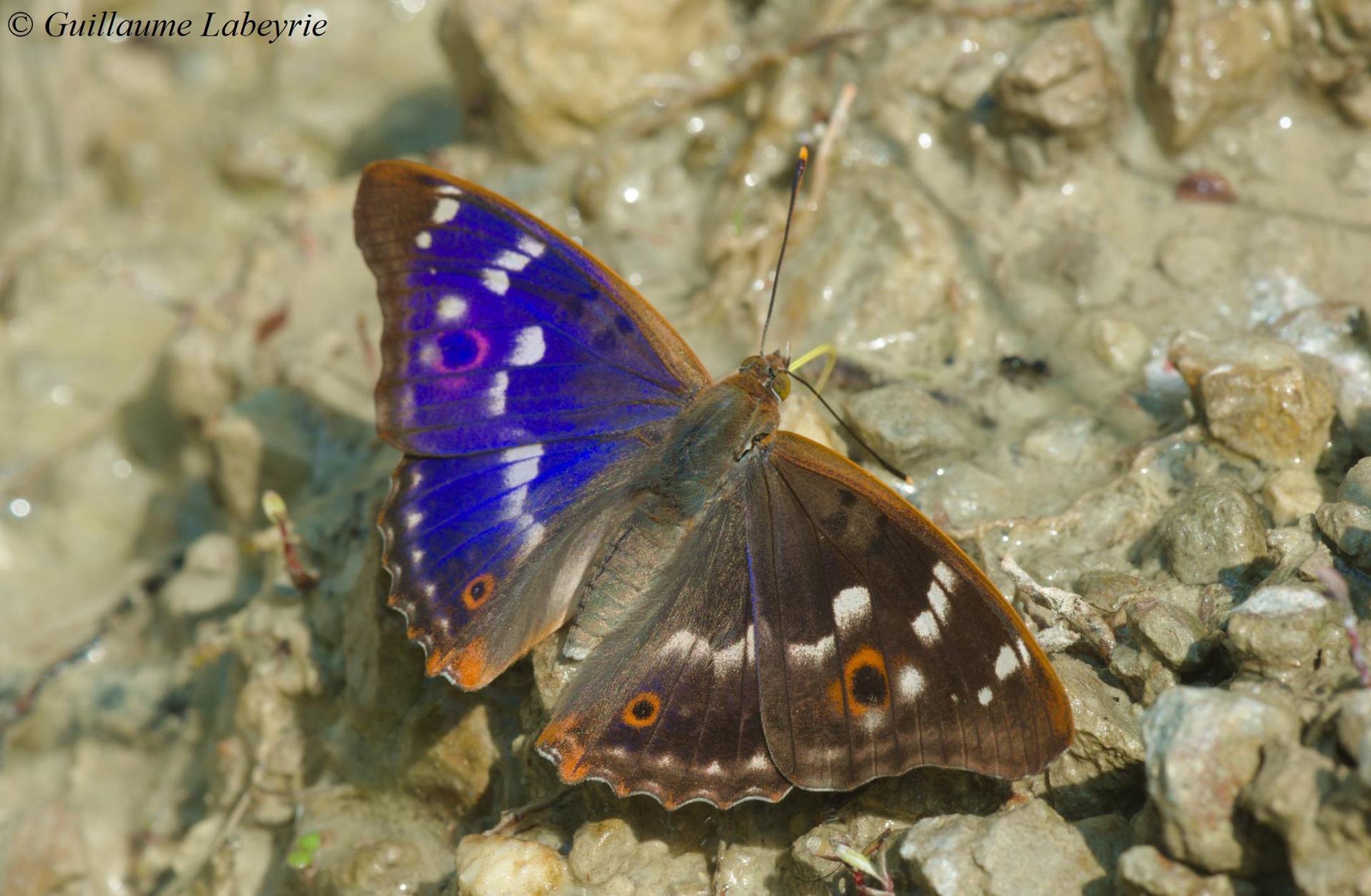 The lesser purple emperor (Apatura ilia). This beautiful butterfly of rather large size is readily identified by its fast and nervous flight and the bright purple iridescent sheen that is only visible under a certain angle of observation. This sheen is due to the tridimensionnal periodic structure of the wing scales, which turn this butterfly into a flying diffraction grating. The species seems scarce in the Preapls, and is found only along certain streams where its host plants grow (poplars and willows). Butterflies from the Apatura genus are attracted to rotten fruits and excrements. The lesser purple emperor occurs in most of Europe, Caucasus and Ural up to China.
The lesser purple emperor (Apatura ilia). This beautiful butterfly of rather large size is readily identified by its fast and nervous flight and the bright purple iridescent sheen that is only visible under a certain angle of observation. This sheen is due to the tridimensionnal periodic structure of the wing scales, which turn this butterfly into a flying diffraction grating. The species seems scarce in the Preapls, and is found only along certain streams where its host plants grow (poplars and willows). Butterflies from the Apatura genus are attracted to rotten fruits and excrements. The lesser purple emperor occurs in most of Europe, Caucasus and Ural up to China.
Family : Nymphalidae / Sub-Family : Satyrinae
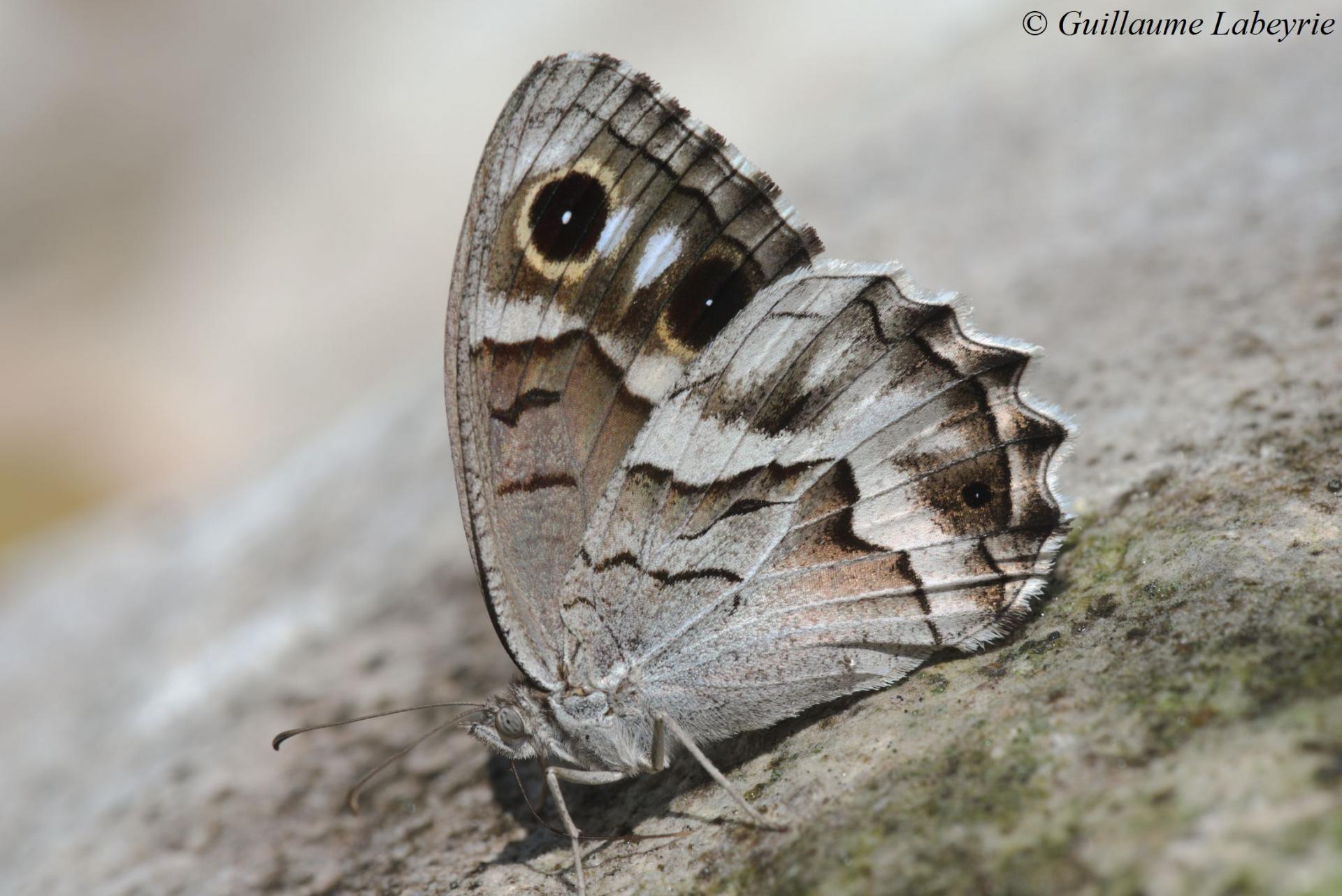 The striped grayling (Pseudotergumia fidia). This mediterranean Satyrinae is usually found in very dry and rocky places. However, it is also often observed near the water in the canyons. This localized species occurs in western Europe (Iberian Peninsula, France and north-western Italy) and in North Africa. In France, the striped grayling roughly follows the distribution of the olive tree.
The striped grayling (Pseudotergumia fidia). This mediterranean Satyrinae is usually found in very dry and rocky places. However, it is also often observed near the water in the canyons. This localized species occurs in western Europe (Iberian Peninsula, France and north-western Italy) and in North Africa. In France, the striped grayling roughly follows the distribution of the olive tree.
Family : Nymphalidae / Sub-Family : Libytheinae
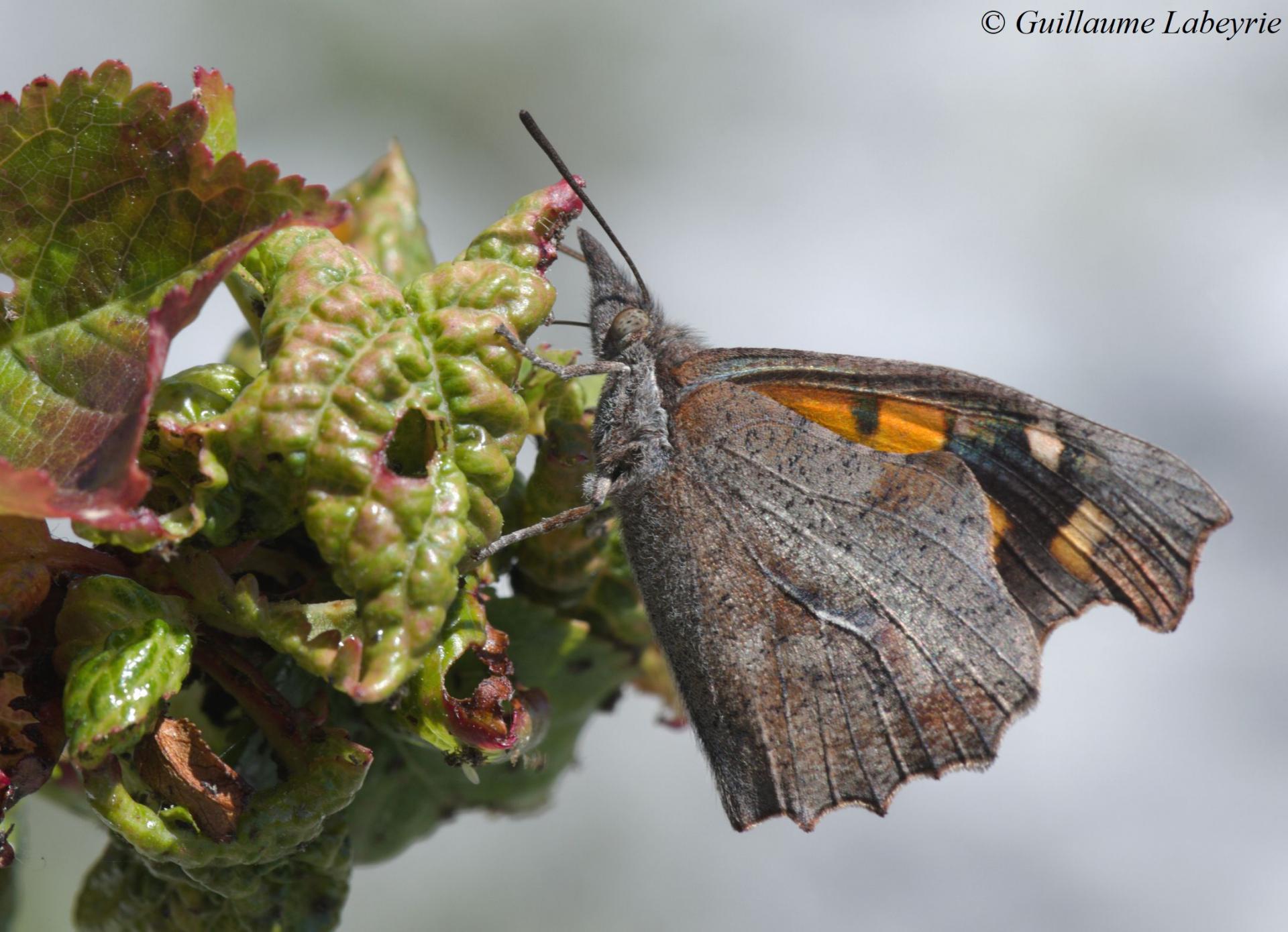 The European beak (Libythea celtis). This strange-looking butterfly is the only member of its sub-family (Libytheinae) in Europe. Its is restricted to the mediterranean range where the European nettle tree (Celtis australis), its host plant, grows. In the Grasse Prealps, this species is often observed along rivers in June. In France, it occurs only in the south-east.
The European beak (Libythea celtis). This strange-looking butterfly is the only member of its sub-family (Libytheinae) in Europe. Its is restricted to the mediterranean range where the European nettle tree (Celtis australis), its host plant, grows. In the Grasse Prealps, this species is often observed along rivers in June. In France, it occurs only in the south-east.
Family : Papilionidae
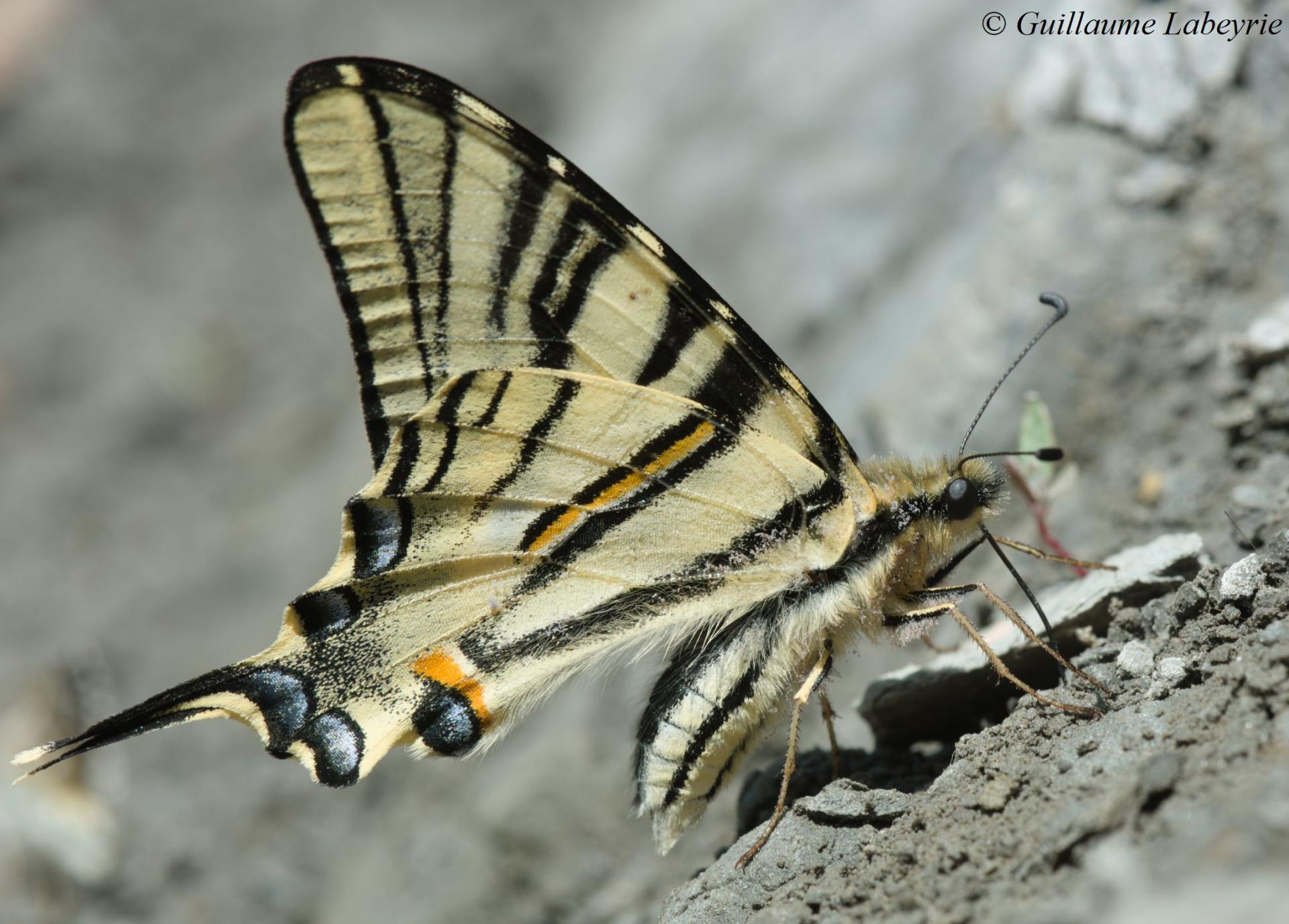 The scarce swallowtail (Iphiclides podalirius). Despite it common english name, this large and beautiful butterfly is still a rather common sight in Provence (but declining). It should not be confused with the Alexanor (Papilio alexanor), much scarcer, which has a more yellowish color, a different stripe pattern, and a white tip of the antennae. Usually observed in dry meadows, this butterfly is also found in the gorges where it can drink on marly seeps, as on this photo. Occuring in most of France, it is widespread in Eurasia but declining in many regions in Europe.
The scarce swallowtail (Iphiclides podalirius). Despite it common english name, this large and beautiful butterfly is still a rather common sight in Provence (but declining). It should not be confused with the Alexanor (Papilio alexanor), much scarcer, which has a more yellowish color, a different stripe pattern, and a white tip of the antennae. Usually observed in dry meadows, this butterfly is also found in the gorges where it can drink on marly seeps, as on this photo. Occuring in most of France, it is widespread in Eurasia but declining in many regions in Europe.
Family : Crambidae
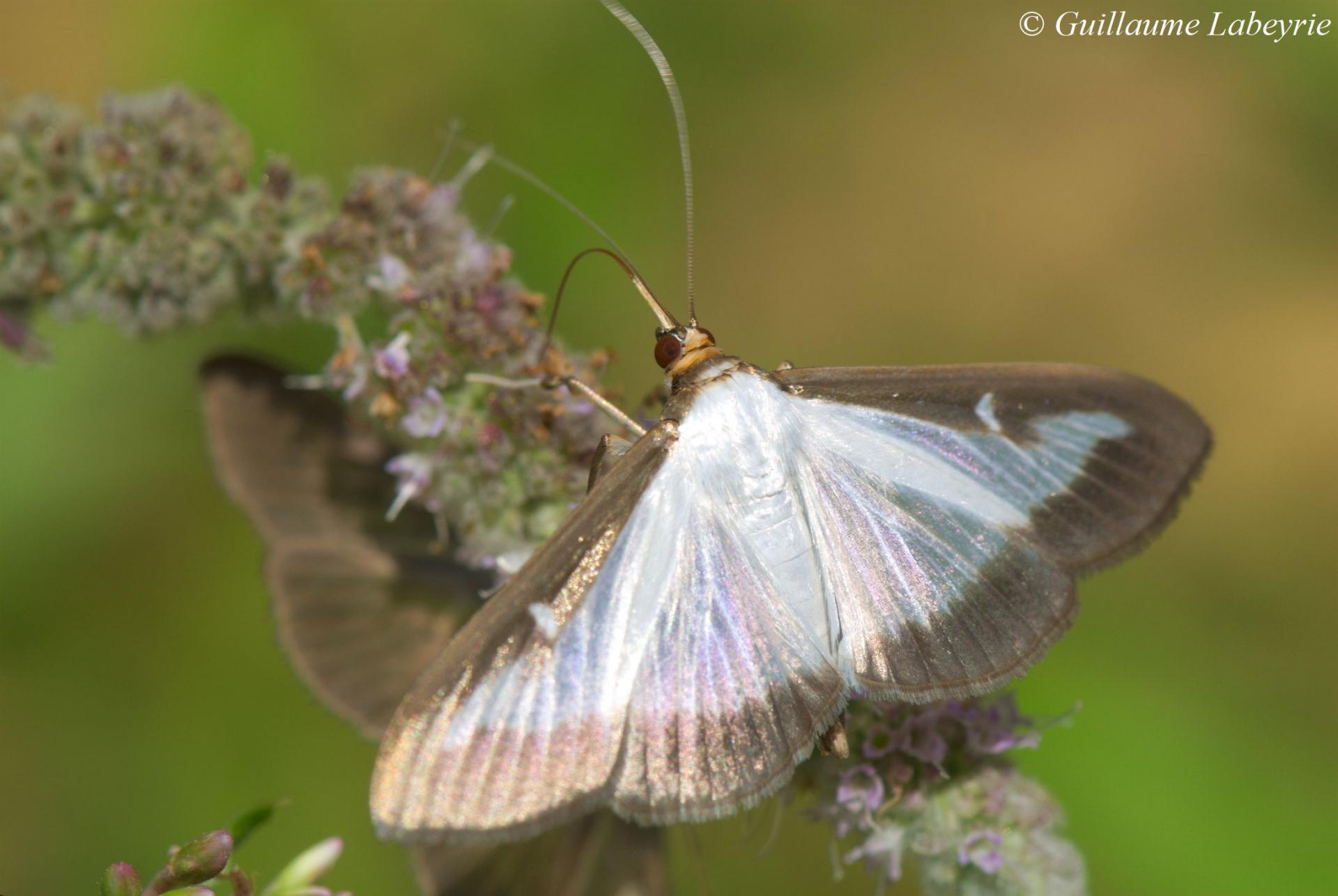 The box tree moth (Cidalyma perspectalis). This delicate small moth is a formidable pest whose caterpillar feeds on members of the boxes family (Buxus sp.). Native to eastern Asia, this species was accidentally introduced in Europe in 2006, and appeared in France in 2008 where it is now found everywhere. With up to three generations per year, the caterpillars eat all the leaves of the tree which usually dies. In the Préalpes de Grasse, the box forests of the upper Siagne and Loup valleys have been devastated, and the moth is now spreading on the plateaus.
The box tree moth (Cidalyma perspectalis). This delicate small moth is a formidable pest whose caterpillar feeds on members of the boxes family (Buxus sp.). Native to eastern Asia, this species was accidentally introduced in Europe in 2006, and appeared in France in 2008 where it is now found everywhere. With up to three generations per year, the caterpillars eat all the leaves of the tree which usually dies. In the Préalpes de Grasse, the box forests of the upper Siagne and Loup valleys have been devastated, and the moth is now spreading on the plateaus.
Family : Saturniidae
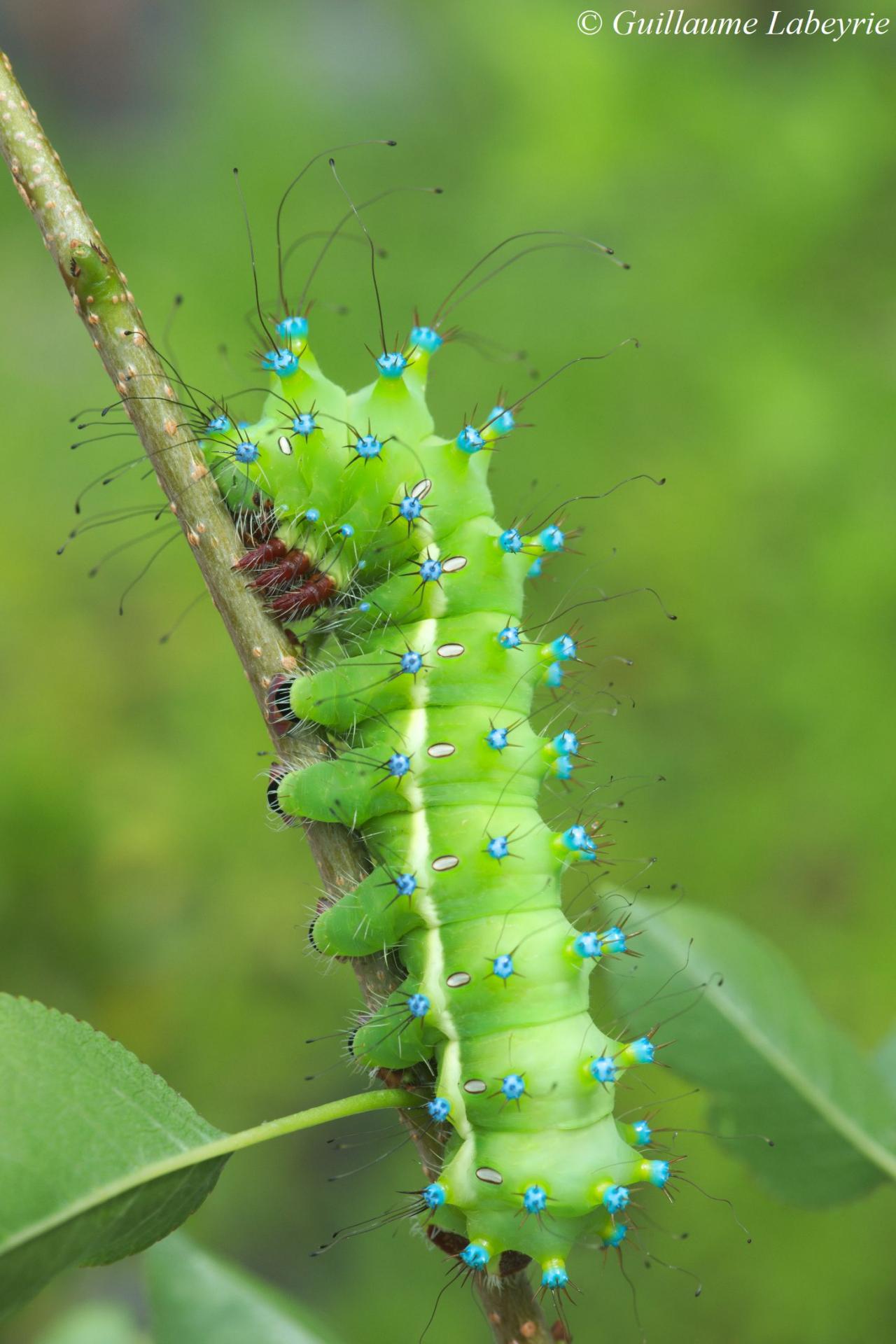 Caterpillar of the giant peacock moth (Saturnia pyri). This wonderful moth is the largest in Europe, with a wingspan reaching 15 cm. The males of this species are able to detect the pheromones emitted by the females at a distance of several kilometers. The stunning caterpillar consumes a variety of plants from the rose family, including the almond tree, the apple tree, the plum tree ... The giant peacock moth occurs in western and southern Europe, and in most of France where it seems to be declining.
Caterpillar of the giant peacock moth (Saturnia pyri). This wonderful moth is the largest in Europe, with a wingspan reaching 15 cm. The males of this species are able to detect the pheromones emitted by the females at a distance of several kilometers. The stunning caterpillar consumes a variety of plants from the rose family, including the almond tree, the apple tree, the plum tree ... The giant peacock moth occurs in western and southern Europe, and in most of France where it seems to be declining.
Family : Erebidae
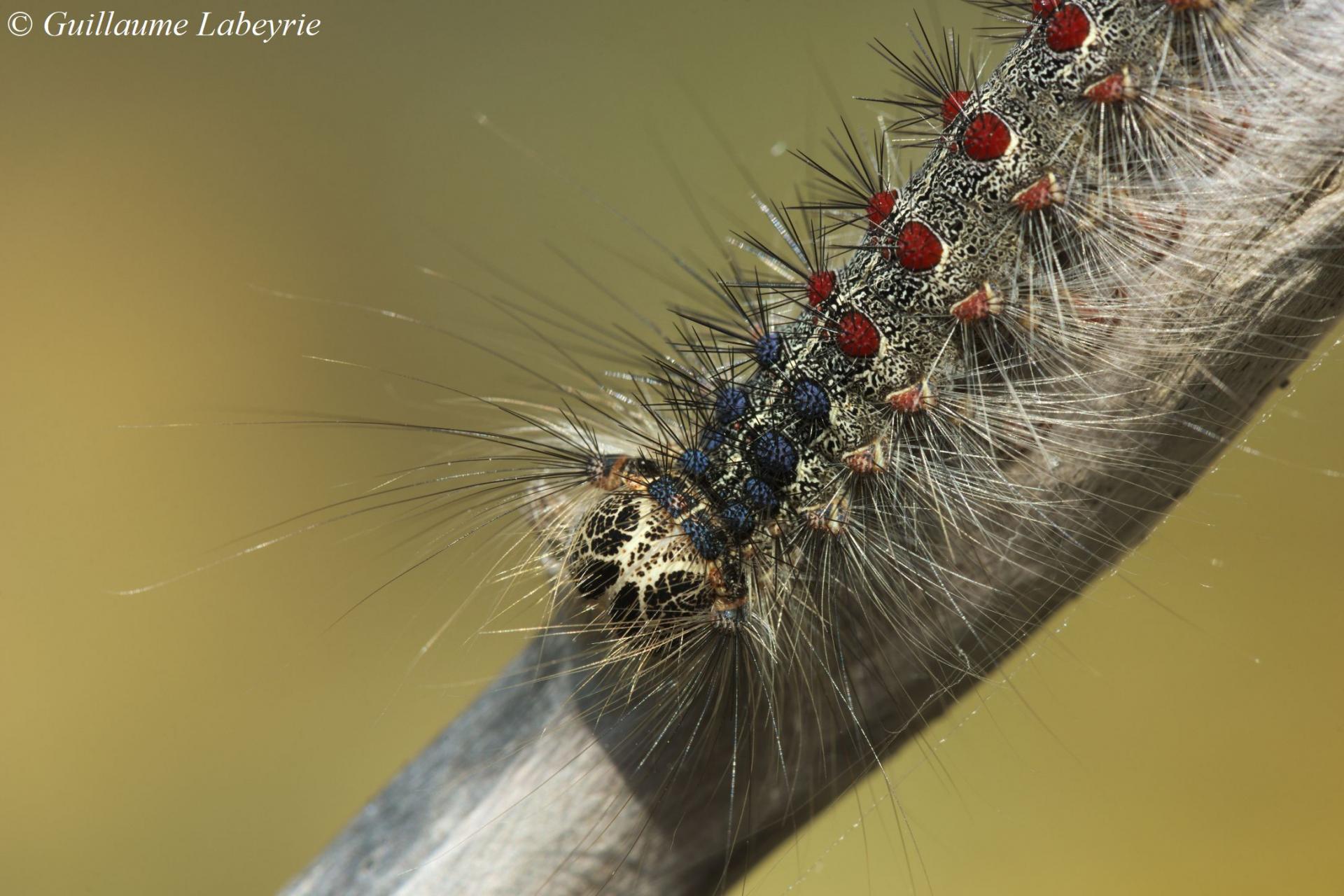 Caterpillar of the european gipsy moth (Lymantria dispar). This rather nondescript small moth has a spectacular caterpillar sporting a series of blue and red spots on its back. This species undergoes cyclic proliferations, leading to the defoliation of entire forests (for instance of cork and holm oaks). During these events, the predators of the caterpillars such as the forest caterpillar hunter (Calosoma sycophanta) can also be observed in great numbers.
Caterpillar of the european gipsy moth (Lymantria dispar). This rather nondescript small moth has a spectacular caterpillar sporting a series of blue and red spots on its back. This species undergoes cyclic proliferations, leading to the defoliation of entire forests (for instance of cork and holm oaks). During these events, the predators of the caterpillars such as the forest caterpillar hunter (Calosoma sycophanta) can also be observed in great numbers.
Beetles (Coleoptera)
Family : Cerambycidae
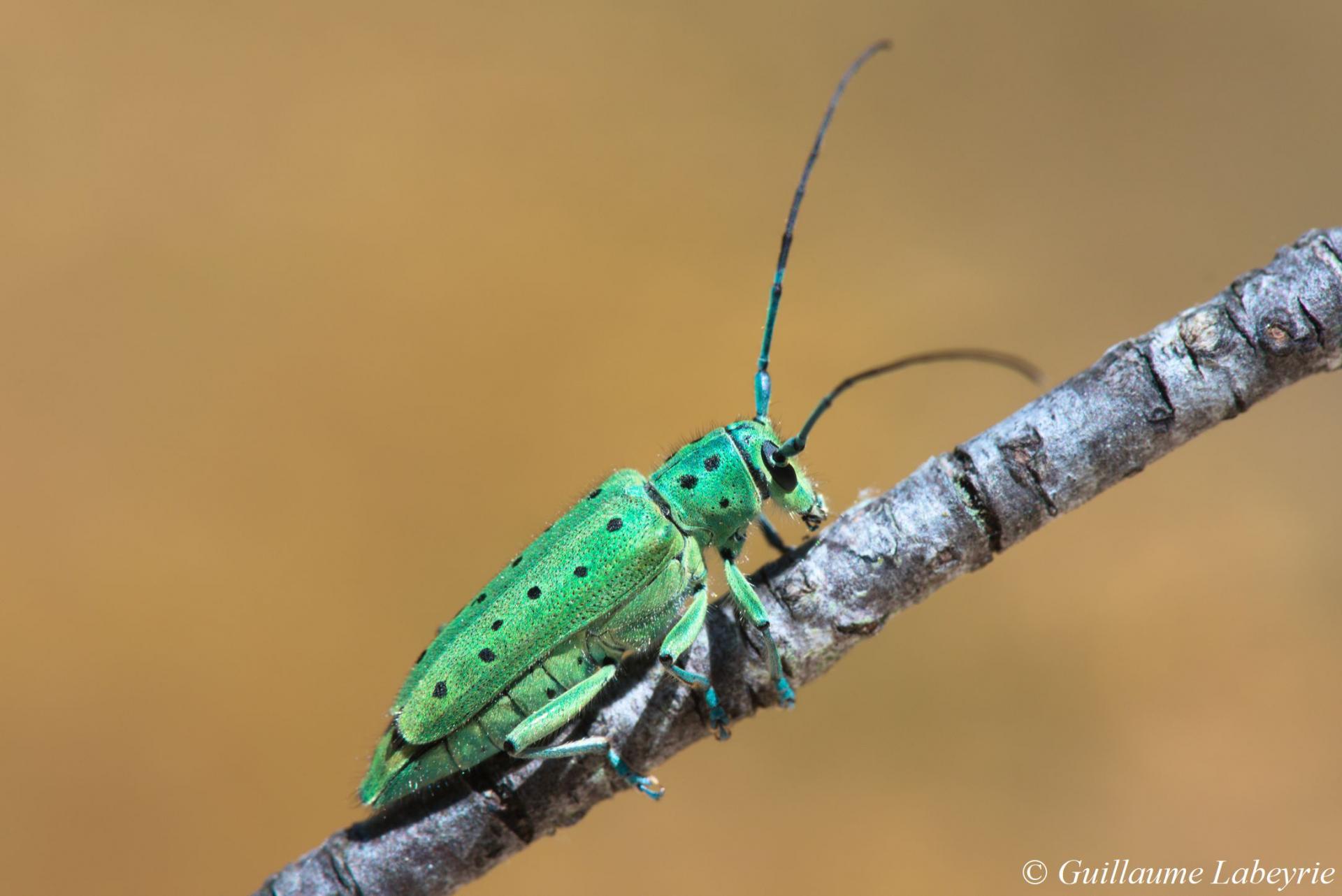 Saperda punctata. This beautiful, rather small longhorn beetle (body length 13-20 mm) is widespread through Europe but declining and often protected due to the vanishing of elm trees on which its larva feeds.
Saperda punctata. This beautiful, rather small longhorn beetle (body length 13-20 mm) is widespread through Europe but declining and often protected due to the vanishing of elm trees on which its larva feeds.
Flora
Family : Aspleniaceae
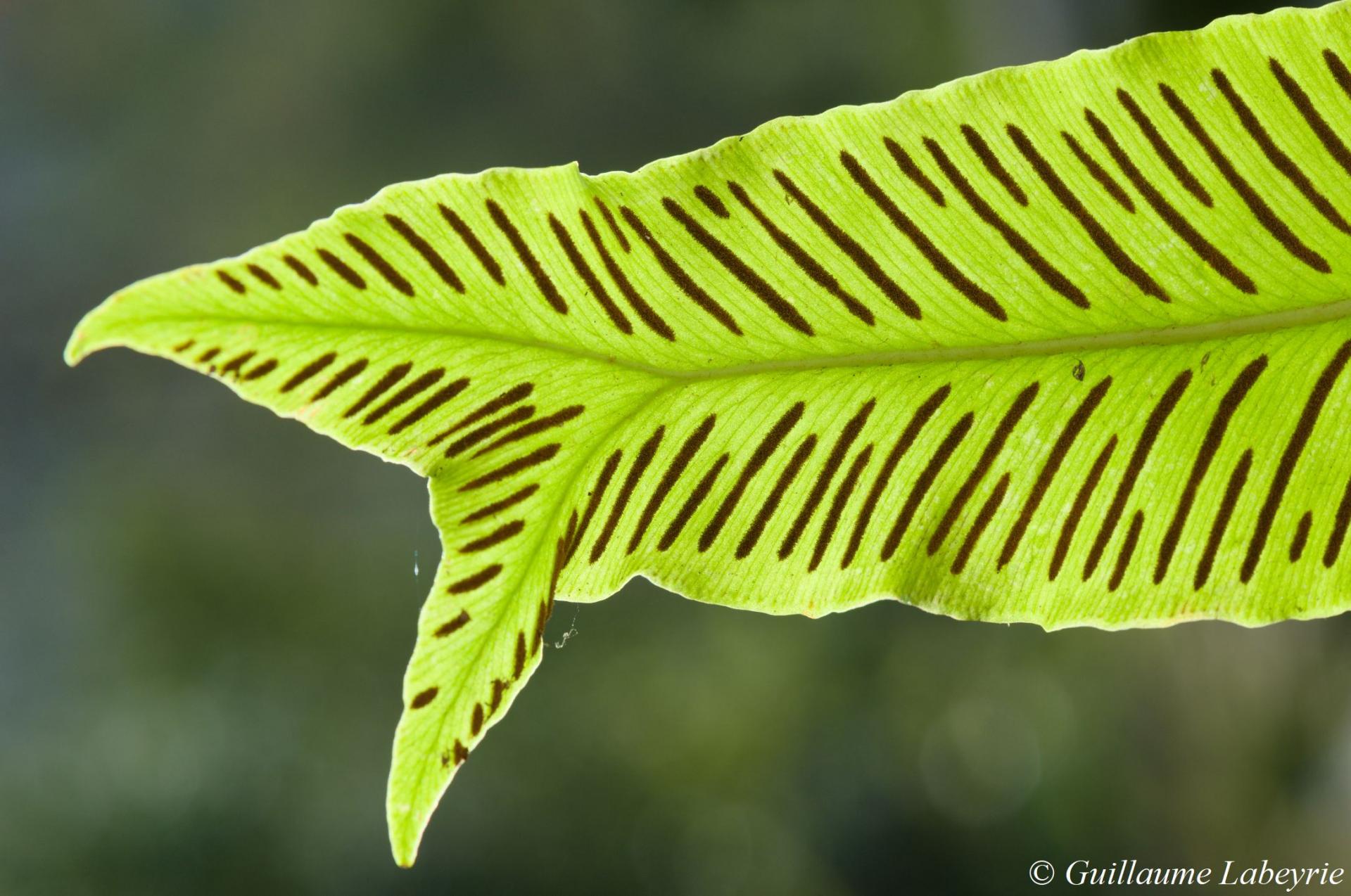 The hart's-tongue fern (Asplenium scolopendrium). The fronds of this spectacular fern can exceed 60 cm in length. The divided tip seen on this photograph is very unusual. In Southern France, this plant usually grows in shady woodlands along rivers or in canyons. Quite uncommon, this species is protected in the PACA region.
The hart's-tongue fern (Asplenium scolopendrium). The fronds of this spectacular fern can exceed 60 cm in length. The divided tip seen on this photograph is very unusual. In Southern France, this plant usually grows in shady woodlands along rivers or in canyons. Quite uncommon, this species is protected in the PACA region.
Family : Marchantiaceae
 The common liverwort (Marchantia polymorpha). This curious plant grows on shady rocks on stream banks. Two reproduction modes are illustrated on this photo. The asexual mode uses gemmae contined in "gemmae cups" attached to the thalli. The sexual mode involves specialized organs, male and female, borne by different plants. The female organs, seen on this photo, have a distinctive star pattern. The male organs are funnel-shaped. The common liverwort occurs in most of France.
The common liverwort (Marchantia polymorpha). This curious plant grows on shady rocks on stream banks. Two reproduction modes are illustrated on this photo. The asexual mode uses gemmae contined in "gemmae cups" attached to the thalli. The sexual mode involves specialized organs, male and female, borne by different plants. The female organs, seen on this photo, have a distinctive star pattern. The male organs are funnel-shaped. The common liverwort occurs in most of France.
Apart from rivers, wetlands are scarce in the Préalpes de Grasse. A few wet meadows are found on the clayey soil of the plains sandwiched between the plateaus. Home to several rare species, these fragile habitats are threatened by human use (agriculture).
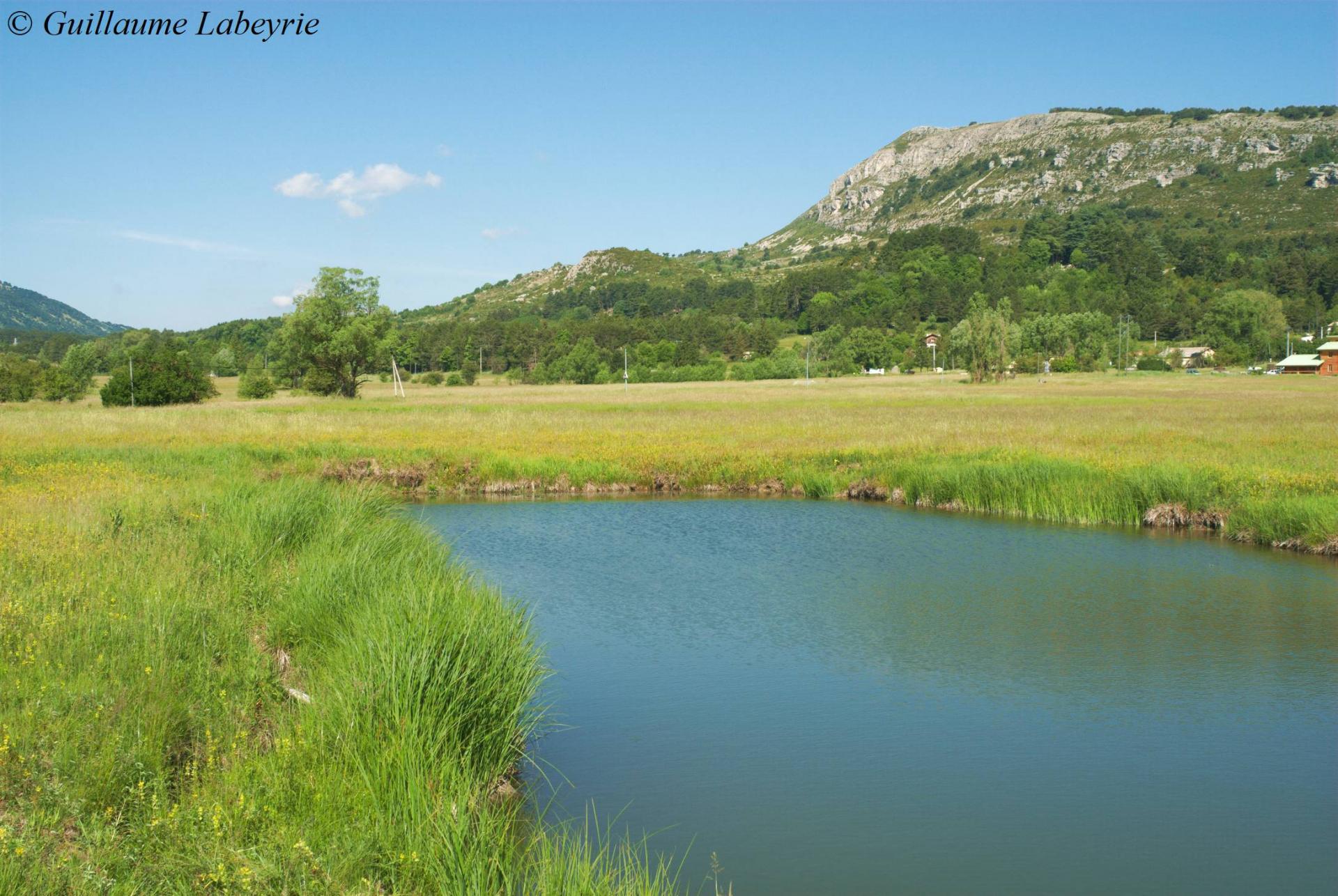 Pond and wet meadow. These habitats harbor a striking biodiversity, and are often home to rare species.
Pond and wet meadow. These habitats harbor a striking biodiversity, and are often home to rare species.
Flora
Family : Amaryllidaceae
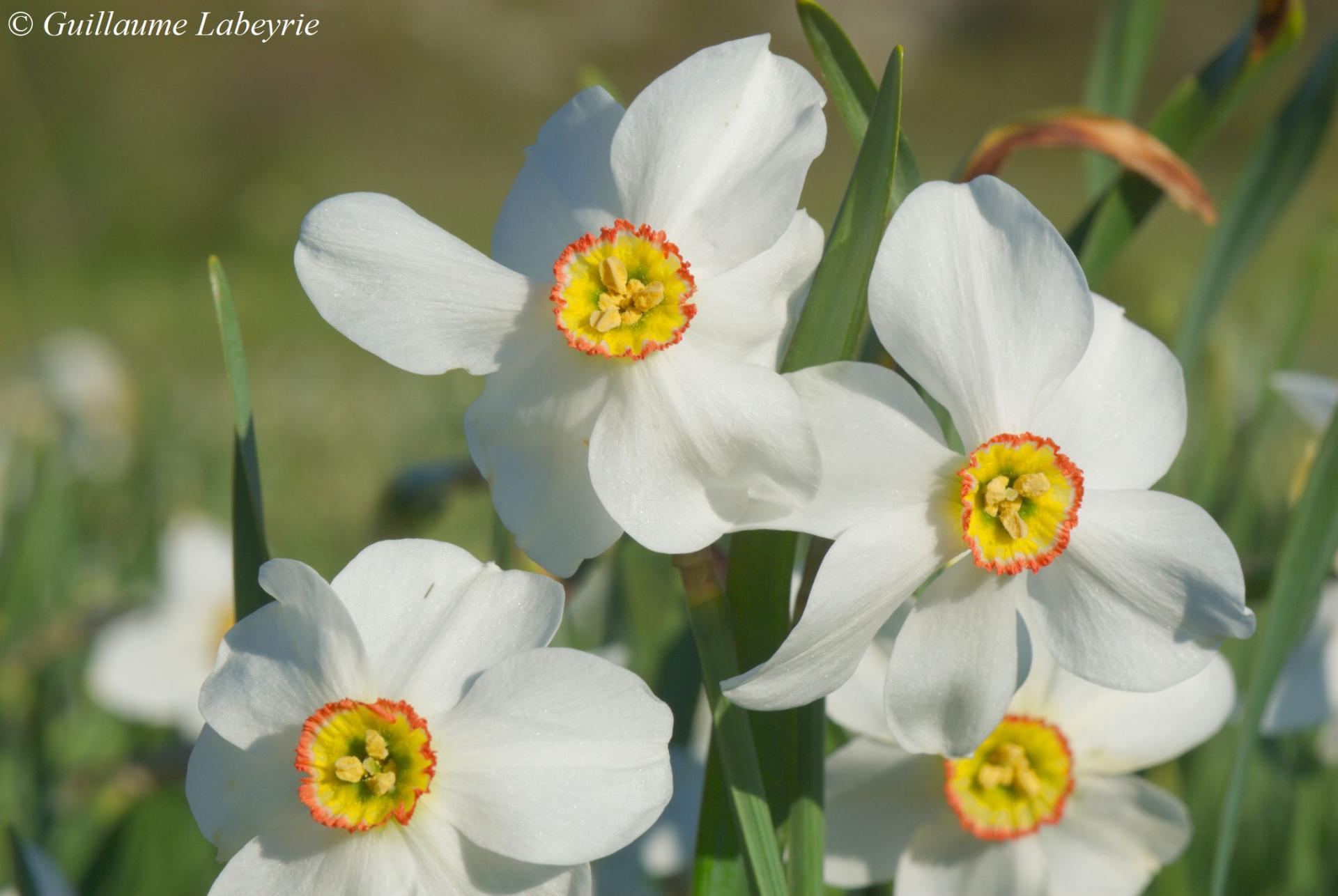 The poet's daffodil (Narcissus poeticus). This narcissus forms large populations in wet meadows at the bottom of certain valleys. Blooming occurs in May. The poet's daffodil is also sometimes found on dryer ground, in the karst.
The poet's daffodil (Narcissus poeticus). This narcissus forms large populations in wet meadows at the bottom of certain valleys. Blooming occurs in May. The poet's daffodil is also sometimes found on dryer ground, in the karst.
Family : Apiaceae
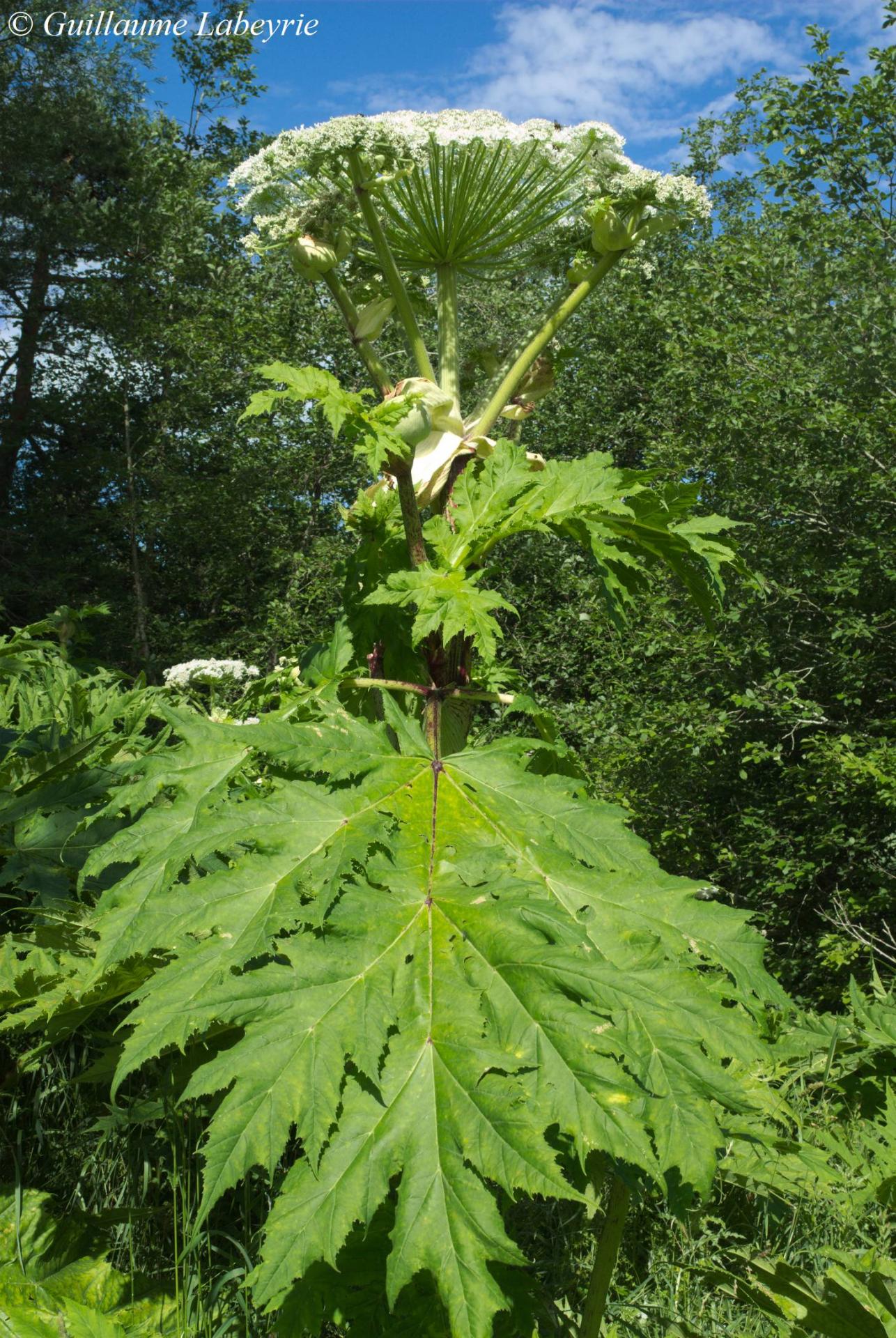 The giant hogweed (Heracleum mantegazzianum). This huge member of the carrot family can reach 4 m and more ! This species originating from the Caucasus was introduced in Europe as an ornamental plant, and has now spread in many countries. Its sap is phototoxic and can cause serious blisters and scars. In the Préalpes de Grasse, the giant hogweed is found along streams and lakes, mainly in the Thorenc valley. Programs are under way to try to eradicate this invasive plant.
The giant hogweed (Heracleum mantegazzianum). This huge member of the carrot family can reach 4 m and more ! This species originating from the Caucasus was introduced in Europe as an ornamental plant, and has now spread in many countries. Its sap is phototoxic and can cause serious blisters and scars. In the Préalpes de Grasse, the giant hogweed is found along streams and lakes, mainly in the Thorenc valley. Programs are under way to try to eradicate this invasive plant.
Family : Asteraceae
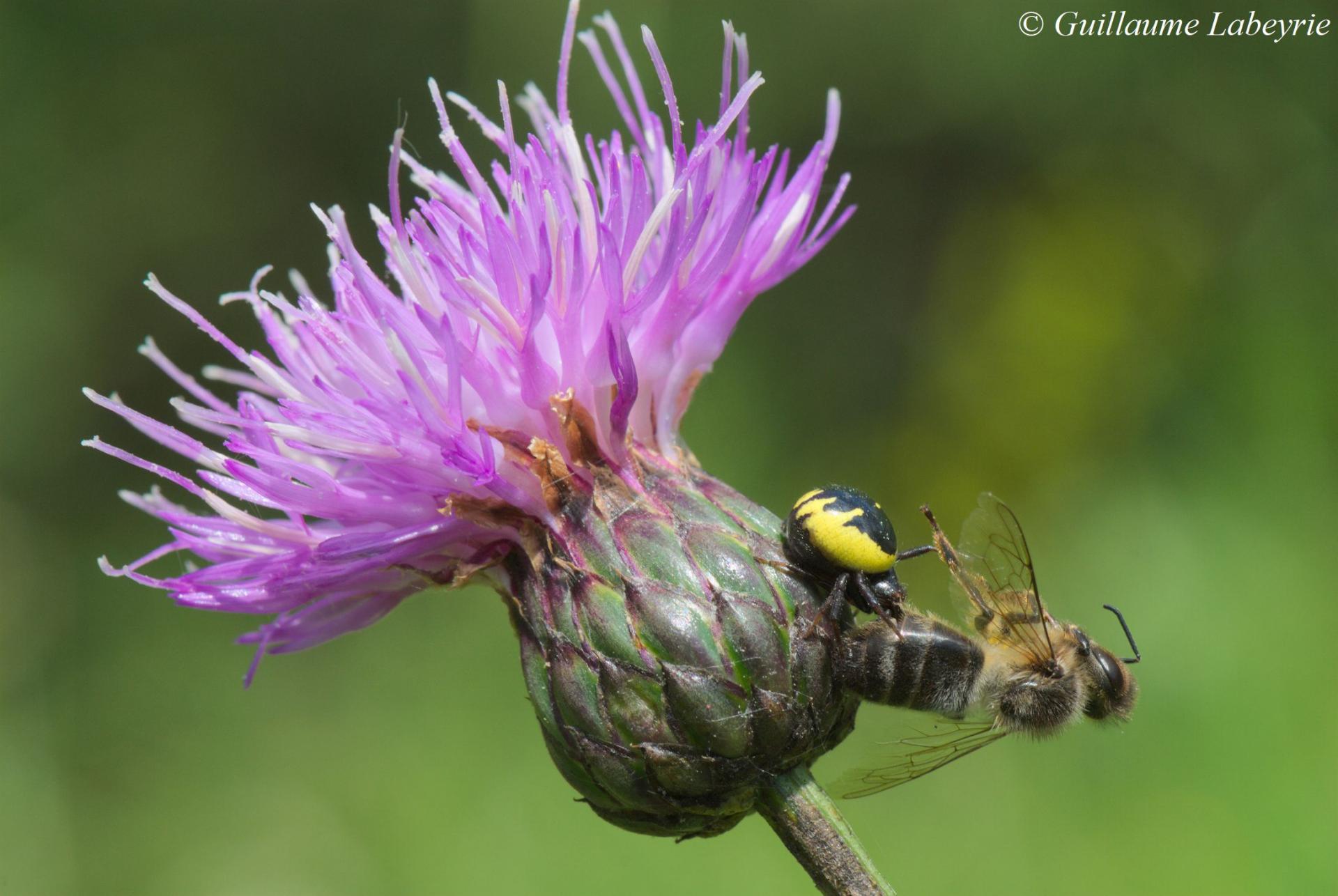 Klasea lycopifolia. This plant has an erected stem up to 80 cm high, with a solitary flower head. The leaves are characteristic: the leaves on the stem are narrow and deeply divided, while the basal leaves are large and ovate, with some divisions near the base. This species is found in humid meadows, around 1100 m of altitude. It is a rare plant in our country, occuring only in the Hautes-Alpes and Alpes-Maritimes. It is listed as "vulnerable" by IUCN, and fully protected.
Klasea lycopifolia. This plant has an erected stem up to 80 cm high, with a solitary flower head. The leaves are characteristic: the leaves on the stem are narrow and deeply divided, while the basal leaves are large and ovate, with some divisions near the base. This species is found in humid meadows, around 1100 m of altitude. It is a rare plant in our country, occuring only in the Hautes-Alpes and Alpes-Maritimes. It is listed as "vulnerable" by IUCN, and fully protected.
Family : Ophioglossaceae
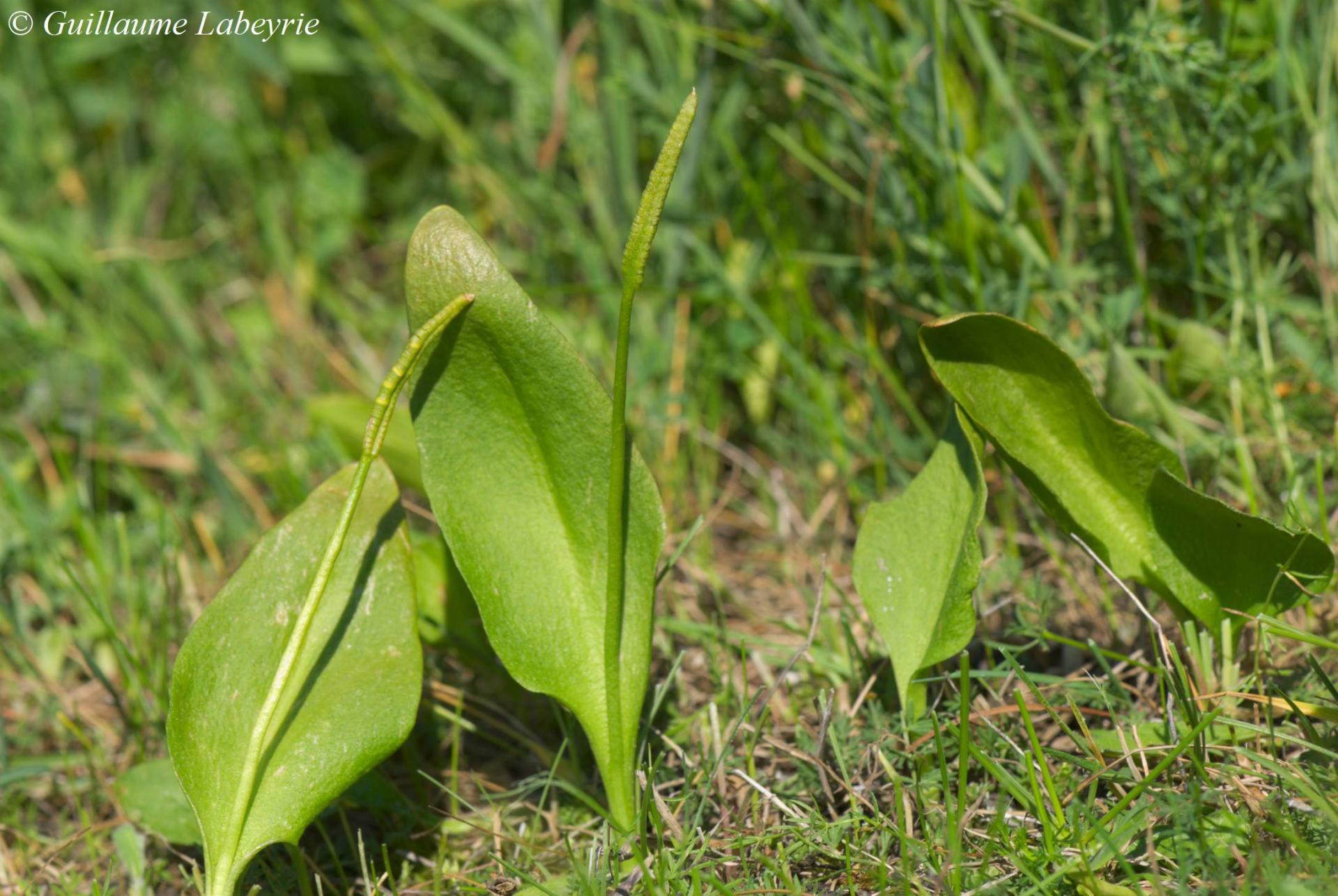 The southern adders-tongue (Ophioglossum vulgatum). This strange plant belongs to a family of primitive ferns. Its is found in wet meadows in low mountains, often in association with the poet's daffodil (Narcissus poeticus) and the broad-leaved marsh orchid (Dactylorhiza majalis, see below). This rare species is protected in the PACA region.
The southern adders-tongue (Ophioglossum vulgatum). This strange plant belongs to a family of primitive ferns. Its is found in wet meadows in low mountains, often in association with the poet's daffodil (Narcissus poeticus) and the broad-leaved marsh orchid (Dactylorhiza majalis, see below). This rare species is protected in the PACA region.
Family : Orchidaceae
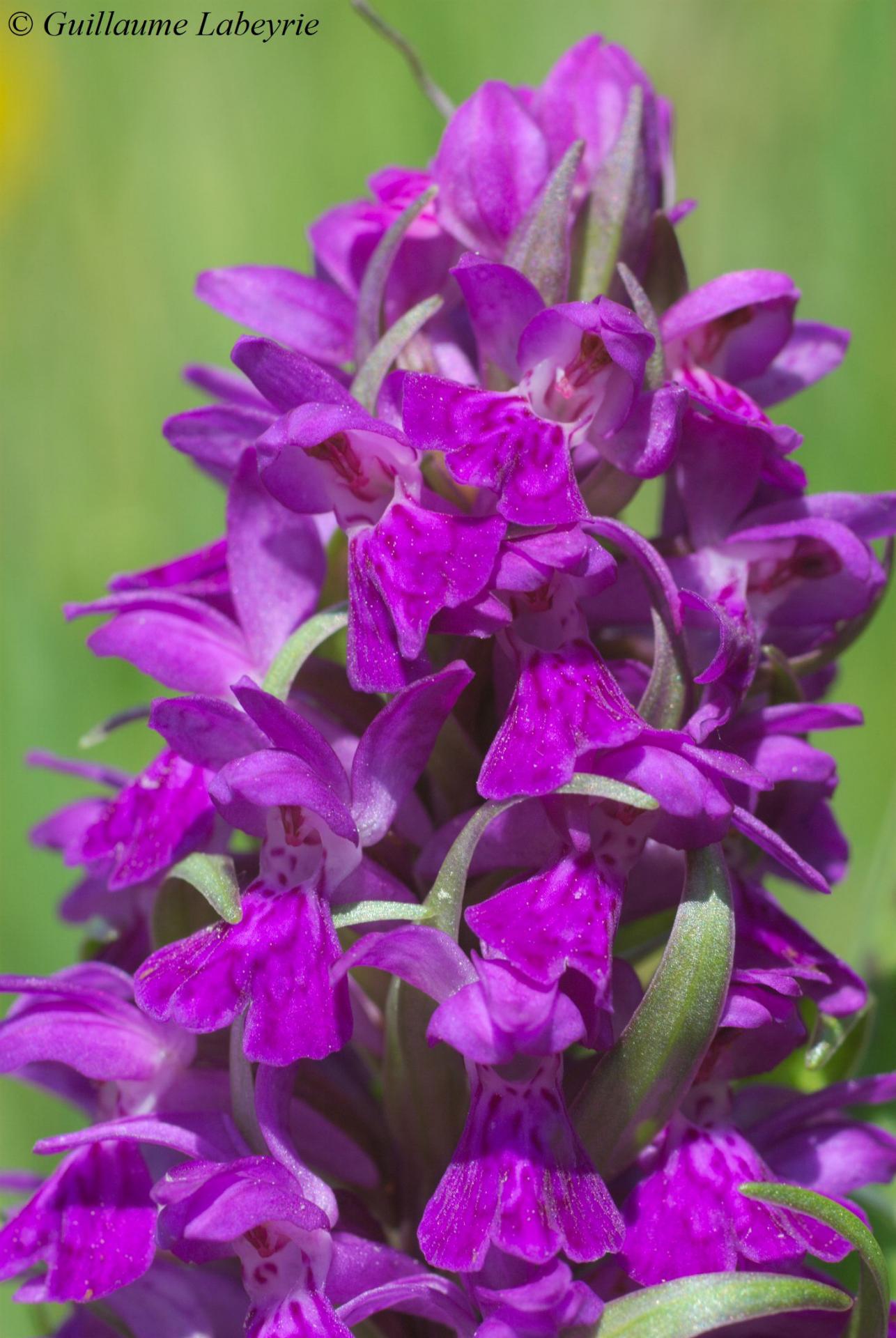 The broad-leaved marsh orchid (Dactylorhiza majalis). This stocky orchid has distinctive deep purple flowers and green leaves with large black spots. In the Prealps, it is found in wet meadows at the bottom of valleys, where it often grows in company of the poet's daffodil (Narcissus poeticus) and the southern adders-tongue (Ophioglossum vulgatum). This orchid flowers in May. It is present in most of Europe (except the Mediterranean range), where it is declining due to the loss of wetlands.
The broad-leaved marsh orchid (Dactylorhiza majalis). This stocky orchid has distinctive deep purple flowers and green leaves with large black spots. In the Prealps, it is found in wet meadows at the bottom of valleys, where it often grows in company of the poet's daffodil (Narcissus poeticus) and the southern adders-tongue (Ophioglossum vulgatum). This orchid flowers in May. It is present in most of Europe (except the Mediterranean range), where it is declining due to the loss of wetlands.
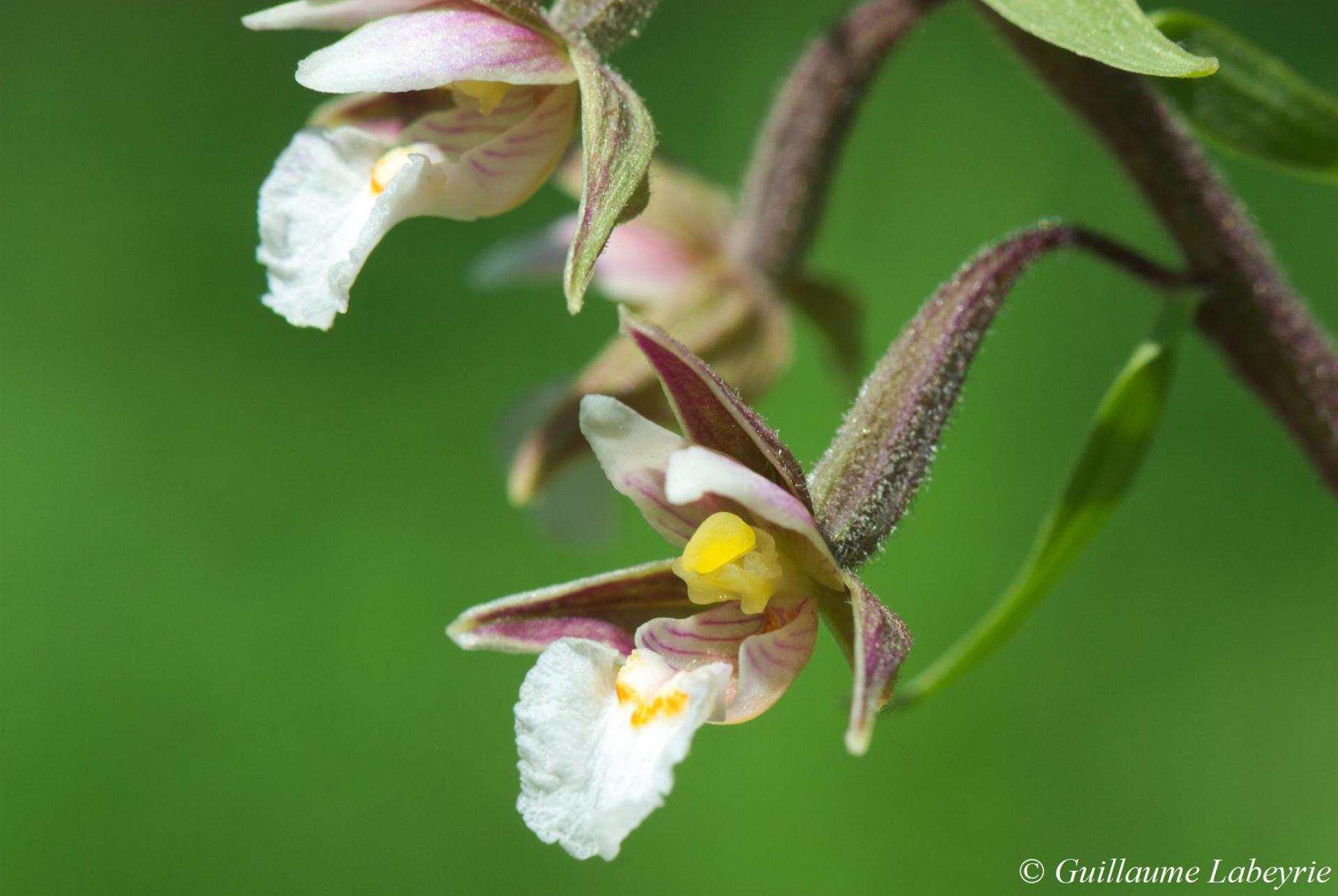 The marsh helleborine (Epipactis palustris). This orchid is the most spectacular member of the Epipactis genus in the area, with large colorful flowers. The blooming occurs in June. It is found along streams and in wet meadows, where it is scarce. Distributed in Europe and Asia, the marsh helleborine is relatively widespread in France but usually rare.
The marsh helleborine (Epipactis palustris). This orchid is the most spectacular member of the Epipactis genus in the area, with large colorful flowers. The blooming occurs in June. It is found along streams and in wet meadows, where it is scarce. Distributed in Europe and Asia, the marsh helleborine is relatively widespread in France but usually rare.
Fauna
Dragonflies and Damselflies (Odonata)
Family : Lestidae
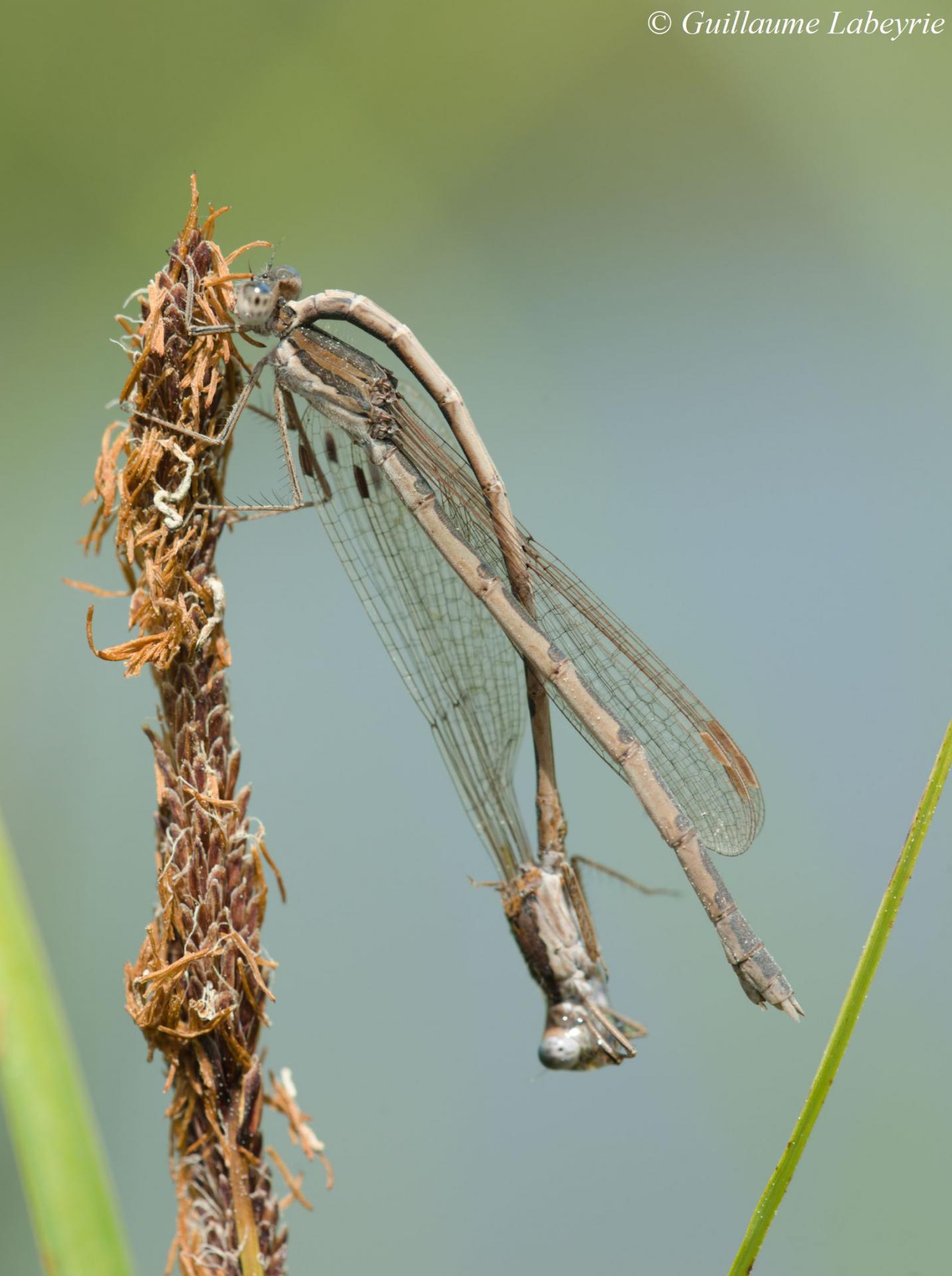 The common winter damselfly (Sympecma fusca). Both sexes of this small species are brownish. Members of the Sympecma genus are the only damselflies in Europe to winter as adults. This species, occuring in most of souther and central Europe, is found in ponds around 1000 m of altitude in the Préalpes de Grasse.
The common winter damselfly (Sympecma fusca). Both sexes of this small species are brownish. Members of the Sympecma genus are the only damselflies in Europe to winter as adults. This species, occuring in most of souther and central Europe, is found in ponds around 1000 m of altitude in the Préalpes de Grasse.
Family : Libellulidae
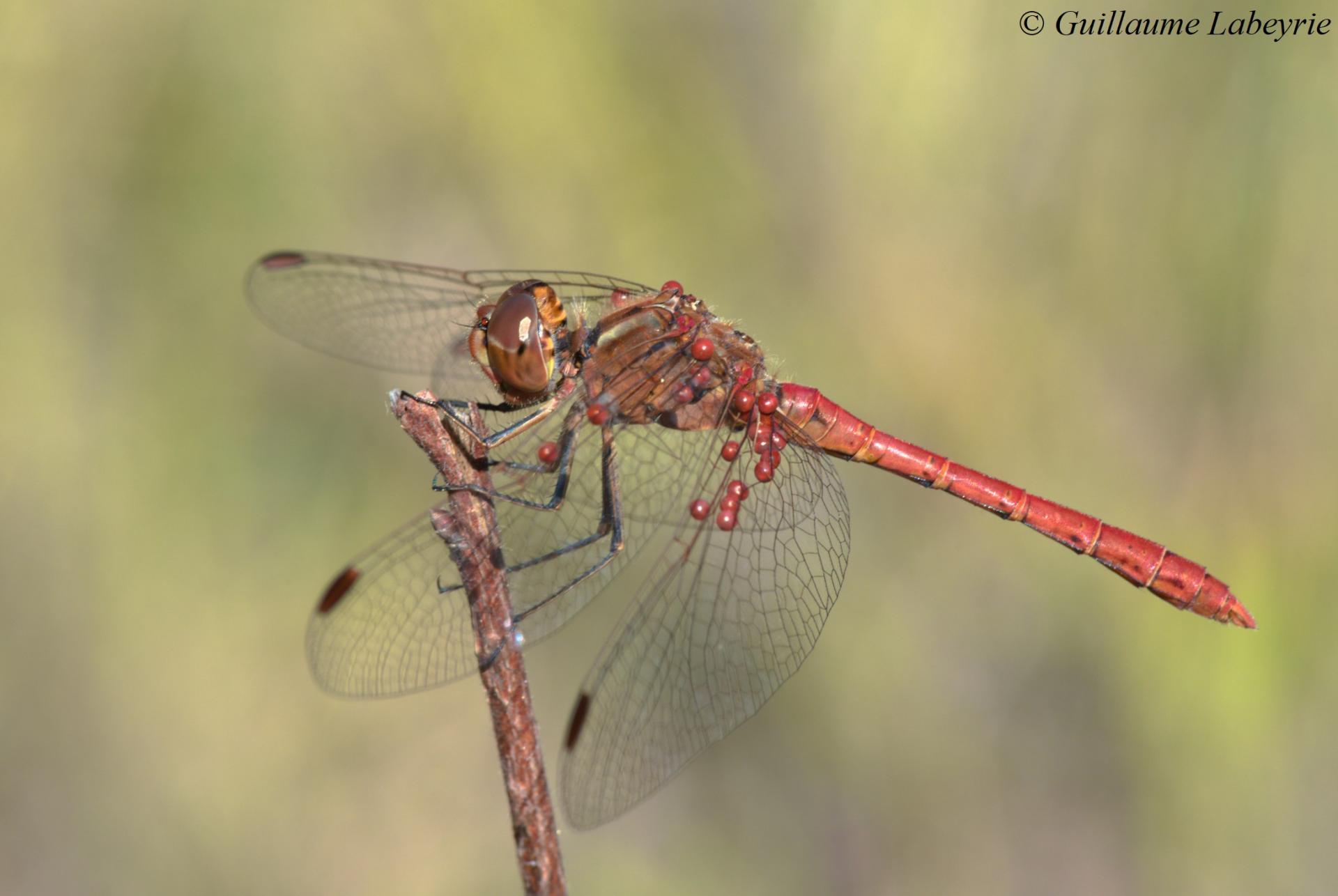 The southern darter (Sympetrum meridionale). Family: Libellulidae. This darter is distinguished from species belonging to the same genus by its yellow and black legs, its red body (for the male) and the uniform brown color of the thorax. In the Prealps, it is often founds around ponds. The small red "pearls" on the wings are larvae of an aquatic mite of the genus Arrenus, which parazites the insect. Sympetrum meridionale seems particularly prone to these encumbering hosts !
The southern darter (Sympetrum meridionale). Family: Libellulidae. This darter is distinguished from species belonging to the same genus by its yellow and black legs, its red body (for the male) and the uniform brown color of the thorax. In the Prealps, it is often founds around ponds. The small red "pearls" on the wings are larvae of an aquatic mite of the genus Arrenus, which parazites the insect. Sympetrum meridionale seems particularly prone to these encumbering hosts !
Butterflies and Moths (Lepidoptera)
Family : Nymphalidae / Sub-Family : Nymphalinae
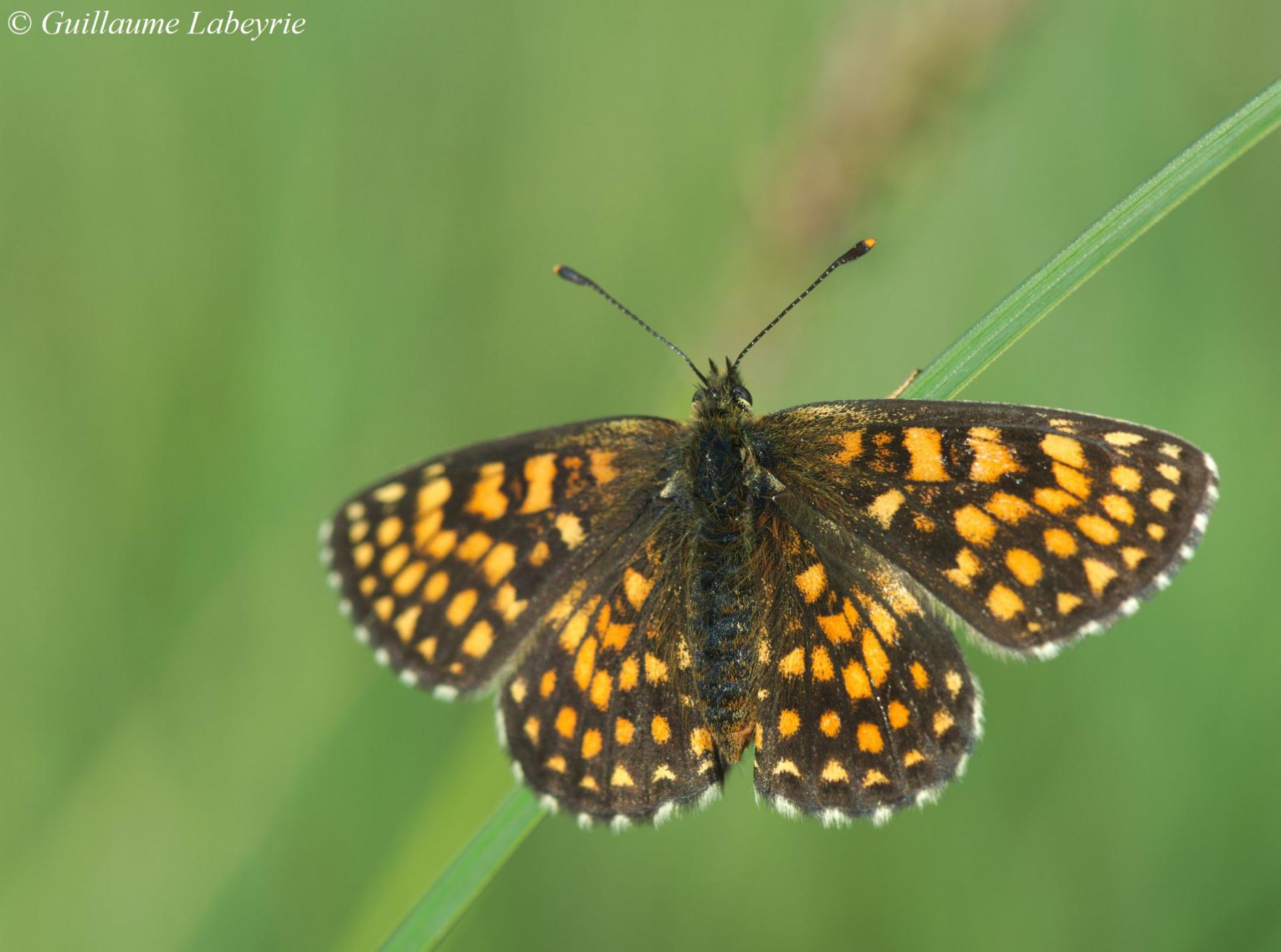 The false heath fritillary (Melitaea diamina). This small species has a much darker background color than other species of the genus. It is found in damp meadows in low mountain ranges. Widespread in central and southern Europe and reaching Asia, this butterfly occurs in France in a south-eastern half.
The false heath fritillary (Melitaea diamina). This small species has a much darker background color than other species of the genus. It is found in damp meadows in low mountain ranges. Widespread in central and southern Europe and reaching Asia, this butterfly occurs in France in a south-eastern half.
Grasshoppers (Orthoptera)
Family : Tettigonidae / Sub-Family : Tettigoninae
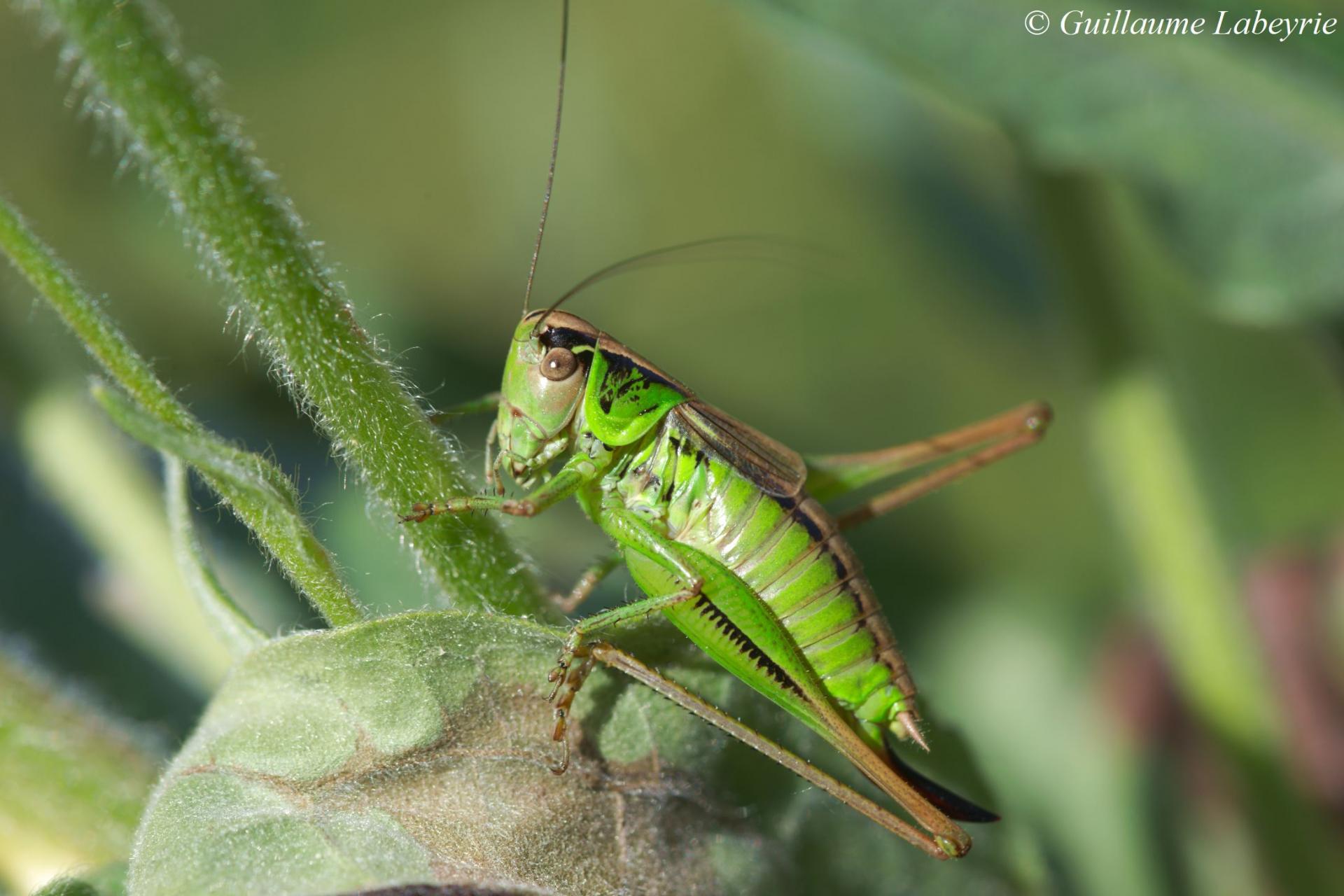 Roesel's bush-cricket (Roeseliana roeselii). This small species has the sides of the pronotum often dark and bordered with green. A very similar species, Azam's bush-cricket (Roeseliana azami), has not yet been observed in the Alpes-Maritimes but is present in the neighbouring departements of the Var and Alpes-de-Haute-Provence. Roeseliana roeselii appreciates rather humid habitats with tall grasses. In the Prealps, this species is found in wet meadows. Roesel's bush-criket occurs from western Europe to western Siberia. It is found in most of the French territory.
Roesel's bush-cricket (Roeseliana roeselii). This small species has the sides of the pronotum often dark and bordered with green. A very similar species, Azam's bush-cricket (Roeseliana azami), has not yet been observed in the Alpes-Maritimes but is present in the neighbouring departements of the Var and Alpes-de-Haute-Provence. Roeseliana roeselii appreciates rather humid habitats with tall grasses. In the Prealps, this species is found in wet meadows. Roesel's bush-criket occurs from western Europe to western Siberia. It is found in most of the French territory.
Family : Tetrigidae
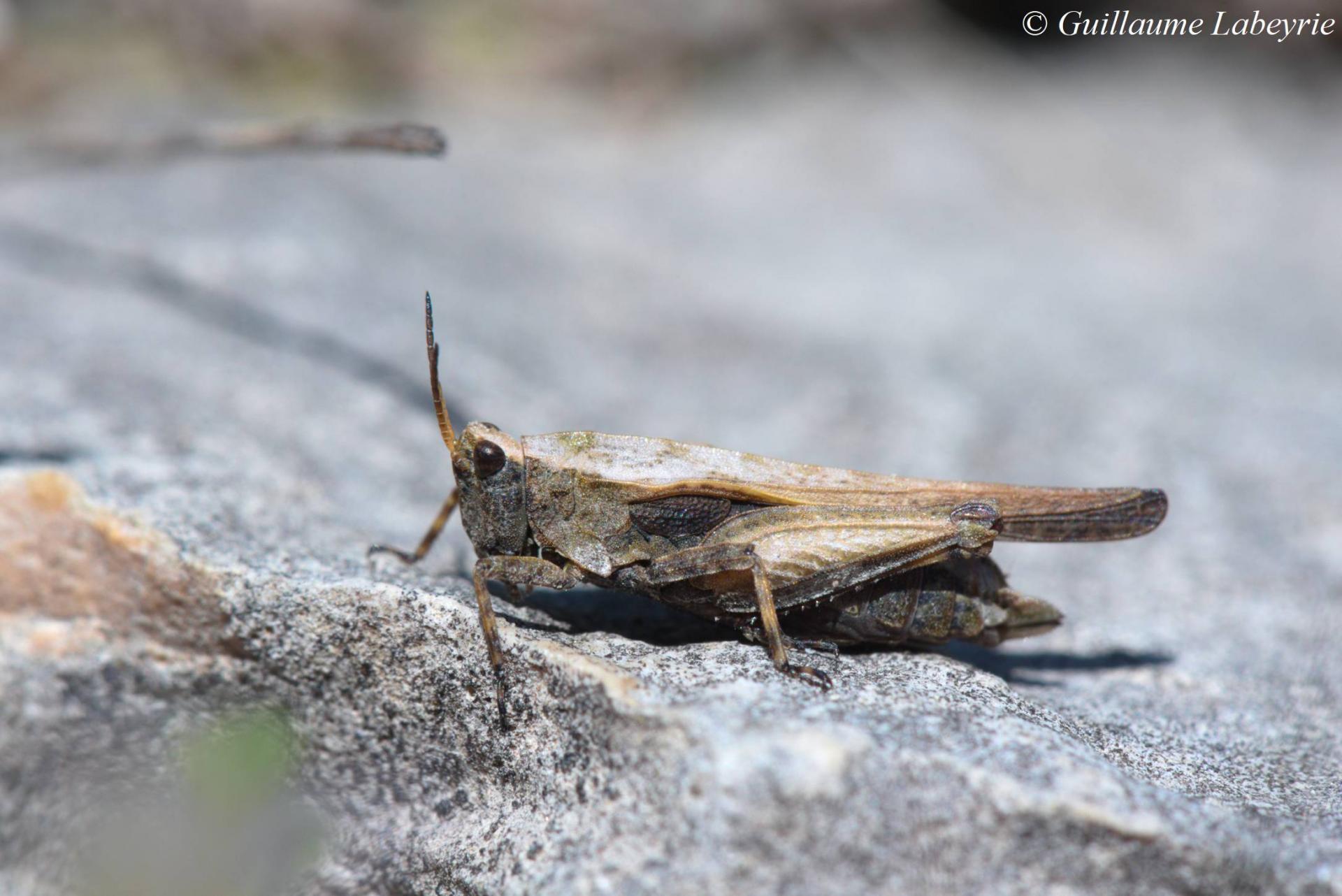 The slender ground-hopper (Tetrix subulata). This tiny species is found in humid areas, for example the banks of ponds, often in the company of Tetrix depressa. It is found up to about 1000 m of altitude. It is present in a large part of France, but rarer on the Mediterranean coast.
The slender ground-hopper (Tetrix subulata). This tiny species is found in humid areas, for example the banks of ponds, often in the company of Tetrix depressa. It is found up to about 1000 m of altitude. It is present in a large part of France, but rarer on the Mediterranean coast.
The karstic landscape of the Grasse Prealps includes many cliffs and other steep rocky habitats. These serve as a shelter for a number of species, including for instance rare breeding birds such as the golden eagle (Aquila chrysaetos), the peregrine falcon (Falco peregrinus) and the red-billed chough (Pyrrhocorax pyrrhocorax).
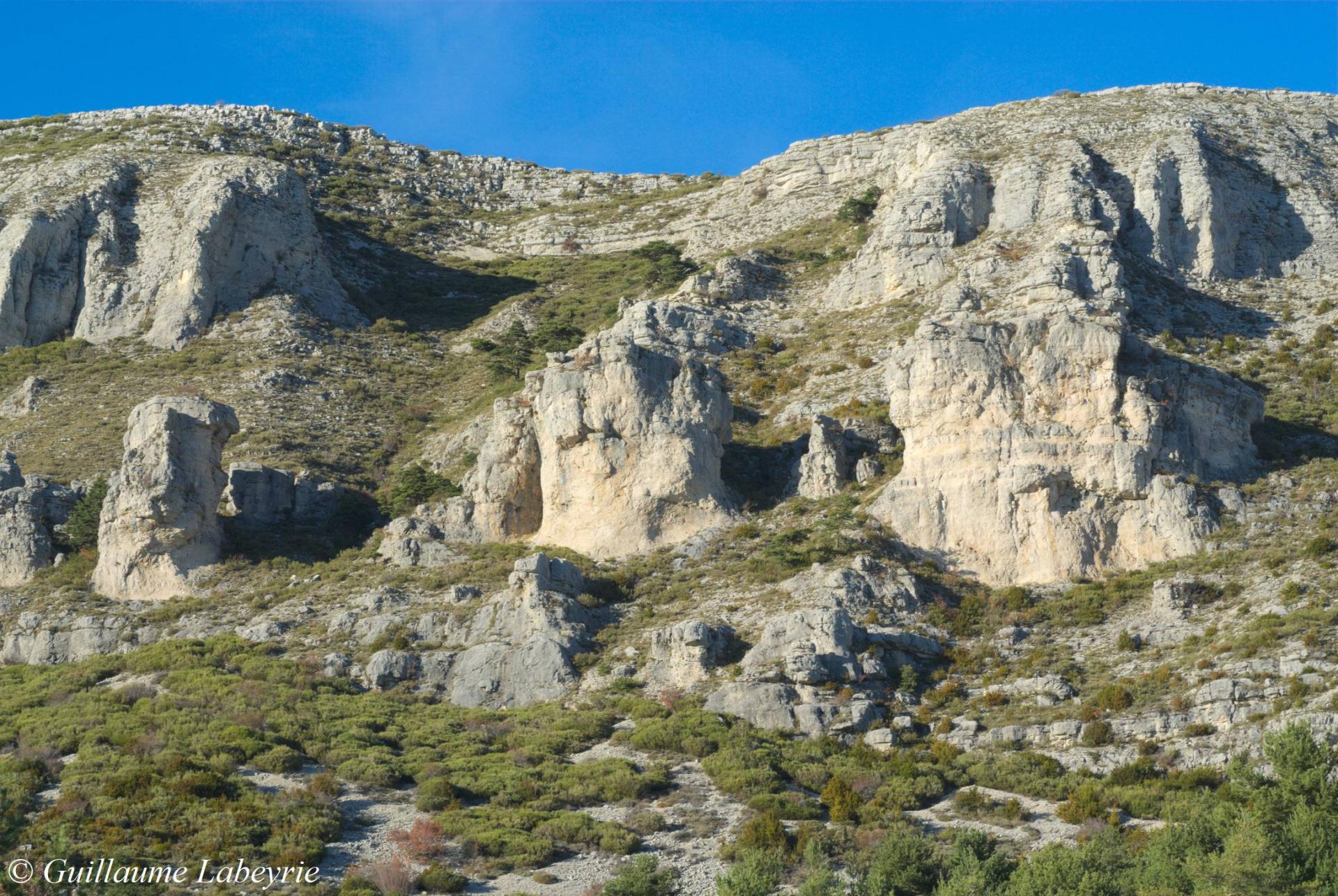 Cliffs of the plateau de Calern.
Cliffs of the plateau de Calern.
Flora
Family : Asteraceae
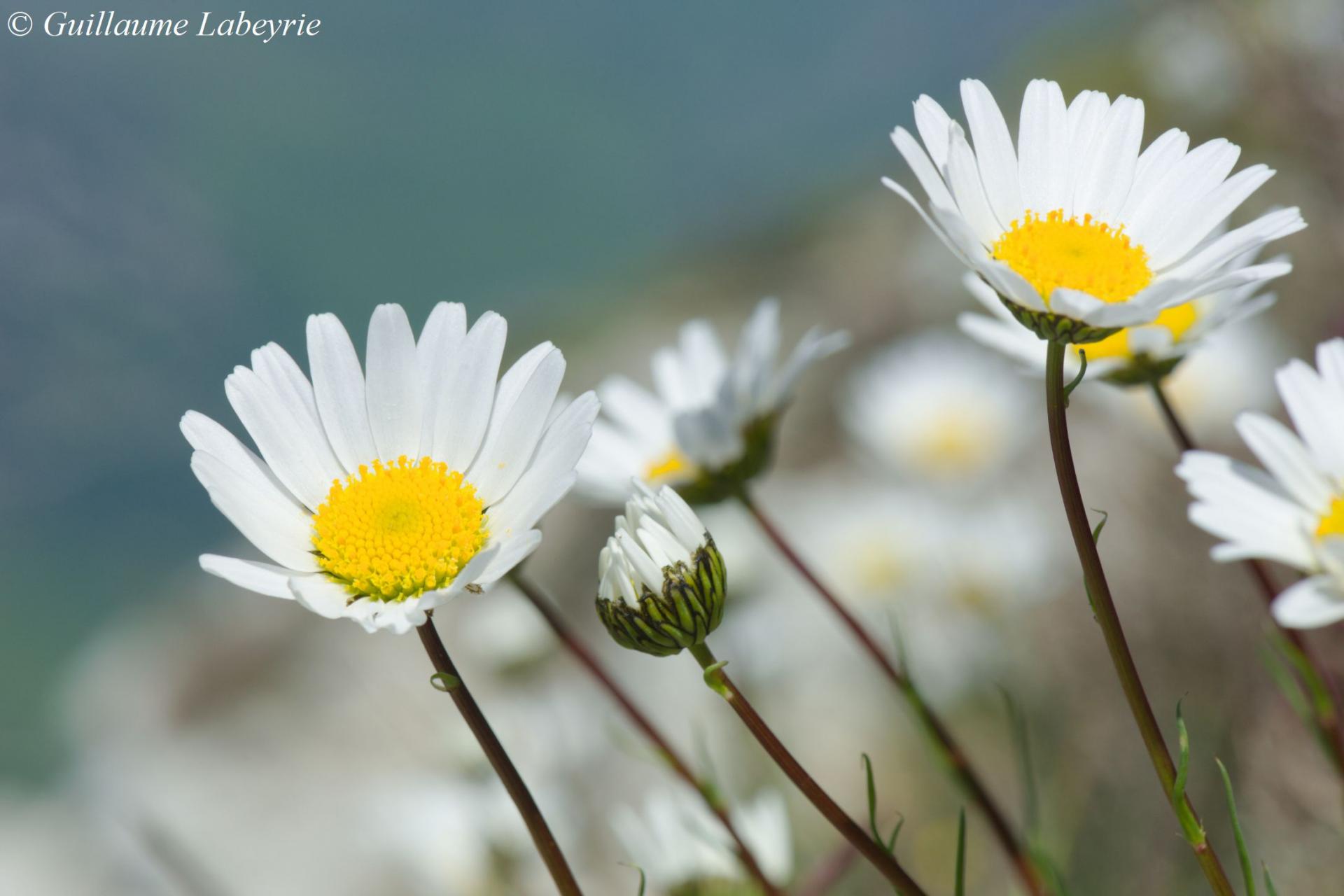 Leucanthemum burnatii. This nice daisy is distinguished by its long and very narrow leaves. It grows in calcareous dry grasslands, rocks and cliffs. It is endemic to southeastern France.
Leucanthemum burnatii. This nice daisy is distinguished by its long and very narrow leaves. It grows in calcareous dry grasslands, rocks and cliffs. It is endemic to southeastern France.
Family : Brassicaceae
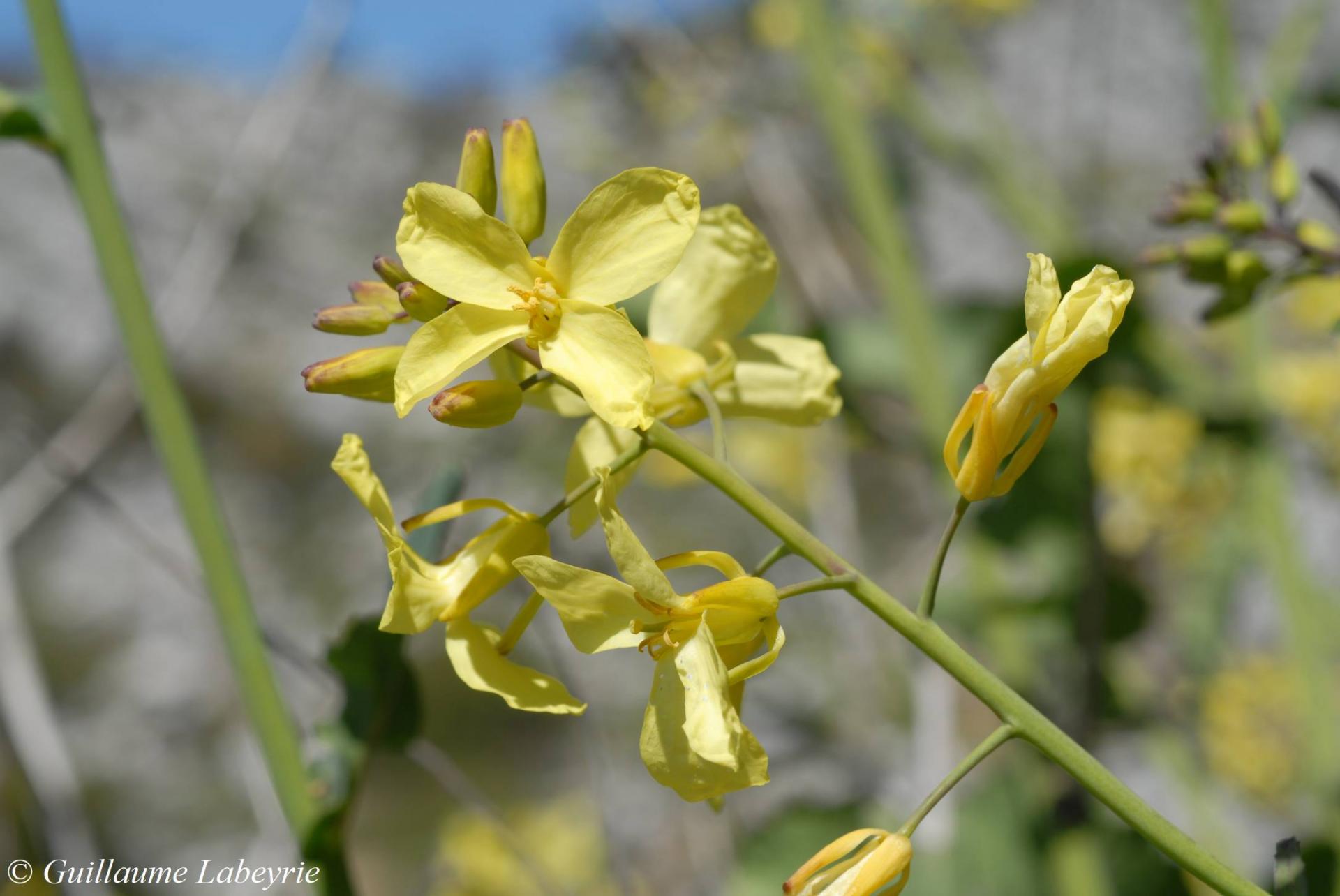 The mountain cabbage (Brassica montana). This wild cabbage grows in calcareous cliffs, often in canyons. It flowers in April, sprouting spectacular flowering spikes reaching 1 m. Restricted in France to a few southern departments, this species is protected in the PACA region.
The mountain cabbage (Brassica montana). This wild cabbage grows in calcareous cliffs, often in canyons. It flowers in April, sprouting spectacular flowering spikes reaching 1 m. Restricted in France to a few southern departments, this species is protected in the PACA region.
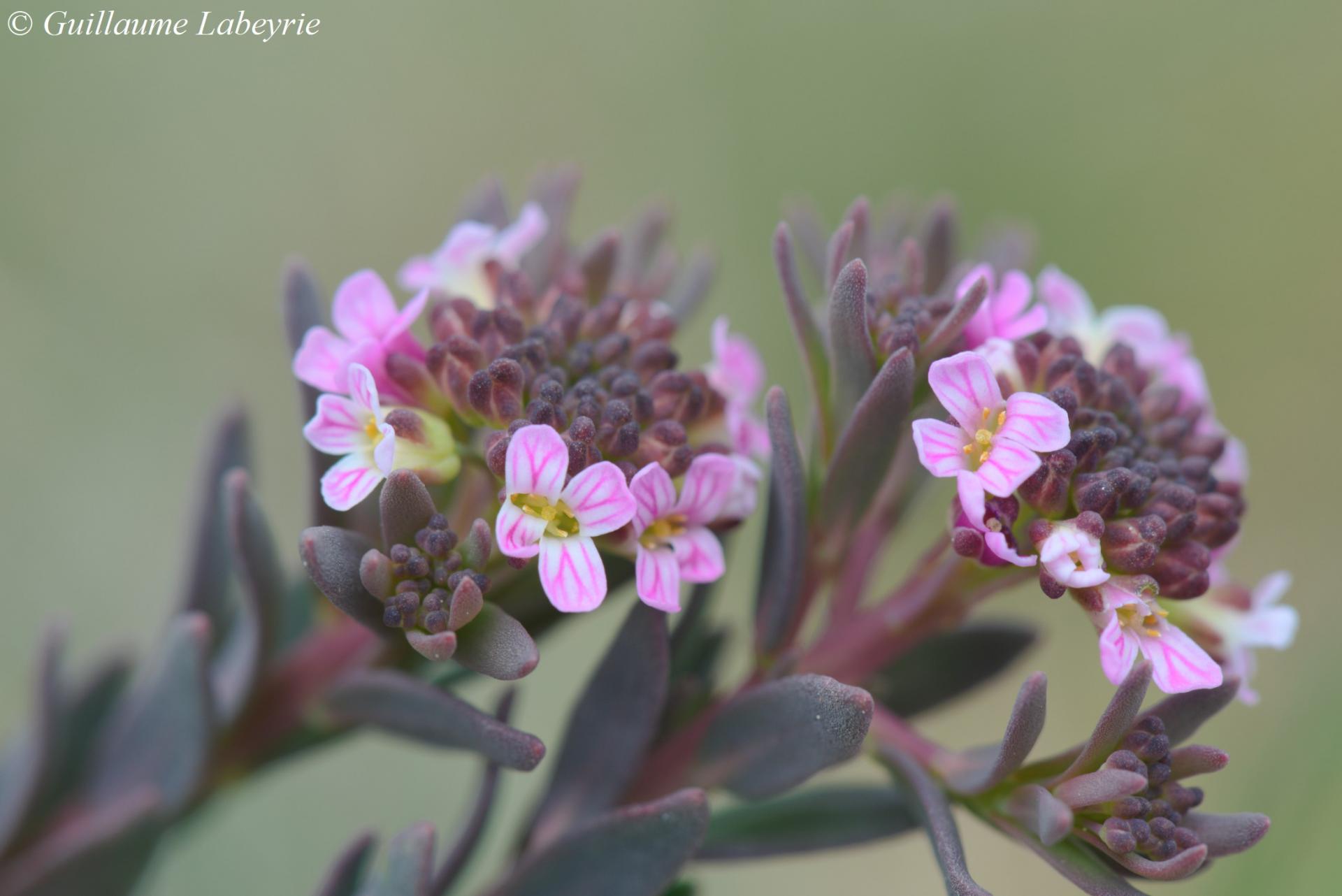 The burnt candytuft (Aethionema saxatile). This pretty, small plant is found on rocky limestone slopes. It is the feeder plant of the mountain small white (Pieris ergane), a protected butterfly (not present in the area). This Mediterranean plant occurs in France in the South-East.
The burnt candytuft (Aethionema saxatile). This pretty, small plant is found on rocky limestone slopes. It is the feeder plant of the mountain small white (Pieris ergane), a protected butterfly (not present in the area). This Mediterranean plant occurs in France in the South-East.
Family : Crassulaceae
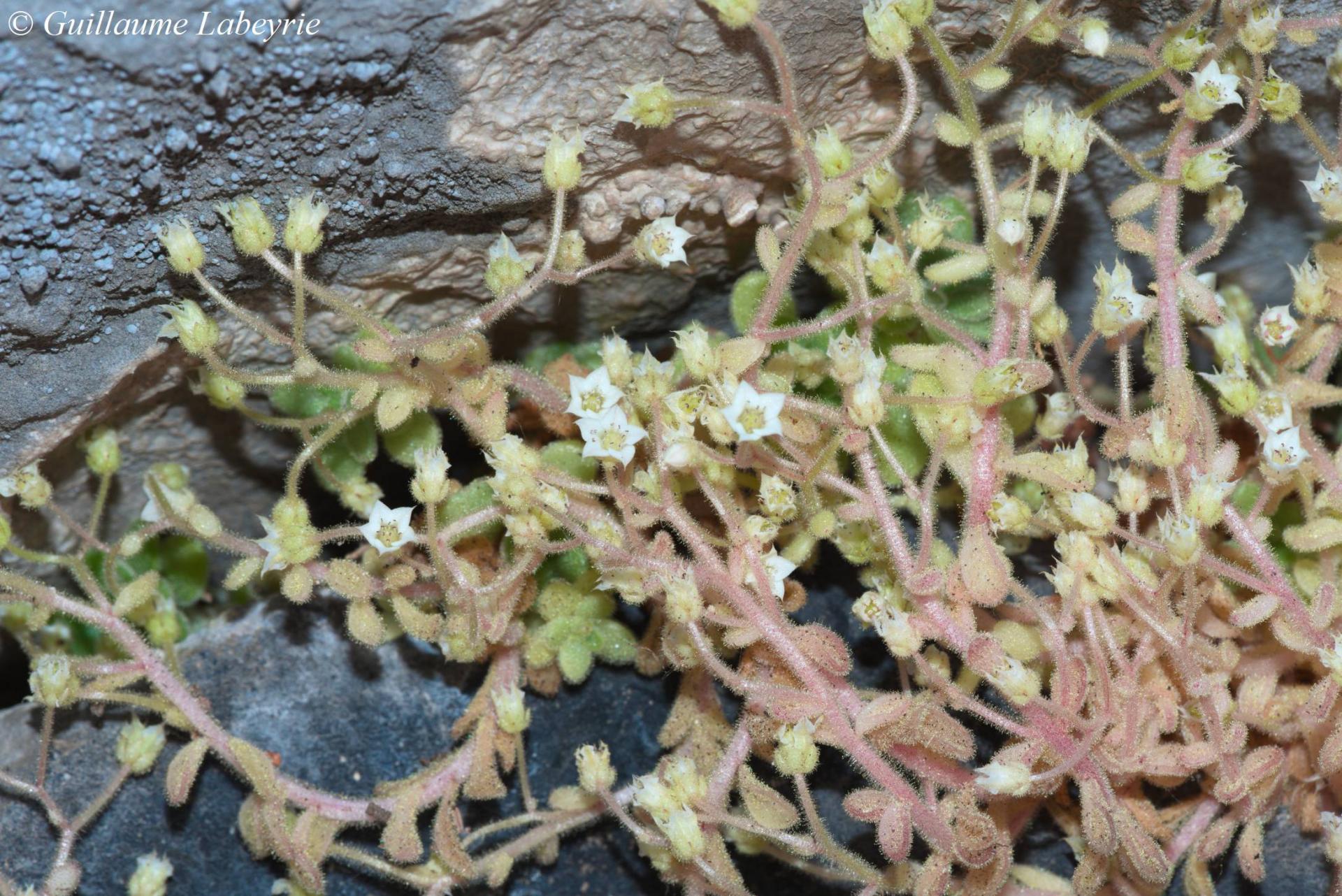 Sedum fragrans. This peculiar stonecrop grows in shaded overhangs of limestone cliffs. The whole plant is covered with glandular hairs. This species is restricted to the extreme South-East of France, from the Verdon to the Italian border. It is protected in région PACA.
Sedum fragrans. This peculiar stonecrop grows in shaded overhangs of limestone cliffs. The whole plant is covered with glandular hairs. This species is restricted to the extreme South-East of France, from the Verdon to the Italian border. It is protected in région PACA.
Family : Euphorbiaceae
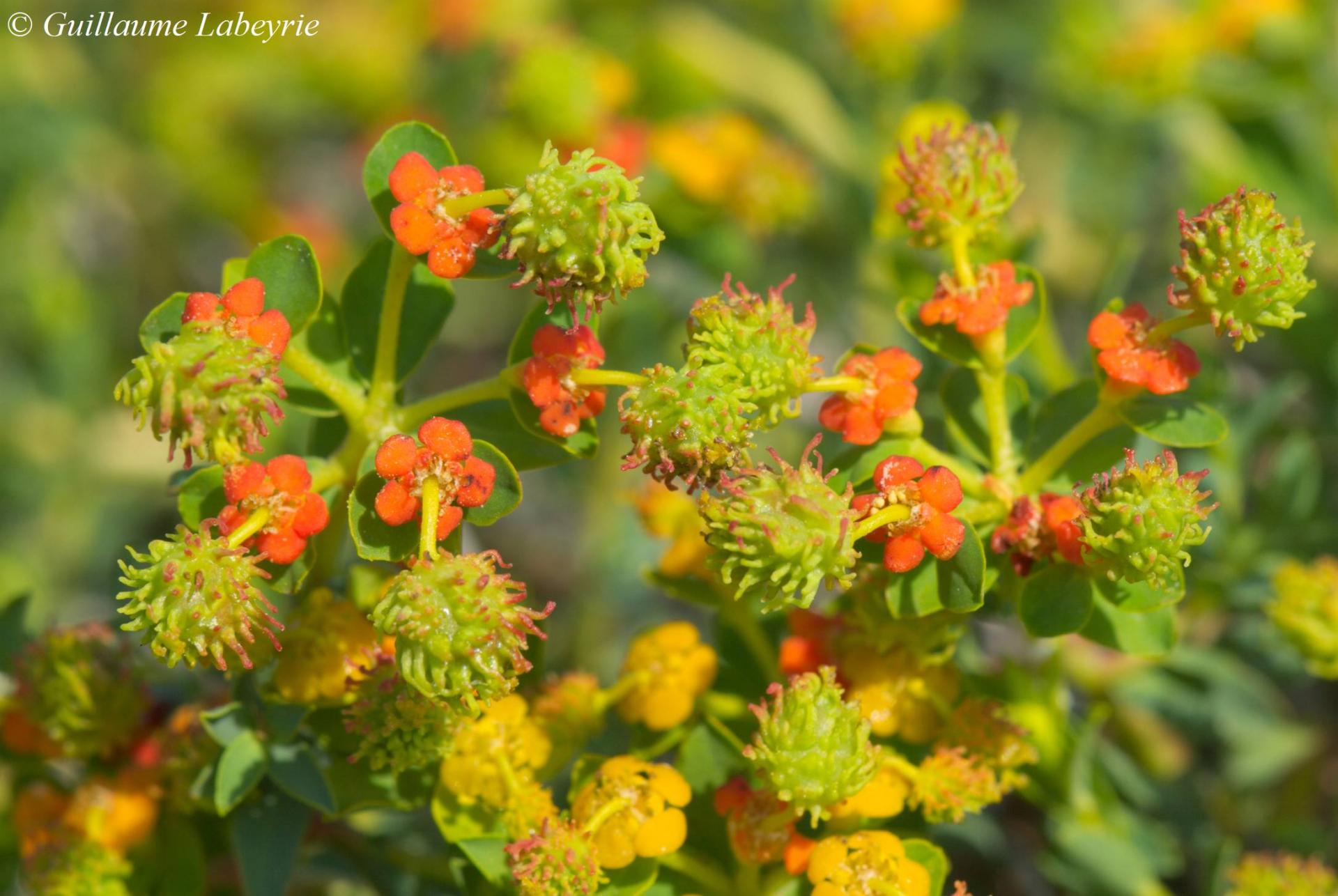 The spiny spurge (Euphorbia spinosa). This spurge is very common in the Prealps. It grows in small, low shrubs. The old branch-tips are spiny. This species is a specialist of dry, rocky habitats. The spiny spurge is found from south-eastern France to Albania.
The spiny spurge (Euphorbia spinosa). This spurge is very common in the Prealps. It grows in small, low shrubs. The old branch-tips are spiny. This species is a specialist of dry, rocky habitats. The spiny spurge is found from south-eastern France to Albania.
Family : Geraniaceae
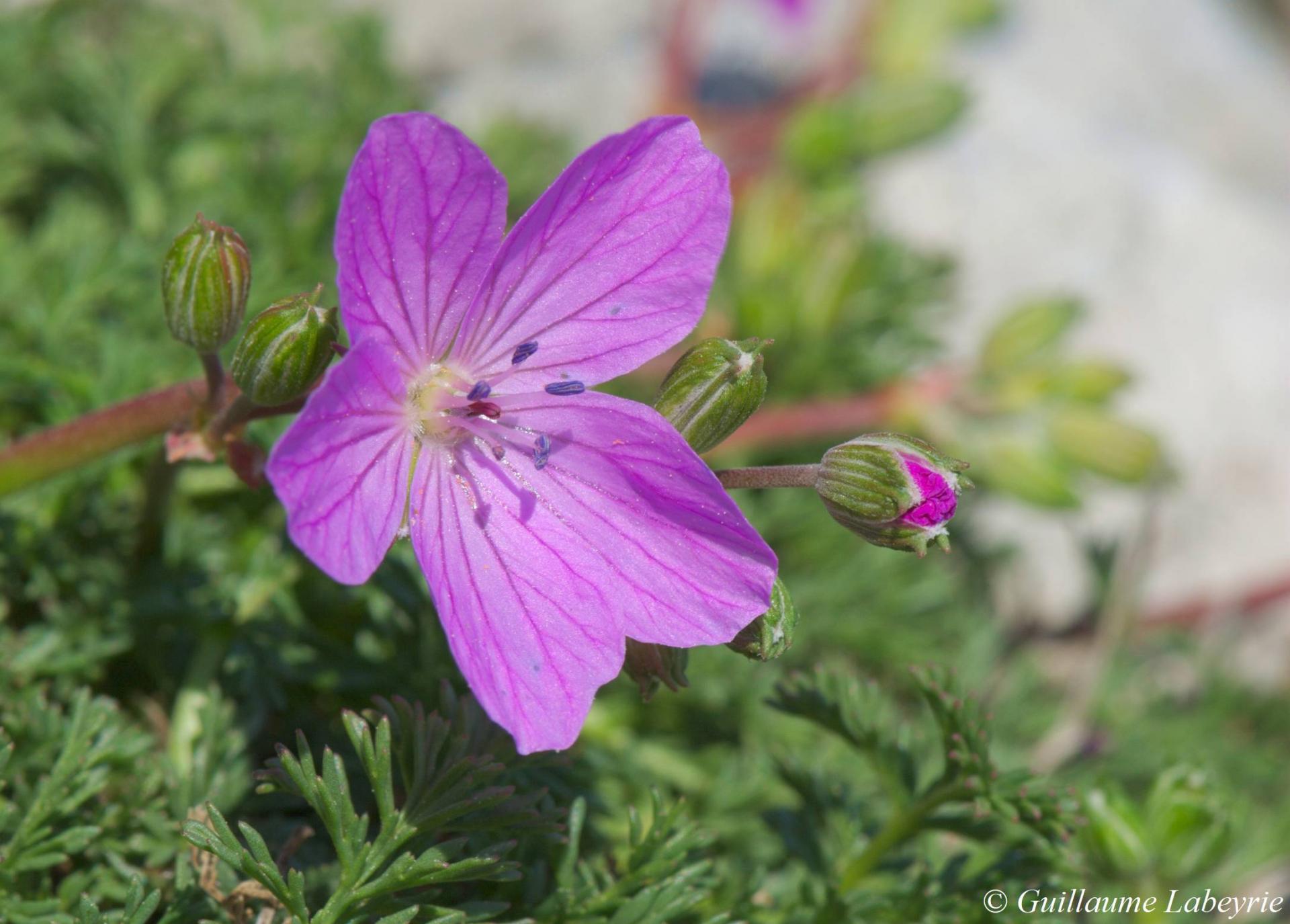 Rodié's storksbill (Erodium rodiei). This striking species has distinctive large pink flowers, and a very divided foliage. The fruits are very elongated. It flowers in April-May, in the cracks of calcareous rocks and cliffs. This plant, very rare and local, is endemic to the Préalpes de Grasse. It is fully protected.
Rodié's storksbill (Erodium rodiei). This striking species has distinctive large pink flowers, and a very divided foliage. The fruits are very elongated. It flowers in April-May, in the cracks of calcareous rocks and cliffs. This plant, very rare and local, is endemic to the Préalpes de Grasse. It is fully protected.
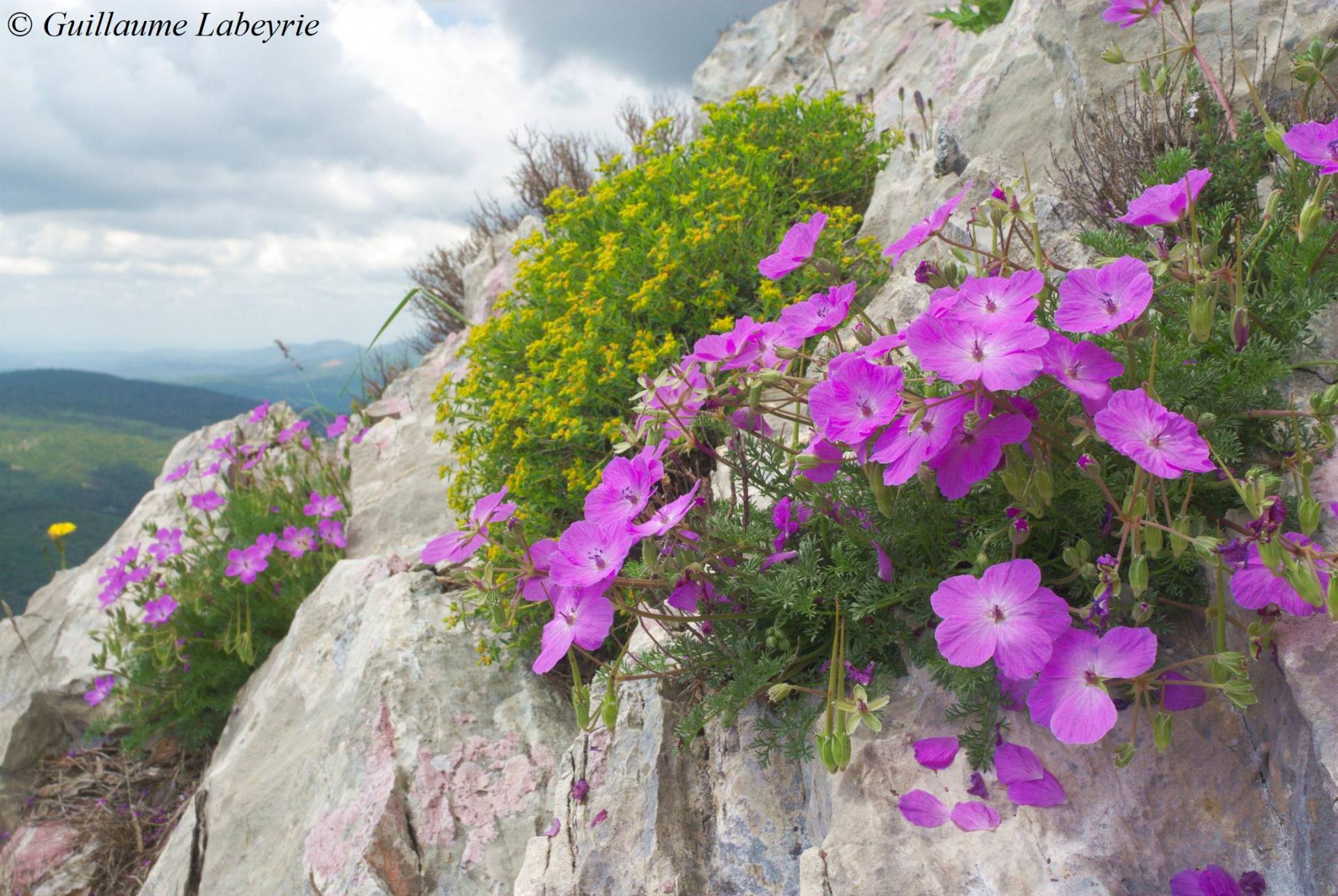 Rodié's storksbill.
Rodié's storksbill.
Family : Lamiaceae
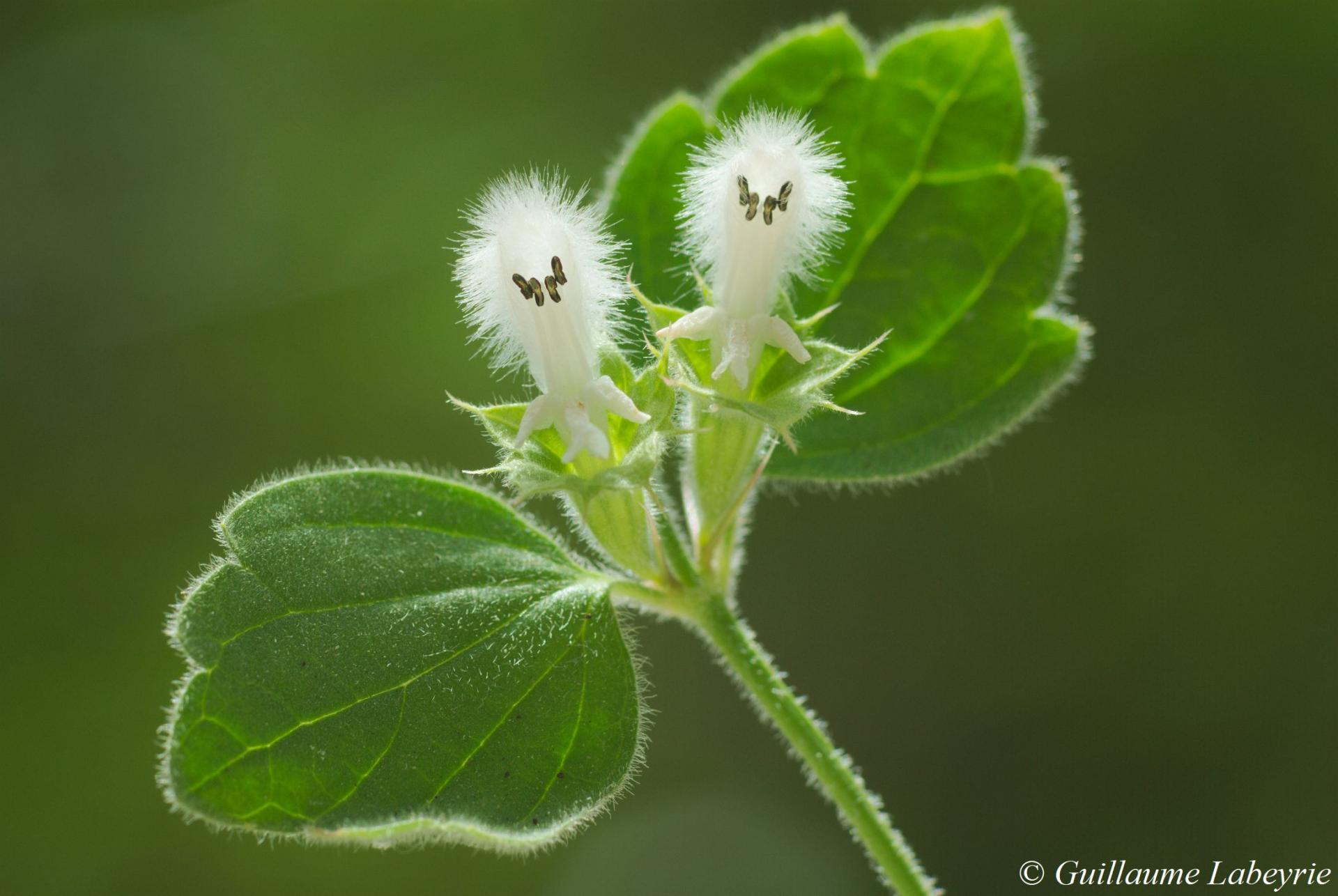 The spiny horehound (Acanthoprasium frutescens). This strange little plant forms shrubs hanging from calcareous cliffs, especially in canyons. Its flowers, with characteristic white plumes, bloom from May to July. This species is found mostly in the Alpes-Maritimes, and protected in the PACA region.
The spiny horehound (Acanthoprasium frutescens). This strange little plant forms shrubs hanging from calcareous cliffs, especially in canyons. Its flowers, with characteristic white plumes, bloom from May to July. This species is found mostly in the Alpes-Maritimes, and protected in the PACA region.
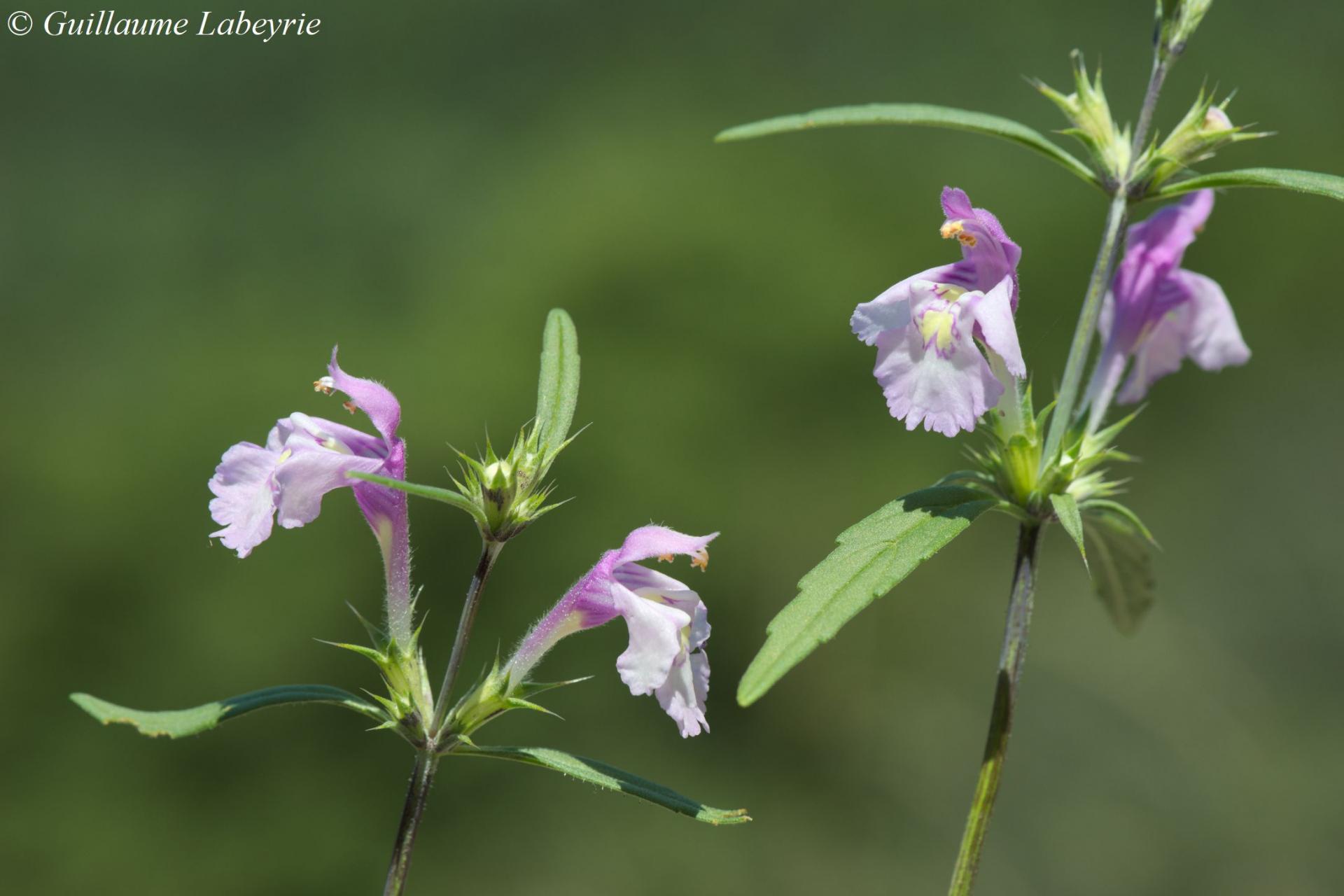 Reuter's hemp-nettle (Galeopsis reuteri). This species differs from others from the genus Galeopsis by its habitat (fine calcareous scree), its narrow dented leaves and its hairless, rounded stem. It is a Ligurian endemic, present in France only in the Alpes-de-Haute-Provence and Alpes-Maritimes.
Reuter's hemp-nettle (Galeopsis reuteri). This species differs from others from the genus Galeopsis by its habitat (fine calcareous scree), its narrow dented leaves and its hairless, rounded stem. It is a Ligurian endemic, present in France only in the Alpes-de-Haute-Provence and Alpes-Maritimes.
Family : Liliaceae
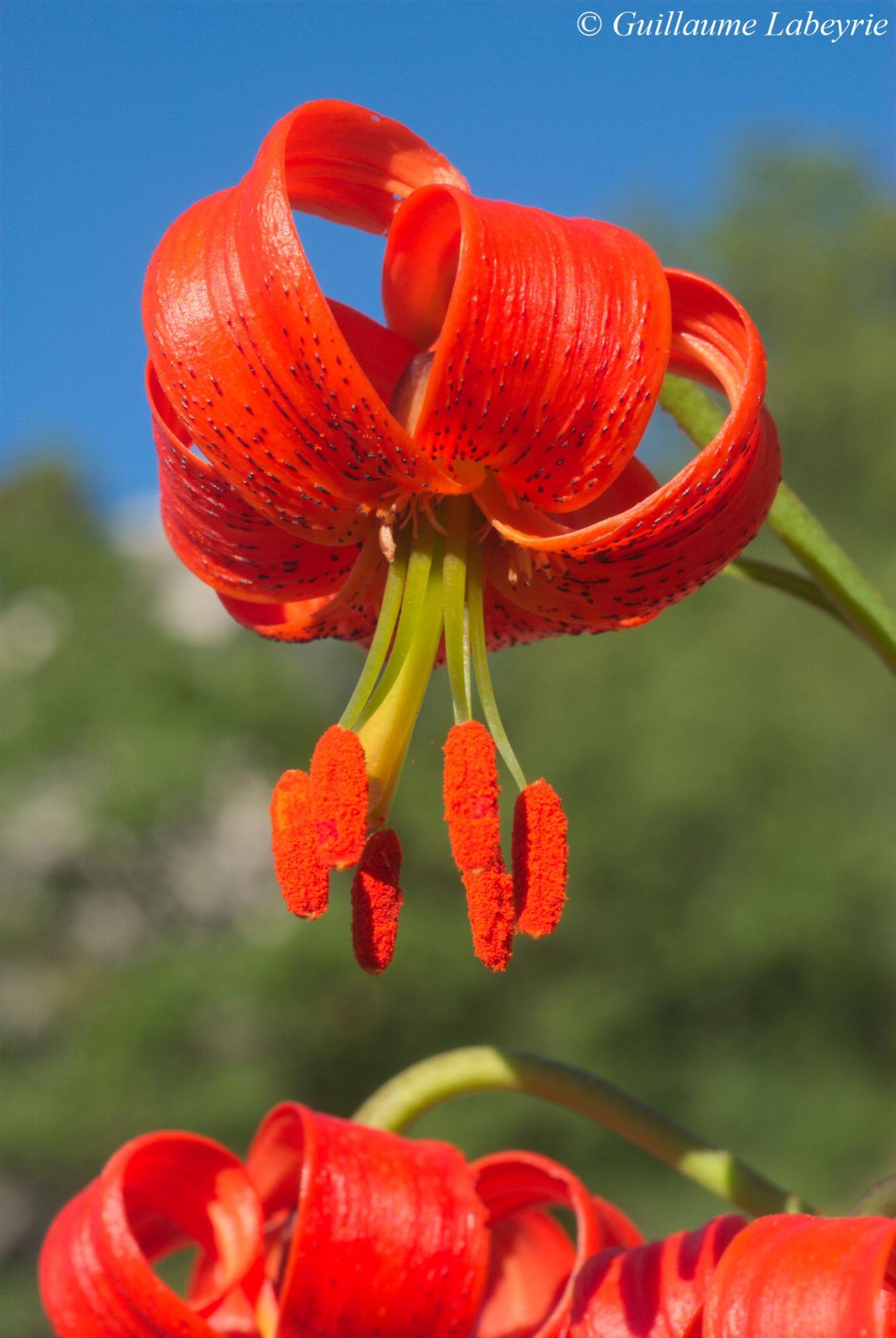 The red lily (Lilium pomponium). This magnificent lily, very spectacular, can not be confused. It is found in rocky area exposed to the south, in low mountain ranges. The flowering occurs in June. This Ligurian endemic is present in France only in the extreme south-east.
The red lily (Lilium pomponium). This magnificent lily, very spectacular, can not be confused. It is found in rocky area exposed to the south, in low mountain ranges. The flowering occurs in June. This Ligurian endemic is present in France only in the extreme south-east.
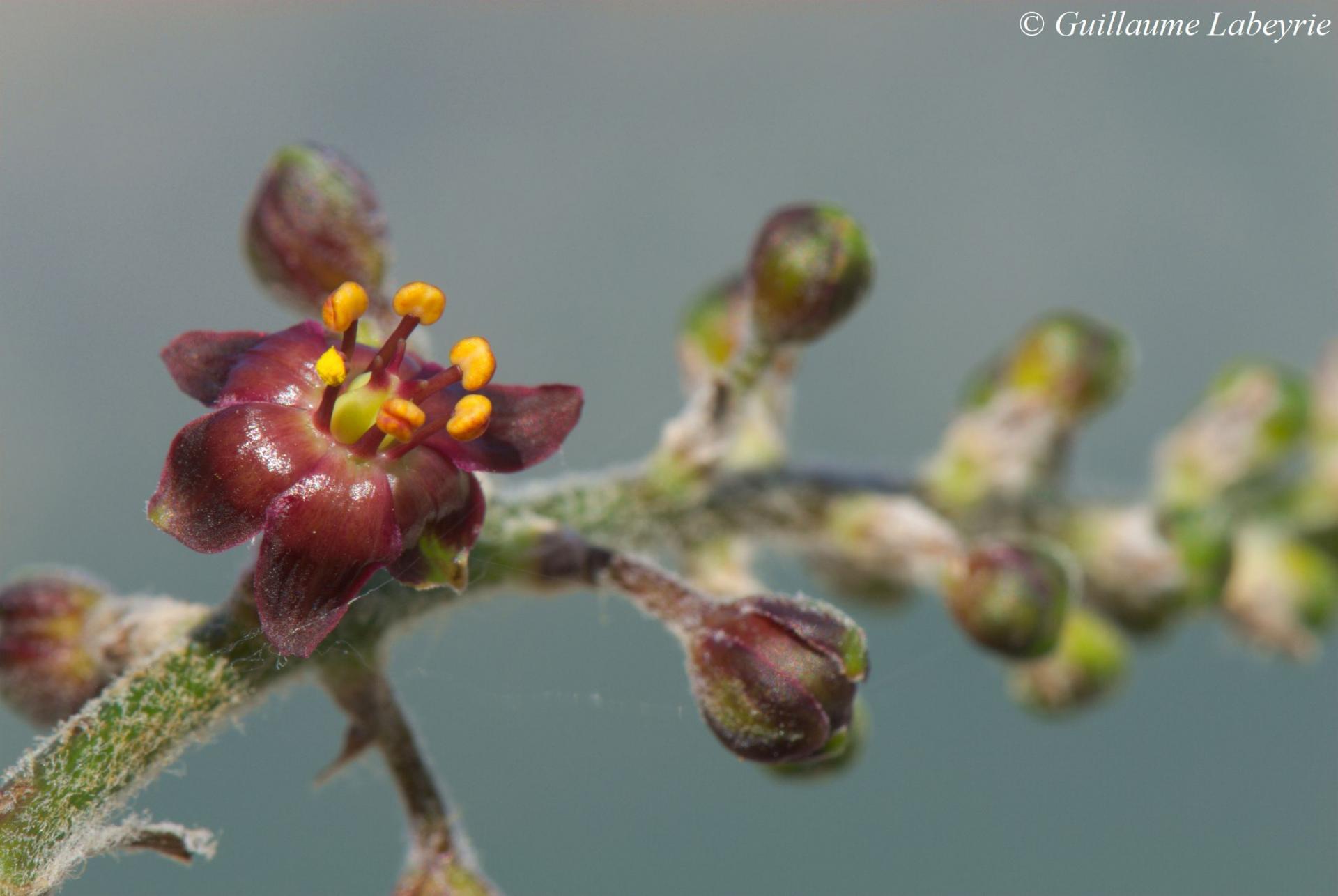 The black false hellebore (Veratrum nigrum). This is an outstanding plant, with broad basal leaves and a 1 m-tall flowering spike sporting hundreds of small dark flowers. It grows in low mountain rocky undergrowth and cliffs, and flowers in August. The black false hellebore is very rare in our country and occurs only in the Alpes-Maritimes, which constitutes the occidental limit of its range expanding eastward to Japan and Siberia. This species is protected in France.
The black false hellebore (Veratrum nigrum). This is an outstanding plant, with broad basal leaves and a 1 m-tall flowering spike sporting hundreds of small dark flowers. It grows in low mountain rocky undergrowth and cliffs, and flowers in August. The black false hellebore is very rare in our country and occurs only in the Alpes-Maritimes, which constitutes the occidental limit of its range expanding eastward to Japan and Siberia. This species is protected in France.
Family : Primulaceae
 The silver-edged primrose (Primula marginata). This pretty primrose flowers in spring in calcareous rocks and cliffs, usually exposed to the north, at altitudes ranging from 1000 to 3000 m. The lavender flowers and serrated leaves are characteristic of this species. It is endemic to the southern Alps, and fully protected in France.
The silver-edged primrose (Primula marginata). This pretty primrose flowers in spring in calcareous rocks and cliffs, usually exposed to the north, at altitudes ranging from 1000 to 3000 m. The lavender flowers and serrated leaves are characteristic of this species. It is endemic to the southern Alps, and fully protected in France.
Family : Ranunculaceae
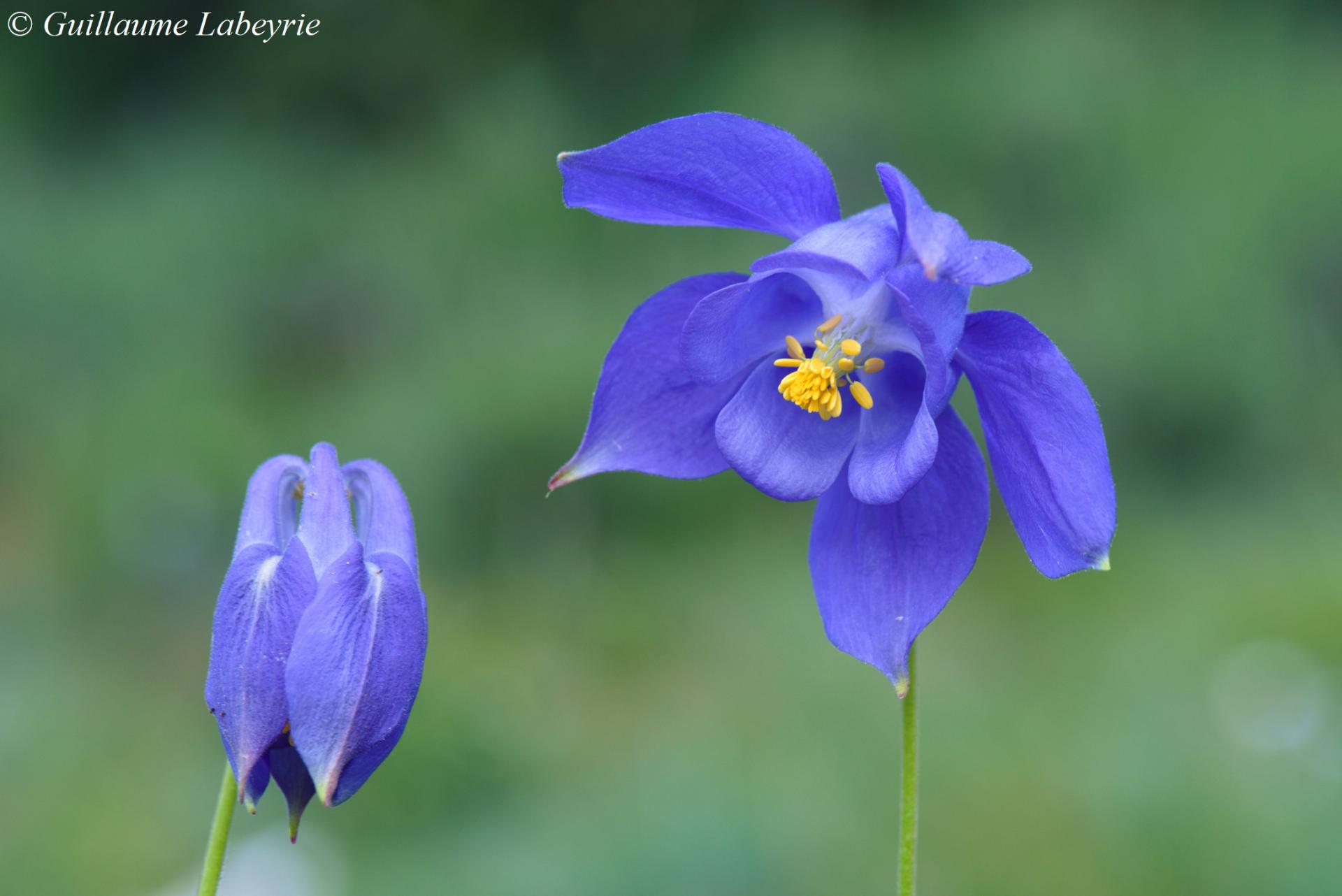
Reuter's columbine (Aquilegia reuteri). This nice columbine grows in calcareous screes, often on north-facing slopes. Contrary to other species, the stamens do not protrude from the corolla, and the flower spurs are strongly curved. Scarce and present only in the South-East from the Vaucluse and Hautes-Alpes to the Alpes-Maritimes, this species is protected at the national level.
Fauna
Butterflies and Moths (Lepidoptera)
Family : Papilionidae
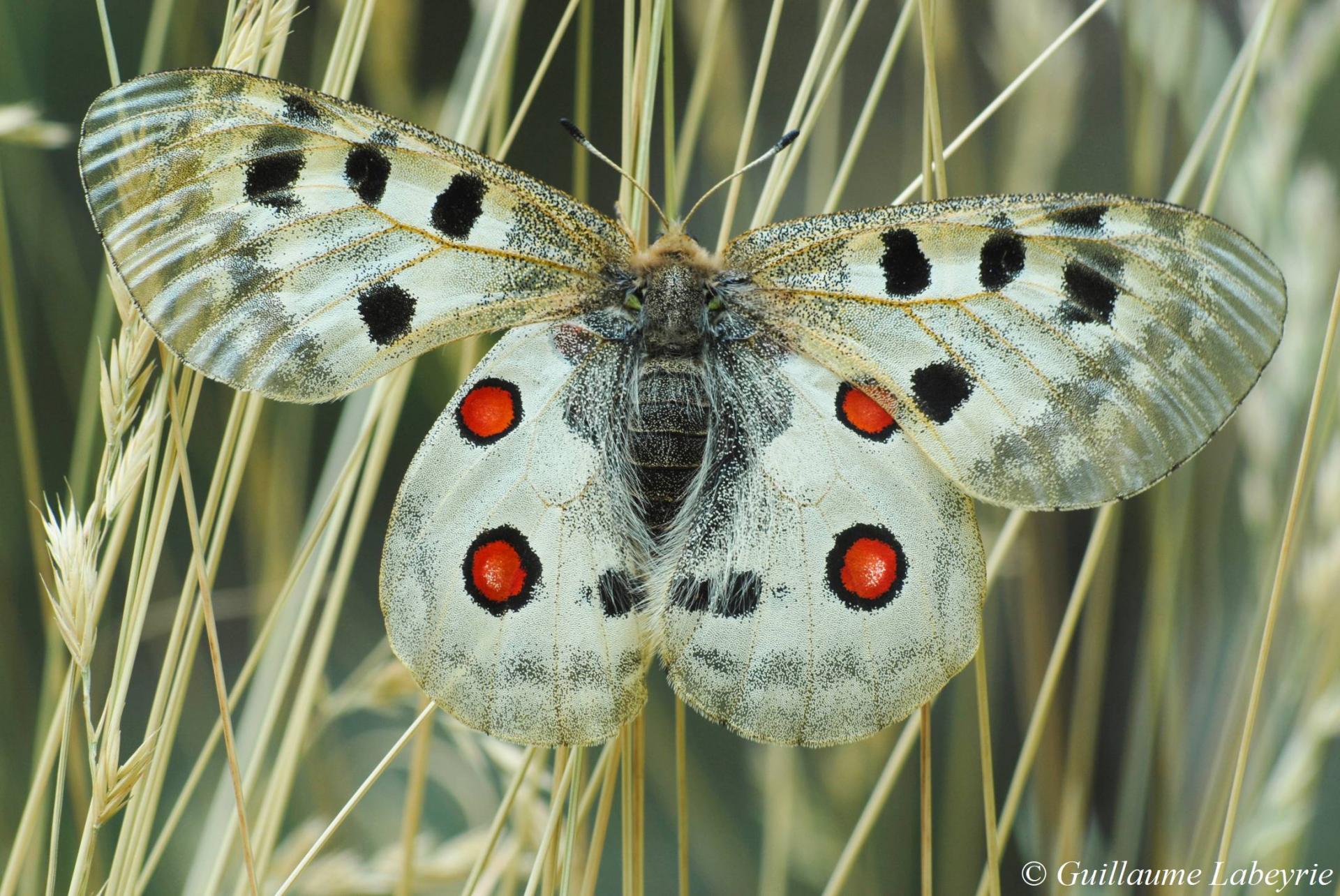 The mountain Apollo (Parnassius apollo). This mountain butterfly is one of our largest species. It is found above 1000 m of altitude, in dry rocky slopes where it glides effortlessly. Its caterpillar feeds on various species of stonecrop (Sedum sp.). The Apollo has a worldwide distribution, ranging from Europe to Asia. However, it is disappearing from many areas and is listed as threatened by IUCN. It is fully protected in France.
The mountain Apollo (Parnassius apollo). This mountain butterfly is one of our largest species. It is found above 1000 m of altitude, in dry rocky slopes where it glides effortlessly. Its caterpillar feeds on various species of stonecrop (Sedum sp.). The Apollo has a worldwide distribution, ranging from Europe to Asia. However, it is disappearing from many areas and is listed as threatened by IUCN. It is fully protected in France.
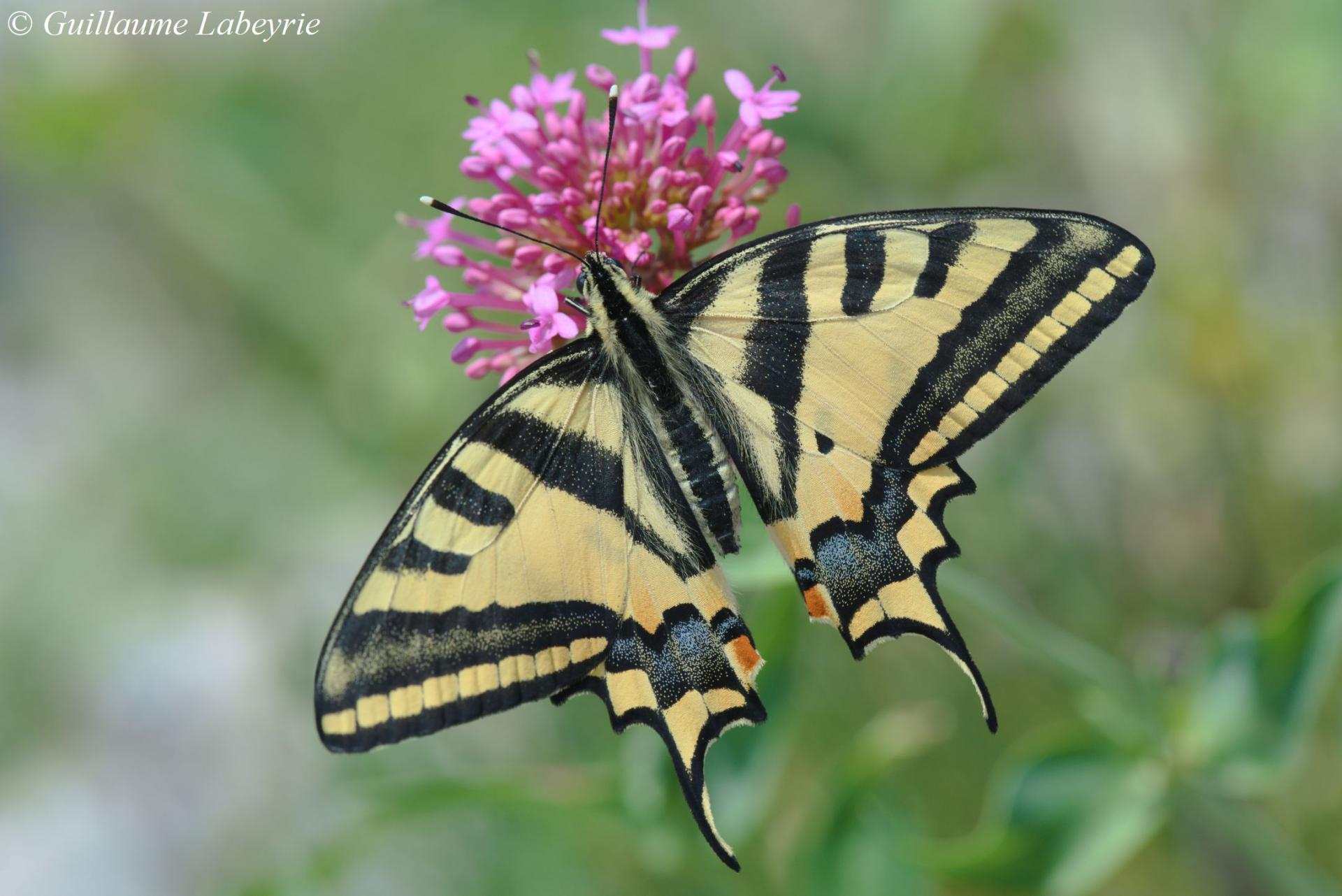 The Alexanor (Papilio alexanor). This large butterfly is at first sight quite similar to the scarce swallowtail (Iphiclides podalirius), but with a yellow tint of the wings (instead of white) and a different stripe pattern. A rare species, the Alexanor is sometimes encountered feeding on the flowers of the red valerian (Centranthus ruber). This butterfly has a very patchy distribution from southeastern France, the Balkans, up to Pakistan. It is fully protected in France.
The Alexanor (Papilio alexanor). This large butterfly is at first sight quite similar to the scarce swallowtail (Iphiclides podalirius), but with a yellow tint of the wings (instead of white) and a different stripe pattern. A rare species, the Alexanor is sometimes encountered feeding on the flowers of the red valerian (Centranthus ruber). This butterfly has a very patchy distribution from southeastern France, the Balkans, up to Pakistan. It is fully protected in France.
The dominant species in the Prealps is the Scots pine (Pinus sylvestris). On the slopes exposed to the north, forests of European beech (Fagus sylvatica) and silver fir (Abies alba) are present. At lower altitudes, the Scots pine is replaced by the downy oak (Quercus pubescens) and the evergreen oak (Quercus ilex). On the eastern slopes of the mountain range, woods of the European hop-hornbeam (Ostrya carpinifolia) can be found. This is the occidental limit of the range of this species. In the gorges, riparian forests include many species: bay laurel (Laurus nobilis), maples, fig trees, ...
Flora
Family : Brassicaceae
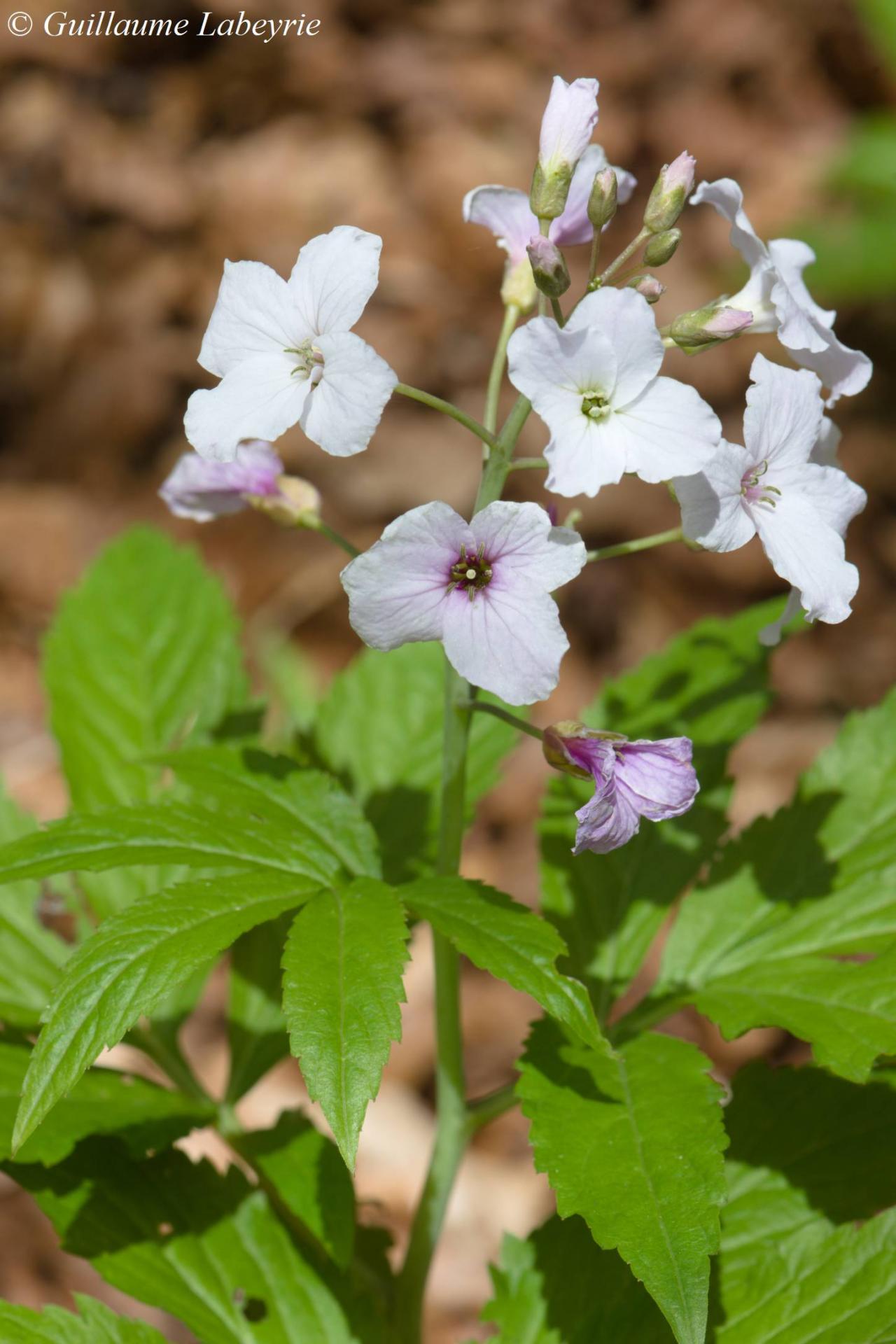 The pinnate coralroot (Cardamine heptaphylla). This plant from the cabbage family shows distinctive large pinkish flowers and imparipinnate leaves with five to seven leaflets. It grows almost exclusively in beech underwoods. In France, this species occurs in the southeastern half of the country. It is protected in several regions but not in PACA where it is still fairly common.
The pinnate coralroot (Cardamine heptaphylla). This plant from the cabbage family shows distinctive large pinkish flowers and imparipinnate leaves with five to seven leaflets. It grows almost exclusively in beech underwoods. In France, this species occurs in the southeastern half of the country. It is protected in several regions but not in PACA where it is still fairly common.
Family : Liliaceae
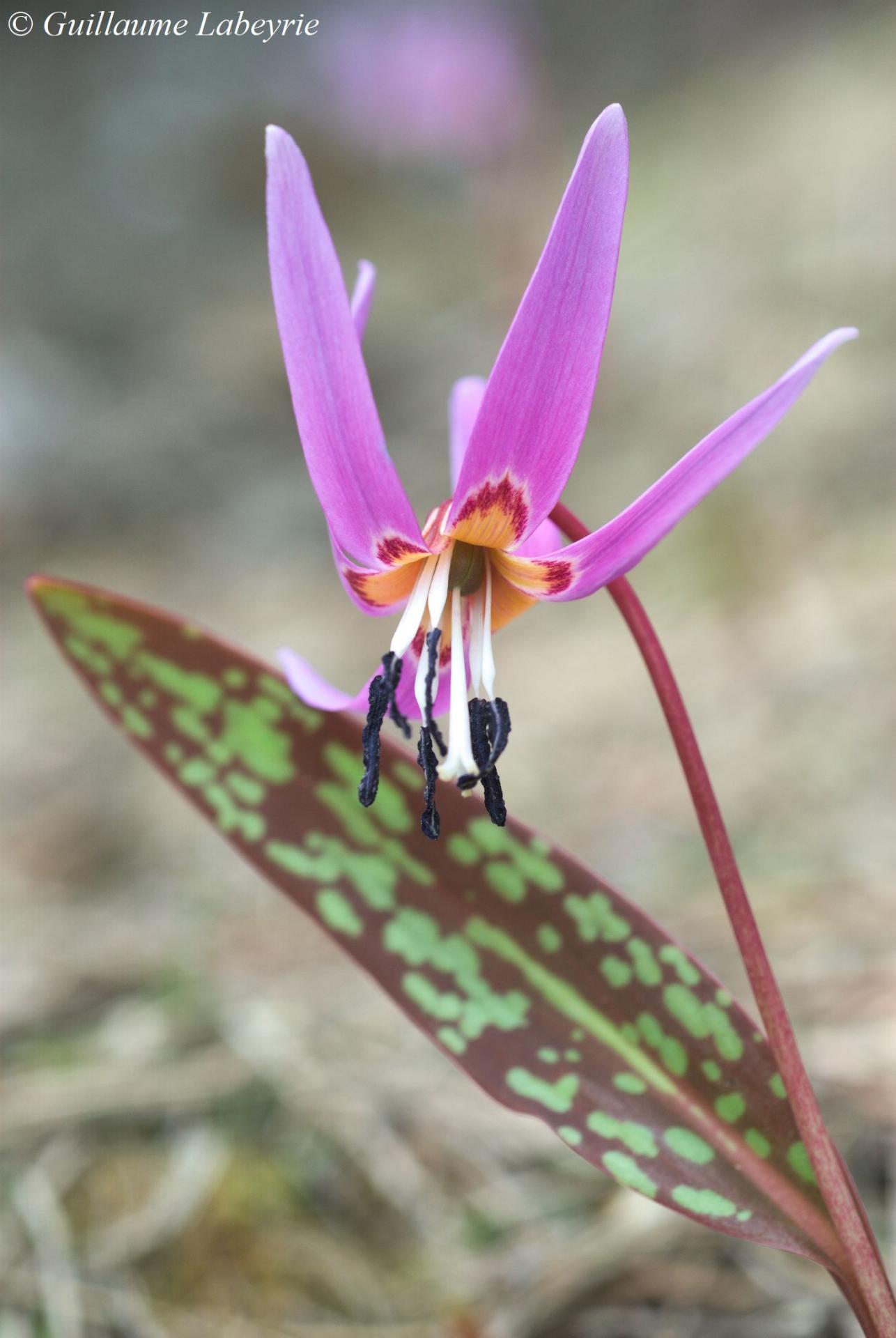 The dog's tooth violet (Erythronium dens-canis). This very pretty flower from the Liliaceae family grows in clear undergrowth and mountain woods clearings. It often blooms just after the melting of the last snow. It is found in southern Europe and the Balkans.
The dog's tooth violet (Erythronium dens-canis). This very pretty flower from the Liliaceae family grows in clear undergrowth and mountain woods clearings. It often blooms just after the melting of the last snow. It is found in southern Europe and the Balkans.
Family : Orchidaceae
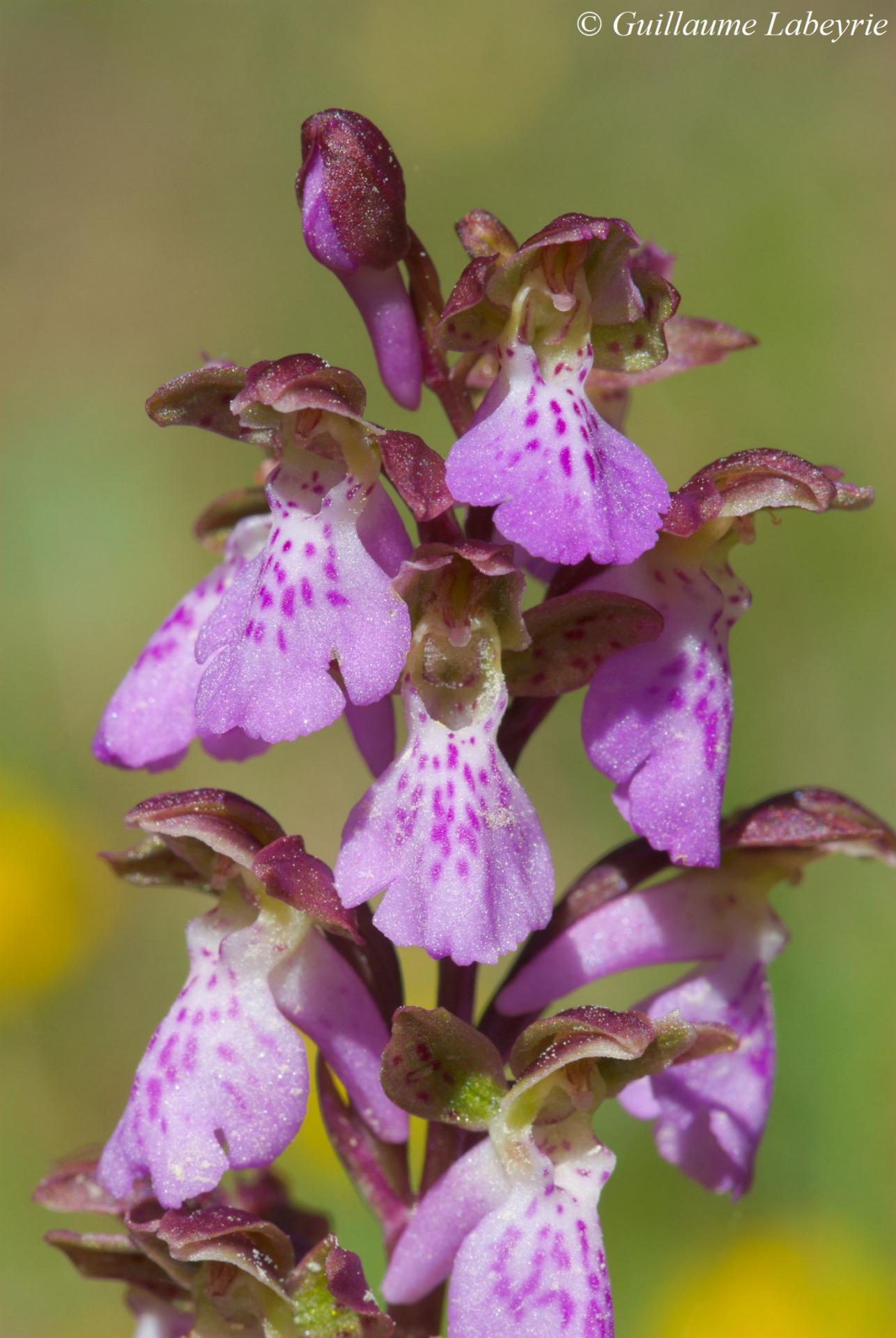 Spitzel's orchid (Orchis spitzelii). This orchid is identified by its green-tinted perianth, its folded labellum and straight, conical spur. It flowers in low mountains in June, in Scots pine clearings often on a marly substrate. This species has a rather wide distribution (from France to Lebanon, up to Sweden in the north and Algeria in the south) with a very scattered distribution. It is everywhere rare and very local. In France, where it is found mainly in the south-east, Orchis spitzelii is fully protected.
Spitzel's orchid (Orchis spitzelii). This orchid is identified by its green-tinted perianth, its folded labellum and straight, conical spur. It flowers in low mountains in June, in Scots pine clearings often on a marly substrate. This species has a rather wide distribution (from France to Lebanon, up to Sweden in the north and Algeria in the south) with a very scattered distribution. It is everywhere rare and very local. In France, where it is found mainly in the south-east, Orchis spitzelii is fully protected.
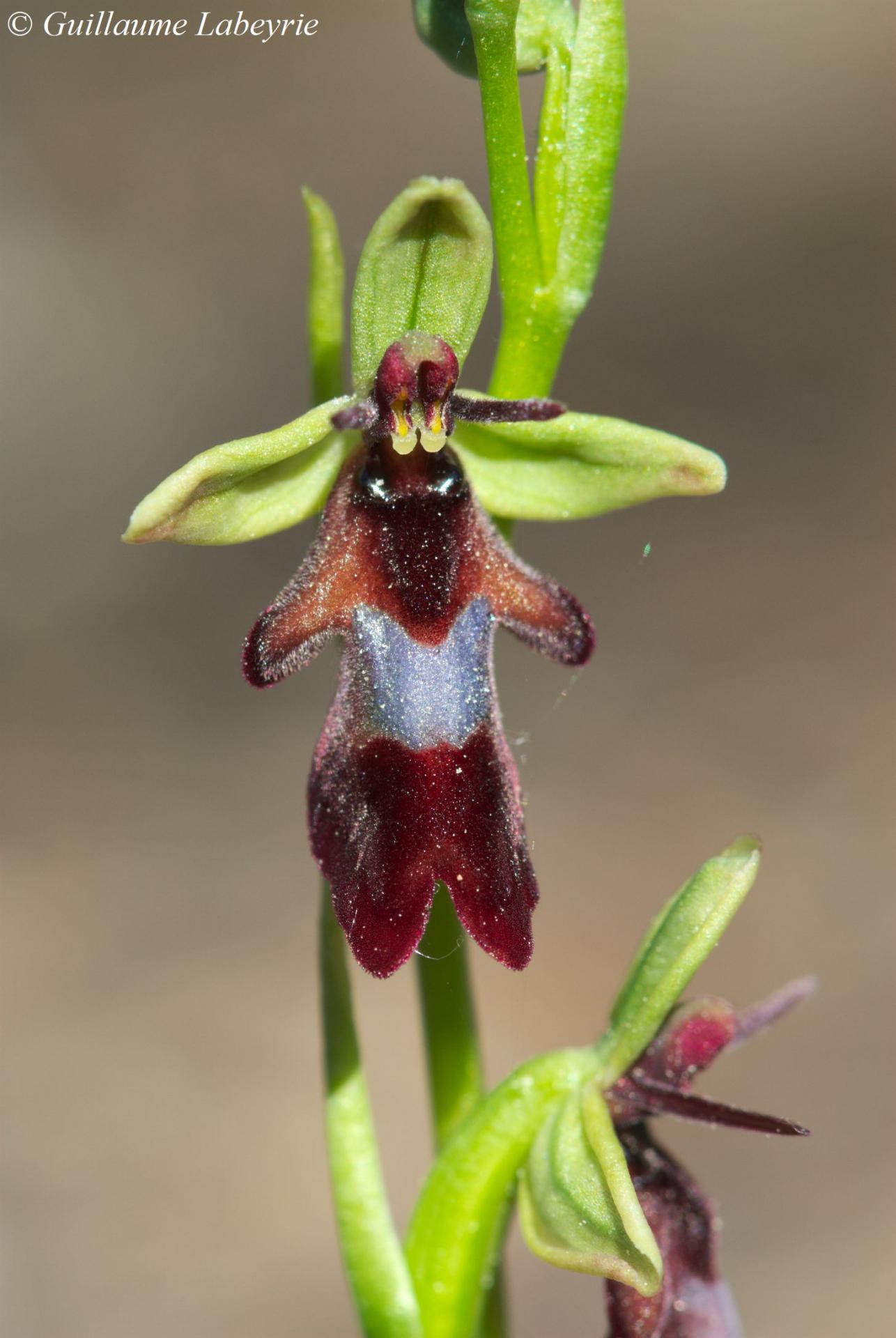 The fly orchid (Ophrys insectifera). This orchid bears flowers with a distinctive shape that mimics an insect. It is usually found in clear Scots pine woods, often in the company of Spitzel's orchid (Orchis spitzelii). This species is quite widespread in Europe.
The fly orchid (Ophrys insectifera). This orchid bears flowers with a distinctive shape that mimics an insect. It is usually found in clear Scots pine woods, often in the company of Spitzel's orchid (Orchis spitzelii). This species is quite widespread in Europe.
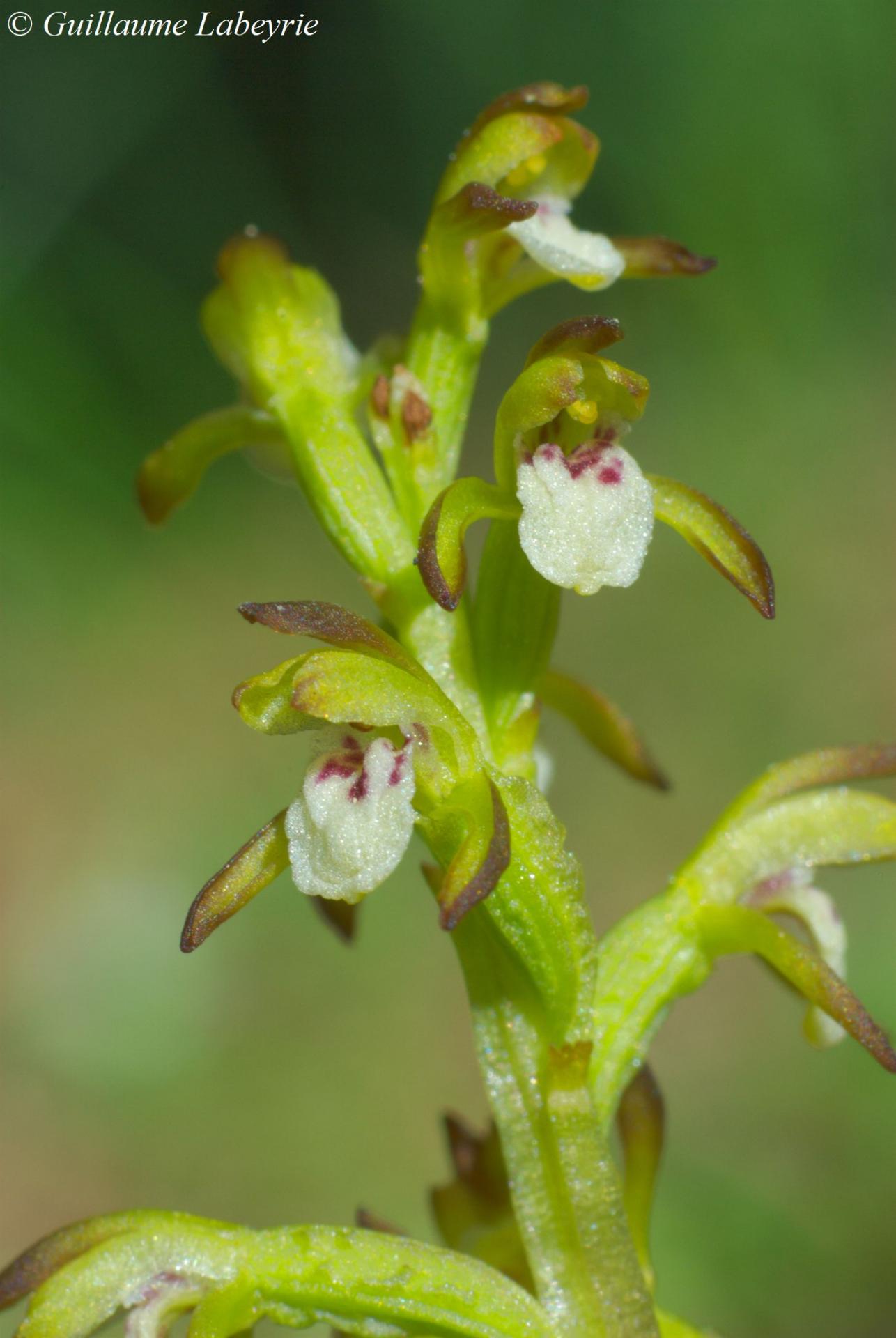 The early coralroot (Corallorhiza trifida). This tiny orchid is often overlooked. This is mostly a mountain species, growing in the undergrowth of beech or coniferous forests. In the Préalpes de Grasse, this species seems very local. Found in the eastern half of France, this orchid is always rare. It has a worldwide distribution, including Northern America and Eurasia.
The early coralroot (Corallorhiza trifida). This tiny orchid is often overlooked. This is mostly a mountain species, growing in the undergrowth of beech or coniferous forests. In the Préalpes de Grasse, this species seems very local. Found in the eastern half of France, this orchid is always rare. It has a worldwide distribution, including Northern America and Eurasia.
Family : Primulaceae
 Chaix's rock jasmine (Androsace chaixii). Most of the rock jasmine species are high mountain plants, growing dense cushions in rock cracks. Androsace chaixii, on the contrary, occurs in low mountains where it grows in shadowy places (beech forests, ...). The little pink flowers grow at the tip of long stems radiating from a rosette of leaves. This uncommon plant, endemic to southeastern France, is protected in the Région Rhône-Alpes.
Chaix's rock jasmine (Androsace chaixii). Most of the rock jasmine species are high mountain plants, growing dense cushions in rock cracks. Androsace chaixii, on the contrary, occurs in low mountains where it grows in shadowy places (beech forests, ...). The little pink flowers grow at the tip of long stems radiating from a rosette of leaves. This uncommon plant, endemic to southeastern France, is protected in the Région Rhône-Alpes.
Family : Ranunculaceae
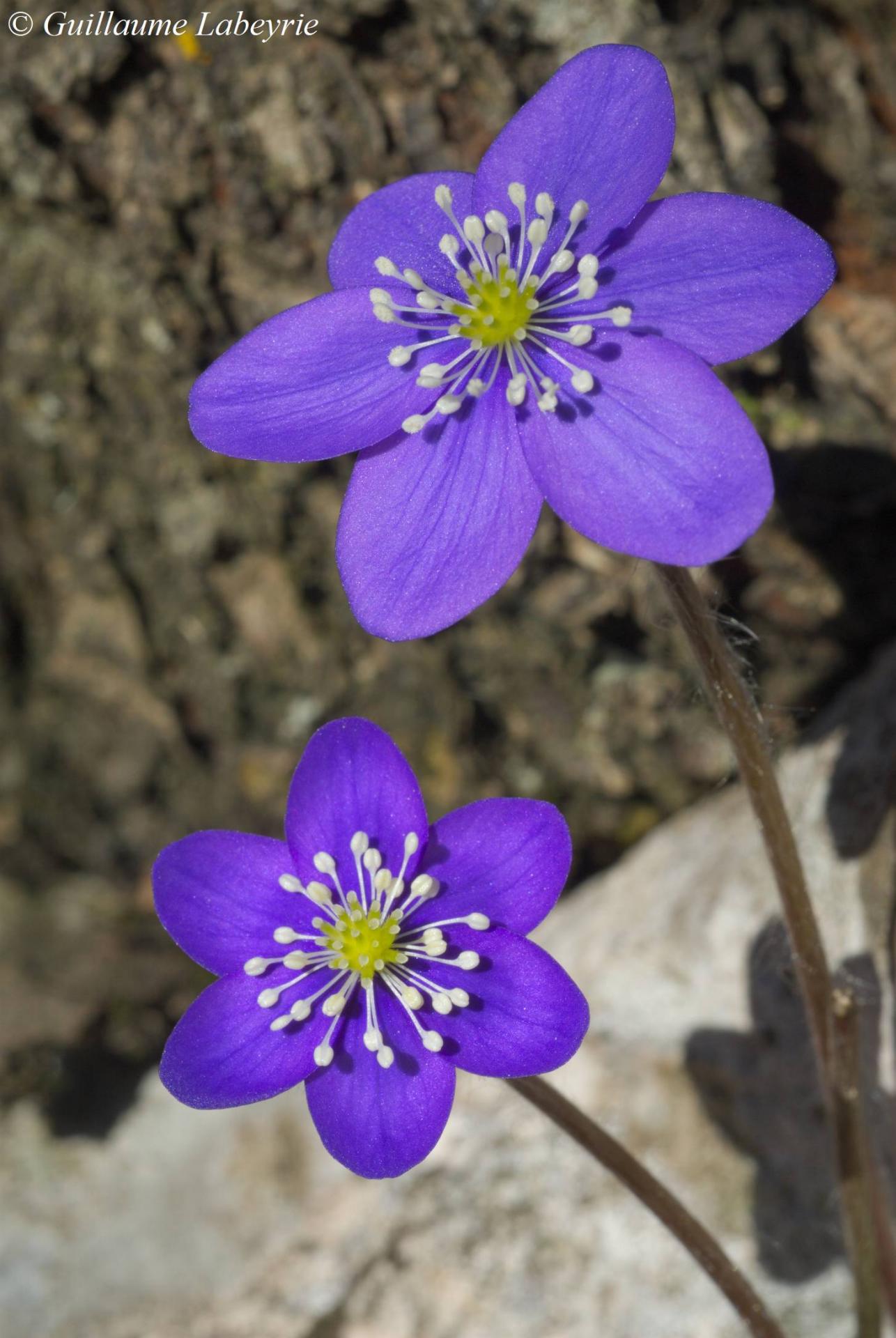 The liverwort (Hepatica nobilis). This anemone flowers early in spring, from March to April. It is commonly found in woods and in the karst. The flowers are usually purple, but can also be white or pink. This plant has a very wide distribution in the Holarctic.
The liverwort (Hepatica nobilis). This anemone flowers early in spring, from March to April. It is commonly found in woods and in the karst. The flowers are usually purple, but can also be white or pink. This plant has a very wide distribution in the Holarctic.
Family : Rutaceae
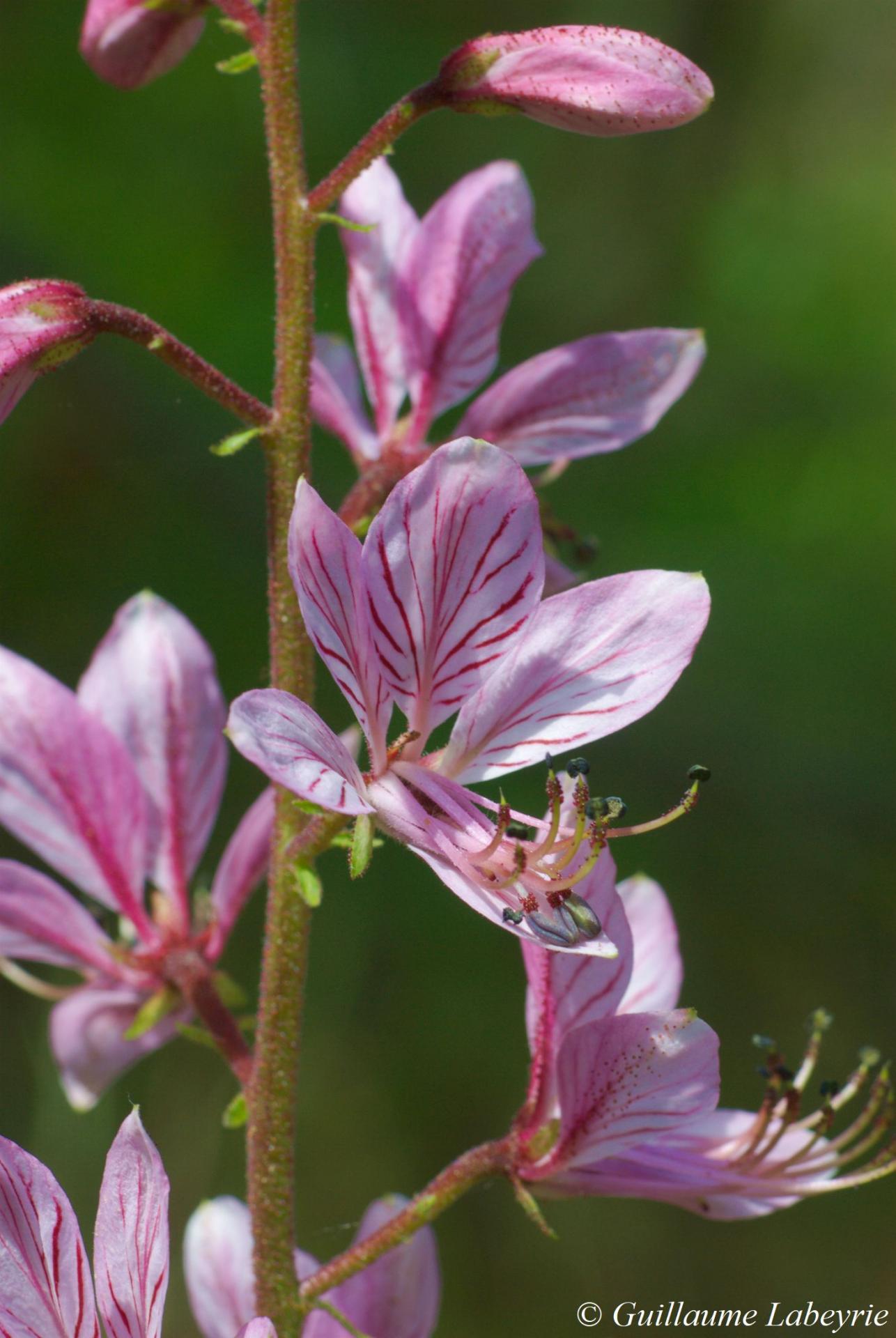 The burning bush (Dictamnus albus). This plant, growing up to 1 m, has divided leaves recalling that of the manna ash (Fraxinus ornus). It is easily recognizable by its large asymmetric pink flowers with purple stripes and long, bunched stammens. This plant is found in clear woods, dry slopes, ... This is a rare plant, protected in the PACA region. Its range extends from Europe to North Africa and part of Asia.
The burning bush (Dictamnus albus). This plant, growing up to 1 m, has divided leaves recalling that of the manna ash (Fraxinus ornus). It is easily recognizable by its large asymmetric pink flowers with purple stripes and long, bunched stammens. This plant is found in clear woods, dry slopes, ... This is a rare plant, protected in the PACA region. Its range extends from Europe to North Africa and part of Asia.
Fungi and lichens
Fungi
Family : Geastraceae
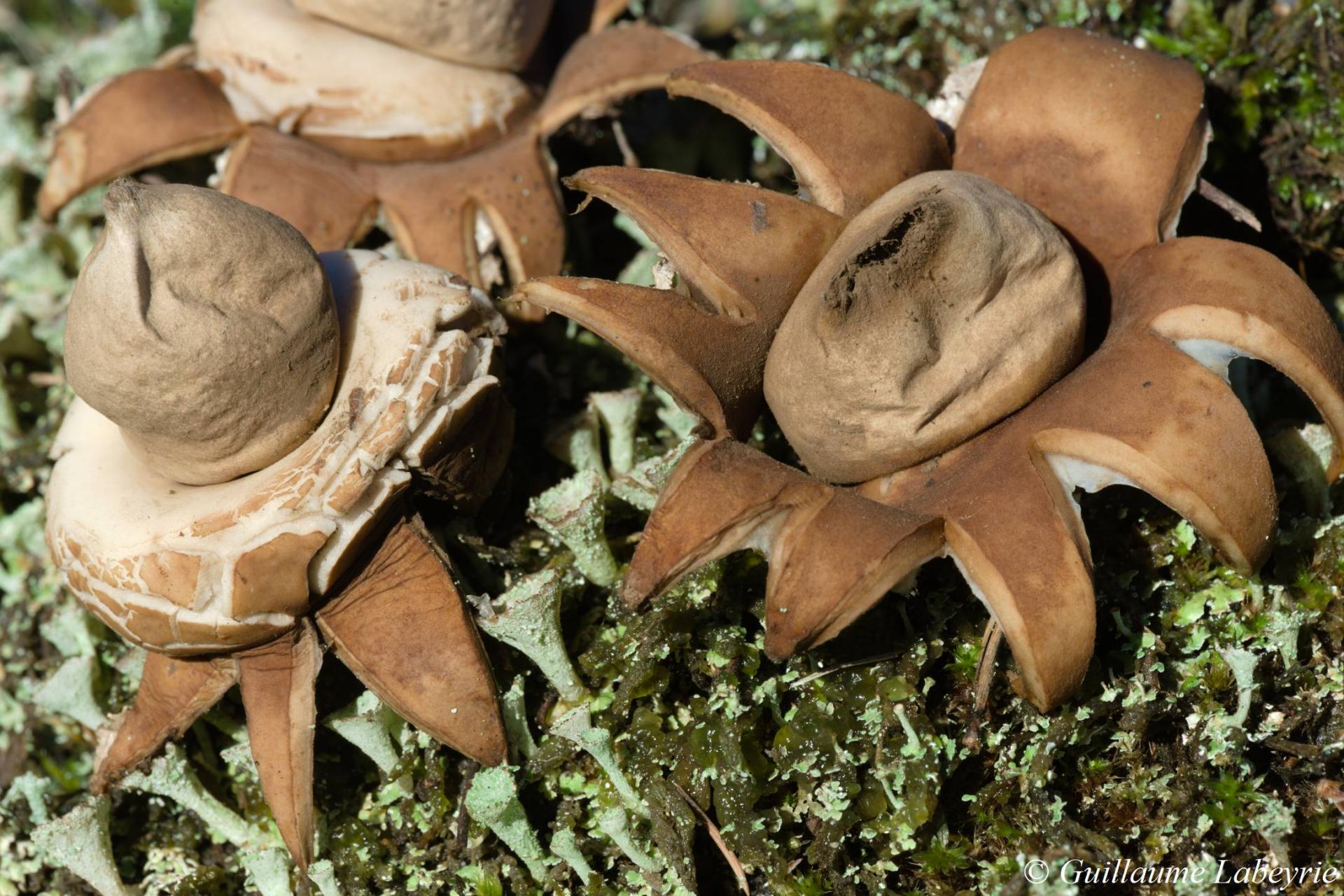 Earthstar (Geaster sp.). These mushrooms are composed of two envelopes: the inner one (endoperidium) contains the spores, and the outer one (exoperidium) splits in a star pattern at maturity. This particular species is found under Scots pines.
Earthstar (Geaster sp.). These mushrooms are composed of two envelopes: the inner one (endoperidium) contains the spores, and the outer one (exoperidium) splits in a star pattern at maturity. This particular species is found under Scots pines.
Lichens
These amazing organisms have succeeded, thanks to the symbiosis between a fungus and a photosynthetic partner (an alga or a cyanobacterium), to get rid of the need for a substrate to survive. They use only the elements drawn from the atmosphere and from water, and solar energy. They offer the attentive observer a festival of shapes, colors and textures. The Alpes-Maritimes department, with around 1600 listed species, is the richest in France for lichen diversity.
Family : Physciaceae
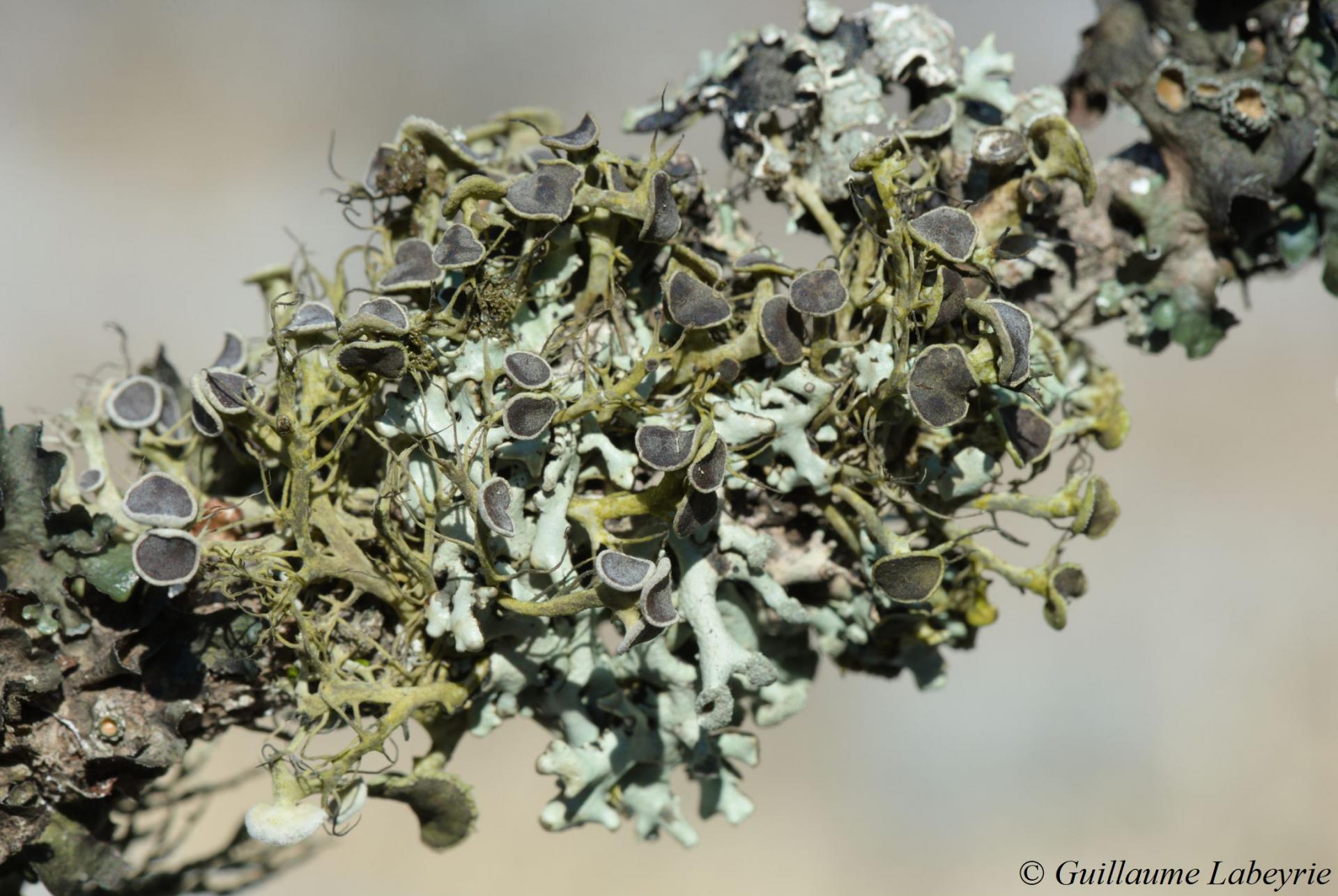 Anaptychia ciliaris. This small lichen has a greenish-gray ciliate thallus, pubescent, and gray pedunculated apothecia (cup-shaped sexual organs) with lighter margins. Present in most of France, this species growing on branches needs good air quality to develop.
Anaptychia ciliaris. This small lichen has a greenish-gray ciliate thallus, pubescent, and gray pedunculated apothecia (cup-shaped sexual organs) with lighter margins. Present in most of France, this species growing on branches needs good air quality to develop.
Family : Parmeliaceae
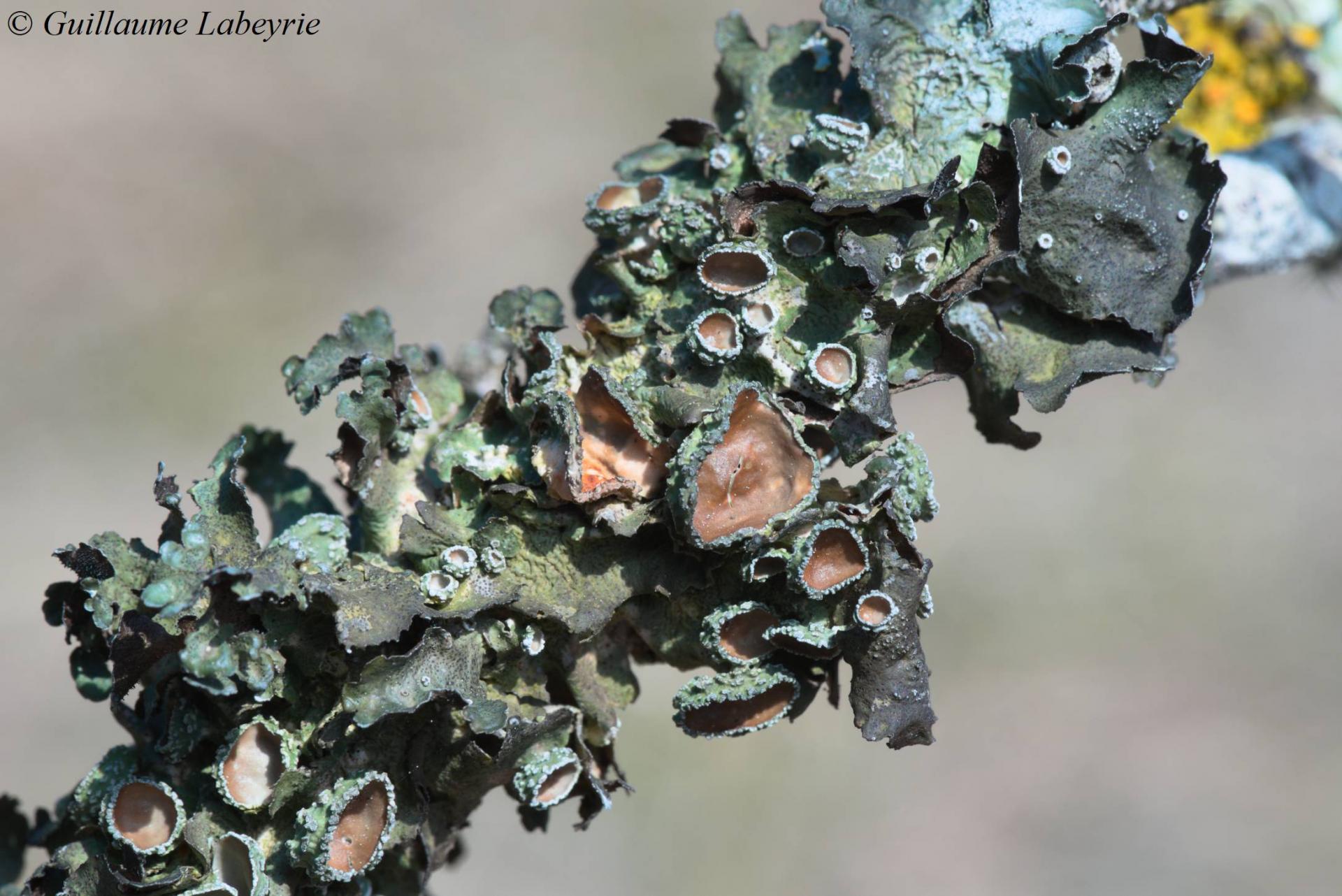 Pleurostica acetabulum. This other lichen shows a distinctive blue-green thallus, with large brown apothecia. It grows on trunks and branches of deciduous trees in most of France.
Pleurostica acetabulum. This other lichen shows a distinctive blue-green thallus, with large brown apothecia. It grows on trunks and branches of deciduous trees in most of France.
Family : Ramalinaceae
These fruticose lichens have thalli divided into "branches" of very diverse shapes. They grow on bark or stone. Most species are very sensitive to air pollution.
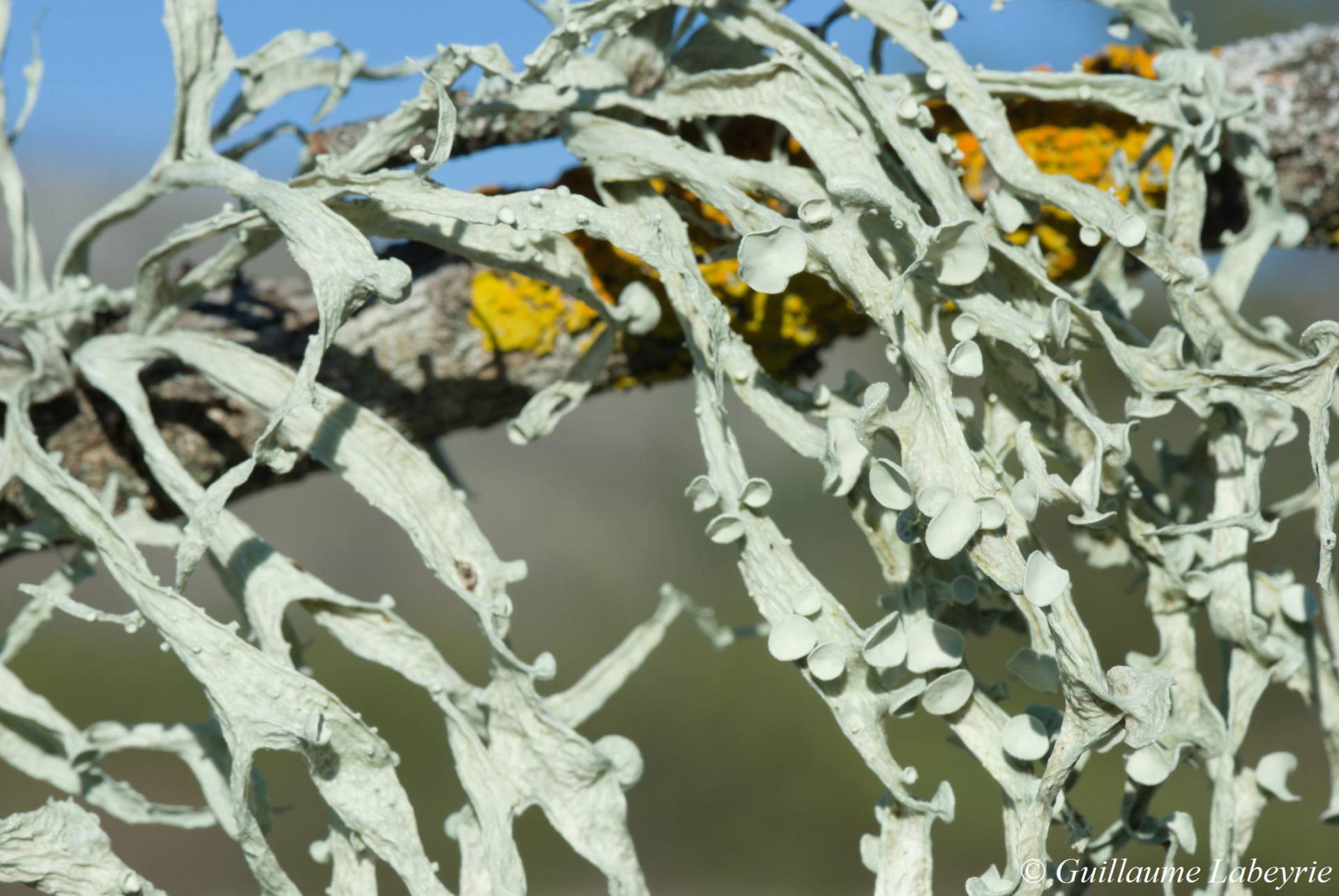 Ramalina calicaris. This species is characterized by its thallus divided in narrow straps, with lateral apothecia. It occurs in a southwestern half of France, on isolated trees or in open forests.
Ramalina calicaris. This species is characterized by its thallus divided in narrow straps, with lateral apothecia. It occurs in a southwestern half of France, on isolated trees or in open forests.
A crowd of lichens. When conditions are favorable, lichens can compete for available space ! At least 9 species are present on this small branch, including Ramalina fastigiata, Anaptychia ciliaris, Pleurosticta acetabulum, ...
Fauna
Beetles (Coleoptera)
Family : Cerambycidae
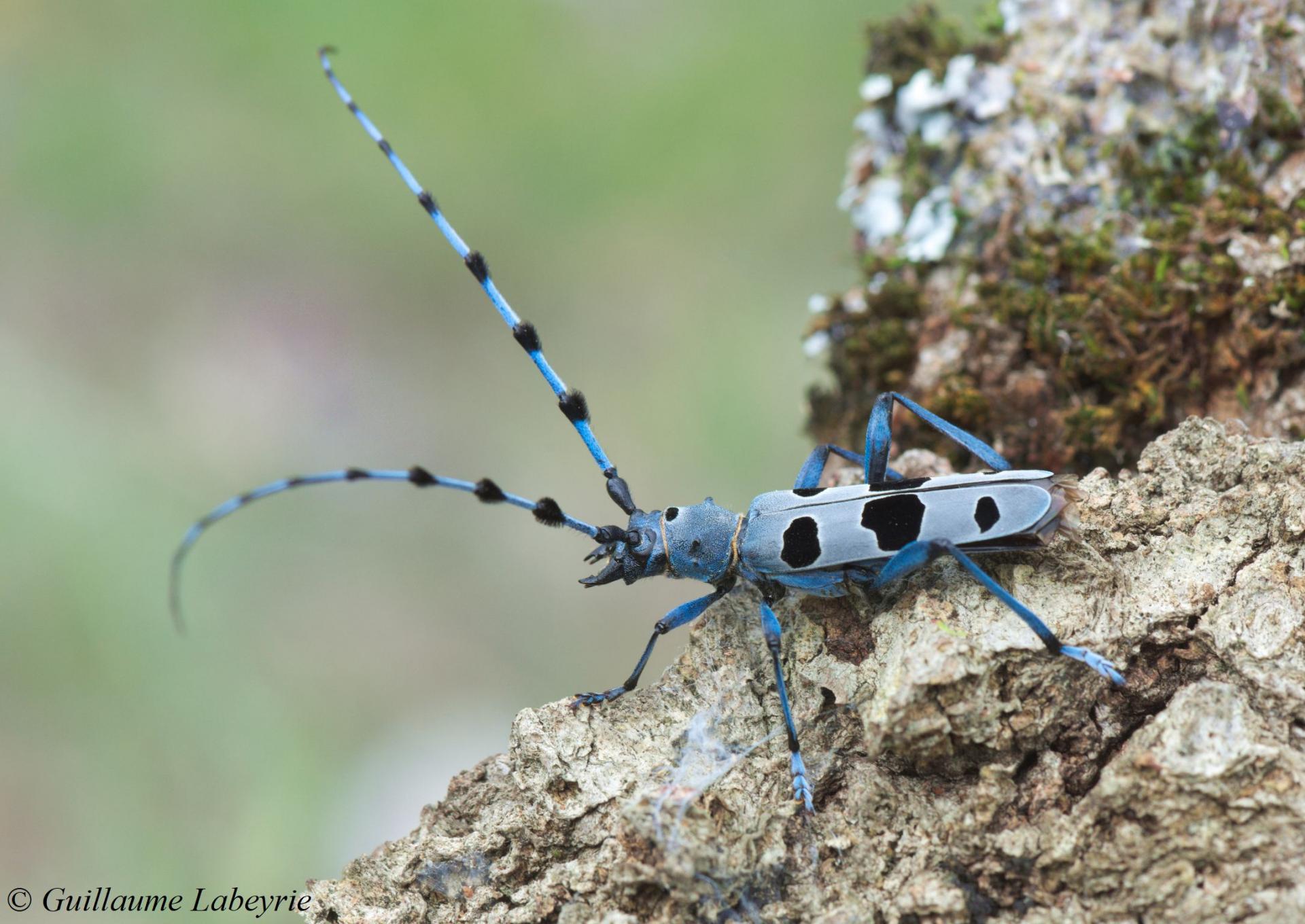 The rosalia longicorn (Rosalia alpina). This magnificient beetle is one of the most spectacular in the European fauna. It favors old beech forests, where the dead trees that feed the larvae can be found. The adults only appear for a short period of about 10 days in July-August. Whilst it occurs mainly in mountains, the rosalia longicorn can also be found at low elevations, where it feeds for instance on ash trees. This species, which occurs from the Alps to Slovakia, has seen its populations dwindling. It is protected in many countries (including France), and is classified as ''vulnerable'' by IUCN.
The rosalia longicorn (Rosalia alpina). This magnificient beetle is one of the most spectacular in the European fauna. It favors old beech forests, where the dead trees that feed the larvae can be found. The adults only appear for a short period of about 10 days in July-August. Whilst it occurs mainly in mountains, the rosalia longicorn can also be found at low elevations, where it feeds for instance on ash trees. This species, which occurs from the Alps to Slovakia, has seen its populations dwindling. It is protected in many countries (including France), and is classified as ''vulnerable'' by IUCN.
 Morimus asper. This other species of longhorn beetle is large and massive, with impressive antennae. It is often found in old beech forests, together with the rosalia longicorn described above. Widespread in Southern Europe, this beetle occurs in France in a southwestern half of the territory.
Morimus asper. This other species of longhorn beetle is large and massive, with impressive antennae. It is often found in old beech forests, together with the rosalia longicorn described above. Widespread in Southern Europe, this beetle occurs in France in a southwestern half of the territory.
Family : Vesperidae
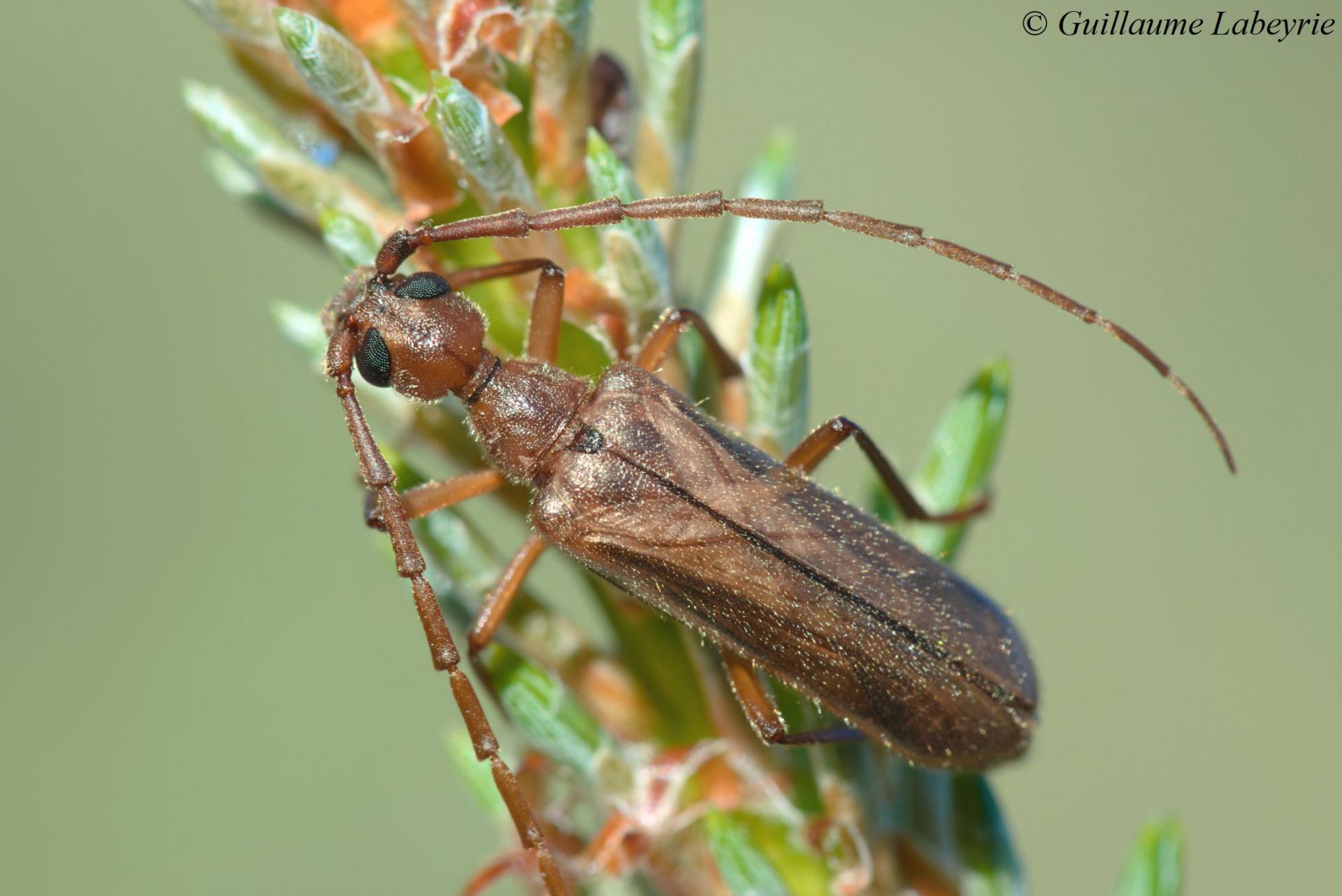
Vesperus strepens. This spectacular-looking beetle is distinguished from the closely related Vesperus ligusticus by its summer emergence date. Vesperus ligusticus emerges in autumn or even winter. In the Prealps, this species is often found near Scots pines.
Heteroptera
Family : Pentatomidae
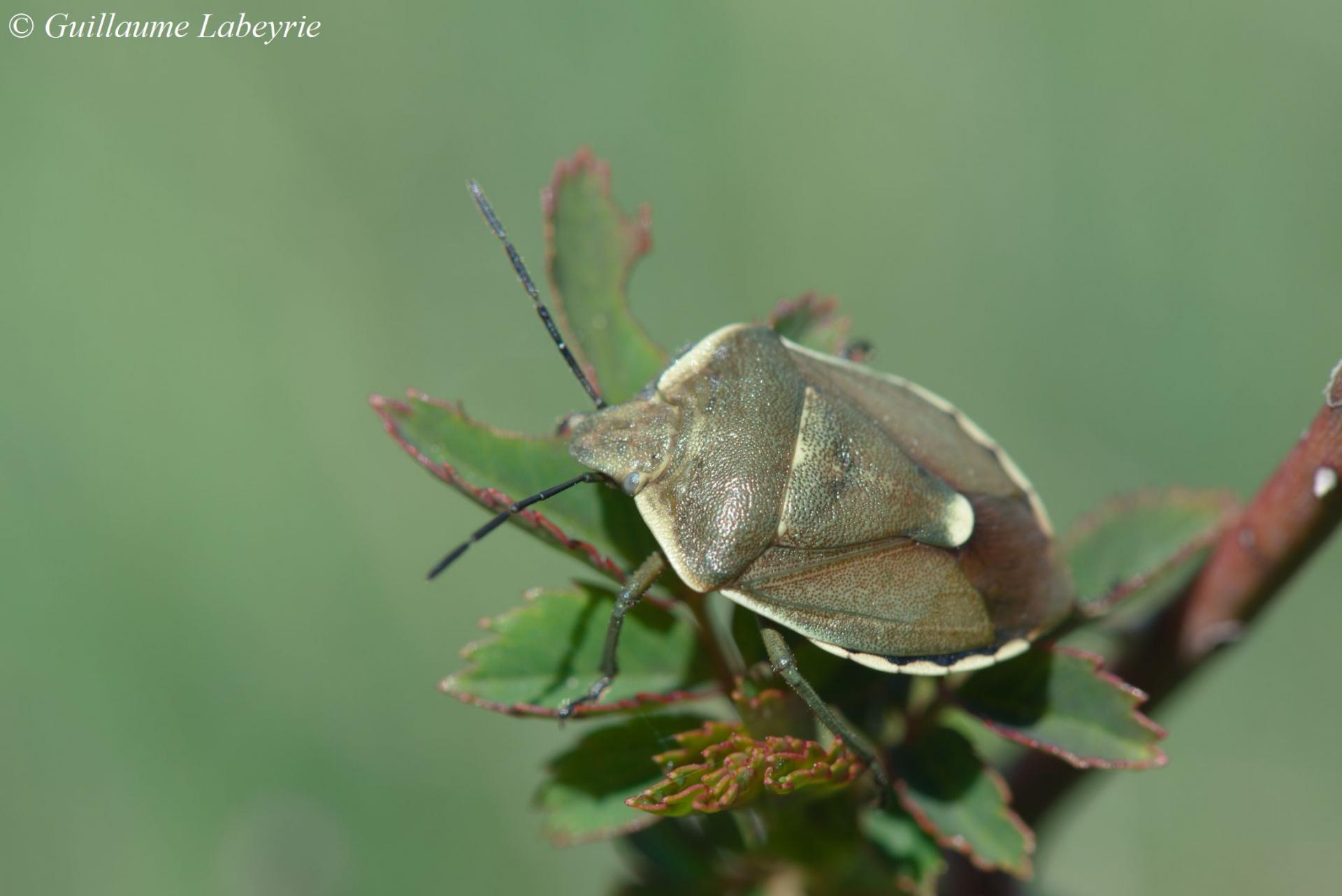
Chlorochroa pinicola. This species has a rather characteristic coloration, greenish brown with white edges of the abdomen and pronotum. It also has a conspicuous white spot at the end of the scutellum. It is a mid-mountain species, where it mainly feeds on the needles and seeds of Scots pines.
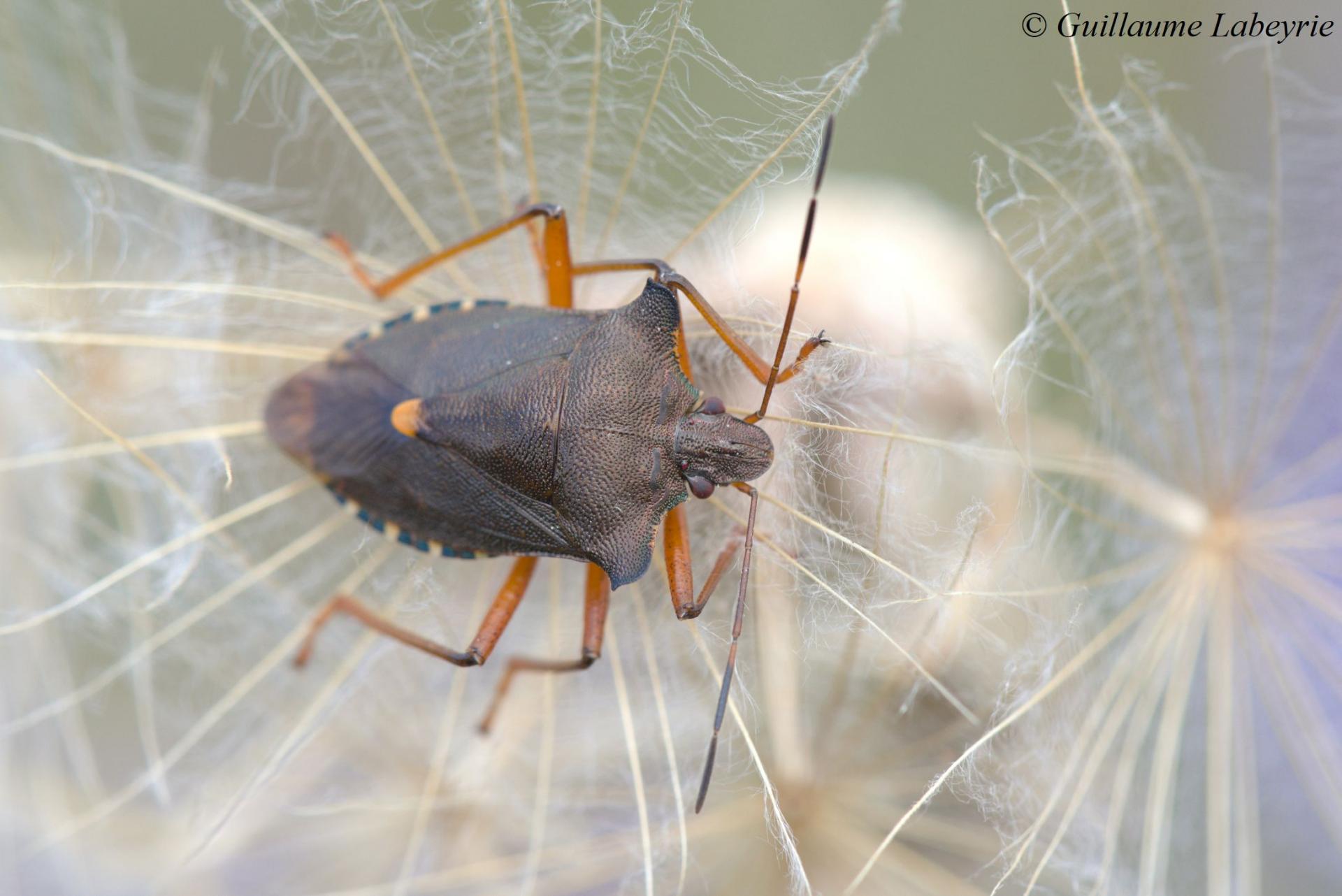 The red-legged shieldbug (Pentatoma rufipes). This beautiful and large shieldbug is easily identified by the shape of the angles of its pronotum. It likes cool forests, where it feeds on a wide variety of tree species. It has a wide worldwide distribution, but avoids the strictly Mediterranean area.
The red-legged shieldbug (Pentatoma rufipes). This beautiful and large shieldbug is easily identified by the shape of the angles of its pronotum. It likes cool forests, where it feeds on a wide variety of tree species. It has a wide worldwide distribution, but avoids the strictly Mediterranean area.
Hymenoptera
Family : Cynipidae
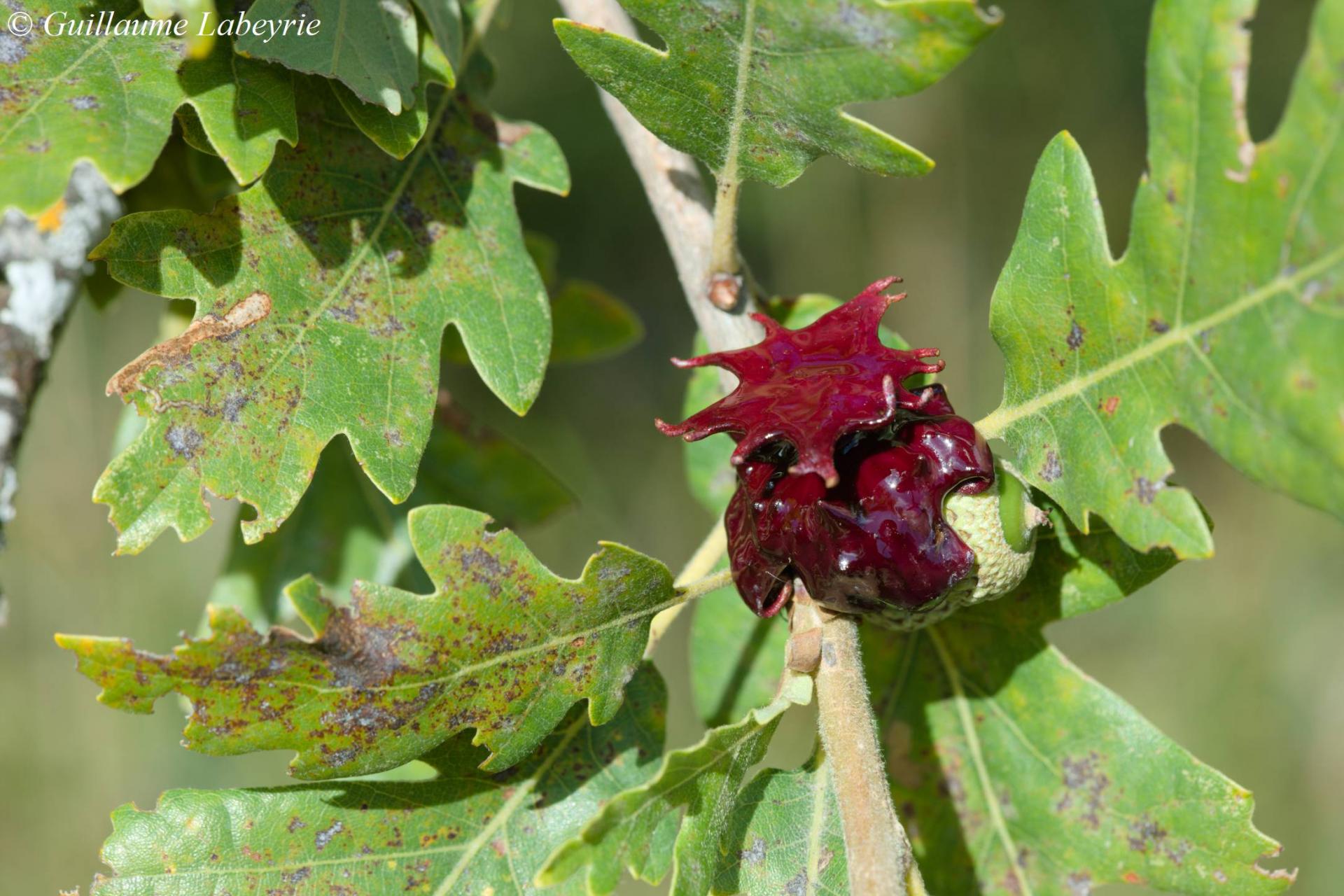 Gall of Andricus dentimitratus. With its toothed "hat", its mahogany color and sticky texture, this gall is probably the most spectacular of our region. It is caused by a tiny wasp laying its eggs in the cup of the acorns of Quercus pubescens. The larvae will develop in the gall. Andricus dentimitratus is a Mediterranean species, occuring in France only in the South.
Gall of Andricus dentimitratus. With its toothed "hat", its mahogany color and sticky texture, this gall is probably the most spectacular of our region. It is caused by a tiny wasp laying its eggs in the cup of the acorns of Quercus pubescens. The larvae will develop in the gall. Andricus dentimitratus is a Mediterranean species, occuring in France only in the South.
Grasshoppers (Orthoptera)
Family : Acrididae / Sub-Family : Locustinae
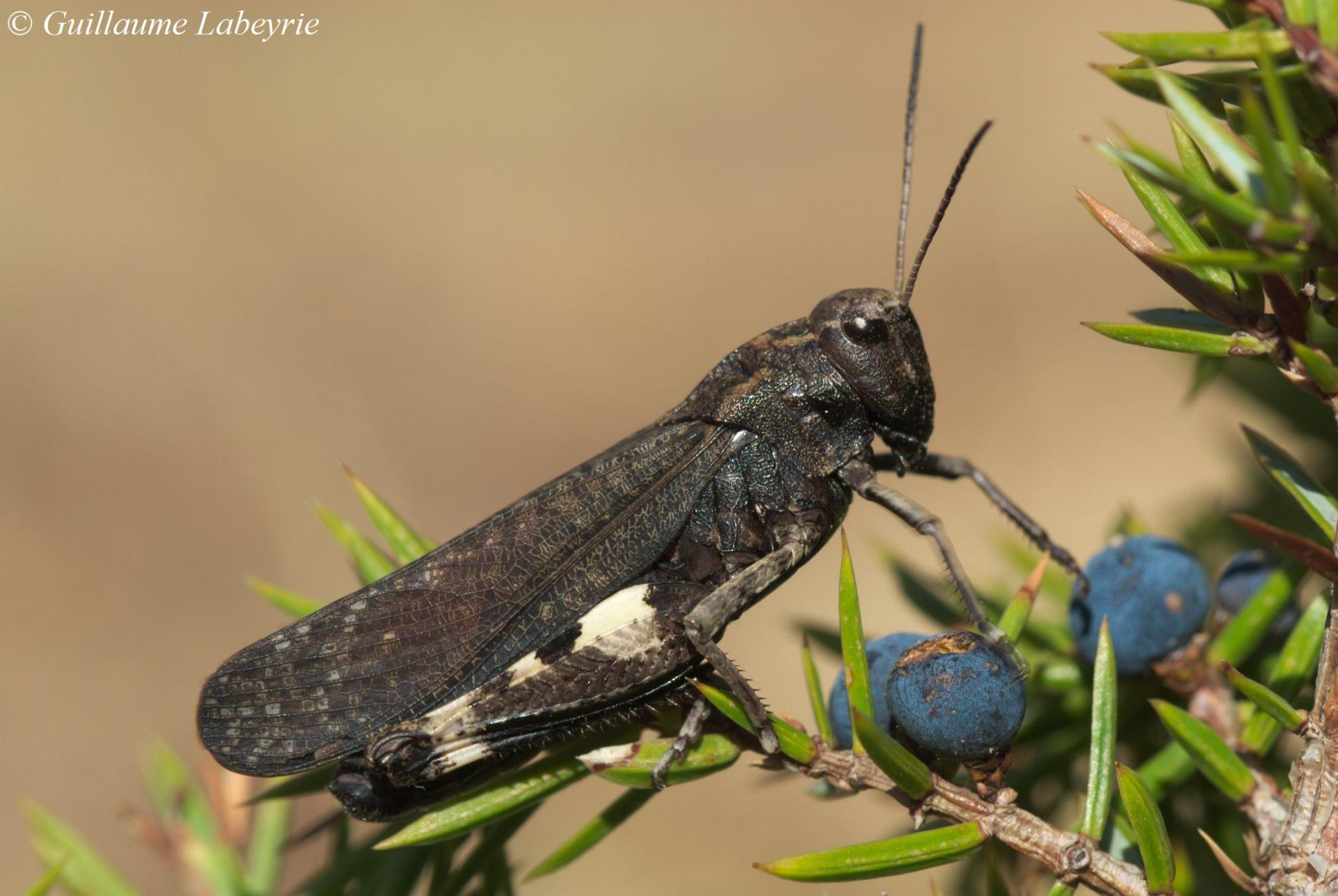 The rattle grasshopper (Psophus stridulus). This grasshopper is very dark, with distinctive white markings on the legs and bright red hind wings. The male, shown here, produces a distinctive rattling during flight. It leaves in dry and rocky mountain grasslands, often in clearings of Scots pine woods. Its range extends from southern Europe to Siberia and Asia. In France, this rather local species is found in the Alps and Pyrenees.
The rattle grasshopper (Psophus stridulus). This grasshopper is very dark, with distinctive white markings on the legs and bright red hind wings. The male, shown here, produces a distinctive rattling during flight. It leaves in dry and rocky mountain grasslands, often in clearings of Scots pine woods. Its range extends from southern Europe to Siberia and Asia. In France, this rather local species is found in the Alps and Pyrenees.
Family : Tettigonidae / Sub-Family : Phaneropterinae
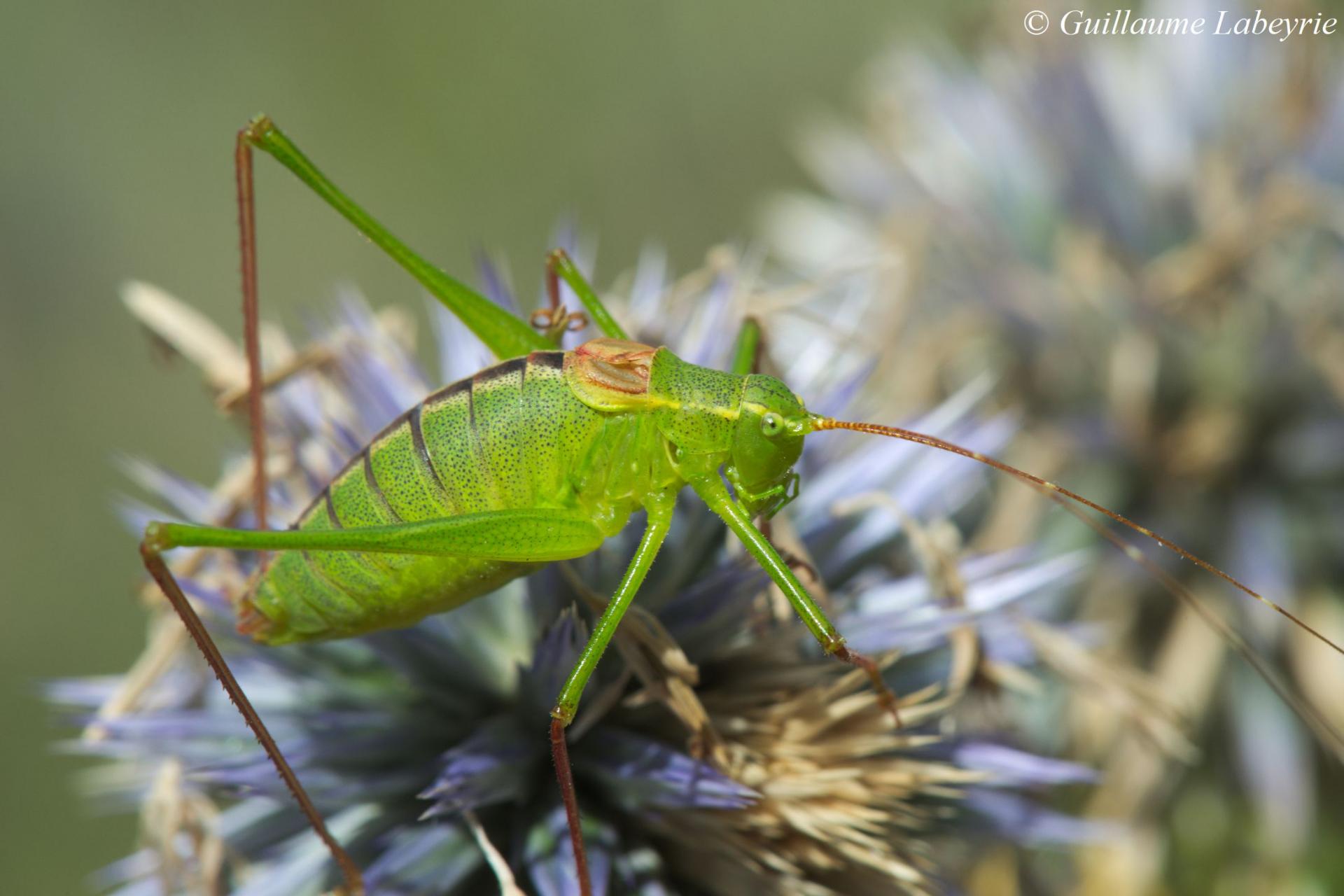 Leptophyes laticauda. This species has its whole body covered with small black dots. Here the pronotum is green, while it has brown edges for Leptophyes punctissima, a neighbouring species. Leptophyes laticauda occurs in France only in the extreme south-east, from 0 to 1500 m of altitude.
Leptophyes laticauda. This species has its whole body covered with small black dots. Here the pronotum is green, while it has brown edges for Leptophyes punctissima, a neighbouring species. Leptophyes laticauda occurs in France only in the extreme south-east, from 0 to 1500 m of altitude.
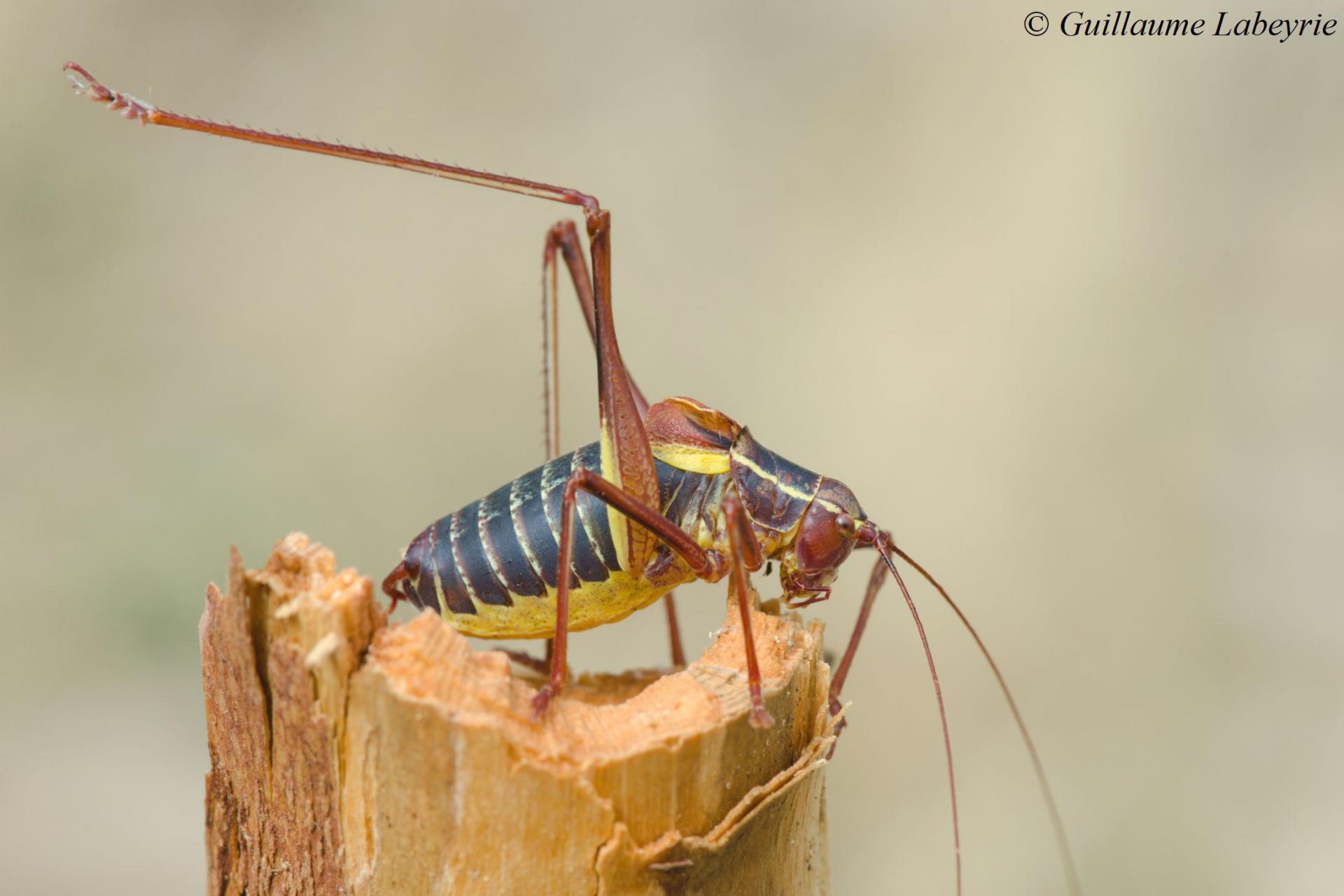 The southern saw-tailed bush cricket (Barbitistes obtusus). This colorful species is usually found in wood clearings. It only occurs in the extreme south-east of France, in Italy and Switzerland.
The southern saw-tailed bush cricket (Barbitistes obtusus). This colorful species is usually found in wood clearings. It only occurs in the extreme south-east of France, in Italy and Switzerland.

